AMX MVP9 WiFi Touch Panel User Manual MVP 9000i OperationReferenceGuide
AMX LLC WiFi Touch Panel MVP 9000i OperationReferenceGuide
AMX >
Contents
- 1. Install Guide
- 2. Final User's Manual
Final User's Manual
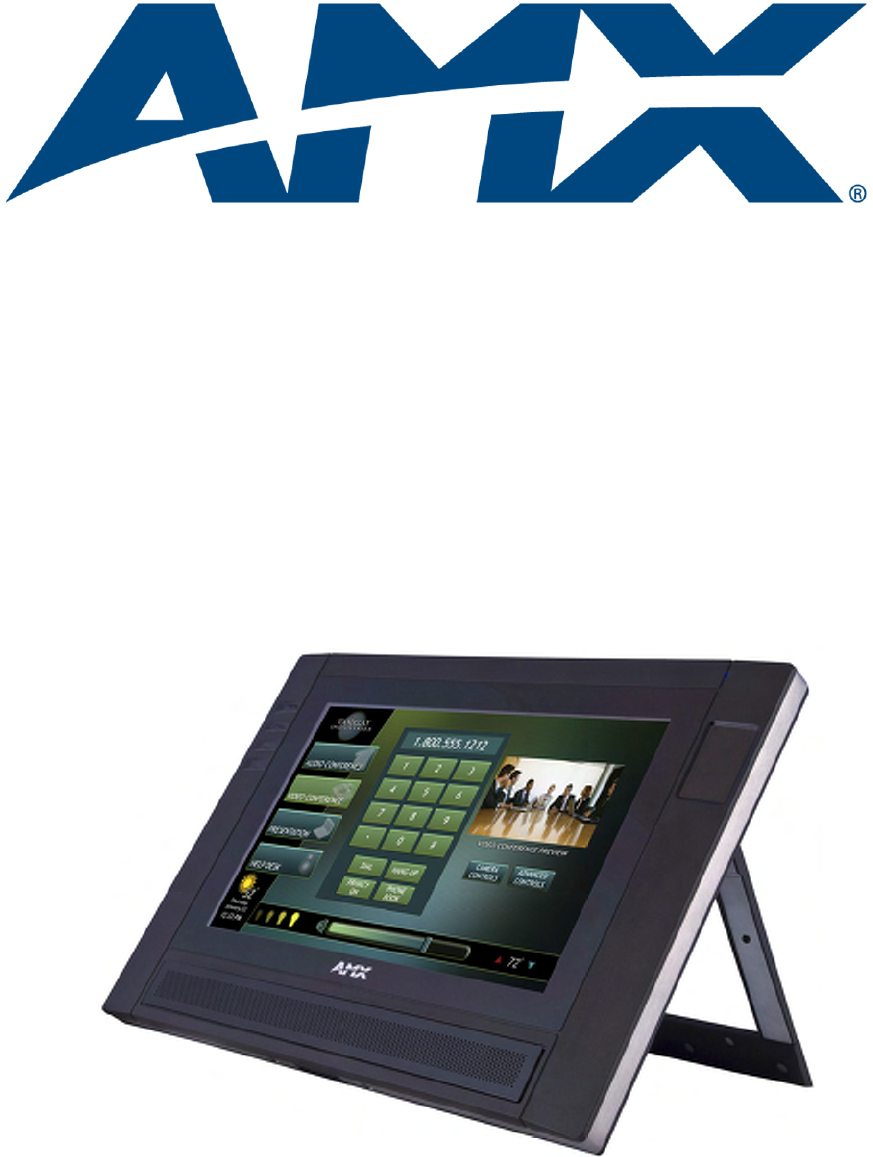
Operation/Reference Guide
Touch Panels
MVP-9000i
9" Modero® ViewPoint®
Touch Panel with Intercom
Initial Release: 10/14/2010
AMX Limited Warranty and Disclaimer
This Limited Warranty and Disclaimer extends only to products purchased directly from AMX or an AMX Authorized Partner which
include AMX Dealers, Distributors, VIP’s or other AMX authorized entity.
AMX warrants its products to be free of defects in material and workmanship under normal use for three (3) years from the date of
purchase, with the following exceptions:
• Electroluminescent and LCD Control Panels are warranted for three (3) years, except for the display and touch overlay compo-
nents are warranted for a period of one (1) year.
• Disk drive mechanisms, pan/tilt heads, power supplies, and MX Series products are warranted for a period of one (1) year.
• AMX lighting products are guaranteed to switch on and off any load that is properly connected to our lighting products, as long
as the AMX lighting products are under warranty. AMX also guarantees the control of dimmable loads that are properly con-
nected to our lighting products. The dimming performance or quality there of is not guaranteed, impart due to the random combi-
nations of dimmers, lamps and ballasts or transformers.
• AMX software is warranted for a period of ninety (90) days.
• Batteries and incandescent lamps are not covered under the warranty.
• AMX AutoPatch Epica, Modula, Modula Series4, Modula CatPro Series and 8Y-3000 product models will be free of defects in
materials and manufacture at the time of sale and will remain in good working order for a period of three (3) years following the
date of the original sales invoice from AMX. The three-year warranty period will be extended to the life of the product (Limited
Lifetime Warranty) if the warranty card is filled out by the dealer and/or end user and returned to AMX so that AMX receives it
within thirty (30) days of the installation of equipment but no later than six (6) months from original AMX sales invoice date. The
life of the product extends until five (5) years after AMX ceases manufacturing the product model. The Limited Lifetime Warranty
applies to products in their original installation only. If a product is moved to a different installation, the Limited Lifetime Warranty
will no longer apply, and the product warranty will instead be the three (3) year Limited Warranty.
All products returned to AMX require a Return Material Authorization (RMA) number. The RMA number is obtained from the AMX
RMA Department. The RMA number must be clearly marked on the outside of each box. The RMA is valid for a 30-day period. After
the 30-day period the RMA will be cancelled. Any shipments received not consistent with the RMA, or after the RMA is cancelled, will
be refused. AMX is not responsible for products returned without a valid RMA number.
AMX is not liable for any damages caused by its products or for the failure of its products to perform. This includes any lost profits, lost
savings, incidental damages, or consequential damages. AMX is not liable for any claim made by a third party or by an AMX Autho-
rized Partner for a third party.
This Limited Warranty does not apply to (a) any AMX product that has been modified, altered or repaired by an unauthorized agent or
improperly transported, stored, installed, used, or maintained; (b) damage caused by acts of nature, including flood, erosion, or earth-
quake; (c) damage caused by a sustained low or high voltage situation or by a low or high voltage disturbance, including brownouts,
sags, spikes, or power outages; or (d) damage caused by war, vandalism, theft, depletion, or obsolescence.
This limitation of liability applies whether damages are sought, or a claim is made, under this warranty or as a tort claim (including
negligence and strict product liability), a contract claim, or any other claim. This limitation of liability cannot be waived or amended by
any person. This limitation of liability will be effective even if AMX or an authorized representative of AMX has been advised of the
possibility of any such damages. This limitation of liability, however, will not apply to claims for personal injury.
Some states do not allow a limitation of how long an implied warranty last. Some states do not allow the limitation or exclusion of inci-
dental or consequential damages for consumer products. In such states, the limitation or exclusion of the Limited Warranty may not
apply. This Limited Warranty gives the owner specific legal rights. The owner may also have other rights that vary from state to state.
The owner is advised to consult applicable state laws for full determination of rights.
EXCEPT AS EXPRESSLY SET FORTH IN THIS WARRANTY, AMX MAKES NO OTHER WARRANTIES, EXPRESSED OR
IMPLIED, INCLUDING ANY IMPLIED WARRANTIES OF MERCHANTABILITY OR FITNESS FOR A PARTICULAR PURPOSE. AMX
EXPRESSLY DISCLAIMS ALL WARRANTIES NOT STATED IN THIS LIMITED WARRANTY. ANY IMPLIED WARRANTIES THAT
MAY BE IMPOSED BY LAW ARE LIMITED TO THE TERMS OF THIS LIMITED WARRANTY. EXCEPT AS OTHERWISE LIMITED
BY APPLICABLE LAW, AMX RESERVES THE RIGHT TO MODIFY OR DISCONTINUE DESIGNS, SPECIFICATIONS, WARRAN-
TIES, PRICES, AND POLICIES WITHOUT NOTICE.
AMX Software License and Warranty Agreement
• LICENSE GRANT. AMX grants to Licensee the non-exclusive right to use the AMX Software in the manner described in this
License. The AMX Software is licensed, not sold. This license does not grant Licensee the right to create derivative works of the
AMX Software. The AMX Software consists of generally available programming and development software, product documenta-
tion, sample applications, tools and utilities, and miscellaneous technical information. Please refer to the README.TXT file on
the compact disc or download for further information regarding the components of the AMX Software. The AMX Software is sub-
ject to restrictions on distribution described in this License Agreement. AMX Dealer, Distributor, VIP or other AMX authorized
entity shall not, and shall not permit any other person to, disclose, display, loan, publish, transfer (whether by sale, assignment,
exchange, gift, operation of law or otherwise), license, sublicense, copy, or otherwise disseminate the AMX Software. Licensee
may not reverse engineer, decompile, or disassemble the AMX Software.
• ACKNOWLEDGEMENT. You hereby acknowledge that you are an authorized AMX dealer, distributor, VIP or other AMX autho-
rized entity in good standing and have the right to enter into and be bound by the terms of this Agreement.
• INTELLECTUAL PROPERTY. The AMX Software is owned by AMX and is protected by United States copyright laws, patent
laws, international treaty provisions, and/or state of Texas trade secret laws. Licensee may make copies of the AMX Software
solely for backup or archival purposes. Licensee may not copy the written materials accompanying the AMX Software.
• TERMINATION. AMX RESERVES THE RIGHT, IN ITS SOLE DISCRETION, TO TERMINATE THIS LICENSE FOR ANY REA-
SON UPON WRITTEN NOTICE TO LICENSEE. In the event that AMX terminates this License, the Licensee shall return or
destroy all originals and copies of the AMX Software to AMX and certify in writing that all originals and copies have been
returned or destroyed.
• PRE-RELEASE CODE. Portions of the AMX Software may, from time to time, as identified in the AMX Software, include PRE-
RELEASE CODE and such code may not be at the level of performance, compatibility and functionality of the GA code. The
PRE-RELEASE CODE may not operate correctly and may be substantially modified prior to final release or certain features may
not be generally released. AMX is not obligated to make or support any PRE-RELEASE CODE. ALL PRE-RELEASE CODE IS
PROVIDED "AS IS" WITH NO WARRANTIES.
• LIMITED WARRANTY. AMX warrants that the AMX Software (other than pre-release code) will perform substantially in accor-
dance with the accompanying written materials for a period of ninety (90) days from the date of receipt. AMX DISCLAIMS ALL
OTHER WARRANTIES, EITHER EXPRESS OR IMPLIED, INCLUDING, BUT NOT LIMITED TO IMPLIED WARRANTIES OF
MERCHANTABILITY AND FITNESS FOR A PARTICULAR PURPOSE, WITH REGARD TO THE AMX SOFTWARE. THIS LIM-
ITED WARRANTY GIVES LICENSEE SPECIFIC LEGAL RIGHTS. Any supplements or updates to the AMX SOFTWARE,
including without limitation, any (if any) service packs or hot fixes provided to Licensee after the expiration of the ninety (90) day
Limited Warranty period are not covered by any warranty or condition, express, implied or statutory.
• LICENSEE REMEDIES. AMX's entire liability and Licensee's exclusive remedy shall be repair or replacement of the AMX Soft-
ware that does not meet AMX's Limited Warranty and which is returned to AMX in accordance with AMX's current return policy.
This Limited Warranty is void if failure of the AMX Software has resulted from accident, abuse, or misapplication. Any replace-
ment AMX Software will be warranted for the remainder of the original warranty period or thirty (30) days, whichever is longer.
Outside the United States, these remedies may not available. NO LIABILITY FOR CONSEQUENTIAL DAMAGES. IN NO
EVENT SHALL AMX BE LIABLE FOR ANY DAMAGES WHATSOEVER (INCLUDING, WITHOUT LIMITATION, DAMAGES
FOR LOSS OF BUSINESS PROFITS, BUSINESS INTERRUPTION, LOSS OF BUSINESS INFORMATION, OR ANY OTHER
PECUNIARY LOSS) ARISING OUT OF THE USE OF OR INABILITY TO USE THIS AMX SOFTWARE, EVEN IF AMX HAS
BEEN ADVISED OF THE POSSIBILITY OF SUCH DAMAGES. BECAUSE SOME STATES/COUNTRIES DO NOT ALLOW
THE EXCLUSION OR LIMITATION OF LIABILITY FOR CONSEQUENTIAL OR INCIDENTAL DAMAGES, THE ABOVE LIMITA-
TION MAY NOT APPLY TO LICENSEE.
• U.S. GOVERNMENT RESTRICTED RIGHTS. The AMX Software is provided with RESTRICTED RIGHTS. Use, duplication, or
disclosure by the Government is subject to restrictions as set forth in subparagraph ©(1)(ii) of The Rights in Technical Data and
Computer Software clause at DFARS 252.227-7013 or subparagraphs ©(1) and (2) of the Commercial Computer Software
Restricted Rights at 48 CFR 52.227-19, as applicable.
• SOFTWARE AND OTHER MATERIALS FROM AMX.COM MAY BE SUBJECT TO EXPORT CONTROL. The United States
Export Control laws prohibit the export of certain technical data and software to certain territories. No software from this Site may
be downloaded or exported (i) into (or to a national or resident of) Cuba, Iraq, Libya, North Korea, Iran, Syria, or any other coun-
try to which the United States has embargoed goods; or (ii) anyone on the United States Treasury Department's list of Specially
Designated Nationals or the U.S. Commerce Department's Table of Deny Orders. AMX does not authorize the downloading or
exporting of any software or technical data from this site to any jurisdiction prohibited by the United States Export Laws.
This Agreement replaces and supersedes all previous AMX Software License Agreements and is governed by the laws of
the State of Texas, and all disputes will be resolved in the courts in Collin County, Texas, USA. For any questions concern-
ing this Agreement, or to contact AMX for any reason, please write: AMX License and Warranty Department, 3000 Research
Drive, Richardson, TX 75082.

FCC Information
This device complies with Part 15 of the FCC Rules. Operation is subject to the following two conditions: (1) this device
may not cause harmful interference, and (2) this device must accept any interference received; including interference
that may cause undesired operation.
Modifications to this product, unless expressly approved by AMX, could void the user’s authority to operate the
equipment.
Federal Communications Commission (FCC)
Statement
This equipment has been tested and found to comply with the limits for a Class B digital device, pursuant to Part 15 of
the FCC rules. These limits are designed to provide reasonable protection against harmful interference in a residential
installation. This equipment generates, uses and can radiate radio frequency energy, and, if not installed and used in
accordance with the instructions, may cause harmful interference to radio communications. However, there is no
guarantee that interference will not occur in a particular installation. If this equipment does cause harmful
interference to radio or television reception, which can be determined by turning the equipment off and on, the user is
encouraged to try to correct the interference by one or more of the following measures:
• Reorient or relocate the receiving antenna.
• Increase the separation between the equipment and receiver.
• Connect the equipment into an outlet on a circuit different from that to which the receiver is connected.
•Consult the dealer or an experienced radio/TV technician for help.
FCC RF Radiation Exposure Statement
This product has been evaluated and found to comply with the limits established by the FCC, Industry Canada and
other international standards for radio frequency exposure when used as described in this manual. The use of
accessories not described may not ensure compliance with these limits.
Indoor Use
This device is intended for indoor use only. WiFi operation in the 5150-5250 MHz range is only for indoor usage to
reduce potential for harmful interference to co-channel mobile satellite systems.

1
MVP-9000i Modero® Wireless Touch Panel with Intercom
Table of Contents
Introduction ........................................................................................................1
Overview .................................................................................................................. 1
Common Application....................................................................................................... 1
Features .......................................................................................................................... 1
Memory .................................................................................................................... 4
Connector Locations ................................................................................................. 4
Basic Operation ........................................................................................................ 4
Powering on the MVP-9000i ..................................................................................... 5
Intercom Microphone ............................................................................................... 5
Stylus ........................................................................................................................ 5
Kick Stand................................................................................................................. 5
Audio/Video Capabilities .......................................................................................... 5
Power Management.................................................................................................. 5
Cleaning the Touch Overlay and Case ...................................................................... 5
Picture View.............................................................................................................. 6
Preview Mode and Normal Mode ................................................................................... 7
Picture View Send Command .......................................................................................... 8
Accessories .........................................................................................................9
Table Docking Station............................................................................................... 9
Powering the MVP-TDS-9.............................................................................................. 10
Recharging .................................................................................................................... 11
Using the USB ports ...................................................................................................... 11
Cleaning the MVP-TDS-9 ............................................................................................... 11
Wall Docking Station .............................................................................................. 12
Unlocking the Touch Panel ..................................................................................... 13
Recharging.............................................................................................................. 14
Installing the MVP-WDS-9....................................................................................... 15
Installing the Wall Docking Station and Plastic Back Box .............................................. 15
Installing the Optional Metal Rough-In Box ............................................................ 18
Pre-Wall Installation of the CB-MVP-WDS9 ................................................................... 18
Other MVP-WDS-9 installations .................................................................................... 19
Configuring Communication .............................................................................21
Overview ................................................................................................................ 21
IR Communication................................................................................................... 22
Modero Setup and System Settings ....................................................................... 22
Accessing the Setup and Protected Setup Pages.......................................................... 22

2MVP-9000i Modero® Wireless Touch Panel with Intercom
Setting the Panel’s Device Number............................................................................... 23
Wireless Settings - Wireless Access Overview ........................................................ 24
DHCP............................................................................................................................. 24
Configuring Wireless Network Access .................................................................... 24
Step 1: Configure the Device’s WiFi Settings ......................................................... 24
Wireless communication using a DHCP Address ........................................................... 24
Wireless Communication Using a Static IP Address....................................................... 25
Using the Site Survey Tool ............................................................................................ 26
Step 2: Configure the Card’s Wireless Security Settings ........................................ 29
Configuring the Device’s Wireless Card for Unsecured Access To a WEP ..................... 29
Automatically Setting SSID............................................................................................ 30
Manually Setting SSID ................................................................................................... 30
Configuring Multiple Wireless Touch Panels To Communicate To a Target WAP.......... 31
Step 3: Choose a Master Connection Mode ........................................................... 31
Ethernet Over USB ................................................................................................. 32
Touch Panel Setup......................................................................................................... 32
Configure a Virtual NetLinx Master using NetLinx Studio ............................................. 35
Ethernet ........................................................................................................................ 37
Master Connection to a Virtual Master via Ethernet ..................................................... 38
Using G4 Web Control to Interact with a G4 Panel ................................................ 40
Using the NetLinx Master To Control the G4 Panel................................................ 41
Setup Pages ......................................................................................................45
Overview ................................................................................................................ 45
Accessing the Setup pages ..................................................................................... 45
Landscape and Portrait Mode Setup Pages ............................................................ 45
Status Page............................................................................................................. 46
Navigation Buttons........................................................................................................ 47
Display Page ........................................................................................................... 48
Audio Page ............................................................................................................. 49
WAV files - Supported Sample Rates ............................................................................ 50
Power Management Page....................................................................................... 51
Date/Time Page ...................................................................................................... 53
Panel Information Page........................................................................................... 55
Panel Information Page - Info ........................................................................................ 55
Panel Information Page - Config.................................................................................... 56
Panel Information Page - File ........................................................................................ 57
Panel Information Page - Project ................................................................................... 58
Protected Setup Pages .....................................................................................59
System & Panel Options page ................................................................................ 61

3
MVP-9000i Modero® Wireless Touch Panel with Intercom
Function Show Example ................................................................................................ 62
Security Settings ........................................................................................................... 62
System Settings Page ............................................................................................. 64
System Settings - Master .............................................................................................. 64
System Settings - Wired ................................................................................................ 65
System Settings - WiFi .................................................................................................. 66
Security Modes ....................................................................................................... 69
Open ............................................................................................................................. 69
WEP .............................................................................................................................. 70
WPA-PSK....................................................................................................................... 72
EAP Security & Server Certificates - Overview ....................................................... 74
EAP-LEAP ...................................................................................................................... 75
EAP-FAST ...................................................................................................................... 77
EAP-PEAP...................................................................................................................... 79
EAP-TTLS....................................................................................................................... 81
EAP-TLS......................................................................................................................... 83
Client Certificate Configuration .................................................................................... 85
System Settings - USB ................................................................................................... 86
Calibrate Page ........................................................................................................ 87
G4 Web Control Settings Page............................................................................... 88
Passwords ............................................................................................................... 90
Panel Logs Page ..................................................................................................... 92
Cache Settings Page ............................................................................................... 93
Panel Statistics Page............................................................................................... 95
Panel Statistics - ICSP.................................................................................................... 95
Panel Statistics - Blinks Tab ........................................................................................... 96
Panel Statistics - IP Tab ................................................................................................. 97
Panel Statistics - Wireless Tab ....................................................................................... 97
Connection Utility Page ................................................................................................ 98
SIP Settings Page.................................................................................................... 99
Upgrading Firmware ......................................................................................101
Overview .............................................................................................................. 101
Upgrading Firmware via USB stick........................................................................ 101
Upgrading Firmware Via NetLinx Studio .............................................................. 102
Step 3: Confirm and Upgrade the firmware via the USB port..................................... 103
A Special Note for Network Interface Connections .............................................. 106
Programming ..................................................................................................109
Overview .............................................................................................................. 109
Animated Transitions ............................................................................................ 109

4MVP-9000i Modero® Wireless Touch Panel with Intercom
^AFP 110
Touch Gesture Recognition................................................................................... 111
Gesture Velocity.......................................................................................................... 111
Gesture Prioritization .................................................................................................. 111
Gesture VNC/Mouse Support...................................................................................... 112
Gesture Custom Event ................................................................................................ 112
Enabling or Disabling the Gesture Custom Event ....................................................... 112
^GCE 112
.............................................................................................................................. 112
Page Commands ................................................................................................... 113
@APG ...................................................................................................................................... 113
@CPG ...................................................................................................................................... 113
@DPG ...................................................................................................................................... 113
@PDR ...................................................................................................................................... 113
@PHE ...................................................................................................................................... 113
@PHP ...................................................................................................................................... 114
@PHT ...................................................................................................................................... 114
@PPA ...................................................................................................................................... 114
@PPF ....................................................................................................................................... 114
@PPG ...................................................................................................................................... 115
@PPK ...................................................................................................................................... 115
@PPM ...................................................................................................................................... 115
@PPN ...................................................................................................................................... 115
@PPT ....................................................................................................................................... 116
@PPX ...................................................................................................................................... 116
@PSE ....................................................................................................................................... 116
@PSP ....................................................................................................................................... 116
@PST ....................................................................................................................................... 116
PAGE ...................................................................................................................................... 116
PPOF ....................................................................................................................................... 117
PPOG ...................................................................................................................................... 117
PPON ...................................................................................................................................... 117
Programming Numbers......................................................................................... 118
RGB Triplets and Names For Basic 88 Colors ............................................................. 118
Font Styles And Id Numbers ....................................................................................... 120
Border Styles And Programming Numbers ................................................................. 120
"^" Button Commands ......................................................................................... 122
^ANI ....................................................................................................................................... 122
^APF ....................................................................................................................................... 122
^BAT ....................................................................................................................................... 123
^BAU ...................................................................................................................................... 123
^BCB ....................................................................................................................................... 123
^BCF ....................................................................................................................................... 124
^BCT ....................................................................................................................................... 124
^BDO ...................................................................................................................................... 124
^BFB ....................................................................................................................................... 125

5
MVP-9000i Modero® Wireless Touch Panel with Intercom
^BIM ........................................................................................................................................125
^BLN .......................................................................................................................................125
^BMC ......................................................................................................................................126
^BMF .......................................................................................................................................127
^BMI ........................................................................................................................................128
^BML .......................................................................................................................................128
^BMP ......................................................................................................................................129
^BNC .......................................................................................................................................129
^BNN ......................................................................................................................................129
^BNT .......................................................................................................................................129
^BOP .......................................................................................................................................129
^BOR .......................................................................................................................................130
^BOS .......................................................................................................................................130
^BPP ........................................................................................................................................130
^BRD .......................................................................................................................................130
^BSF ........................................................................................................................................131
^BSM .......................................................................................................................................131
^BSO .......................................................................................................................................131
^BVL ........................................................................................................................................131
^BVN .......................................................................................................................................131
^BVP .......................................................................................................................................132
^BVT .......................................................................................................................................132
^BWW .....................................................................................................................................132
^CPF ........................................................................................................................................132
^DLD .......................................................................................................................................132
^DPF .......................................................................................................................................133
^ENA .......................................................................................................................................133
^FON ......................................................................................................................................133
^GDI ........................................................................................................................................134
^GIV ........................................................................................................................................134
^GLH .......................................................................................................................................134
^GLL ........................................................................................................................................134
^GRD .......................................................................................................................................134
^GRU .......................................................................................................................................135
^GSC .......................................................................................................................................135
^GSN .......................................................................................................................................135
^ICO ........................................................................................................................................135
^IRM ........................................................................................................................................136
^JSB ........................................................................................................................................136
^JSI .........................................................................................................................................136
^JST ........................................................................................................................................137
^MBT .......................................................................................................................................137
^MDC ......................................................................................................................................137
^PIC .........................................................................................................................................137
^SHO .......................................................................................................................................137
^TEC ........................................................................................................................................138
^TEF ........................................................................................................................................138
^TXT ........................................................................................................................................138
^UNI ........................................................................................................................................139
^WLD ......................................................................................................................................139

6MVP-9000i Modero® Wireless Touch Panel with Intercom
Miscellaneous MVP Strings.......................................................................................... 140
undock <master> .................................................................................................................... 140
dock ........................................................................................................................................ 140
MVP Panel Lock Passcode Commands ........................................................................ 140
^LPC ....................................................................................................................................... 140
^LPR ....................................................................................................................................... 140
^LPS ........................................................................................................................................ 140
Text Effects Names............................................................................................... 141
Button Query Commands ..................................................................................... 141
?BCB ....................................................................................................................................... 142
?BCF ....................................................................................................................................... 143
?BCT ....................................................................................................................................... 143
?BMP ...................................................................................................................................... 144
?BOP ....................................................................................................................................... 144
?BRD ....................................................................................................................................... 145
?BWW ..................................................................................................................................... 145
?FON ...................................................................................................................................... 146
?ICO ........................................................................................................................................ 146
?JSB ........................................................................................................................................ 147
?JSI ......................................................................................................................................... 147
?JST ........................................................................................................................................ 148
?TEC ........................................................................................................................................ 148
?TEF ........................................................................................................................................ 149
?TXT ........................................................................................................................................ 149
Panel Runtime Operations .................................................................................... 150
ABEEP ..................................................................................................................................... 150
ADBEEP .................................................................................................................................. 150
@AKB ...................................................................................................................................... 150
AKEYB .................................................................................................................................... 150
AKEYP ..................................................................................................................................... 150
AKEYR ..................................................................................................................................... 150
@AKP ...................................................................................................................................... 151
@AKR ...................................................................................................................................... 151
BEEP ....................................................................................................................................... 151
BRIT ........................................................................................................................................ 151
@BRT ....................................................................................................................................... 151
DBEEP ..................................................................................................................................... 151
@EKP ...................................................................................................................................... 151
PKEYP ..................................................................................................................................... 152
@PKP ...................................................................................................................................... 152
SETUP ..................................................................................................................................... 152
SHUTDOWN ........................................................................................................................... 152
SLEEP ...................................................................................................................................... 152
@SOU ...................................................................................................................................... 152
@TKP ....................................................................................................................................... 153
TPAGEON ............................................................................................................................... 153
TPAGEOFF .............................................................................................................................. 153
@VKB ...................................................................................................................................... 153

7
MVP-9000i Modero® Wireless Touch Panel with Intercom
WAKE ......................................................................................................................................153
Input Commands................................................................................................... 154
^CAL .......................................................................................................................................154
^KPS ........................................................................................................................................154
^VKS .......................................................................................................................................154
Embedded codes.................................................................................................. 155
Panel Setup Commands ........................................................................................ 156
@PWD .....................................................................................................................................156
^PWD ......................................................................................................................................156
Dynamic Image Commands................................................................................... 157
^BBR .......................................................................................................................................157
^RAF .......................................................................................................................................157
^RFR ........................................................................................................................................157
^RAF, ^RMF - Embedded Codes ................................................................................ 158
^RMF .......................................................................................................................................158
^RSR ........................................................................................................................................158
Escape Sequences ....................................................................................................... 159
$DV .........................................................................................................................................159
$SY ..........................................................................................................................................159
$IP ...........................................................................................................................................159
$HN .........................................................................................................................................159
$MC .........................................................................................................................................159
$ID ...........................................................................................................................................159
$PX ..........................................................................................................................................159
$PY ..........................................................................................................................................159
$ST ..........................................................................................................................................159
$AC .........................................................................................................................................159
$AP ..........................................................................................................................................159
$CC .........................................................................................................................................159
$CP ..........................................................................................................................................159
$LC ..........................................................................................................................................159
$LP ..........................................................................................................................................159
$BX ..........................................................................................................................................159
$BY ..........................................................................................................................................159
$BN .........................................................................................................................................159
Intercom Commands............................................................................................. 160
^MODEL? ................................................................................................................................160
^ICS- ........................................................................................................................................160
^ICE' ........................................................................................................................................160
^ICM-TALK ..............................................................................................................................161
^ICM-LISTEN ...........................................................................................................................161
^ICM-MICLEVEL ......................................................................................................................161
^ICM-MUTEMIC ......................................................................................................................161
^ICM-SPEAKERLEVEL .............................................................................................................161
SIP Commands ...................................................................................................... 162
^PHN-AUTOANSWER .............................................................................................................162
^PHN-CALL .............................................................................................................................162

8MVP-9000i Modero® Wireless Touch Panel with Intercom
^PHN-INCOMING ................................................................................................................... 162
^PHN-LINESTATE ................................................................................................................... 162
^PHN-MSGWAITING .............................................................................................................. 162
^PHN-ANSWER ...................................................................................................................... 163
^PHN-AUTOANSWER ............................................................................................................. 163
?PHN-AUTOANSWER ............................................................................................................. 163
^PHN-CALL ............................................................................................................................. 163
^PHN-PRIVACY ....................................................................................................................... 163
^PHN-REDIAL ......................................................................................................................... 163
^PHN-TRANSFERRED ............................................................................................................. 163
^PHN-DTMF ........................................................................................................................... 164
^PHN-HANGUP ...................................................................................................................... 164
^PHN-HOLD ........................................................................................................................... 164
?PHN-LINESTATE .................................................................................................................... 164
^PHN-PRIVACY ....................................................................................................................... 164
?PHN-PRIVACY ....................................................................................................................... 164
^PHN-REDIAL ......................................................................................................................... 164
^PHN-TRANSFER .................................................................................................................... 164
^PHN-SETUP-DOMAIN ........................................................................................................... 165
^PHN-SETUP-ENABLE ............................................................................................................ 165
^PHN-SETUP-PASSWORD ...................................................................................................... 165
^PHN-SETUP-PORT ................................................................................................................. 165
^PHN-SETUP-PROXYADDR .................................................................................................... 165
^PHN-SETUP-STUNADDR ....................................................................................................... 165
^PHN-SETUP-USERNAME ....................................................................................................... 165
Battery Life and Replacement ........................................................................167
Overview .............................................................................................................. 167
IMPORTANT NOTES! ............................................................................................ 167
Power Management.............................................................................................. 168
Proper Battery Maintenance................................................................................. 168
Battery Replacement ............................................................................................ 169
READ THESE INSTRUCTIONS FIRST!........................................................................... 169
Replacing the Battery ........................................................................................... 169
Remove the Old Battery.............................................................................................. 171
Install the New Battery................................................................................................ 171
Reconnecting the Battery To The Device .................................................................... 171
Appendix A: Text Formatting .........................................................................173
Text Formatting Codes for Bargraphs/Joysticks................................................... 173
Text Area Input Masking....................................................................................... 174
Input mask character types ......................................................................................... 174
Input Mask Ranges ...................................................................................................... 175
Input mask next field characters.................................................................................. 175
Input mask operations................................................................................................. 175
Input mask literals ....................................................................................................... 175

9
MVP-9000i Modero® Wireless Touch Panel with Intercom
Input mask output examples ....................................................................................... 176
URL Resources ...................................................................................................... 176
Special Escape Sequences........................................................................................... 176
Appendix B: Wireless Technology ..................................................................179
Overview of Wireless Technology......................................................................... 179
Terminology.......................................................................................................... 180
802.1x ......................................................................................................................... 180
AES ............................................................................................................................. 180
CERTIFICATES (CA) ..................................................................................................... 180
MIC.............................................................................................................................. 180
TKIP............................................................................................................................. 180
WEP ............................................................................................................................ 180
WPA ............................................................................................................................ 180
WPA2 .......................................................................................................................... 181
EAP Authentication............................................................................................... 182
EAP Characteristics ..................................................................................................... 182
EAP Communication Overview.................................................................................... 183
Configuring Modero Firmware via the USB Port .................................................. 184
Step 1: Configure The Panel For a USB Connection Type ........................................... 184
Step 2: Prepare NetLinx Studio For Communication Via the USB Port ....................... 184
AMX Certificate Upload Utility ............................................................................. 185
Uploading a Certificate File .................................................................................. 185
Appendix C: Troubleshooting ........................................................................187
Overview .............................................................................................................. 187
Panel Doesn’t Respond To Touches ............................................................................ 187
Battery Will Not Hold Or Take A Charge .................................................................... 187
MVP-9000i Isn’t Appearing In The Online Tree Tab .................................................... 188
MVP Can’t Obtain a DHCP Address ............................................................................ 188
My WAP Doesn’t Seem To Be Working....................................................................... 188
NetLinx Studio Only Detects One Of My Connected Masters .................................... 188
Can’t Connect To a NetLinx Master ............................................................................ 188
Only One Modero Panel In My System Shows Up....................................................... 188
Panel Behaves Strangely After Downloading A Panel File Or Firmware ..................... 189

10 MVP-9000i Modero® Wireless Touch Panel with Intercom
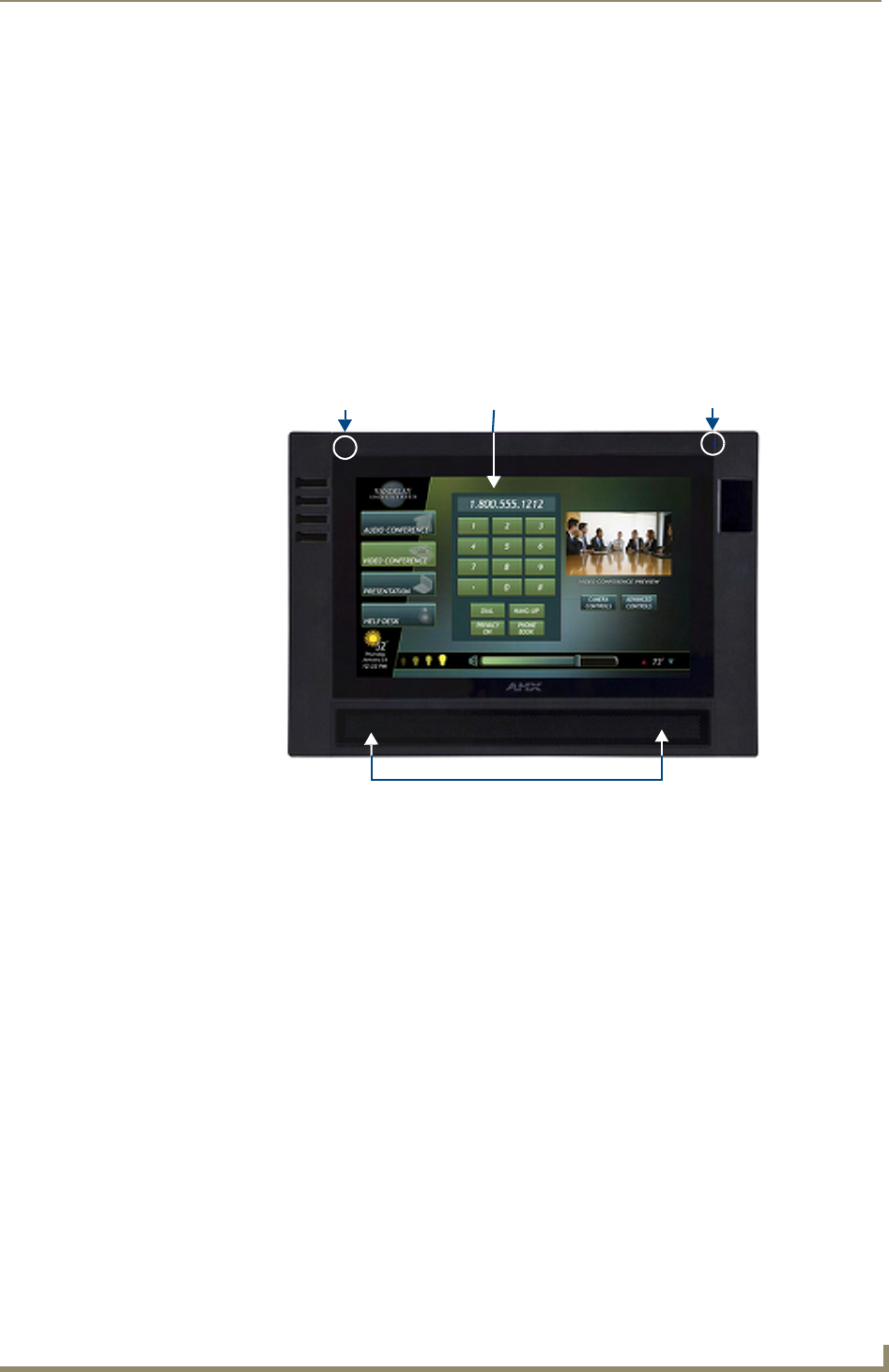
Introduction
1
MVP-9000i Modero® Wireless Touch Panel with Intercom
Introduction
Overview
The MVP-9000i redefines touch panel control offering both wireless and wired functionality, new user
interface capabilities like gestures and animated page transitions, a stunning 9" widescreen 24-bit color
display, full digital duplex VoIP telephone or intercom interface and built-in 802.11a/b/g WiFi card with
antenna diversity. The MVP-9000i switches seamlessly to wireless mode when removed from either the MVP-
TDS-9 Table Docking Station or the MVP-WDS-9 Wall Docking Station. Transfer touch panel pages, upgrade
the firmware or display photo files using the USB or micro-SD card slot. Available in black (FG5967-01) and
white (FG5967-02), the MVP-9000i also features a capacitive touch directional pad, 4 programmable buttons,
and over 1 GB of usable flash memory. The MVP-9000i also supports 5 hours of continuous use to three days
of standby time.
Common Application
The MVP-9000i is ideal for a wide variety of residential and commercial control and automation applications
where flexibility of docked with wired Ethernet or undocked with 802.11a/b/g functionality is desired. This is
an option for extremely noisy wireless environments such as multiple dwelling units, as well as applications
that require telephone/intercom functionality.
Features
Ultra-light, compact and thin form factor
Available in your choice of black or white
Capacitive touch buttons provide simple (up/down) or sophisticated control (up/down, right/left,
select)
VoIP Intercom and SIP Telephone (requires AMX SIP Gateway) Ready
802.11a/b/g WiFi for two-way network communications
Wireless communications remain secure using WEP, WPA, WPA2, EAP-TLS, EAP-TTLS and
PEAP network security standards
Enhanced usability with microphone and speakers
Versatile placement options, including an integrated kickstand and the optional MVP-TDS-9 Table
Docking Station and MVP-WDS-9 Wall Docking Station
FIG. 1 MVP-9000i-GB touch panel
Touch screenMicrophone
Speaker grille
Status LED
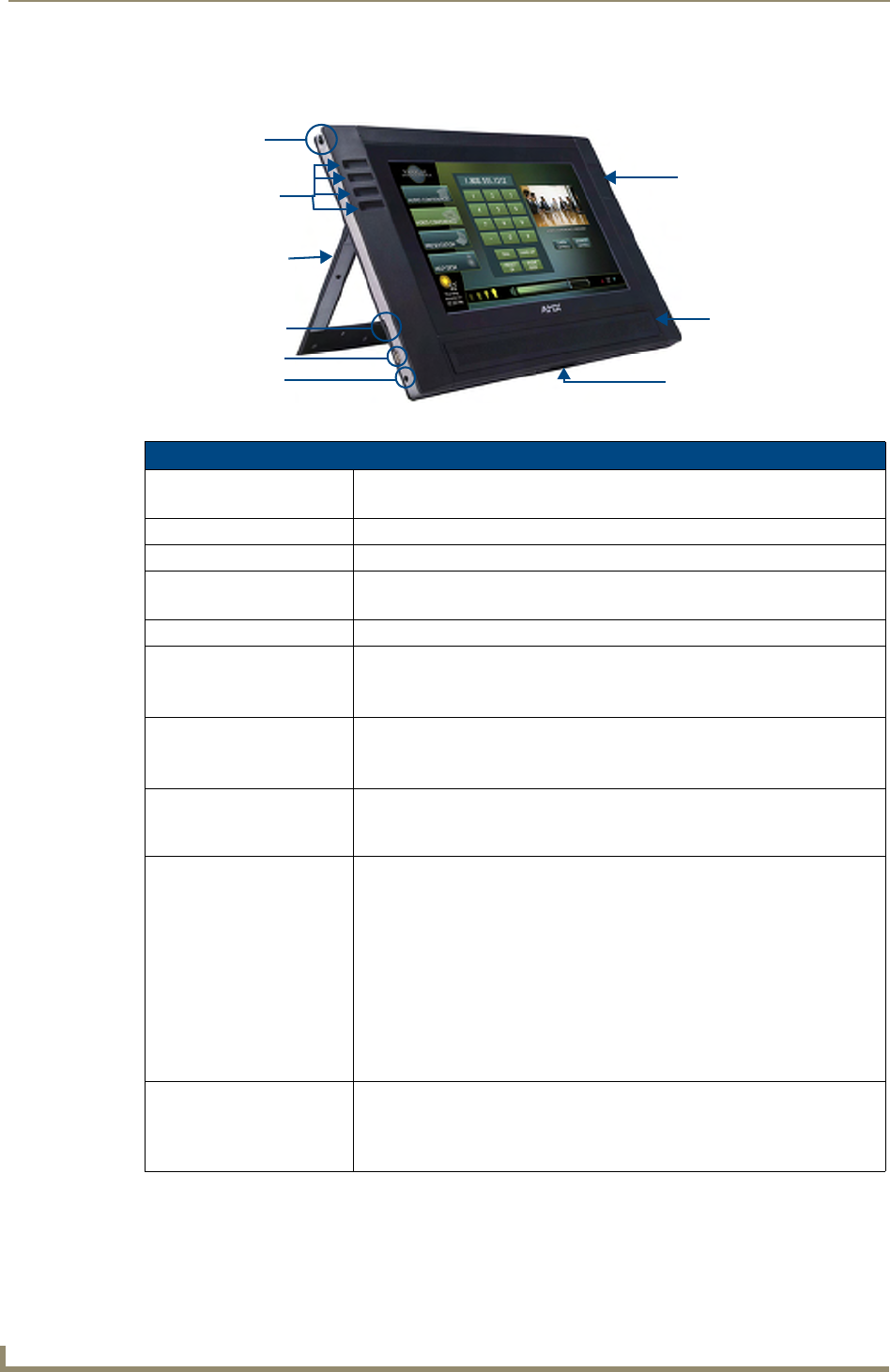
Introduction
2 MVP-9000i Modero® Wireless Touch Panel with Intercom
The MVP-9000i comes with an integrated rear “kickstand”, allowing it to be used and displayed away from a
Docking Station (FIG. 2). It also comes with a pre-installed 802.11a/b/g wireless card.
FIG. 2 MVP-9000i side view (with kickstand)
MVP-9000i Specifications
Models Available: • MVP-9000i-GB (Black - FG5967-01)
• MVP-9000i-GW (White - FG5967-02)
Dimensions: • 7.62” x 10.98” x 1.06" (19.35 cm x 27.89 cm x 2.69 cm)
Weight: • 3.60 lbs (1.63 kg)
Enclosure: MVP-9000i-GB: Black plastic with brushed metal retaining ring.
MVP-9000i-GW: White plastic with brushed metal retaining ring.
Memory: • 2GB internal microSD (1.1GB accessible to user)
Power Requirements
(Without Charging):
• Constant current draw: 1.1 A @ 12 VDC
• Startup current draw: 1.2 A @ 12 VDC
• If panel is mounted onto a TDS or WDS, add 0.1 A to the above figures.
Power Requirements (While
Charging):
Panel while charging battery:
• Constant current draw: 2.0 A @ 12VDC
• If panel is mounted onto a TDS or WDS, add 0.1 A to the above figures.
Minimum Power Supply
Required:
• PS3.0 Power Supply (FG423-30) (included)
• PS-POE-AT High Power PoE Injector (FG423-81) through the Table Docking
Station and Wall Docking Station
Power Modes: • ON: All necessary modules are powered up and device remains online with
the NetLinx Master.
• Sleep: Only the backlight will be turned off after the user selectable time of
inactivity has elapsed. Panel resumes the ON mode immediately after being
touched.
• STANDBY: Power to all components other than the touch screen is turned off
after the user selectable time of inactivity has elapsed. Device will turn back
on by touching the screen. Re-acquiring a WAP connection may require up
to 25 seconds.
• SHUTDOWN: Power to all peripherals and components is turned off. The
system remains in this mode until it is restarted.
Battery Duration: • On (continuous use): 5 hours; Standby: 3 days
• 10 hours of normal use, in a combination of On, Sleep, Standby, and
Shutdown.
• 3 days of standby use
Kickstand
Mini-USB port
DC power jack
MicroSD memory
card slot
Docking Station
interface connector
Stylus
Speaker
Capacitive touch
Capacitive touch
buttons (4) directional pad
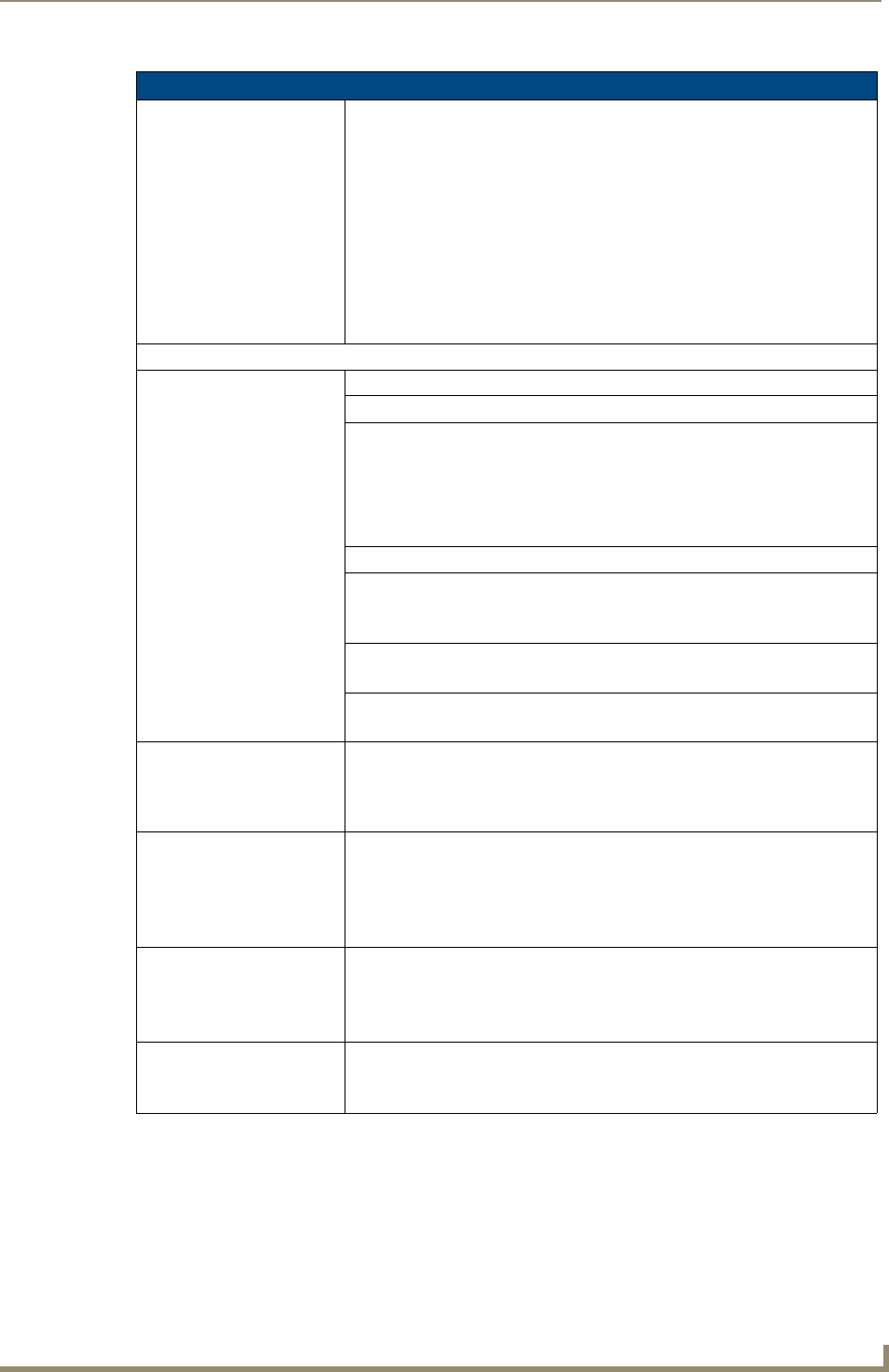
Introduction
3
MVP-9000i Modero® Wireless Touch Panel with Intercom
MVP-9000i Specifications (Cont.)
Panel LCD Parameters: • Screen resolution: 800 x 480 pixels (HV) @ 60 Hz refresh rate
• Aspect ratio: 16 x 9
• Brightness (luminance): 400 cd/m2
• Channel transparency: 8-bit Alpha blending
• Contrast ratio: 900:1 max.
• Display colors: 16.7M colors (24-bit color depth)
• Dot/pixel pitch: 0.246 mm
• Panel type: TFT Color Active-Matrix (IPS technology)
• Viewing angles:
Vertical: + 85° (up from center) and - 85° (down from center)
Horizontal: + 85° (left from center) and - 85° (right from center)
External Components
Stylus Slot: Slot where the included stylus is stored, located on the left side of the device.
MicroSD Card Slot: Slot for insertion of standard MicroSD memory cards.
Mini-USB Connector: 5-pin Mini-USB connector used for audio output to USB headphones,
programming, firmware updates, and touch panel file transfer between the PC
and the target panel.
Note: When connecting the panel to PC using a CC-USB (or compatible)
cable, be sure to power the panel On before attempting to connect the USB
cable from the PC to the mini-USB port on the panel.
DC power port: 2.5 mm port to power the panel away from a Docking Station.
Microphone: For use with the intercom feature and for calls using SIP.
• Frequency: 20 to 160,000 Hz
• S/N Ratio: More than 58 dB
Speaker: • 4 Ohm
• 2 Watts 300Hz cutoff frequency
Audio Standards: • G.711 sound standard
• 75dB SPL@1m
IR Emitters: Transmit IR (transmit only) over 20 feet (6.10 m) from the panel.
• IR emitters on G4 panels share the device address number of the panel.
• Transmits AMX fixed frequencies at 38KHz and 455KHz and third-party
user-programmable frequencies from 20KHz to 1.5MHz
Certifications: • FCC Class B
•CE
•IC
• VCCI
•C-Tick
Operating/Storage
Environment
• Operating Temperature: 0° C (32° F) to 40° C (104° F)
• Operating Humidity: 5% - 85% RH
• Storage Temperature: -10° C (-14° F) to 60° C (140° F)
• Storage Humidity: 5% - 85% RH
Included Accessories: • MVP-9000i Installation Guide (93-5967-01)
• PS3.0 Power Supply (FG423-30)
• Stylus (pre-installed onto the left side of the unit)
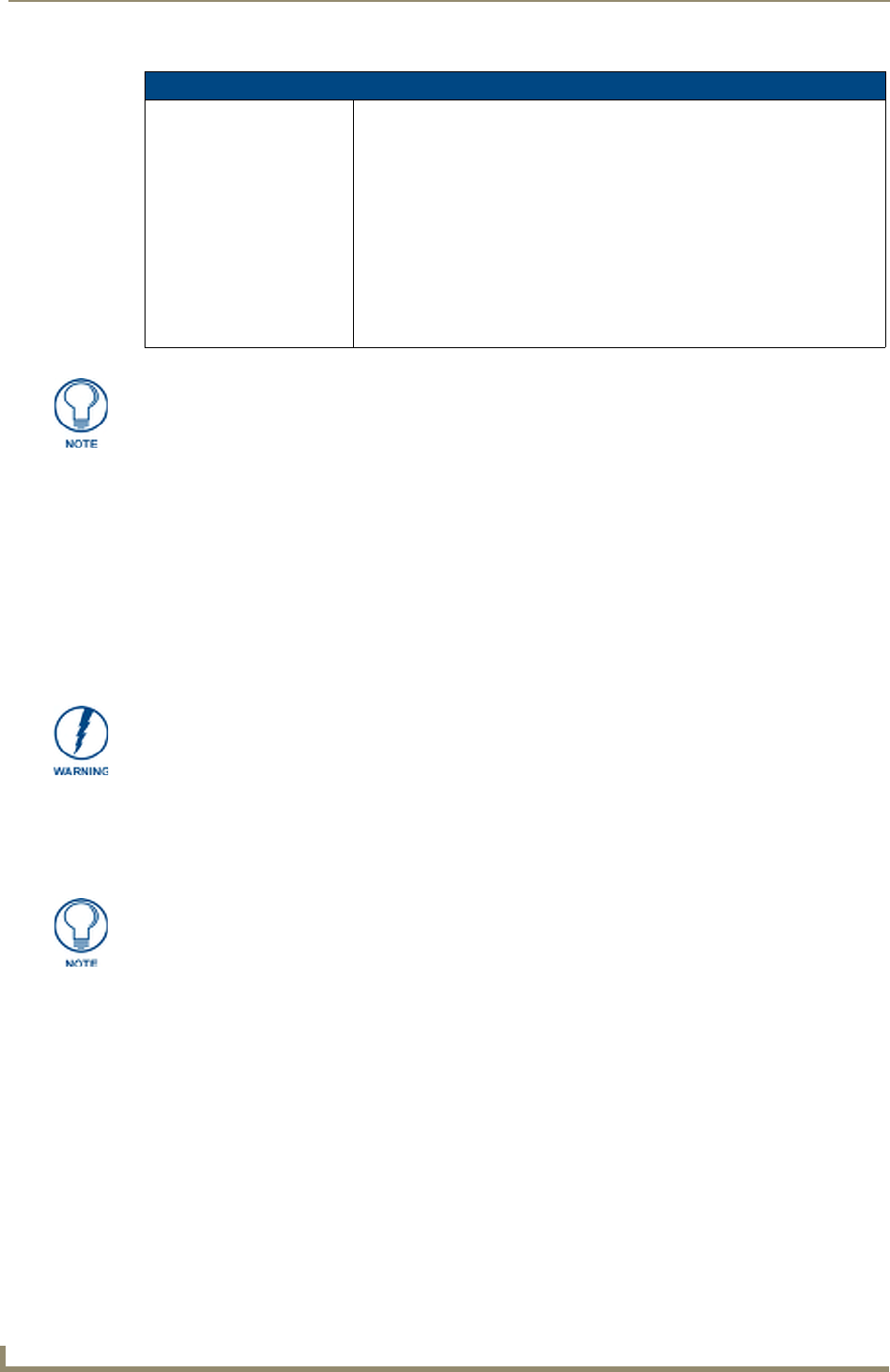
Introduction
4 MVP-9000i Modero® Wireless Touch Panel with Intercom
Memory
The MVP-9000i comes with 2GB internal MicroSD memory,1.1GB of which is accessible to the user. This
memory may not be upgraded.
Connector Locations
With the unit facing you, the mini-USB port (for programming and downloading firmware and the DC power
port are located on the lower left side of the device (FIG. 2). The connector for the Table Docking Station
(please refer to the Table Docking Station section on page 9) is located on the bottom of the device.
In addition to its speaker, the MVP-9000i also utilizes its mini-USB port as a connector for standard
headphones or headsets. These headphones must use a mini-USB plug or adaptor in order to utilize this
feature.
Basic Operation
The MVP-9000i is operated using its integral touchscreen, as well as the capacitive touch buttons on the left
and the directional pad on the right side of the device (FIG. 1). If the device has gone into its Sleep or Standby
Modes, a touch of the touchscreen or of any of the buttons will reactivate it.
The MVP-9000i device’s power use allows up to 72 hours of use between rechargings of its internal battery,
but its battery charge lasts up to one monthif the device goes into Shutdown Mode during that time. The device
may be placed in its charging cradle at any time and operated within its cradle, making a wired Ethernet
connection in the process.
Any wired connection intended for the device will be reconnected within approximately twenty seconds after
the device is placed in a Table Docking Station or Wall Docking Station. Depending upon preselected settings,
the device may be set to go into On Mode as soon as it is placed in the Docking Station.
MVP-9000i Specifications (Cont.)
Other AMX Equipment: • MVP-TDS-9-GB Black Table Docking Station (FG5967-10)
• MVP-TDS-9-GW White Table Docking Station (FG5967-11)
• MVP-WDS-9-GB Black Wall Docking Station (FG5967-12)
• MVP-WDS-9-GW White Wall Docking Station (FG5967-13)
• CC-MINIUSB Mini USB to PC Cable Adapter (FG5967-20)
• MicroSD card - 2GB (FG2116-80)
• MicroSD card - 4GB (FG2116-81)
• MVP-BP-9 Replacement Battery Pack (FG5967-21)
• PS-POE-AT High Power PoE Injector (FG423-81)
• MVP-STYLUS-52-XX Replacement Stylus, pack of 3 (Black: FG5966-21;
White: FG5966-22)
This device complies with FCC Part 15 and Industry Canada RSS 210 subject to the
following conditions:
1. This device must not cause harmful interference and
2. This device must accept all interference, including interference that interferes with
the operation of this device.
Although firmware upgrades can be conducted over a wireless Ethernet connection,
transferring firmware KIT files over a wired LAN, USB data stick, or USB flash card is
recommended, and only when the panel is connected to a power supply. If battery
power is below 30 percent, and the touch panel is not connected to a power supply,
the download will not be completed.
While standard input/output headsets may be used in lieu of headphones, the
headset may only be used for output. While you may receive sound from the headset,
its microphone will not function. Always use the MVP-9000i’s microphone for
receiving sound.

Introduction
5
MVP-9000i Modero® Wireless Touch Panel with Intercom
Powering on the MVP-9000i
The MVP-9000i may be powered on by touching and holding the touchscreen. If the device was in Sleep
Mode, it will automatically turn on when put into a Table or Wall Docking Station.
Intercom Microphone
The MVP-9000i contains a built-in microphone above the upper lefthand corner of the touch screen for video
and audio conferencing capabilities. This microphone is concealed by the casing.
Stylus
The MVP-9000i comes with a unique touchscreen stylus that slides into a storage groove on the left side of the
device when not in use. Replacement styluses may be ordered in a 3-pack (black, FG5966-21; white, FG5966-
22) from www.amx.com.
Kick Stand
Since the MVP-9000i device is designed to be a unit used away from its docking station, it has an extendable
“kickstand” on the back of the unit (FIG. 2). This may be opened by physically lifting the free end of the kick
stand away from the device. The device may then be propped up on a flat surface and accessed in a normal
fashion.
Audio/Video Capabilities
The MVP-9000i has the capability of displaying multiple JPEG and PNG files at one time. The device also
supports streaming motion JPEG video (of the sort used by many IP and Web cameras), as well as MP3 and
WAV audio files.
Power Management
The MVP-9000i utilizes a dual voltage external power supply. It may be recharged through the supplied PS3.0
Power Supply (FG423-30), as well as through the MVP-TDS-9 Table Docking Station (FG5967-1X) or the
MVP-WDS-9 Wall Docking Station (FG5967-1X). For more information, see the Accessories section on
page 9 for details.
When not in active use, the MVP-9000i conserves battery life between chargings. Pressing the touch screen
will return the device to its On Mode. For more information on the battery, see the Battery Life and
Replacement section on page 167.
Cleaning the Touch Overlay and Case
Always use a clean cotton cloth and a spray bottle containing water or any standard ammonia-free glass
cleaner can be used to clean the touch screen. Do NOT use alcohol-based cleaners, as alcohol-based cleaners
can damage the device’s touch screen overlay.
Do not directly spray the device: instead, spray the cloth to clean the touch screen overlay.
Do NOT use an abrasive of any type to clean the MVP-9000i, as this may permanently damage or
remove the device’s finish.
Although the MVP-9000i unit is equipped with a mini-USB port, the device cannot be
powered through the USB port. The port is only used for uploading firmware.
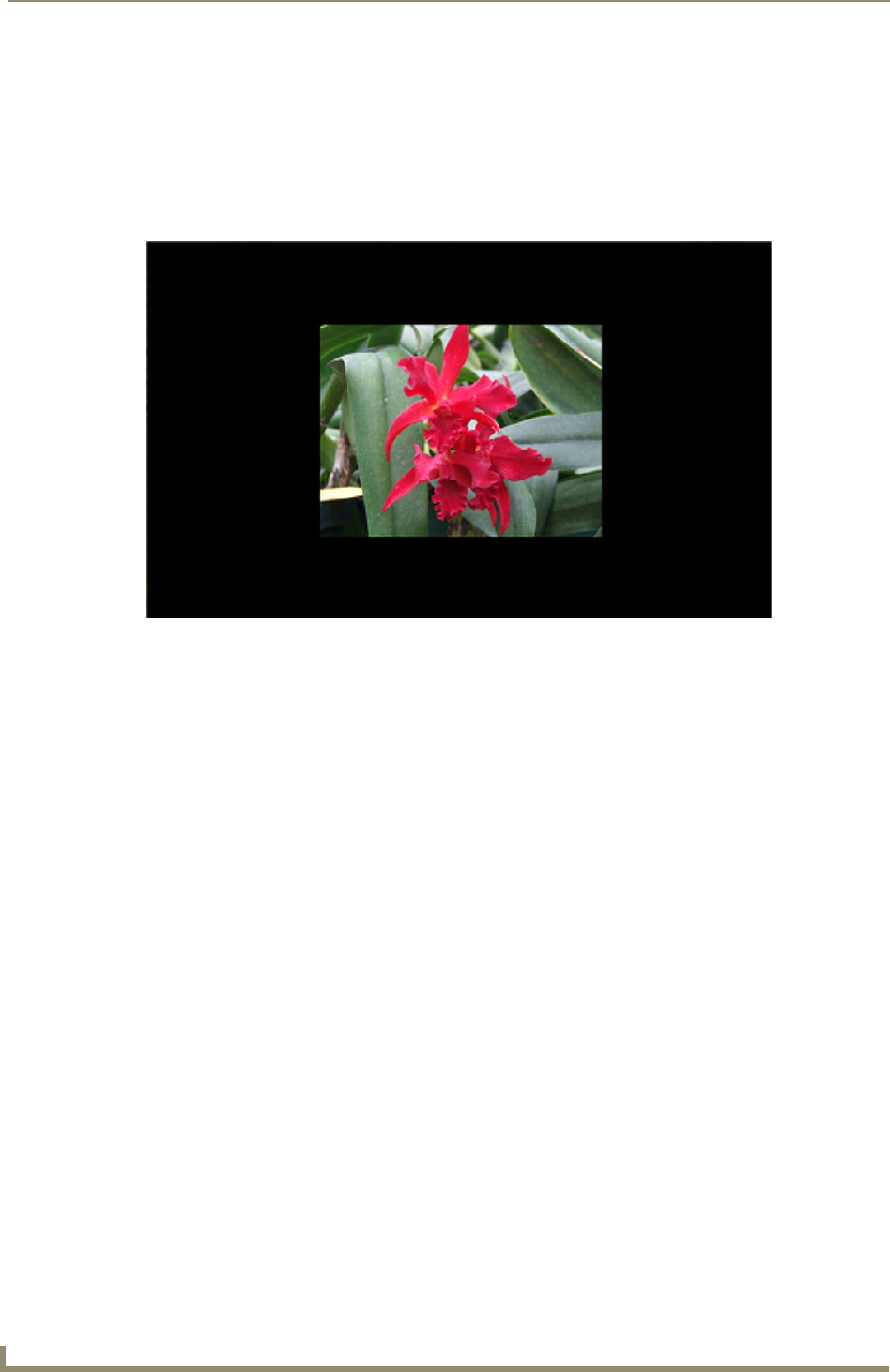
Introduction
6 MVP-9000i Modero® Wireless Touch Panel with Intercom
Picture View
Picture View is a new feature debuting with the MVP-9000i. Inserting a microSD memory card into the slot on
the left side of the device, or connecting a USB drive via the mini-USB port (FIG. 2), allows the MVP-9000i to
access JPEG images on that card and display them on the touchscreen (FIG. 3). Individual images may be
accessed at any time, or the entire collection may be displayed for predetermined times. Picture View may be
stopped at any time by removing the memory card or USB drive, and the MVP-9000i will return to its default
display page.
To start Picture View:
1. Connect a USB drive to the device or insert a microSD memory card into the microSD memory card slot.
Picture View will automatically recognize all available images on the drive or memory card and start
displaying them on the touchscreen.
FIG. 3 Picture View display
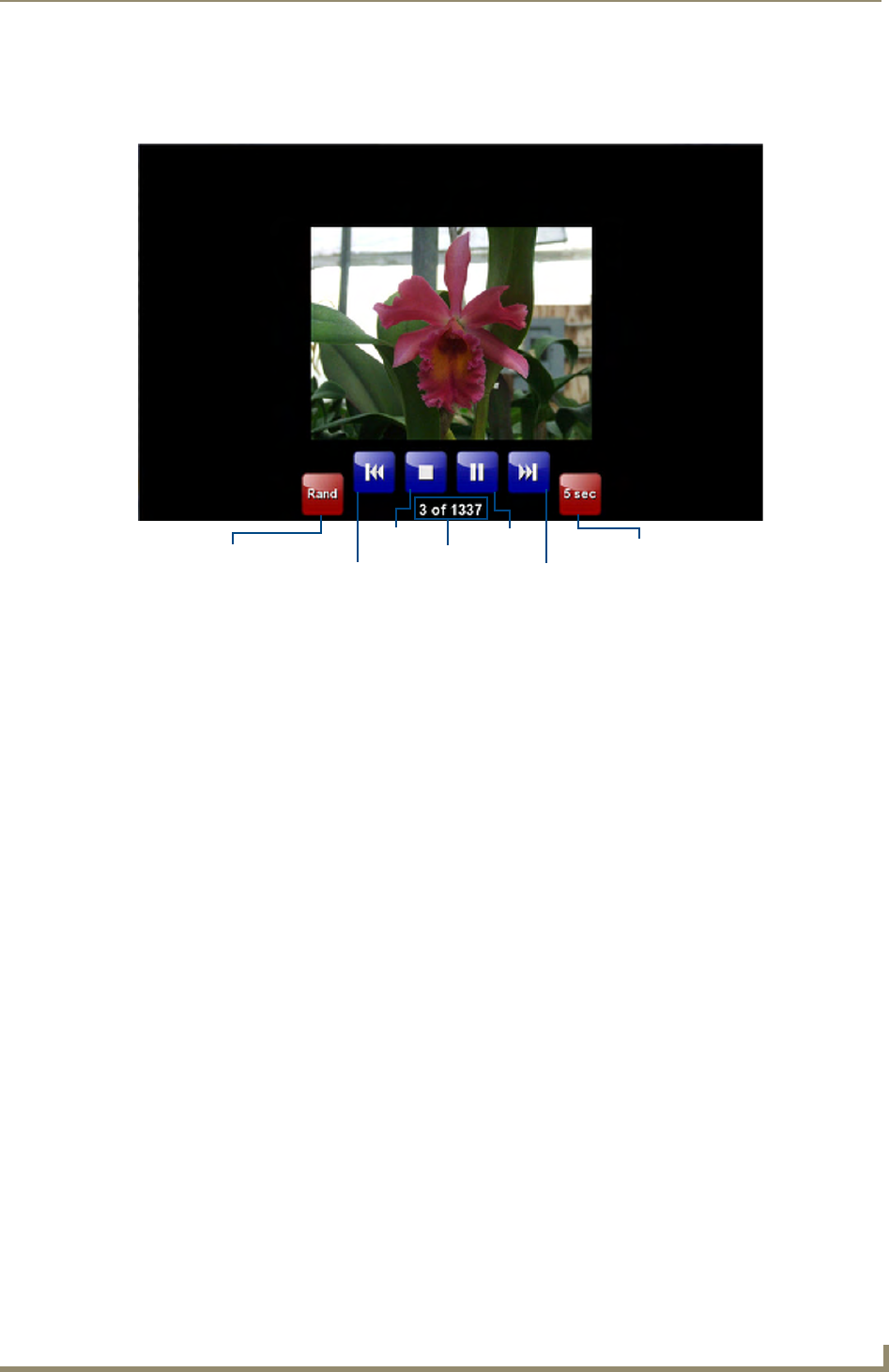
Introduction
7
MVP-9000i Modero® Wireless Touch Panel with Intercom
2. When the images begin to display, touch any place on the touchscreen to open the configuration popup
menu (FIG. 4). If no selection is made, this menu will remain in place for 15 seconds and then disappear.
It may be accessed again by touching anywhere on the touchscreen.
3. On the leftmost red button, select between Rand (images display at random) and A-Z (images display in
alphabetical order based on the name of the file).
4. The four blue buttons allow scrolling through saved images and the rate of display:
The First Image Saved button returns the display to the first image uploaded by Page View.
The Stop button stops Page View and returns to the default panel page.
The Pause/Resume button allows the display to stop on one particular image. Press it again to
resume the display procession.
The Last Image Saved button returns the display to the last image uploaded by Page View. If the
MPVP-9000i has not accessed all of the images available on a USB drive or memory card, Page
View will display the last one uploaded to date.
5. On the rightmost red button, select the number of seconds a selected image will be displayed in Picture
View. This may be selected between 5, 10, 15, 30, and 60 seconds.
6. The counter beneath the buttons displays the number of images currently uploaded by the MVP-9000i
versus the number detected on the USB drive or microSD card.
Preview Mode and Normal Mode
Picture View has two modes: Preview Mode and Normal Mode. Preview Mode allows the user to configure
Picture View. Once an SD card or a USB drive containing images is inserted into the panel, the images will
begin to display. Touching any place on the display will result in the configuration popup to slide from the
bottom of the display.
Picture View goes into its Normal Mode when the MVP-9000i goes into idle timeout while connected to a
USB drive or memory card. Normal Mode displays images until the touchscreen or capacitive touch buttons
are touched, or some other wakeup event is detected. When the device goes back into timeout, Normal Mode
will return to displaying images until the USB drive or memory card are removed from the device.
FIG. 4 Picture View configuration popup menu
First image
saved
Stop Pause/
Last image
saved
Counter Resume
Random/
A-Z
Timer

Introduction
8 MVP-9000i Modero® Wireless Touch Panel with Intercom
Picture View Send Command
Picture View may be enabled or disabled with the ^PIC Send Command. For more information, please refer to
the ^PIC section on page 137.
All images must be in JPEG format. PNG and other image formats cannot be viewed
through Picture View.
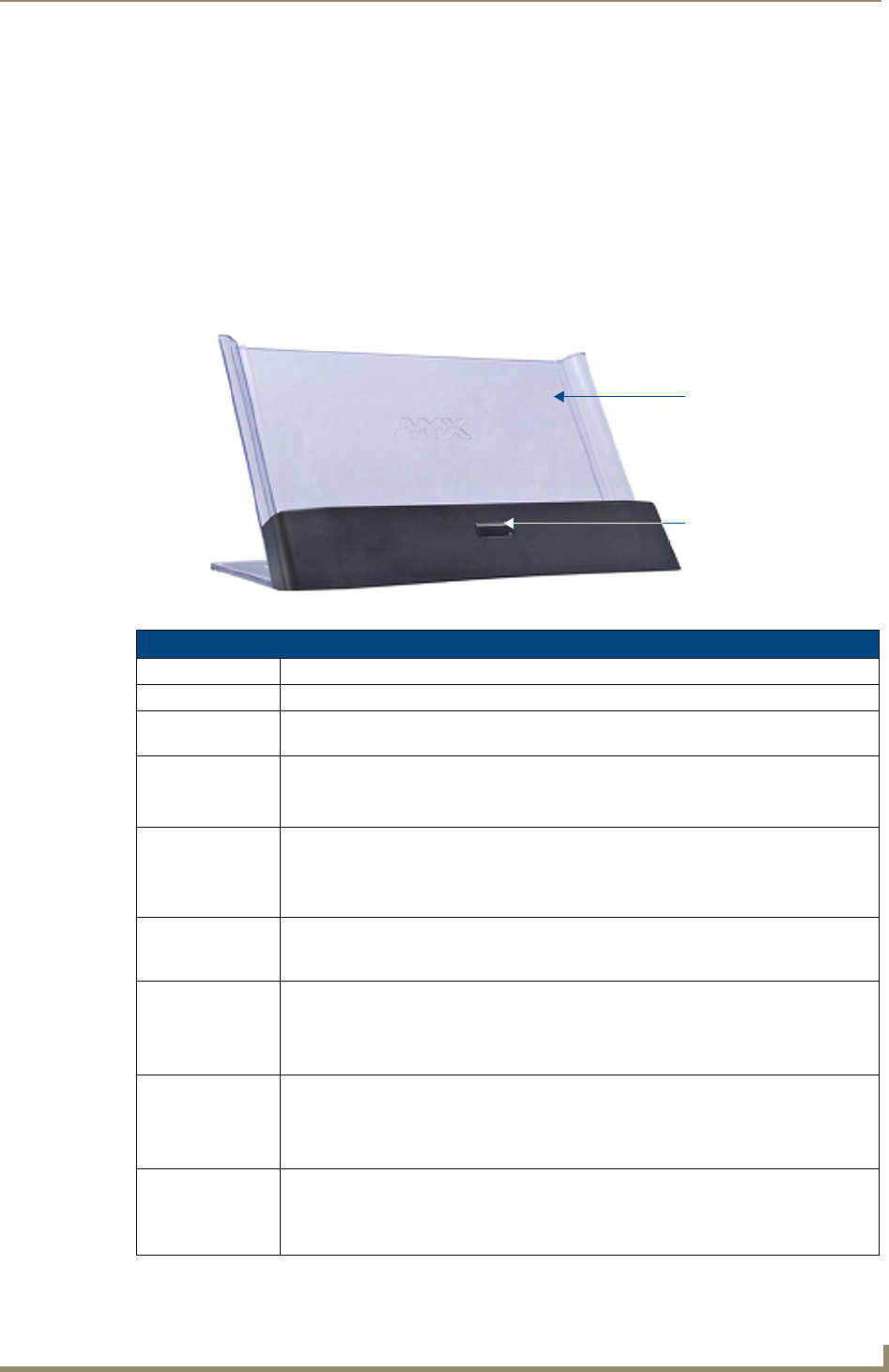
Accessories
9
MVP-9000i Modero® Wireless Touch Panel with Intercom
Accessories
Table Docking Station
The Power-over-Ethernet MVP-TDS-9 Table Docking Station (FIG. 5) charges the MVP-9000i and provides a
wired Ethernet connection when the panel is docked. The MVP-TDS-9's sleek design allows the panel to slide
into perfect placement in the docking station and includes password protection support for panel removal.
When the MVP-9000i is placed into the PoE docking station, it automatically switches from wireless to wired
Ethernet communication. The Docking Station is available in either black (MVP-TDS-9-GB, FG5967-10) or
white (MVP-TDS-9-GW, FG5967-11).
FIG. 5 MVP-TDS-9-GB Table Docking Station - Front
MVP-TDS-9 Specifications
Dimensions (HWD): • 6.25” x 11.50” x 5.50” (15.88cm x 29.21cm x 13.97cm)
Weight: • 1.25 lbs (.57 kg)
Power
Requirements:
• 3.0 W (Class II listed power supplemented), supplied via the PS-POE-AT High-Power
PoE Injector.
Startup Power
Requirements:
• Cradle and panel (not charging): 16 W
• Cradle and panel (charging): 23 W
• Ejection: 23 W
Front Components: • Docking Station cradle: for supporting the device while connected or charging.
• Release button: before removing the MVP touch panel, press this button to switch the
panel from a wired to a wireless Ethernet connection to its network.
• 12-pin charging connector on bottom of device cradle.
Rear Components: • 2 USB ports on the left side of the device, for firmware or file download to a docked
touch panel. These ports may also be used for using a keyboard and/or mouse with the
touch panel.
Operating/Storage
Environments:
• Operating Temperature: 0° C (32° F) to 40° C (104° F)
• Operating Humidity: 20% - 85% RH
• Storage Temperature: -20° C (-4° F) to 60° C (140° F)
• Storage Humidity: 5% - 85% RH
Included
Accessories
• MVP-TDS-9 Table Docking Station Installation Guide (93-5967-10)
• PS-POE-AT High Power PoE Injector (FG423-81)
• Ethernet cable - black (ECA5967-22BL) (for MVP-TDS-9-GB)
• Ethernet cable - white (ECA5967-22WH) (for MVP-TDS-9-GW)
Other AMX
Equipment:
• MVP-9000i Modero Viewpoint Widescreen Touch Panel with Intercom - Black
(FG5967-01)
• MVP-9000i Modero Viewpoint Widescreen Touch Panel with Intercom - White
(FG5967-02)
Docking Station cradle
Release button
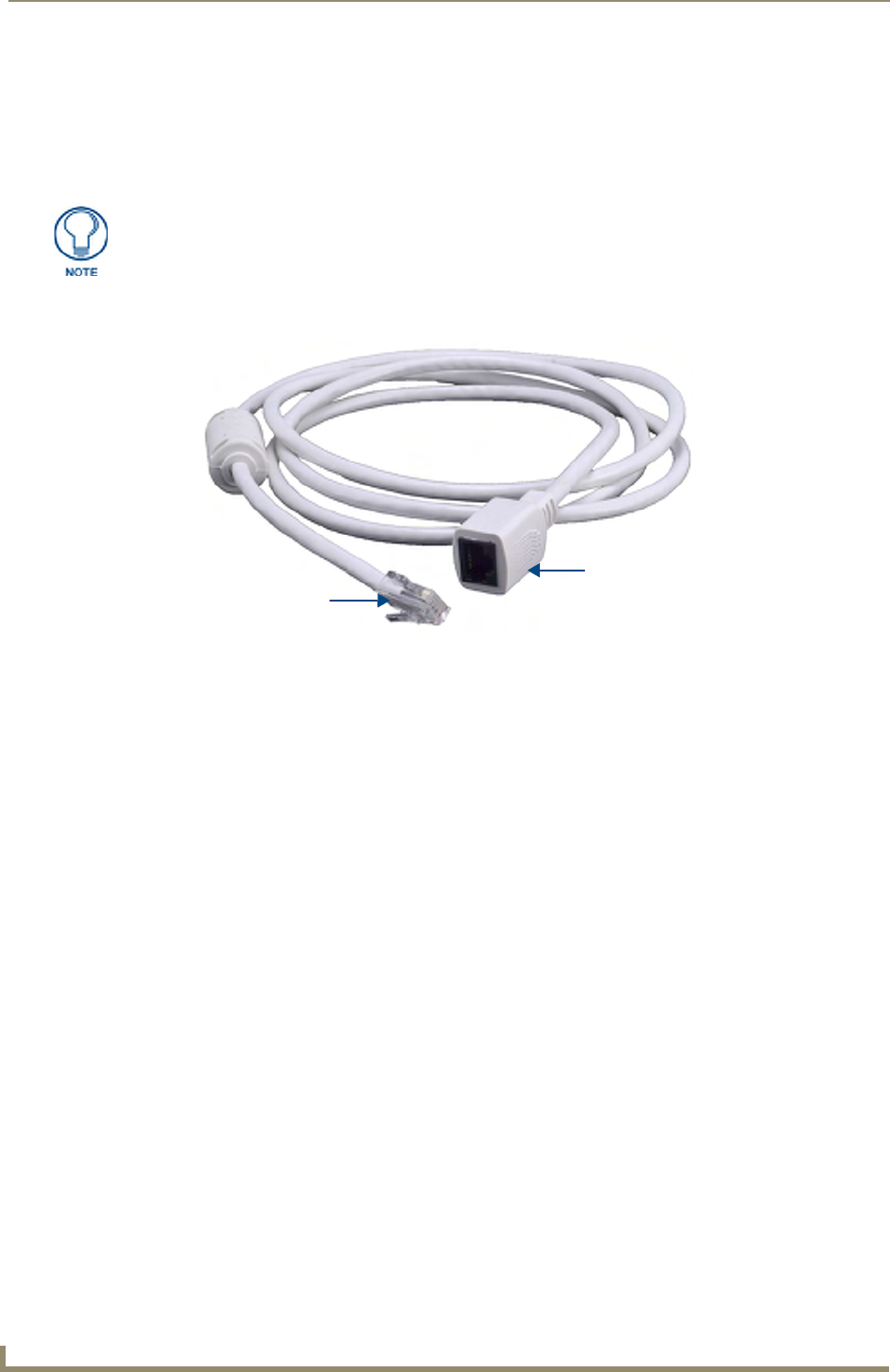
Accessories
10 MVP-9000i Modero® Wireless Touch Panel with Intercom
Powering the MVP-TDS-9
The MVP-TDS-9 uses the PS-POE-AT High-Power PoE Injector (FG423-81) to provide direct power for the
MVP panel via a standard Ethernet connection, both for standard function and for charging its internal battery.
This also allows a wired Ethernet connection for the panel, and the panel may be used normally while docked
in the MVP-TDS-9 without the need for a wireless connection.
For both Ethernet connection and for power for the MVP-9000i, the MVP-TDS-9 uses a special Ethernet cable
(FIG. 6) in order to connect to the PS-POE-AT.
To connect the MVP-TDS-9 to the PS-POE-AT via the special Ethernet cable:
1. Connect the terminal end of the cable to the PWR connector on the bottom of the MVP-TDS-9.
2. To prevent wear on the power supply cord and assure that the device’s base is in full contact with the table
surface, press the cord into the locking groove running across the bottom of the device (FIG. 7).
3. The other end of the included Ethernet cable has an input port, intended for a standard RJ45 jack. Use a
standard Ethernet cable to connect the Ethernet/PoE port to the PS-POE-AT plugging the other end of the
Ethernet cable into the Data & Power Out RJ45 port on the PS-POE-AT. Make sure that the PS-POE-AT’s
power cable is connected to the device and to an available power source, and that the incoming Ethernet
cable accessing the Data In RJ45 jack is connected to the desired network.
4. Place the touch panel in the Docking Station cradle, guiding it into place with the locking grooves on each
side of the cradle (FIG. 7). When fully seated, the touch panel’s Docking Station connector should be in
contact with the Docking Station’s charger pins.
Use only the RJ45 plug on the included Ethernet cable with the MVP-TDS-9. Other
RJ45 plugs will not fit in the device’s jack, and attempting to use another plug may
damage the jack. If necessary, the cable may be spliced and shortened for special
installations.
FIG. 6 MVP-TDS-9 cable
To input port on
the MVP-TDS-9
To Ethernet cable connected
to PS-POE-AT
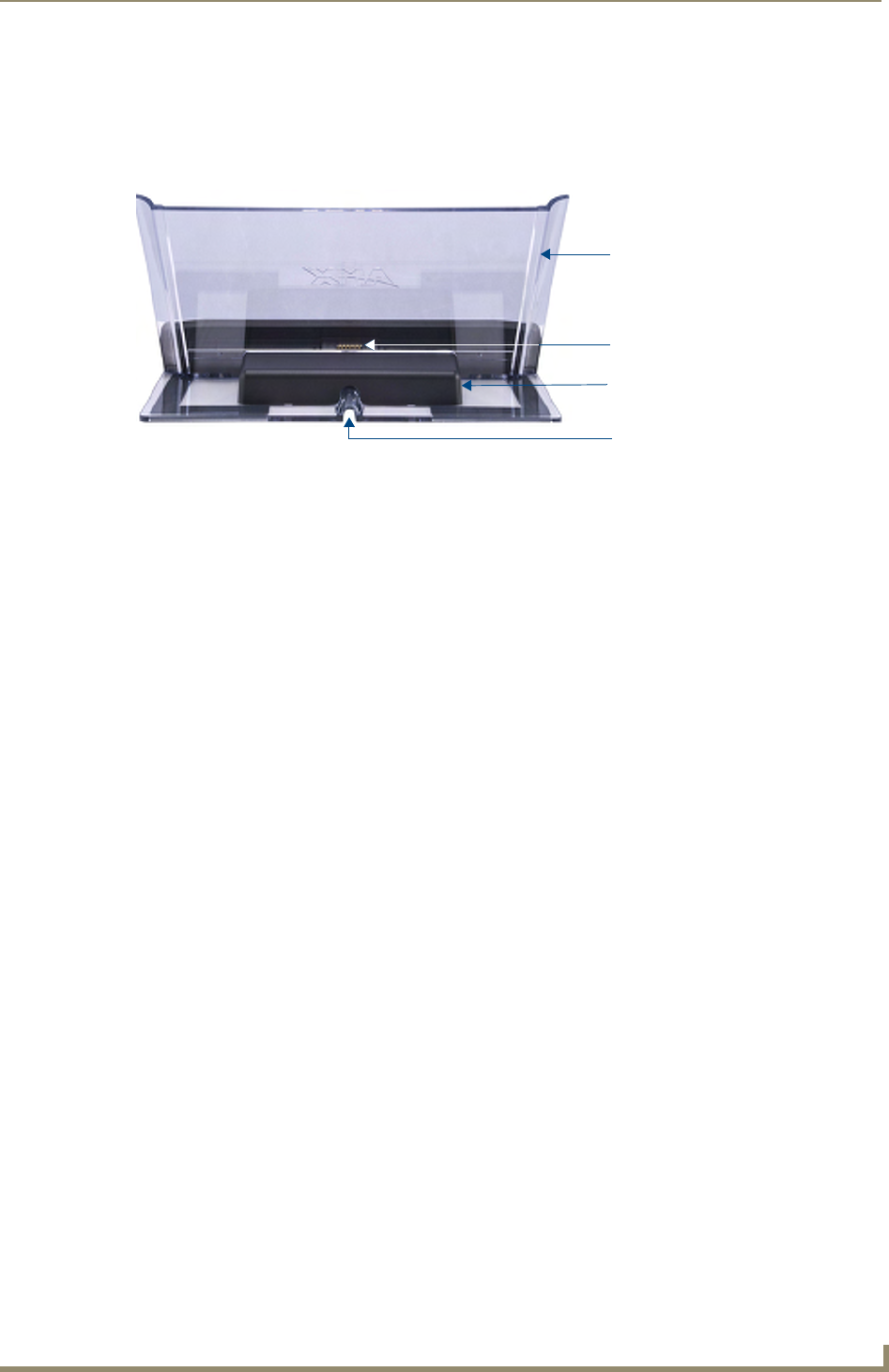
Accessories
11
MVP-9000i Modero® Wireless Touch Panel with Intercom
Recharging
To recharge the MVP-9000i, slide the device into the Table Docking Station cradle bottom-first and make sure
the device is fully seated in the Docking Station. The charger pins in the bottom of the cradle (FIG. 7) must be
in contact with the connector on the bottom of the MVP-9000i for it to start recharging. The MVP panel will
stop recharging automatically once the battery has achieved its maximum charge.
Using the USB ports
The MVP-TDS-9 has two USB ports on the left of the device behind the Docking Station cradle (FIG. 7).
These ports may be used for transferring files to the MVP-9000i, as well as ports for USB-powered
accessories.
Cleaning the MVP-TDS-9
You should clean the MVP-TDS-9 Table Docking Station after each day’s use to maintain the device’s
appearance. Always use a clean cotton cloth and a spray bottle containing water or a non-ammonia-based
cleaner, as alcohol-based cleaners can damage the device. Do not directly spray the device: instead, spray the
cloth to prevent moisture from collecting on the charger pins. Do NOT use an abrasive of any type to clean the
Table Docking Station, as this may permanently damage or remove the device’s finish.
FIG. 7 MVP-TDS-9-GW Table Docking Station - Rear
Charger pins
Docking Station cradle
Locking groove
USB ports (2)
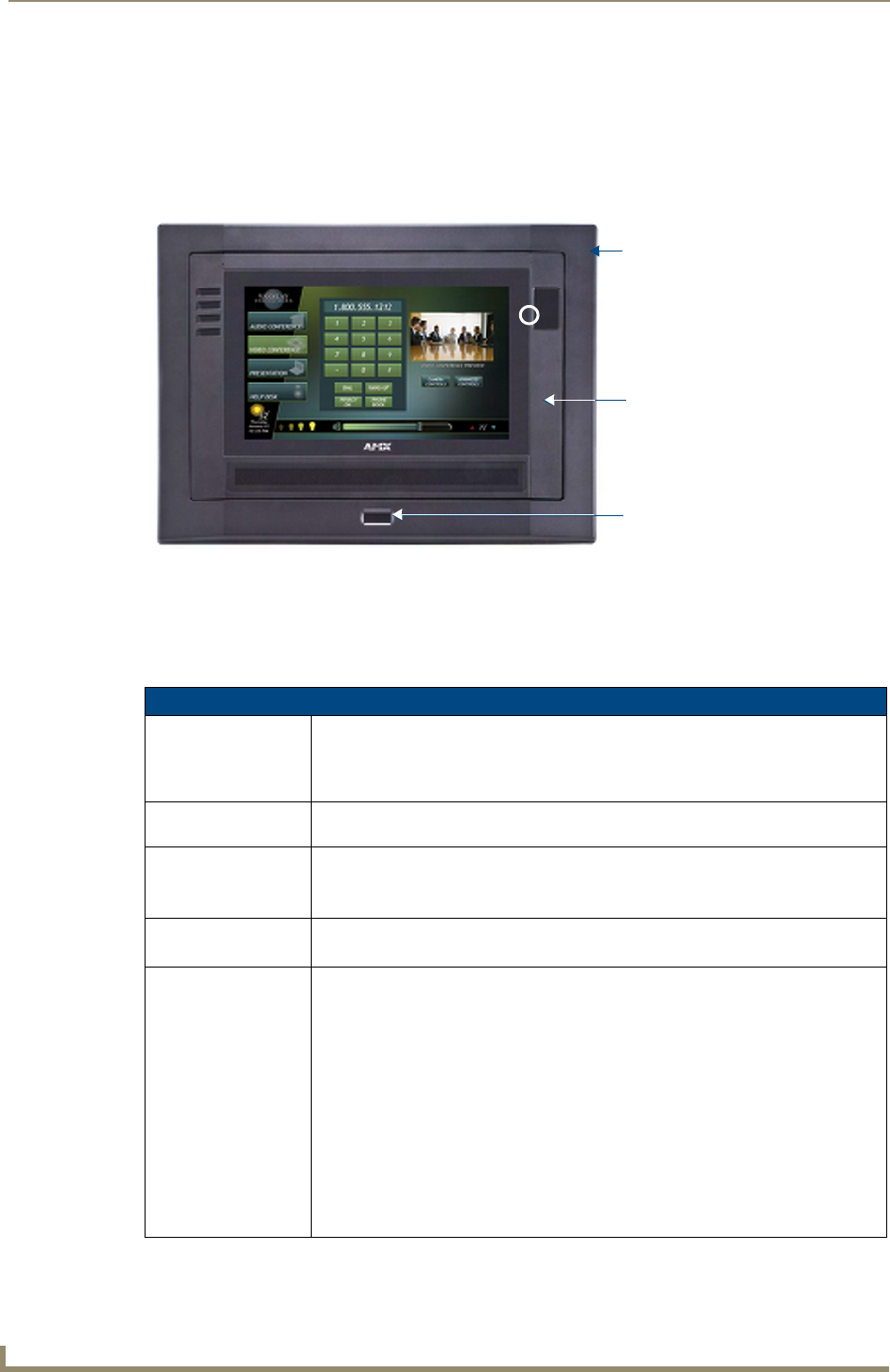
Accessories
12 MVP-9000i Modero® Wireless Touch Panel with Intercom
Wall Docking Station
While charging the MVP-9000i, the Power-over-Ethernet MVP-WDS-9 Wall/Flush Mount Docking Station
provides fast, reliable wired Ethernet communication to the touch panel. In addition, the MVP-WDS-9
employs a unique, anti-theft locking mechanism to keep the touch panel safe and secure. With a push of a
button, the panel glides forward for simple removal and transport. The Wall Docking Station is available in
either white (FG5967-13) or black (FG5967-12).
The features of the MVP-WDS-9 include:
Full charging of a docked MVP-9000i in approximately 5 hours
Touch panel password feature for security
Integrated docking alignment guides for easy docking.
FIG. 8 MVP-WDS-9-GB Wall Docking Station - Front
MVP-WDS-9 Specifications
Dimensions (HWD): • 9.75" x 12.50" x 2.13" (24.77cm x 31.75cm x 5.40cm)
Note: Always use the cutout/installation dimensions for the MVP-WDS-9 when
installing this unit into various surfaces. This SP engineering drawing is available
online at www.amx.com.
Power Requirements: • 3.0 W (Class II listed power supplemented), supplied via the PS-POE-AT High-
Power PoE Injector.
Startup Power
Requirements
• Cradle and panel (not charging): 16 W
• Cradle and panel (charging): 23 W
• Ejection: 23 W
Weight: • Without back box: 1.50 lbs (0.68 kg)
• With back box: 2.40 lbs (1.09 kg)
Front Panel
Components:
• Securing Magnets: Secures MVP touch panel during ejection.
• Security Latch: Adds the primary layer of security when mounting an MVP touch
panel. When the device is inserted, this latch grabs onto the rear of the touch panel
and secures it to prevent it from inadvertently being removed.
• Interface Connector: A set of contacts that connect to the underside MVP connector
strip. This connection provides both communication and power between the touch
panel and the MVP-WDS-9.
• Support Cradle: This retractable mechanism supports a resting MVP panel and
allows a user to either insert or remove a connected MVP panel.
• Security Release pushbutton: Located on the front of the unit, this pushbutton
toggles an on-screen security keypad if security is enabled.
- Entering the correct release code allows the MVP-WDS-9 to release the touch
panel from the security latch.
Security Release button
MVP-9000i
MVP-WDS-9
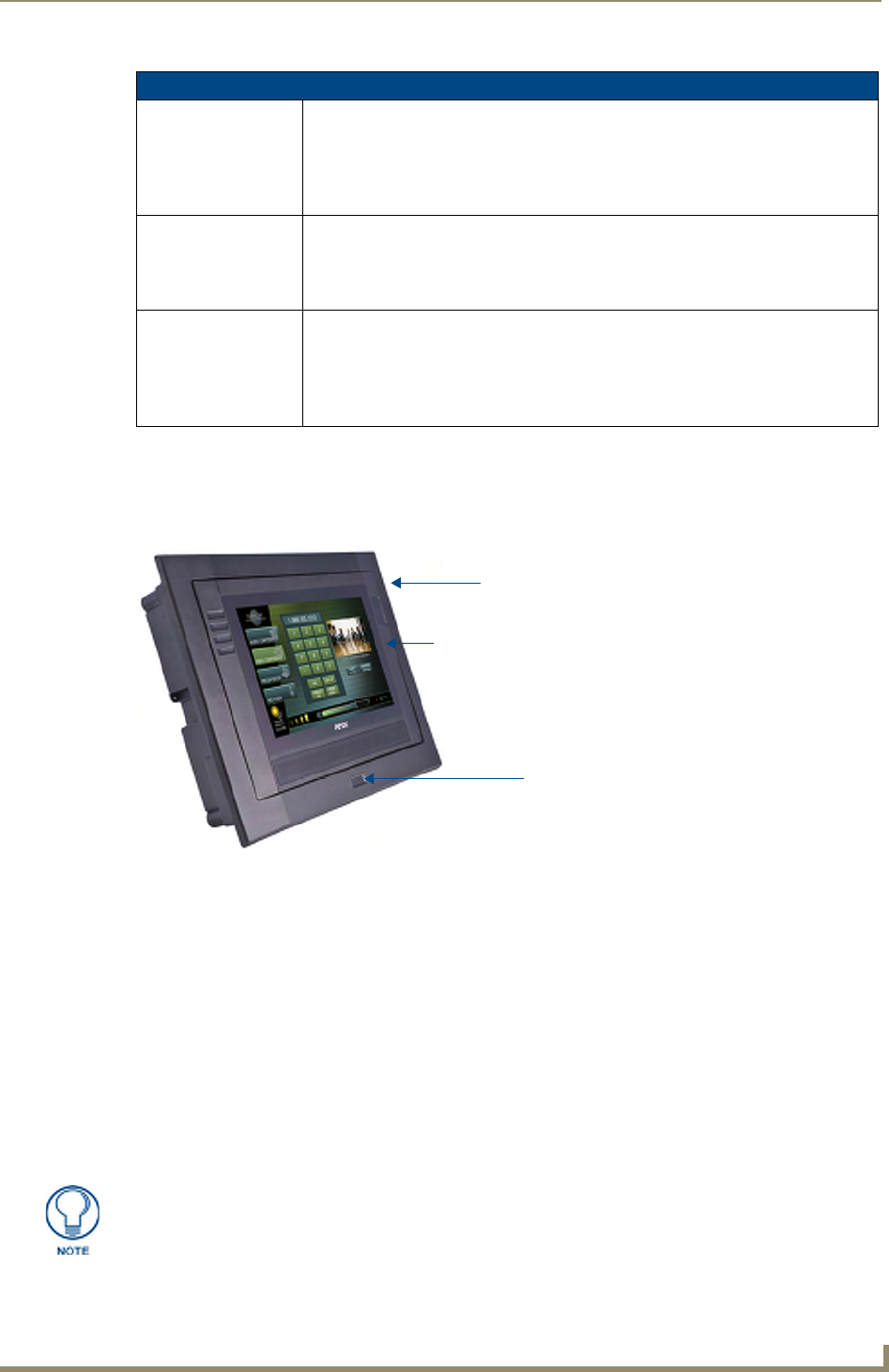
Accessories
13
MVP-9000i Modero® Wireless Touch Panel with Intercom
The MVP-9000i touch panel remains locked in the MVP-WDS-9 until unlocked by the user. This may be done
by entering an appropriate password (please refer to the Passwords section on page 90 for more information),
or by pressing the Security Release button on the front of the device in emergencies. The station ejects the
device top first. The device uses two neodymium rare-earth magnets to keep the MVP-9000i from falling out
of its cradle when the touch panel is angled forward.
Unlocking the Touch Panel
Once placed within the Wall Docking Station, the MVP-9000i remains secured until the user unlocks it. A ten-
second lag between the touch panel being placed in the Wall Docking Station and the security feature enabling
allows the user to remove the touch panel if it is accidentally put into the device. To release the touch panel
from the Wall Docking Station:
1. Press the Security Release button (see FIG. 9).
2. A password keypad will pop up on the MVP-9000i screen. Enter a password in the password keypad and
press Enter.
3. Wait for the Wall Docking Station to pivot the touch panel away from the wall (FIG. 10).
4. The device will remain in the ejected position until the MVP-9000i is removed. Wait until the device’s
ejection door has completely withdrawn before re-installing the MVP-9000i.
MVP-WDS-9 Specifications (Cont.)
Operating/Storage
Environments:
• Operating Temperature: 0° C to 40° C
• (32° F to 104° F)
• Operating Humidity: 20% - 85% RH
• Storage Temperature: -20° C to 60° C (-4° F to 140° F)
• Storage Humidity: 5% - 85% RH
Included Accessories • MVP-WDS-9 Wall Docking Station Installation Guide (93-5967-12)
• Snap-On Ferrite (04-0007)
• MVP-WDS-9 Wall Docking Station Template (68-5967-01)
• PS-POE-AT High Power PoE Injector (FG423-81)
Other AMX Equipment: • MVP-9000i-GB Modero Wireless Touch Panel, Black (FG5967-01)
• MVP-9000i-GW Modero Wireless Touch Panel, White (FG5967-02)
• MVP-TDS-9-GB Black Table Docking Station (FG5967-10)
• MVP-TDS-9-GW White Table Docking Station (FG5967-11)
• CB-MVP-WDS9 Rough-In Box (FG038-13)
FIG. 9 MVP-WDS-9-GB Wall Docking Station - Side view
MVP-9000i
Wall Docking Station
Security Release button
Unique passwords may be entered for up to four unique users as well as the
administrator. For more information on setting passwords, please refer to the
Passwords section on page 90.
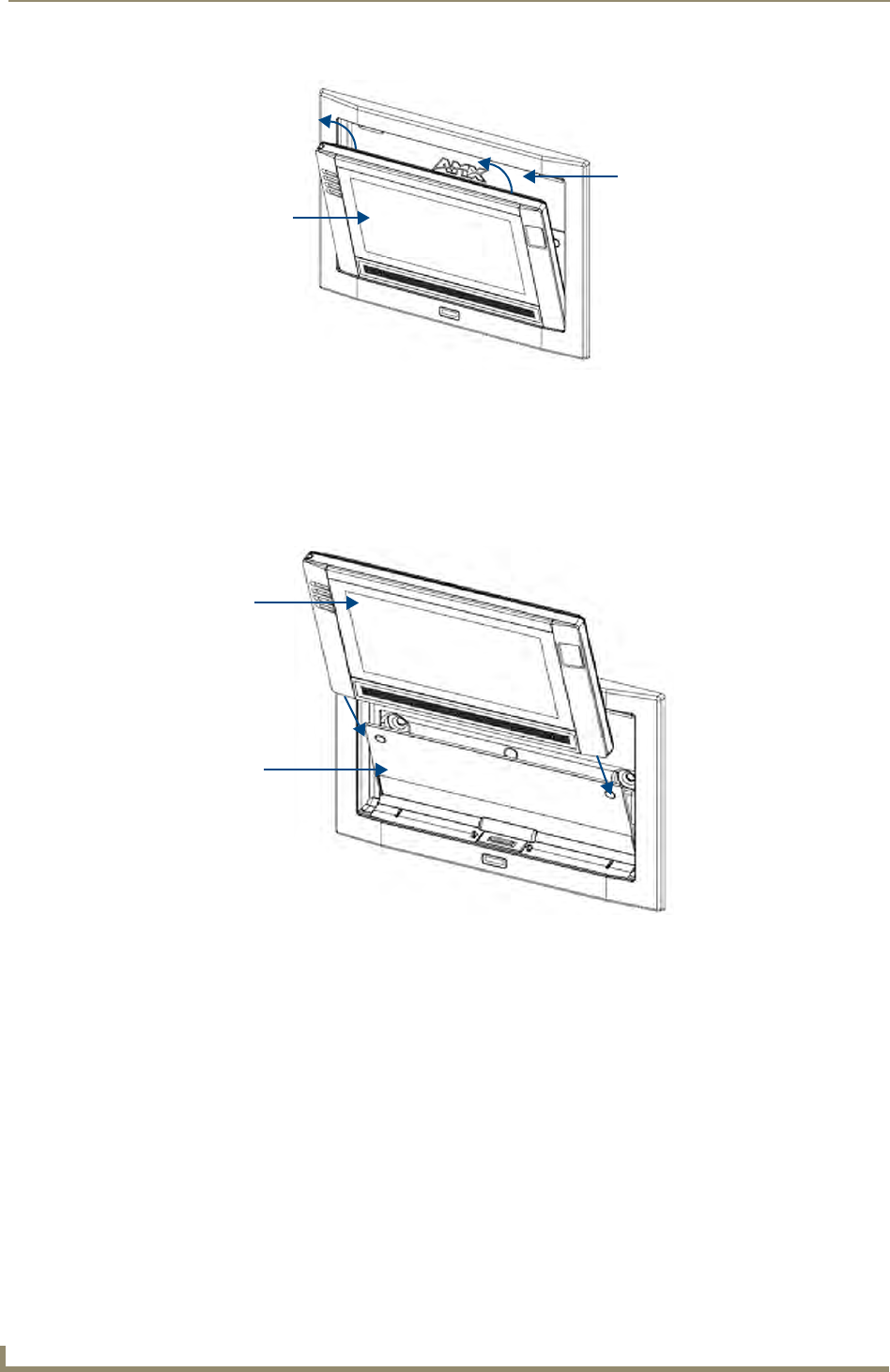
Accessories
14 MVP-9000i Modero® Wireless Touch Panel with Intercom
Recharging
To recharge the MVP-9000i:
1. Slide the device into the Wall Docking Station cradle bottom-first and make sure the device is fully seated
in the Docking Station (FIG. 11).
2. Press the top of the MVP-9000i back until it clicks. The touch panel is now locked into the Docking
Station, and the station will automatically charge the device’s battery. (Please refer to the Power
Management Page section on page 51 to check on the battery charge status.)
3. To release the touch panel, unlock the touch panel and wait for the Wall Docking Station to pivot the
touch panel away from the wall (FIG. 10).
FIG. 10 Ejected position for the MVP-9000i
FIG. 11 Inserting the MVP-9000i into the MVP-WDS-9
MVP-9000i
MVP-WDS-9
MVP-9000i
MVP-WDS-9
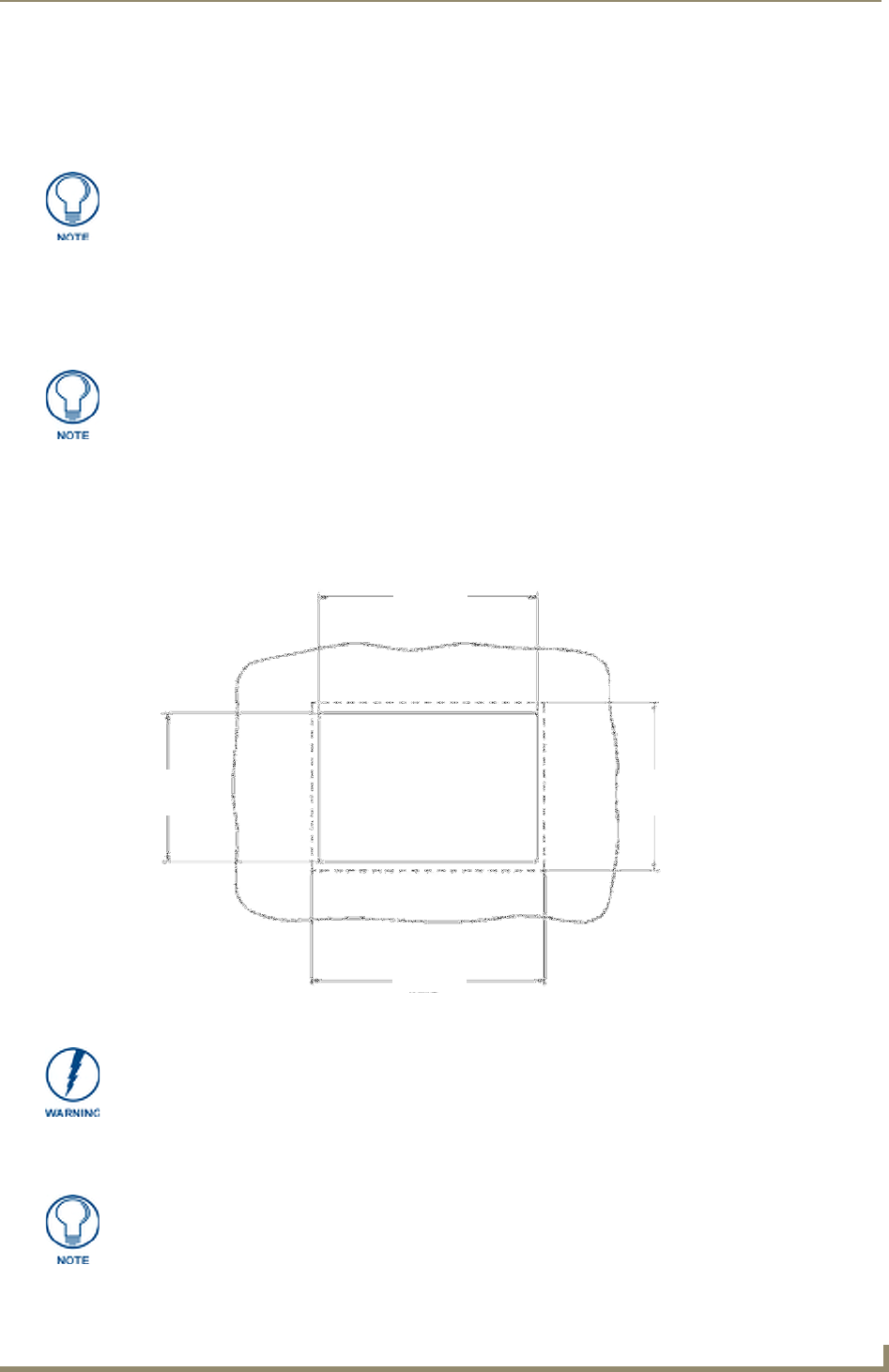
Accessories
15
MVP-9000i Modero® Wireless Touch Panel with Intercom
Installing the MVP-WDS-9
Since the Wall Docking Station is intended to be affixed to a wall or other permanent structure, care must be
taken to ensure its proper installation to prevent potential damage to the MVP-9000i placed within.
Installing the Wall Docking Station and Plastic Back Box
The Plastic Back Box has two pairs of knockouts at the top of the box and four (4) lockdown wings attached to
the box with Phillips-head screws. For ease of installation, the interior of the box contains an “UP” arrow
pointing to the knockouts.
To install the Plastic Back Box:
1. Cut a hole into the wall or surface intended to hold the back box. The back box is sized 12 1/16 inches
(30.64 cm) long and 8 11/16 inches (22.07 cm) high, so the hole should be at least 1/4” (6.4mm) smaller
in each dimension (FIG. 12). Use the included MVP-WDS-9 Wall Docking Station Template (68-5967-
01) as an aid for hole placement and measurement.
2. Select the knockout to be removed from the top of the box. The box has two knockouts, at the top left and
the top right.
Other than wall installation tools, the only tool required for this installation is a #2
Phillips screwdriver.
The optional CB-MVP-WDS9 Metal Rough-In Box is not required for installation of
the supplied Plastic Back Box, but it offers an extra level of support.
FIG. 12 Recommended cutout for the MVP-WDS-9 plastic back box
8.25"
(212.7mm
(212 7mm)
5.56"
(141.29mm)
5.56"
(141.29mm)
8.25"
12.06"
(30.64 cm)
12.06"
(30.64 cm)
8.69"
(22.07 cm)
8.69"
(22.07 cm)
Make sure to measure the size of the intended hole before starting to cut it. Cutting
the hole slightly smaller than the dimensions to allow for adjustments is highly
recommended.
To assist with wiring, and to avoid mechanical stresses on the wire and the
mechanism of the Wall Docking Station, the top left knockout, when viewing the
device from the rear, is preferred for use for Ethernet installation. Use the top right
knockout for USB cable connection.
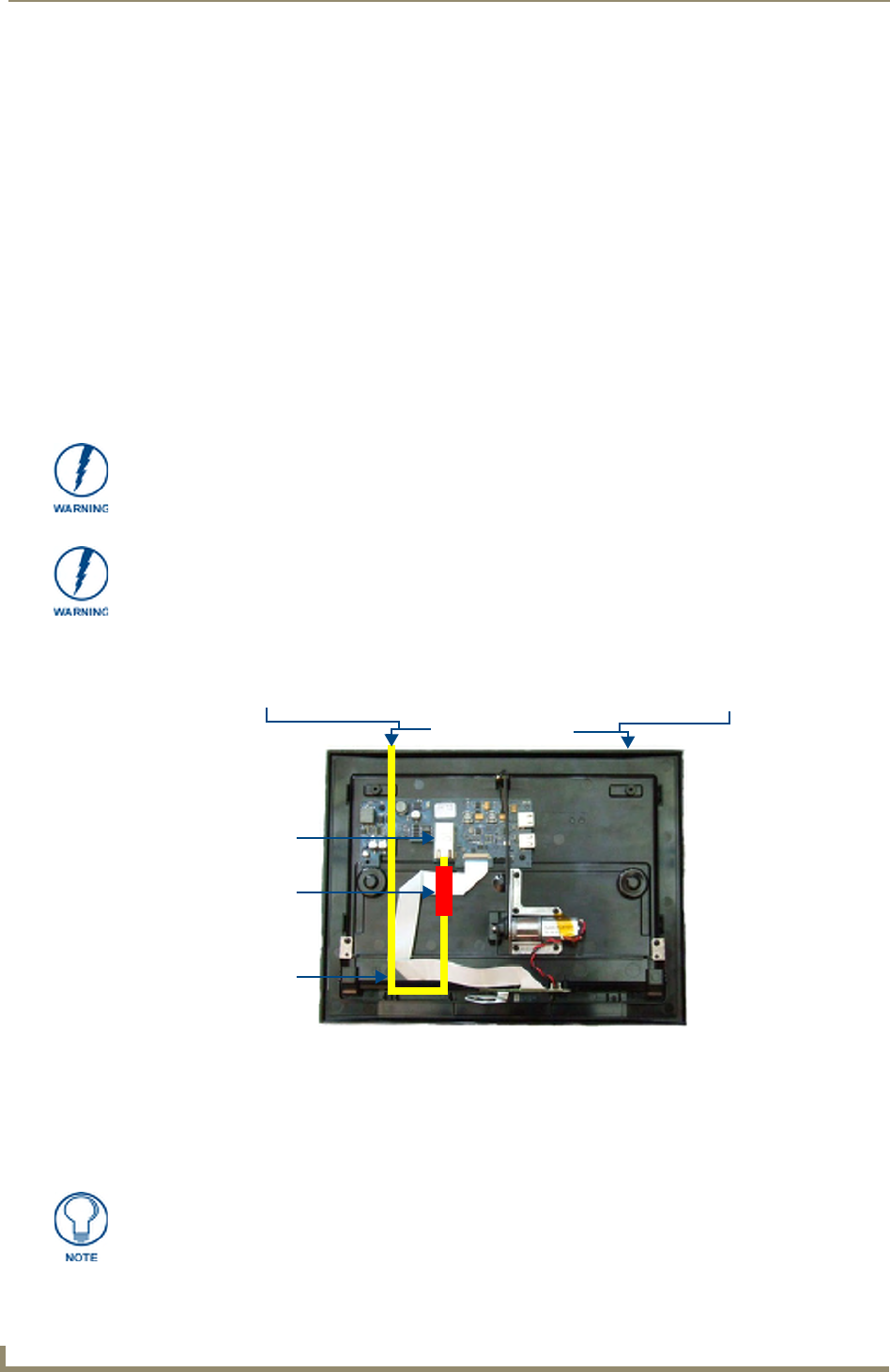
Accessories
16 MVP-9000i Modero® Wireless Touch Panel with Intercom
3. Connect the PS-POE-AT High-Power PoE Injector to a power source. Connect the PS-POE-AT to an
Ethernet switch on the network via one length of Ethernet cable and insert one length of Ethernet cable
for connection to the Wall Docking Station.
4. Run the Ethernet cable through the knockout into the back box. Pull out about six inches (15.25cm) of
cable into the back box to facilitate installation of the MVP-WDS-9.
5. Slide the plastic back box into the hole, being careful not to twist or pinch the cable, and set it flush with
the wall.
Make sure that all of the lockdown wings are folded into their slots before attempting to insert the
box.
For ease of installation, the inside of the box has the direction “UP” labeled for reference.
6. Extend the wings on the sides of the box by tightening the screws inside the box.
Not all of the wings must be extended to lock the box in place, but extending a minimum of the top
and bottom wings is highly recommended.
Apply enough pressure to the screw head to keep the box flush with the wall: this ensures that the
wing will tighten up against the inside of the wall.
7. Attach the included snap-on ferrite to the Ethernet cable, as close to the RJ-45 connector as possible.
Attach the cable to the Ethernet Port (FIG. 13).
8. Firmly seat the device against the back box. Make sure that the tab connector at the bottom of the device
is locked into the back box.
9. Insert the two installation screws from the MVP-WDS-9 Installation Kit into the screw holes in the
interior compartment of the device and tighten them to anchor the device to the back box.
Make absolutely certain that the box is in its intended position. Once the box
lockdown wings are extended within the box’s hole within the wall, removing the box
will be extremely difficult without damaging the wall in the process.
The maximum recommended torque to screw in the wings on the plastic back box is
5 IN-IBS [5(NI-CM)]. Applying excessive torque while tightening the wing screws,
such as with powered screwdrivers, can strip out the wings or damage the plastic
back box.
FIG. 13 MVP-WDS-9 - Ethernet cable path
Knockout placement
in back box
Recommended Ethernet installation Recommended USB installation
Ethernet port
Ferrite installation
position
Recommended
Ethernet cable
path
For ease of installation, put each screw on a neodymium magnet in the device’s
interior compartment to keep them on hand until they are needed.

Accessories
17
MVP-9000i Modero® Wireless Touch Panel with Intercom
10. After fully seating the screws, wipe down the area around the screw holes with the alcohol prep pad from
the Installation Kit. Take a rubber foot and remove its adhesive backing. Put the foot, adhesive-side down,
in the slot surrounding the screw hole in the Wall Docking Station. Press down firmly to remove any air
bubbles from underneath the foot.
11. Install an MVP-9000i device by placing it into the interior compartment bottom-first. Press the top of the
touch panel until it is flush with the Wall Docking Station. The neodymium magnets will hold it in place.
12. To remove the MVP-9000i, unlock the touch panel (see the Unlocking the Touch Panel section on page 13
for more information) and wait for the touch panel to pull away from the Wall Docking Station. Once it
has been released, grip it by the top of the device, and pull it free from the Docking Station.
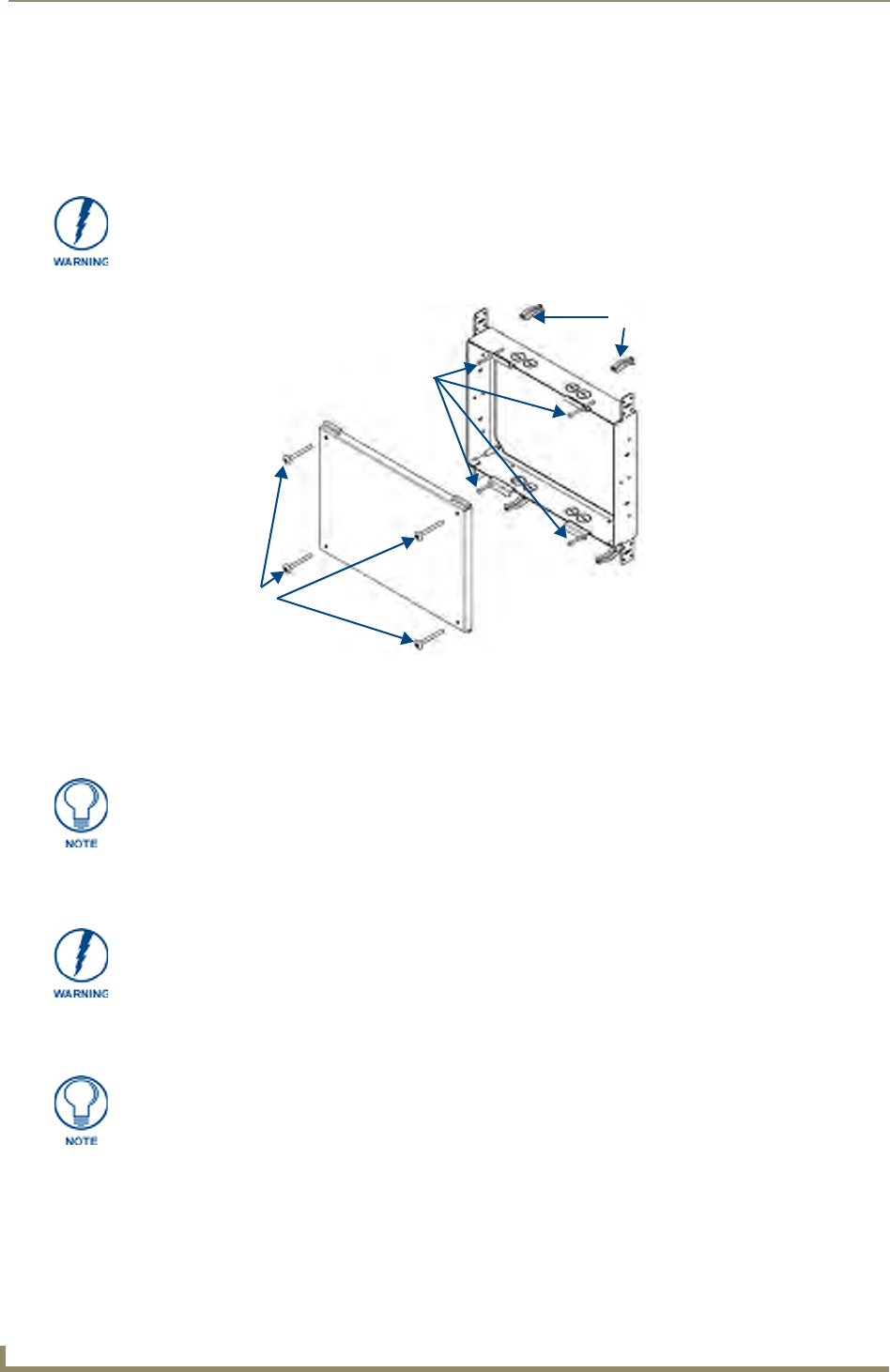
Accessories
18 MVP-9000i Modero® Wireless Touch Panel with Intercom
Installing the Optional Metal Rough-In Box
The optional metal rough-in box (FG038-13) is 11.97 inches (30.40cm) wide at its widest dimension (wider
than the bezel of the Wall Docking Station), and is only intended for pre construction installations (FIG. 14).
The Metal Rough-In Box is used in conjunction with the Wall Docking Station’s plastic back box.
.
Pre-Wall Installation of the CB-MVP-WDS9
1. Remove the rough-in box cover (A in FIG. 14) before installation of the Rough-In Box (B).
2. Fasten the CB-MVP-WDS9 rough-in box to the stud through the holes on the Stud Mounting Tabs, using
either nails or screws (not provided).
3. Remove the appropriate wiring knockouts from the rough-in box to accommodate the cables being
threaded through to the MVP-WDS-9.
4. Thread the incoming Ethernet and USB wiring through the knockouts. Using the left wiring knockouts
for USB connector cables and the right wiring knockouts for the LAN/PoE In cable is very highly
recommended with this installation. Leave enough slack in the wiring to accommodate installation of the
docking station.
5. Install the drywall/sheetrock before inserting the back box for the CB-MVP-WDS9.
In order to guarantee a stable installation of the MVP-WDS-9, the distance between
the CB-MVP-WDS9 and the outer wall surface must be a minimum of .50 inches
(1.27cm) and a maximum of .1.50 inches (3.81cm).
FIG. 14 CB-MVP-WDS9 Rough-In Box - with front cover
Screws for
Dry Wall Clips
Front Cover
Mounting Screws
Dry Wall Clips
A
B
The cover MUST be removed before drywall installation. The cover may be
reinstalled after drywall installation using 4-40 screws (not included).
Ensure that the metal rough-in box is flush with the 2x4 studs. Any overhang will
affect the installation of the covering sheetrock, as well as affect the placement of the
Plastic Back Box.
Make sure that the power cable has been pulled through the metal rough-in box by
the resident electrician before continuing the installation.

Accessories
19
MVP-9000i Modero® Wireless Touch Panel with Intercom
6. Cut out the opening for the MVP-WDS-9 where the wall has been placed over the Rough-In Box. Cutting
out the surface slightly smaller than what is outlined in the installation drawings, so that you can make
any necessary cutout adjustments, is very highly recommended.
Other MVP-WDS-9 installations
The Wall-Mounted Docking Station is designed to be installed in various different locations, such as into the
face of a wooden podium or the top of a table. Depending upon the ability to wire it to a power source, Wall-
Mounted Docking Stations may be installed on vertical or horizontal surfaces composed of such materials as
wood, brick, and glass.
Installing a Wall-Mounted Docking Station into a solid wall thicker than a standard thickness of sheetrock is
possible, but requires special preparation. If installing into a solid wall of concrete or rock, a recess must be
chiselled or cut out to match the size of the device. The box is sized 8.375 inches (21.27cm) long and 5.75
inches (14.60cm) high, so the hole should be at least 1/4” (0.64cm) smaller in these dimensions. To facilitate
the full range of movement of the device’s components, the recess must be at least 2.69 inches (6.83cm) deep.
Ensure that the power cable has been installed in the wall and is accessible by the
installer before chiseling out the recess.
Instead of using the lockdown wings to secure the Plastic Back Box, standard
concrete screws may be inserted through the screw holes after removing the
lockdown wings.
However, drill the concrete screw holes into the wall before setting the screws into the
box, as excessive torque applied to the screws will damage the box.
To avoid this, the box may be installed with adhesive. Test an unobtrusive spot on the
back of the box with a sample of the adhesive to check for any adverse reactions
before installing the device.

Accessories
20 MVP-9000i Modero® Wireless Touch Panel with Intercom
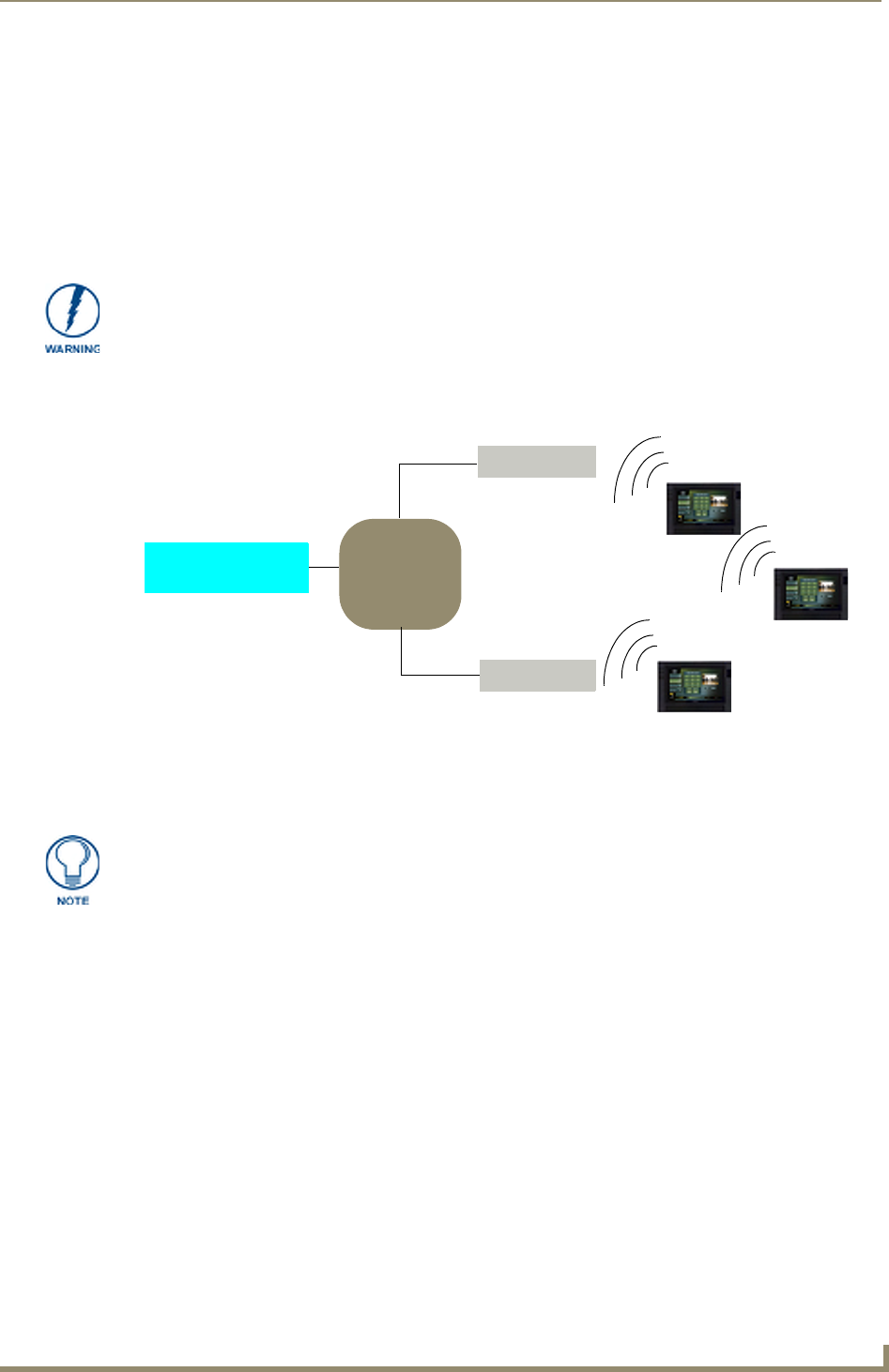
Configuring Communication
21
MVP-9000i Modero® Wireless Touch Panel with Intercom
Configuring Communication
Overview
All control for a MVP-9000i touch panel is established through a NetLinx Master. Communication between
the MVP and the Master consists of using wired LAN (Static IP only), Wireless Ethernet (DHCP, Static IP) or
USB. References to Ethernet in this manual focus on the use of Wireless Ethernet via the MVP’s WiFi Card.
In the example below (FIG. 15), three MVP-9000i devices are shown at varying distances from the two WAP
gateways. As with any other WAP network, the gateways are spaced so as to allow a maximum wireless
coverage for the three devices.
When initially installing the MVP-9000i, some basic configuration items, including network settings and
NetLinx settings, will need to be set. For more information, refer to the Protected Setup Pages section on
page 59.
Before commencing, verify you are using the latest NetLinx Master and Modero
panel-specific firmware. Verify you are using the latest versions of AMX’s NetLinx
Studio and TPDesign4 programs.
FIG. 15 System Deployment Diagram
Network Master IP
Network
802.11a/b/g WAP
802.11a/b/g WAP
Panel 1
Panel 2
Panel 3
The MVP-9000i defaults to Ethernet and Auto mode for its Master connection.
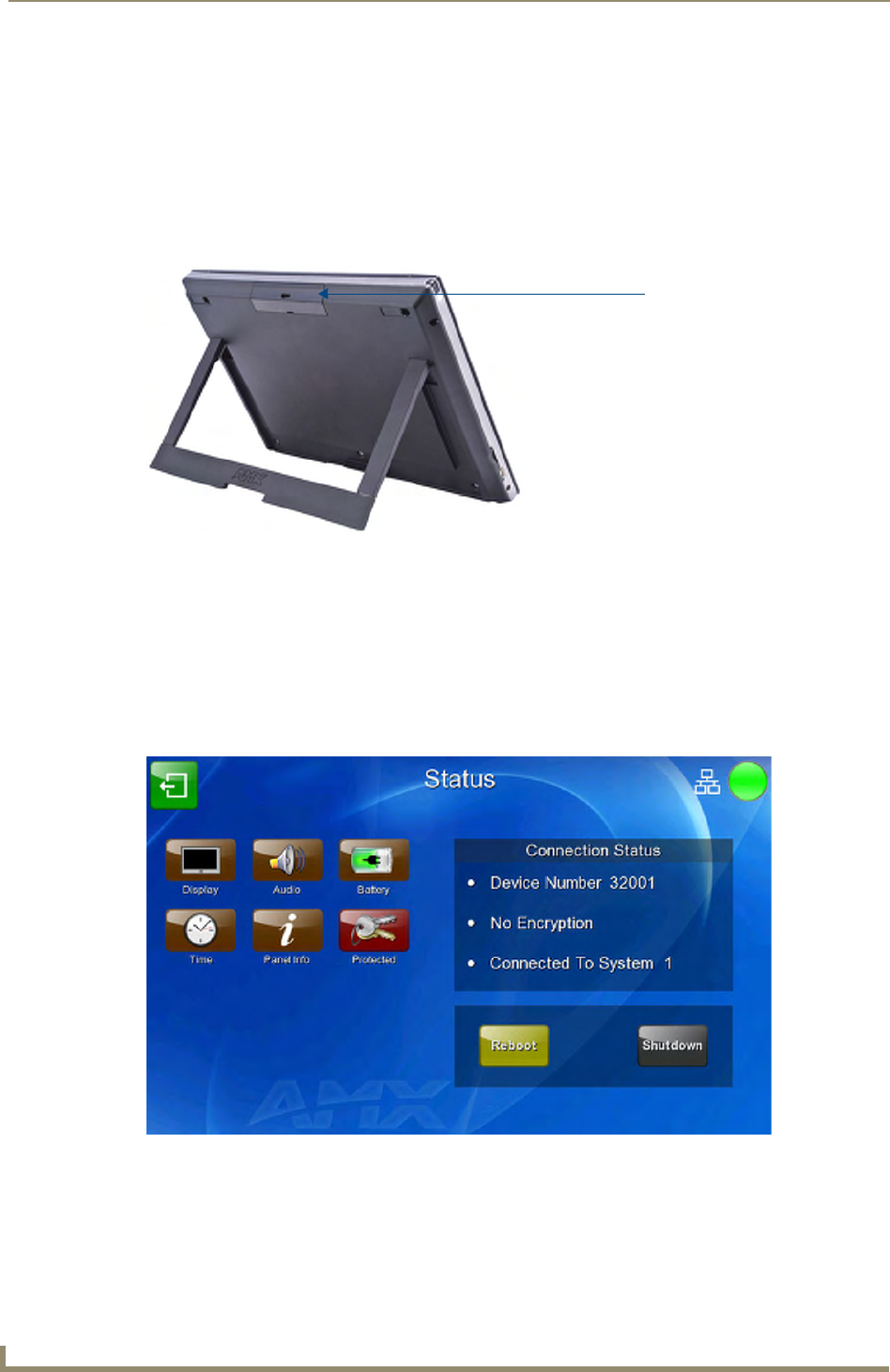
Configuring Communication
22 MVP-9000i Modero® Wireless Touch Panel with Intercom
IR Communication
In certain situations, the MVP-9000i may be used as an infrared remote device for other AMX controllers. The
device can transmit IR over 20 feet (6.10 m) from the panel at AMX frequencies of 38KHz and 455KHz, and
third-party device frequencies between 20KHz and 120KHz. IR receivers and transmitters on G4 panels share
the device address number of the panel.
The MVP-9000i includes an IR transmitter for communication between the device and the NetLinx Master
and between separate devices. The transmitter is located behind the IR Emitter Panel on the rear of the device
(FIG. 16).
Modero Setup and System Settings
All AMX Modero panels, including the MVP-9000i, feature on-board Setup pages. Use the options in the
Setup pages to access panel information and make various configuration changes.
Accessing the Setup and Protected Setup Pages
1. At any time, press the Reset button on the side of the device and hold it for 6 seconds. (For more
information, please refer to the Accessing the Setup pages section on page 45.) This opens the Status
page (FIG. 17).
FIG. 16 IR transmitter window on the MVP-9000i-GB
FIG. 17 Status page
IR Emitter Panel
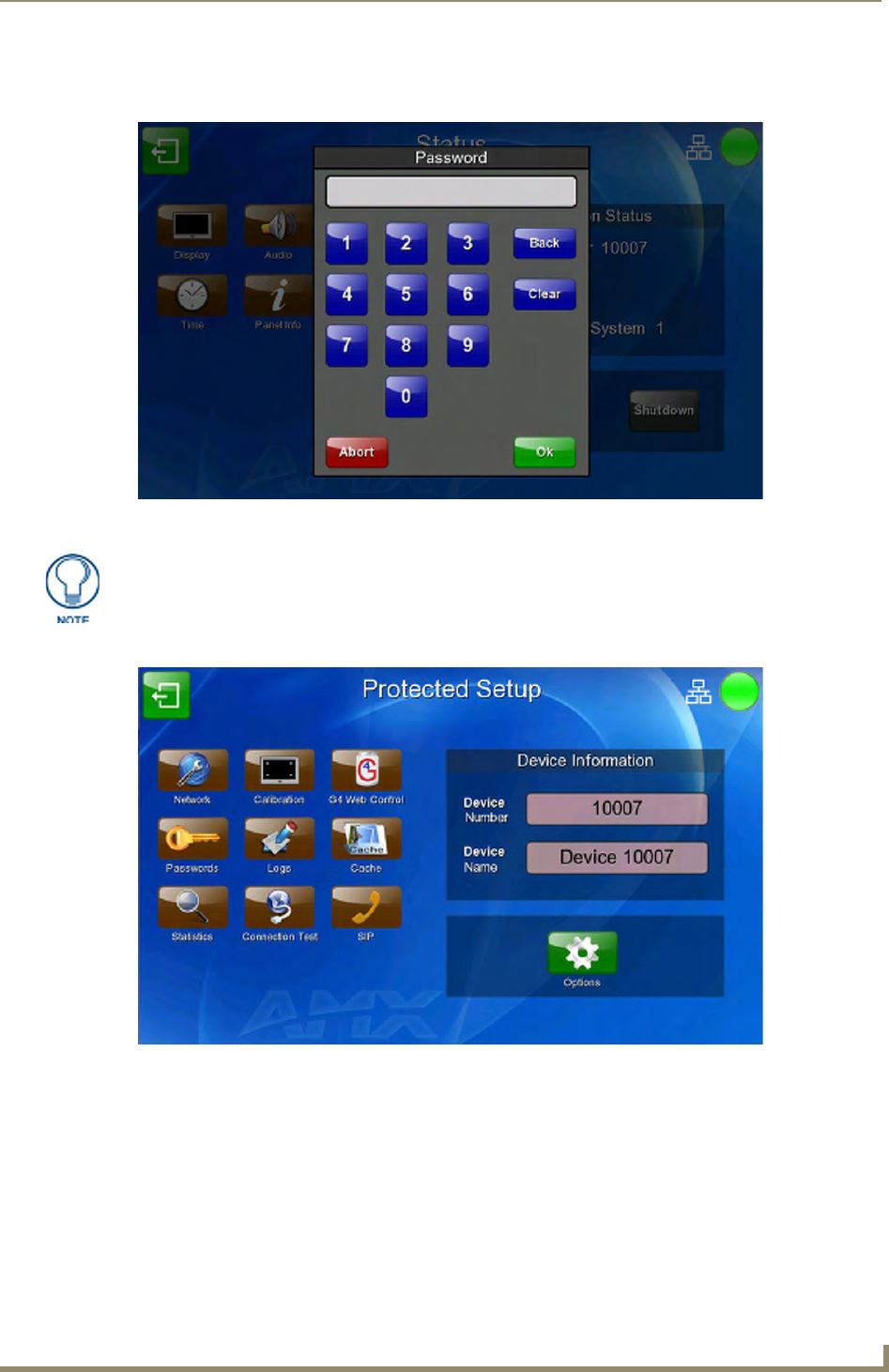
Configuring Communication
23
MVP-9000i Modero® Wireless Touch Panel with Intercom
2. Press the Protected button. This opens a popup keypad for password entry(FIG. 18). Enter the device’s
password and press Done to proceed to the Protected Setup page (FIG. 19).
For more information on the Setup and Protected Setup pages, refer to the Setup Pages section on page 45 and
the Protected Setup Pages section on page 59.
Setting the Panel’s Device Number
In the Protected Setup page:
1. Press the Device Number field in the Device Information section to open the Device Number keypad.
2. Enter a unique Device Number assignment for the device, and press Done to return to the Protected Setup
page. The Device Number default is 0.
3. From the Setup page, press Reboot to reboot the device and apply the new Device Number.
FIG. 18 Protected Setup password popup window
The default password for the Protected Setup page is 1988, but this may be changed
at any time.
FIG. 19 Protected Setup page
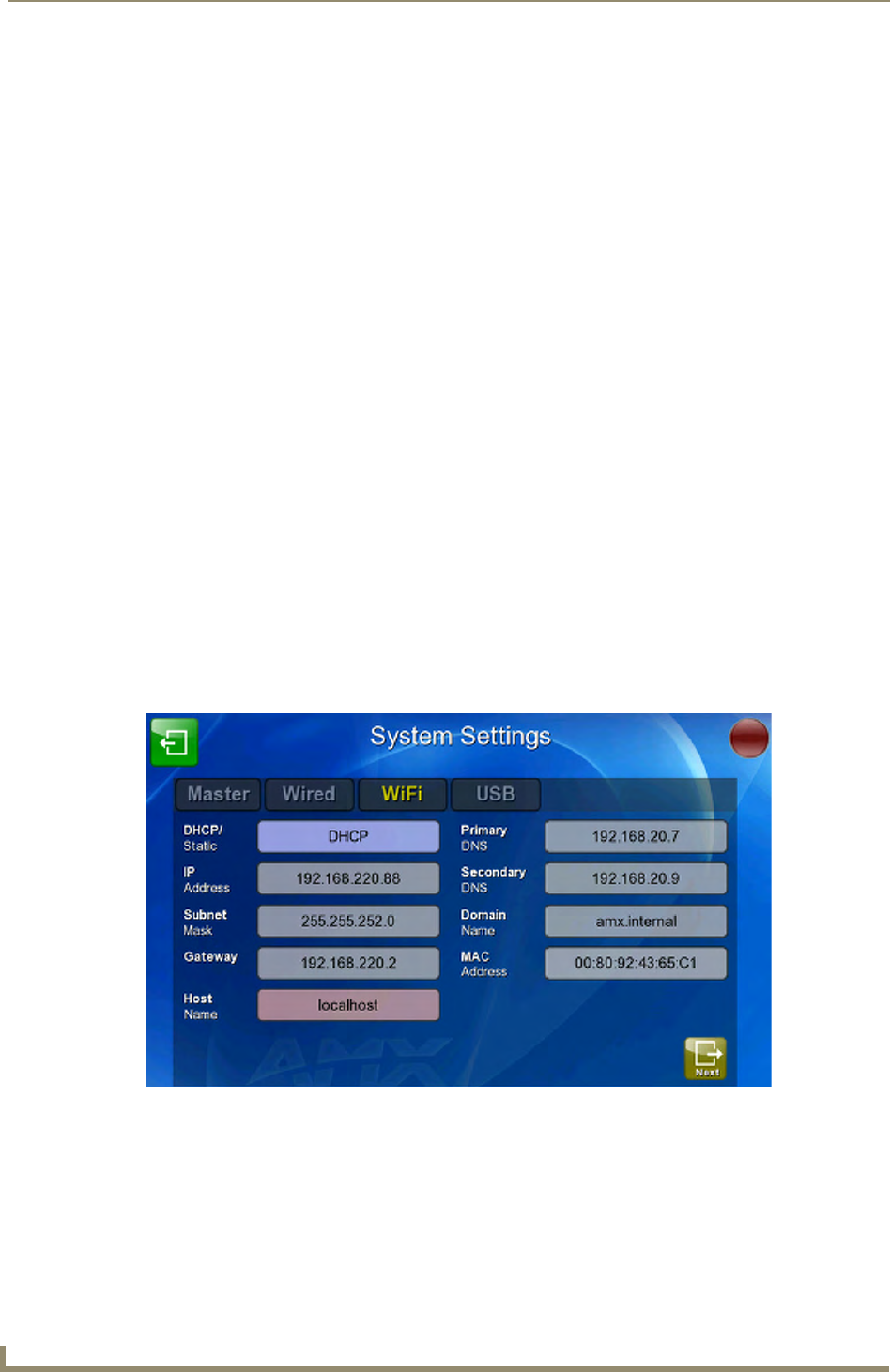
Configuring Communication
24 MVP-9000i Modero® Wireless Touch Panel with Intercom
Wireless Settings - Wireless Access Overview
DHCP
When choosing DHCP, a DHCP server must be accessible before the fields are populated.
The parameters of the wireless card must be set before selecting Ethernet as the Master Connection Type. The
Wireless Access Point communication parameters must match those of the pre-installed wireless CF
card inside the device.
MVP touch panels connect to a wireless network through their use of the pre-installed AMX 802.11a/b/g
wireless interface card. This allows users to communicate with a Wireless Access Point (WAP). For a more
detailed explanation of the new security and encryption technology, refer to the Appendix B: Wireless
Technology section on page 179.
For more information on utilizing the AMX Certificate Upload Utility in conjunction with the EAP security,
refer to the AMX Certificate Upload Utility section on page 185.
Configuring Wireless Network Access
The first step in connecting the MVP-9000i to a wireless network is to configure the wireless communication
parameters within the device’s Wireless Settings page. This page only configures the card to communicate to a
target WAP: the device must still be directed to communicate with the correct Master. This “pointing to a
Master” is done via the System Settings page, which allows configuration of the IP Address, System Number
and Username/Password information assigned to the target Master.
Step 1: Configure the Device’s WiFi Settings
The first step to a successful setup of the internal wireless card is to configure the WiFi tab on the System
Settings page. This section configures the communication parameters from the MVP panel to the web.
Wireless communication using a DHCP Address
In the Protected Setup page:
1. Touch the Network button to open the System Settings page.
2. Select the WiFi tab (FIG. 20).
3. Toggle the DHCP/Static field until the choice cycles to DHCP. This action causes all fields in the IP
Settings section, other than Host Name, to be greyed-out.
FIG. 20 System Settings page - WiFi tab
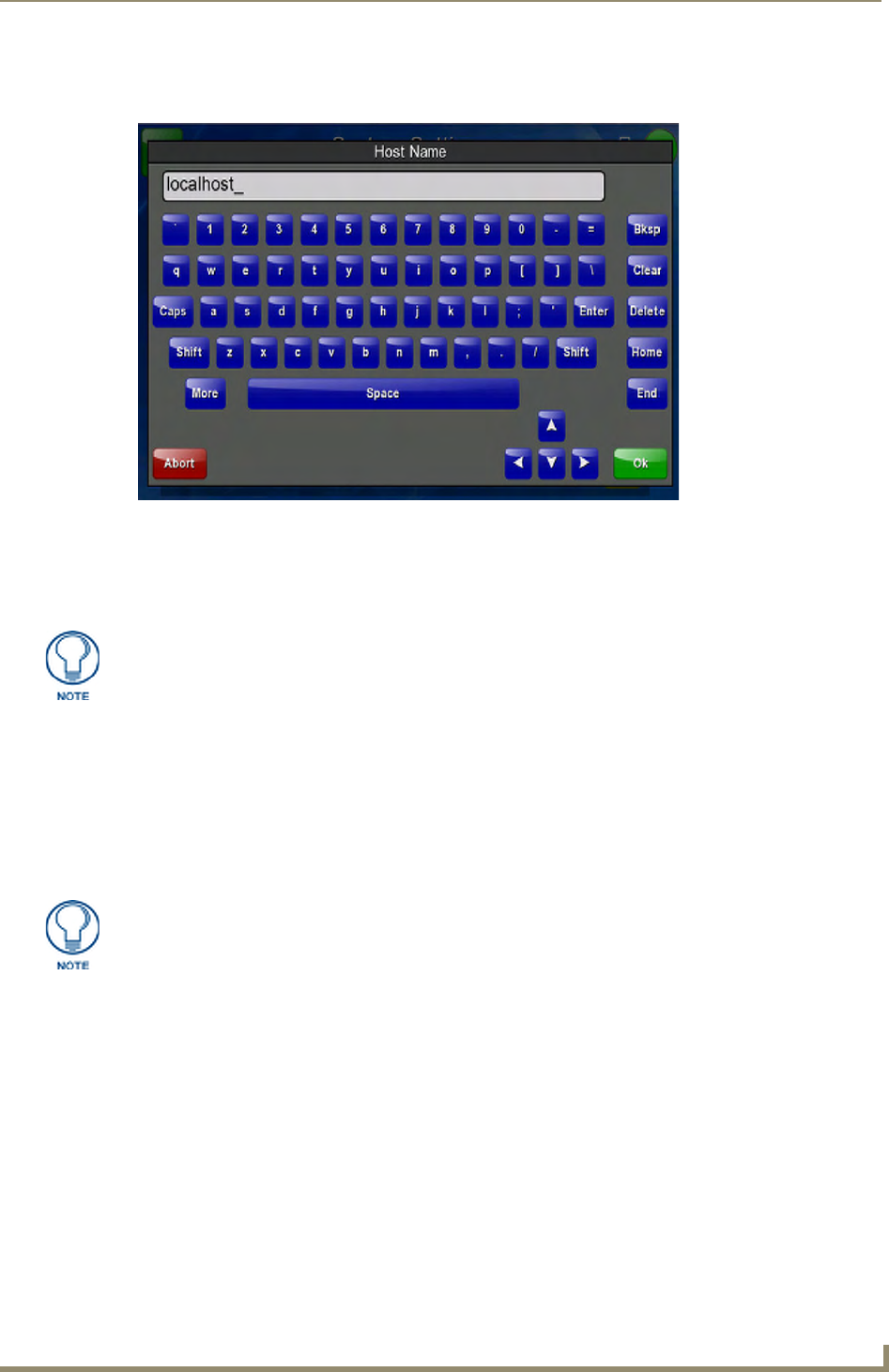
Configuring Communication
25
MVP-9000i Modero® Wireless Touch Panel with Intercom
4. Press the optional Host Name field to open the Host Name keyboard (FIG. 21) and enter the host name
information. The default name is "localhost".
5. Press OK after assigning the alpha-numeric string of the host name.
6. The remaining greyed-out fields in the IP Settings section cannot be altered. Once the panel is rebooted,
these values are obtained by the unit and displayed in the DNS fields after power-up.
7. Set up the security and communication parameters between the wireless card and the target WAP by
configuring the Wireless Settings section on this page. Refer to Step 2: Configure the Card’s Wireless
Security Settings section on page 29 for detailed procedures to setup either a secure or insecure
connection.
Wireless Communication Using a Static IP Address
1. From the Protected Setup page, press the Network button to open the System Settings page. Wireless
communication is set within the WiFi tab of this page (FIG. 20).
2. Toggle the DHCP/Static field until the choice cycles to Static. The IP Address, Subnet Mask, and
Gateway fields then turn red, noting that they are now user-editable.
3. Press the IP Address field to open a keyboard and enter the Static IP Address provided by the System
Administrator. Press OK after entering the IP address information and repeat the same process for the
Subnet Mask and Gateway fields.
4. Press the optional Host Name field to open the keyboard and enter the Host Name information. Press OK
after assigning the alpha-numeric string of the host name.
5. Press the Primary DNS field to open a Keyboard, enter the Primary DNS Address (provided by the
System Administrator) and press OK when compete. Repeat this process for the Secondary DNS field.
6. Press the Domain field to open a Keyboard, enter the resolvable domain Address (this is provided by the
System Administrator and equates to a unique Internet name for the panel), and press OK when
complete.
FIG. 21 Host Name keyboard
This information can be found in either the Workspace - System name > Define
Device section of the code that defines the properties for the panel, or in the Device
Addressing/Network Addresses section of the Tools > NetLinx Diagnostics dialog.
Check with your System Administrator for a pre-reserved Static IP Address to be
assigned to the panel. This address must be obtained before continuing with the
Static assignment of the panel.
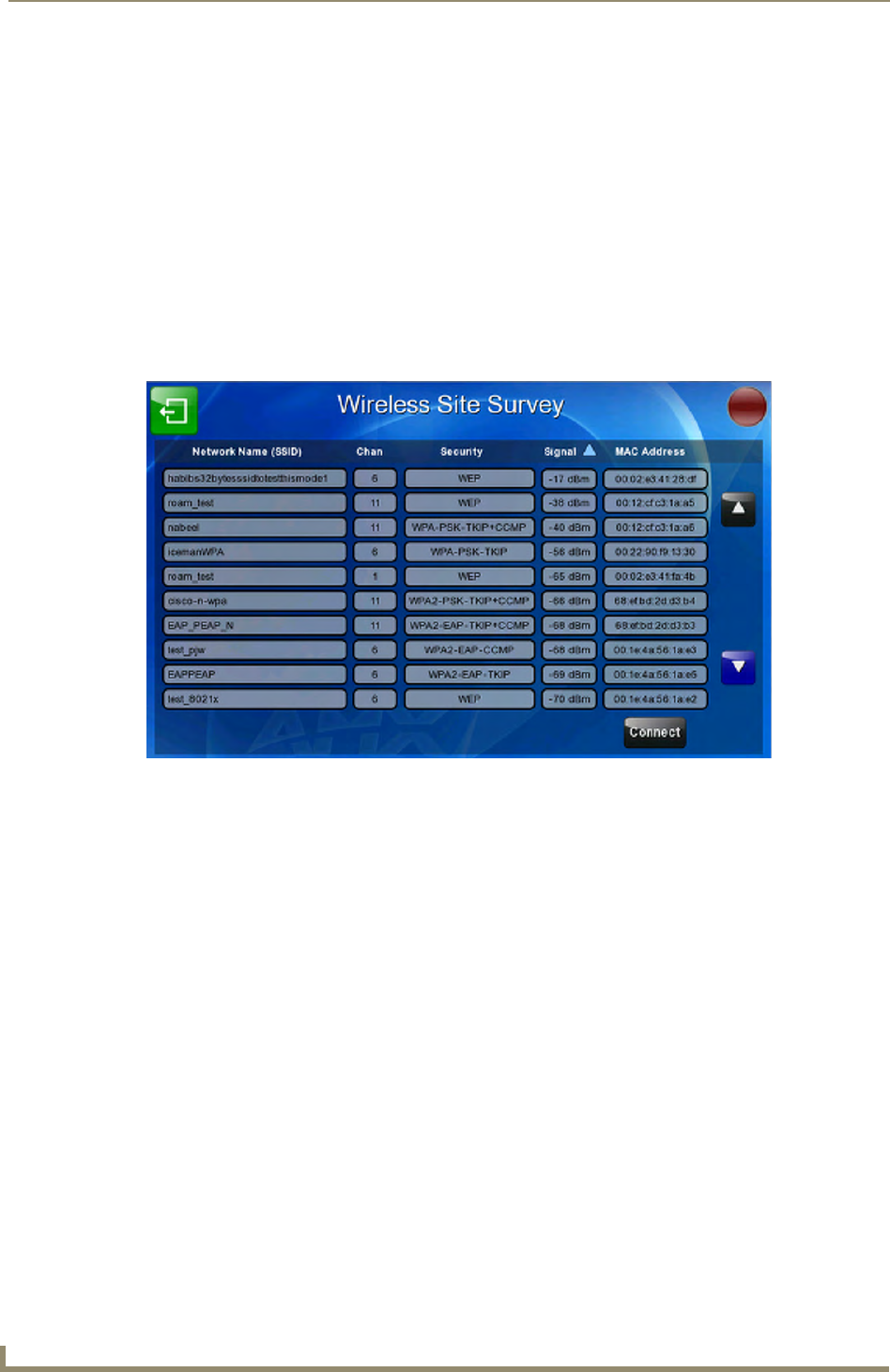
Configuring Communication
26 MVP-9000i Modero® Wireless Touch Panel with Intercom
7. Set up the security and communication parameters between the wireless card and the target WAP by
configuring the information on the second page of the WiFi tab. Refer to the following section for detailed
procedures to set up either a secure or unsecure connection.
Using the Site Survey Tool
This tool allows a user to “sniff out” all transmitting Wireless Access Points within the detection range of the
internal wireless card (FIG. 22). Once the Site Survey button is pressed, the device displays the Site Survey
page, which contains the following categories:
Network Name (SSID) - Wireless Access Point names
Channel (RF) - Channel currently being used by the WAP (Wireless Access Point)
Security (if detectable - such as WEP, OPEN and UNKNOWN) - Security protocol enabled on the
WAP
Signal - Displays the signal strength
MAC Address - Unique identification of the transmitting Access Point
To access the Wireless Site Survey page:
1. From the System Settings page, touch the WiFi tab.
2. At the bottom of the page, press the Next button to move to the second WiFi tab page.
3. Press the Site Survey button. This action launches the Wireless Site Survey page, which displays a listing
of all detected WAPs in the communication range of the internal card.
The card scans its environment every four seconds and adds any new WAPs found to the list. Every
scan cycle updates the signal strength fields.
Access points are tracked by MAC Address.
If the WAP’s SSID is set as a blank, then N/A is displayed within the SSID field.
If the WAP’s SSID is not broadcast, it will not show up on the Wireless Networks screen.
If a WAP is displayed in the list is not detected for 10 scans in a row, it is then removed from the
screen. In this way, a user can walk around a building and track access points as they move in and
out of range.
4. Sort the information provided on this page by pressing on a column name. This moves the sorting arrow
to that column, where it may be toggled up or down.
Up arrow - indicates that the information is being sorted in an ascending order.
Down arrow - indicates that the information is being sorted in a descending order.
FIG. 22 Wireless Site Survey page
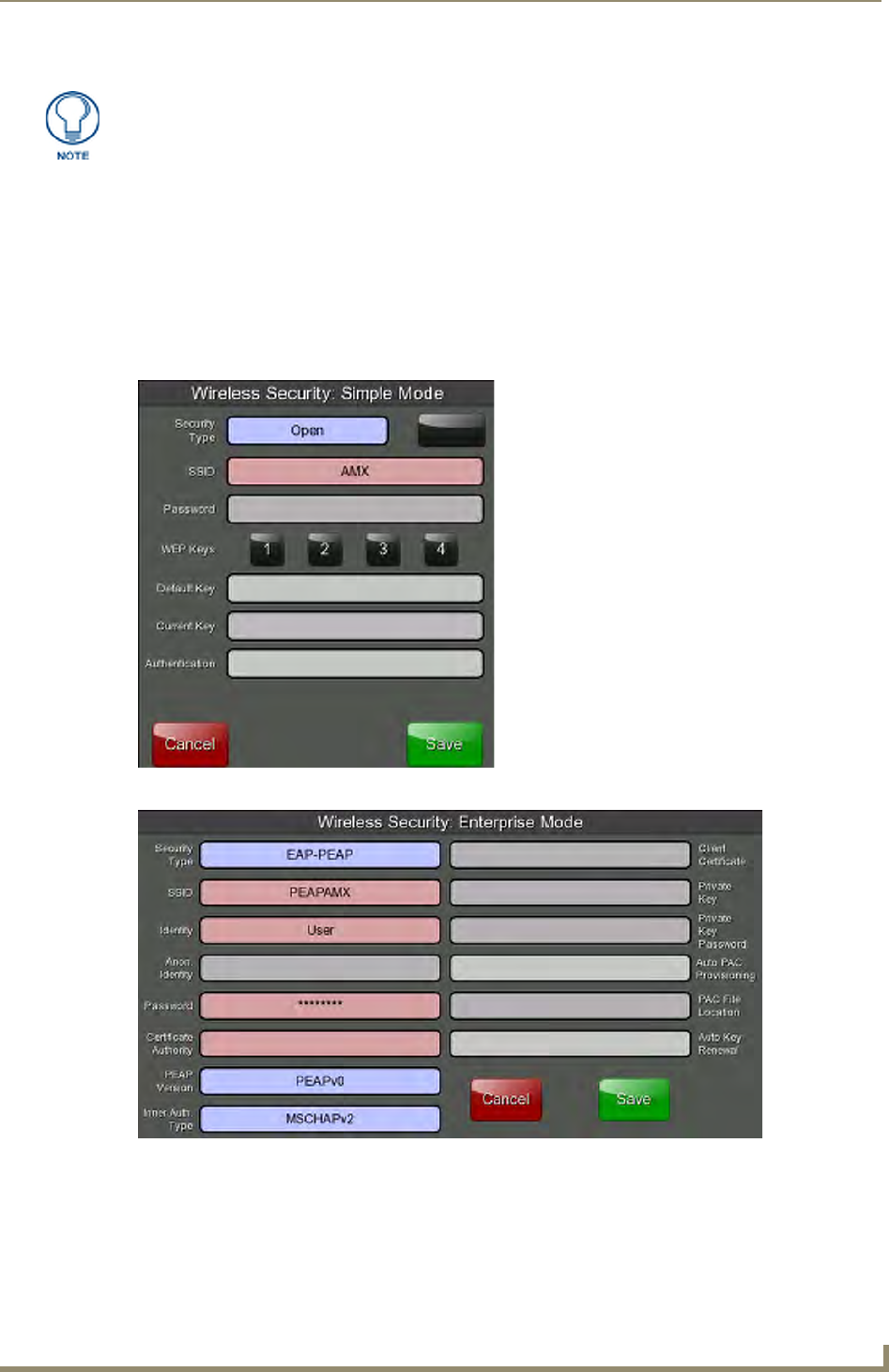
Configuring Communication
27
MVP-9000i Modero® Wireless Touch Panel with Intercom
5. Select a desired Access Point by touching the corresponding row. The up arrow and down arrow will be
grayed out if ten or fewer access points are detected. If more are detected, then they will be enabled as
appropriate so that the user can scroll through the list.
6. With the desired WAP selected and highlighted, click the Connect button to be directed to the selected
security mode’s popup window with the SSID field filled in. From there, either Cancel the operation or
fill in any necessary information fields and then click Save.
Selecting an Open, WEP, and WPA-PSK Access Point and then clicking Connect will open the
corresponding Simple Mode popup window (FIG. 23). For any other security mode, clicking Connect
will open the corresponding Enterprise Mode popup window (FIG. 24).
In an Open security mode, after selection and connection to a target WAP, the SSID name of the
selected WAP is saved for the open security mode.
If the panel detects more than 10 WAPs, the Up/Down arrows at the far right side of
the page become active (blue) and allow the user to scroll through the list of entries.
FIG. 23 Wireless Security: Simple Mode popup window
FIG. 24 Wireless Security: Enterprise Mode popup window
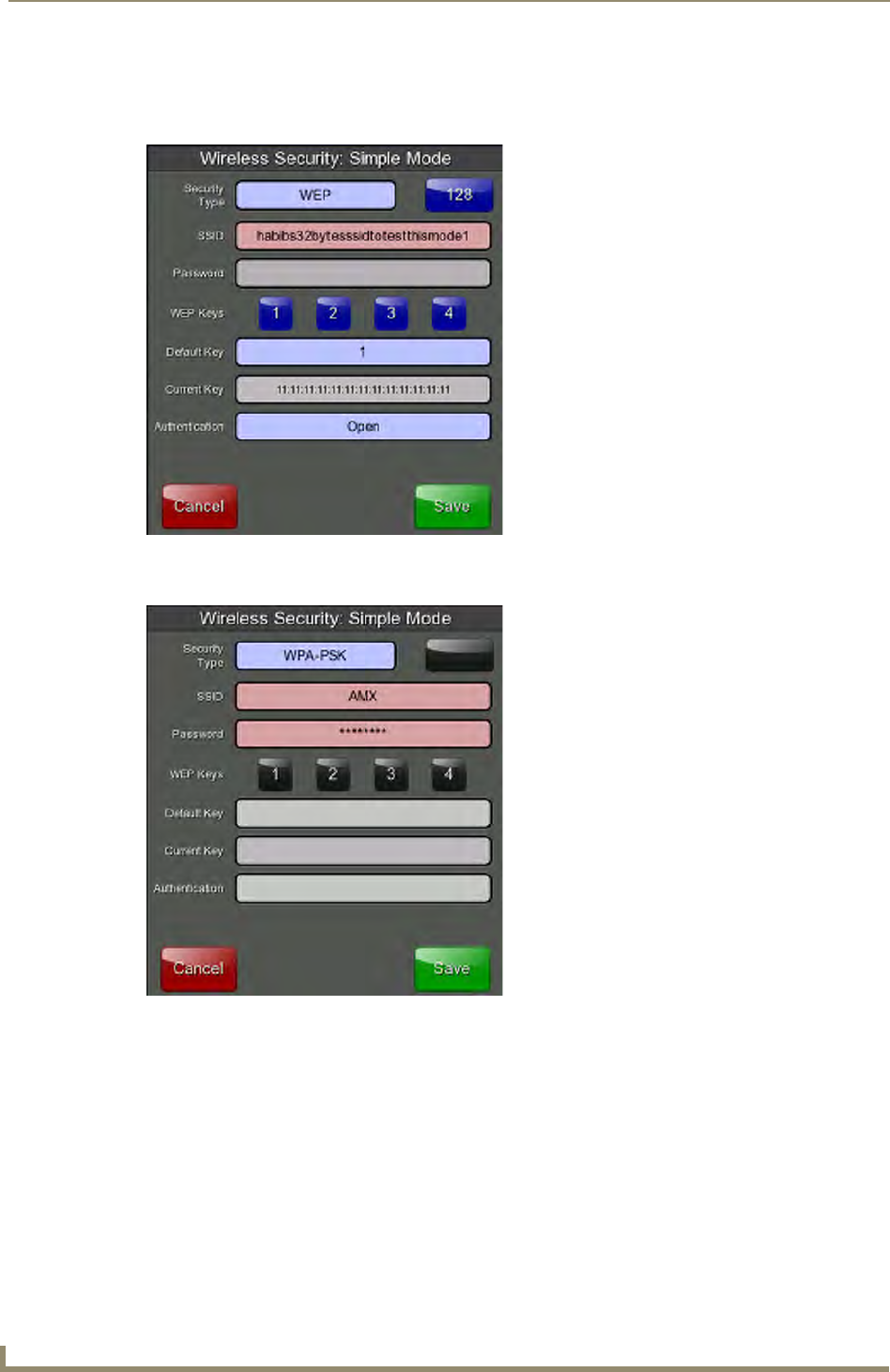
Configuring Communication
28 MVP-9000i Modero® Wireless Touch Panel with Intercom
In a WEP security mode, after selection and connection to a WEP Access Point, the user is then
redirected back to the Wireless Security: Simple Mode popup window (FIG. 25), where the SSID
field is already filled out. The user is only required to enter in the remaining WEP key settings.
A similar process occurs for WPA-PSK access points (FIG. 26).
FIG. 25 Wireless Security: Simple Mode - WEP
FIG. 26 Wireless Security: Simple Mode: WPA-PSK

Configuring Communication
29
MVP-9000i Modero® Wireless Touch Panel with Intercom
Step 2: Configure the Card’s Wireless Security Settings
The second step in setting up the wireless card is to configure the Wireless Settings section of the Wireless
Settings page. This section configures both the communication and security parameters from the internal
wireless card to the WAP. The procedures outlined within the following sections for an 802.11a/b/g card
facilitate a common security configuration to a target WAP.
Refer to the Appendix B: Wireless Technology section on page 179 for more information on other security
methods.
After setting up the wireless card parameters, configure the communication parameters for the target Master;
see Step 3: Choose a Master Connection Mode section on page 31.
Configuring the Device’s Wireless Card for Unsecured Access To a WEP
In the System Settings page:
1. Select the WiFi tab.
2. Press the Next button to move to the second WiFi tab page.
3. Enter the SSID information by:
Automatically filling it by pressing the Site Survey button. From the Site Survey page, choosing an
Open WAP from within the Site Survey page and then pressing the Connect button at the bottom of
the page (FIG. 22).
Manually entering the SSID information into the appropriate fields by following steps 7 through 9.
4. From the two Security Mode selections, press the Simple button to open the Wireless Security: Simple
Mode popup window. Press the Security Type field to select Open. An Open security method does not
utilize any encryption methodology, but does require that an alpha-numeric SSID be entered. This method
sends out network packets as unencrypted text.
5. Press the red SSID field to display an on-screen Network Name (SSID) keyboard.
6. In this keyboard, enter the SSID name used on the target Wireless Access Point (case sensitive).
The card should be given the SSID used by the target WAP. If this field is left blank, the unit will
attempt to connect to the first available WAP. By default, all WAP200Gs use AMX as their
assigned SSID value.
One of the most common problems associated with connection to a WAP involves an incorrect
SSID. Make sure to maintain the same case when entering the SSID information. ABC is not the
same as Abc.
7. Click OK when complete or Abort to return to the popup window without saving any changes.
8. From the Wireless Security: Simple Mode popup window (FIG. 23), press the Save button to incorporate
the new information into the device and begin the communication process.
9. Verify the proper configuration in the fields in the WiFi tab. Refer to Step 1: Configure the Device’s WiFi
Settings section on page 24 for detailed information.
10. Press the Back button twice to return to the Status page. Remember that the connection must be
configured to a target Master from the System Settings page.
11. After the panel restarts, return to the WiFi tab and verify the link quality and signal strength.
The signal level field should provide some value indicating the strength of the
connection to a Wireless Access Point. If no signal or no IP Address is displayed,
configuration of the network could be required.

Configuring Communication
30 MVP-9000i Modero® Wireless Touch Panel with Intercom
Automatically Setting SSID
In the System Settings page:
1. Select the WiFi tab.
2. Press the Site Survey button at the bottom of the page.
3. Select a secured WAP from within the Site Survey page, and press the Connect button (FIG. 22).
4. If the security is not handled automatically, the information must be entered manually from the Wireless
Security menu.
Manually Setting SSID
In the System Settings page:
1. Select the WiFi tab.
2. Press the Next button to move to the second WiFi page.
3. From the Security Modes options, press the Simple button to open the Wireless Security: Simple Mode
popup window.
4. Press the SSID field. From the Network Name (SSID) keyboard, enter the SSID name used by the target
Wireless Access Point (case sensitive), and press OK when finished.
The card should be given the SSID used by the target WAP. If this field is left blank, the device will
attempt to connect to the first available WAP.
One of the most common problems associated with connection to a WAP arises because of an
improperly entered SSID. The same case must be maintained when entering this information. ABC
is not the same as Abc.
The alpha-numeric string is AMX by default, but can later be changed to any 32-character entry.
This string must be duplicated within the Network Name (SSID) field on the WAP. As an example, if
the SSID is TECHPUBS, this word and the case within must match both the Network Name
(SSID) field on the touch panel’s Network Name SSID field and on the WAP’s Basic Wireless
Configuration page.
5. Toggle the button to the right of the Security Type field until it reads either 64 or 128.
The 64/128 selection reflects the bit-level of encryption security. This WEP encryption level must match
the encryption level being used on the WAP.
6. Choose a WEP Key value (from 1- 4) that matches what will be used on the target.
7. Verify that the fields within the IP Settings section have been properly configured. Refer to Step 1:
Configure the Device’s WiFi Settings section on page 24 for detailed information. Press Save when
finished to save any changes and return to the System Settings page.
8. Press the Back button twice to navigate to the Status page and save any changes. Remember that you will
need to return to the System Settings page after the reboot and configure the connection to a target Master.
9. After the panel restarts, return to the second page of the WiFi tab to verify the Signal Level Value and the
Signal Level.
WEP will not work unless the same Default Key is set on both the panel and the
Wireless Access Point.
For example: if the Wireless Access Point has been set to default key 4 (which was
01:02:03:04:05), the panel’s key 4 must be set to 01:02:03:04:05.
The WEP Key identifier values must match for both devices.
The Signal Level Value field provides some value indicating regarding the strength of
the connection to a Wireless Access Point. Configuration of the network could be
required if there is no signal or no IP Address is displayed.
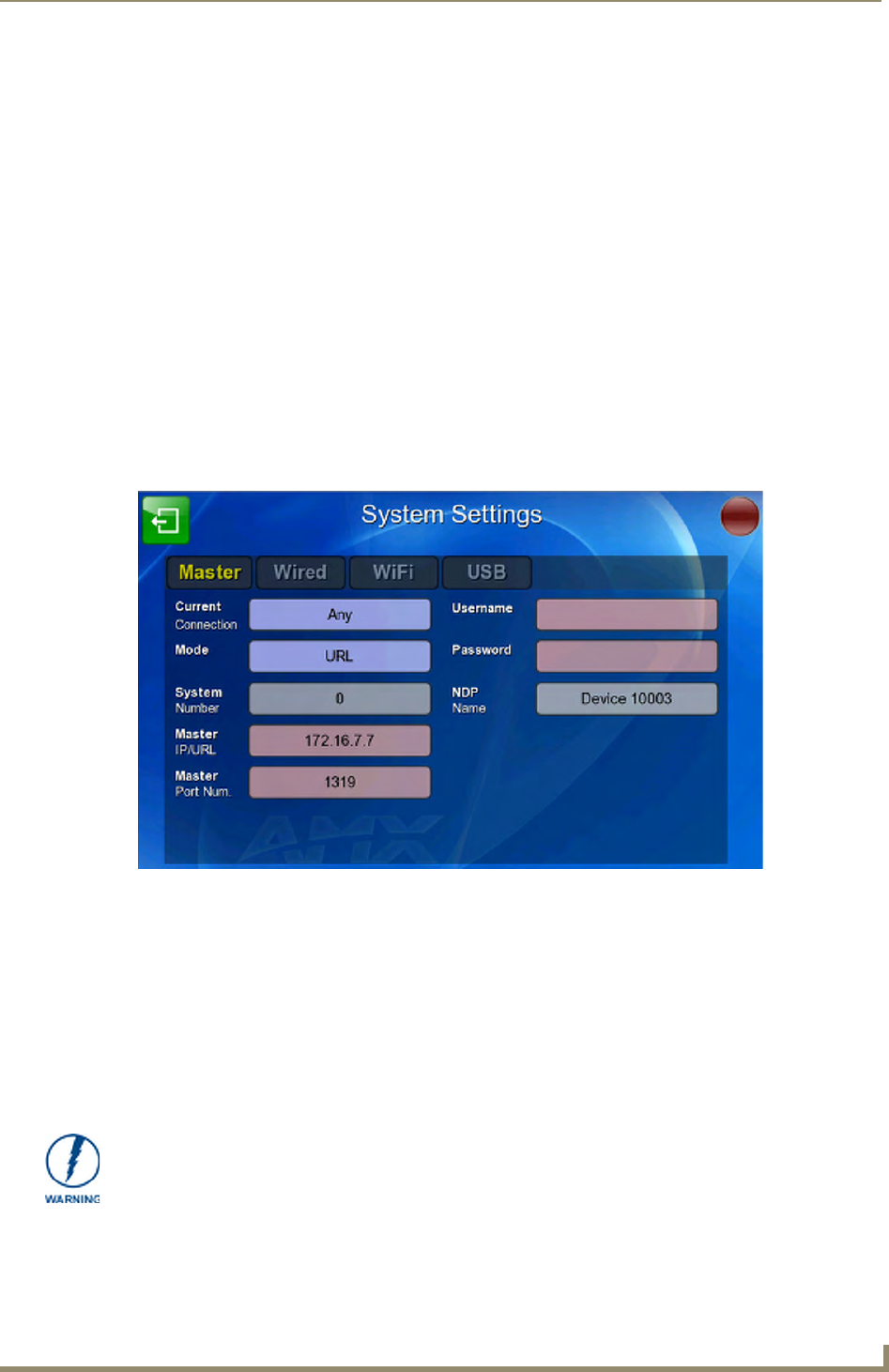
Configuring Communication
31
MVP-9000i Modero® Wireless Touch Panel with Intercom
Configuring Multiple Wireless Touch Panels To Communicate To a Target WAP
1. For each communicating touch panel, complete all of the steps outlined within the previous Automatically
Setting SSID section on page 30.
2. Navigate back to the WiFi tab on each panel.
3. Verify that all communicating Modero panels are using the same SSID, encryption level, Default Key #,
and an identical Current Key value.
As an example, all panels should be set to Default Key #1 and be using aa:bb:cc.as the Current Key
string value. This same Key value and Current Key string should be used on the target WAP.
4. Repeat steps 1 - 3 on each panel. Using the same passphrase generates the same key for all
communicating Modero panels.
Step 3: Choose a Master Connection Mode
The MVP-9000i requires a decision on the type of connection to be made between it and the Master.
To establish a Master connection:
1. From the System Settings page, select the Master tab if it is not already selected.
2. The Current Connection field displays the current connection availability (FIG. 27). If this field reads
“Any”, then connections may be made via Ethernet, wireless Ethernet, or USB.
A Wired connection involves communication from the panel to a Master via a wired Ethernet
connection to the network. This is available through the Wired tab on the System Settings page.
A WiFi connection involves communication from the panel to a Master via a wireless connection to
the network. This is available through the WiFi tab on the System Settings page.
A USB connection is a direct connection from the panel’s mini-USB port to a corresponding USB
port on the PC (acting as a Virtual Master). This is available through the USB tab on the System
Settings page.
3. Select the Mode field to choose the master connection mode. The connection modes are Auto, URL, and
Listen.
FIG. 27 System Settings page - Master Tab
Although firmware upgrades can be conducted over a wireless Ethernet connection,
transferring firmware KIT files over a wired LAN, USB data stick, or USB flash card is
recommended, and only when the panel is connected to a power supply. If battery
power is below 30 percent, and the touch panel is not connected to a power supply,
the download will not be completed.
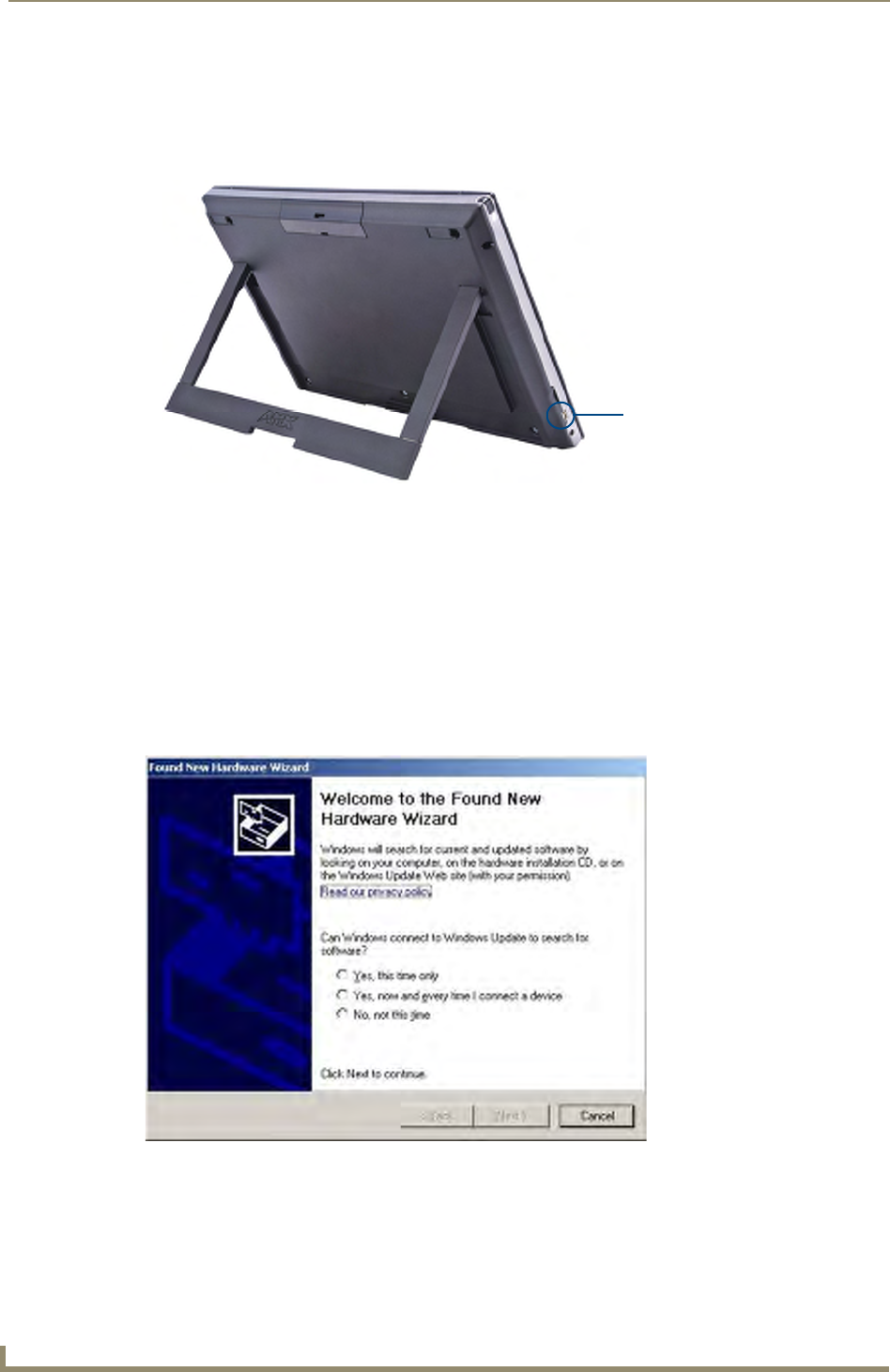
Configuring Communication
32 MVP-9000i Modero® Wireless Touch Panel with Intercom
Ethernet Over USB
The MVP-9000i device supports an Ethernet over USB driver for panel downloads and firmware updates. This
means that the device can connect to a host computer for updates through its Mini USB port instead of through
a standard Ethernet port (FIG. 28).
Firmware downloads require use of the USB Programming Cable (FG10-5965) and a computer running
Windows XP.
Touch Panel Setup
To prepare the MVP-9000i for Ethernet for USB communication:
1. Turn on the MVP-9000i and wait for the device to finish booting up.
2. Insert the mini-USB end of the USB Programming Cable into the mini-USB port on the device. Insert the
other end into the appropriate USB port on the computer containing the files to be downloaded.
3. If the connection goes well, the Windows XP machine will detect the device as an unsupported USB
device. It then presents a dialog that prompts the user for a suitable driver (FIG. 29):
4. Select Yes, this time only and click on Next.
FIG. 28 USB Port on the MVP-9000i
FIG. 29 Found New Hardware Wizard dialog
Mini USB port
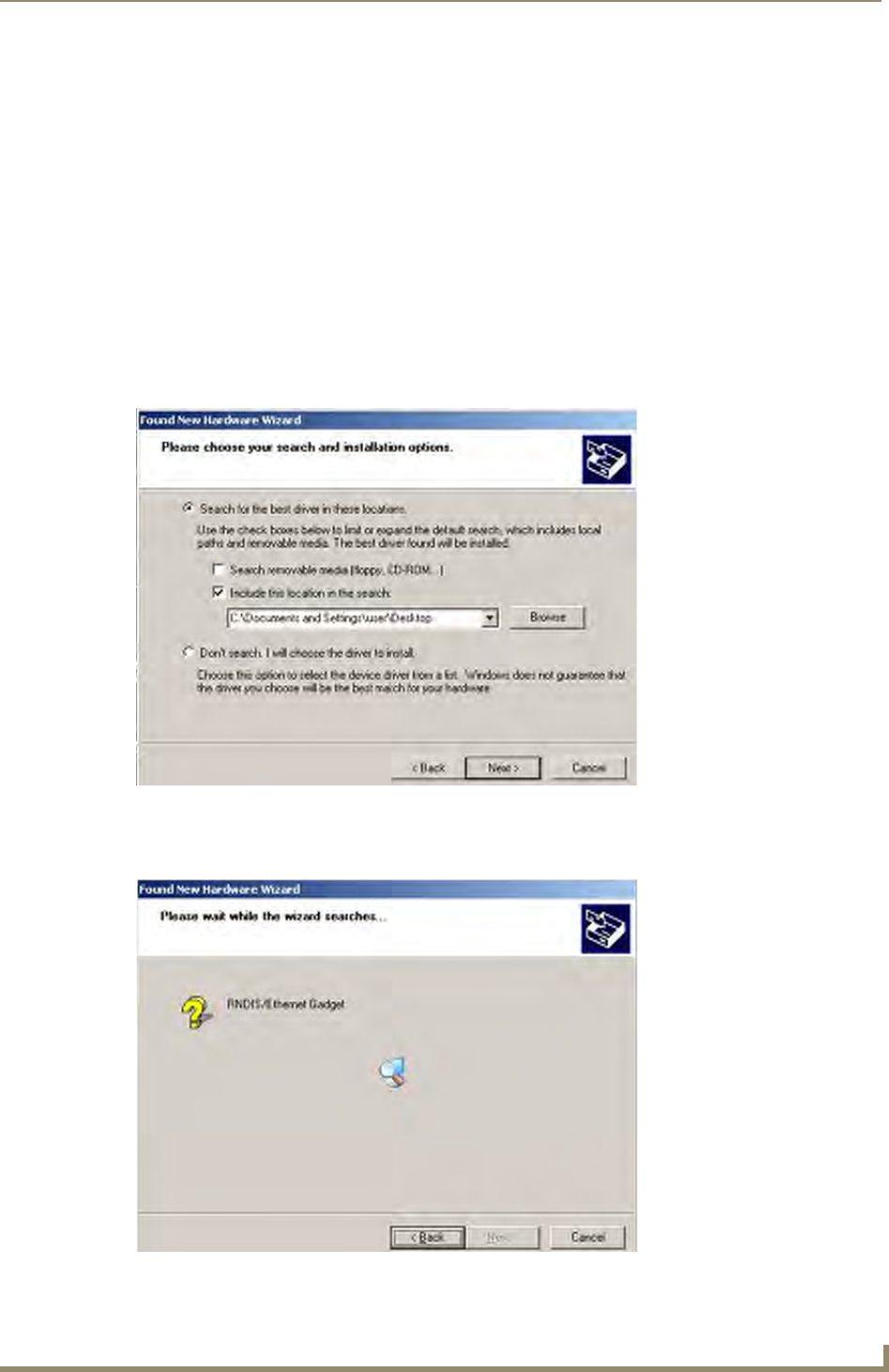
Configuring Communication
33
MVP-9000i Modero® Wireless Touch Panel with Intercom
5. In the new window:
- Select Use the following IP Address.
Under IP address, provide an IP address. The USB interface IP address of the panel can be found in
the System Settings page under the USB tab. The default USB IP of panel is 172.16.0.2, so the IP
address for the USB interface on the PC must be 172.16.0.xx. Ensure that it is in the same subnet as
the IP address given to the usb0 interface on the MVP-9000i, but make sure that it has a different
node number. The IP address cannot be the same as the panel`s USB IP address.
Under Subnet mask, set the suitable subnet mask.
Click OK.
6. In the next box (FIG. 30), make sure to:
Select Search for the best driver in these locations
Select Include this location in the search
Click on Browse
Select the folder that contains the 'linux.inf' file
7. Click on Next.
8. The Windows XP machine now searches for the suitable driver (FIG. 31).
FIG. 30 Found New Hardware Wizard Installation Options dialog
FIG. 31 Found New Hardware Wizard while searching for the driver
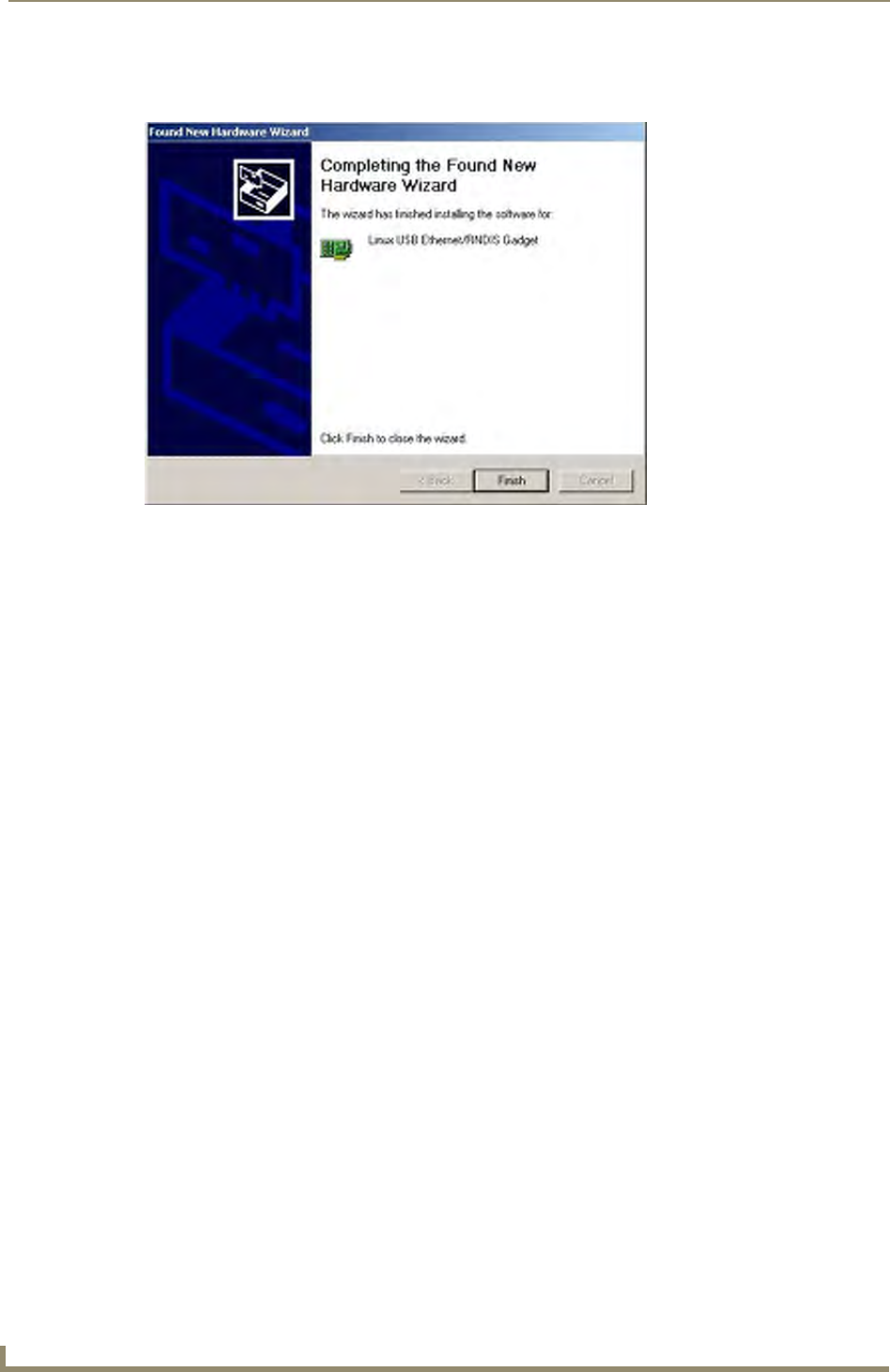
Configuring Communication
34 MVP-9000i Modero® Wireless Touch Panel with Intercom
9. Once the system finds the driver, it displays its choice (FIG. 32). Click Finish to complete the driver
installation.
When an IP address is assigned to the usb0 interface on the device, Windows XP will make an attempt to
assign an IP address to the corresponding interface on the Windows side. Usually, this IP address is a random
value and in a totally different subnet. The user may set the Windows network properties for the Ethernet over
USB interface to have a specific address whenever the Windows XP system detects an MVP-9000i with an
assigned IP address.
In Windows XP:
1. From the Windows XP desktop, click on Start > Settings > Network Connections. This opens a window
listing the currently active network connections.
2. Select the connection that is specific to AMX USB Device Link.
3. Right click and select Properties.
4. In the Local Area Connection 3 Properties window (FIG. 33) under the General tab, select Internet
Protocol (TCP/IP) and click on Properties.
FIG. 32 Completing the Found New Hardware Wizard
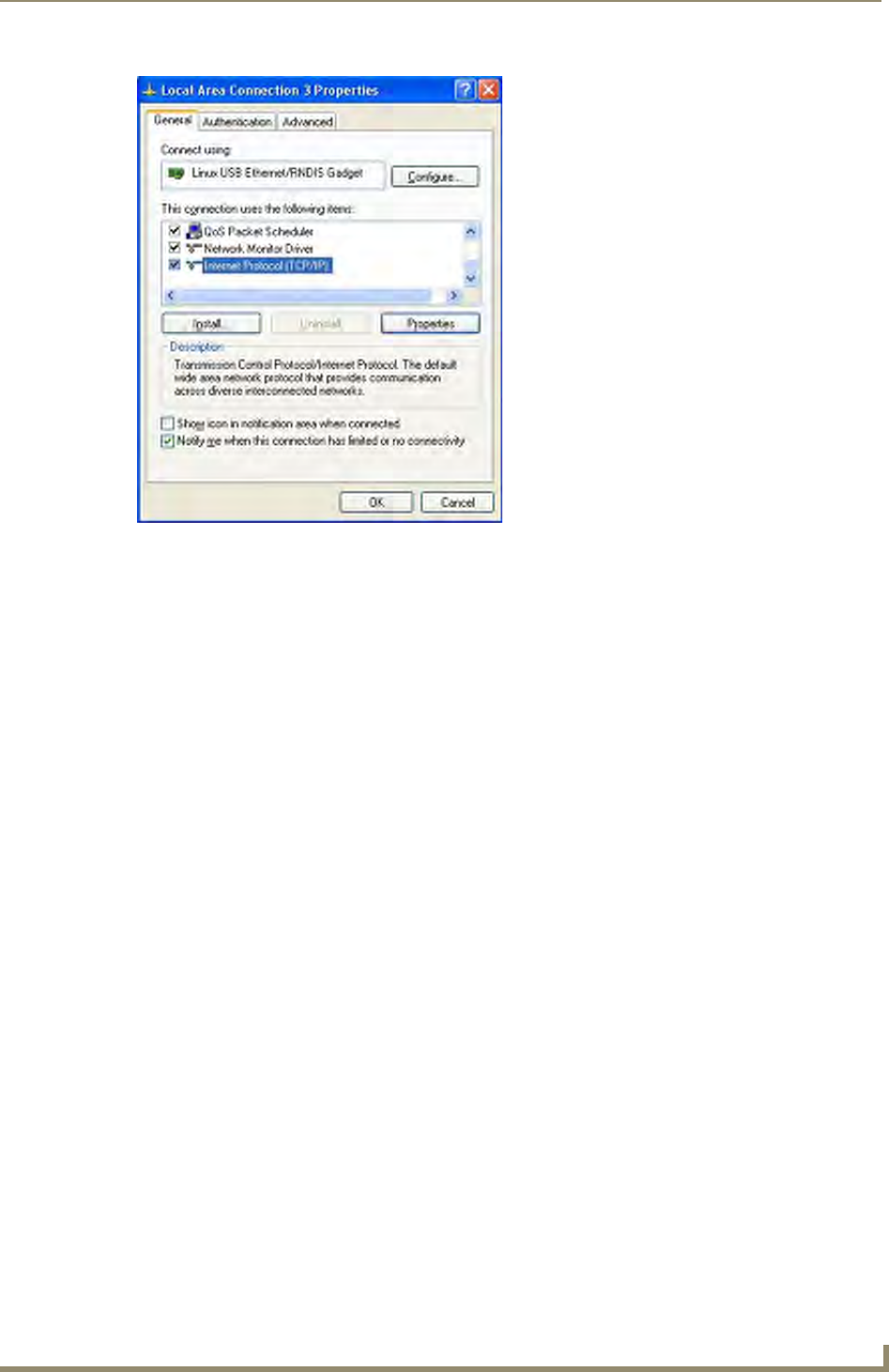
Configuring Communication
35
MVP-9000i Modero® Wireless Touch Panel with Intercom
5. In the new window:
Select Use the following IP Address.
Under IP address, provide an IP address (ensure that it is in the same subnet as the IP address given
to the usb0 interface on the MVP-9000i).
Under Subnet mask, set the suitable subnet mask.
Click on OK'
6. In the Local Area Connection 3 Properties window, click on OK.
The user should now be able to run any TCP/IP application between the two systems.
Configure a Virtual NetLinx Master using NetLinx Studio
A Virtual NetLinx Master (VNM) is used when the target panel is not actually connected to a physical NetLinx
Master. In this situation, the PC takes on the functions of a Master via a Virtual NetLinx Master. This
connection is made by either using the PC’s Ethernet Address (via TCP/IP using a known PC’s IP Address as
the Master) or using a direct mini-USB connection to communicate directly to the panel.
Before beginning:
1. If using the mini-USB connection, verify the panel has been configured to communicate via USB within
the System Settings page and that the USB driver has been properly configured. Changing the Master
Connection type requires a reboot before the change takes effect.
2. In NetLinx Studio, select Settings > Master Communication Settings, from the Main menu to open the
Master Communication Settings dialog (FIG. 34).
FIG. 33 Local Area Connection 3 Properties
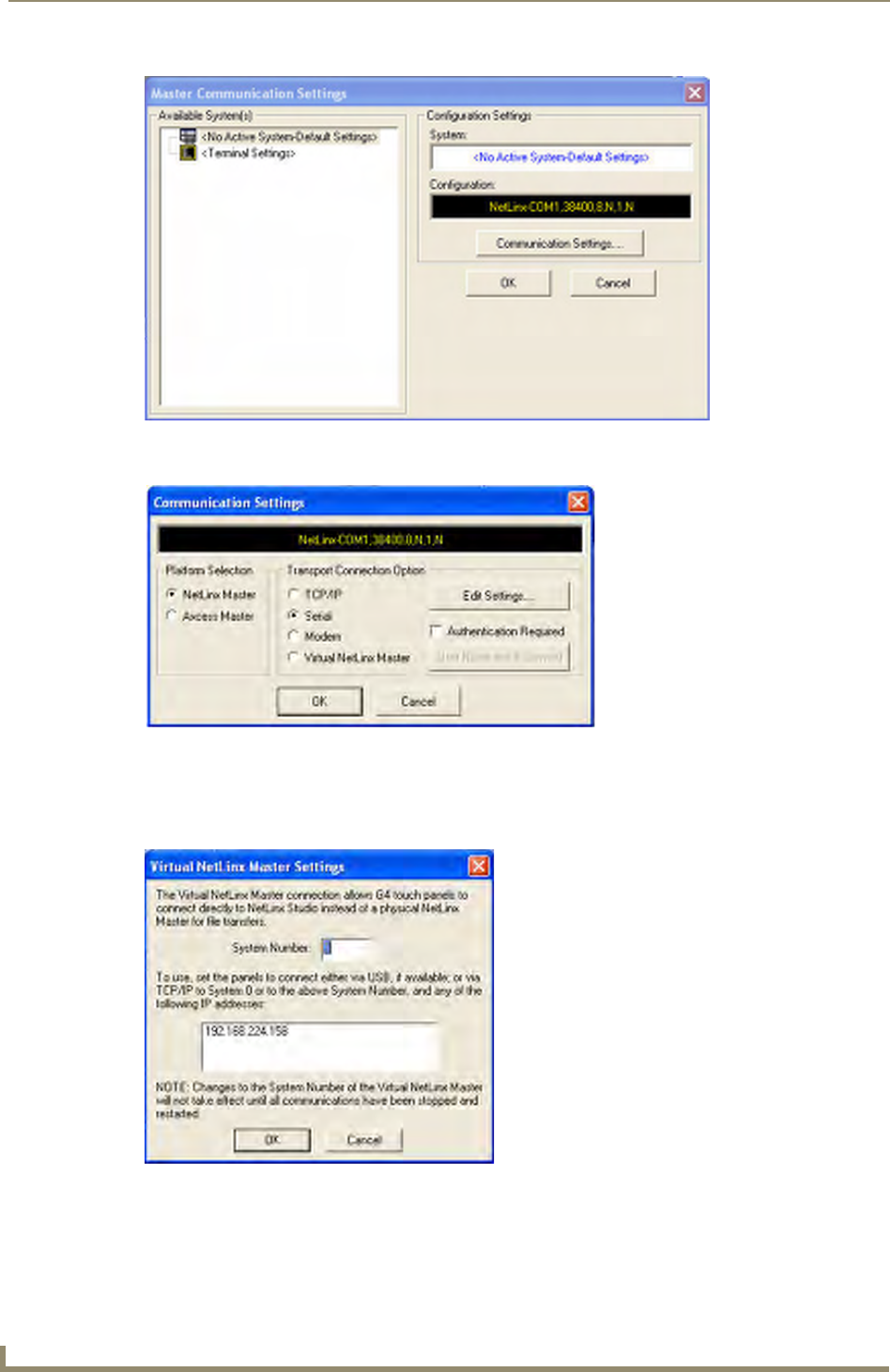
Configuring Communication
36 MVP-9000i Modero® Wireless Touch Panel with Intercom
3. Click the Communications Settings button to open the Communications Settings dialog (FIG. 35).
4. Click the NetLinx Master radio button in the Platform Selection section.
5. Click the Virtual NetLinx Master radio button in the Transport Connection Option section.
6. Click the Edit Settings button to open the Virtual NetLinx Master Settings dialog (FIG. 36).
7. Enter the System number; the default is 1.
8. Click OK on all open dialogs to save your settings.
9. Click the OnLine Tree tab in the Workspace window to view the devices on the Virtual System.
FIG. 34 Master Communications Settings dialog
FIG. 35 Communications Settings dialog
FIG. 36 Virtual NetLinx Master Settings dialog
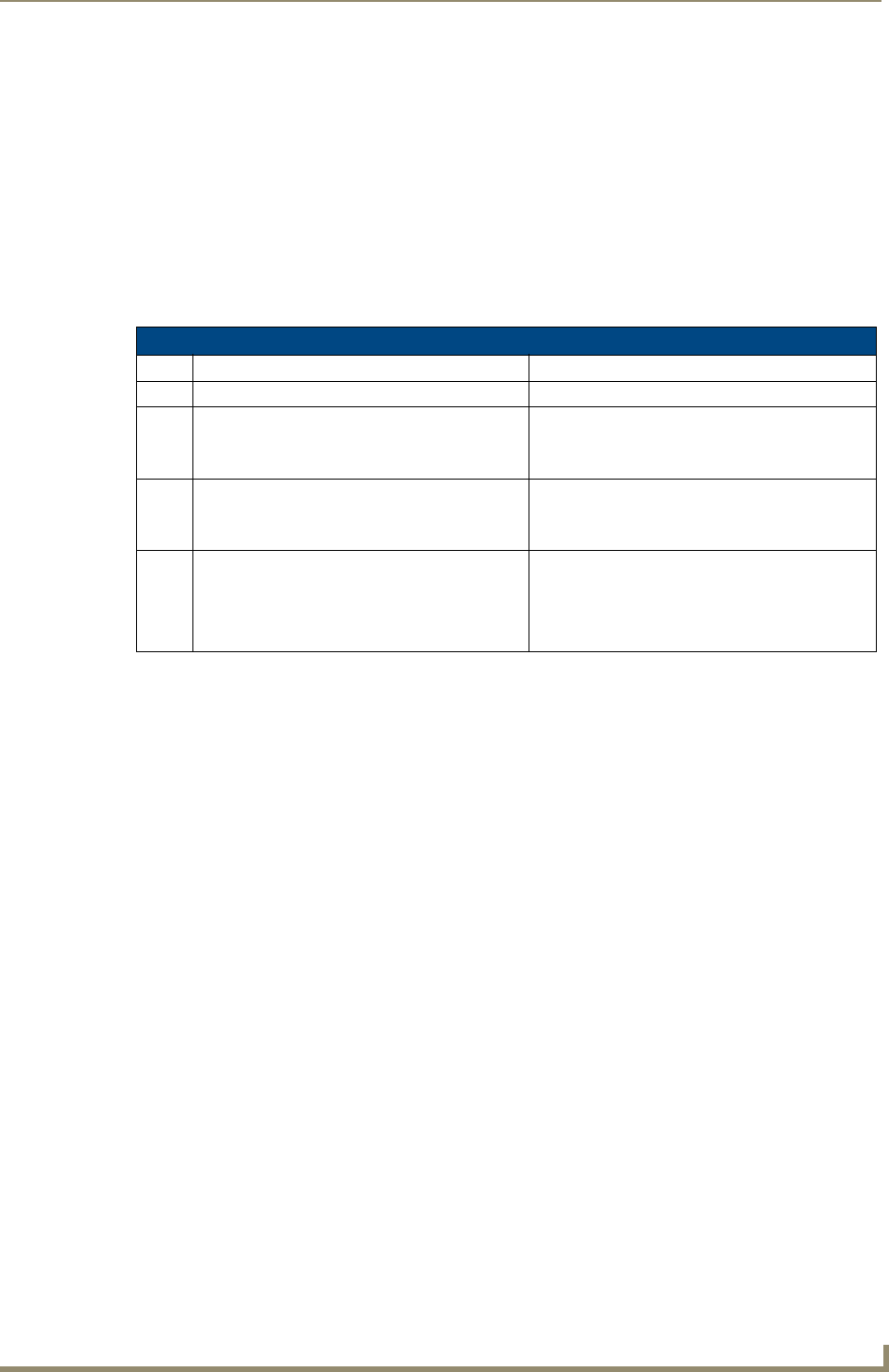
Configuring Communication
37
MVP-9000i Modero® Wireless Touch Panel with Intercom
10. Right-click on Empty Device Tree/System and select Refresh System to re-populate the list.
The panel will not appear as a device below the virtual system number (in the Online Tree tab) until
both the system number (default = 1) is entered into the Master Connection section of the System
Settings page and the panel is restarted.
The System Connection status button turns green after a few seconds to indicate an active USB
connection to the PC via the Virtual Master.
If the System Connection icon does not turn green, check the USB connection and communication
settings and refresh the system.
Ethernet
1. When using Wireless Ethernet, press the listed Mode in the Master tab to toggle through the available
connection modes:
2. Select the Master Port Num. field to open the keypad and change this value.
The default setting for the port is 1319.
3. Set the Master Port and select OK.
4. If you enabled password security on your Master, set the username and password within the device.
5. Select the blank field Username to open the keyboard.
6. Set the Username and select OK.
7. Select the blank field Password to open the keyboard.
8. Set the Password and select OK.
9. Press the Back button twice to return to the Status page.
Connection Modes
Mode Description Procedures
None No connection None
Auto The device connects to the first master that
responds. This setting requires setting the
System Number.
Setting the System Number:
1. Select the System Number to open the keypad.
2. Set your System Number and select Done.
URL The device connects to the specific IP of a
Master via a TCP connection. This setting
requires setting the Master’s IP.
Setting the Master IP:
1. Select the Master IP number to the keyboard.
2. Set the Master IP and select Done.
Listen The device "listens" for the Master to initiate
contact. This setting requires providing the
Master with the device’s IP.
Confirm that the device IP is on the Master URL
list. Set the Host Name on the device and use it to
locate the device on the Master. Host Name is
particularly useful in the DHCP scenario, where
the IP address can change.
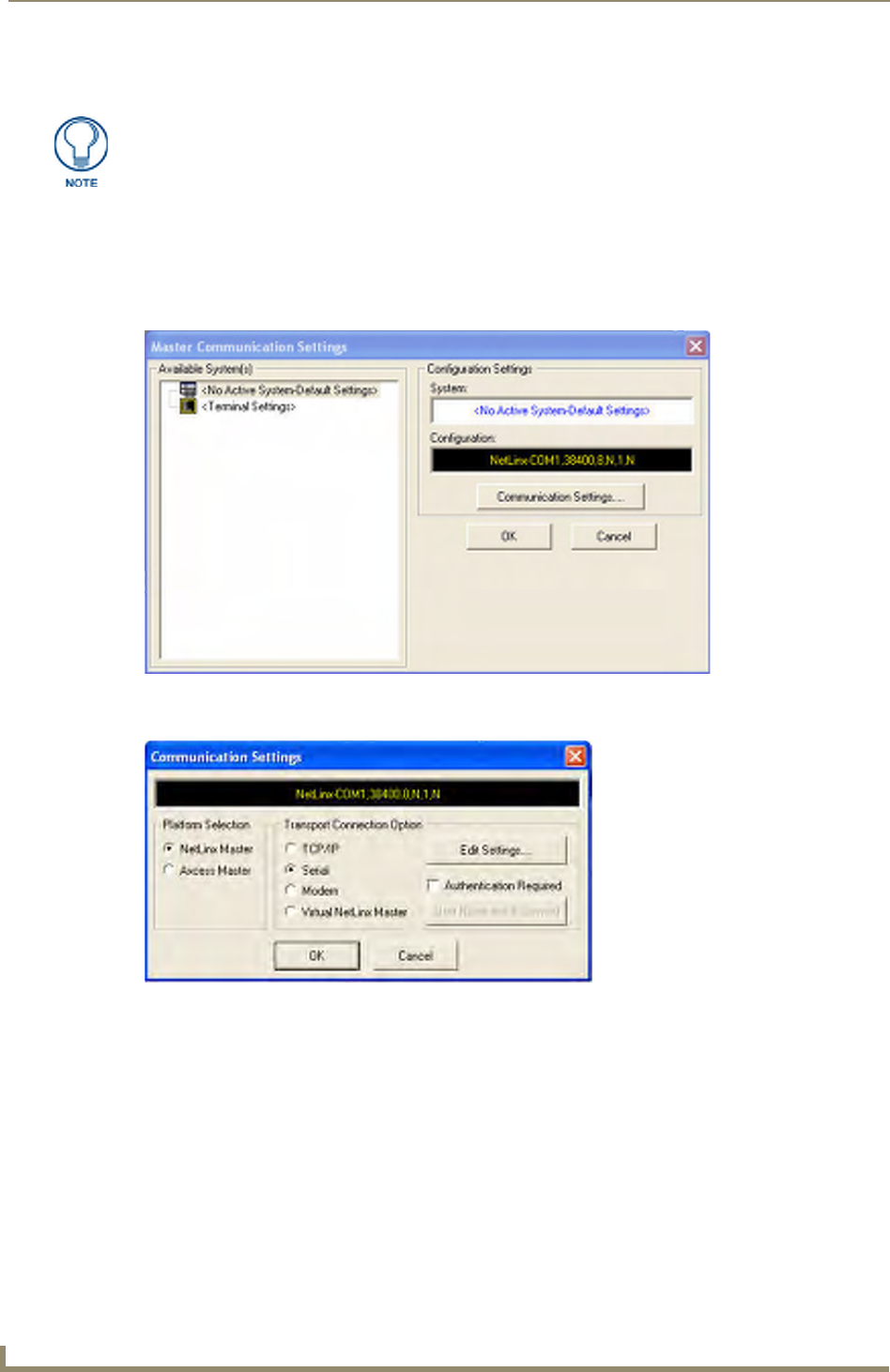
Configuring Communication
38 MVP-9000i Modero® Wireless Touch Panel with Intercom
Master Connection to a Virtual Master via Ethernet
Before beginning:
1. Verify that the panel has been configured to communicate with the Wireless Access Point and confirm
that the signal strength quality bargraph is On.
2. In NetLinx Studio, select Settings > Master Communication Settings from the Main menu to open the
Master Communication Settings dialog (FIG. 37).
3. Click the Communications Settings button to open the Communications Settings dialog (FIG. 38).
4. Click on the Virtual NetLinx Master radio button (from the Platform Selection section) to indicate that
you are working as a NetLinx Master.
5. Click on the Virtual NetLinx Master radio box from the Transport Connection Option section to
indicate wanting to configure the PC to communicate with a panel. Everything else, such as the
Authentication, is greyed out because the procedure is not being made through the Master’s UI.
6. Click the Edit Settings button in the Communications Settings dialog to open the Virtual NetLinx Master
Settings dialog (FIG. 39).
7. From within this dialog, enter the System number (default is 1) and note the IP Address of the target PC
being used as the Virtual Master. This IP Address can also be obtained by following these procedures:
On the PC, click Start > Run to open the Run dialog.
Enter cmd into the Open field and click OK to open the command DOS prompt.
When configuring the panel to communicate with a Virtual Master on your PC via
wireless Ethernet, the Master IP/URL field must be configured to match the IP
Address of the PC. Make sure to use the Virtual System value assigned to the Virtual
Master within NetLinx Studio.
FIG. 37 Master Communications Settings dialog
FIG. 38 Communications Settings dialog
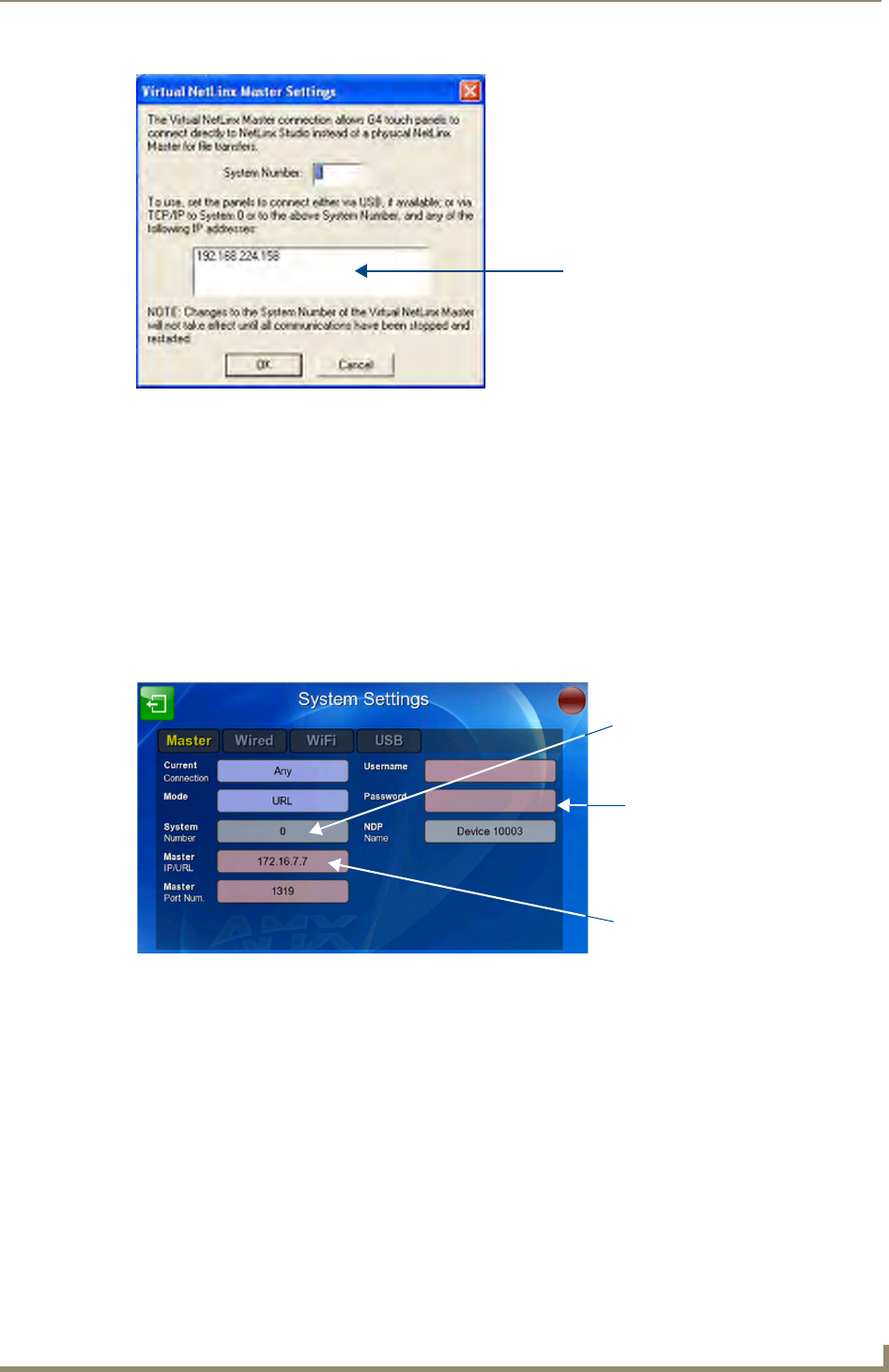
Configuring Communication
39
MVP-9000i Modero® Wireless Touch Panel with Intercom
From the C:\> command line, enter ipconfig to display the IP Address of the PC. This information
is entered into the Master IP/URL field on the panel.
8. Click OK to close the open dialogs, save the settings, and return to the main NetLinx Studio application.
9. Click the OnLine Tree tab in the Workspace window to view the devices on the Virtual System. The
default System value is one.
10. Right-click on the Empty Device Tree/System entry and select Refresh System to re-populate the list.
11. Place the panel in the Table Docking Station or in the Wall Docking Station and turn the panel On.
12. After the panel powers up, press and hold down the Reset button for 6 seconds to continue with the setup
process and proceed to the Setup page.
13. Select Protected Setup > Network to open the System Settings page and Master tab (FIG. 40).
14. Press the Mode field until the choice cycles to the word URL.
By selecting URL, the System Number field becomes read-only (grey) because the panel pulls this value
directly from the communicating target Master, virtual or not. A Virtual Master system value can be set
within the active AMX software applications such as NetLinx Studio, TPD4, or IREdit.
15. Press the Master IP/URL field to open a Keyboard and enter the IP Address of the PC used as the Virtual
Master.
16. Click OK to accept the new value and return to the System Settings page.
17. Do not alter the Master Port Number value, as this is the default value used by NetLinx.
18. Press the Back button twice to open the Status page and save your changes.
FIG. 39 Virtual NetLinx Master Settings dialog
FIG. 40 Sample System Settings page (for Virtual Master communication)
IP Addresses of computer
(also obtained by using the
Start > Run > cmd command
The System number is assigned
to the Master within the AMX
software application (these
MUST match)
When using a Virtual Master,
there is no need to enter a
username and/or password.
Enter the IP Address
information of the PC
used as a Virtual Master.
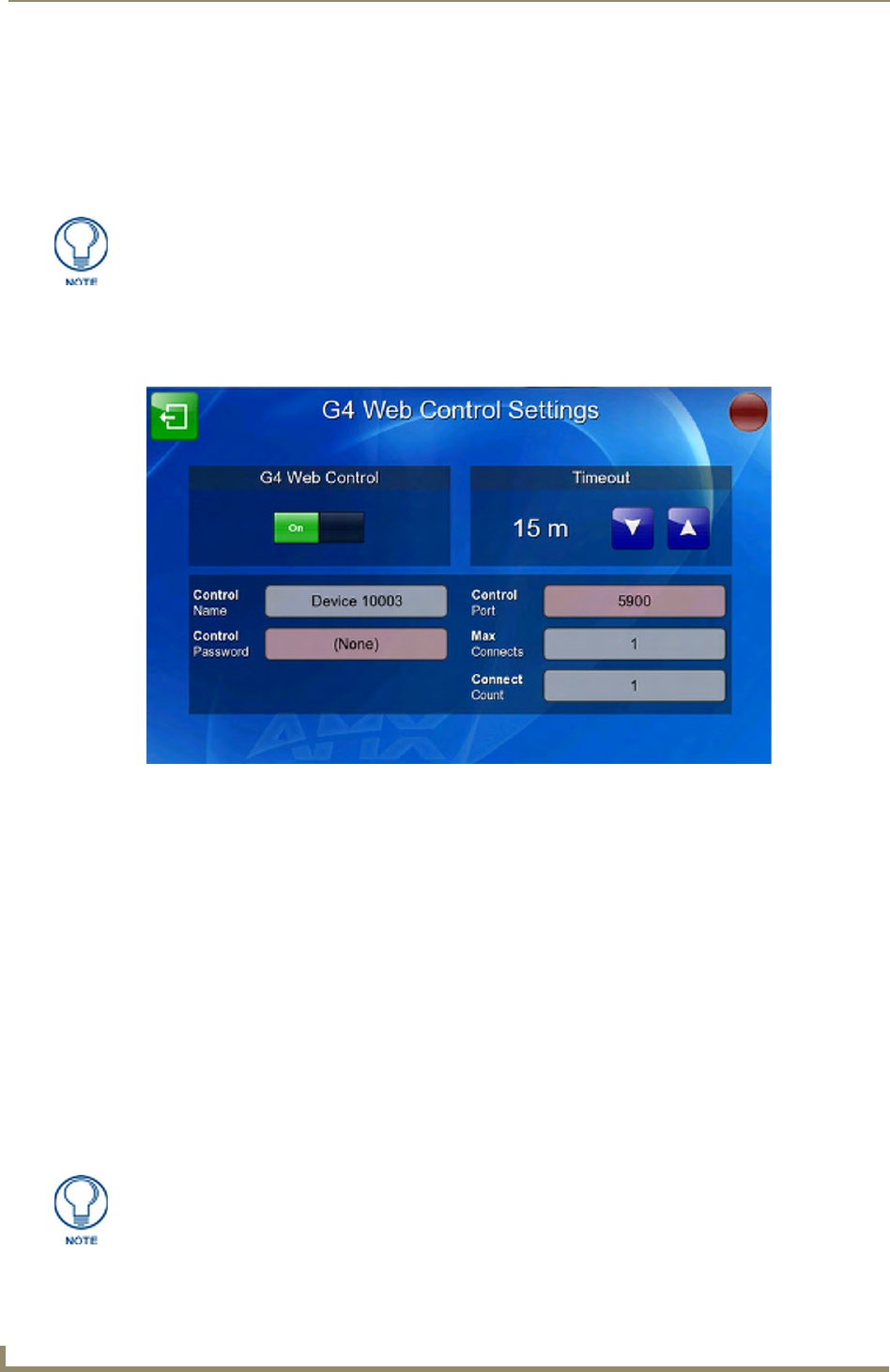
Configuring Communication
40 MVP-9000i Modero® Wireless Touch Panel with Intercom
Using G4 Web Control to Interact with a G4 Panel
The G4 Web Control feature allows you to use a PC to interact with a G4-enabled panel via the Web. This
feature works in tandem with the browser-capable NetLinx Security firmware update (build 300 or higher).
G4 Web Control is only available with the latest Modero panel firmware.
Refer to the G4 Web Control Settings Page section on page 88 for more detailed field information.
1. From the Setup page, press the Protected button (located on the lower-left of the panel page) to open the
Protected Setup page and display an on-screen keypad.
2. Press the G4 WebControl button to open the G4 Web Control Settings page (FIG. 41).
3. Press the G4 Web Control button until it toggles to On and turns green.
4. The Control Name field is exactly the same as the Device Name field in the Protected Setup page.
5. Press the Control Password field to open the Web Password keyboard.
6. From the Web Password keyboard, enter a unique alpha-numeric string to be assigned as the G4
Authentication session password associated with VNC web access of this panel.
7. Press OK to save all changes and return to the G4 Web Control Settings page or Abort to return to the
page without saving any changes.
8. Press the Control Port field to open the Web Port Number keypad.
9. Within the keypad, enter a unique numeric value to be assigned to the port on which the VNC Web Server
is running. The default value is 5900. Press OK after entering the value.
10. Press the Up/Down arrows in the Timeout section to increase or decrease the amount of time the device
can remain idle with no cursor movements before the session is closed and the user is disconnected. The
options are Off; 3, 5, 10, 15, and 30 minutes; and 1, 2, 3, and 4 hours.
11. Press the Back button twice to return to the Status page and save any changes.
Verify your NetLinx Master (ME260/64 or NI-Series) has been installed with the latest
firmware KIT file from www.amx.com. Refer to the NetLinx Master instruction
manual for more detailed information on the use of the new Web-based NetLinx
Security.
FIG. 41 G4 Web Control Settings page
Verify that the NetLinx Master’s IP Address and System Number have been properly
entered into the Master tab of the System Settings page.
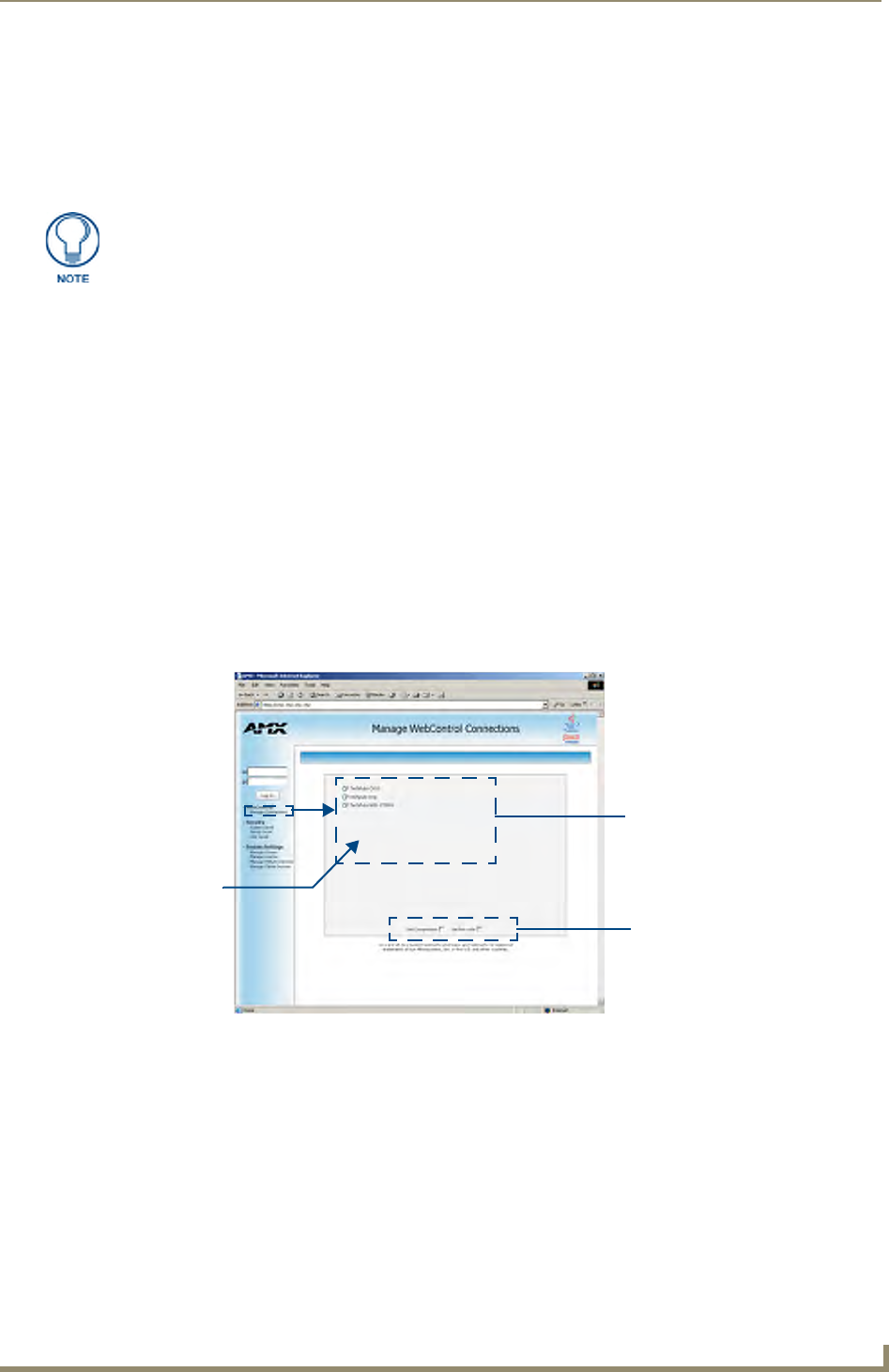
Configuring Communication
41
MVP-9000i Modero® Wireless Touch Panel with Intercom
Using the NetLinx Master To Control the G4 Panel
Refer to the particular NetLinx Master’s instruction manual for detailed information on how to download the
latest firmware from www.amx.com. This firmware build enables SSL certificate identification and
encryption, HTTPS communication, ICSP data encryption, and disables the ability to alter the Master security
properties via a TELNET session.
Once the Master’s IP Address has been set through NetLinx Studio version 2.x or higher:
1. Launch your web browser.
2. Enter the IP Address of the target Master (example: http://198.198.99.99) into the web browser’s Address
field.
3. Press the Enter key on your keyboard to begin the communication process between the target Master and
your computer.
Initially, the Master Security option is disabled from within the System Security page, and no
username and password is required for access or configuration.
Both HTTP and HTTPS Ports are enabled by default via the Manage System > Server page.
If the Master has been previously configured for secured communication, click OK to accept the
AMX SSL certificate, if SSL is enabled, and then enter a valid username and password into the
fields within the Login dialog.
4. Click OK to enter the information and proceed to the Master’s Manage WebControl Connections window.
This page (FIG. 42) is accessed by clicking on the Manage connections link (within the Web Control
section within the Navigation frame). Once activated, this page displays links to G4 panels running the
latest G4 Web Control feature that were previously set up and activated on the device.
5. Click on the G4 panel name link associated with the target panel. A secondary web browser window
appears on the screen (FIG. 43).
In order to make full use of the SSL encryption, the web browser used should incorporate an
encryption feature. This encryption level is displayed as a Cipher strength.
FIG. 42 Manage WebControl Connections page (populated with compatible panels)
Compatible
devices field
(showing G4
WebControl links)
Compression
Options
G4 panels
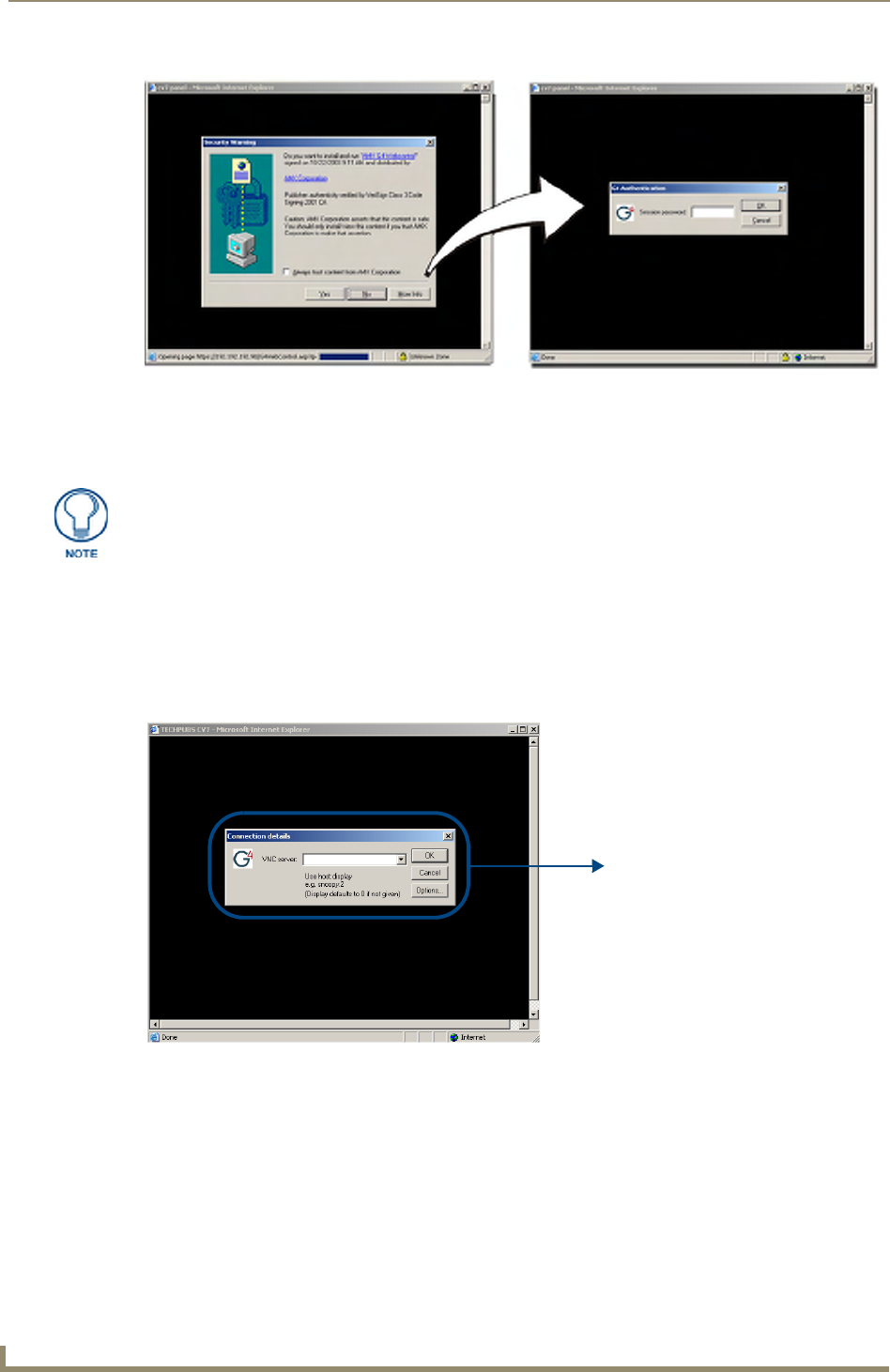
Configuring Communication
42 MVP-9000i Modero® Wireless Touch Panel with Intercom
6. Click Yes from the Security Alert popup window to agree to the installation of the G4 WebControl
application on your computer. This application contains the necessary Active X and VNC client
applications necessary to properly view and control the panel pages from your computer.
7. Some situations might display a Connection Details dialog (FIG. 44) requesting a VNC Server IP
Address. This is the IP Address not of the Master but of the target touch panel. Depending on which
method of communication is being used, it can be found in either:
Wired Ethernet - System Settings > IP Settings section within the IP Address field.
Wireless - Wireless Settings > IP Settings section within the IP Address field.
If this field does not appear, continue to step 9.
8. If a WebControl password was set up on the G4 WebControl page, a G4 Authentication Session password
dialog box appears on the screen within the secondary browser window.
9. Enter the Web Control session password into the Session Password field (FIG. 44).
This password was previously entered into the Control Password field within the G4 Web Control Settings
page on the panel.
10. Click OK to send the password to the panel and begin the session.
A confirmation message appears stating "Please wait, Initial screen loading.".
FIG. 43 Web Control VNC installation and Password entry screens
The G4 Web Control application is sent by the panel to the computer that is used for
communication. Once the application is installed, this popup will no longer appear.
This popup will only appear if you are connecting to the target panel using a different
computer.
FIG. 44 Connection Details dialog
IP Address of touch panel
- obtained from WiFi tab of
the System Settings page
(MVP-9000i)

Configuring Communication
43
MVP-9000i Modero® Wireless Touch Panel with Intercom
The secondary window is then populated with the same G4 page being displayed on the target G4
panel.
A small circle appears within the on-screen G4 panel page and corresponds to the location of the
mouse cursor.
A left-mouse click on the computer-displayed panel page equates to an actual touch on the target
G4 panel page.

Configuring Communication
44 MVP-9000i Modero® Wireless Touch Panel with Intercom
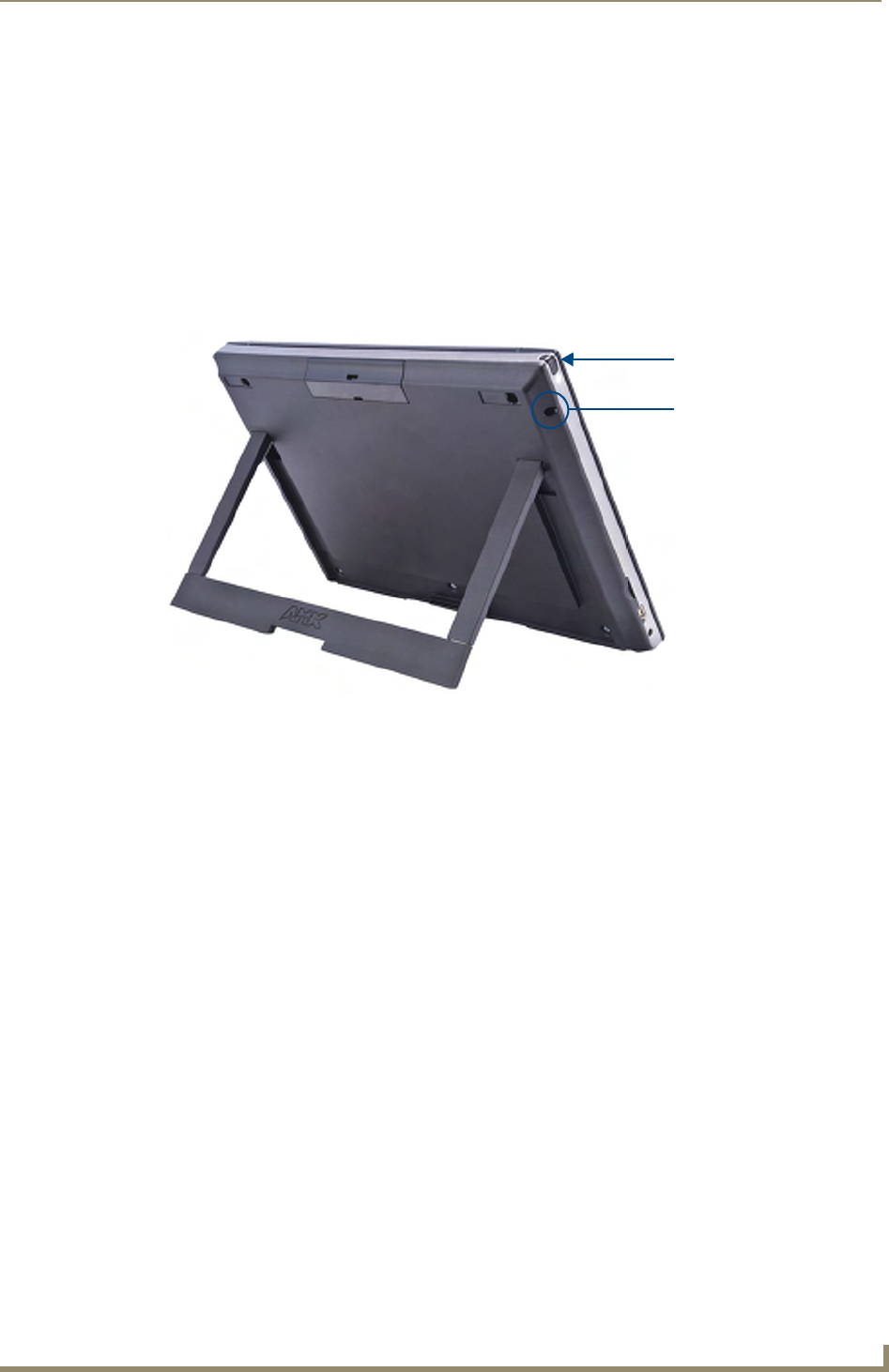
Setup Pages
45
MVP-9000i Modero® Wireless Touch Panel with Intercom
Setup Pages
Overview
The MVP-9000i features on-board Setup pages. Use the options in the Setup pages to access panel information
and make various configuration changes.
Accessing the Setup pages
To access the Setup pages, press the Reset button on the left side of the MVP-9000i with the stylus for 6
seconds (FIG. 45).
The Reset button allows access to three different modes. Pressing and holding for 6 seconds opens the Setup
page. Continuing to hold for a total of 9 seconds opens the Calibrate page (page 87). Holding the Reset
button for 12 seconds will put the device into Shutdown Mode.
Landscape and Portrait Mode Setup Pages
If desired, the MVP-9000i may be switched between landscape and portrait orientation modes via the System
& Panel Options page in the Protected Setup pages (page 61). Separate setup page files must be downloaded
for each mode. These files are available at www.amx.com.
FIG. 45 Setup Page Access on the MVP-9000i
Stylus
Reset button
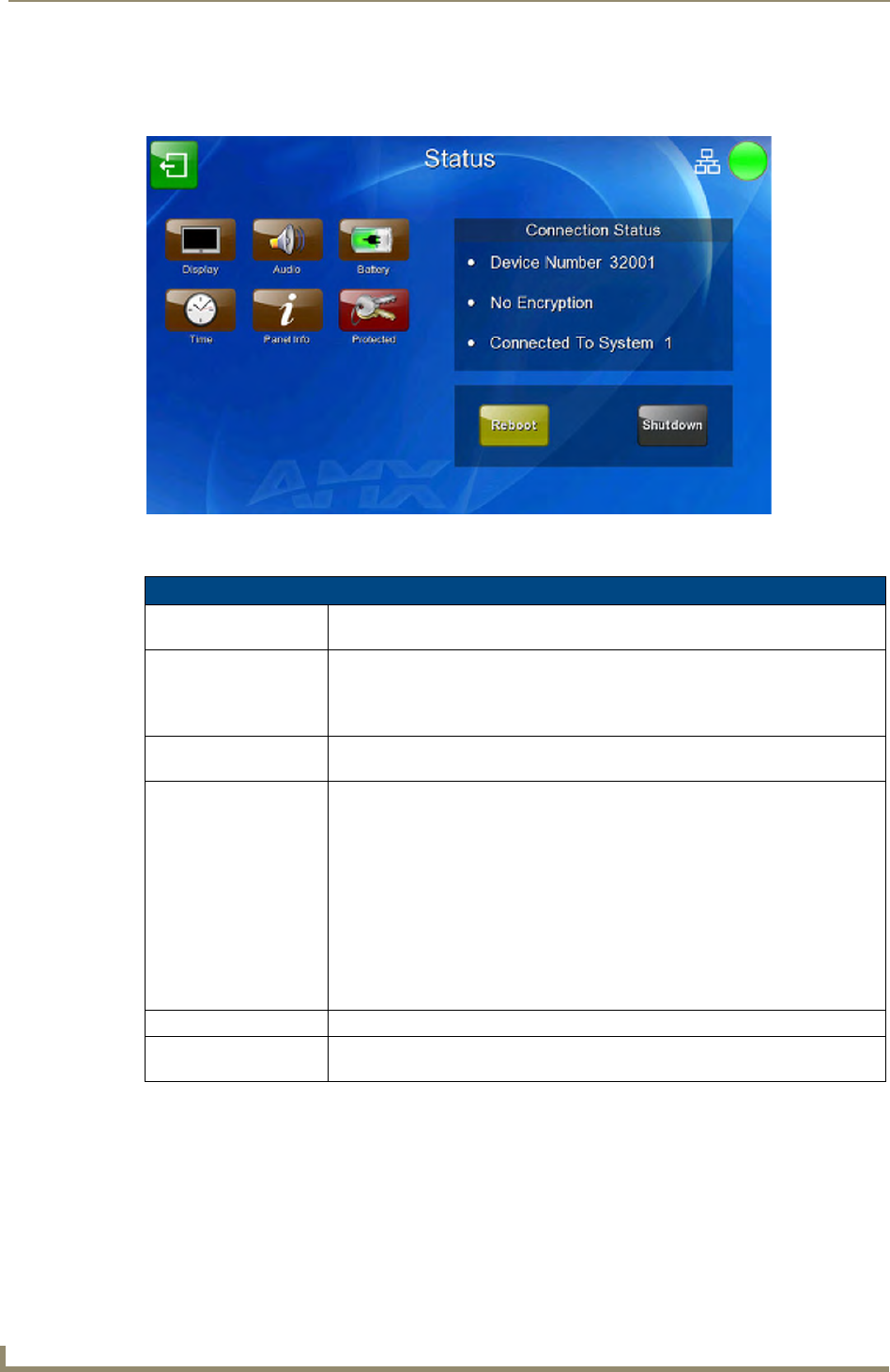
Setup Pages
46 MVP-9000i Modero® Wireless Touch Panel with Intercom
Status Page
The Status page (FIG. 46) allows quick access to several essential panel properties:
Features on this page include: .
To shut down the panel:
1. Access the Setup page.
2. Press the Shutdown button.
3. Disconnect any power source plugs or USB connections, if necessary.
FIG. 46 MVP-9000i Status page
Status Page
Back icon: The icon in the upper-left corner of each Setup page allows the user to return to
the previously selected page.
Connection Status icon: The icon in the upper-right corner of each Setup page provides a constant visual
indication of current connection status.
Note: a Lock appears on the icon if the panel is connected to a secured NetLinx
Master.
Navigation Buttons: The buttons along on the left half of the page provide access to secondary Setup
pages (see following sections).
Connection Status: Displays whether the panel is has external communication, as well as the
encryption status of the Master, the connection type (Ethernet or USB), and to
which System the panel is connected.
• The Connection Status field always displays the device number. If the device has
not been established on a network, the device number will read “0”.
• Until a connection is established, the message displayed is: “Attempting
connection.”.
• When a connection is established, the message displayed is either: “Connected
via Ethernet “or “Connected via USB “.
• The word “Encrypted” appears when an encrypted connection is established with
a NetLinx Master.
Reboot button: Press this button to reboot the panel.
Shutdown button: Press this button to shut off the panel. If the panel is docked in a docking station or
otherwise connected to external power, this button will be greyed out.
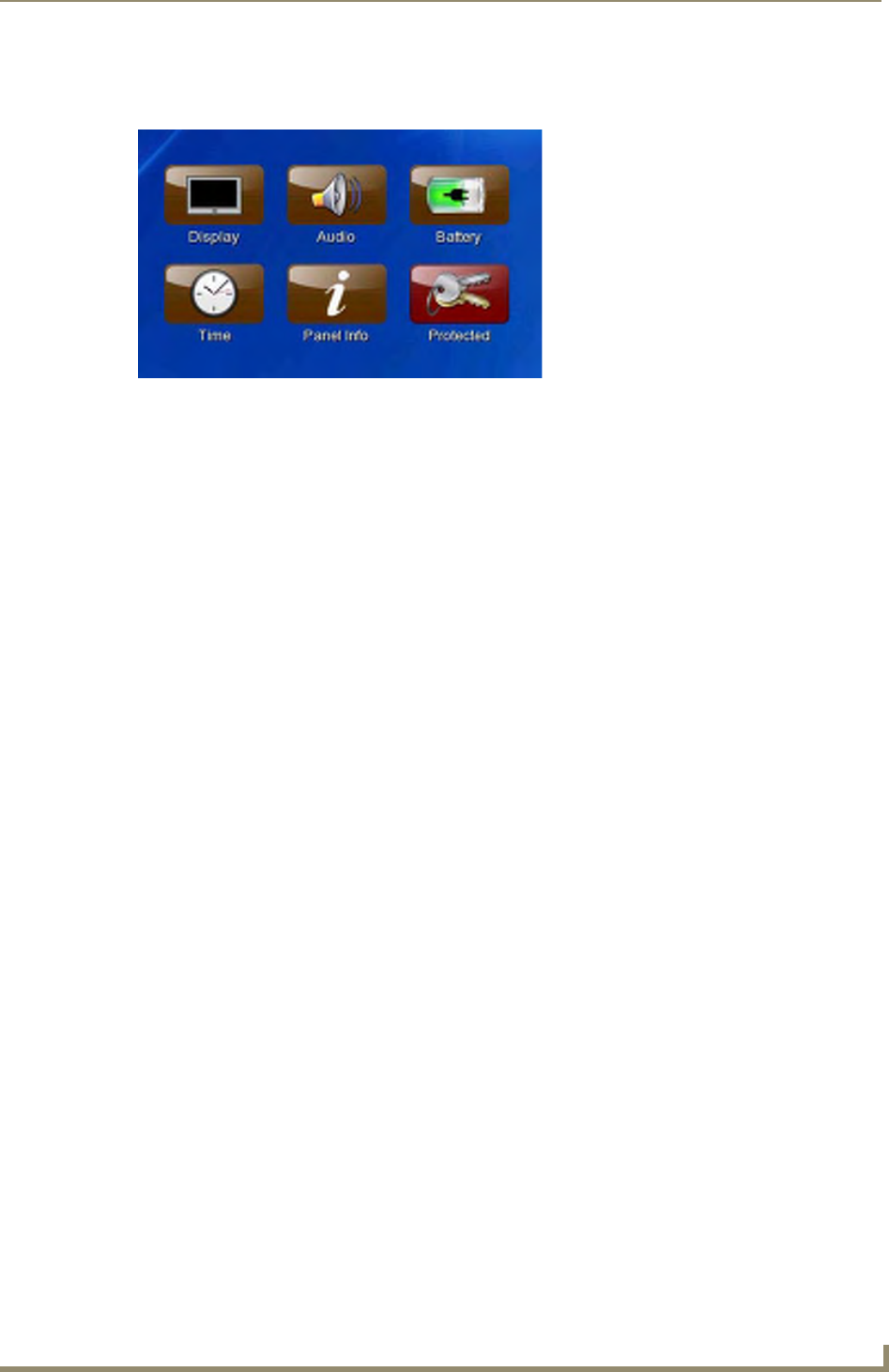
Setup Pages
47
MVP-9000i Modero® Wireless Touch Panel with Intercom
Navigation Buttons
The following Navigation buttons (FIG. 47) appear on the left side of the Status page:
The six buttons include:
Display: this button opens the Display page (page 48)
Audio: this button opens the Audio page (page 49)
Battery: this button opens the Power Management page (page 51)
Time: this button opens the Date/Time page (page 53)
Panel Info: this button opens the Panel Information page (page 58)
Protected: this button opens the Protected Setup page (page 59)
FIG. 47 Navigation buttons on the Status page
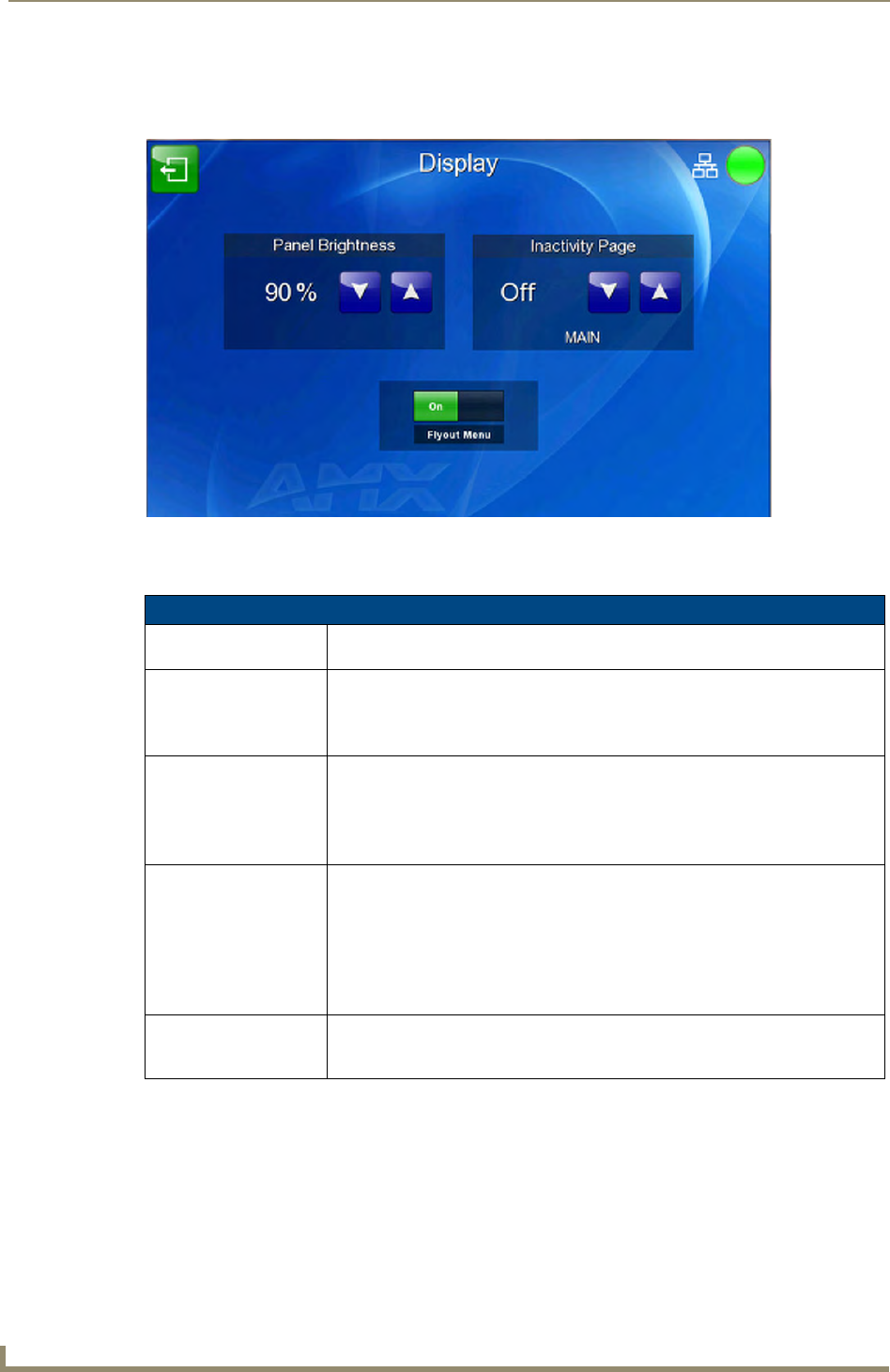
Setup Pages
48 MVP-9000i Modero® Wireless Touch Panel with Intercom
Display Page
The Display page controls the basic functions of the touch panel display, including the panel brightness.
The features on this page include:
FIG. 48 Display page
Display Page
Back icon: The icon in the upper-left corner of each Setup page allows the user to return to
the previously selected page.
Connection Status icon: The icon in the upper-right corner of each Setup page provides a constant visual
indication of current connection status.
Note: a Lock appears on the icon if the panel is connected to a secured NetLinx
Master.
Panel Brightness: Sets the display brightness and contrast levels of the panel.
• Press the Brightness Up/Down buttons to adjust the brightness level.
Range = 0 - 100.
Note: Be careful not to turn down the brightness too low to be able to see the
Setup page.
Inactivity Page: Indicates the length of time that the panel can remain idle before automatically
flipping to a pre-selected page.
• Press the Up/Down buttons to increase/decrease the Inactivity Page Flip
Timeout setting. Range = 1, 2, 5, 10, 15, 30 minutes, 1, 2, 3, 4 hours.
• Set the timeout value to 0 to disable Inactivity Page mode.
Note: The touch panel page used for the Inactivity page flip is named within a
small Inactivity Page field below the buttons. The default reading is “MAIN”.
Flyout Menu: This switch controls the flyout menus on the capacitive touch buttons on the left of
the screen. “On” allows use of any flyout menus connected to the buttons, and
“OFF” disables them.
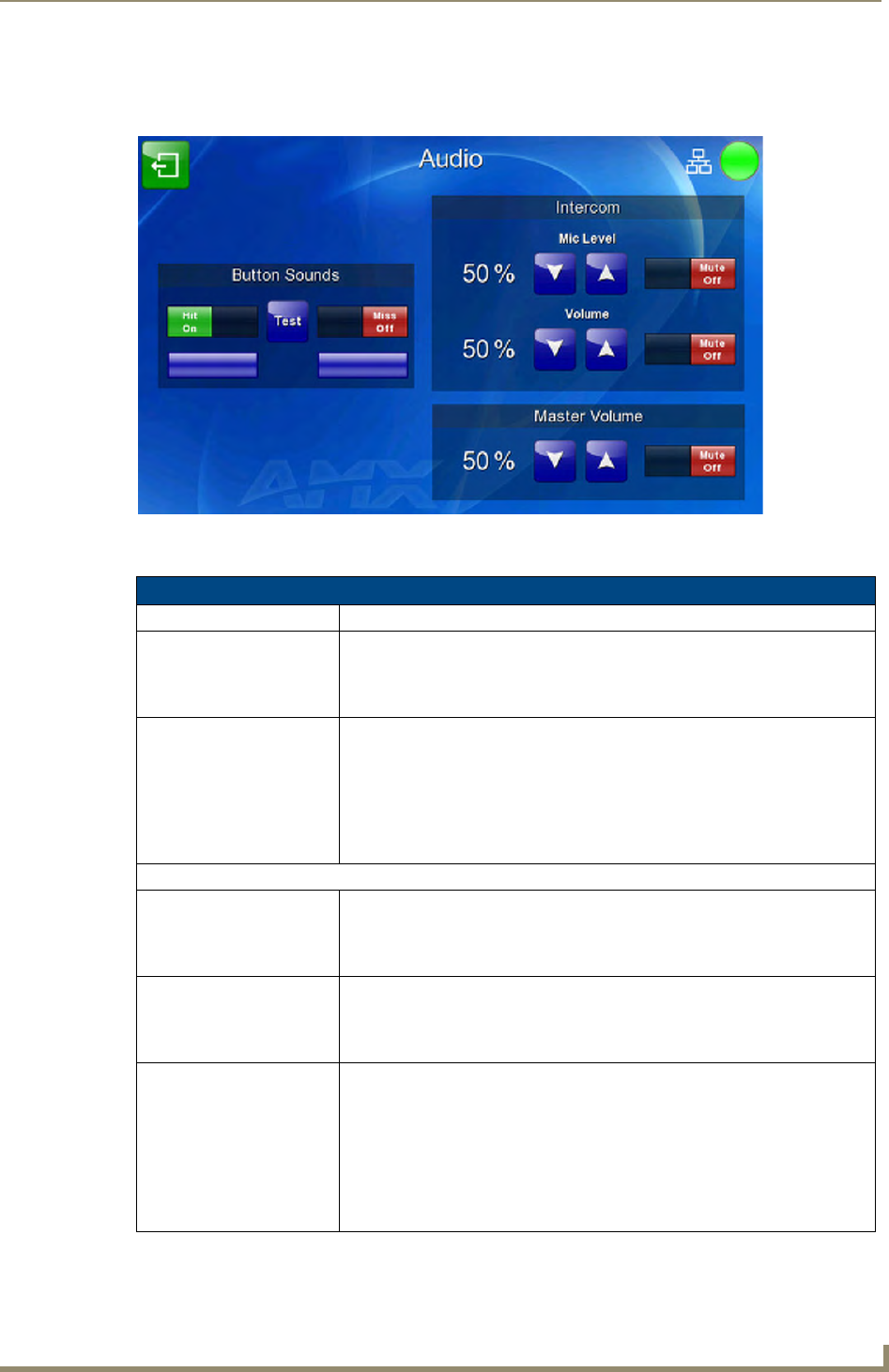
Setup Pages
49
MVP-9000i Modero® Wireless Touch Panel with Intercom
Audio Page
The Audio page allows adjustment of volume levels and panel sounds settings (FIG. 49).
Features on this page include:
FIG. 49 Audio pages
Audio Page
Back: Saves all changes and returns to the previous page.
Connection Status icon: The icon in the upper-right corner of each Setup page provides a constant
visual indication of current connection status.
Note: a Lock appears on the icon if the panel is connected to a secured NetLinx
Master.
Button Sounds: • Activating the Hit On button plays a default sound when you touch an active
button. Touch the field a second time to switch the button to Hit Off, which
disables the sound.
• Activating Miss On button plays a default sound when you touch a non-active
button or any area outside of the active button. Touch the field a second time
to switch the button to Miss Off, which disables the sound.
•The Test button plays a test WAV/MP3 file over the panel’s internal speakers.
Intercom
Mic Level: Adjusts the volume level on the intercom’s microphone:
• Use the Up/Down buttons to adjust the microphone level (range = 0 - 100%).
Press the Mute On button to mute the microphone and press it again
(switching the button to Mute Off) to enable it.
Volume: Adjusts the volume level on the touch panel’s speaker:
• Use the Up/Down buttons to adjust the speaker level (range = 0 - 100%).
Press the Mute On button to mute the speaker and press it again (switching
the button to Mute Off) to enable it.
Master Volume: This section allows you to alter the current master volume level:
• Use the Up/Down buttons to adjust the volume level in one-percent
increments (range = 0 - 100%).
• The Master Volume readout indicates the current volume level. Press the Up/
Down buttons to adjust the volume level in one-percent increments (range =
0 - 100%).
• The Mute On button toggles the Mute feature. Press it again to switch it to
Mute Off.
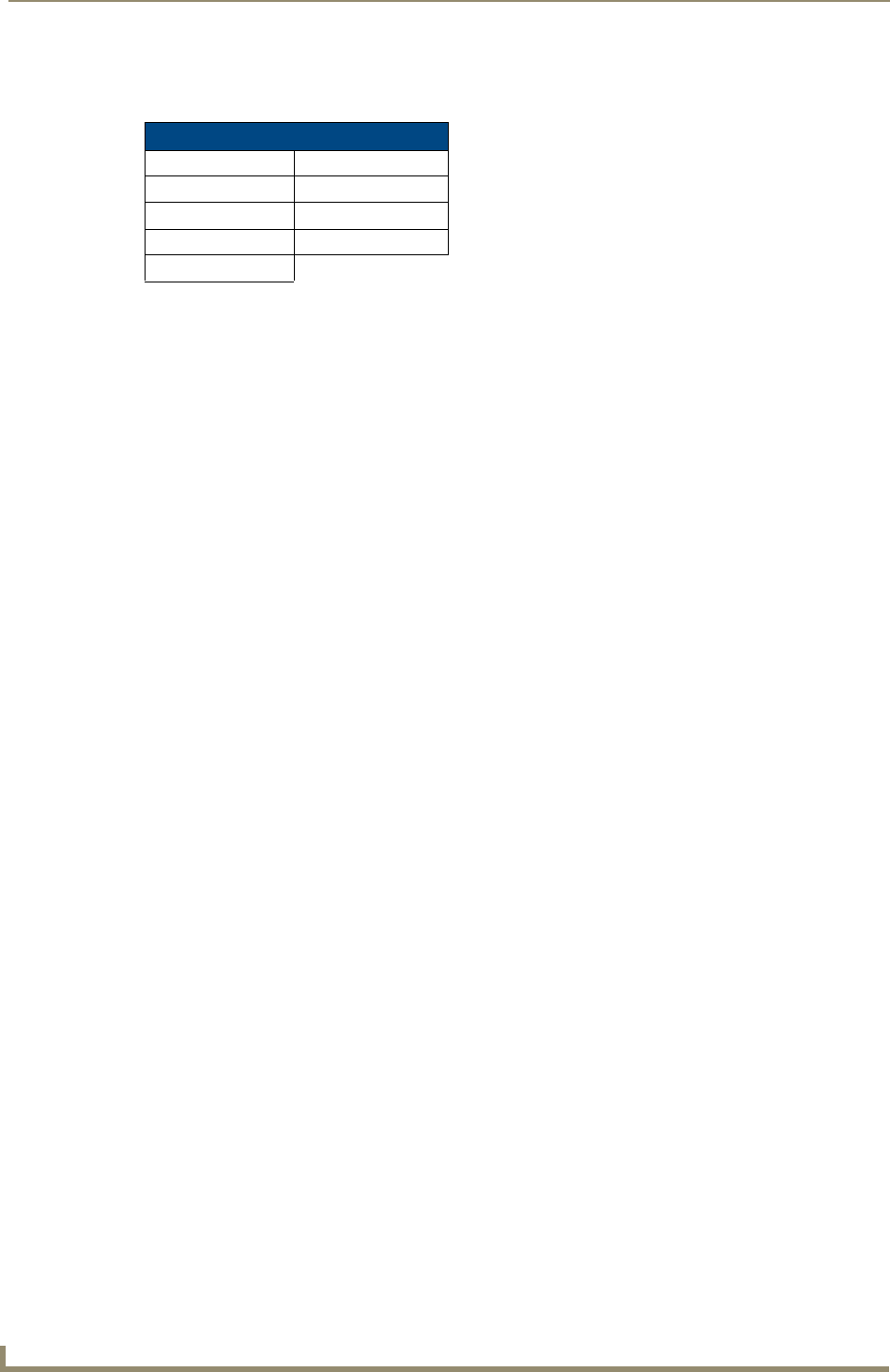
Setup Pages
50 MVP-9000i Modero® Wireless Touch Panel with Intercom
WAV files - Supported Sample Rates
The following sample rates for WAV files are supported by MVP-9000i panels:
Supported WAV Sample Rates
• 48000 Hz • 16000 Hz
• 44100 Hz • 12000 Hz
• 32000 Hz • 11025 Hz
• 24000 Hz • 8000 Hz
• 22050 Hz
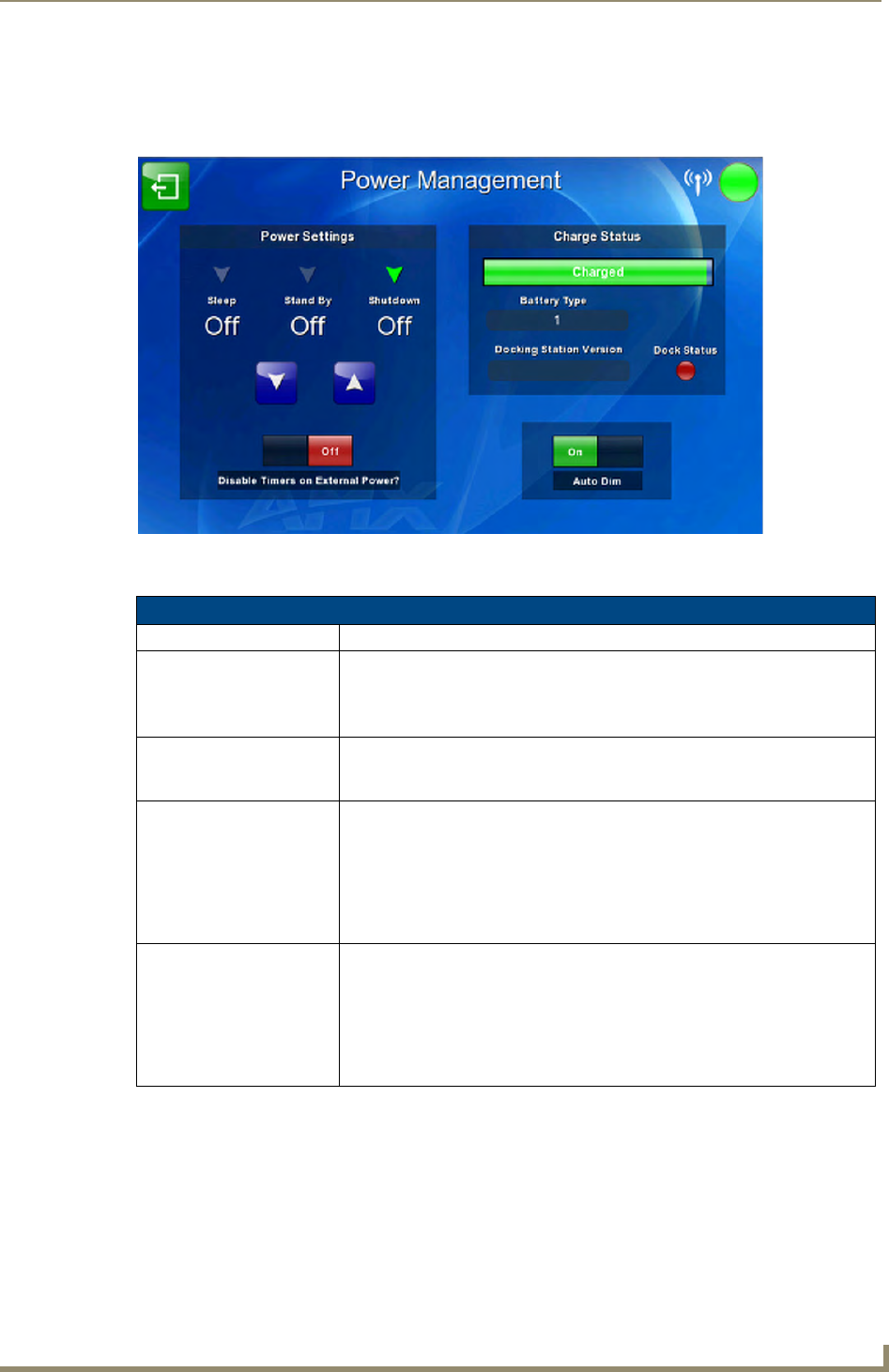
Setup Pages
51
MVP-9000i Modero® Wireless Touch Panel with Intercom
Power Management Page
The options on the Power Management page allow setting of power warning preferences and battery status
information, and adjustment of the display times for battery warnings (FIG. 50)
Features on this page include:
FIG. 50 Power Management page
Power Management Page
Back: Saves all changes and returns to the previous page.
Connection Status icon: The icon in the upper-right corner of each Setup page provides a constant
visual indication of current connection status.
Note: a Lock appears on the icon if the panel is connected to a secured NetLinx
Master.
Power Settings: The three settings in the Power Settings section may be selected by touching
either the arrow to the left of each setting or by touching the entry itself. Each is
highlighted with a green arrow to the left when selected.
Sleep This value determines the number of seconds or minutes that need to pass
before the panel automatically goes into Sleep Mode. Once asleep, the device
may be awakened by touching the buttons on either side of the screen or the
screen itself. Use the Up/Down arrows to change the settings; the
setting bar will change from blue to green to display the percentage of minimum
versus maximum. A value of Off disables this feature.
Range = 10, 15, 20, 25, 30 seconds; 5, 15, 30 minutes; 1, 2 hours Default = Off
Stand By This value determines the number of seconds or minutes that need to pass
before the panel automatically goes into Standby Mode. Once in standby, the
device may be awakened by touching and holding the lowest left button and the
directional pad at the same time. Use the Up/Down arrows to change the set-
tings; the setting bar will change from blue to yellow to display the percentage
of minimum versus maximum. A value of Off disables this feature.
Range = 15, 30 minutes; 1, 2, 3, 4 hours Default = Off
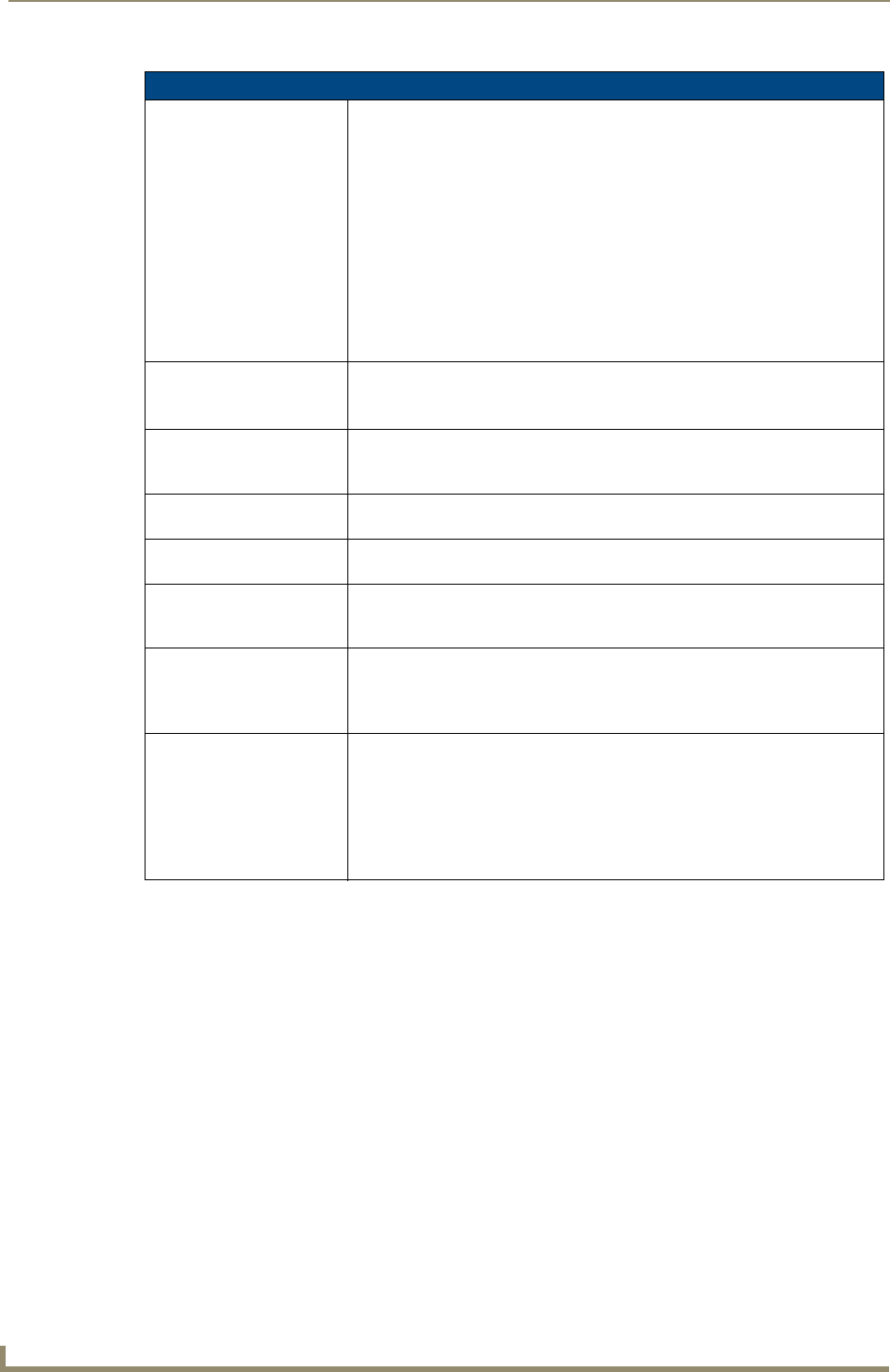
Setup Pages
52 MVP-9000i Modero® Wireless Touch Panel with Intercom
Power Management Page (Cont.)
Shutdown This value determines the number of seconds or minutes that need to pass
before the panel automatically shuts down. Once shut down, the device will
have to be restarted. The Up/Down buttons alter the timeout value (in minutes).
Use the Up/Down arrows to change the settings; the setting bar will change
from blue to orange to display the percentage of minimum versus maximum. A
value of Off disables this feature.
Note: Shutdown mode turns the unit completely off, including communication
circuits, and preserves battery life, unlike Sleep or Standby mode, which only
turn off the display.
From Shutdown mode, a unit must be turned on by pressing and holding the
directional pad or overlay until the panel begins a bootup, which may take up to
a minute.
Range = 3, 5, 10, 15, 30 minutes; 1, 2, 3, 4 hours Default = Off.
Low Battery Warning: The Up/Down buttons adjust the time value (in minutes) available on the battery
(for use) before the panel displays a low battery warning.
Range - 10 - 45, default = 15 min.
Disable Timers on External
Power?:
Touch this button to disable the Sleep, Stand By, and Shutdown timers if the
panel is connected to an external power source, such as a Table or Wall
Docking Station. Touch the button again to enable the timers.
Charge Status: The Charge Status field indicates the power charge currently available on the
battery. When fully charged, the field is green and reads “Charged”.
Battery Type: The Battery Type field indicates the type of battery currently installed in the
MVP-9000i. The value listed is 1.
Docking Station Version: The Docking Station Version field indicates the version of firmware used for
the currently used Table or Wall Docking Station. This field is blank if the panel
is not docked in a Docking Station.
Dock Status: The Dock Status icon turns green when connected to an active Table or Wall
Docking Station, and turns red when disconnected.
NOTE: when using the panel’s included power source, this icon will still appear
red, even if the panel is drawing power from the power source.
Auto Dim: The DISABLE/DISABLED button acts as a power save feature with two options:
•On - Clicking on this button activates the brightness limit set on the panel,
conserving battery power. Activating this feature causes the panel to function
at 80% of full brightness and overrides the Panel Brightness value set on the
Setup page.
•Off - Clicking on this button deactivates this power save feature. The panel
will use the Panel Brightness level.
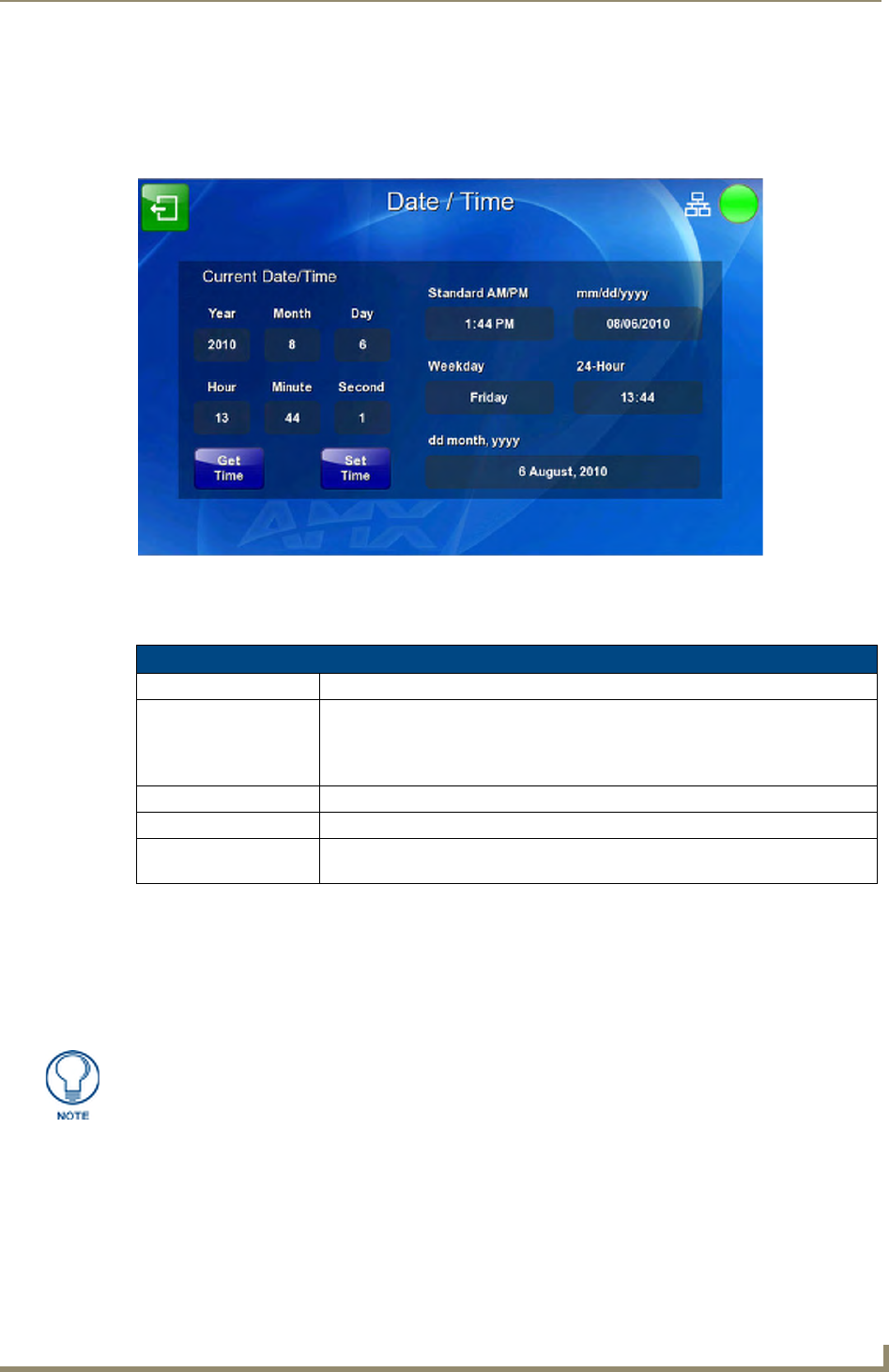
Setup Pages
53
MVP-9000i Modero® Wireless Touch Panel with Intercom
Date/Time Page
The options on the Date/Time page (FIG. 51) allows setting and adjusting of time and date information on the
MVP-9000i. If the time and/or date on the Master is modified, all connected devices will be updated to reflect
the new information.
Features on this page include:
The current date and time may be retrieved from the NetLinx Master, or it may be updated manually. To
retrieve the date and time from the Master:
1. From the Date/Time page, press the Get Time button.
2. The new time and date will be added.
3. Press the Back button to save the changes.
FIG. 51 Date/Time page
Date/Time Page
Back: Saves all changes and returns to the previous page.
Connection Status icon: The icon in the upper-right corner of each Setup page provides a constant visual
indication of current connection status.
Note: a Lock appears on the icon if the panel is connected to a secured NetLinx
Master.
Current Date/Time: These fields display the calendar date information in several different formats.
Get Time: The Get Time button retrieves Time and Date information from the Master.
Set Time: The Set Time button retains and saves any time/date modifications made on the
panel.
If the panel is not connected to a Master, the Get Time function will not work.
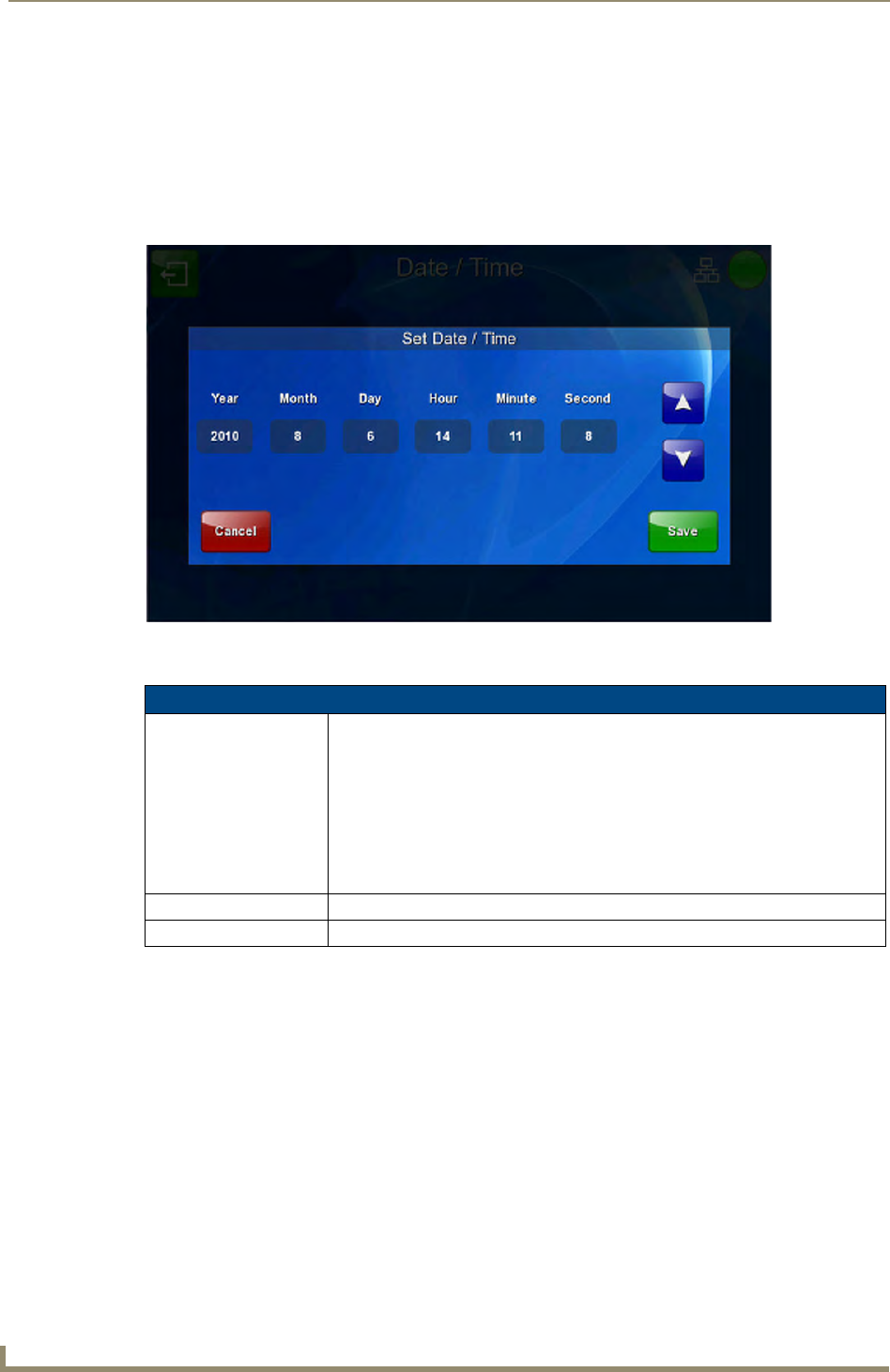
Setup Pages
54 MVP-9000i Modero® Wireless Touch Panel with Intercom
To set the date and time manually on an MVP-9000i:
1. From the Date/Time page, press the Set Time button to open the Set Date/Time popup window (FIG. 52).
2. Touch the field to be changed to highlight it.
3. Use the Up/Down arrows to change the information in the field.
4. To return to the Date/Time page without saving any changes, press Cancel.
5. To save all changes and return to the Date/Time page, press Save.
FIG. 52 Set Date/Time popup window
Set Date/Time Popup Window
Set Date/Time: Use the Up/Down arrow buttons to adjust the MVP-9000i’s calendar date and time.
A white outline around the field indicates which field is currently selected.
•Year range = 2000 - 2199
•Month range = 1 - 12
•Day range = 1 - 31
•Hour = 24-hour military
•Minute range = 0 - 59
•Second range = 0 - 59
Cancel: Touch this button to return to the Date/Time page without saving any changes.
Save: Touch this button to save all changes and return to the Date/Time page.
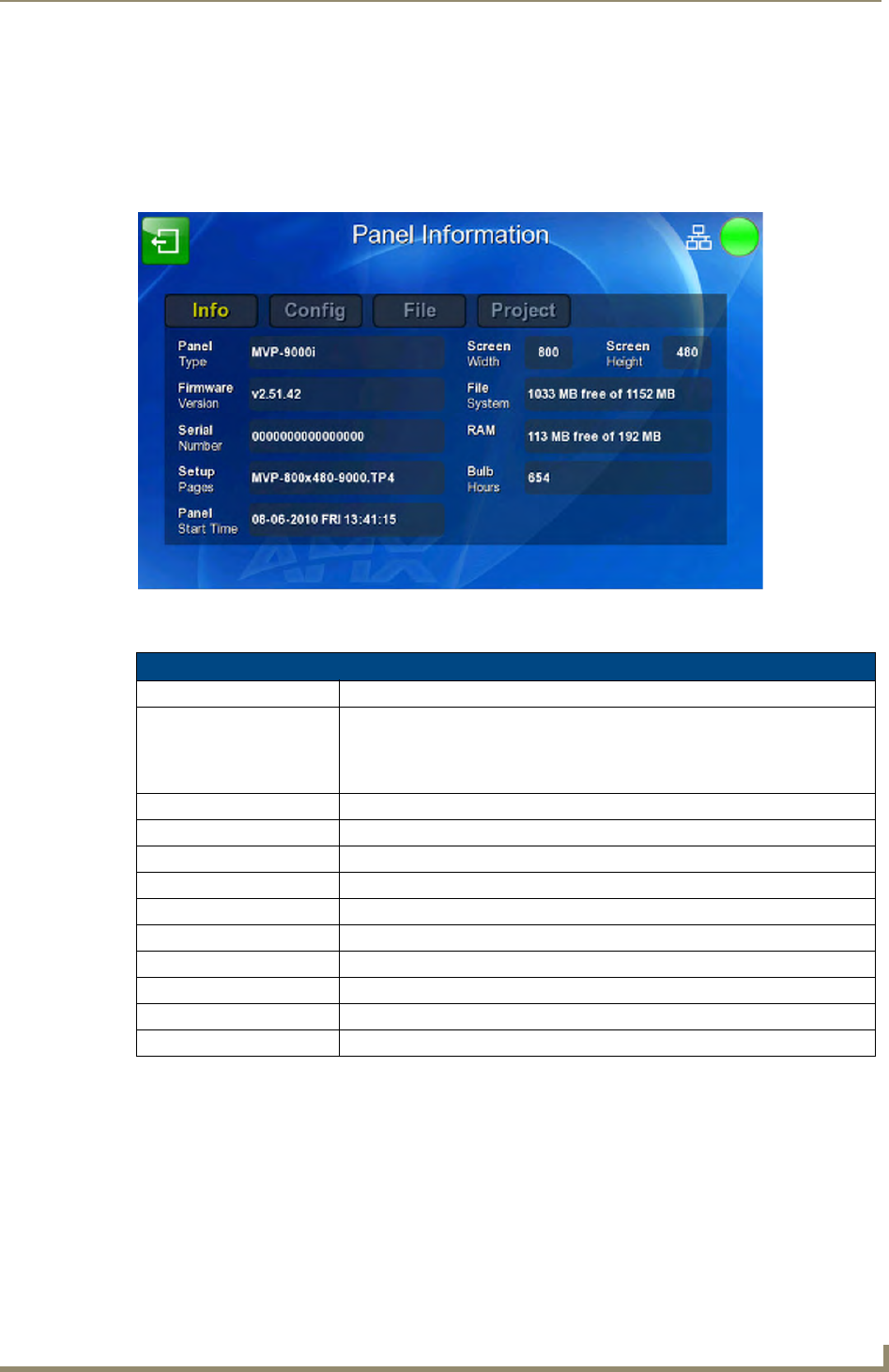
Setup Pages
55
MVP-9000i Modero® Wireless Touch Panel with Intercom
Panel Information Page
The Panel Information page includes four tabs: Info (page 55), Config (page 56), File (page 57), and Project
(page 58).
Panel Information Page - Info
The Info tab of the Panel Information page provides detailed panel information (FIG. 53).
Features on this page include:
FIG. 53 Panel Information page - Info
Panel Information Page - Info
Back: Saves all changes and returns to the previous page.
Connection Status icon: The icon in the upper-right corner of each Setup page provides a constant
visual indication of current connection status.
Note: a Lock appears on the icon if the panel is connected to a secured NetLinx
Master.
Panel Type: Displays the model of the panel being used.
Firmware Version: Displays the version number of the G4 firmware loaded on the panel.
Serial Number: Displays the specific serial number value assigned to the panel.
Setup Pages: Displays the type and version of the Setup pages being used by the panel.
Panel Start Time: Displays the time taken by the panel to wake up from sleep mode.
Screen Width: Displays the screen width (in pixels). MVP-9000i = 800 pixels.
Screen Height: Displays the screen height (in pixels). MVP-9000i = 480 pixels.
File System: Displays the amount of Compact Flash memory available on the panel.
RAM: Displays the available RAM (or Extended Memory module) on the panel.
Bulb Hours: Displays the number of hours elapsed with the display on full power.
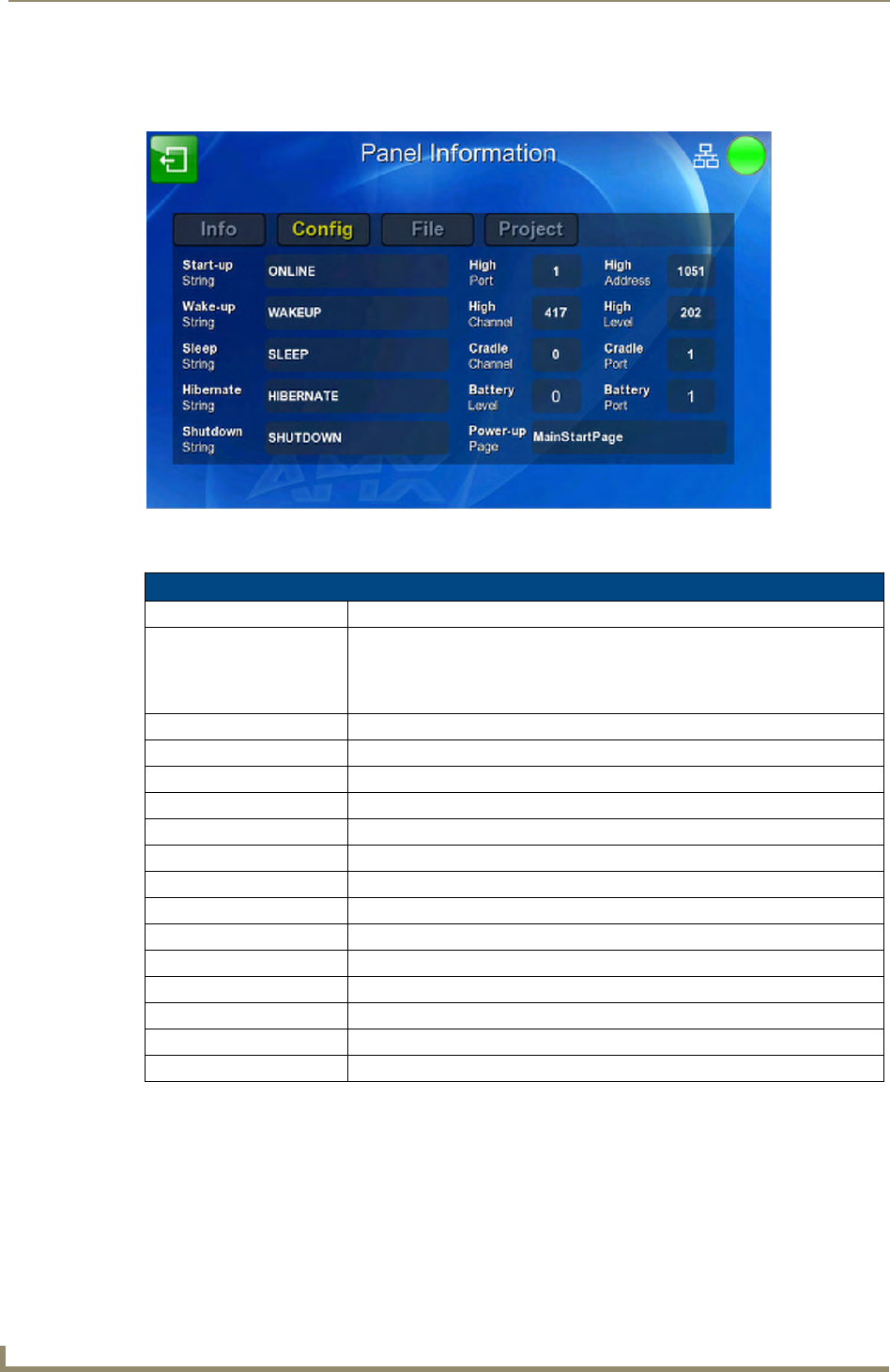
Setup Pages
56 MVP-9000i Modero® Wireless Touch Panel with Intercom
Panel Information Page - Config
The Config tab provides information on the panel’s configuration (FIG. 54).
Features on this page include:
FIG. 54 Panel Information Page - Config
Panel Information Page - Config
Back: Saves all changes and returns to the previous page.
Connection Status icon: The icon in the upper-right corner of each Setup page provides a constant
visual indication of current connection status.
Note: a Lock appears on the icon if the panel is connected to a secured NetLinx
Master.
Start Up String: Displays the start-up string.
Wake Up String: Displays the wake up string used after an activation from a timeout.
Sleep String: Displays the sleep string used during a panel’s Sleep mode.
Hibernate String: Displays the hibernate string used during a panel’s Standby mode.
Shutdown String: Displays the shutdown string used during a panel’s Shutdown mode.
High Port: Displays the high port (port count) value for the panel.
High Address: Displays the high address (address count) value for the panel.
High Channel: Displays the high channel (channel count) value for the panel.
High Level: Displays the high level (level count) value being used by the panel.
Cradle Channel: Displays the cradle channel (channel count) value being used by the panel.
Cradle Port: Displays the cradle port (port count) value for the panel.
Battery Level: Displays the battery level (level count) value for the panel.
Battery Port: Displays the battery port (port count) value for the panel.
Power Up Page: Displays the page assigned to display after the panel is powered-up.
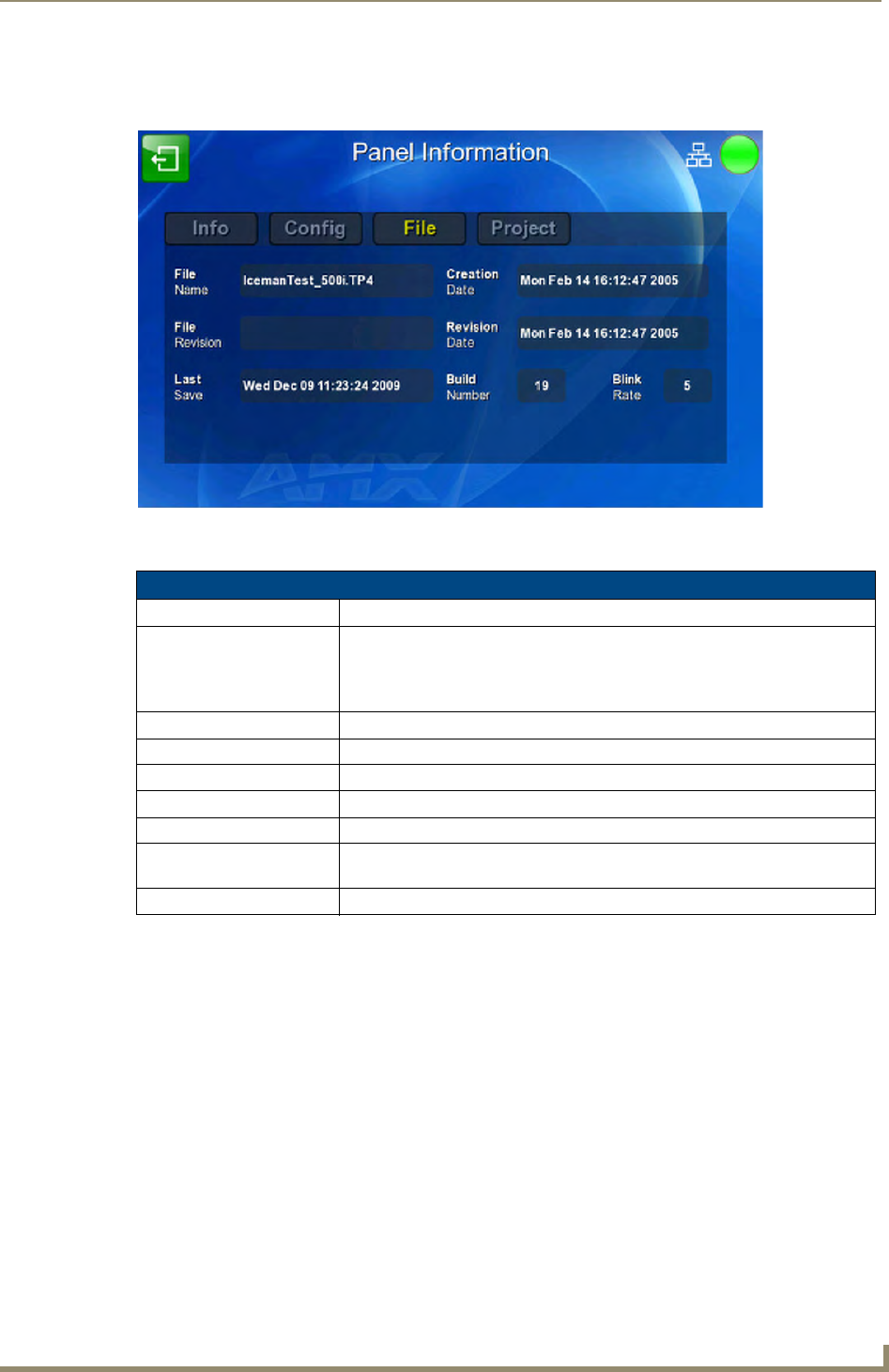
Setup Pages
57
MVP-9000i Modero® Wireless Touch Panel with Intercom
Panel Information Page - File
The File tab displays information on the particular TPDesign4 file used by the panel.
Features on this page include:
FIG. 55 Panel Information page - File
Panel Information Page - File
Back: Saves all changes and returns to the previous page.
Connection Status icon: The icon in the upper-right corner of each Setup page provides a constant
visual indication of current connection status.
Note: a Lock appears on the icon if the panel is connected to a secured NetLinx
Master.
File Name: The name of the TPDesign4 file currently being used for the panel.
File Revision: The revision number of the TPDesign4 file, if applicable.
Last Save: The last save date on the project.
Creation Date: The creation date of the project.
Revision Date: Displays the last revision date for the project.
Build Number Displays the build number information of the TPD4 software used to create the
project file.
Blink Rate: Displays the feedback blink rate, in 5-second increments.
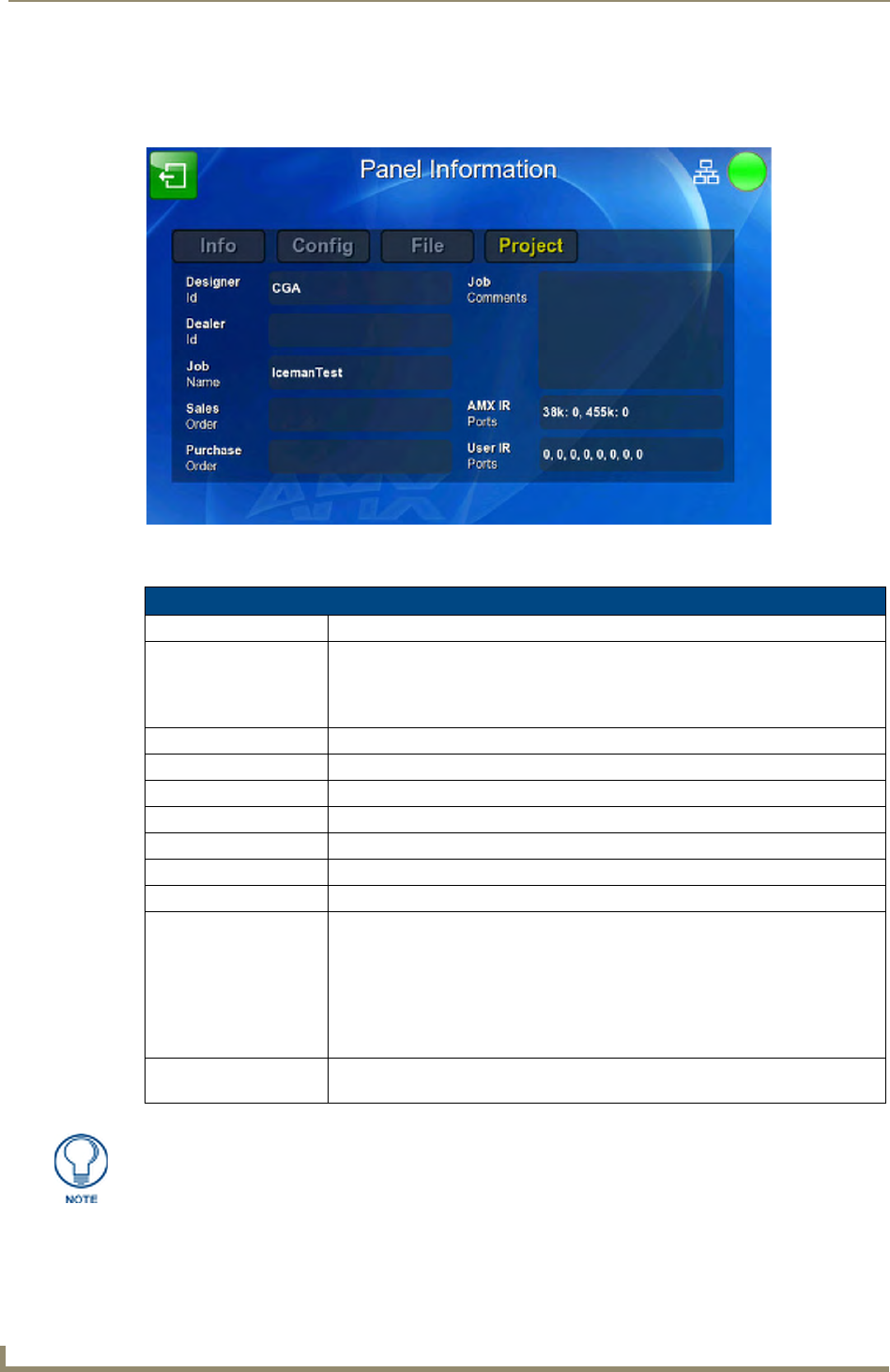
Setup Pages
58 MVP-9000i Modero® Wireless Touch Panel with Intercom
Panel Information Page - Project
The Project tab displays the project properties of the TPDesign4 project file currently loaded on the panel
(FIG. 56).
Features on this page include:
FIG. 56 Panel Information page - Project
Panel Information Page - Project
Back: Saves all changes and returns to the previous page.
Connection Status icon: The icon in the upper-right corner of each Setup page provides a constant visual
indication of current connection status.
Note: a Lock appears on the icon if the panel is connected to a secured NetLinx
Master.
Designer ID: Displays the designer information.
Dealer ID: Displays the dealer ID number (unique to every dealer and entered in TPD4).
Job Name: Displays the job name.
Sales Order: Displays the sales order information.
Purchase Order: Displays the purchase order information.
Job Comments: Displays any comments associated to the job (from the TPD4 project file).
File Name: Displays the name of the TPDesign4 project file downloaded to the panel.
AMX IR Ports: Displays the AMX 38 kHz and 455 kHz IR channel port used by the IR Emitter on
the panel.
• This information is specified in TPD4 (Project Properties > IR Emitters &
Receivers tab).
• For example, if you set the AMX IR 38K Port to 7 and then put a button on the
panel with a channel code of 5 and a port of 7, it will trigger the IR code in slot 5
of the AMX IR 38K Port.
User IR Ports: Displays the primary channel ports used by the IR receiver on the panel. This field
may display up to eight ports being used at one time.
IR receivers and transmitters on G4 panels share the device address number of the
panel.
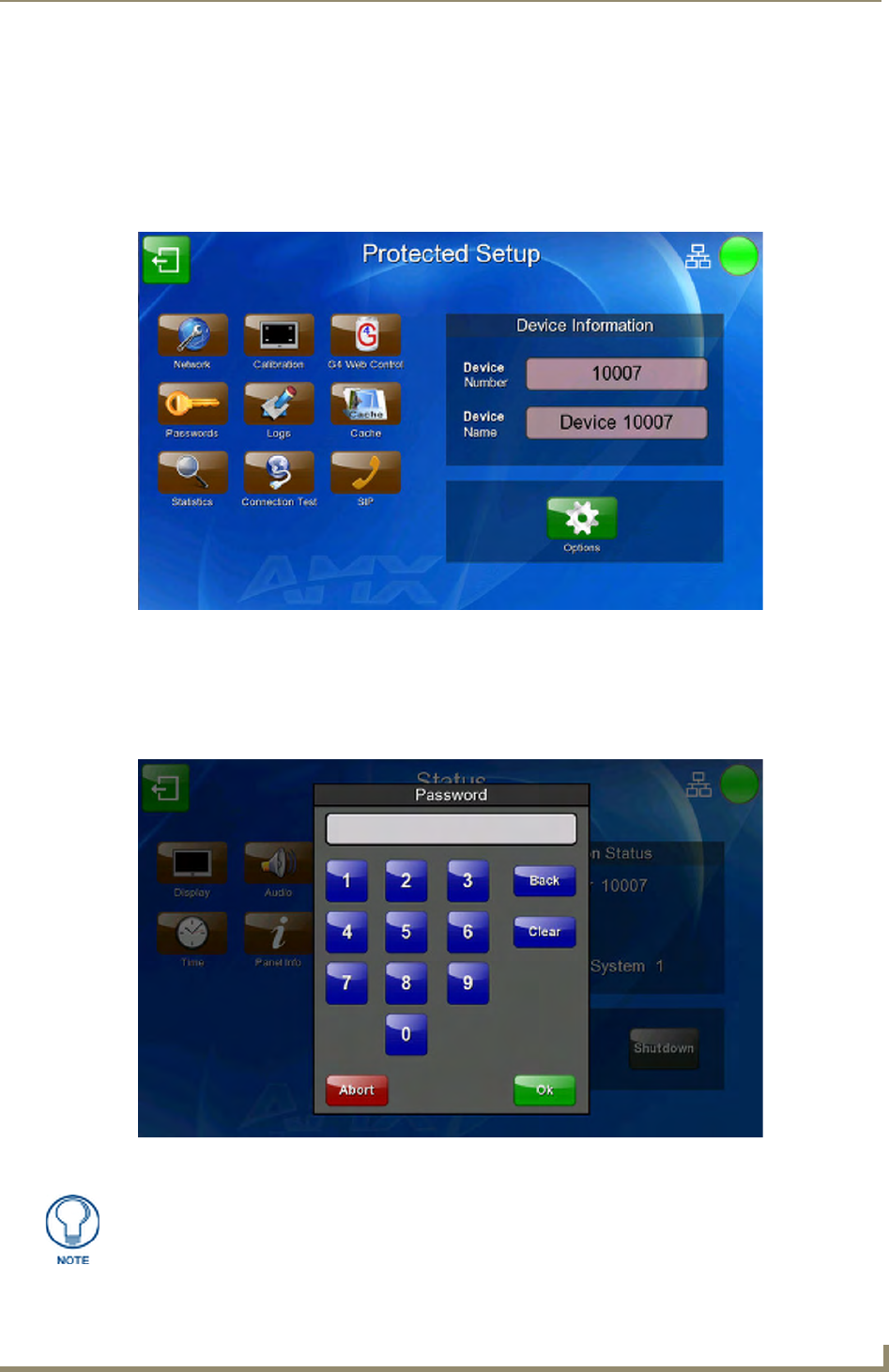
Protected Setup Pages
59
MVP-9000i Modero® Wireless Touch Panel with Intercom
Protected Setup Pages
The Protected Setup page (FIG. 57) provides secured access to advanced panel configuration options,
including communication and security settings. The Protected Setup page is accessed through the Setup page
(please refer to the Setup Pages section on page 45).
To access the Protected Setup pages:
6. From the Setup page, select the Protected button on the left side of the screen. This opens the password
keypad (FIG. 58).
7. Enter the factory default password (1988) into the password keypad to access the page.
FIG. 57 Protected Setup page showing default values
FIG. 58 Protected Settings page password keypad
This password may be changed later through the Passwords section on page 90.
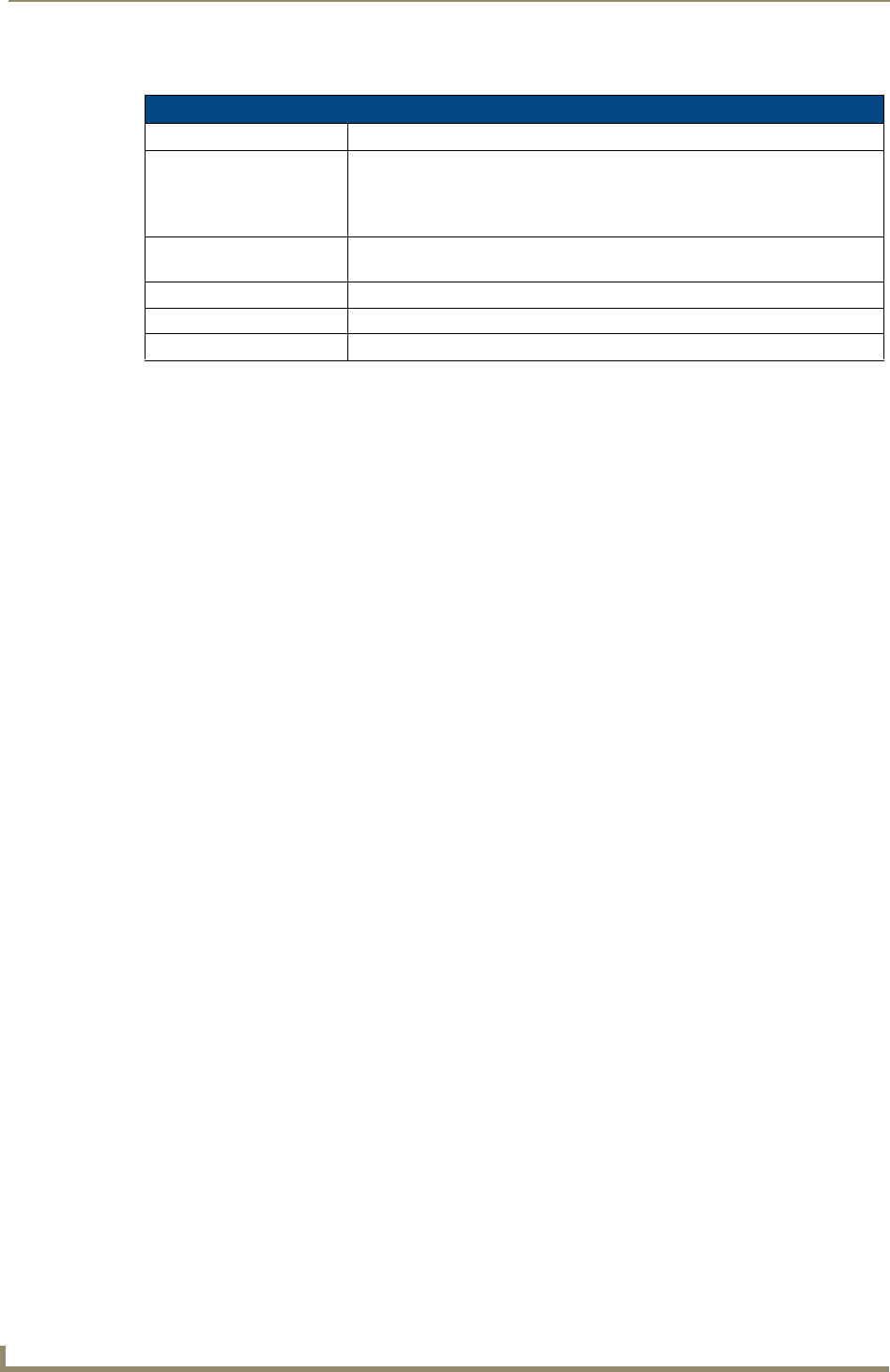
Protected Setup Pages
60 MVP-9000i Modero® Wireless Touch Panel with Intercom
Features on the Protected Setup page include:
The nine buttons include:
Network: this button opens the System Settings page (page 64)
Calibration: this button opens the Calibrate page (page 87)
G4 Web Control: this button opens the G4 Web Control Settings page (page 88)
Passwords: this button opens the Passwords page (page 94)
Logs: this button opens the Panel Logs page (page 92)
Cache: this button opens the Cache Settings page (page 93)
Statistics: this button opens the Panel Statistics page (page 95)
Connection Test: this button opens the Connection Utility page (page 98)
SIP: this button opens the SIP Settings page (page 99)
Protected Setup Page
Back: Saves all changes and returns to the previous page.
Connection Status icon: The icon in the upper-right corner of each Protected Setup page provides a
constant visual indication of current connection status.
Note: a Lock appears on the icon if the panel is connected to a secured NetLinx
Master.
Navigation Buttons: The buttons along on the left side of the page provide access to secondary
Protected Setup pages (see following sections).
Device Number: Opens a keypad used to view or change the device number of the panel.
Device Name Opens a keypad used to view or change the device name used for the panel.
Options: Opens the System & Panel Options page (page 61).
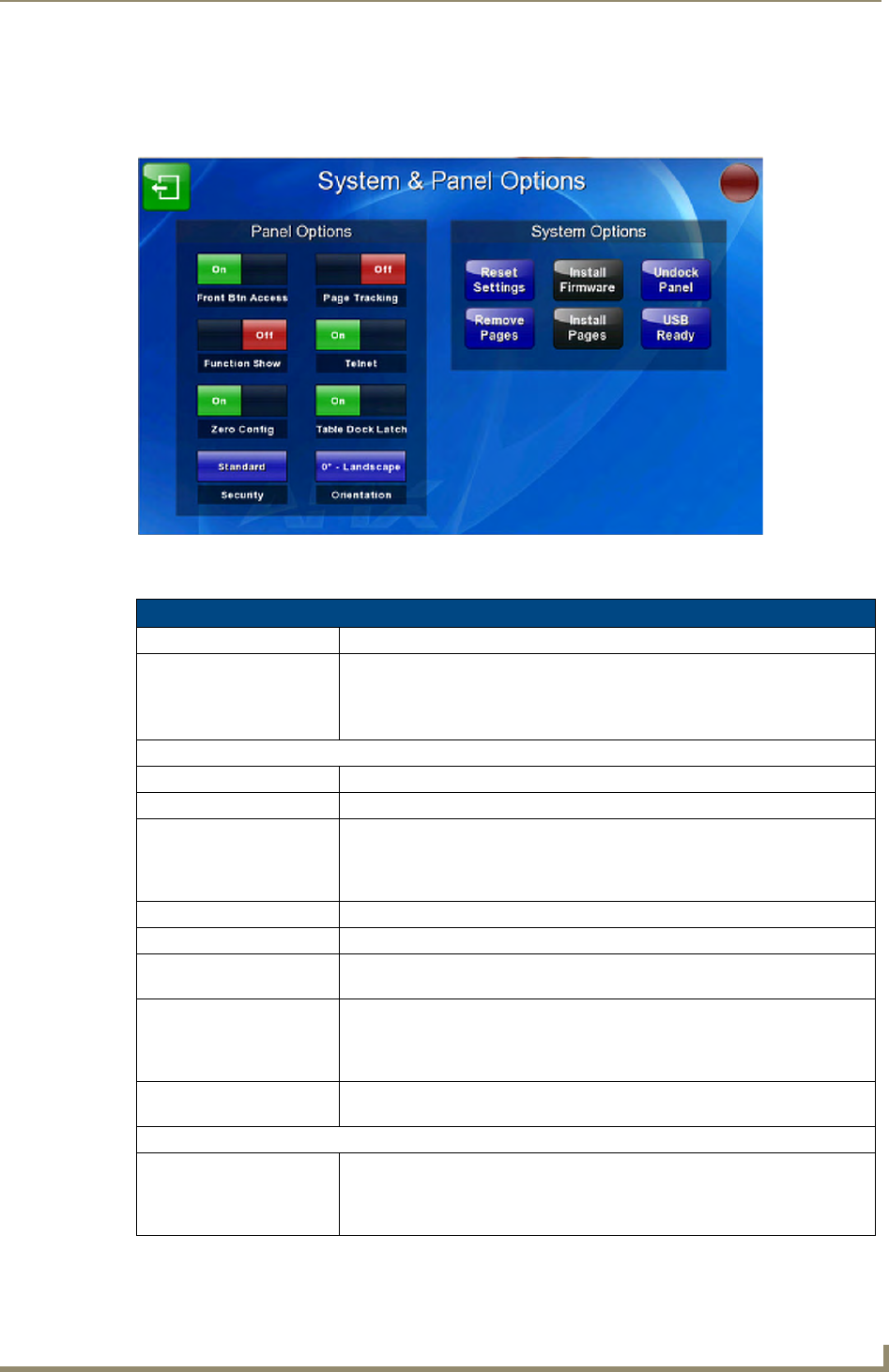
Protected Setup Pages
61
MVP-9000i Modero® Wireless Touch Panel with Intercom
System & Panel Options page
Touch the Options button at the bottom of the Protected Setup page to open the System & Panel Options page
(FIG. 59).
Features on the System & Panel Options page include:
FIG. 59 Protected Setup Navigation Buttons
System & Panel Options Page
Back: Saves all changes and returns to the previous page.
Connection Status icon: The icon in the upper-right corner of each Protected Setup page provides a
constant visual indication of current connection status.
Note: a Lock appears on the icon if the panel is connected to a secured NetLinx
Master.
Panel Options:
Front Btn Access • Controls the use of the front panel buttons.
Page Tracking: • Controls tracking of pages used by the panel in the Panel Logs page.
Function Show: • When the Function Show feature is displayed, the Channel Port and Code will
appear in yellow, the Address Port and Code in green, and the Level Port and
Channel Code in purple. (Please refer to the Function Show Example section
on page 62 for more information.)
Telnet: • Controls access via Telnet.
Zero Config: • Controls Zero Configuration access.
Table Dock Latch: • Enables and disables the docking latch on the Table Docking Station
(page 9).
Security: • Displays one of three security settings: Standard Security, Secure, and DoD.
Pressing this button opens a popup window allowing changes to the Security
Profile. NOTE: Refer to the Security Settings section on page 62 for very
important information on using this feature.
Orientation: • Selects the orientation by which the panel pages are presented: 0° -
Landscape, 90° - Portrait, and 270° - Portrait.
System Options:
Reset Settings: • Deletes all of the current configuration parameters on the panel (including IP
Addresses, Device Number assignments, Passwords, and other presets).
This option invokes a Confirmation dialog, prompting you to confirm your
selection before resetting the panel.
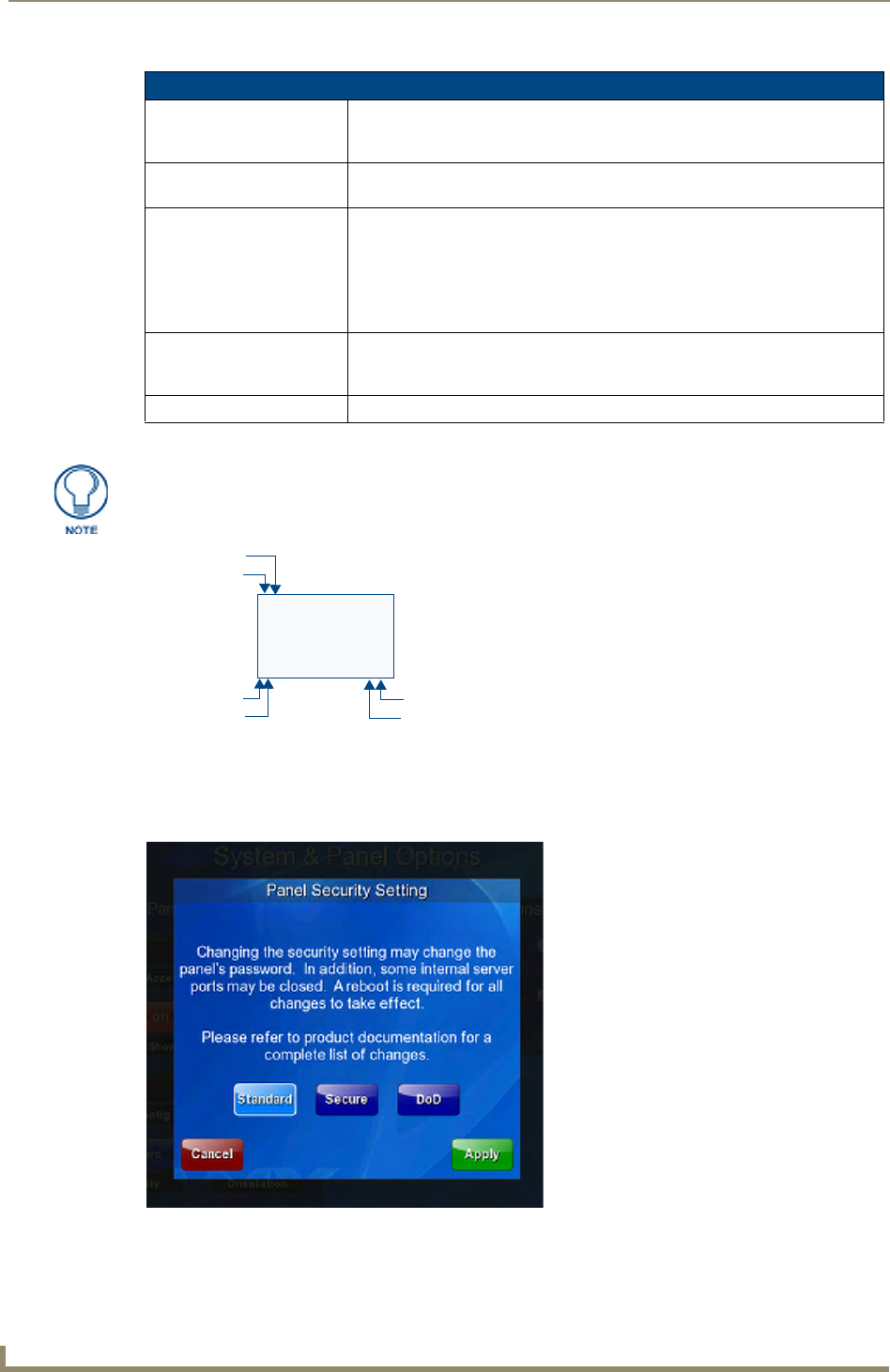
Protected Setup Pages
62 MVP-9000i Modero® Wireless Touch Panel with Intercom
Function Show Example
Security Settings
The Security button on the System & Options page has three settings: Standard, Secure, and DoD. Pressing the
button opens the Panel Security Setting popup window (FIG. 61):
Each of the settings has different features for touch panel security:
System & Panel Options Page (Cont.)
Install Firmware: • Allows uploading of firmware via TPDesign4 or via external USB hard drive. If
the panel is not connected to a computer or USB hard drive, this button will
be blacked out.
Undock Panel: • Releases the panel from the Table Docking Station (page 9) or the Wall
Docking Station (page 12).
Remove Pages: • Removes all TPD4 touch panel pages currently on the panel, including the
pre-installed AMX Demo pages. This option invokes a Confirmation dialog,
prompting you to confirm your selection before removing the panel pages.
• Note that the YES button on the Confirmation dialog is disabled for 5 seconds
as additional protection against accidentally resetting the panel or removing
the panel pages.
Install Pages: • Allows uploading of touch panel pages via TPD4 or via external USB hard
drive. If the panel is not connected to a computer or USB hard drive, this
button will be blacked out.
USB Ready: • Notes that the panel is ready to accept files via a USB device.
When the Function Show feature is displayed, the Channel Port and Code will appear
in yellow, the Address Port and Code in green, and the Level Port and Channel Code
in purple.
FIG. 60 Function Show example
FIG. 61 Panel Security Setting popup window
Channel Code
0.20
0,8 0,50
Channel Port
Address Port
Address Code
BUTTON
Level Port
Channel Code
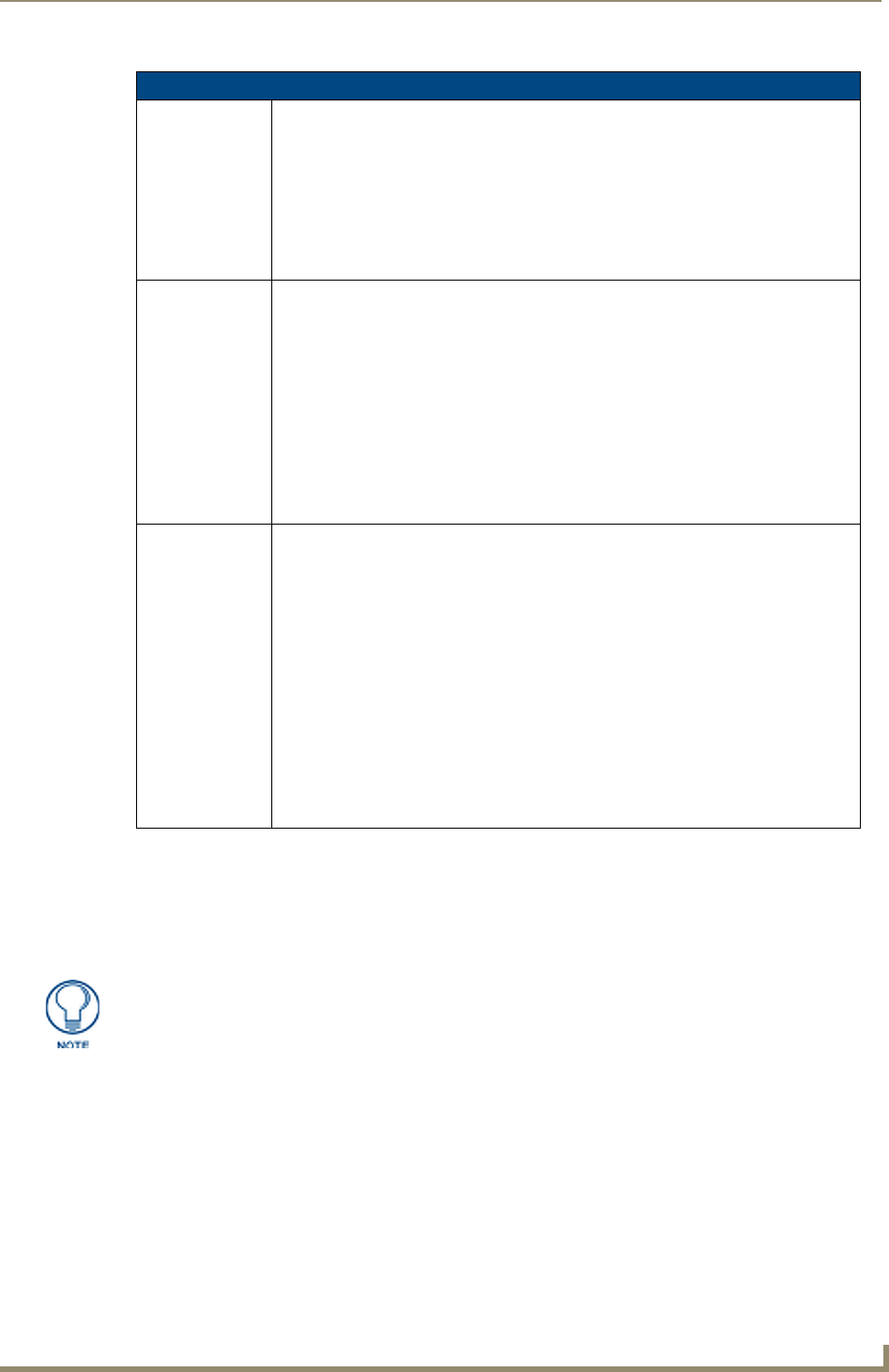
Protected Setup Pages
63
MVP-9000i Modero® Wireless Touch Panel with Intercom
Selecting between these three immediately and automatically resets the existing password to the default
password for that setting. With an unsecured panel using the Standard setting, the default password is 1988.
With panels using either the Secure or the DoD settings, the default password is Amx1234! (paying attention
to the case of the letters). Entering the existing password will not work, and the default will need to be entered
at this point to allow access to the Protected Setup page and allow resetting of the password to a new one.
For more information on configuring AMX devices for a secure environment, please refer to the guide Security
Profiles: Configuring AMX Devices For Installation Into a Secure Environment, available at www.amx.com.
Security Profile Features
Standard: • Factory default, shipped in this configuration.
• Administrator and NetLinx user accounts have a default password of “password”.
• Telnet, HTTP, HTTPS, and SSH are all enabled and require no authentication.
• Program terminal requires no authentication.
• ICSP communication protocol between devices: encryption and authentication are
disabled.
• FTP is enabled.
• Minimum password requirement is 4 characters.
Secure: • Must be configured from the program terminal.
• HTTP, Telnet, and FTP are disabled.
• SSH, HTTPS, and program terminal require authentication by an authorized user.
• SSH, HTTPS, and program terminal session timeouts are enabled.
• ICSP communication protocol between devices: encryption and authentication are
enabled.
• Minimum password requirement is 8 characters with at least 1 numeric character.
• Login failure attempt pauses 4 seconds before another login attempt is allowed.
• After 3 consecutive unsuccessful login attempts, login lockout is enabled for 15
minutes.
• Login and logout audit logging is enabled.
DoD: • Must be configured from the program terminal.
• HTTP, Telnet, and FTP are disabled.
• SSH, HTTPS, and program terminal require authentication by an authorized user.
• SSH, HTTPS, and program terminal session timeouts are enabled.
• ICSP communication protocol between devices: encryption and authentication are
enabled.
• Minimum password requirement is 8 characters with at least 1 numeric character, one
uppercase character, one lowercase character, and one special character, with no
duplicate adjacent characters.
• Login failure attempt pauses 4 seconds before another login attempt is allowed.
• After 3 consecutive unsuccessful login attempts, login lockout is enabled for 15
minutes.
• Login and logout audit logging is enabled.
• DoD session banner is enabled.
If the Security button setting is changed in any way, even if it is toggled back to its
original setting, the password is automatically reset to the default for the chosen
setting. You MUST use the new default of 1988 (Standard) or Amx1234! (Secure or
DoD) to re-enter the Protected Setup page.
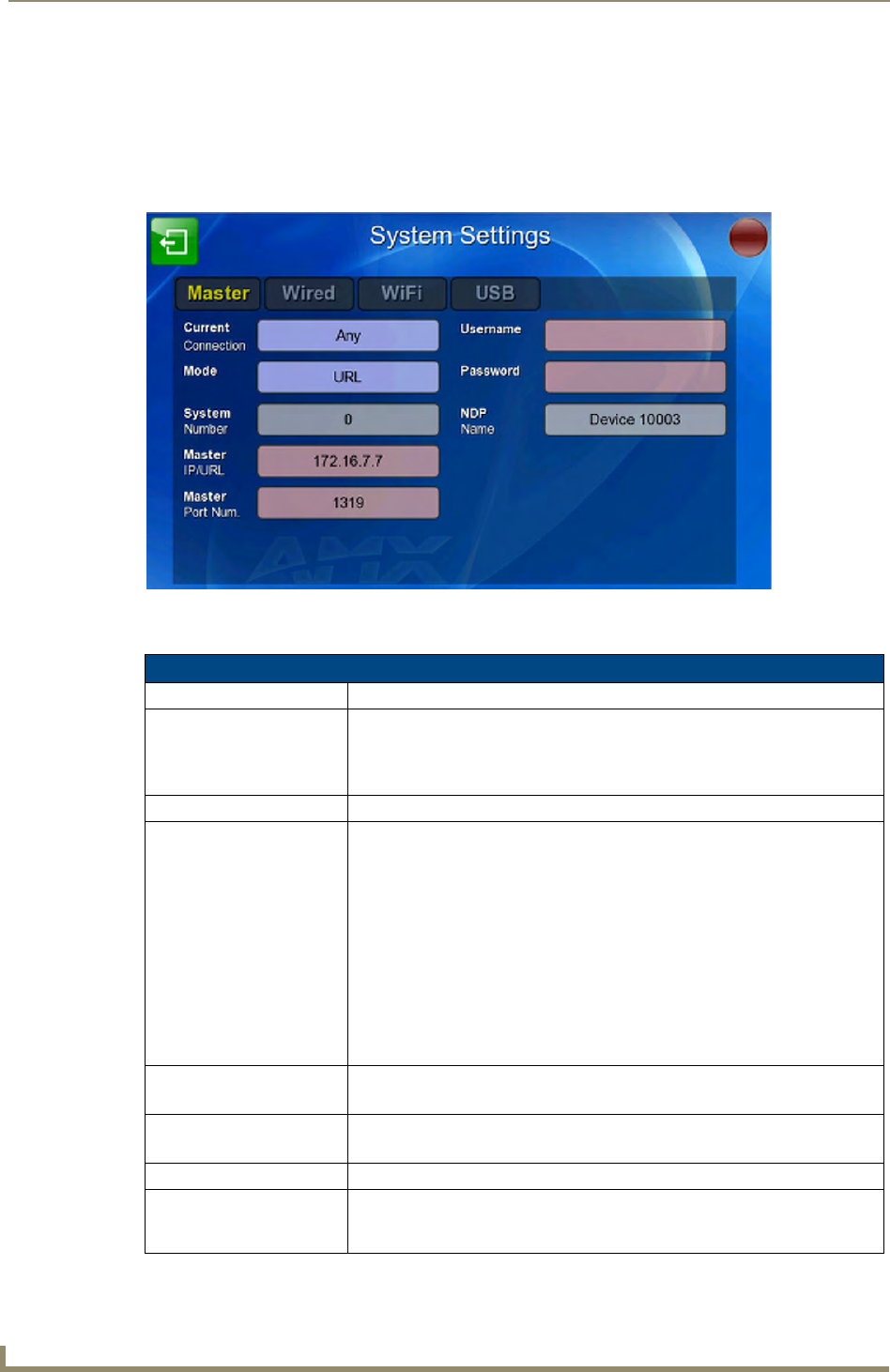
Protected Setup Pages
64 MVP-9000i Modero® Wireless Touch Panel with Intercom
System Settings Page
The System Settings page (FIG. 62) displays the NetLinx Master’s communication settings. This page contains
four tabs: Master, Wired, WiFi, and USB. Each of these tabs is covered in a separate section.
System Settings - Master
The Master tab controls the method of connection to a NetLinx Master.
The elements of this page include:
FIG. 62 System Settings - Master Tab
System Settings - Master Tab
Back: Saves all changes and returns to the previous page.
Connection Status icon: The icon in the upper-right corner of each Protected Setup page provides a
constant visual indication of current connection status.
Note: a Lock appears on the icon if the panel is connected to a secured NetLinx
Master.
Current Connection: Displays the current connection status.
Mode: Cycles between the connection modes: URL, Listen, and Auto.
•URL - In this mode, enter the IP/URL, Master Port Number, and username/
password (if used) on the Master. The System Number field is read-only - the
panel obtains this information from the Master.
•Listen - In this mode, add the panel address into the URL List in NetLinx
Studio and set the connection mode to Listen. This mode allows the Modero
touch panel to “listen” for the Master’s communication signals. The System
Number and Master IP/URL fields are read-only.
•Auto - In this mode, enter the System Number and a username/password (if
applicable). Use this mode when both the panel and the NetLinx Master are
on the same Subnet and the Master has its UDP feature enabled. The Master
IP/URL field is read-only.
System Number: Allows entry of a system number. Default value is 0 (zero).
(Available in Auto Mode Only - disabled when USB or Auto is selected)
Master IP/URL Sets the Master IP or URL of the NetLinx Master.
(Available in URL Only - disabled when Listen or Auto is selected)
Master Port Num.: Allows entry of the port number used with the NetLinx Master. Default = 1319.
Username: If the target Master has been previously secured, enter the alpha-numeric string
(into each field) assigned to a pre-configured user profile on the Master. This
profile should have the pre-defined level of access/configuration rights.
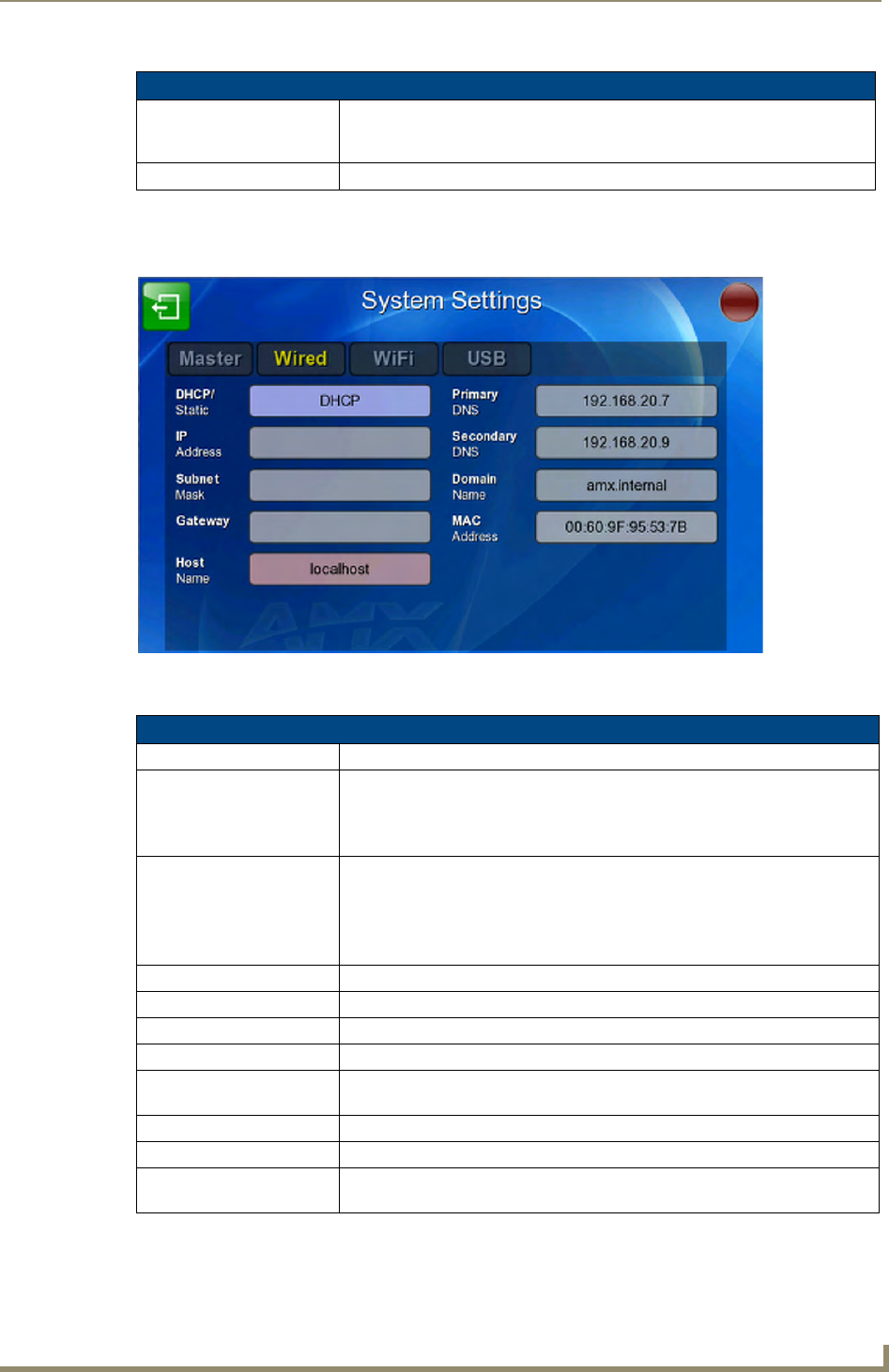
Protected Setup Pages
65
MVP-9000i Modero® Wireless Touch Panel with Intercom
System Settings - Wired
Use the options on the Wired Tab (FIG. 63) to configure communication settings for Ethernet communication
with the MVP-9000i.
Features on this page include:
System Settings - Master Tab (Cont.)
Password: If the target Master has been previously secured, enter the alpha-numeric string
(into each field) assigned to a pre-configured user profile on the Master. This
profile should have the pre-defined level of access/configuration rights.
NDP Name: Displays the name of the device connecting to the Master.
FIG. 63 System Settings - Wired Tab
System Settings - Wired Tab
Back: Saves all changes and returns to the previous page.
Connection Status icon: The icon in the upper-right corner of each Protected Setup page provides a con-
stant visual indication of current connection status.
Note: a Lock appears on the icon if the panel is connected to a secured NetLinx
Master.
DHCP/STATIC Sets the panel to either DHCP or Static communication modes.
•DHCP - a temporary IP Addresses is assigned to the panel by a DHCP server.
If DHCP is selected, the other IP Settings fields are disabled (see below).
•Static IP is a permanent IP Address assigned to the panel. If Static IP is
selected, the other IP Settings fields are enabled (see below).
IP Address Enter the secondary IP address for this panel.
Subnet Mask Enter the subnetwork address for this panel.
Gateway Enter the gateway address for this panel.
Host Name Enter the host name for this panel.
Primary DNS Enter the address of the primary DNS server used by this panel for host name
lookups.
Secondary DNS Enter the secondary DNS address for this panel.
Domain Enter a unique name to the panel for DNS look-up.
MAC Address This unique address identifies the wireless Ethernet card in the panel (read-
only).
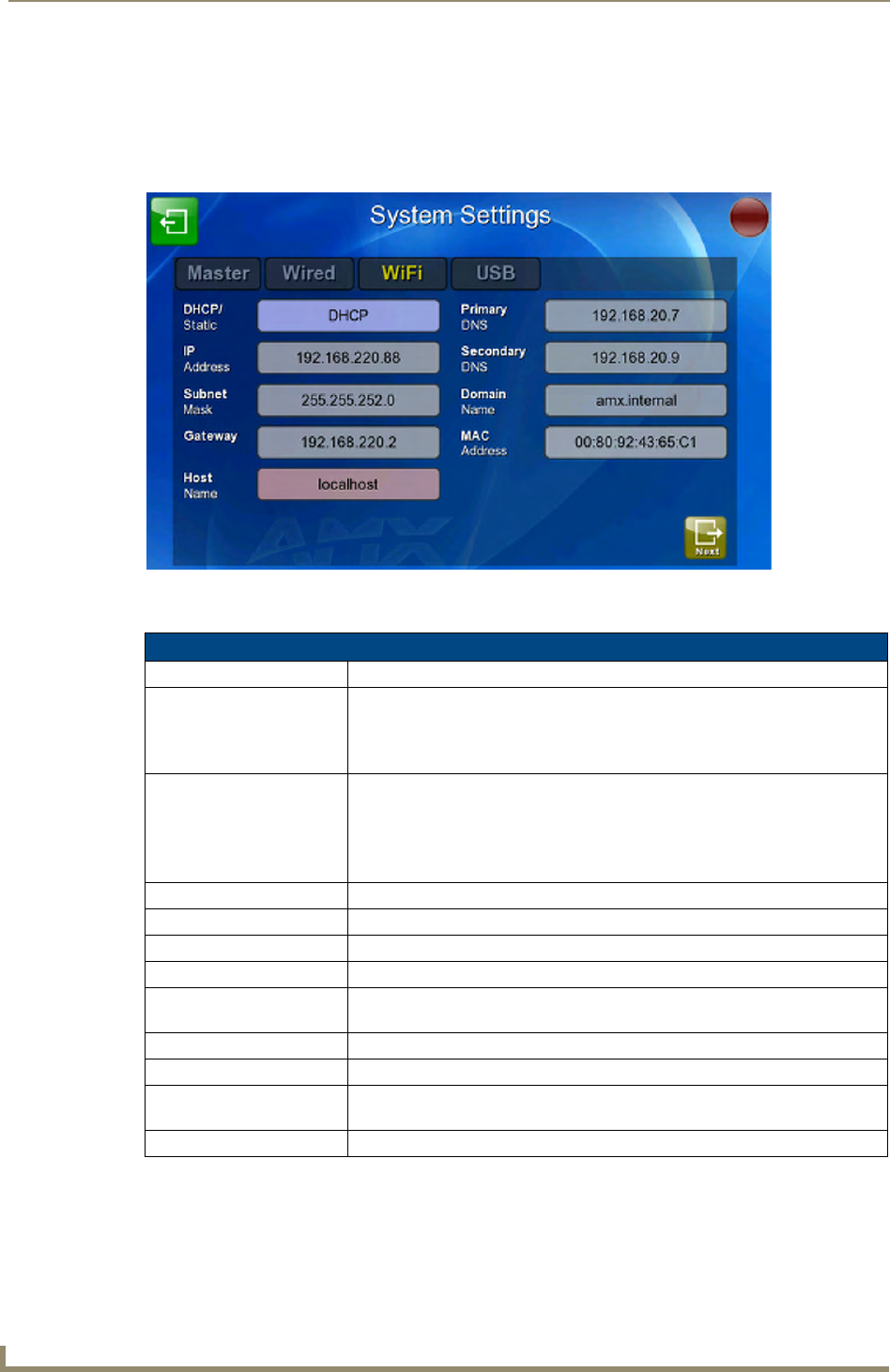
Protected Setup Pages
66 MVP-9000i Modero® Wireless Touch Panel with Intercom
System Settings - WiFi
The options on the Systems Settings - WiFi tab (FIG. 64) include the wireless security methods supported by
the WiFi card. These security methods incorporate WPA, WPA2, and EAP technology, some of which require
the upload of unique certificate files to a target panel. Refer to the Appendix B: Wireless Technology section on
page 180 for further information.
Features on this tab include:
FIG. 64 System Settings - WiFi Tab
System Settings - WiFi Tab
Back: Saves all changes and returns to the previous page.
Connection Status icon: The icon in the upper-right corner of each Protected Setup page provides a con-
stant visual indication of current connection status.
Note: a Lock appears on the icon if the panel is connected to a secured NetLinx
Master.
DHCP/STATIC Sets the panel to either DHCP or Static communication modes.
•DHCP - a temporary IP Addresses is assigned to the panel by a DHCP server.
If DHCP is selected, the other IP Settings fields are disabled (see below).
•Static IP is a permanent IP Address assigned to the panel. If Static IP is
selected, the other IP Settings fields are enabled (see below).
IP Address Enter the secondary IP address for this panel.
Subnet Mask Enter the subnetwork address for this panel.
Gateway Enter the gateway address for this panel.
Host Name Enter the host name for this panel.
Primary DNS Enter the address of the primary DNS server used by this panel for host name
lookups.
Secondary DNS Enter the secondary DNS address for this panel.
Domain Enter a unique name to the panel for DNS look-up.
MAC Address This unique address identifies the wireless Ethernet card in the panel (read-
only).
Next: Touch this button to move to the second page of the WiFi tab (page 67)
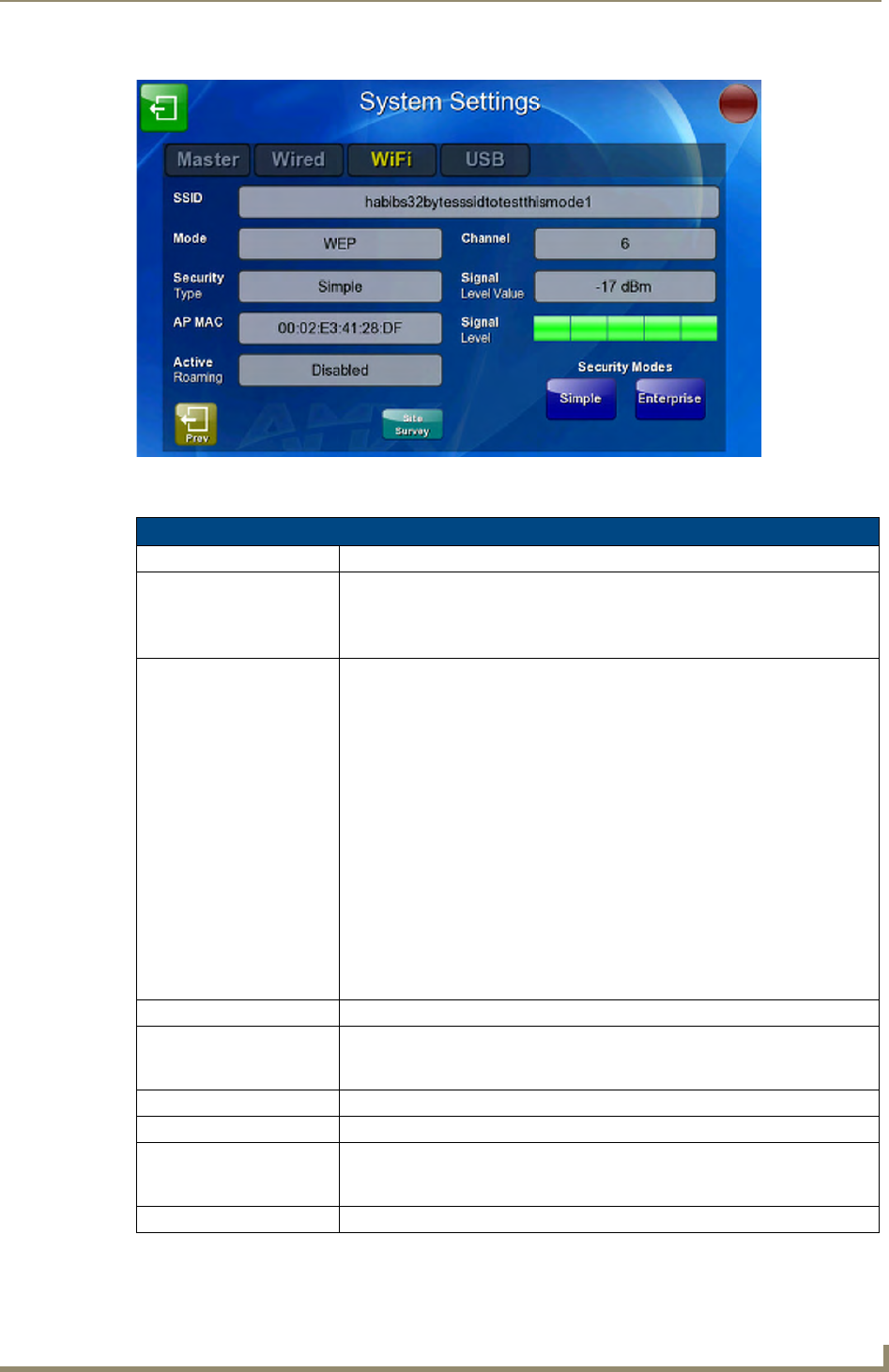
Protected Setup Pages
67
MVP-9000i Modero® Wireless Touch Panel with Intercom
Features on the second page of this tab include:
FIG. 65 System Settings - WiFi Tab (page 2)
System Settings - WiFi Tab - Page 2
Back: Saves all changes and returns to the previous page.
Connection Status icon: The icon in the upper-right corner of each Protected Setup page provides a con-
stant visual indication of current connection status.
Note: a Lock appears on the icon if the panel is connected to a secured NetLinx
Master.
Access Point MAC Address: This unique address identifies the Wireless Access Point (WAP) used by this
panel for wireless communication (read-only).
•Site Survey button: Launches the Wireless Site Survey page. The options on
this page allow you to detect (“sniff-out”) all WAPs transmitting within range of
the panel’s WiFi card.
Data displayed on the Site Survey page is categorized by:
- Network Name (SSID) - WAP names
- Channel (RF) - channels currently being used by the WAP
- Security Type - security protocol enabled on the WAP, if detectable
- Signal Strength - None, Poor, Fair, Good, Very Good, and Excellent
- MAC Address - Unique identification of the transmitting Access Point
• Refer to the Using the Site Survey Tool section on page 26 for more detailed
information on the SIte Survey page.
• When communicating with a NXA- WAP200G, enter the MAC Address
(BSSID) of the target WAP as the Access Point MAC Address. Refer to the
WAP200G Instruction Manual for more information.
SSID: Displays the currently used SSID of the target WAP.
Mode: Displays the currently selected security type within the Simple or Enterprise
security modes. This may be changed within the Simple or Enterprise Security
mode popup windows (XXXX).
Security Type: Displays the currently selected Security Mode:
AP MAC:
Active Roaming: In security modes that allow it, the Active Roaming setting may be changed
from Disabled to Enabled on 1,6,11. When enabled, this allows roaming
between channels 1, 6, and 11 depending upon availability of a given channel.
Channel: The RF channel being used for connection to the WAP (read -only).
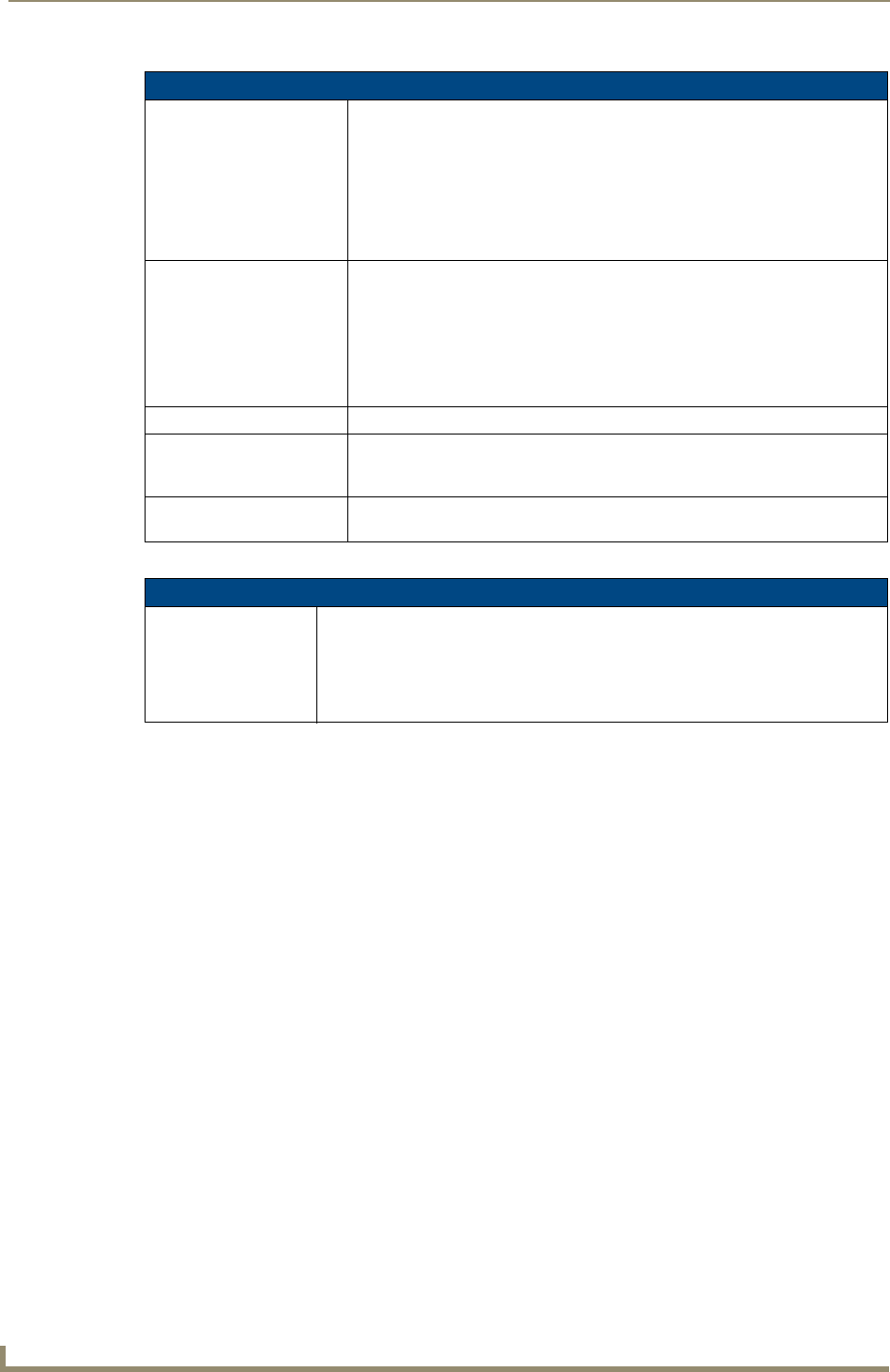
Protected Setup Pages
68 MVP-9000i Modero® Wireless Touch Panel with Intercom
Some encryption and security features may or may not be supported:
Refer to the Configuring Wireless Network Access section on page 24 for more information on configuring the
panel for wireless network access using the various security options.
System Settings - WiFi Tab - Page 2 (Cont.)
Signal Level Value: This indicator displays a description of the signal strength from the Wireless
Access Point connection in real time.
SNR (Signal Noise Ratio) is a measure of the relative strength of a wireless RF
connection. Given this value and the link quality above, you can determine the
noise level component of the SNR. For example, if signal strength is high but
the link quality is low, then the cause of the link degradation is noise. However, if
signal strength is low and link quality is low, the cause would simply be signal
strength.
Signal Level: Displays the quality of the link from the wireless NIC to the Wireless Access
Point (direct sequence spread spectrum) in real time.
• Even when link quality is at its lowest you still have a connection, and the
ability to transmit and receive data, even if at lower speeds.
Note: “Link Quality” and “Signal Strength” are applicable to RF connections
only. It is possible to have an RF signal to a WAP, but be unable to communicate
with it because of either incorrect IP or encryption settings.
Prev. Touch this button to return to the first page of the WiFi tab.
Site Survey: Touching this button launches the Wireless Site Survey page. The options on
this page allow you to detect (“sniff-out”) all WAPs transmitting within range of
the panel’s WiFi card.
Security Modes: Security for WiFi connections is available in Simple Mode or Enterprise Mode.
Touch the appropriate button to open the pop-up window for each mode.
Wireless Security Support
802.11a/b/g WiFi card: • Open (Clear Text)
• Static WEP (64-bit and 128-bit key lengths)
• WPA-PSK
• EAP security (with and without certificates)
• WAP SIte Survey
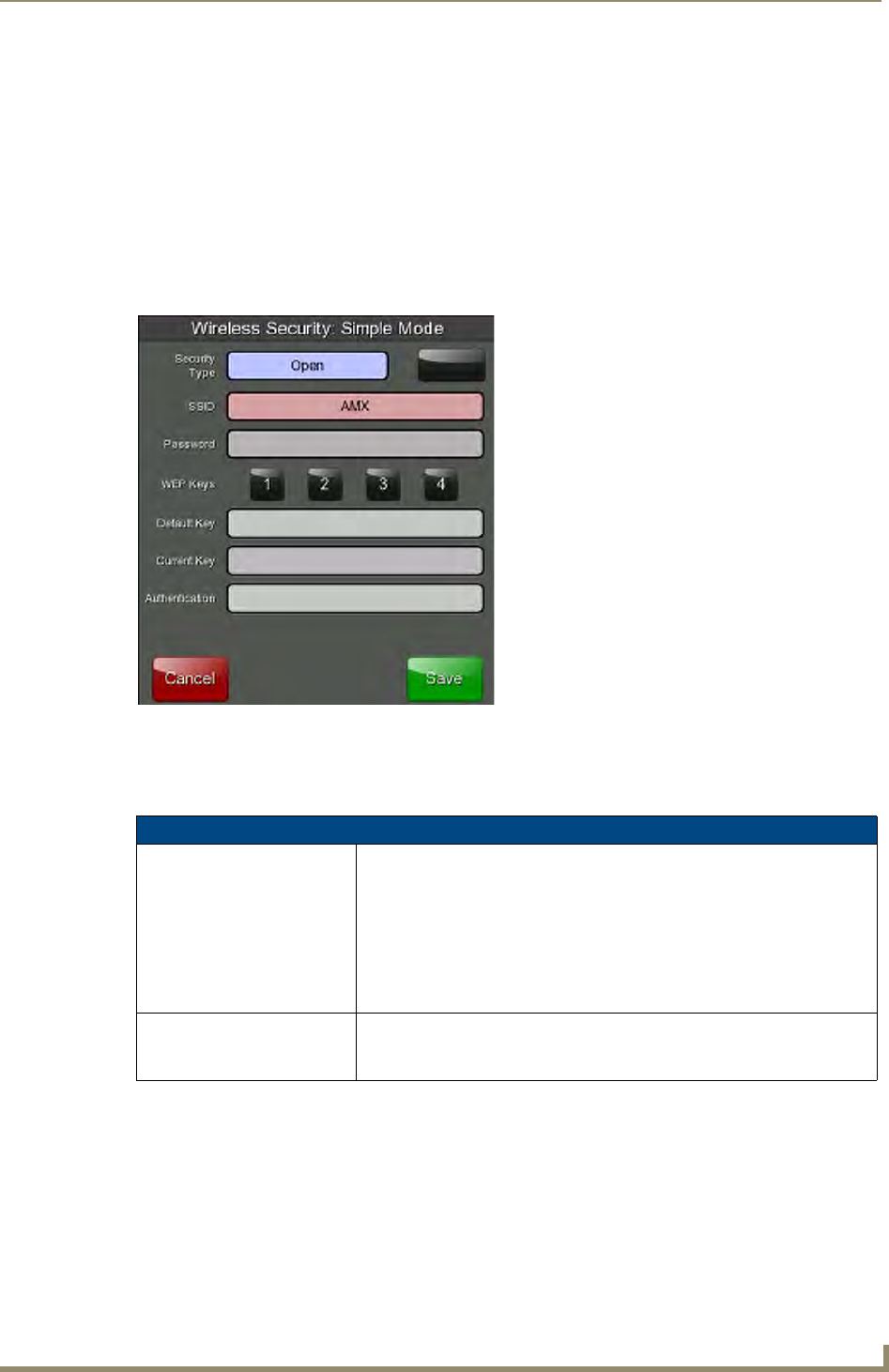
Protected Setup Pages
69
MVP-9000i Modero® Wireless Touch Panel with Intercom
Security Modes
The Security Modes section on the second page of the WiFi tab has two buttons: Simple and Enterprise.
Pressing the Simple button opens the Wireless Security: Simple Mode popup window, which offers wireless
security options suitable for most home and office environments such as Open (page 69), WEP (page 70), and
WPA-PSK (page 72). For more secure options, such as for corporate environments, the Wireless Security:
Enterprise Mode popup window offers EAP-LEAP (page 75), EAP-FAST (page 77), EAP-PEAP (page 79),
EAP-TTLS (page 81), and EAP-TLS (page 83).
Open
From the Security Modes options, press the Simple button to open the Wireless Security: Simple Mode page.
Scroll through the Security Type options to select Open (FIG. 66).
Open security does not utilize any encryption methodology, but requires an SSID (alpha-numeric) entry.
This entry must match the Network Name (SSID) entry of the target WAP so the panel knows what device it is
using to communicate with the network.
Refer to the Configuring Wireless Network Access section on page 24 and the Using the Site Survey
Tool section on page 26 for further details on these security options.
FIG. 66 Wireless Security: Simple Mode - Open
Open Settings
SSID (Service Set Identifier): Opens an on-screen keyboard to enter the SSID name used on the target
WAP. The SSID is a unique name used by the WAP, and is assigned to all
panels on that network. An SSID is required by the WAP before the panel is
permitted to join the network.
• The SSID is case sensitive and must not exceed 32 characters.
• Make sure this setting is the same for all points in your wireless network.
• If this field is left blank, the panel will attempt to connect to the first available
WAP.
Save/Cancel: • Save - store the new security information, apply changes, and return to the
previous page.
•Cancel - discard changes and return to the previous page.
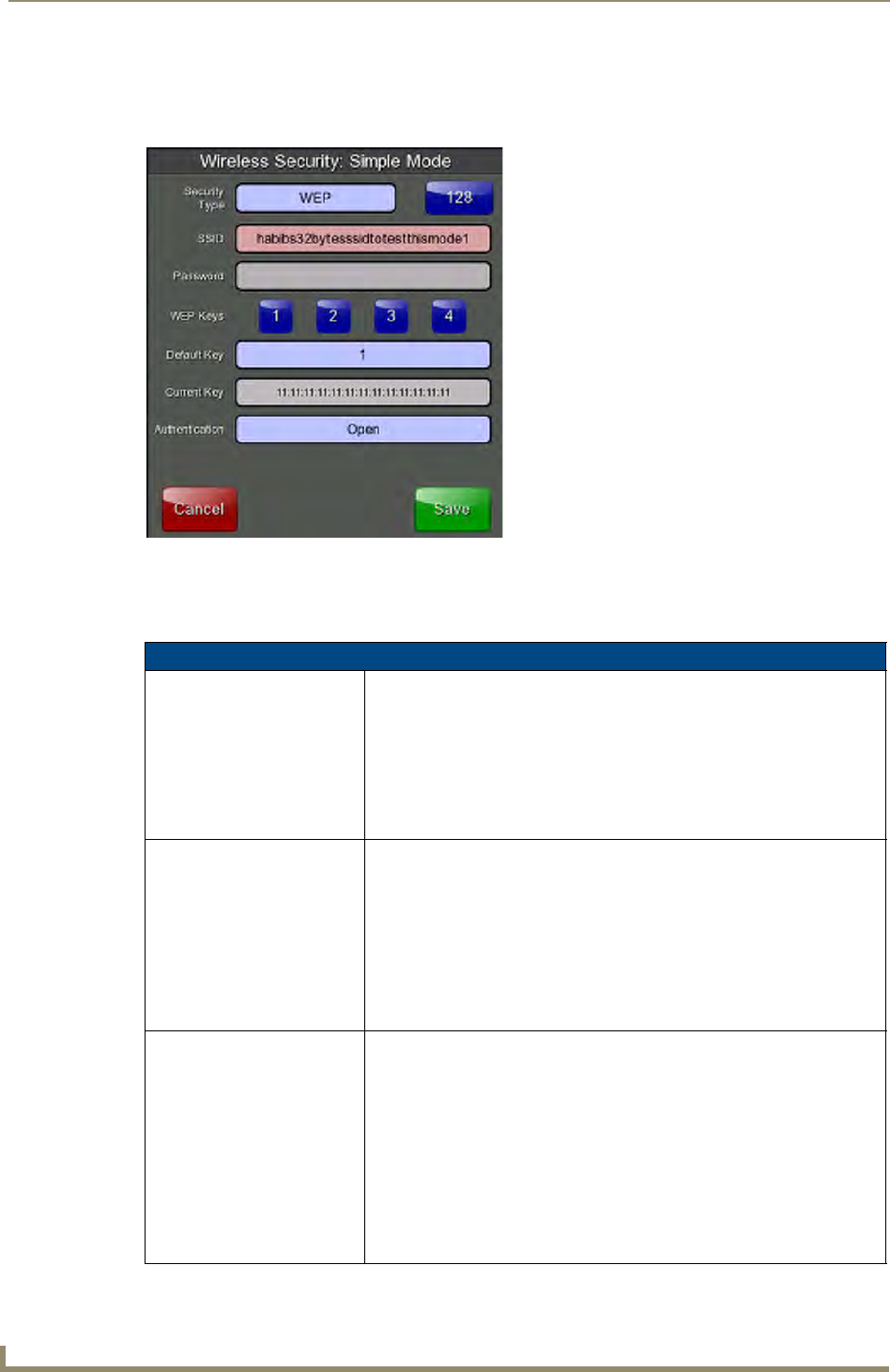
Protected Setup Pages
70 MVP-9000i Modero® Wireless Touch Panel with Intercom
WEP
From the Security Modes options, press the Simple button to open the Wireless Security: Simple Mode page.
Scroll through the Security Type options to select WEP (FIG. 67).
WEP security requires that both a target WAP be identified and an encryption method be implemented prior to
establishing communication. In addition to providing both Open and Shared Authentication capabilities, this
page also supports Hexadecimal and ASCII keys.
FIG. 67 Wireless Security: Simple Mode - WEP
WEP
SSID (Service Set Identifier): Opens an on-screen keyboard to enter the SSID name used on the target
WAP. The SSID is a unique name used by the WAP, and is assigned to all
panels on that network. An SSID is required by the WAP before the panel is
permitted to join the network.
• The SSID is case sensitive and must not exceed 32 characters.
• Make sure this setting is the same for all points in your wireless network.
• If this field is left blank, the panel will attempt to connect to the first available
WAP.
64 /128: Cycles through the available encryption options: 64 or 128 Bit Key Size.
“WEP” (Wired Equivalent Privacy) is an 802.11 security protocol designed to
provide wireless security equivalent to wired networks.
•64 enables WEP encryption using a 64 Bit Key Size. All packets are
transmitted with their contents encrypted using the Default WEP Key.
•128 enables WEP encryption using a 128 Bit Key Size. All packets are
transmitted with their contents encrypted using the Default WEP Key.
• If the key is not the correct size, the system will resize it to match the
number of bits required for the WEP encryption mode selected.
WEP Keys: This feature provides another level of security by selecting up to four WEP
Keys.
Push any of the four buttons to open an on-screen keyboard. Both ASCII and
HEX keys are supported. Up to four keys can be configured for both.
• An ASCII key utilizes either 5 or 13 ASCII characters
• A HEX key utilizes either 10 or 26 Hexidecimal characters
Press Done to accept any changes and save the new value.
Note: A 64-bit key will be 10 characters in length while a 128-bit key will be
26 characters in length. The length of the key entered determines the level of
WEP encryption employed (64 or 128-bit). 128-bit keys may be used if
supported by the internal wireless card.
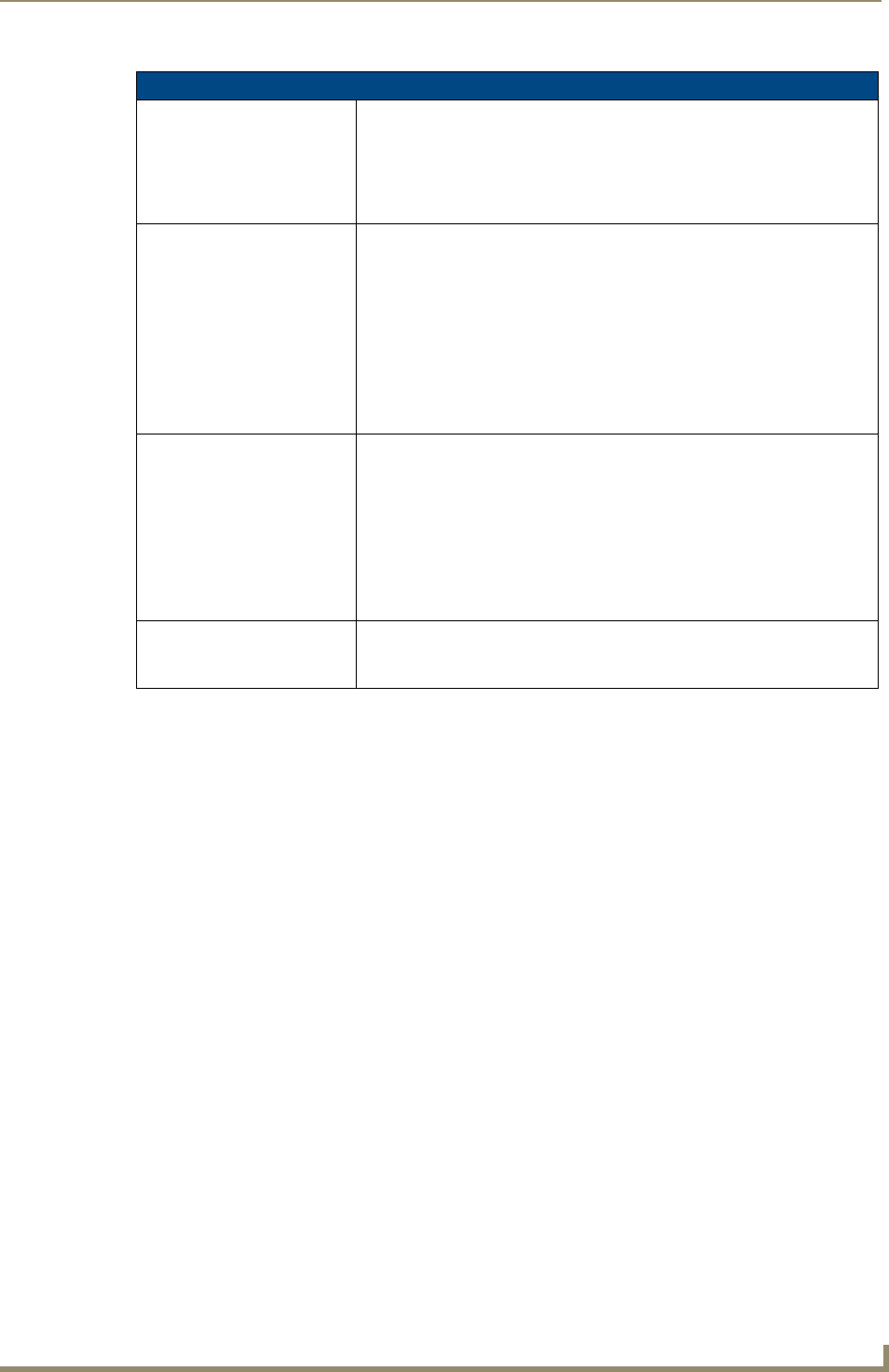
Protected Setup Pages
71
MVP-9000i Modero® Wireless Touch Panel with Intercom
Refer to the Configuring Wireless Network Access section on page 24 and the Using the Site Survey
Tool section on page 26 for further details on these security options.
WEP (Cont.)
Default Key: Cycles through the four available WEP key identifiers to select a WEP key to
use. As the Default Key value is altered (through selection) the corresponding
“Current Key” is displayed. Each Current Key corresponds to a WEP key.
This feature is useful for accessing different networks without having to
re-enter that networks’ WEP key. It is also sometimes used to set up a
rotating key schedule to provide an extra layer of security.
Current Key: Displays the current WEP key in use.
• When working with a single panel and a single WAP, manually entering the
Current Key from the WAP into the selected WEP Key is recommended.
• When working with a single WAP and multiple panels, generating a Current
Key using the same passphrase on all panels and then entering the
panel-produced WEP key manually into the Wireless Access Point is
recommended.
• Keys may also be examined by touching the key buttons and noting the
keyboard initialization text.
• Use the on-screen keyboard’s Clear button to erase stored key information.
Authentication: Toggles between the two authentication modes: Open (broadcast publicly) or
Shared (encrypted).
•An Open network allows connections from any client without authentication.
•A Shared network requires the client to submit a key which is shared by the
network WAP before it is given permission to associate with the network. In
this case the key is the same as the WEP encryption key.
In either case, if WEP encryption has been enabled, the client will still require
the WEP key to encrypt and decrypt packets in order to communicate with the
network.
Save/Cancel: • Save - store the new security information, apply changes, and return to the
previous page.
•Cancel - discard changes and return to the previous page.
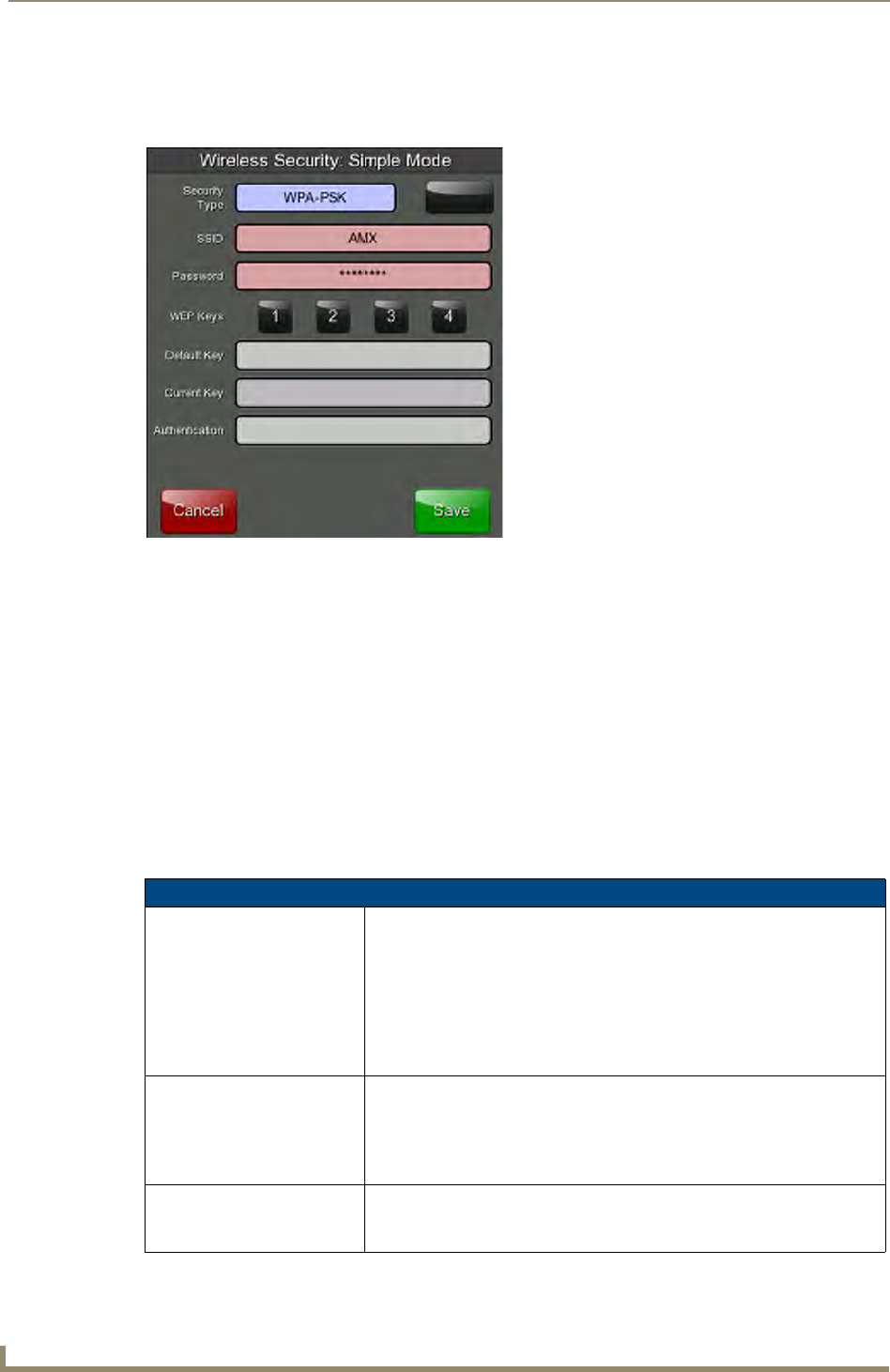
Protected Setup Pages
72 MVP-9000i Modero® Wireless Touch Panel with Intercom
WPA-PSK
From the Security Modes options, press the Simple button to open the Wireless Security: Simple Mode page.
Scroll through the Security Type options to select WPA-PSK (FIG. 68).
WPA-PSK security is designed for environments where using WPA or WPA2 is desirable, but an 802.1x
authentication server is not available. PSK connections are more secure than WEP and are simpler to
configure, since they implement dynamic keys but share a key between the WAP and the panel (client).
Using WPA-PSK, the encryption on the WAP could either be WPA or WPA2. The firmware in the panel will
automatically connect to the WAP using the correct encryption. The WPA encryption type is configured on the
WAP, not in the firmware.
WAPs do not display “WPA” or “WPA2” on their configuration screens:
WPA is normally displayed as TKIP.
WPA2 is normally displayed as AES CCMP.
The following fields are required: SSID and Password/Pass Phrase.
Enter the SSID of the WAP.
Enter a pass phrase with a minimum of 8 characters and a maximum of 63.
The exact same pass phrase (including capitalization) must be entered in the access point.
FIG. 68 Wireless Security: Simple Mode - WPA-PSK
WPA-PSK Settings
SSID (Service Set Identifier): Opens an on-screen keyboard to enter the SSID name used on the target
WAP. The SSID is a unique name used by the WAP, and is assigned to all
panels on that network. An SSID is required by the WAP before the panel is
permitted to join the network.
• The SSID is case sensitive and must not exceed 32 characters.
• Make sure this setting is the same for all points in your wireless network.
• If this field is left blank, the panel will attempt to connect to the first available
WAP.
Password: Opens an on-screen keyboard to enter a passphrase (password).
• This alpha-numeric string must use a minimum of 8 characters and a
maximum of 63.
• The exact pass phrase string (including capitalization) must be entered on
the target WAP.
Save/Cancel: • Save - store the new security information, apply changes, and return to the
previous page.
•Cancel - discard changes and return to the previous page.
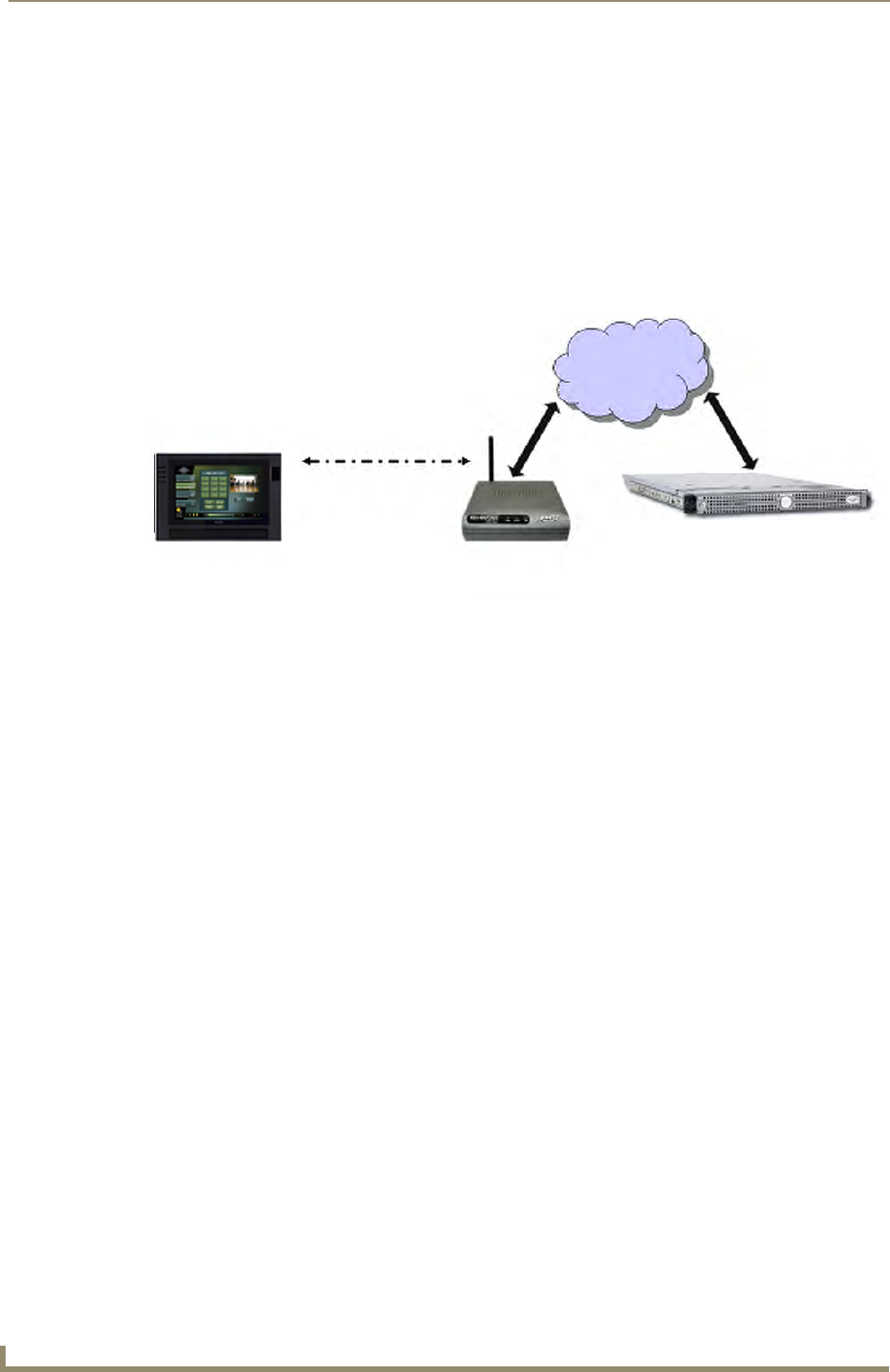
Protected Setup Pages
74 MVP-9000i Modero® Wireless Touch Panel with Intercom
EAP Security & Server Certificates - Overview
The following EAP types all support a server certificate:
EAP-PEAP
EAP-TTLS
EAP-TLS
All three of these certificate-using security methods are documented in the following sections. EAP
Authentication goes a step beyond simply encrypting data transfers, but also requires that a set of credentials
be validated before the client (panel) is allowed to connect to the rest of the network (FIG. 69). Please note that
no user intervention is necessary during this process, as it proceeds automatically based on the configuration
parameters entered into the panel.
A server certificate file uses a certificate installed in a panel so that the RADIUS server can be validated before
the panel tries to connect to it. The field name associated with this file is Certificate Authority.
If a server certificate is used, it should first be downloaded into the panel and the Certificate Authority field
should then be set to the name of that certificate file. No file path should be used for this setting, as all
certificates are stored in a specific directory that the user cannot control or change. The most secure connection
method uses a server certificate.
If no server certificate will be used, this field should be left blank. If the field contains a file name, then a valid
certificate file with the same file name must be previously installed on the panel. Otherwise the authentication
process will fail.
FIG. 69 EAP security method in process
LAN
Client - Panel
(supplicant)
802.1x
(EAP over Wireless)
Authenticator
(Wireless Access Point)
Authentication Server
(RADIUS Server)
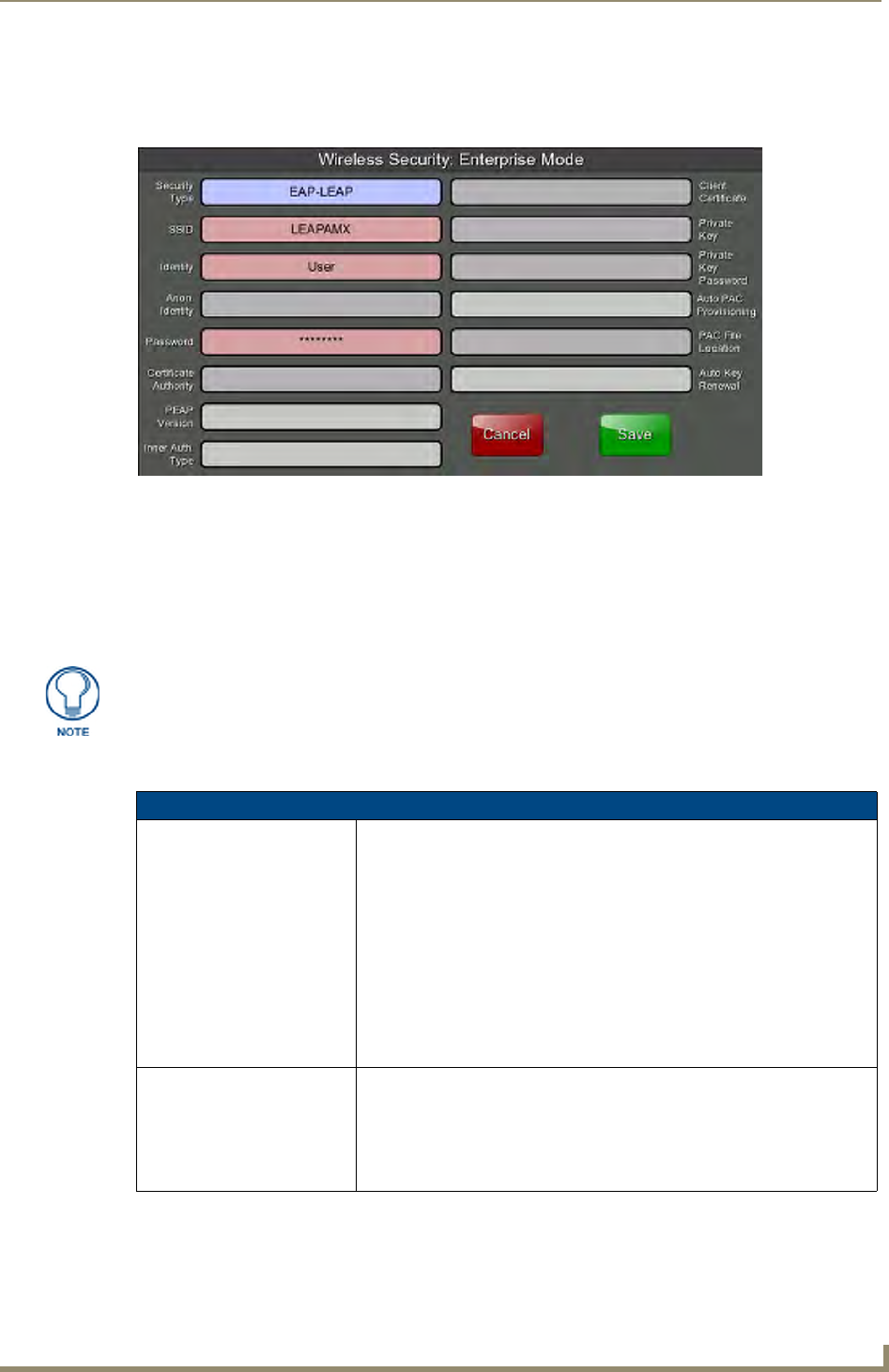
Protected Setup Pages
75
MVP-9000i Modero® Wireless Touch Panel with Intercom
EAP-LEAP
From the Security Modes options, press the Enterprise button to open the Wireless Security: Enterprise Mode
page. Scroll through the Security Type options to select EAP-LEAP (FIG. 70).
EAP (Extensible Authentication Protocol) is an Enterprise authentication protocol that can be used in both
wired and wireless network environments. EAP requires the use of an 802.1x Authentication Server, also
known as a Radius server. The configuration fields described below take variable length strings as inputs. An
on-screen keyboard is opened when these fields are selected.
LEAP (Lightweight Extensible Authentication Protocol) was developed to transmit authentication information
securely in a wireless network environment.
EAP-LEAP security is designed for wireless environments where having a client or server certificate
validation scheme in place is not required, yet necessary to transmit data securely over a wireless network.
FIG. 70 Wireless Security: Enterprise Mode - EAP-LEAP
LEAP does not use client (panel) or server (RADIUS) certificates, and is therefore
one of the least secure EAP security methods. However, it can be utilized
successfully by implementing sufficiently complex passwords.
EAP-LEAP
SSID (Service Set Identifier): Opens an on-screen keyboard to enter the SSID name used on the target
WAP.
The SSID is a unique name used by the WAP, and is assigned to all panels
on that network. An SSID is required by the WAP before the panel is
permitted to join the network.
• The SSID is case sensitive and must not exceed 32 characters.
• Make sure this setting is the same for all points in the wireless network.
• With EAP security, the SSID of the WAP must be entered. If it is left blank,
the panel will try to connect to the first access point detected that supports
EAP. However, a successful connection is not guaranteed because the
detected WAP may be connected to a RADIUS server, which may not
support this EAP type and/or have the proper user identities configured.
Identity: Opens an on-screen keyboard. Enter an EAP Identity string (used by the
panel to identify itself to an Authentication (RADIUS) Server).
Note: This information is similar to a username used to login to a secured
server or workstation. This works in tandem with the Password string which is
similar to the password entered to gain access to a secured workstation.
Typically, this is in the form of a username such as jdoe@amx.com.
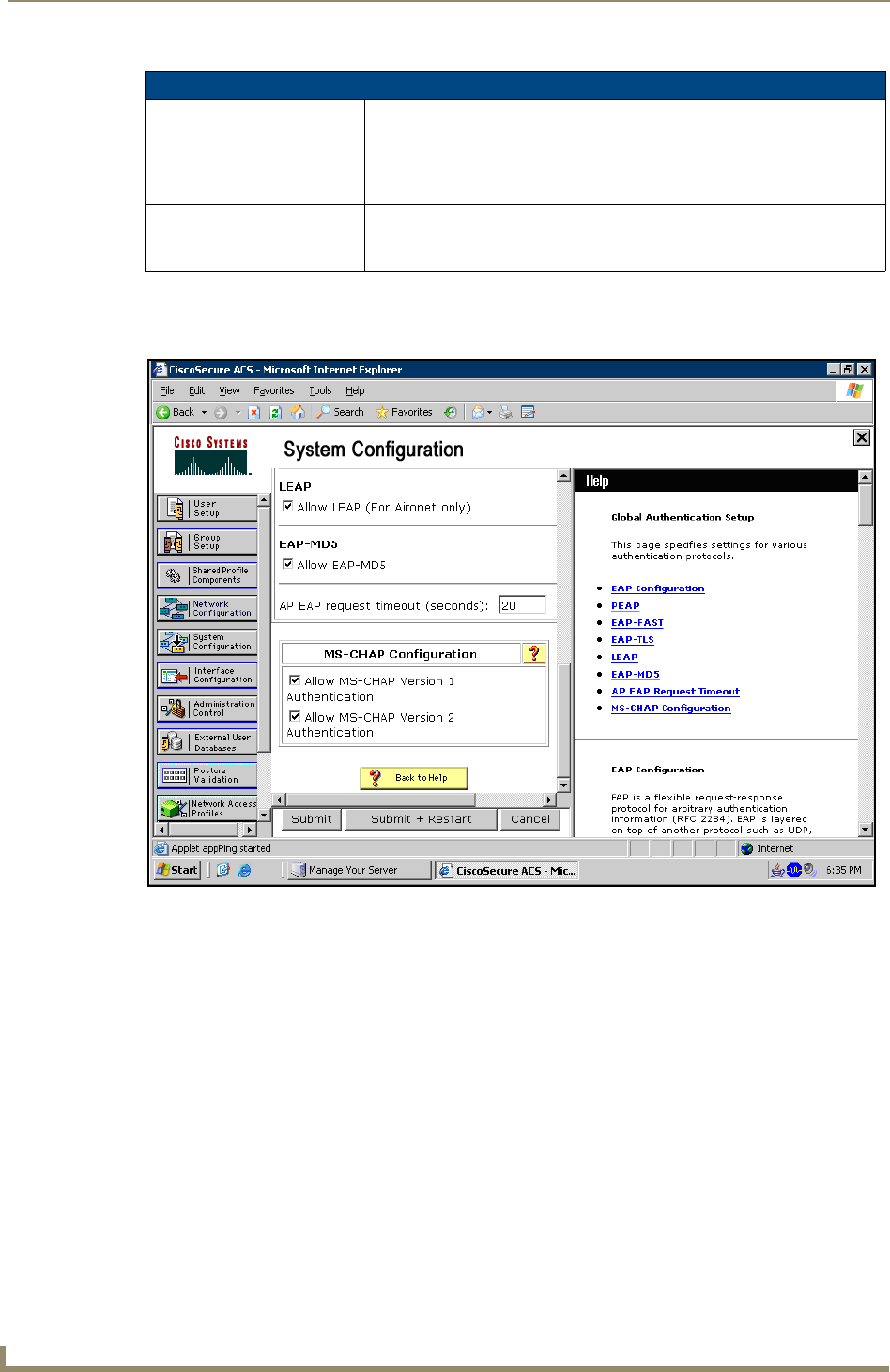
Protected Setup Pages
76 MVP-9000i Modero® Wireless Touch Panel with Intercom
Refer to the EAP Authentication section on page 182 for further details on these security options.
Refer to FIG. 71 for an example of how a typical EAP-LEAP system configuration page should
appear.
EAP-LEAP (Cont.)
Password: Opens an on-screen keyboard. Enter the network password string specified
for the user entered within the Identity field (used by the panel to identify itself
to an Authentication (RADIUS) Server)
Note: This information is similar to the password entered to gain access to a
secured workstation.
Save/Cancel: • Save - store the new security information, apply changes, and return to the
previous page.
•Cancel - discard changes and return to the previous page.
FIG. 71 EAP-LEAP sample Cisco System Security page
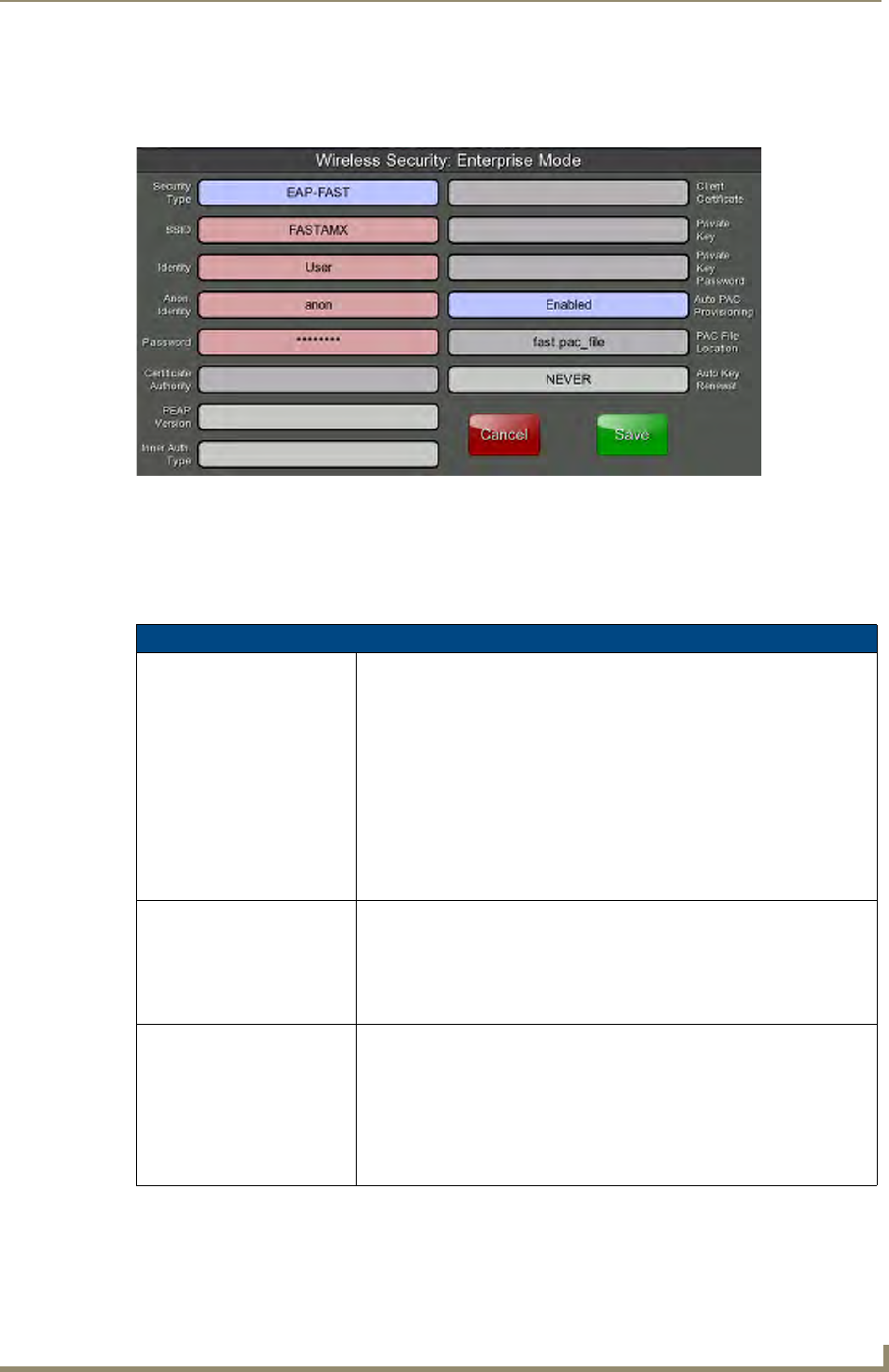
Protected Setup Pages
77
MVP-9000i Modero® Wireless Touch Panel with Intercom
EAP-FAST
From the Security Modes options, press the Enterprise button to open the Wireless Security: Enterprise Mode
page. Scroll through the Security Type options to select EAP-FAST (FIG. 72).
EAP-FAST (Flexible Authentication via Secure Tunneling) security was designed for wireless environments
where security and ease of setup are equally desirable. EAP-FAST uses a certificate file, however it can be
configured to download the certificate automatically the first time the panel attempts to authenticate itself.
Automatic certificate downloading is convenient but slightly less secure, since its the certificate is transferred
wirelessly and could theoretically be “sniffed-out”.
FIG. 72 Wireless Security: Enterprise Mode - EAP-FAST
EAP-FAST
SSID (Service Set Identifier): Opens an on-screen keyboard to enter the SSID name used on the target
WAP.
The SSID is a unique name used by the WAP, and is assigned to all panels
on that network. An SSID is required by the WAP before the panel is
permitted to join the network.
• The SSID is case sensitive and must not exceed 32 characters.
• Make sure this setting is the same for all points in the wireless network.
• With EAP security, the SSID of the WAP must be entered. If it is left blank,
the panel will try to connect to the first access point detected that supports
EAP. However, a successful connection is not guaranteed because the
detected WAP may be connected to a RADIUS server, which may not
support this EAP type and/or have the proper user identities configured.
Identity: Opens an on-screen keyboard to enter an EAP Identity string (used by the
panel to identify itself to an Authentication (RADIUS) Server).
Note: This information is similar to a username used to login to a secured
server or workstation. This works in tandem with the Password string which is
similar to the password entered to gain access to a secured workstation.
Typically, this is in the form of a username such as: jdoe@amx.com.
Anonymous Identity: Opens an on-screen keyboard to enter an IT provided alphanumeric string
which (similar to the username) is used as the identity, but that does not
represent a real user.
This information is used as a fictitious name which might be seen by sniffer
programs during the initial connection and setup process between the panel
and the Radius server. In this way the real identity (username) is protected.
Typically, this is in the form of a fictitious username, such as
anonymous@amx.com
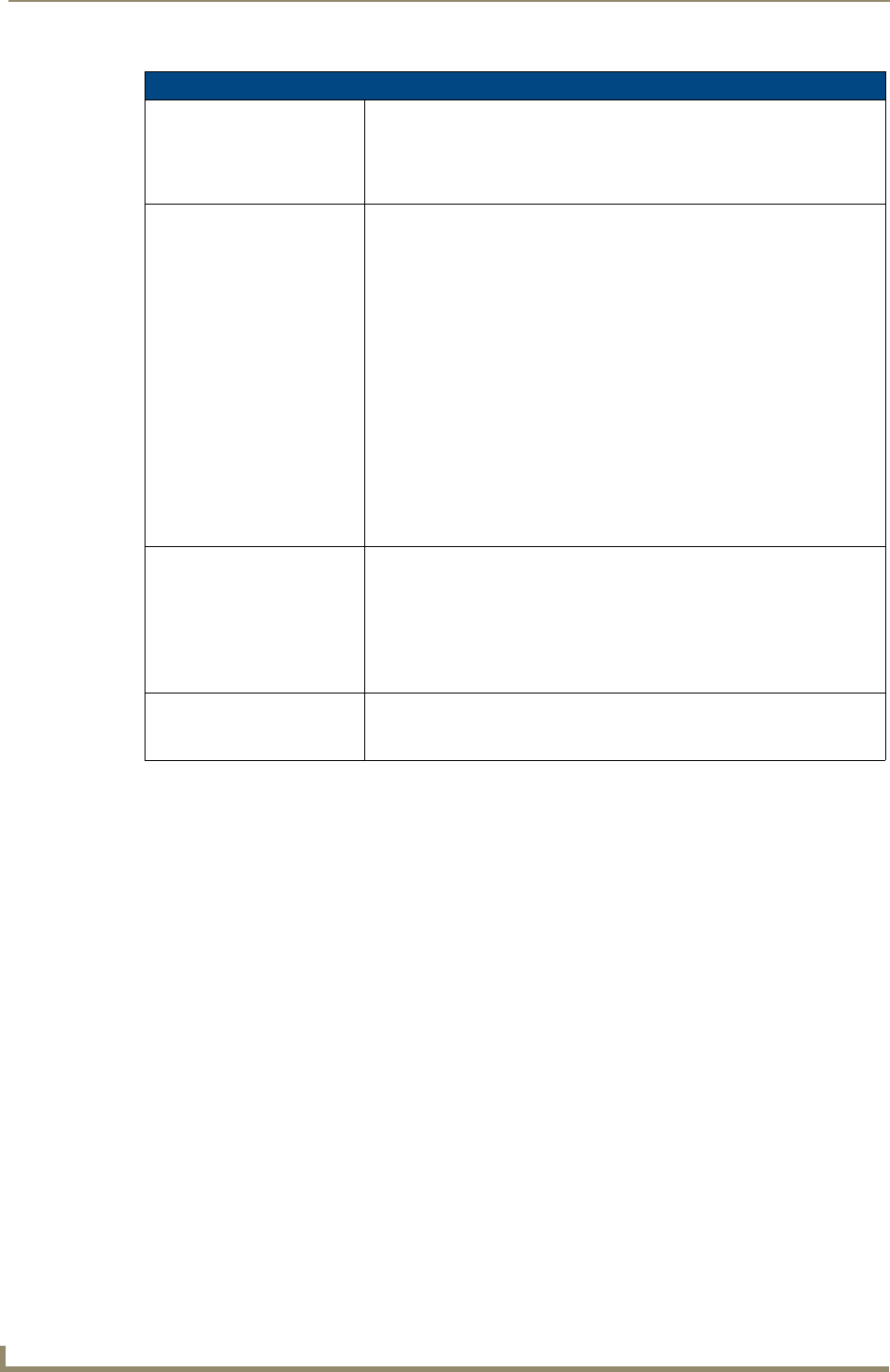
Protected Setup Pages
78 MVP-9000i Modero® Wireless Touch Panel with Intercom
Refer to the EAP Authentication section on page 182 and the Using the Site Survey Tool section on page 26 for
further details on these security options.
EAP-FAST (Cont.)
Password: Opens an on-screen keyboard. Enter the network password string specified
for the user entered within the Identity field (used by the panel to identify itself
to an Authentication (RADIUS) Server)
Note: This information is similar to the password entered to gain access to a
secured workstation.
Automatic PAC
Provisioning:
This selection toggles PAC (Protected Access Credential) Provisioning -
Enabled (automatic) or Disabled (manual).
• If Enabled is selected, the following PAC File Location field is disabled,
because the search for the PAC file is done automatically.
• If Disabled is selected, the user is required to manually locate a file
containing the PAC shared secret credentials for use in authentication. In
this case, the IT department must create a PAC file and then transfer it into
the panel using the AMX Certificate Upload application.
Note: Even when automatic provisioning is enabled, the PAC certificate is
only downloaded the first time that the panel connects to the RADIUS server.
This file is then saved into the panel's file system and is then reused from
then on. It is possible for the user to change a setting, such as a new Identity,
that would invalidate this certificate. In that case, the panel must be forced to
download a new PAC file.
To do this, set Automatic PAC Provisioning to Disabled and then back to
Enabled. This forces the firmware to delete the old file and request a new
one.
PAC File Location: This field is used when the previous Automatic PAC Provisioning option has
been Disabled.
• When pressed, the panel displays an on-screen PAC File Location
keyboard which allows you to enter the name of the file containing the PAC
shared secret credentials for use in authentication.
• This field is only valid when the automatic PAC provisioning feature has
been enabled via the previous field.
Save/Cancel: • Save - store the new security information, apply changes, and return to the
previous page.
•Cancel - discard changes and return to the previous page.
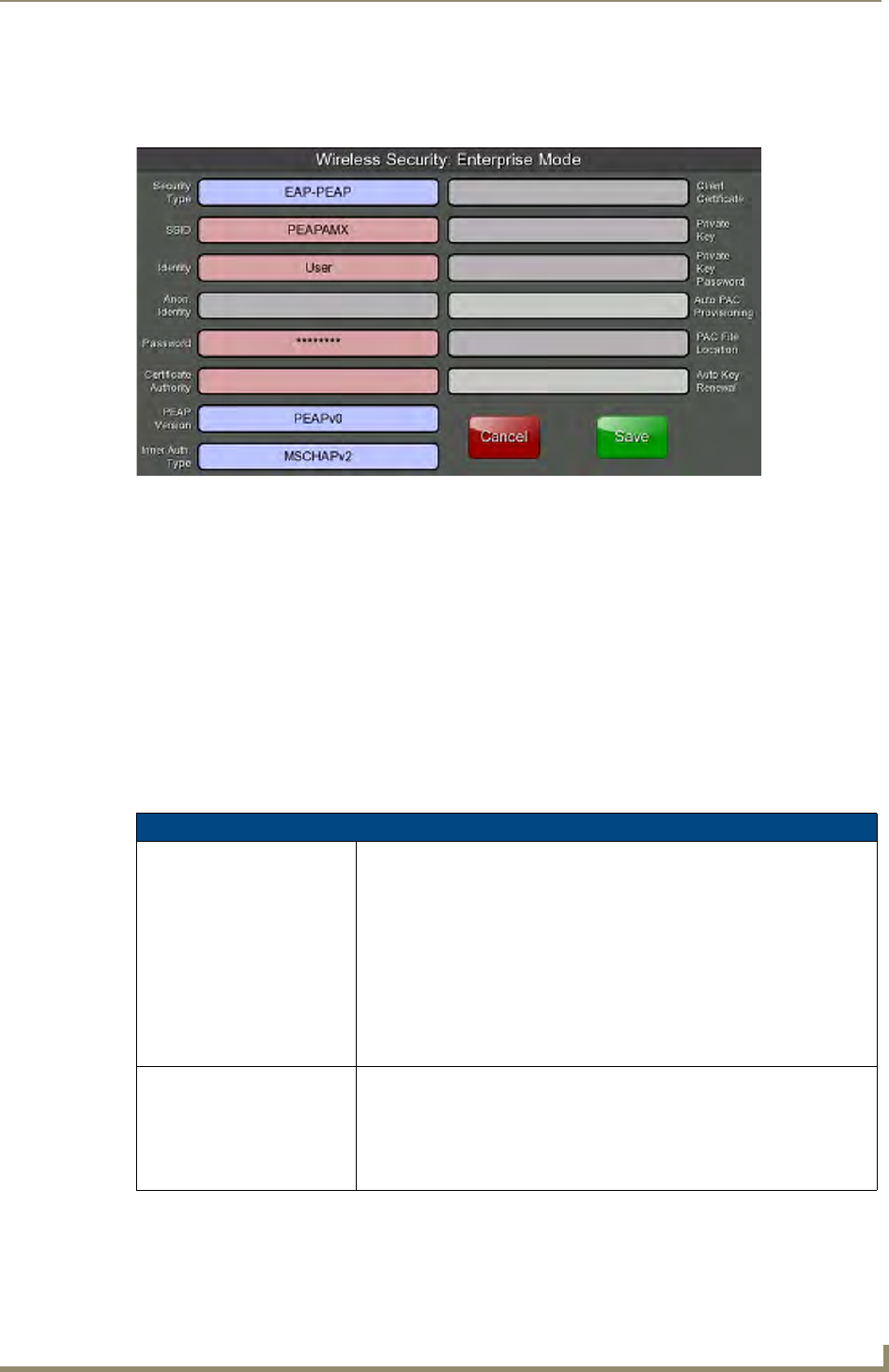
Protected Setup Pages
79
MVP-9000i Modero® Wireless Touch Panel with Intercom
EAP-PEAP
From the Security Modes options, press the Enterprise button to open the Wireless Security: Enterprise Mode
page. Scroll through the Security Type options to select EAP-PEAP (FIG. 73).
PEAP (Protected Extensible Authentication Protocol) was developed as a way to securely transmit
authentication information, such as passwords, over a wireless network environment. PEAP uses only server-
side public key certificates and therefore does not need a client (panel) certificate which makes the
configuration and setup easier.
There are two main versions of the PEAP protocol supported by panel’s DeviceScape Wireless Client:
PEAPv0
PEAPv1
PEAP uses inner authentication mechanisms supported by the DeviceScape Wireless Client, the most common
of which are:
MSCHAPv2 with PEAPv0
GTC with PEAPv1
EAP-PEAP security is designed for wireless environments where it is necessary to transmit data securely over
a wireless network.
FIG. 73 Wireless Security: Enterprise Mode - EAP-PEAP
EAP-PEAP
SSID (Service Set Identifier): Opens an on-screen keyboard to enter the SSID name used on the target
WAP. The SSID is a unique name used by the WAP, and is assigned to all
panels on that network. An SSID is required by the WAP before the panel is
permitted to join the network.
• The SSID is case sensitive and must not exceed 32 characters.
• Make sure this setting is the same for all points in the wireless network.
• With EAP security, the SSID of the WAP must be entered. If it is left blank,
the panel will try to connect to the first access point detected that supports
EAP. However, a successful connection is not guaranteed because the
detected WAP may be connected to a RADIUS server, which may not
support this EAP type and/or have the proper user identities configured.
Identity: Opens an on-screen keyboard to enter an EAP Identity string (used by the
panel to identify itself to an Authentication (RADIUS) Server).
Note: This information is similar to a username used to login to a secured
server or workstation. This works in tandem with the Password string, which
is similar to the password entered to gain access to a secured workstation.
Typically, this is in the form of a username such as jdoe@amx.com.
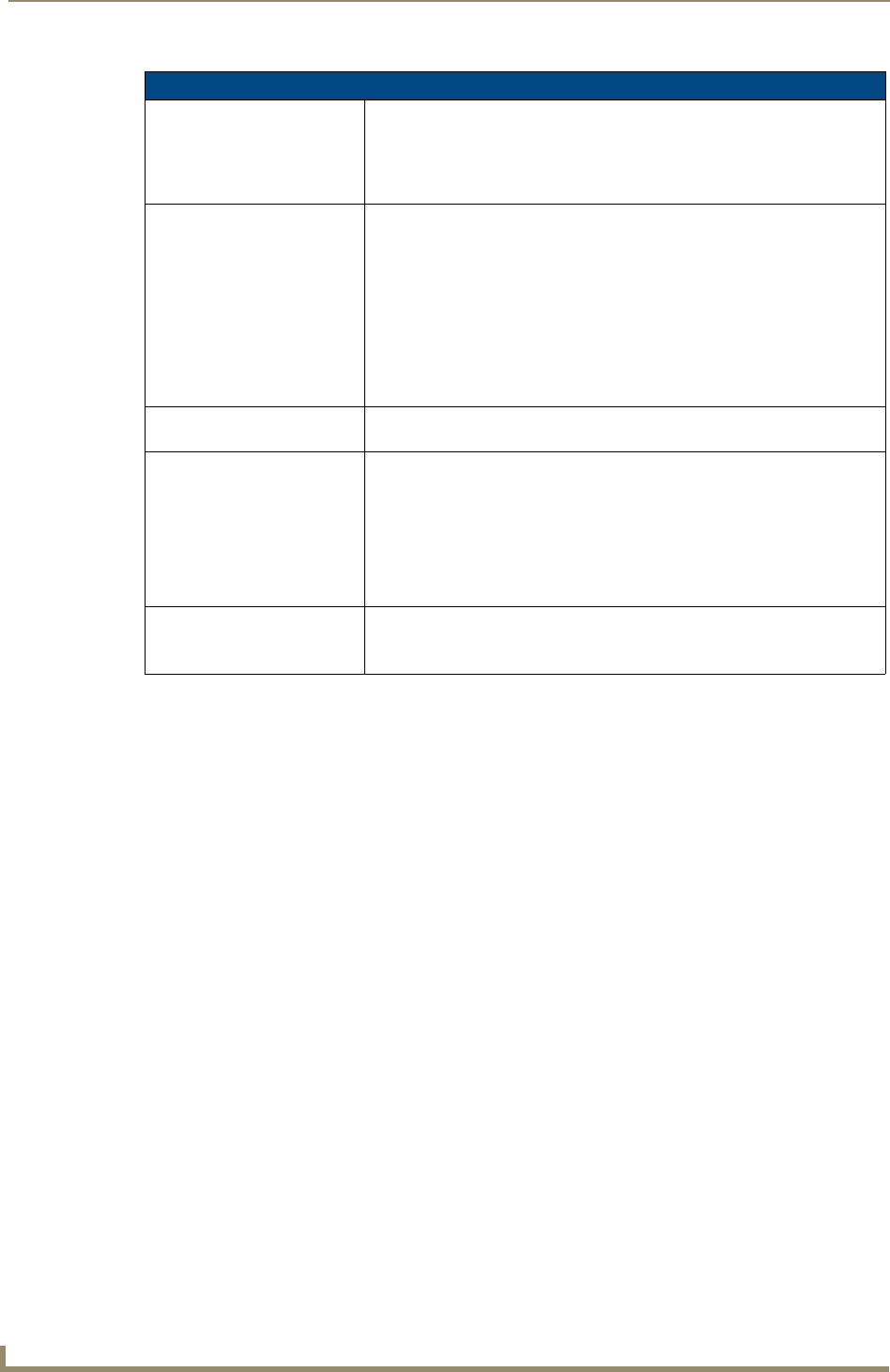
Protected Setup Pages
80 MVP-9000i Modero® Wireless Touch Panel with Intercom
Refer to the EAP Authentication section on page 182 and the Using the Site Survey Tool section on page 26 for
further details on these security options.
EAP-PEAP Settings (Cont.)
Password: Opens an on-screen keyboard to enter the network password string specified
for the user entered within the Identity field (used by the panel to identify itself
to an Authentication (RADIUS) Server)
Note: This information is similar to the password entered to gain access to a
secured workstation.
Certificate Authority: When pressed, the panel displays an on-screen Certificate Authority (CA)
File Location keyboard, which allows you to enter the name of the certificate
authority file which is used to validate the server certificate.This field is
optional.
If a server certificate is used, it should first be downloaded into the panel and
the Certificate Authority field should then be set to the name of that certificate
file. No file path should be used for this setting as all certificates are stored in
a specific directory that the user cannot control or change.
Use the on-screen keyboard’s Clear button to erase completely any
previously stored network path information.
PEAP Version: When pressed, this field cycles through the choices of available PEAP:
PEAPv0, PEAPv1, or PEAPv1 w/peaplabel=1.
Inner Authentication Type: When pressed, this field cycles through the choices of available Inner
Authentication mechanisms supported by the Devicescape Secure Wireless
Client. The most commonly used are: MSCHAPv2 and GTC.
• MSCHAPv2 (used with PEAPv0)
•GTC (used with PEAPv1)
•OTP
•MD5
Save/Cancel: • Save - store the new security information, apply changes, and return to the
previous page.
•Cancel - discard changes and return to the previous page.
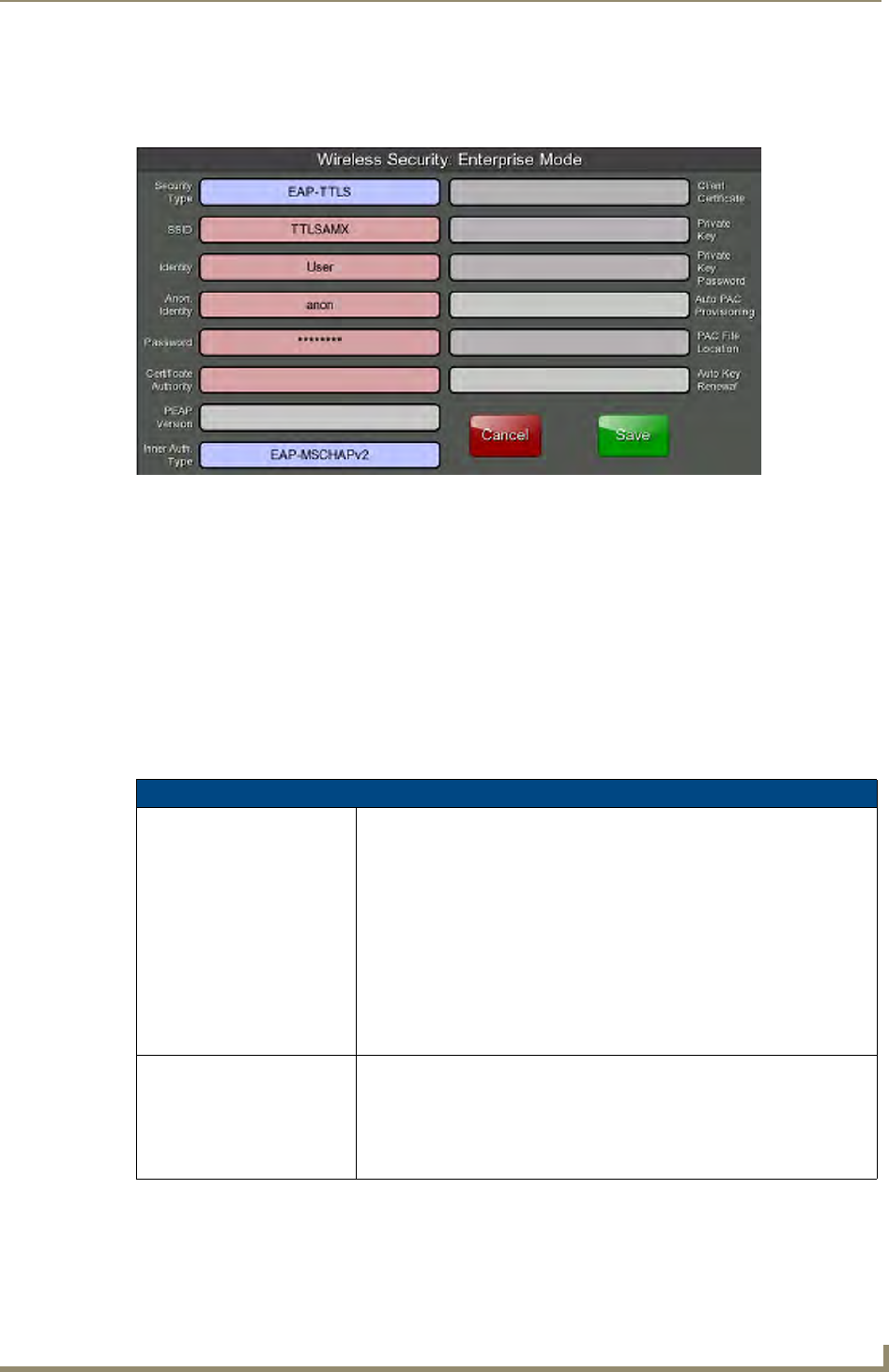
Protected Setup Pages
81
MVP-9000i Modero® Wireless Touch Panel with Intercom
EAP-TTLS
From the Security Modes options, press the Enterprise button to open the Wireless Security: Enterprise Mode
page. Scroll through the Security Type options to select EAP-TTLS (FIG. 74).
TTLS (EAP Tunneled Transport Layer Security) is an authentication method that does not use a client
certificate to authenticate the panel. However. this method is more secure than PEAP because it does not
broadcast the identity of the user. Setup is similar to PEAP, but differs in the following areas:
An anonymous identity must be specified until the secure tunnel between the panel and the Radius
server is setup to transfer the real identity of the user.
There is no end-user ability to select from the different types of PEAP.
Additional Inner Authentication choices are available to the end-user.
EAP-TTLS security is designed for wireless environments where the Radius server needs to validate directly
the identity of the client (panel) before allowing it access to the network. This validation is done by tunneling a
connection through the WAP and directly between the panel and the Radius server. Once the client is identified
and then validated, the Radius server disconnects the tunnel and allows the panel to access the network directly
via the target WAP.
FIG. 74 Wireless Security: Enterprise Mode - EAP-TTLS
EAP-TTLS
SSID (Service Set Identifier): Opens an on-screen keyboard to enter the SSID name used on the target
WAP.
The SSID is a unique name used by the WAP, and is assigned to all panels
on that network. An SSID is required by the WAP before the panel is
permitted to join the network.
• The SSID is case sensitive and must not exceed 32 characters.
• Make sure this setting is the same for all points in the wireless network.
• With EAP security, the SSID of the WAP must be entered. If it is left blank,
the panel will try to connect to the first access point detected that supports
EAP. However, a successful connection is not guaranteed because the
detected WAP may be connected to a RADIUS server, which may not
support this EAP type and/or have the proper user identities configured.
Identity: Opens an on-screen keyboard. Enter an EAP Identity string (used by the
panel to identify itself to an Authentication (RADIUS) Server).
Note: This information is similar to a username used to login to a secured
server or workstation. This works in tandem with the Password string which is
similar to the password entered to gain access to a secured workstation.
Typically, this is in the form of a username such as: jdoe@amx.com.
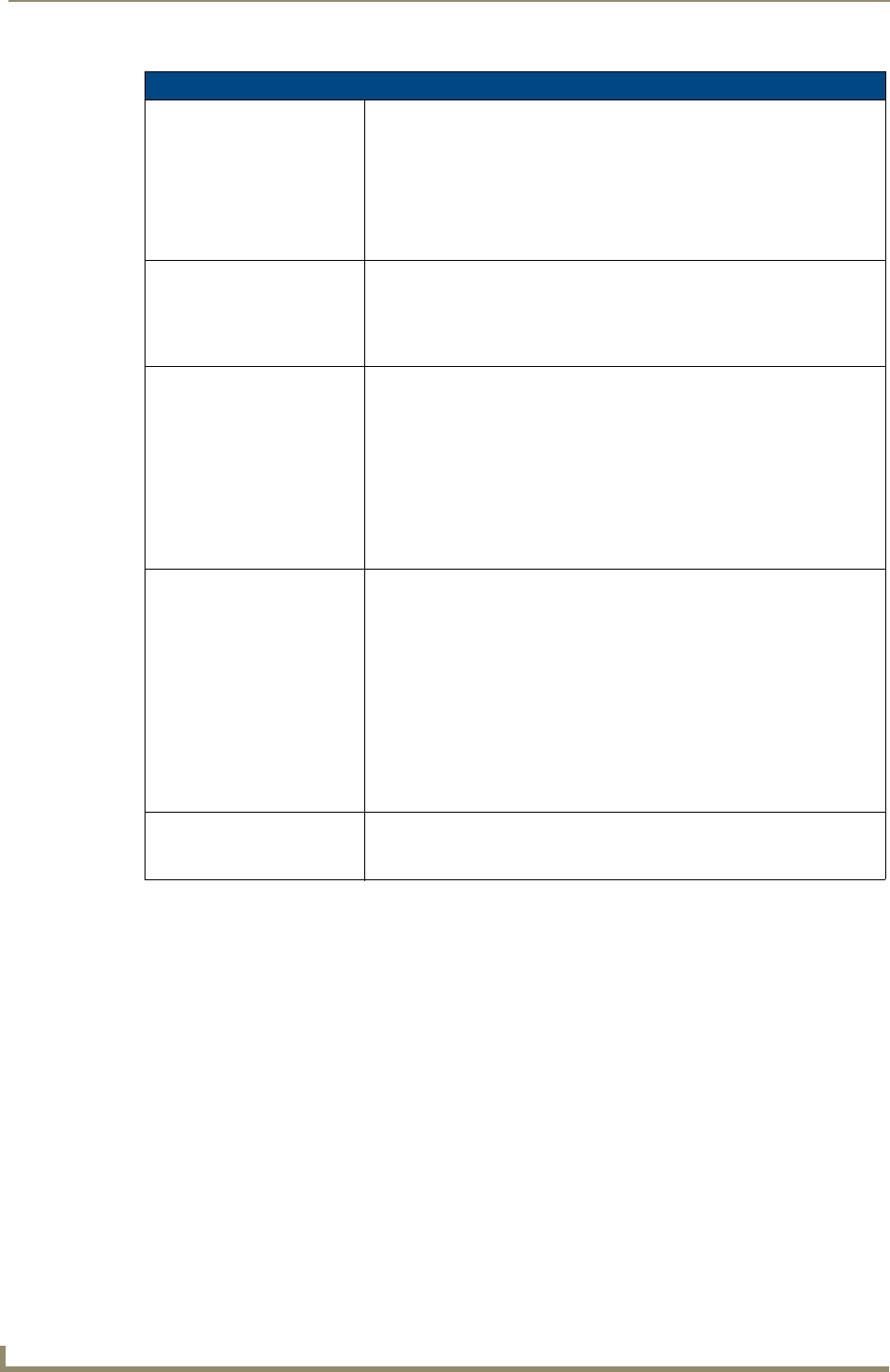
Protected Setup Pages
82 MVP-9000i Modero® Wireless Touch Panel with Intercom
Refer to the EAP Authentication section on page 182 and the Using the Site Survey Tool section on page 26 for
further details on these security options.
EAP-TTLS (Cont.)
Anonymous Identity: Opens an on-screen keyboard. Enter an IT provided alpha-numeric string
which (similar to the username) used as the identity, but that does not
represent a real user.
This information is used as a fictitious name which might be seen by sniffer
programs during the initial connection and setup process between the panel
and the Radius server. In this way the real identity (username) is protected.
Typically, this is in the form of a fictitious username such as:
anonymous@amx.com
Password: Opens an on-screen keyboard. Enter the network password string specified
for the user entered within the Identity field (used by the panel to identify itself
to an Authentication (RADIUS) Server)
Note: This information is similar to the password entered to gain access to a
secured workstation.
Certificate Authority: When pressed, the panel displays an on-screen Certificate Authority (CA)
File Location keyboard which allows you to enter the name of the certificate
authority file which is used to validate the server certificate. This field is
optional.
If a server certificate is used, it should first be downloaded into the panel and
the Certificate Authority field should then be set to the name of that certificate
file. No file path should be used for this setting as all certificates are stored in
a specific directory that the user cannot control or change.
Use the on-screen keyboard’s Clear button to completely erase any
previously stored network path information.
Inner Authentication Type: When pressed, this field cycles through the choices of available Inner
Authentication mechanism supported by the Devicescape Secure Wireless
Client:
• EAP-MSCHAPv2
• EAP-GTC
• EAP-OTP
• EAP-MD5
• MSCHAPv2
• MSCHAP
•PAP
• CHAP
Save/Cancel: • Save - store the new security information, apply changes, and return to the
previous page.
•Cancel - discard changes and return to the previous page.
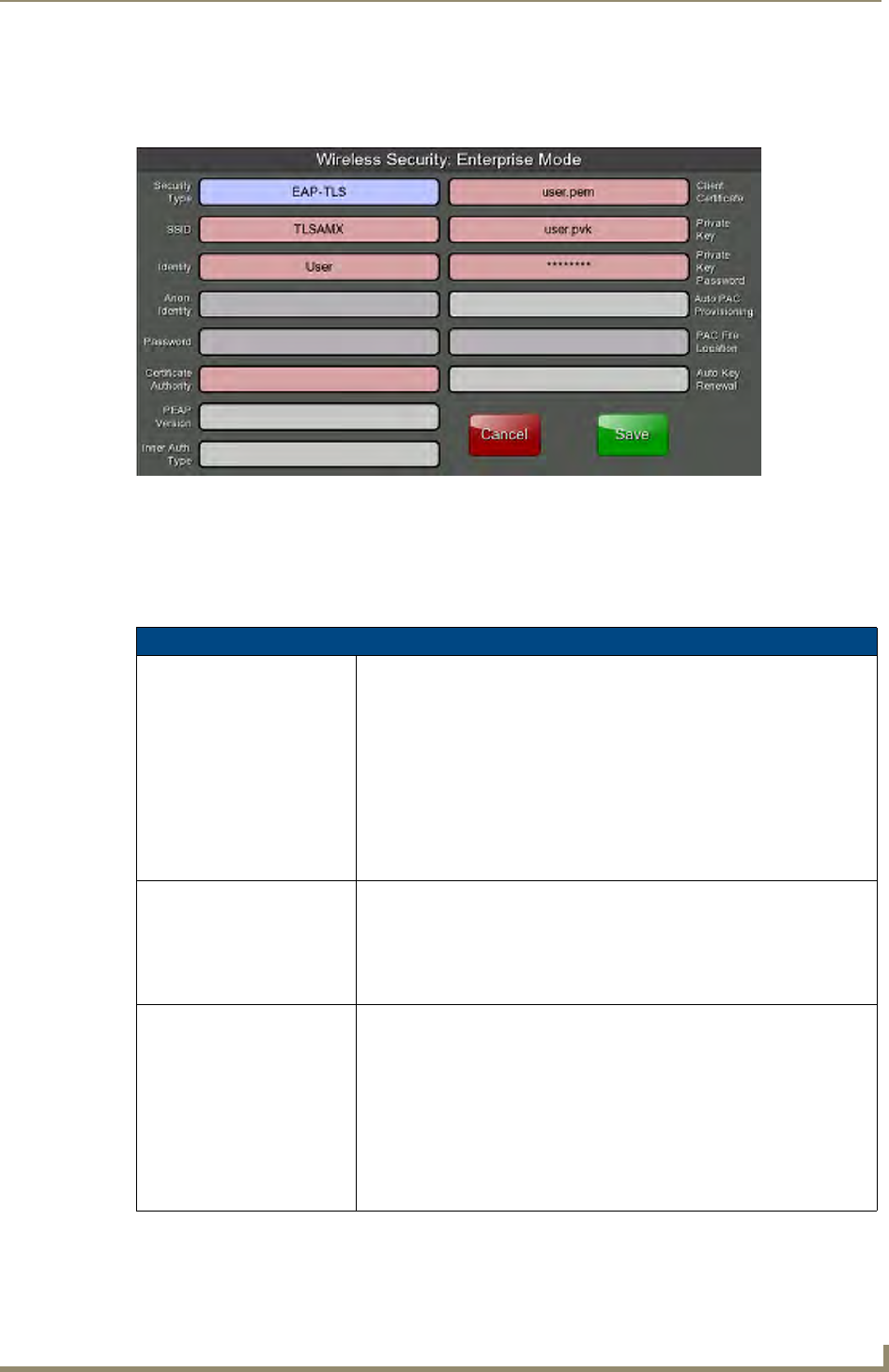
Protected Setup Pages
83
MVP-9000i Modero® Wireless Touch Panel with Intercom
EAP-TLS
From the Security Modes options, press the Enterprise button to open the Wireless Security: Enterprise Mode
page. Scroll through the Security Type options to select EAP-TLS (FIG. 75).
TLS (Transport Layer Security) was the original standard wireless LAN EAP authentication protocol. TLS
requires additional work during the deployment phase, but provides additional security since even a
compromised password is not enough to break into an EAP-TLS protected wireless network environment.
EAP-TLS security is designed for wireless environments where it is necessary to securely transmit data over a
wireless network by adding an additional level of security protocol via the use of a private key.
FIG. 75 Wireless Security: Enterprise Mode - EAP-TLS
EAP-TLS
SSID (Service Set Identifier): Opens an on-screen keyboard for entering the SSID name used on the target
WAP. The SSID is a unique name used by the WAP, and is assigned to all
panels on that network. An SSID is required by the WAP before the panel is
permitted to join the network.
• The SSID is case sensitive and must not exceed 32 characters.
• Make sure this setting is the same for all points in the wireless network.
• With EAP security, the SSID of the WAP must be entered. If it is left blank,
the panel will try to connect to the first access point detected that supports
EAP. However, a successful connection is not guaranteed because the
detected WAP may be connected to a RADIUS server, which may not
support this EAP type and/or have the proper user identities configured.
Identity: Opens an on-screen keyboard for entering an EAP Identity string (used by
the panel to identify itself to an Authentication (RADIUS) Server).
Note: This information is similar to a username used to login to a secured
server or workstation. This works in tandem with the Password string, which
is similar to the password entered to gain access to a secured workstation.
Typically, this is in the form of a username such as: jdoe@amx.com.
Certificate Authority: When pressed, the panel displays an on-screen Certificate Authority (CA)
File Location keyboard, for entering the name of the certificate authority file
which is used to validate the server certificate.
This field is optional.
If a server certificate is used, it should first be downloaded into the panel and
the Certificate Authority field should then be set to the name of that certificate
file. No file path should be used for this setting, as all certificates are stored in
a specific directory that the user cannot control or change.
• Use the on-screen keyboard’s Clear button to completely erase any
previously stored network path information.
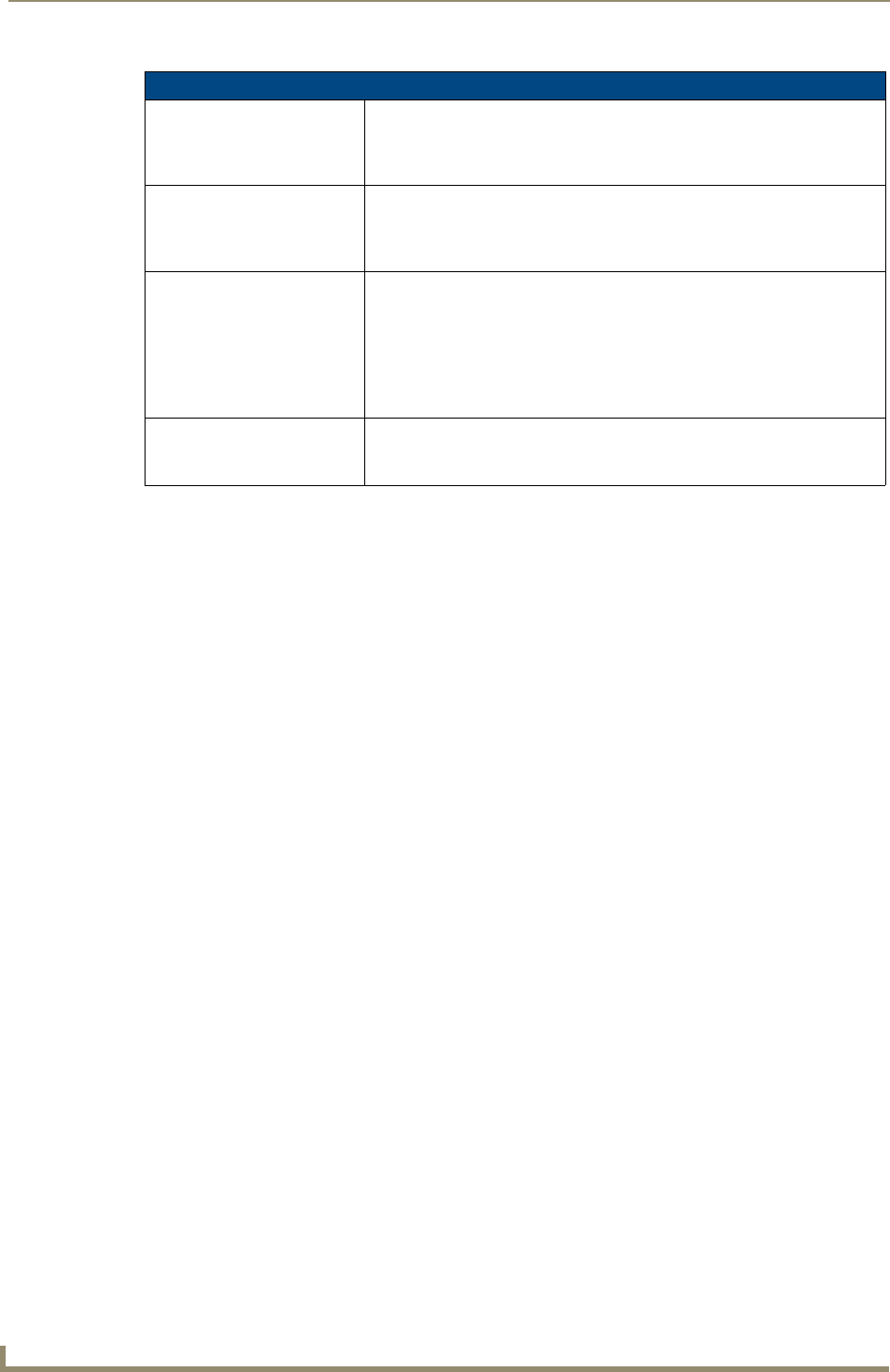
Protected Setup Pages
84 MVP-9000i Modero® Wireless Touch Panel with Intercom
Refer to the EAP Authentication section on page 182 for further details on these security options.
Refer to the Using the Site Survey Tool section on page 26 for more information on using this
feature.
EAP-TLS (Cont.)
Client Certificate: Opens an on-screen keyboard for entering the name of the file containing the
client (panel) certificate for use in certifying the identity of the client (panel).
• Refer to the Client Certificate Configuration section on page 85 for
information regarding Client Certificates and their parameters.
Private Key: When pressed, the panel displays an on-screen Client Private Key File
Location keyboard for entering the name of the file containing the private key.
• Use the on-screen keyboard’s Clear button to completely erase any
previously stored network path information.
Private Key password: This field should only be used if the Private Key is protected with a password.
If no password protection is associated with the Private Key, then this field
should be left blank.
• When pressed, the panel displays an on-screen Private Key Password
keyboard which allows you to enter an alpha-numeric password string.
• Use the on-screen keyboard’s Clear button to completely erase any
previously stored network path information.
Save/Cancel: • Save - store the new security information, apply changes, and return to the
previous page.
•Cancel - discard changes and return to the previous page.
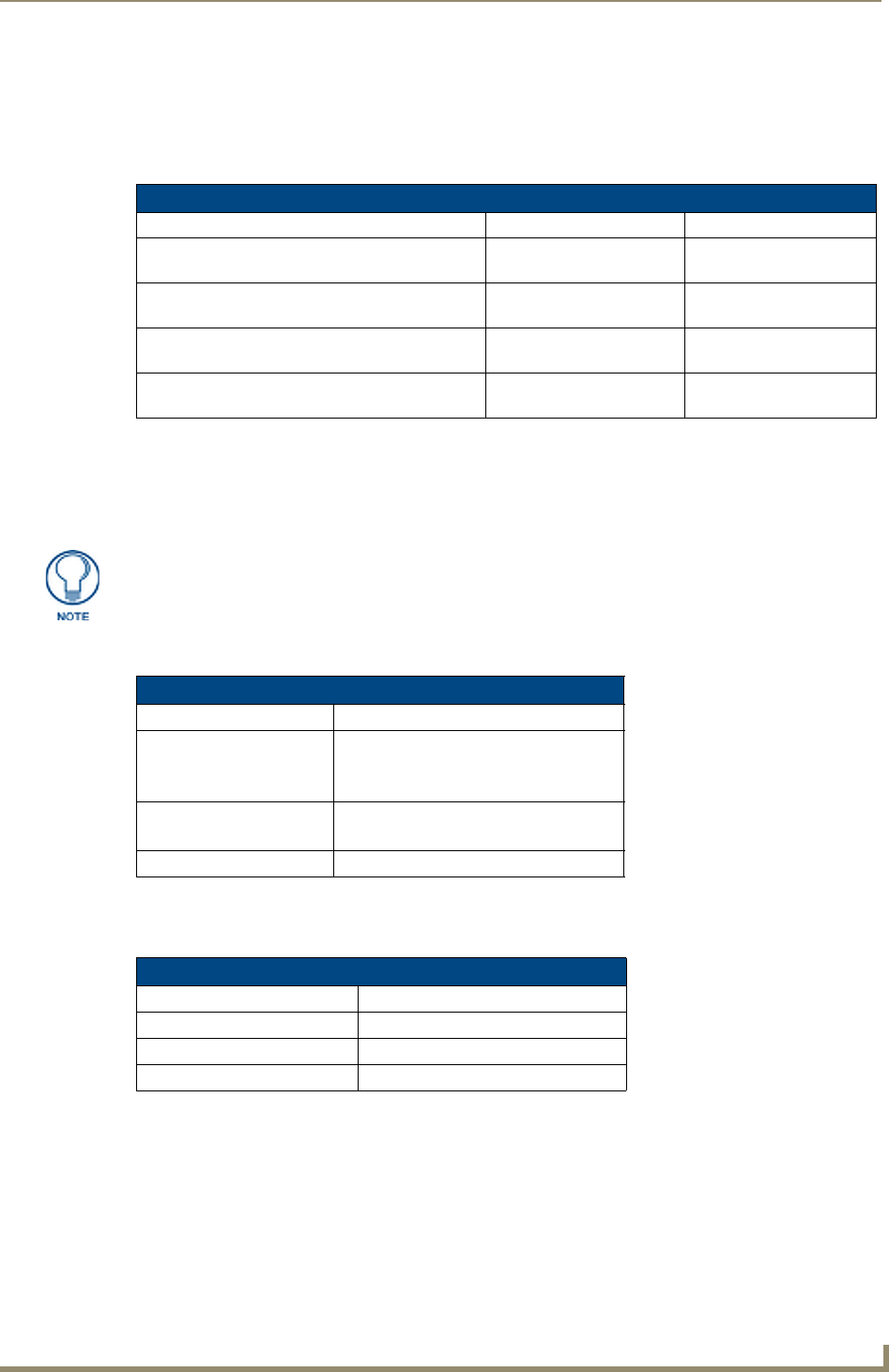
Protected Setup Pages
85
MVP-9000i Modero® Wireless Touch Panel with Intercom
Client Certificate Configuration
A client certificate can be configured by an IT department in several ways. The client certificate and private
key can both be incorporated into one file or split into two separate files. In addition, the file format used by
these files could be PEM, DER, or PKCS12. These formats are described later in this section. The following
table describes how to fill in the fields for each possible case.
AMX supports the following security certificates
PEM (Privacy Enhanced Mail)
DER (Distinguished Encoding Rules)
PKCS12 (Public Key Cryptography Standard #12)
Certificate files frequently use 5 file extensions. It can be confusing because there is not a one to one
correspondence. The following table shows the possible file extension used for each certificate type:
Please note which certificate types are supported by the different certificate fields used on the configuration
screens (PEAP, TTLS, and TLS). The following table outlines the firmware fields and their supported
certificate types.
Client Certificate Configuration
Certificate Configuration Client Certificate Field Private Key Field
Single file contains both the client certificate and
the private key. Format is: PEM or DER.Enter the file name Enter the same file name
First file contains the client certificate, second file
contains the private key. Format is: PEM or DER.Enter the first file name Enter the second file name
Single file contains both the client certificate and
the private key. Format is: PKCS12 Leave this field blank Enter the file name
First file contains the client certificate, second file
contains the private key. Format is: PKCS12 Not supported Not supported
PKCS12 files are frequently generated by Microsoft certificate applications.
Otherwise, PEM is more common.
Certificates and their Extensions
Certificate Type Possible File Extensions
PEM .cer
.pem
.pvk
DER .cer
.der
PKCS12 .pfx
Certificate Types Supported by the Modero Firmware
Configuration Field Name Certificate File Type Supported
Certificate Authority field PEM and DER
Client Certificate field PEM and DER
Private Key field .PEM, DER, and PKCS12
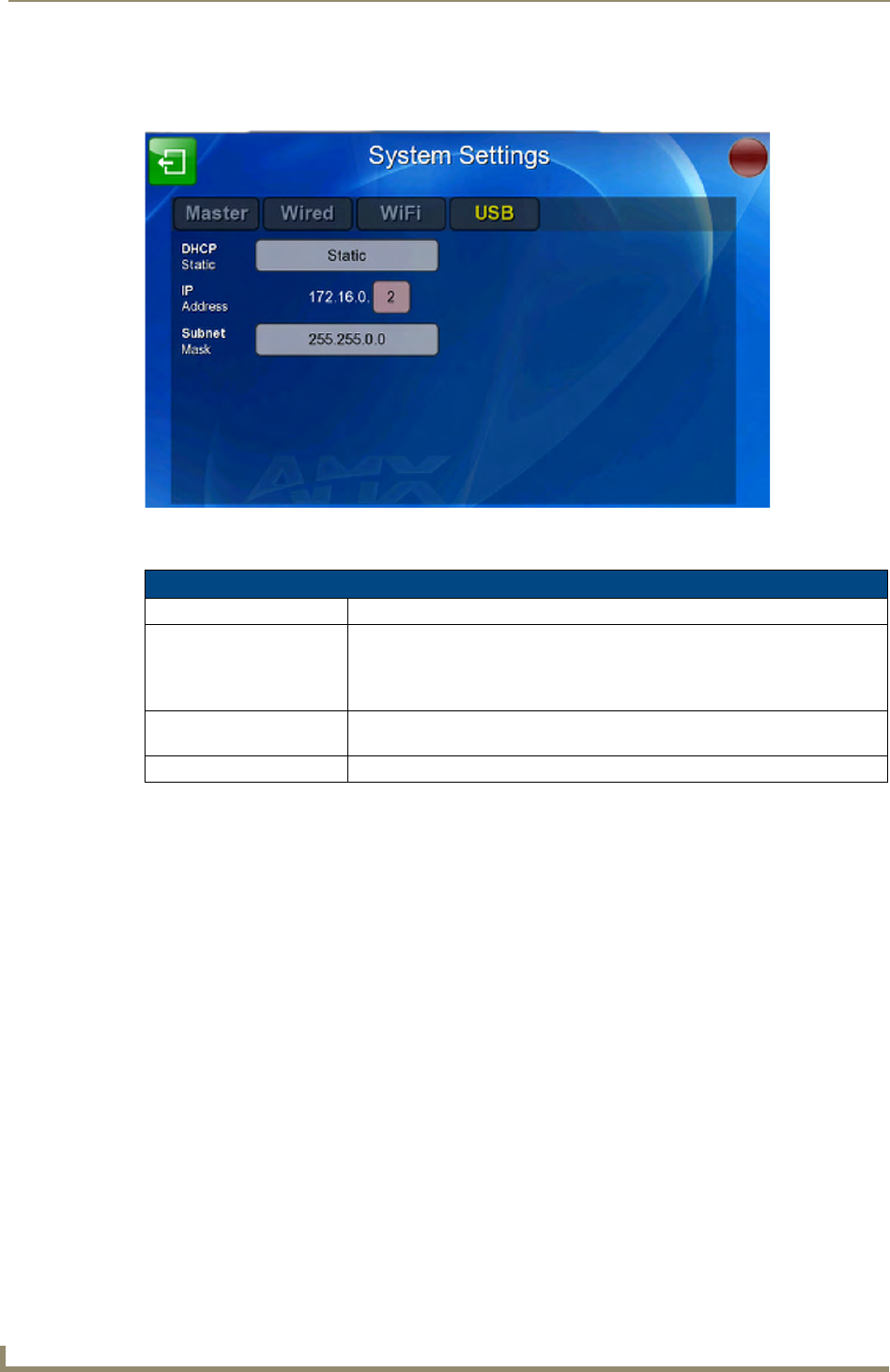
Protected Setup Pages
86 MVP-9000i Modero® Wireless Touch Panel with Intercom
System Settings - USB
This tab controls the ability for the MVP-9000i to connect to a network via a USB connection.
The features on the USB tab include:
FIG. 76 System Settings page - USB tab
System Settings - USB Tab
Back: Saves all changes and returns to the previous page.
Connection Status icon: The icon in the upper-right corner of each Protected Setup page provides a con-
stant visual indication of current connection status.
Note: a Lock appears on the icon if the panel is connected to a secured NetLinx
Master.
IP Address: Displays the secondary IP address for the panel. The last series of digits may
be edited, with a host number added between 2 and 254.
Subnet Mask Displays the subnet mask address for the panel.
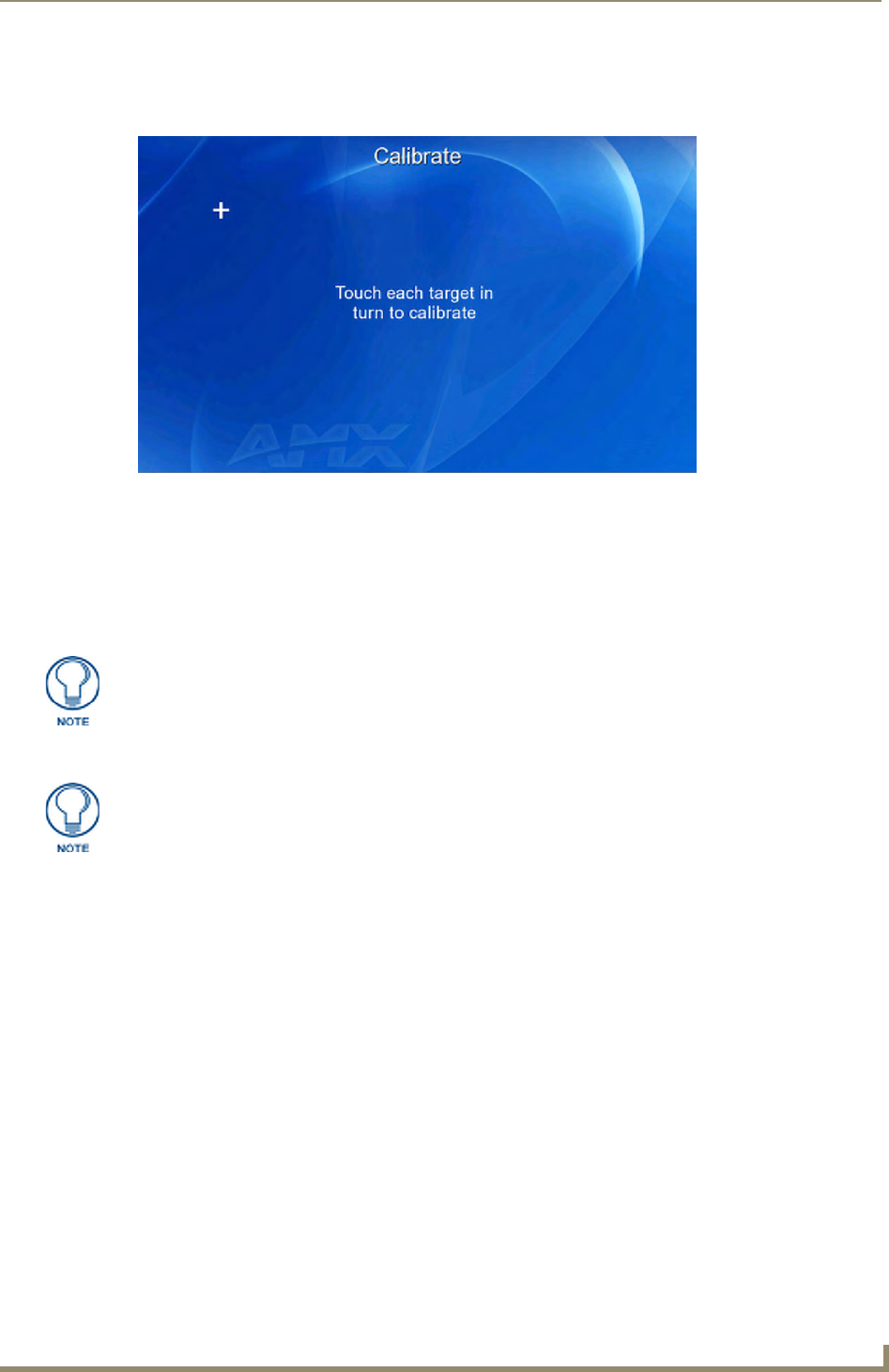
Protected Setup Pages
87
MVP-9000i Modero® Wireless Touch Panel with Intercom
Calibrate Page
The Calibrate page (FIG. 77) allows you to calibrate the touch panel for accurate button selection.
1. From the Protected Setup page, touch the Calibration button to open the Calibrate page.
2. Press the crosshairs in turn. If the crosshairs are not touched within ten seconds, the MVP-9000i will
return to the Protected Setup page.
3. The page will read "Calibration Successful. Touch to continue." Touch anywhere on the screen to return
to the Protected Setup page.
Always calibrate the panel before its initial use, and after downloading new firmware.
FIG. 77 Calibrate page
If the screen is not touched at that point, the device will automatically return to the
Protected Setup page within 10 seconds.
The Calibrate page may also be accessed by pressing down and holding the Reset
button on the side of the panel for 9 seconds. For more information, please refer to
the Accessing the Setup pages section on page 45.
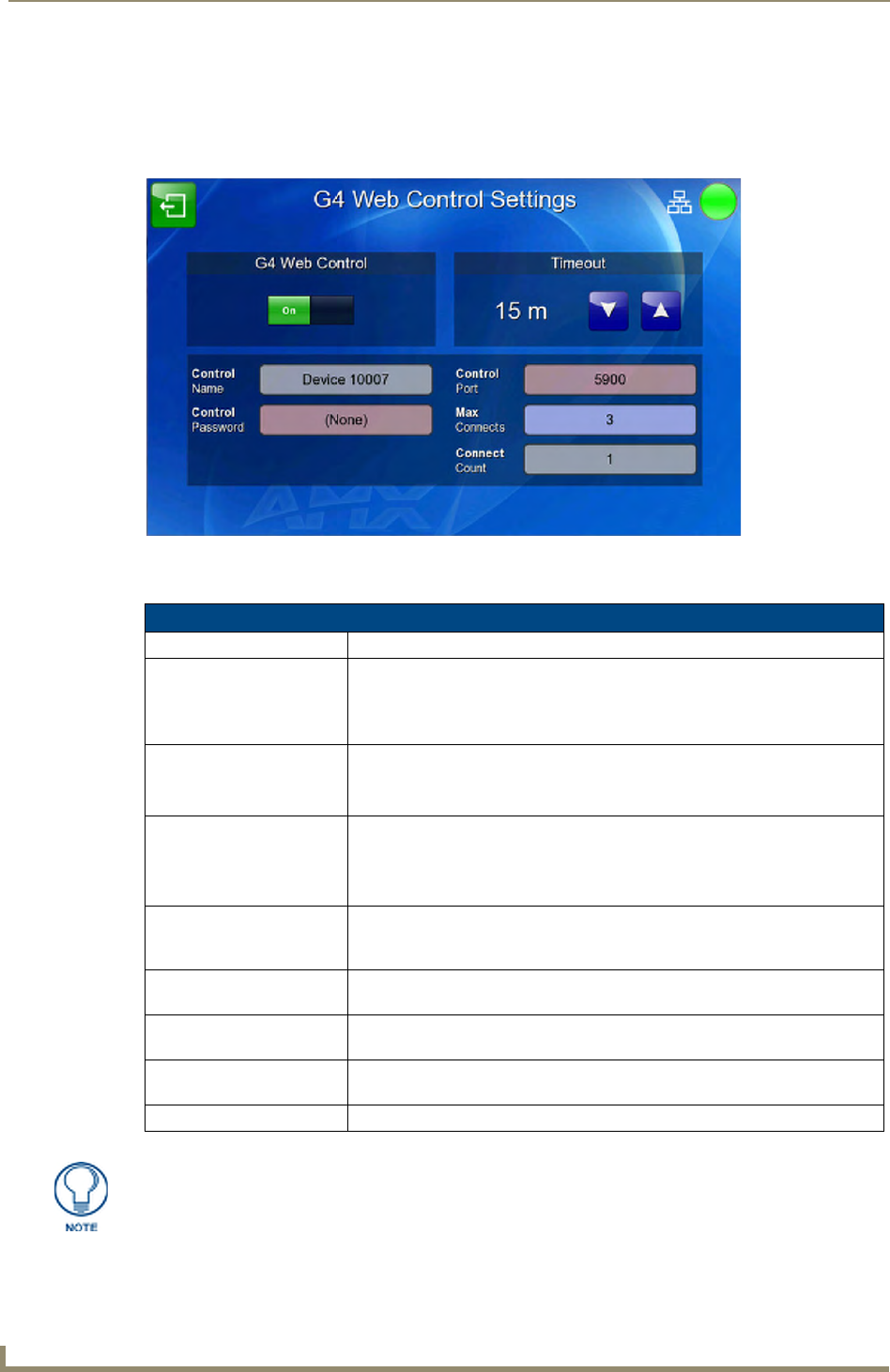
Protected Setup Pages
88 MVP-9000i Modero® Wireless Touch Panel with Intercom
G4 Web Control Settings Page
An on-board VNC (Virtual Network Computing) server allows the panel to connect to any remote PC running
a VNC client. Once connected, the client can view and control the panel remotely. The options on this page
allow you to enable/disable G4 Web Control functionality(FIG. 78).
Features on this page include:
FIG. 78 G4 Web Control Settings page
G4 Web Control Settings Page
Back: Saves all changes and returns to the previous page.
Connection Status icon: The icon in the upper-right corner of each Protected Setup page provides a
constant visual indication of current connection status.
Note: a Lock appears on the icon if the panel is connected to a secured NetLinx
Master.
G4 Web Control: The G4 Web Control button toggles between the two G4 activation settings:
•Off - deactivates G4 Web Control on the panel.
•On - activates G4 Web Control on the panel.
Timeout: Sets the length of time (in minutes) that the panel can remain idle, detecting no
cursor movements, before the G4 Web Control session is terminated.
• Minimum value = Off (panel never times out)
Maximum value = 4 h (panel times out after 4 hours)
Control Name: Use this field to enter a unique alpha-numeric string to be used as the panel’s
display name within the Manage WebControl Connections window of the
NetLinx Security browser window.
Control Password: Use this field to enter the G4 Authentication session password required for
VNC access to the panel.
Control Port: Use this field to enter the number of the port used by the VNC Web Server.
Default = 5900.
Max Connects: Displays the maximum number of users that can be simultaneously connected
to this panel via VNC. Default = 1.
Connect Count: Displays the number of users currently connected to this panel via VNC.
Refer to the Using G4 Web Control to Interact with a G4 Panel section on page 40 for
instructions on using the G4 Web Control page with the web-based NetLinx Security
application.

Protected Setup Pages
89
MVP-9000i Modero® Wireless Touch Panel with Intercom
The panel MUST be rebooted to save changes made on this page.
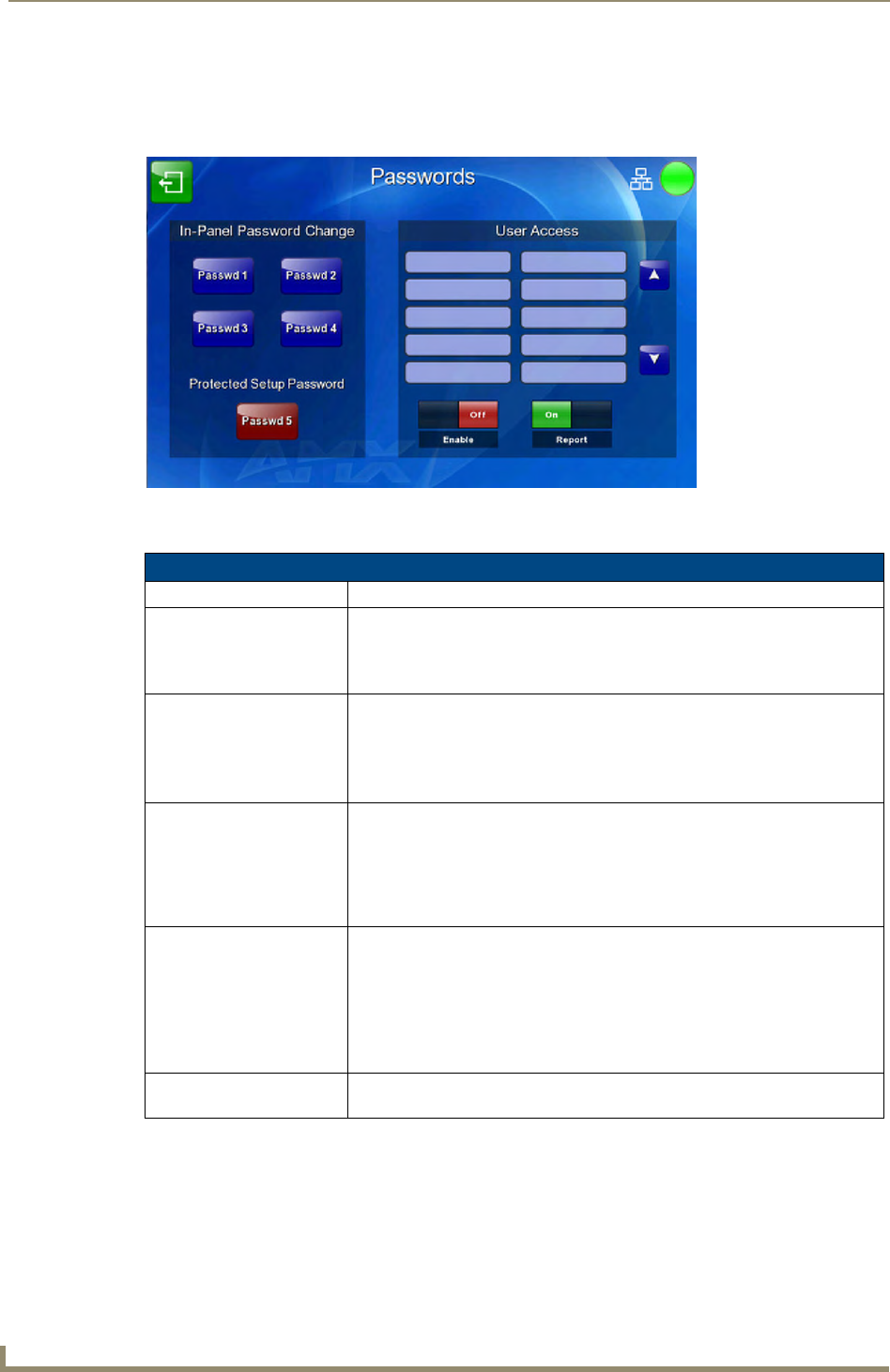
Protected Setup Pages
90 MVP-9000i Modero® Wireless Touch Panel with Intercom
Passwords
The options on the Passwords page (FIG. 79) allow assignment of passwords required for users to access the
Protected Setup page, and to release the device from a Table or Wall Docking Station.
Features on this page include:
FIG. 79 Passwords page
Passwords Page
Back: Saves all changes and returns to the previous page.
Connection Status icon: The icon in the upper-right corner of each Protected Setup page provides a
constant visual indication of current connection status.
Note: a Lock appears on the icon if the panel is connected to a secured NetLinx
Master.
In Panel Password Change: Accesses the alphanumeric values associated to particular password sets.
• The PASSWORD 1, 2, 3, 4 and 5 (protected) buttons open a keyboard to
enter alphanumeric values associated to the selected password group.
Note: Clearing Password #5 removes the need to enter a password before
accessing the Protected Setup page.
User Access: Use these buttons to access and modify the user name/password combinations
required for removing the panel from a docking station. The number of user
access passwords on the panel is limited only by the amount of storage
memory available.
Use the UP/DN buttons to scroll through the list of saved User Access user
names and passwords.
Enable/Enabled: The Enable button allows you to toggle between activating or deactivating the
MVP panel requirement of a user to enter a pre-defined password before
removing the panel from a connected docking station:
•Off - does not prompt the user for a password, the docking station just
releases the panel when the security release pushbutton is pressed.
•On - requires that a valid password from the User Access list be entered
before removing a panel from a docking station.
Report: The Report button enables/disables reporting the panel’s docking status to the
Master.
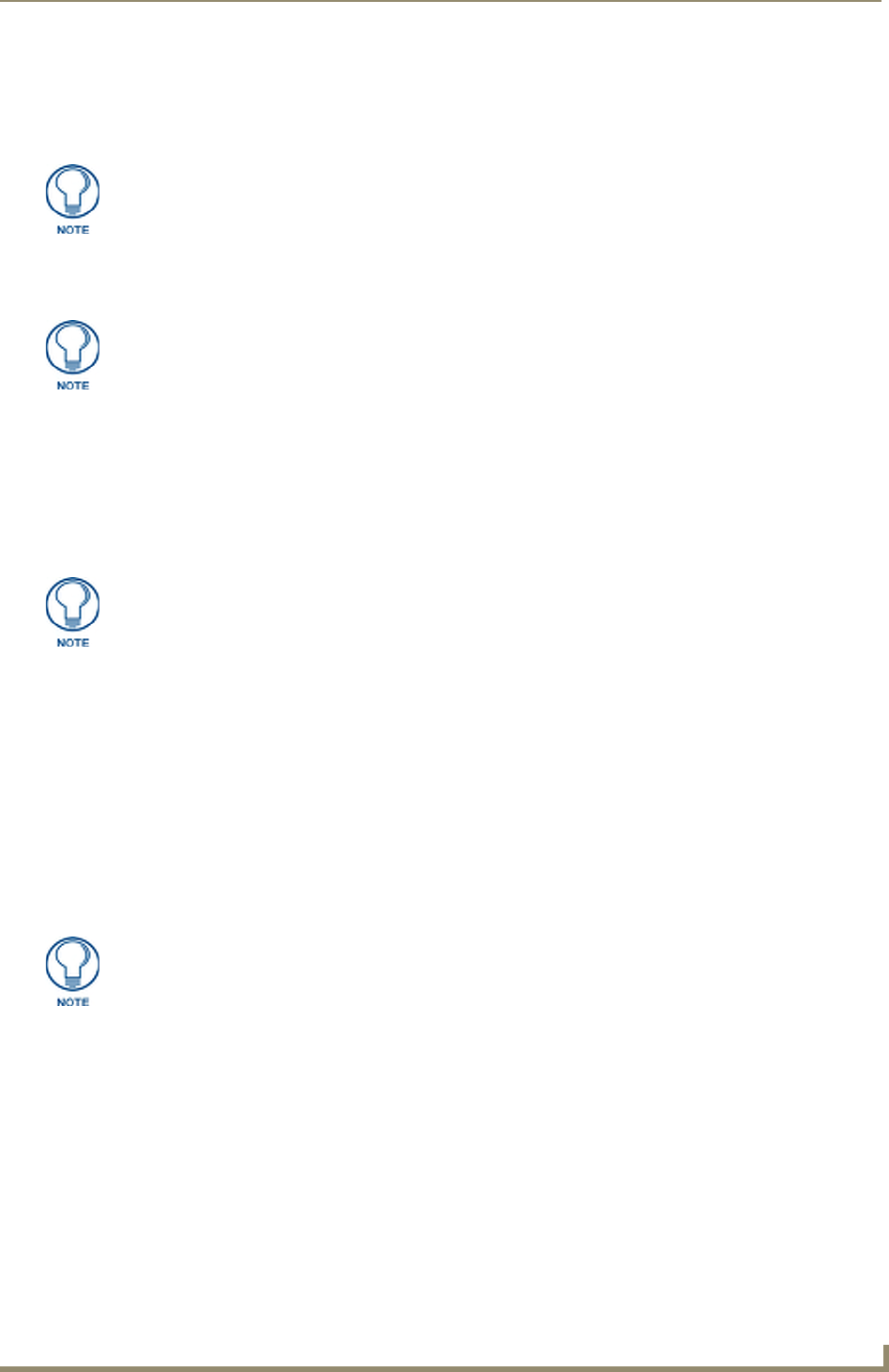
Protected Setup Pages
91
MVP-9000i Modero® Wireless Touch Panel with Intercom
To change a previously established password:
1. In the Password Settings page, press the button in the In Panel Password Change section for the particular
password to be changed.
2. In the Password keyboard, enter the new alphanumeric password.
3. Press Done when complete.
To list a new user within the User Access section:
1. Press a blank button in the User Access section.
2. In the Name keyboard, enter the user’s name or nickname and press Done when finished.
3. In the Password keyboard, enter the selected alphanumeric password and press Done when finished.
4. The new user’s name will appear in the left column of User Access section. The password will also appear
in the right column, but its characters will be replaced with asterisks.
To change a User Access password:
1. Press the button corresponding to the user’s name in the User Access section.
2. In the Password keyboard, enter the user’s password and press Done.
3. Press the password button in the right column of the User Access section.
4. Enter the new password into the Password keyboard and press Done.
To view all previous instances of users accessing the device:
1. From the Password Settings page, press the Report button to highlight it. The MVP-9000i will record all
successful and unsuccessful attempts to access the touch panel.
2. Press the Record button to send a record to the network Master of all recorded attempts to access the
device. This record may be retrieved from the Master at any time.
Password 5 is protected, and can only be changed by the Administrator.
Only one of the main passwords may be used to access the Protected Settings page.
An individual user password may not be used to access the Protected Settings page
unless it matches one of the main passwords.
No matter how many characters are in an actual password, the Password column in
the User Access section will always show five asterisks.
For more information on removing an MVP-9000i from a MVP-WDS-9 Docking
Station, please refer to the Unlocking the Touch Panel section on page 13.
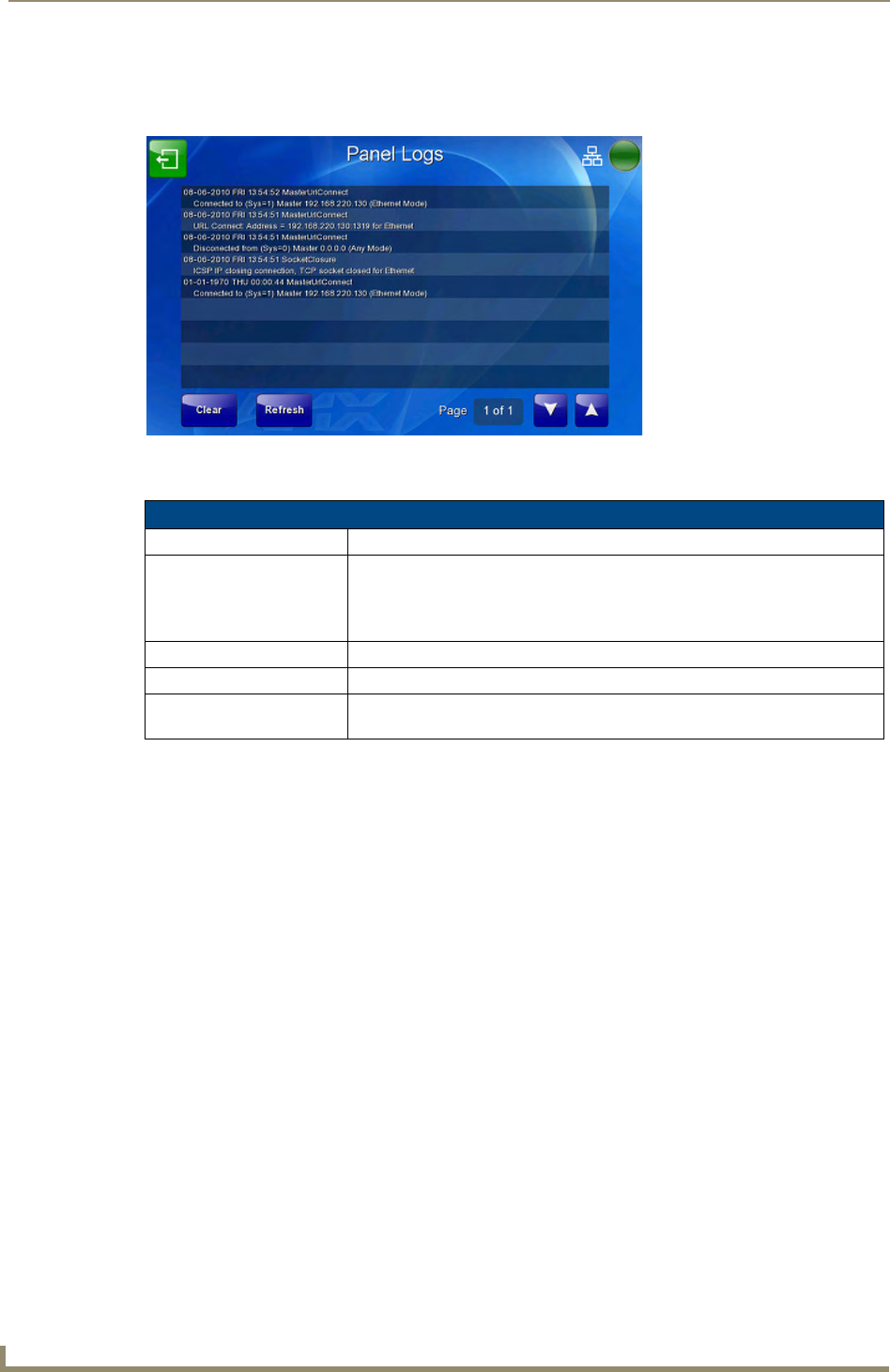
Protected Setup Pages
92 MVP-9000i Modero® Wireless Touch Panel with Intercom
Panel Logs Page
The Panel Logs page (FIG. 80) chronicles all previous connections between the device and the network
The features on this page include:
FIG. 80 Panel Logs Page
Panel Logs Page
Back: Saves all changes and returns to the previous page.
Connection Status icon: The icon in the upper-right corner of each Protected Setup page provides a
constant visual indication of current connection status.
Note: a Lock appears on the icon if the panel is connected to a secured NetLinx
Master.
Clear: Clears all connection logs.
Refresh: Refreshes displayed log information.
Page: Displays the current log page number. Use the Up/Down arrows to select log
pages.
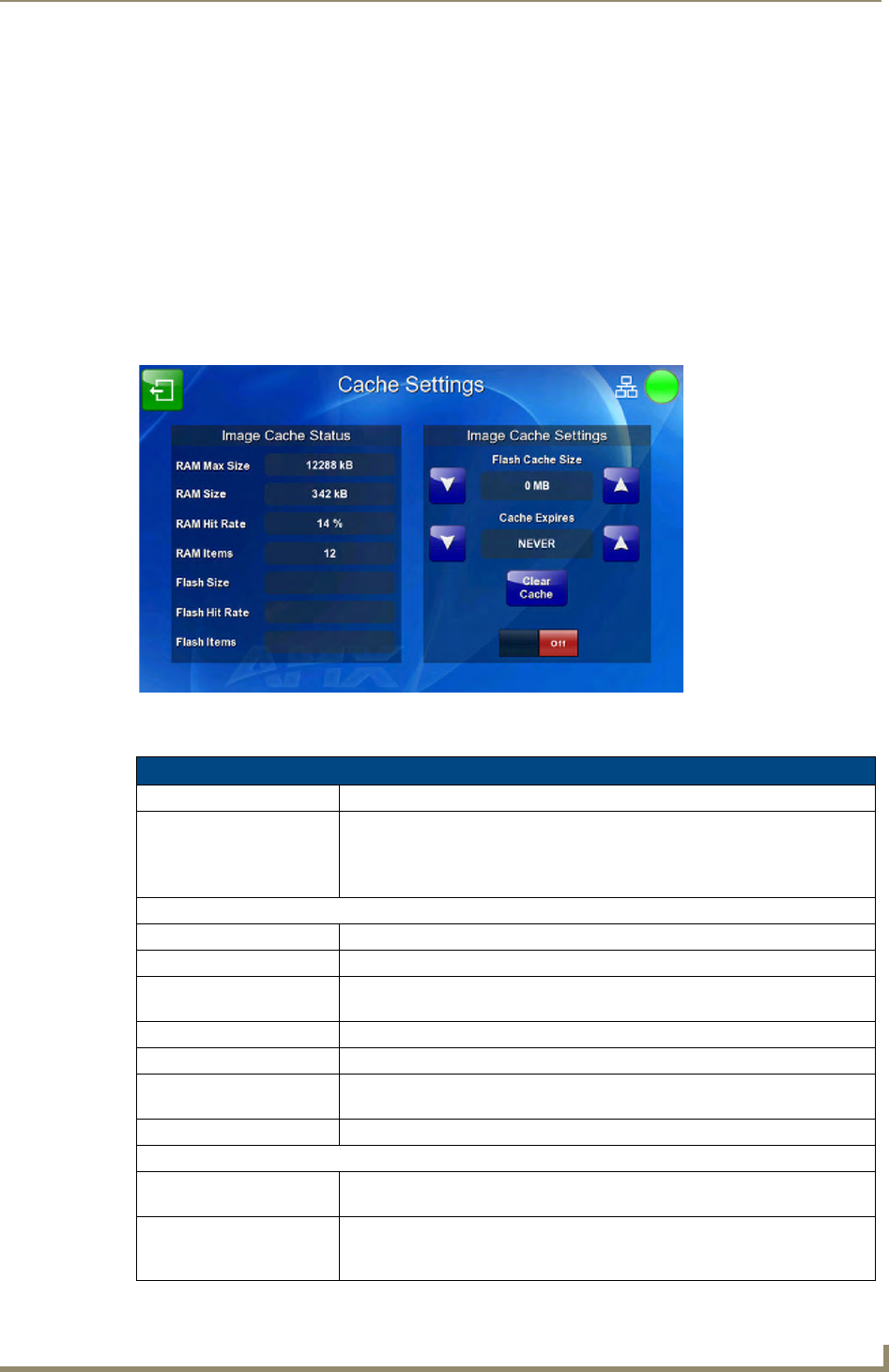
Protected Setup Pages
93
MVP-9000i Modero® Wireless Touch Panel with Intercom
Cache Settings Page
The options on the Cache Settings page (FIG. 81) allow setting and clearing of the flash memory cache, as
well as viewing the status of the current cache settings. The G4 graphics engine caches images to decrease load
time of previously viewed images. RAM caching is always enabled, and both static and dynamic images are
stored in the RAM cache as they are viewed. The size of RAM cache is automatically configured to take into
account available memory versus memory that may be needed by the panel later. As the RAM cache
approaches its maximum size, the oldest items in the cache may be discarded to make room for newer items. If
Flash caching is enabled, dynamic images that would have been discarded will actually be moved to Flash,
since retrieving images on Flash is typically faster than across a network, although it is slower than using a
RAM cache. Note that since static images are already stored on Flash, they are never moved to the Flash cache,
so Flash caching applies only to dynamic images. Images in Flash cache are moved back to RAM cache the
next time they are viewed. As the Flash cache approaches its maximum size, the least recently used items may
be discarded to make room for new items.
The features on this page include:
FIG. 81 Cache Settings Page
Cache Settings Page
Back: Saves all changes and returns to the previous page.
Connection Status icon: The icon in the upper-right corner of each Protected Setup page provides a
constant visual indication of current connection status.
Note: a Lock appears on the icon if the panel is connected to a secured NetLinx
Master.
Image Cache Status
RAM Max Size: The maximum size allocated to the RAM cache.
RAM Current Size: The size of the current RAM cache contents.
RAM Hit Rate: The number of times the RAM cache was referenced since the last cache
clearing.
RAM Items: The total number of cached images in the RAM cache.
Flash Size: The maximum size allocated to the flash cache.
Flash Hit Rate: The number of times the flash cache was referenced since the last cache
clearing.
Flash Items: The total number of cached images in the flash cache.
Image Cache Settings
Flash Cache Size: Use the Up/Down buttons to increase or decrease the total size of the flash
memory cache, up to a maximum of 963 MB.
Cache Expires: Use the Up/Down buttons to control the amount of time elapsed before the
panel automatically deletes its cache, with increments of 2 hours, 8 hours, 1
day, 2 days, 5 days, and "NEVER".

Protected Setup Pages
94 MVP-9000i Modero® Wireless Touch Panel with Intercom
Cache Settings Page (Cont.)
Clear Cache: Clears all files previously stored in the flash memory cache.
On/Off: Saves any changes made to the Flash Cache Size or Cache Expires fields.
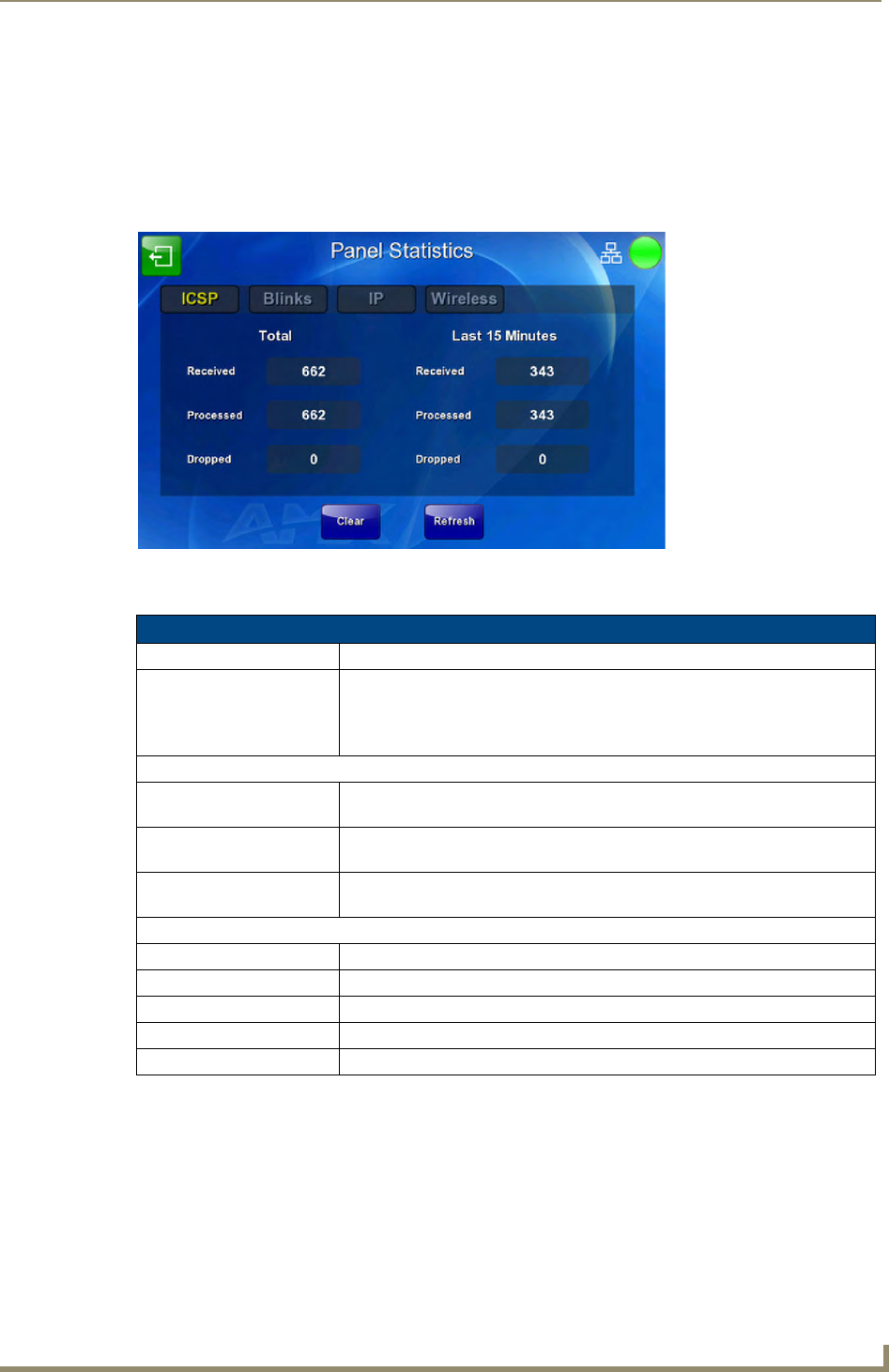
Protected Setup Pages
95
MVP-9000i Modero® Wireless Touch Panel with Intercom
Panel Statistics Page
The Panel Statistics page (FIG. 82) displays activity between the device and the network. The page contains
four tabs: ICSP, Blink, IP, and Wireless. in proportions of ICSP messages, blink messages, and Ethernet versus
wireless use.
Panel Statistics - ICSP
The ICSP tab collects the number of ICSP messages received by the device.
The features on this tab include:
FIG. 82 Panel Statistics - ICSP Tab
Panel Statistics - ICSP Tab
Back: Saves all changes and returns to the previous page.
Connection Status icon: The icon in the upper-right corner of each Protected Setup page provides a
constant visual indication of current connection status.
Note: a Lock appears on the icon if the panel is connected to a secured NetLinx
Master.
Total:
Received: Lists the number of ICSP messages received since the last time the page was
cleared or refreshed.
Processed: Lists the number of ICSP messages processed since the last time the page
was cleared or refreshed.
Dropped: Lists the number of ICSP messages dropped since the last time the page was
cleared or refreshed.
Last 15 minutes:
Received: Lists the number of ICSP messages received within the previous 15 minutes.
Processed: Lists the number of ICSP messages processed within the previous 15 minutes.
Dropped: Lists the number of ICSP messages dropped within the previous 15 minutes.
Clear: Clears all fields on the ICSP tab.
Refresh: Refreshes all data on the ICSP tab.
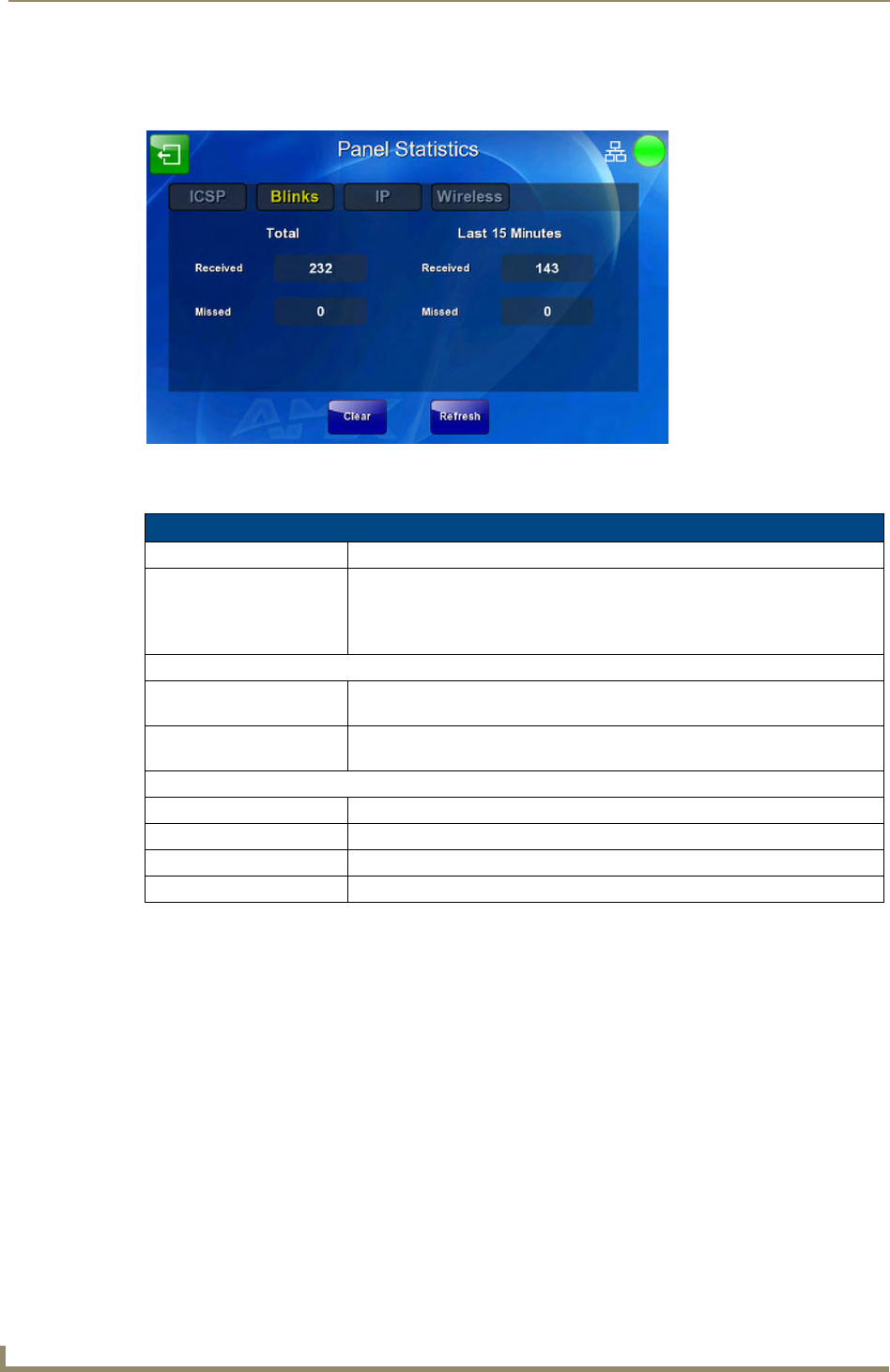
Protected Setup Pages
96 MVP-9000i Modero® Wireless Touch Panel with Intercom
Panel Statistics - Blinks Tab
The Blinks tab (FIG. 83) collects the number of blink messages received by the device.
Features on this tab include:
FIG. 83 Panel Statistics - Blinks Tab
Panel Statistics - Blinks Tab
Back: Saves all changes and returns to the previous page.
Connection Status icon: The icon in the upper-right corner of each Protected Setup page provides a
constant visual indication of current connection status.
Note: a Lock appears on the icon if the panel is connected to a secured NetLinx
Master.
Total:
Received: Lists the number of blink messages received since the last time the page was
cleared or refreshed.
Missed: Lists the number of blink messages missed since the last time the page was
cleared or refreshed.
Last 15 Minutes:
Received: Lists the number of blink messages missed within the last 15 minutes.
Missed: Lists the number of blink messages missed within the last 15 minutes.
Clear: Clears all fields on the Blinks tab.
Refresh: Refreshes all data on the Blinks tab.
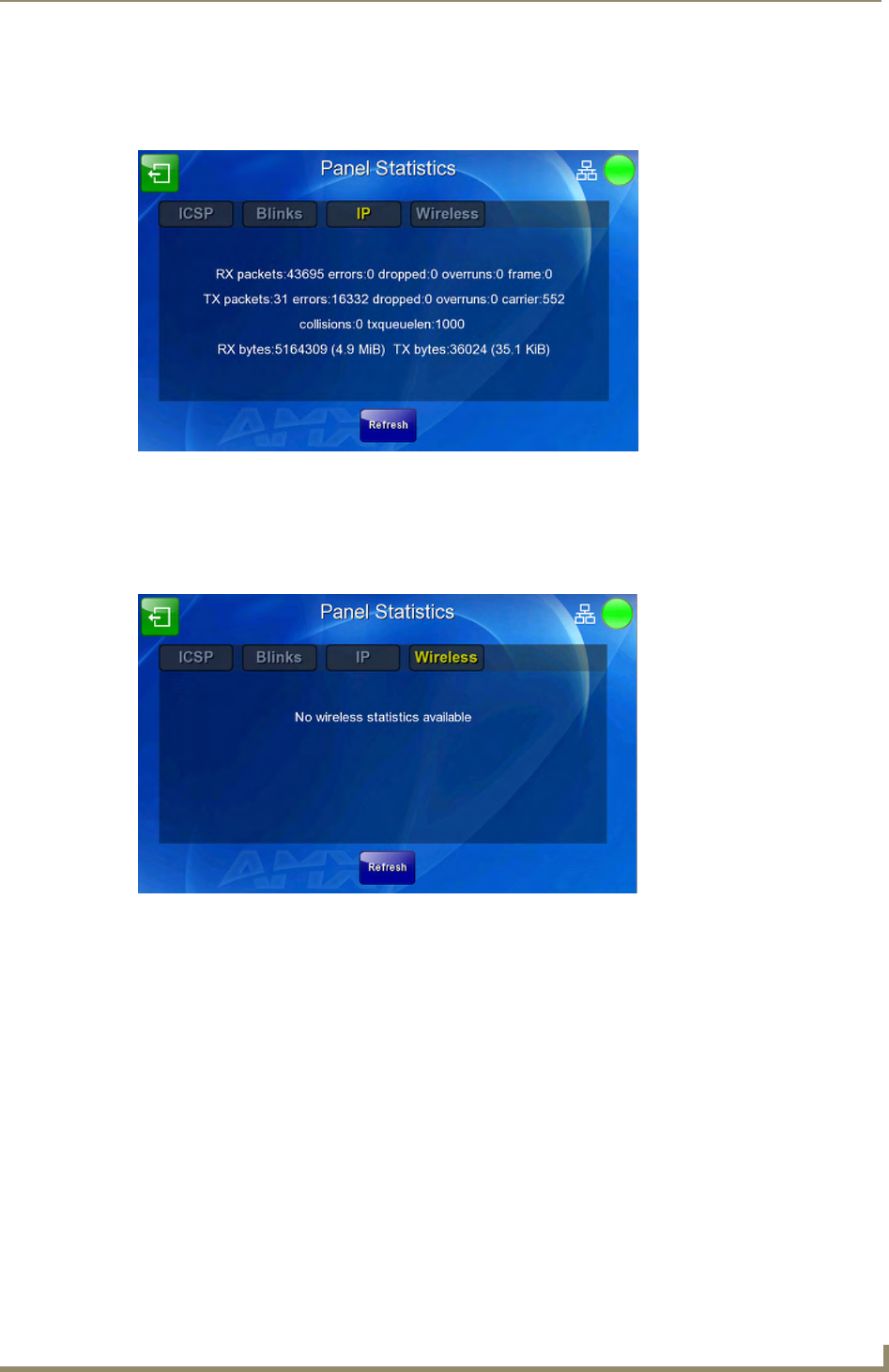
Protected Setup Pages
97
MVP-9000i Modero® Wireless Touch Panel with Intercom
Panel Statistics - IP Tab
The IP tab (FIG. 84) displays received and transmitted IP packets. Touch the Refresh button to return the
counters to their placement before the latest update.
Panel Statistics - Wireless Tab
The Wireless tab (FIG. 84) displays the MVP-9000i’s wireless access statistics, including the wireless mode,
the frequency used, and the latest used access point. Touch the Refresh button to return the counters to their
placement before the latest update.
FIG. 84 Panel Statistics - IP Tab
FIG. 85 Panel Statistics - Wireless Tab
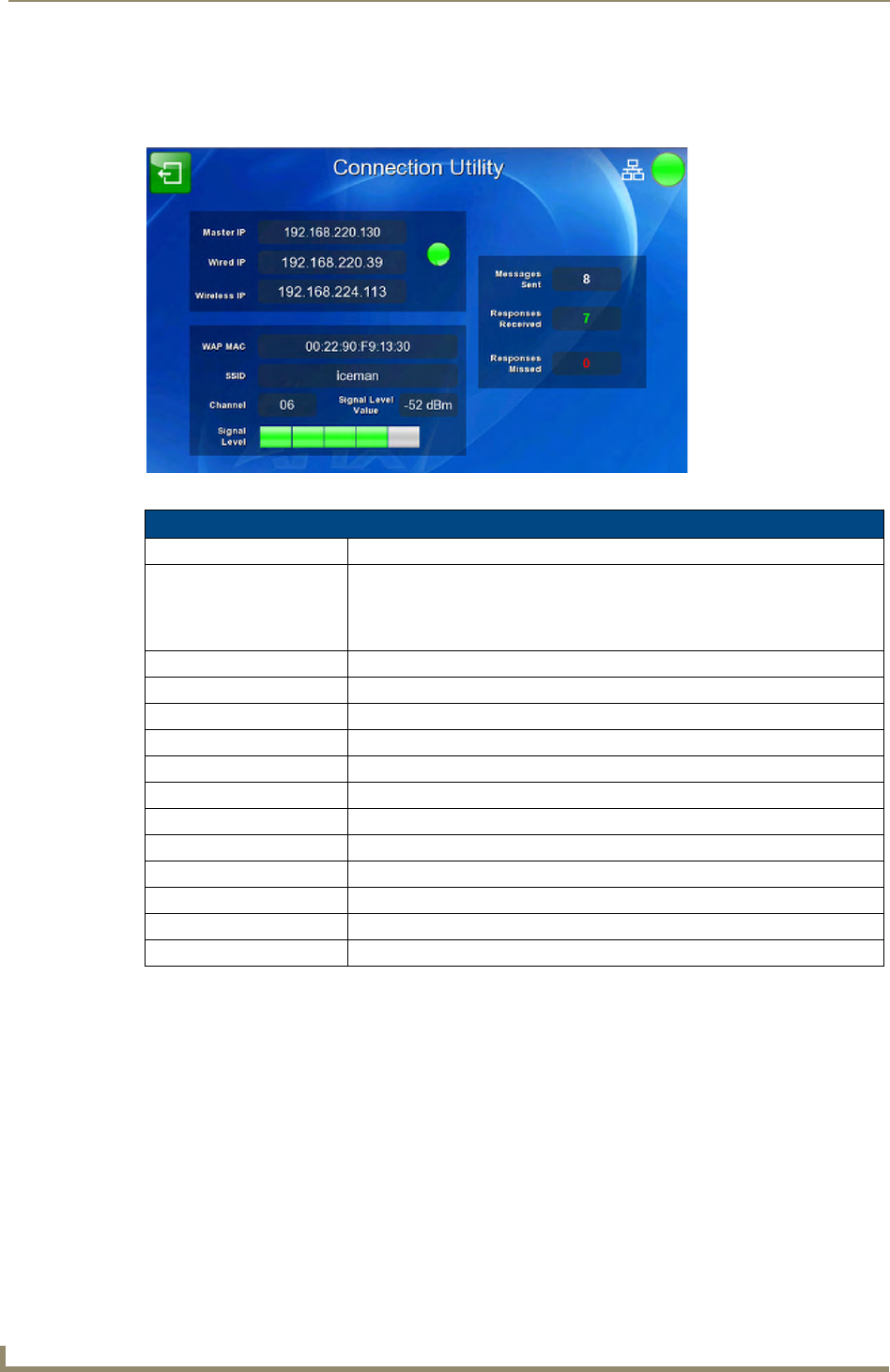
Protected Setup Pages
98 MVP-9000i Modero® Wireless Touch Panel with Intercom
Connection Utility Page
The Connection Utility page (FIG. 86) displays the current wired and wireless connection information,
including the latest link quality and signal strength information.
FIG. 86 Connection Utility Page
Connection Utility Page
Back: Saves all changes and returns to the previous page.
Connection Status icon: The icon in the upper-right corner of each Protected Setup page provides a
constant visual indication of current connection status.
Note: a Lock appears on the icon if the panel is connected to a secured NetLinx
Master.
Master IP: The IP address for the network’s Master.
Wired IP: The IP address used by the device for wired connections.
Wireless IP: The IP address used by the device for wireless connections.
WAP MAC: The WAP’s MAC address.
SSID: Displays the currently used SSID of the target WAP.
Channel: The channel being used for the current connection.
Link Quality: Displays the current quality of the target WAP link.
Signal Level Value: Displays the current value of the target WAP signal.
Signal Level: Displays the current strength of the target WAP signal.
Messages Sent: Lists the number of queries sent to the WAP.
Responses Received: Lists the number of responses received from the WAP.
Responses Missed: Lists the number of responses missed by the WAP.
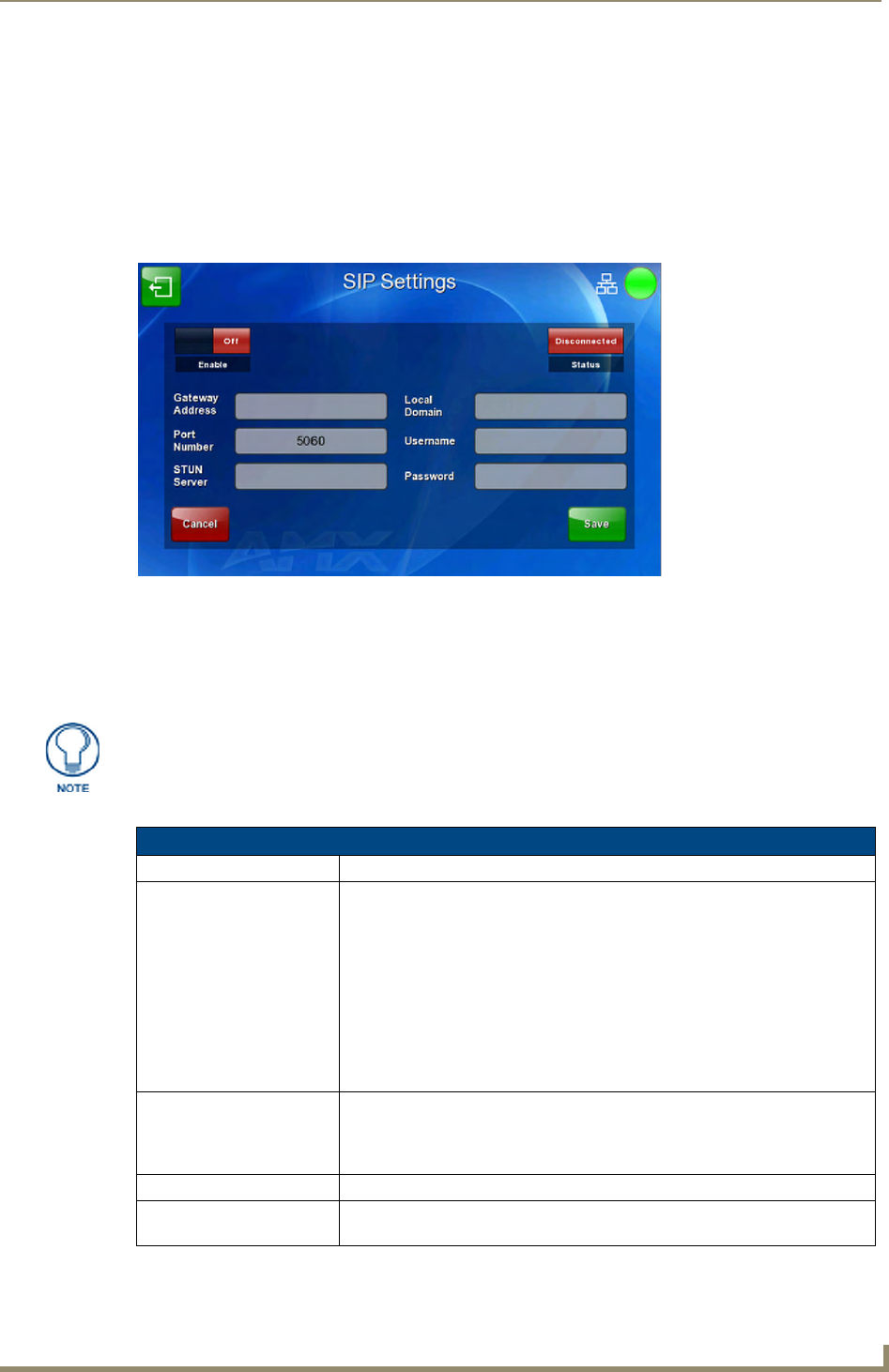
Protected Setup Pages
99
MVP-9000i Modero® Wireless Touch Panel with Intercom
SIP Settings Page
The options on the SIP Settings page (FIG. 87) enable you to establish network settings for using your touch
panel as an IP phone. With a CSG SIP Communications Gateway (FG2182-01, -02, -03), you can use your
touch panel to make and receive local, long distance, and international phone calls, and have access to phone
features like call waiting, caller ID, call forwarding, call queuing, and voice mail. Setting up your touch panel
as a telephone requires that you set it up as one in the CSG SIP Communications Gateway. Refer to the CSG
SIP Communications Gateway Operation/Reference Guide for information on setting up your touch panel to
work as a telephone.
You may need to load a Duet module to enable the touch panel to receive SIP calls. The Duet module translates
between the standard interface and the device protocol. It parses the buffer for responses from the device,
sends strings to control the device, and receives commands from the UI module or telnet sessions. Refer to the
documentation supplied with the Duet Module for more details.
Features on this page include:
FIG. 87 SIP Settings page
A sample UI module is provided in the module package. It is not intended to cover
every possible application, but can be expanded as needed by a dealer to meet the
requirements of a particular installation.
SIP Settings Page
Back: Saves all changes and returns to the previous page.
Connection Status icon: The icon in the upper-right corner of each Setup page shows online/offline state
of the panel to the master.
• Bright red - disconnected
• Bright green - connected. Blinks when a blink message is received to dark
green every 5 seconds for half a second then go back to bright green.
• Bright yellow - panel missed a blink message from the master. It will remain
yellow for 3 missed blink messages and then turn red. It will return to green
when a blink message is received.
Note: A lock appears on the icon if the panel is connected to a secured NetLinx
Master.
Enable: This option enables the SIP Stack on startup. If you disable this option, the
panel will not attempt to read the rest of the configuration and will not register
with a proxy server. However, point-to-point SIP will still be enabled allowing for
existing intercom functionality.
Status: This option displays whether you are connected to the proxy server.
Gateway Address: This option enables you to enter the IP address or DNS name of the proxy
server that you want to use to register.
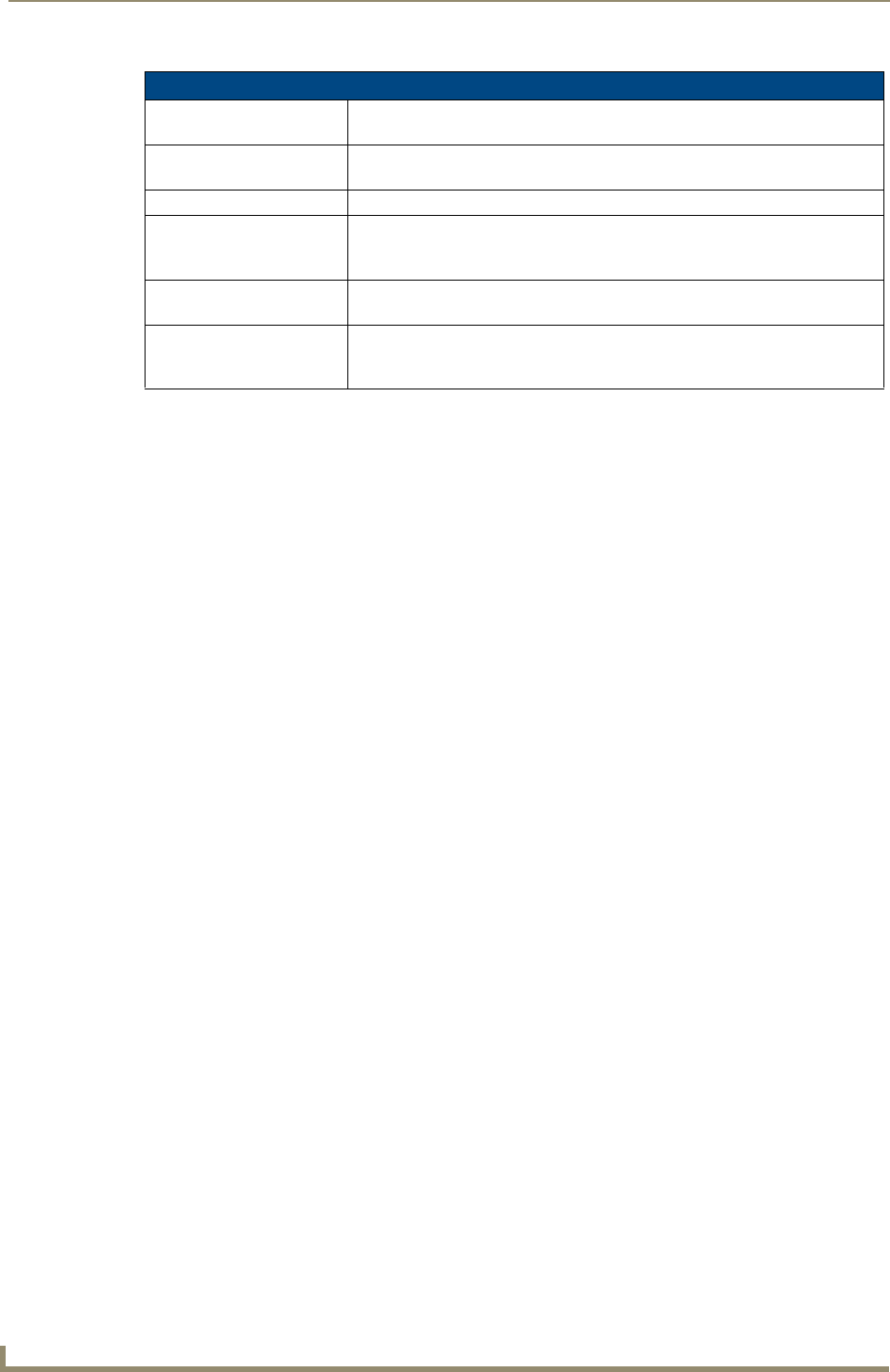
Protected Setup Pages
100 MVP-9000i Modero® Wireless Touch Panel with Intercom
SIP Settings Page (Cont.)
Port Number: The option displays the port you use to connect to the proxy server. The stan-
dard SIP port is 5060, but some providers use different ports.
STUN Address: This option enables you to enter the IP address or DNS name of the Simple
Traversal of UDP through NATs (STUN) server. This field is optional.
Local Domain: This is the realm used for authentication. This field is optional.
User Name: This option enables you to enter the user name used for authentication to the
proxy server. Normally, the user name is the same as the phone number
assigned to the extension you are using. This field is optional.
Password: This option enables you to enter the password for the user at the proxy server.
This field is optional.
Cancel/Save: Touch the Cancel button to return to the Protected Setup page without saving
any changes made on the SIP Settings page. Touch the Save button to save
the changes and return to the Protected Setup page.
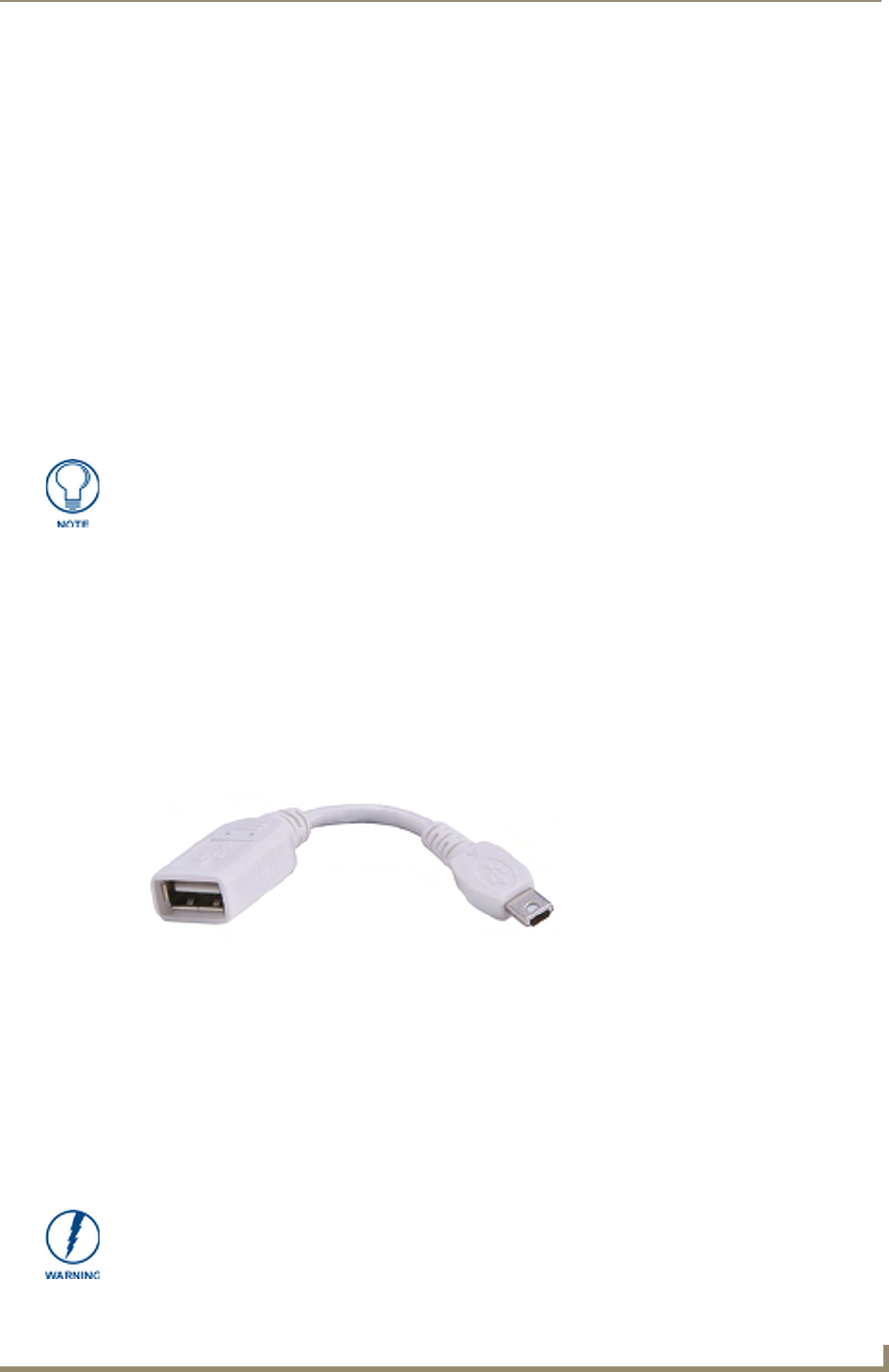
Upgrading Firmware
101
MVP-9000i Modero® Wireless Touch Panel with Intercom
Upgrading Firmware
Overview
For the purpose of panel downloads, the MVP-9000i’s download procedure is not compatible with other AMX
panel devices. This is due to the unique configuration of the device.
The first major change from other AMX devices is that the MVP-9000i uses dynamic Setup Pages for its
displays. Instead of requiring a separate Setup Page project built within TPDesign 4, the MVP-9000i uses only
a single set of Setup Pages for all of its supported resolutions.
To enable a single Setup Page project to support all resolutions, this requires including images for the largest
supported resolution with the Setup Page project and scaling the images to fit for lower resolutions. This
modification would apply to state-level bitmaps and chameleon images; previously, image scaling has only
applied to dynamic images.
These features require a separate G4SupportFiles installation to be posted for download independently of the
TPDesign4, NetLinx Studio, and Visual Architect applications.
The MVP-9000i uses a native RNDIS USB driver for USB-over-Ethernet communication. When the device is
connected to the downloading computer (see instructions below for more details), it creates a new LAN
connection, and the user will need to supply a static IP address for this to be enabled. To enter a static IP
address, the user must edit the properties of the TCP/IP interface of the connection itself. This driver is
included in the installation of the latest version of NetLinx Studio, available from www.amx.com.
Upgrading Firmware via USB stick
The MVP-9000i uses the CC-MINIUSB Mini USB to PC Cable Adapter (FG5967-20) for programming,
firmware updates, and touch panel file transfer between a PC and the target device (FIG. 88). If a programming
cable is not available, it may be purchased from www.amx.com. The Mini-USB port for the connector is
located on the left side of the device as viewed from the front.
To upgrade the firmware on the MVP-90001 to the latest version:
1. Download the latest MVP-9000i firmware from www.amx.com and save it to a USB stick.
2. Turn on the MVP-9000i and allow it to boot up. For best results, connect the panel to its power source or
place it in a Table or Wall Docking Station.
3. Connect the male plug of CC-MINIUSB Cable Adapter to the mini-USB port on the MVP-90001, and
then connect the USB stick to the female USB port.
4. The MVP-9000i will automatically search the USB stick for the correct KIT file, and automatically
uploads the firmware.
Programming the MVP-9000i requires the use of the latest versions of NetLinx Studio
and TPDesign 4, both available from www.amx.com.
FIG. 88 CC-MINIUSB MiniUSB to PC Cable Adapter
If the MVP-9000i battery is at less than a 30 percent charge, the firmware upload will
automatically fail. For best results, before uploading the firmware, connect the panel
to its power source or place it in a Table or Wall Docking Station.
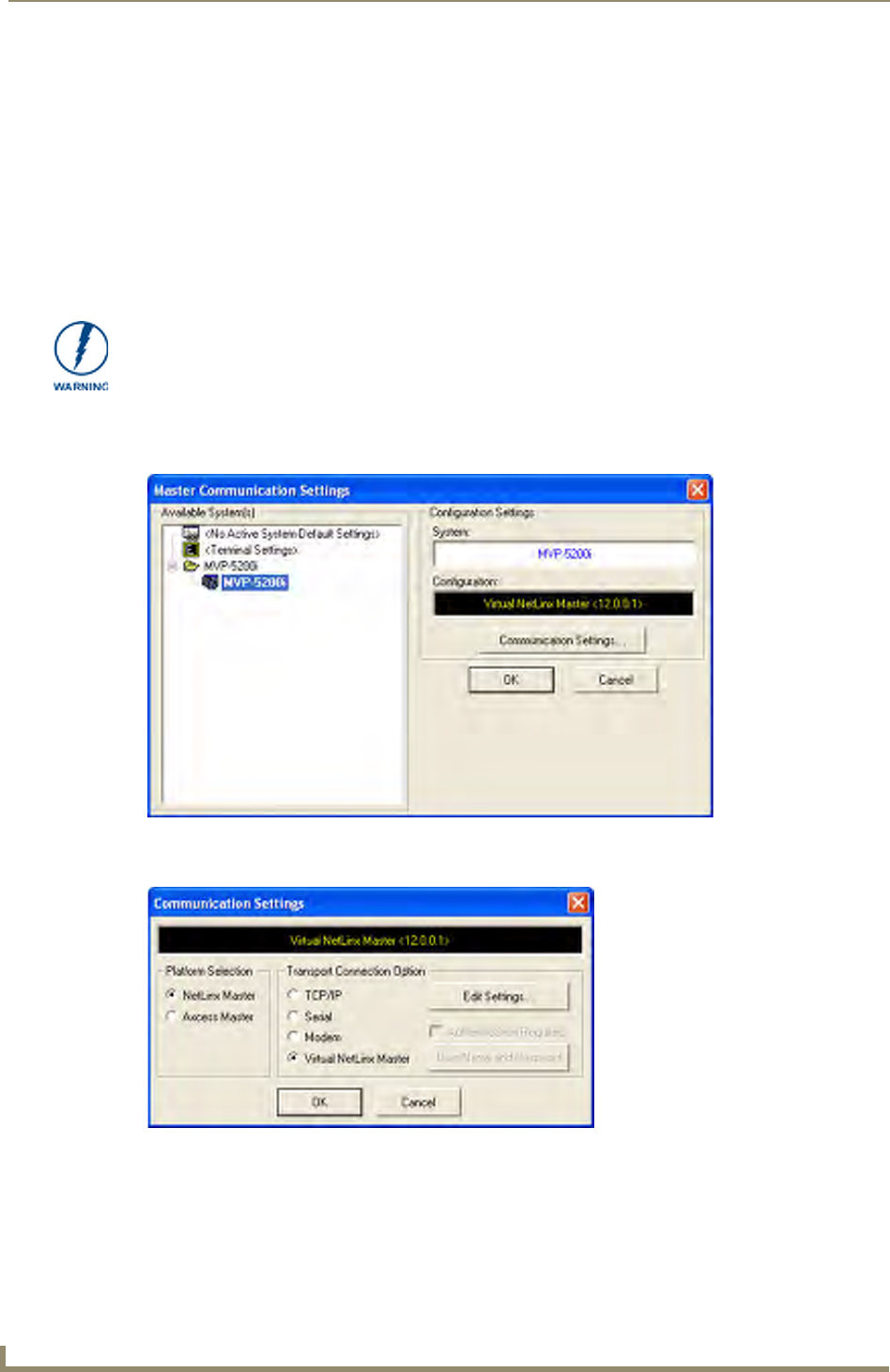
Upgrading Firmware
102 MVP-9000i Modero® Wireless Touch Panel with Intercom
Upgrading Firmware Via NetLinx Studio
The MVP-9000i uses a 5-pin CC-USB (Type A) to Mini-B 5-Wire programming cable (FG10-5965) for
programming, firmware updates, and touch panel file transfer between a PC and the target device. If a
programming cable is not available, it may be purchased from www.amx.com. The Mini-USB port for the
connector is located on the left side of the device as viewed from the front.
Before beginning with this section, verify that the device is powered and the Type-A end of the USB connector
is inserted and secure in the PC’s USB port . The panel must be powered On before connecting the mini-
USB connector to the panel. To guarantee that the upgrade is not interrupted by power loss, connecting the
device to a power source, such as inserting it into a Table Docking Station, before beginning the upgrade is
highly recommended.
1. Launch NetLinx Studio 2.x and select Settings > Master Communication Settings from the Main menu
to open the Master Communication Settings dialog (FIG. 89). If this is the first time the device needs to
be configured, refer to the Configuring Modero Firmware via the USB Port section on page 186.
2. Click the Communications Settings... button to open the Communications Settings dialog box (FIG. 90).
3. Click on the NetLinx Master radio button from the Platform Selection section.
4. Click on the Virtual Master radio box from the Transport Connection Option section to configure the PC
to communicate directly with a panel. Everything else, such as the Authentication, is greyed-out because
this connection is not going through the Master’s UI.
Establishing a USB connection between the PC and the panel, prior to installing the
USB Driver, will cause a failure in the USB driver installation.
FIG. 89 Master Communications Settings dialog box
FIG. 90 Communications Settings dialog box
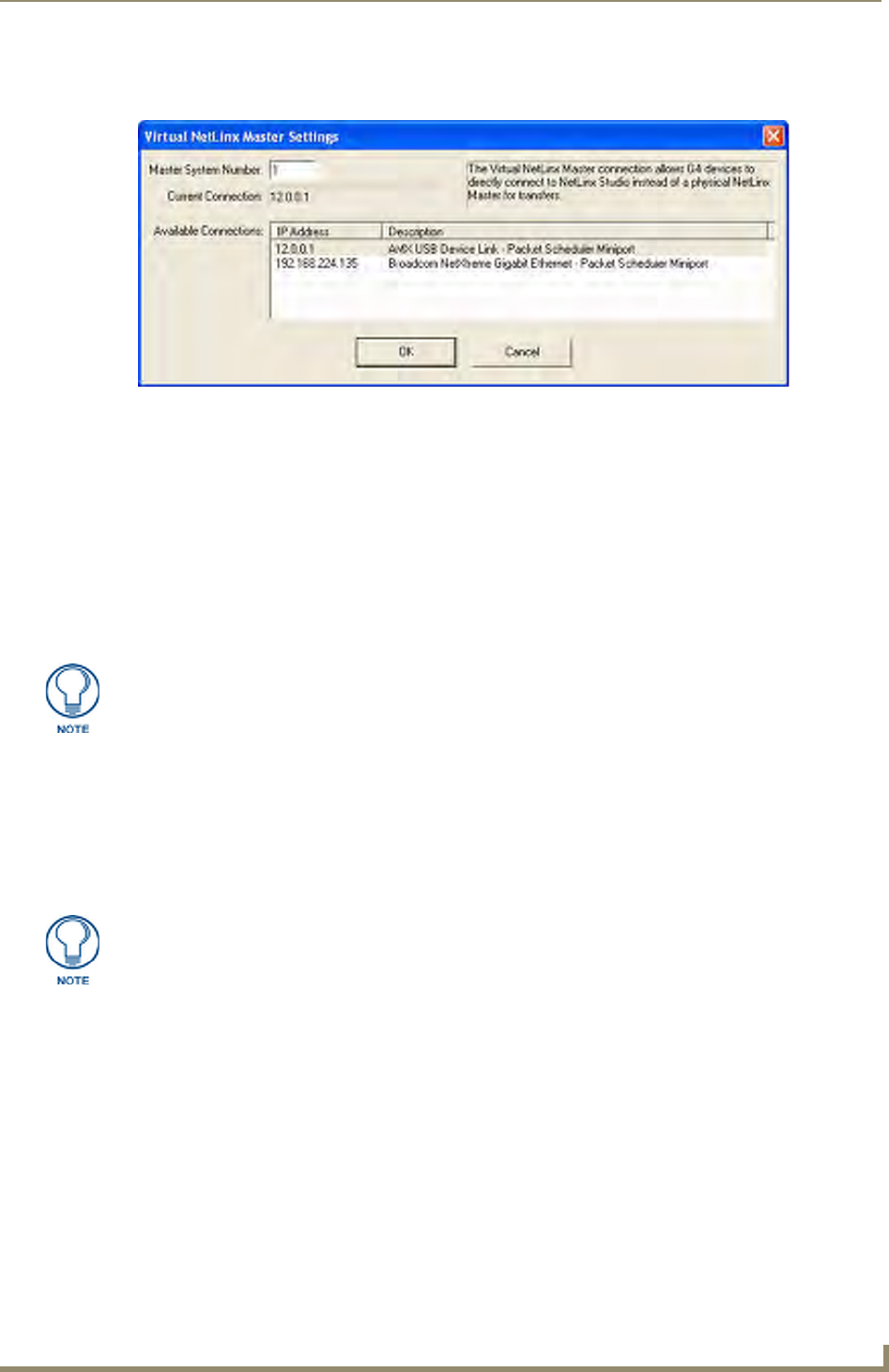
Upgrading Firmware
103
MVP-9000i Modero® Wireless Touch Panel with Intercom
5. Click the Edit Settings button on the Communications Settings dialog to open the Virtual NetLinx Master
Settings dialog (FIG. 91).
6. Within this dialog, enter the Master System number. The default is 1.
7. In the Available Connections section, click on the IP address for the touch panel to select it.
8. In the Virtual NetLinx Master Settings dialog box, click OK to close the box.
9. In the Communications Settings dialog box, click OK to close the box.
10. In the Master Communications Settings dialog box, click OK to save your settings and return to the main
NetLinx Studio application.
11. Click the OnLine Tree tab in the Workspace window to view the devices on the Virtual System. The
default System value is 1.
12. Right-click on the Empty Device Tree/System entry and select Refresh System to re-populate the list.
13. The OnLine Tree should now display the connection to the device. The Connection Status Icon on the
device may take up to five seconds to register the connection.
Step 3: Confirm and Upgrade the firmware via the USB port
Use the CC-USB Type-A to Mini-B 5-wire programming cable to provide communication between the mini-
USB Program port on the touch panel and the PC. This method of communication is used to transfer firmware
Kit files and TPD4 touch panel files.
1. Verify that the direct USB connection (Type-A on the panel to mini-USB on the panel) is configured
properly, using the steps outlined in the previous two sections.
2. With the panel already configured for USB communication and the Virtual Master setup within NetLinx
Studio, refresh the Online Tree pane.
3. After the Communication Verification dialog window verifies active communication between the Virtual
Master and the panel, click the OnLine Tree tab in the Workspace window (FIG. 92) to view the devices
on the Virtual System. The default System value is 1.
4. Right-click on the System entry (FIG. 92) and select Refresh System to re-populate the list. Verify the
panel appears in the OnLine Tree tab of the Workspace window.
FIG. 91 Virtual NetLinx Master Settings
The panel will not appear as a device below the virtual system number, in the Online
Tree tab, until both the system number used in step 14 for the Virtual NetLinx Master
is entered into the Master Connection section of the System Settings page and the
panel is restarted.
A mini-USB connection is only detected after it is installed onto an active panel.
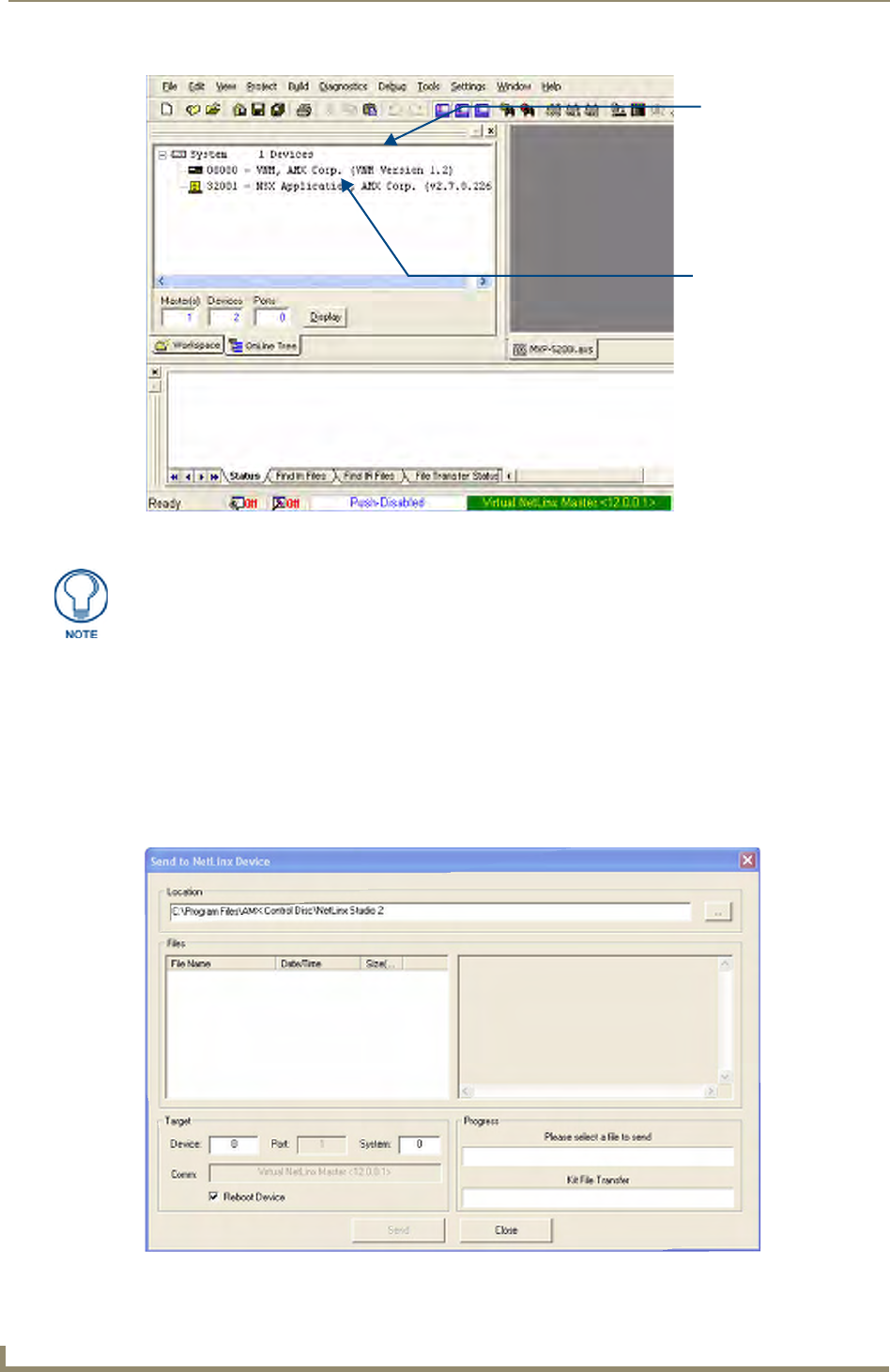
Upgrading Firmware
104 MVP-9000i Modero® Wireless Touch Panel with Intercom
5. If the panel firmware version is not the latest available; locate the latest firmware file from the
www.amx.com > Tech Center > Firmware Files > Modero Panels section of the website.
6. Click on the desired Kit file link and after accepting the Licensing Agreement, verify download of the
Modero Kit file to a known location.
7. Select Tools > Firmware Transfers > Send to NetLinx Device from the main menu to open the Send to
NetLinx Device dialog (FIG. 93). Verify that the panel’s System and Device number values match those
values listed within the System folder in the OnLine Tree tab of the Workspace window.
FIG. 92 NetLinx Workspace window (showing panel connection via a Virtual NetLinx Master)
Virtual Master firmware
version and device number
MVP panel firmware version
and device number
The panel-specific firmware is shown on the right of the listed panel.
Download the latest firmware file from www.amx.com and then save the Kit file to
your computer. Note that each Kit file is intended for download to its corresponding
panel. In some cases, several Kit files may be included in a .zip file; extract the .zip
file to access the required Kit file.
FIG. 93 Send to NetLinx Device dialog window
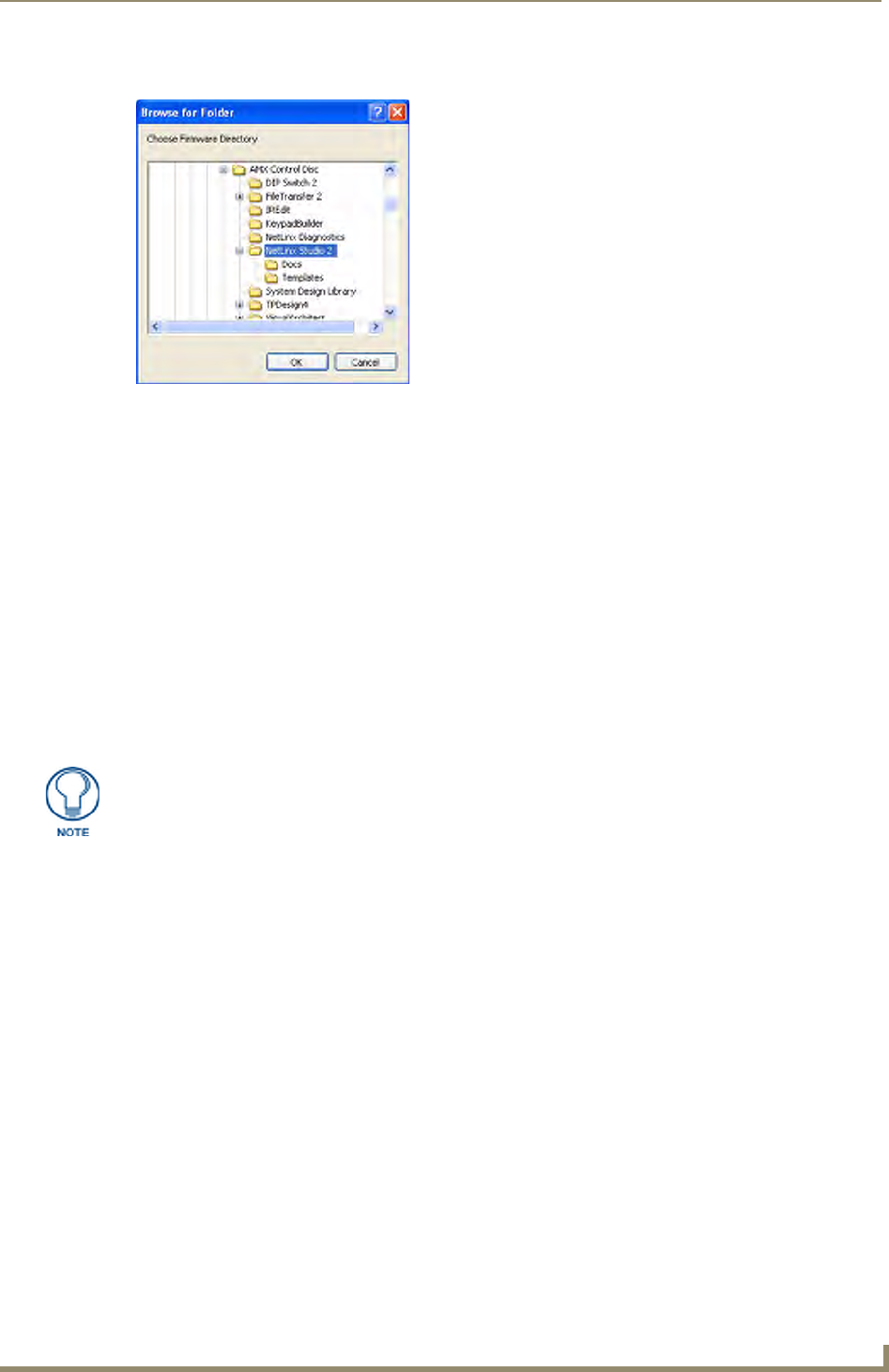
Upgrading Firmware
105
MVP-9000i Modero® Wireless Touch Panel with Intercom
8. Select the appropriate Kit file from within the Browse for Folder window (FIG. 94).
9. Select the panel’s Kit file from the Files section.
10. Enter the Device value associated with the panel and the System number associated with the Master
(listed in the OnLine Tree tab of the Workspace window). The Port field is greyed-out.
11. Click the Reboot Device checkbox if it is not already checked. This causes the touch panel to reboot after
the firmware update process is complete.
12. Click Send to begin the transfer. The file transfer progress is indicated on the bottom-right of the dialog.
13. After the file transfer is complete, the panel will automatically reboot. As the panel is rebooting,
temporarily unplug the USB connector on the panel until the panel has completely restarted.
14. Once the first panel page has been displayed, reconnect the USB connector to the panel.
15. Right-click the associated System number and select Refresh System. This causes a refresh of all project
systems, establishes a new connection to the Master, and populates the System list with devices on your
particular system.
16. Confirm that the panel has been properly updated to the correct firmware version.
FIG. 94 Browse for Folder window
Verify you have downloaded the latest firmware file from www.amx.com and then
save the Kit file to your computer.
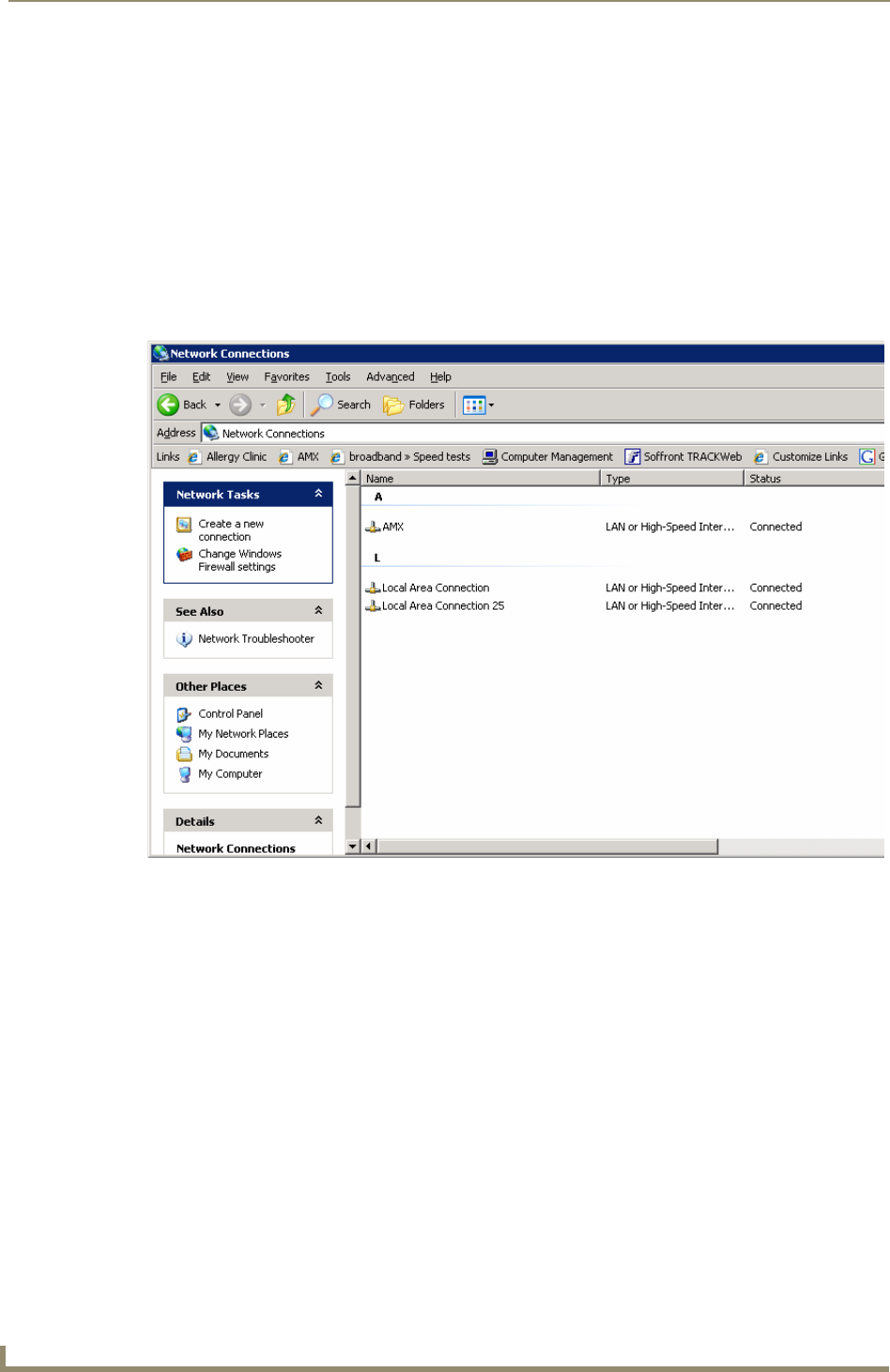
Upgrading Firmware
106 MVP-9000i Modero® Wireless Touch Panel with Intercom
A Special Note for Network Interface Connections
Due to any USB connection to your PC being made through a Network Interface Connection (NIC), Windows
will automatically make any new NIC connection the Primary connection. If this happens, the USB address of
12.0.0.x will show up across the PC’s network switches as the PC’s source address. In some cases, network
administrators will notice the NIC connection and reconfigure any PC that has connected to the MVP-9000i.
Business, college, and government installations are the type of installations that would be most affected, and
most home installations would not be affected.
To prevent the NIC connection from becoming the primary connection:
1. From the Windows Start menu, select Settings > Control Panel to open the Control Panel window.
2. In the Control Panel window, click on the Network Connections icon to open the Network Connections
window (FIG. 95)
FIG. 95 Network Connections window
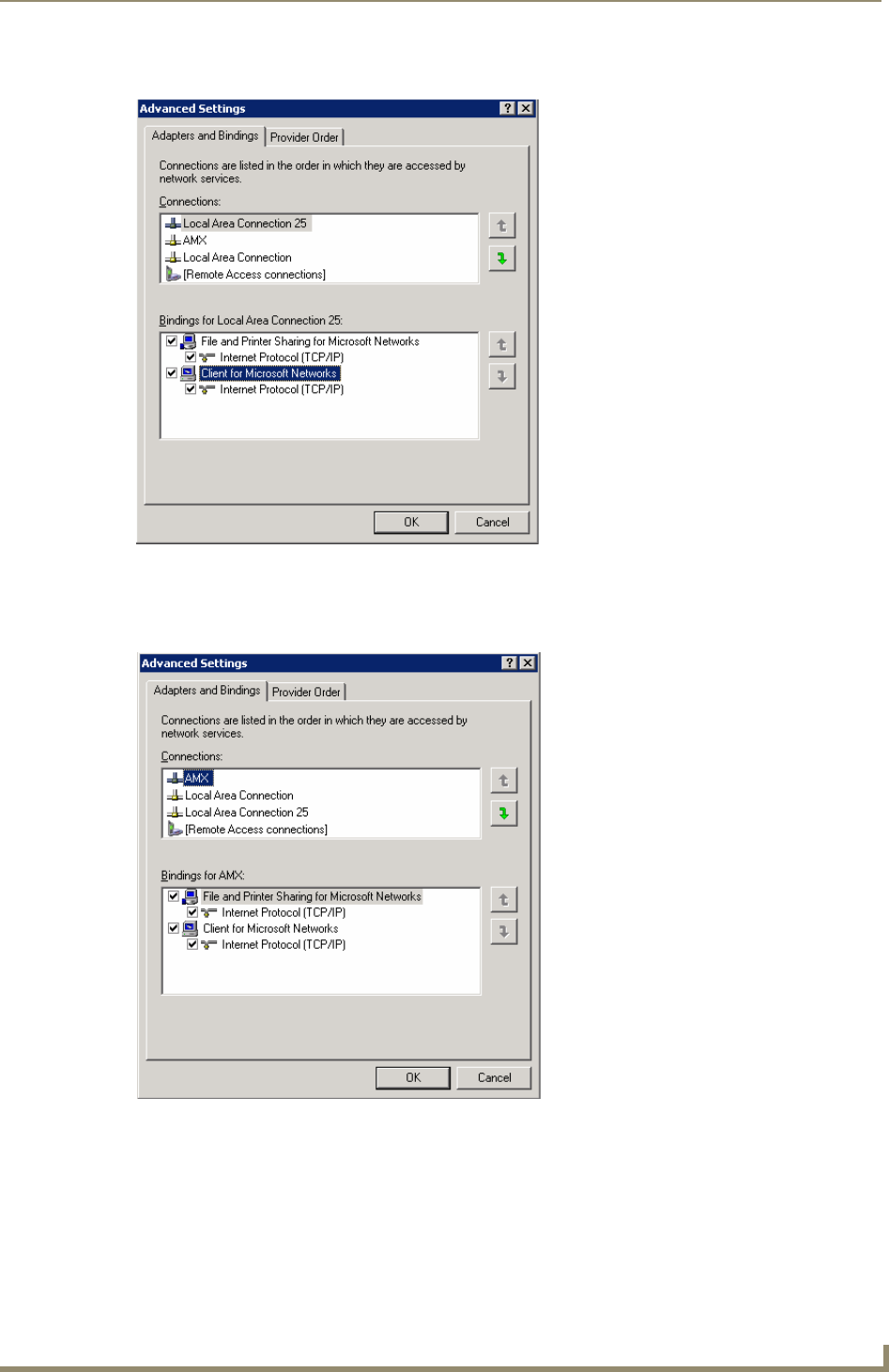
Upgrading Firmware
107
MVP-9000i Modero® Wireless Touch Panel with Intercom
3. From the Advanced menu, select Advanced Settings... to open the Advanced Settings window (FIG. 96).
4. Under the Adapters And Bindings tab, the user needs to make sure the Local Area Connection is not at the
top of the Connections list. If it is at the top of the list (FIG. 96), select it and use the down arrow to the
right of the list to move it to the bottom of the list (FIG. 97).
5. In the lower Bindings for Local Area Connection field, unselect ALL bindings by clicking on the
checkboxes by each binding to remove the checks from each box (FIG. 98).
FIG. 96 Advanced Settings window
FIG. 97 Moving the Local Area Connection
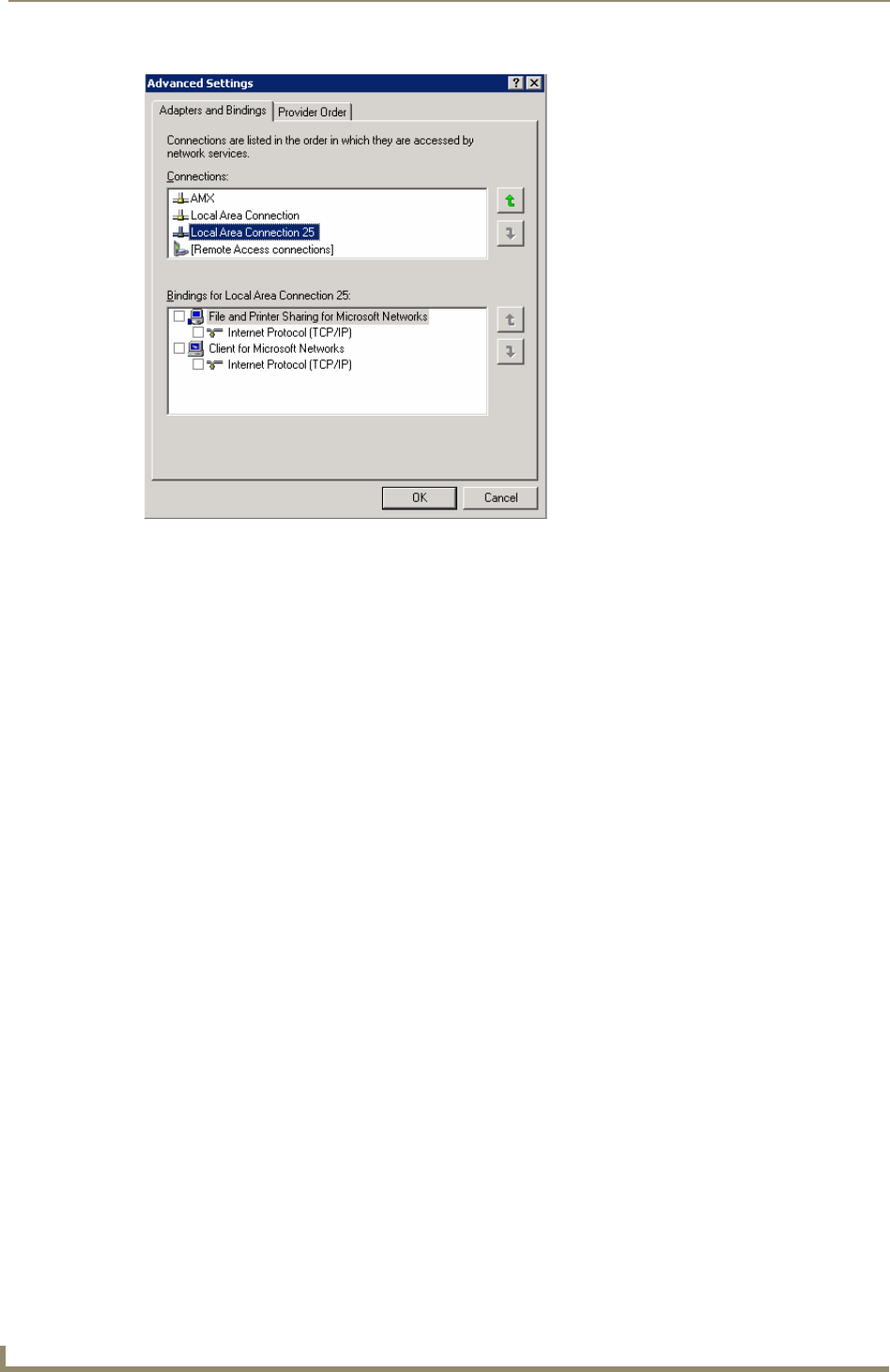
Upgrading Firmware
108 MVP-9000i Modero® Wireless Touch Panel with Intercom
6. When finished, click OK to close the Advanced Settings window and save all changes.
FIG. 98 Bindings for Local area list detail
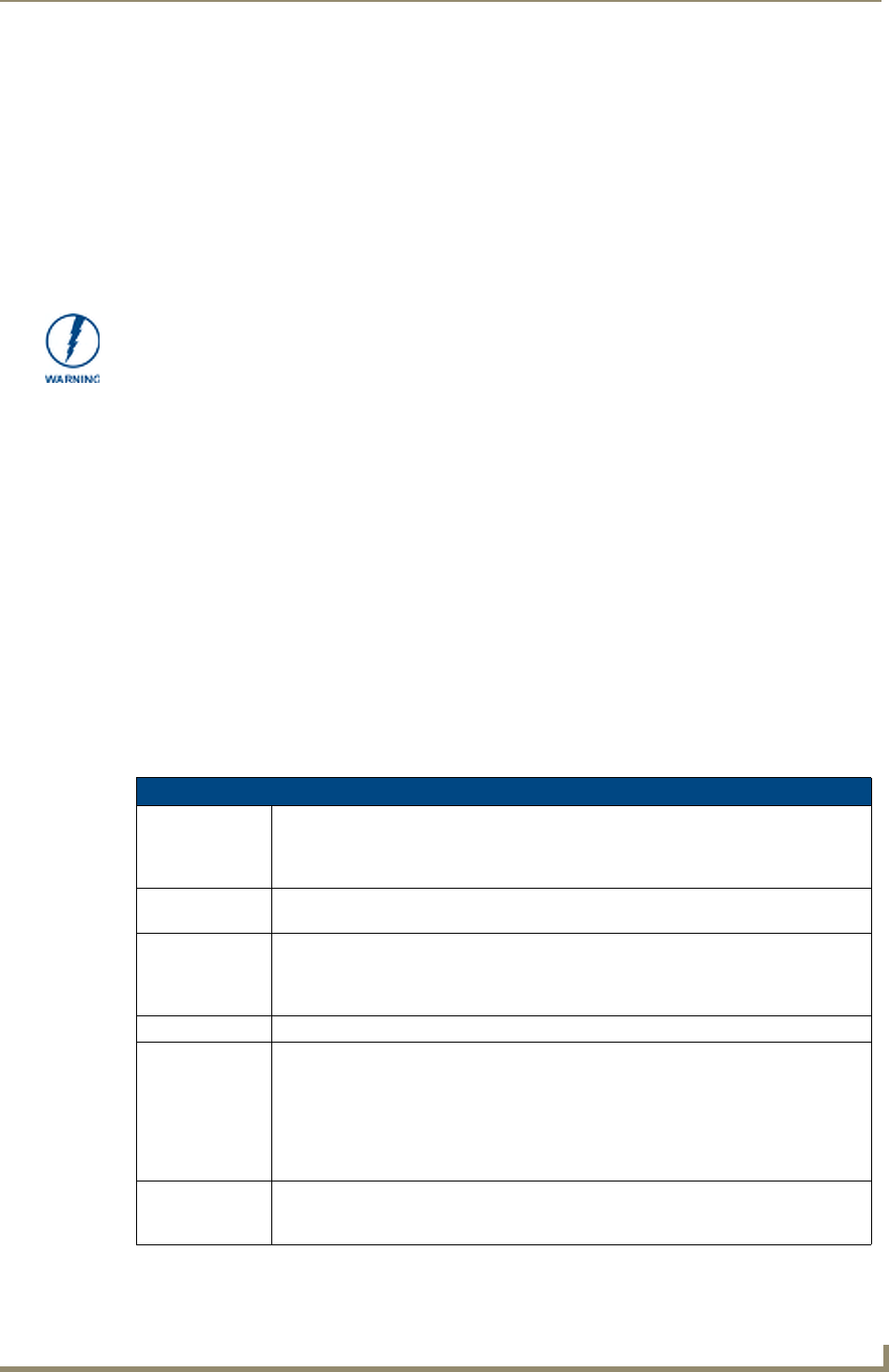
Programming
109
MVP-9000i Modero® Wireless Touch Panel with Intercom
Programming
Overview
You can program the MVP-9000i, using the commands in this section, to perform a wide variety of operations
using Send_Commands and variable text commands.
A device must first be defined in the NetLinx programming language with values for the Device: Port:
System (in all programming examples - Panel is used in place of these values and represents all Modero
panels).
Animated Transitions
Animated transitions are used to add motion and effects to the transition from one page to another on a panel.
With existing panel firmware, page flip transitions occur with the new page immediately drawing over the
existing page on the screen. With animated transitions, the old page is moved, faded, or overdrawn from the
screen while the new page is drawn. These operations use the OpenGL hardware accelerator to ensure smooth
transitions.
Current panel firmware also supports animated buttons and popup page effects. This functionality is
unchanged.
In all cases, once the transition is triggered, the old page is frozen. For example, if the old page had an
animated button, the motion on that button would stop as soon as the transition is triggered. If there is motion
on the new page such as an animated button or even a popup effect, this motion will operate even while the
overall page itself is in motion as part of the transition.
Seven different classes of transitions are supported. Each transition class is described below. All of the
transition classes, with the exception of Page Curl, are commanded transitions. Once the transition is triggered,
it proceeds to completion. Page Curl can be interrupted and directed by the person touching the LCD as
described below.
Verify you are using the latest NetLinx Master and Modero firmware, as well as the
latest version of NetLinx Studio and TPD4.
Transition Classes
Slide The current page slides off of the screen and the new page slides in until it completely
covers the screen and stops. There is no gap between pages, so if the page
backgrounds match, this effect can give the appearance of moving around on a canvas
that is larger than the physical screen size.
Slide with bounce This is the same as a slide transition, but with a bounce effect added when the new page
reaches the edge of the screen across from where it originated.
Black glass The existing page appears to move away from the viewer and off to the side. As soon as
it is completely off the screen, the new page moves in and toward the viewer from the
opposite edge of the screen. Both the old and new pages have a reflection on the bottom
that makes it appear that the page is sliding along black reflective glass.
Fade The current page fades out while the new page fades in.
Page curl The existing page appears to be peeled away like a sheet of paper, revealing the new
page underneath. The new page has a shadow effect, and a faint reversed impression of
the old page can be seen through the back of the paper being flipped. This transition can
be interrupted by the user by holding a finger on the LCD and moving it around. The
corner of the paper will follow the user's finger until released, causing the transition to
proceed to completion. For the best effect, the button that triggers the page curl effect
should be placed near the corner of the screen from which the page curl will originate.
Door with fade The new page moves over the existing page like a door with a hinge at the edge of the
LCD. In addition, the new page is semi-transparent, allowing the old page to be seen
through until the transition is finished, at which point the old page has faded away.
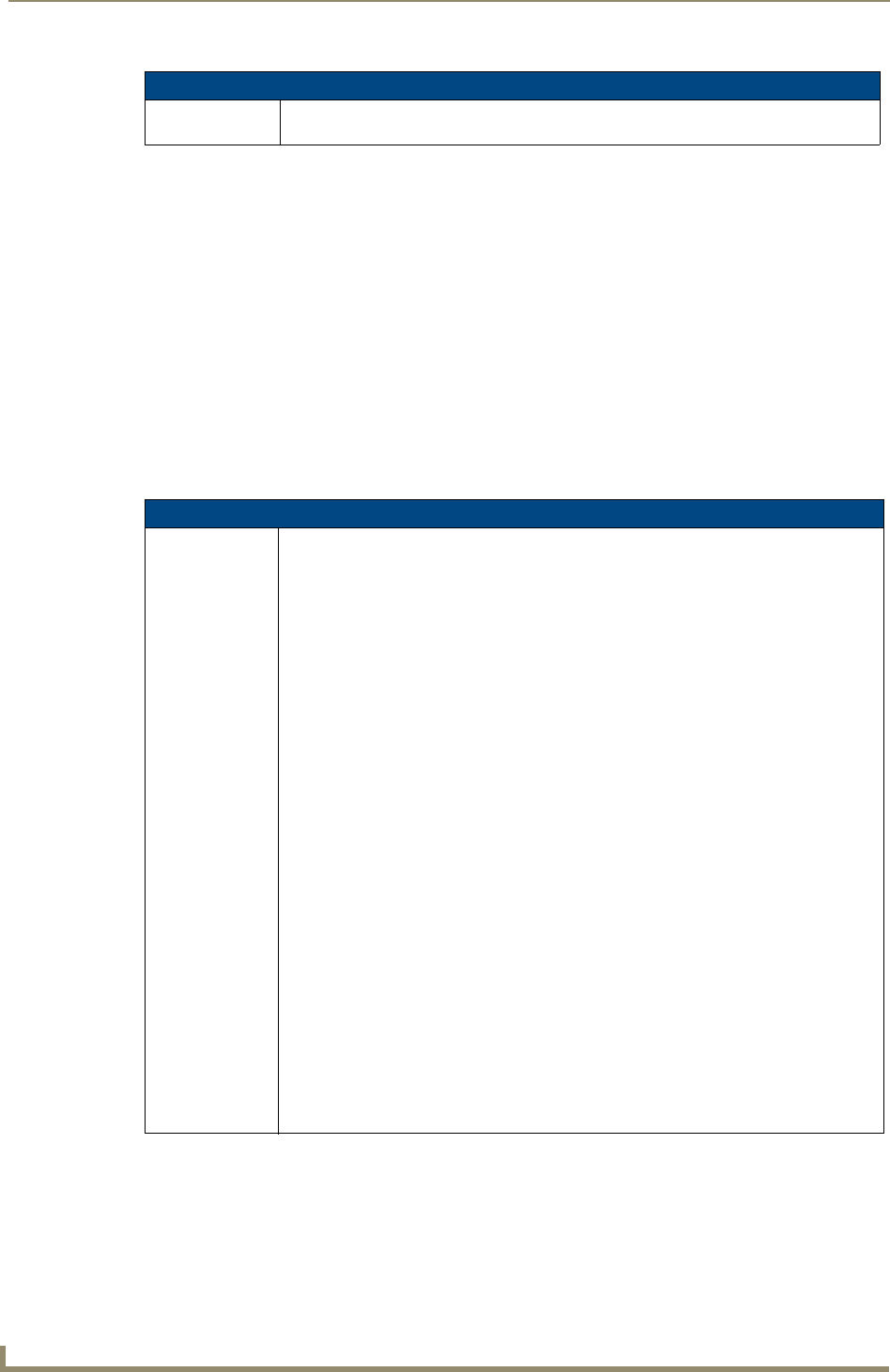
Programming
110 MVP-9000i Modero® Wireless Touch Panel with Intercom
The origin of the transition is the point on the LCD where the motion originates. In most cases, these locations
are the top, bottom, left and right of the screen. For example, a slide transition with a left origin will appear to
slide in from the left towards the right of the screen.
Slide, slide with bounce, door with fade and center door with fade can originate from the top, bottom, left and
right sides of the screen. Black glass can originate from the left or right. Fade does not need an origin since the
entire screen fades together. Page curl originates from the four corners of the screen: upper left, lower left,
upper right and lower right.
The transition time is the amount of time required for the transition to operate from start to finish. This value
can be specified from 0.3 seconds to 3.0 seconds in tenths of a second. If not specified, the default is 1.5
seconds.
Transition times are based on real world clock time and do not vary based on the speed of the processor or the
frame rate at which the display system is running.
Since the transitions require OpenGL hardware acceleration, they are not seen by the user on a VNC
connection. When a transition is triggered, the user will see a normal page flip to the new page on the VNC
connection, while the animated transition occurs as expected on the panel.
Transition Classes (Cont.)
Center door with
fade
This transition operates as above, except that the hinge point is at the center of the LCD
rather than the edge.
Transition Commands
^AFP
Flips to a page
with the specified
page name using
an animated
transition.
Flips to a page with the specified page name using an animated transition. If the page is
active, do not redraw the current page. If the page name is blank, flips to the previous
page.
Syntax: "'^AFP-<page name>,<animation>,<origin>,<time>'"
Animation is one of the following strings: slide, sldBounce, blkGlass, fade, pgCurl, door-
Fade, cntrDrFade
If animation is blank or invalid, the page flip will occur without any animated transition
occurring.
Origin is a number representing one of the following values for where
the animated transition originates on the screen:
1 - center (currently unused)
2 - top
3 - bottom
4 - left
5 - right
6 - lower left
7 - lower right
8 - upper left
9 - upper right
If the origin is blank or invalid, the default is 5 (right).
Time is the transition time in tenths of a second which can vary from 3 (0.3 seconds) to 30
(3.0 seconds). Values above or below these values will be clamped. If the time is blank,
then the default is 1.5 seconds.
Example:
"'^AFP-MAIN,slide,5,10'"
Will transition to a page named MAIN using a slide effect from the right to the left and
taking 1 second to complete.
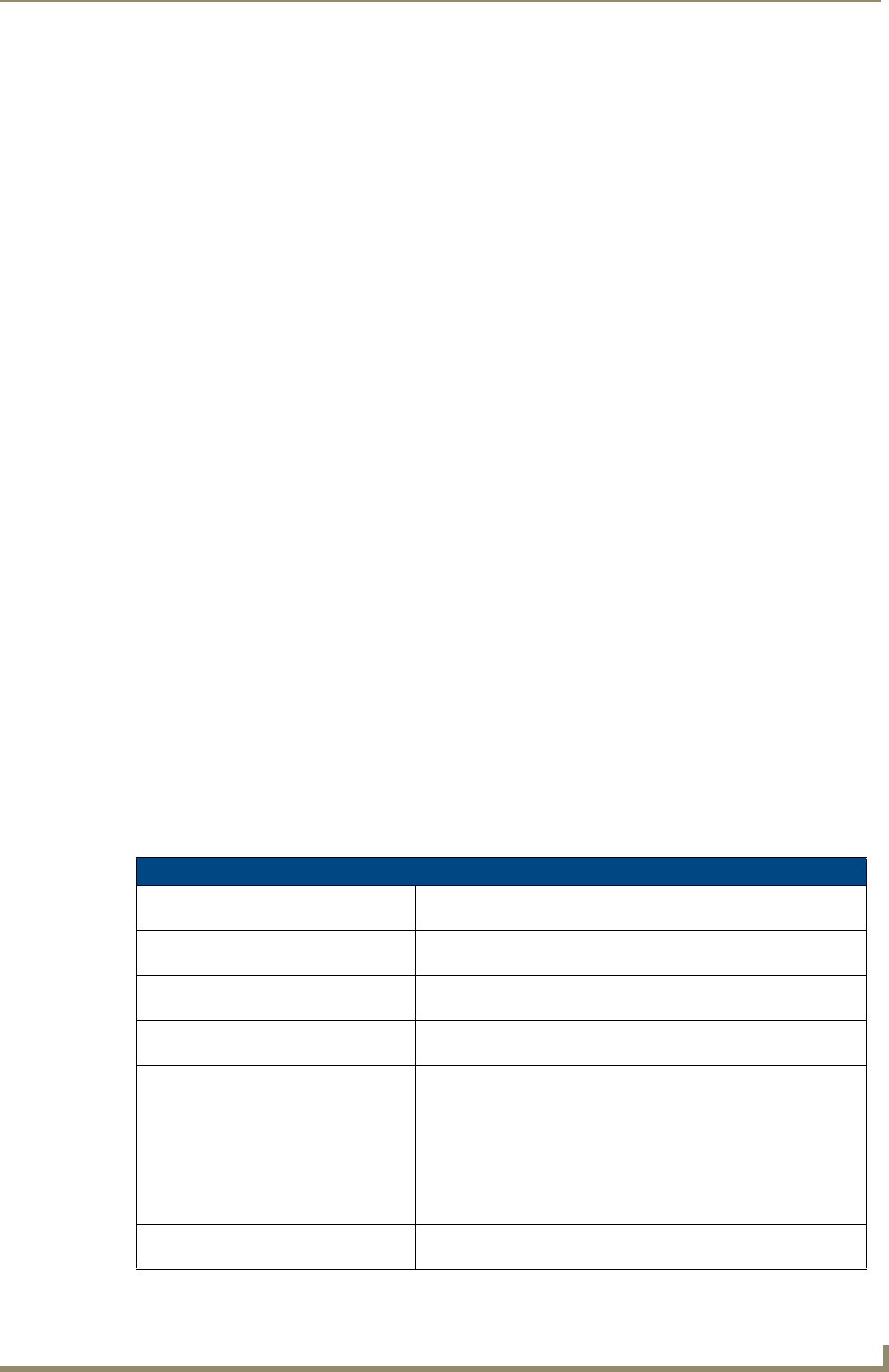
Programming
111
MVP-9000i Modero® Wireless Touch Panel with Intercom
Touch Gesture Recognition
Gesturing refers to the act of moving a finger or stylus across the overlay and having the panel recognize and
process this motion as a gesture.
Once a gesture is detected, it is processed as another external button on the panel. This enables the user to
design pages that translate gesture operations into any functionality available to external buttons. In addition, a
gesture velocity is calculated and transmitted to the master along with the gesture type itself in a custom event
message. Nothing will be processed if the external button associated with this gesture has no page flip
operations programmed, is disabled, or has no values programmed for address, channel, level, string output or
command output. The custom event, however, is always transmitted.
The following seven gesture types are supported:
1. Swipe up
2. Swipe down
3. Swipe right
4. Swipe left
5. Clockwise circle
6. Counter-clockwise circle
7. Double-Tap
Gesture Velocity
A gesture “velocity” is calculated to represent the speed of the gesture. This is done by measuring the time
from when the user first presses the screen until they release. The following simplified velocities are supported
and transferred to the master in the custom event message:
1. Fast
2. Normal
3. Slow
A precise velocity is sent in the custom event message which represents the velocity in terms of pixels per
second for slides and circles. For a double tap, this value is the total time in milliseconds from the first press to
the second release.
Gesture Prioritization
It is important to prioritize the operation of the presses, moves and releases of the user to avoid confusion over
what the user intended. The following process is used to determine what the user meant whenever a gesture
operation is defined globally or for this page.
Gesture Prioritization
The user presses outside of a button or
slider and moves before releasing.
The firmware will always try to recognize a gesture as long as the
user moves at least 20 pixels before the release occurs.
The user presses inside of a slider and
moves before releasing.
This will always be processed as a slider operation and no attempt
will be made to recognize a gesture.
The user presses inside of a joystick
button and moves before releasing.
This will always be processed as a joystick operation and no
attempt will be made to recognize a gesture.
The user moves a movable popup page. This will always be processed as a popup page move and not a
gesture.
The user presses on a button and then
moves.
In this case, the press will not be sent for the first 0.15 second. If
the user has moved at least 60 pixels by this time, then a button
press/release will not be processed, but this will be processed as a
gesture. At 0.15 second, the button press is processed and once
the user releases, the release is processed and no gesture
recognition is attempted. To be clear, it is not necessary for the
user to move off of a button to be considered a gesture, but to
move at least 60 pixels in that first 0.15 of a second.
The user double taps on a button or
slider.
This will not be recognized as a gesture. This would be considered
two quick press/release operations on the button or slider.
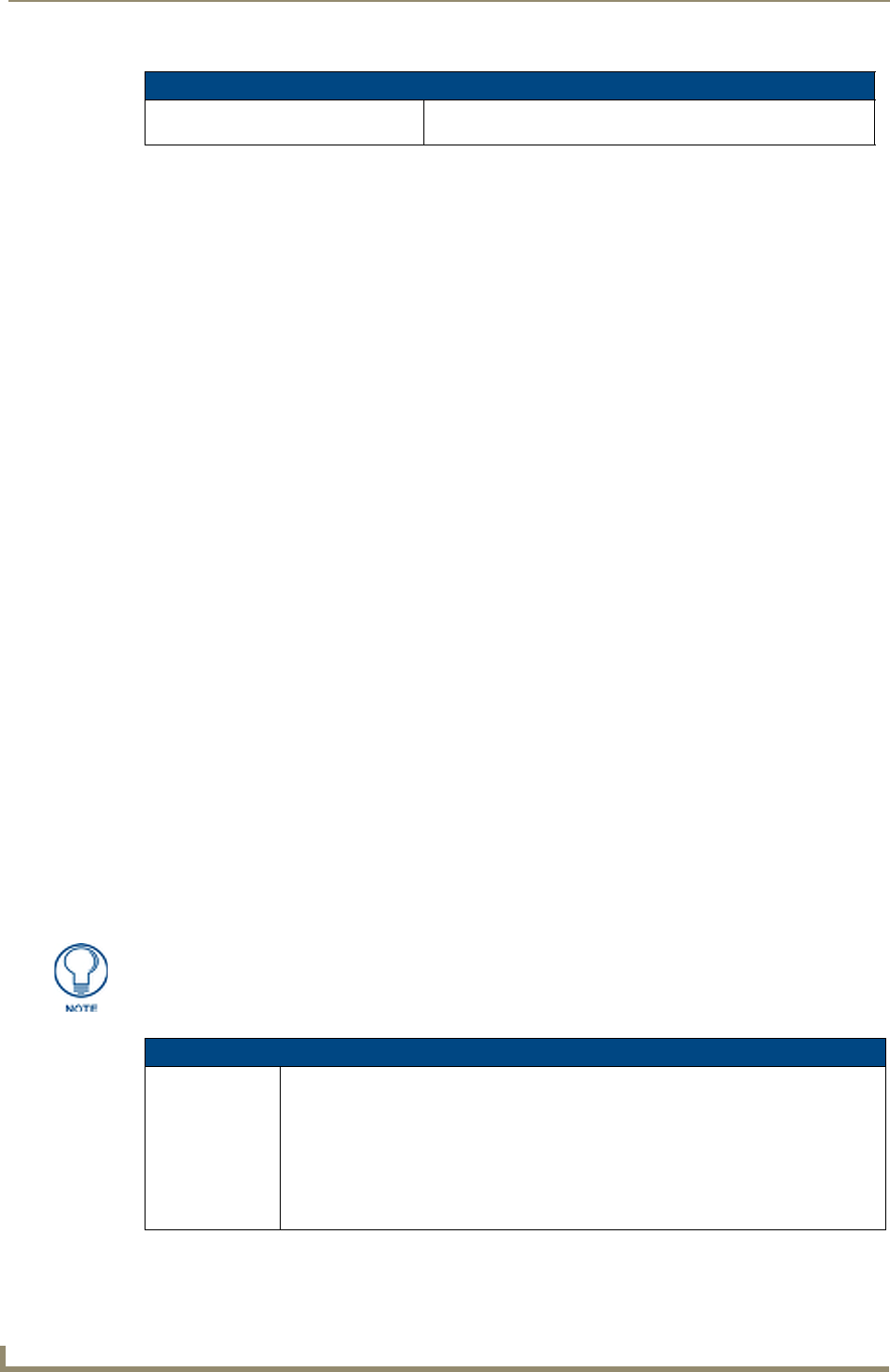
Programming
112 MVP-9000i Modero® Wireless Touch Panel with Intercom
Gesture VNC/Mouse Support
Gestures are recognized whether or not the user is using a finger or stylus on the panel's screen overlay, a
mouse on a VNC connection, or a mouse connected to the local USB port on the panel.
Gesture Custom Event
Whenever a gesture is recognized and processed a custom event is also sent to the master. The following values
describe this event:
CUSTOM_EVENT ADDRESS is 1
CUSTOM_EVENT EVENTID is 600
Custom.Value1 is the gesture number
Custom.Value2 is the simplified gesture velocity
Custom.Value3 is the precise gesture velocity
Gesture numbers are:
1. Swipe up
2. Swipe down
3. Swipe right
4. Swipe left
5. Clockwise circle
6. Counter-clockwise circle
7. Double-Tap
Simplified gesture velocity values are:
1. Fast
2. Normal
3. Slow
Precise gesture velocity:
1. For slides and circles this represents pixels per second.
2. For double taps, this is the time in milliseconds from the first press to the second release.
Enabling or Disabling the Gesture Custom Event
By default, a gesture custom event is sent to the master each time that a gesture is recognized. A send
command has been added to allow disabling and re-enabling of this capability.
Gesture Prioritization (Cont.)
The user double taps outside of a button
or slider.
This will be registered as a gesture.
The value sent is not retained and gesture custom events will be enabled each time
the panel restarts.
Gesture Custom Event Commands
^GCE
Sets whether or
not the panel
sends a custom
event to the
master whenever
a gesture is
detected.
For panels supporting gestures. Sets whether or not the panel sends a custom event to
the master whenever a gesture is detected.
Syntax:
"'^GCE-ON'" or "'^GCE-OFF'"
NOTE: This setting is not retained and the default is to always send the events. To enable
sending the event, the value after the dash can be "on", "ON", or “1”. Anything else will
disable sending custom events.
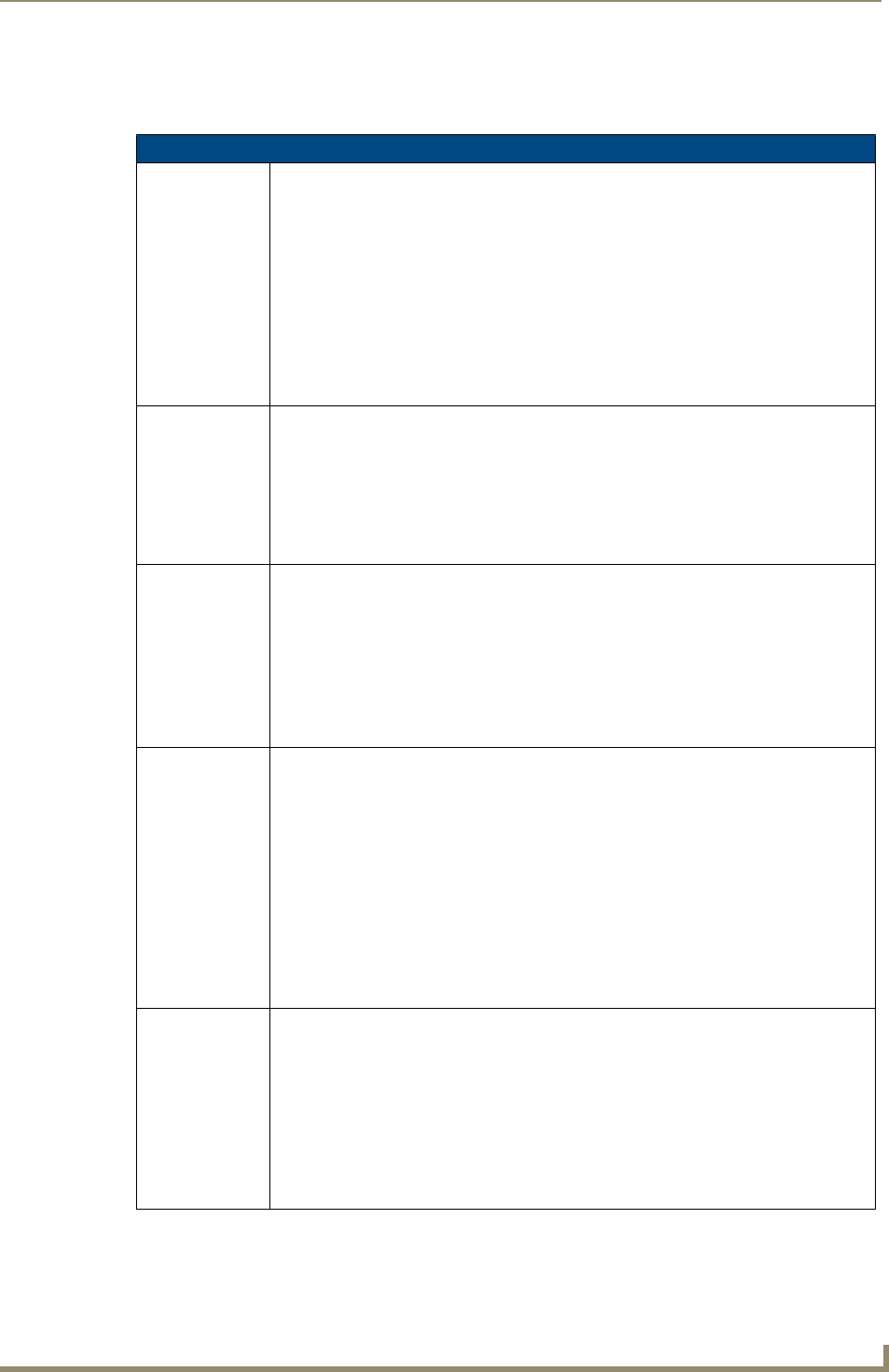
Programming
113
MVP-9000i Modero® Wireless Touch Panel with Intercom
Page Commands
These Page Commands are used in NetLinx Programming Language and are case insensitive.
Page Commands
@APG
Add a specific
popup page to a
specified popup
group.
Add the popup page to a group if it does not already exist. If the new popup is added to a
group which has a popup displayed on the current page along with the new pop-up, the
displayed popup will be hidden and the new popup will be displayed.
Syntax:
"'@APG-<popup page name>;<popup group name>'"
Variable:
popup page name = 1 - 50 ASCII characters. Name of the popup page.
popup group name = 1 - 50 ASCII characters. Name of the popup group.
Example:
SEND_COMMAND Panel,"'@APG-Popup1;Group1'"
Adds the popup page ’Popup1’ to the popup group ’Group1’.
@CPG
Clear all popup
pages from
specified popup
group.
Syntax:
"'@CPG-<popup group name>'"
Variable:
popup group name = 1 - 50 ASCII characters. Name of the popup group.
Example:
SEND_COMMAND Panel,"'@CPG-Group1'"
Clears all popup pages from the popup group ’Group1’.
@DPG
Delete a specific
popup page from
specified popup
group if it exists.
Syntax:
"'@DPG-<popup page name>;<popup group name>'"
Variable:
popup page name = 1 - 50 ASCII characters. Name of the popup page.
popup group name = 1 - 50 ASCII characters. Name of the popup group.
Example:
SEND_COMMAND Panel,"'@DPG-Popup1;Group1'"
Deletes the popup page ’Popup1’ from the popup group ’Group1’.
@PDR
Set the popup
location reset flag.
If the flag is set, the popup will return to its default location on show instead of its last drag
location.
Syntax:
"'@PDR-<popup page name>;<reset flag>'"
Variable:
popup page name = 1 - 50 ASCII characters. Name of the page the popup is displayed
On.
reset flag = 1 = Enable reset flag
0 = Disable reset flag
Example:
SEND_COMMAND Panel,"'@PDR-Popup1;1'"
Popup1 will return to its default location when turned On.
@PHE
Set the hide effect
for the specified
popup page to the
named hide effect.
Syntax:
"'@PHE-<popup page name>;<hide effect name>'"
Variable:
popup page name = 1 - 50 ASCII characters. Name of the page the popup is displayed
On.
hide effect name = Refers to the popup effect names being used.
Example:
SEND_COMMAND Panel,"'@PHE-Popup1;Slide to Left'"
Sets the Popup1 hide effect name to ’Slide to Left’.
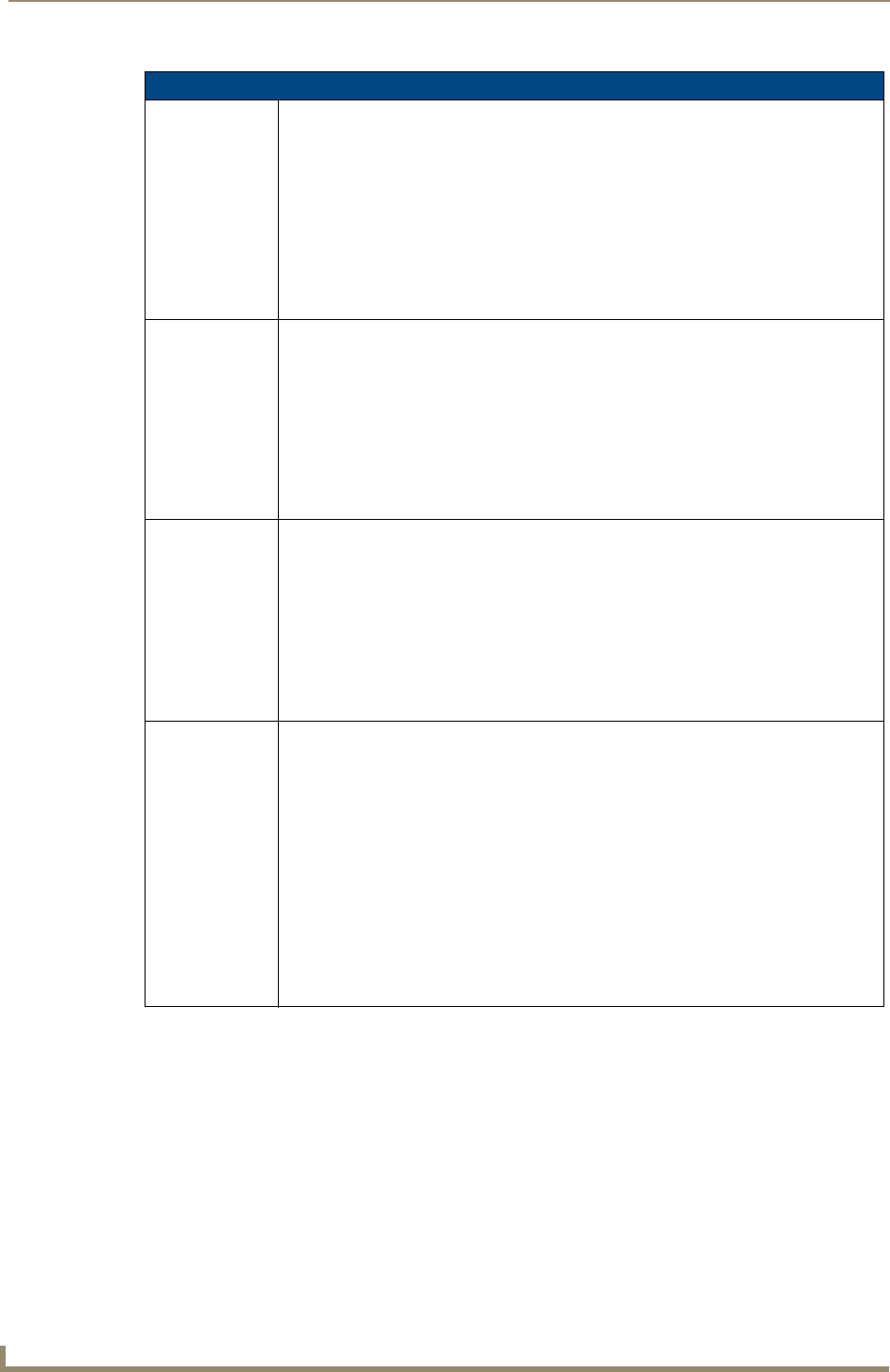
Programming
114 MVP-9000i Modero® Wireless Touch Panel with Intercom
Page Commands (Cont.)
@PHP
Set the hide effect
position.
Only 1 coordinate is ever needed for an effect; however, the command will specify both.
This command sets the location at which the effect will end at.
Syntax:
"'@PHP-<popup page name>;<x coordinate>,<y coordinate>'"
Variable:
popup page name = 1 - 50 ASCII characters. Name of the page the popup is displayed
On.
Example:
SEND_COMMAND Panel,"'@PHP-Popup1;75,0'"
Sets the Popup1 hide effect x-coordinate value to 75 and the y-coordinate value to 0.
@PHT
Set the hide effect
time for the
specified popup
page.
Syntax:
"'@PHT-<popup page name>;<hide effect time>'"
Variable:
popup page name = 1 - 50 ASCII characters. Name of the page the popup is displayed
On.
hide effect time = Given in 1/10ths of a second.
Example:
SEND_COMMAND Panel,"'@PHT-Popup1;50'"
Sets the Popup1 hide effect time to 5 seconds.
@PPA
Close all popups
on a specified
page.
If the page name is empty, the current page is used. Same as the ’Clear Page’ command
in TPDesign4.
Syntax:
"'@PPA-<page name>'"
Variable:
page name = 1 - 50 ASCII characters. Name of the page the popup is displayed On.
Example:
SEND_COMMAND Panel,"'@PPA-Page1'"
Close all pop-ups on Page1.
@PPF
Deactivate a
specific popup
page on either a
specified page or
the current page.
If the page name is empty, the current page is used (see example 2). If the popup page is
part of a group, the whole group is deactivated. This command works in the same way as
the ’Hide Popup’ command in TPDesign4.
Syntax:
"'@PPF-<popup page name>;<page name>'"
Variable:
popup page name = 1 - 50 ASCII characters. Name of the popup page.
page name = 1 - 50 ASCII characters. Name of the page the popup is displayed On.
Example:
SEND_COMMAND Panel,"'@PPF-Popup1;Main'"
Example 2:
SEND_COMMAND Panel,"'@PPF-Popup1'"
Deactivates the popup page ’Popup1’ on the current page.

Programming
115
MVP-9000i Modero® Wireless Touch Panel with Intercom
Page Commands (Cont.)
@PPG
Toggle a
specific popup
page on either a
specified page or
the current page.
If the page name is empty, the current page is used (see example 2). Toggling refers to the
activating/deactivating (On/Off) of a popup page. This command works in the same way
as the ’Toggle Popup’ command in TPDesign4.
Syntax:
"'@PPG-<popup page name>;<page name>'"
Variable:
popup page name = 1 - 50 ASCII characters. Name of the popup page.
page name = 1 - 50 ASCII characters. Name of the page the popup is displayed On.
Example:
SEND_COMMAND Panel,"'@PPG-Popup1;Main'"
Toggles the popup page ’Popup1’ on the ’Main’ page from one state to another (On/Off).
Example 2:
SEND_COMMAND Panel,"'@PPG-Popup1'"
Toggles the popup page ’Popup1’ on the current page from one state to another (On/Off).
@PPK
Kill a specific
popup page from
all pages.
Kill refers to the deactivating (Off) of a popup window from all pages. If the pop-up page is
part of a group, the whole group is deactivated. This command works in the same way as
the 'Clear Group' command in TPDesign 4.
Syntax:
"'@PPK-<popup page name>'"
Variable:
popup page name = 1 - 50 ASCII characters. Name of the popup page.
Example:
SEND_COMMAND Panel,"'@PPK-Popup1'"
Kills the popup page ’Popup1’ on all pages.
@PPM
Set the modality
of a specific
popup page to
Modal or
NonModal.
A Modal popup page, when active, only allows you to use the buttons and features on that
popup page. All other buttons on the panel page are inactivated.
Syntax:
"'@PPM-<popup page name>;<mode>'"
Variable:
popup page name = 1 - 50 ASCII characters. Name of the popup page.
mode = NONMODAL converts a previously Modal popup page to a NonModal.
MODAL converts a previously NonModal popup page to Modal.
modal = 1 and non-modal = 0
Example:
SEND_COMMAND Panel,"'@PPM-Popup1;Modal'"
Sets the popup page ’Popup1’ to Modal.
SEND_COMMAND Panel,"'@PPM-Popup1;1'"
Sets the popup page ’Popup1’ to Modal.
@PPN
Activate a
specific popup
page to launch on
either a specified
page or the
current page.
If the page name is empty, the current page is used (see example 2). If the popup page is
already on, do not re-draw it. This command works in the same way as the ’Show Popup’
command in TPDesign4.
Syntax:
"'@PPN-<popup page name>;<page name>'"
Variable:
popup page name = 1 - 50 ASCII characters. Name of the popup page.
page name = 1 - 50 ASCII characters. Name of the page the popup is displayed On.
Example:
SEND_COMMAND Panel,"'@PPN-Popup1;Main'"
Activates ’Popup1’ on the ’Main’ page.
Example 2:
SEND_COMMAND Panel,"'@PPN-Popup1'"
Activates the popup page ’Popup1’ on the current page.
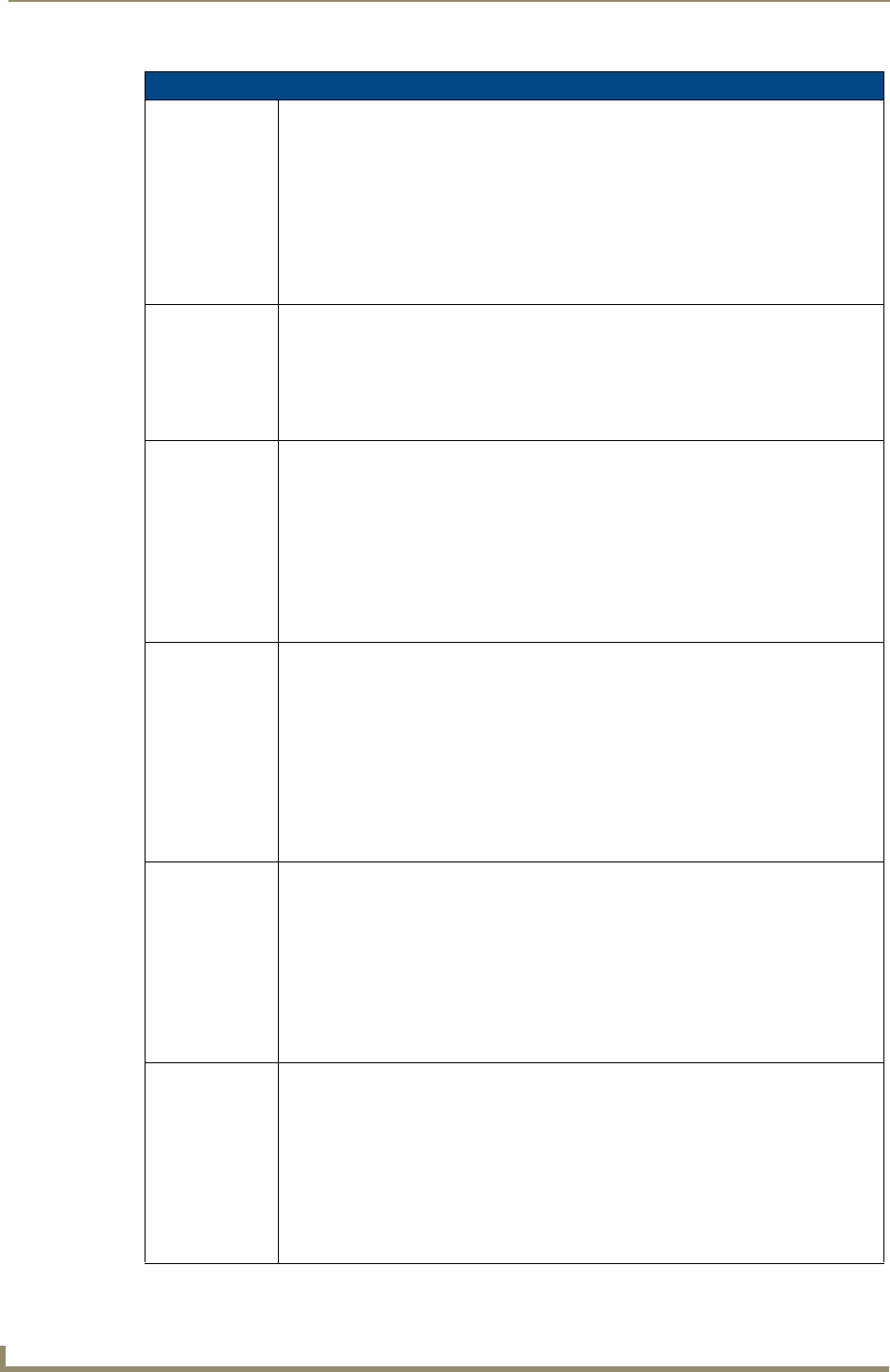
Programming
116 MVP-9000i Modero® Wireless Touch Panel with Intercom
Page Commands (Cont.)
@PPT
Set a specific
popup page to
timeout within a
specified time.
If timeout is empty, popup page will clear the timeout.
Syntax:
"'@PPT-<popup page name>;<timeout>'"
Variable:
popup page name = 1 - 50 ASCII characters. Name of the popup page.
timeout = Timeout duration in 1/10ths of a second.
Example:
SEND_COMMAND Panel,"'@PPT-Popup1;30'"
Sets the popup page ’Popup1’ to timeout within 3 seconds.
@PPX
Close all
popups on all
pages.
This command works in the same way as the 'Clear All' command in TPDesign 4.
Syntax:
"'@PPX'"
Example:
SEND_COMMAND Panel,"'@PPX'"
Close all popups on all pages.
@PSE
Set the show
effect for the
specified popup
page to the
named show
effect.
Syntax:
"'@PSE-<popup page name>;<show effect name>'"
Variable:
popup page name = 1 - 50 ASCII characters. Name of the page the popup is displayed
On.
show effect name = Refers to the popup effect name being used.
Example:
SEND_COMMAND Panel,"'@PSE-Popup1;Slide from Left'"
Sets the Popup1 show effect name to ’Slide from Left’.
@PSP
Set the show
effect position.
Only 1 coordinate is ever needed for an effect; however, the command will specify both.
This command sets the location at which the effect will begin.
Syntax:
"'@PSP-<popup page name>;<x coordinate>,<y coordinate>'"
Variable:
popup page name = 1 - 50 ASCII characters. Name of the page the popup is displayed
On.
Example:
SEND_COMMAND Panel,"'@PSP-Popup1;100,0'"
Sets the Popup1 show effect x-coordinate value to 100 and the y-coordinate value to 0.
@PST
Set the show
effect time for the
specified popup
page.
Syntax:
"'@PST-<popup page name>;<show effect time>'"
Variable:
popup page name = 1 - 50 ASCII characters. Name of the page the popup is displayed
On.
show effect time = Given in 1/10ths of a second.
Example:
SEND_COMMAND Panel,"'@PST-Popup1;50'"
Sets the Popup1 show effect time to 5 seconds.
PAGE
Flip to a specified
page.
Flips to a page with a specified page name. If the page is currently active, it will not redraw
the page.
Syntax:
"'PAGE-<page name>'"
Variable:
page name = 1 - 50 ASCII characters. Name of the page the popup is displayed On.
Example:
SEND_COMMAND Panel,"'PAGE-Page1'"
Flips to page1.

Programming
117
MVP-9000i Modero® Wireless Touch Panel with Intercom
Page Commands (Cont.)
PPOF
Deactivate a
specific popup
page on either a
specified page or
the current page.
If the page name is empty, the current page is used (see example 2). If the popup page is
part of a group, the whole group is deactivated. This command works in the same way as
the ’Hide Popup’ command in TPDesign4.
Syntax:
"'PPOF-<popup page name>;<page name>'"
Variable:
popup page name = 1 - 50 ASCII characters. Name of the popup page.
page name = 1 - 50 ASCII characters. Name of the page the popup is displayed On.
Example:
SEND_COMMAND Panel,"'PPOF-Popup1;Main'"
Deactivates the popup page ’Popup1’ on the Main page.
Example 2:
SEND_COMMAND Panel,"'PPOF-Popup1'"
Deactivates the popup page ’Popup1’ on the current page.
PPOG
Toggle a
specific popup
page on either a
specified page or
the current page.
If the page name is empty, the current page is used (see example 2). Toggling refers to the
activating/deactivating (On/Off) of a popup page. This command works in the same way
as the ’Toggle Popup’ command in TPDesign4.
Syntax:
"'PPOG-<popup page name>;<page name>'"
Variable:
popup page name = 1 - 50 ASCII characters. Name of the popup page.
page name = 1 - 50 ASCII characters. Name of the page the popup is displayed On.
Example:
SEND_COMMAND Panel,"'PPOG-Popup1;Main'"
Toggles the popup page ’Popup1’ on the Main page from one state to another (On/Off).
Example 2:
SEND_COMMAND Panel,"'PPOG-Popup1'"
Toggles the popup page ’Popup1’ on the current page from one state to another (On/Off).
PPON
Activate a
specific popup
page to launch on
either a specified
page or the
current page.
If the page name is empty, the current page is used (see example 2). If the popup page is
already On, do not re-draw it. This command works in the same way as the ’Show Popup’
command in TPDesign4.
Syntax:
"'PPON-<popup page name>;<page name>'"
Variable:
popup page name = 1 - 50 ASCII characters. Name of the popup page.
page name = 1 - 50 ASCII characters. Name of the page the popup is displayed On.
Example:
SEND_COMMAND Panel,"'PPON-Popup1; Main'"
Activates the popup page ’Popup1’ on the Main page.
Example 2:
SEND_COMMAND Panel,"'PPON-Popup1'"
Activates the popup page ’Popup1’ on the current page.
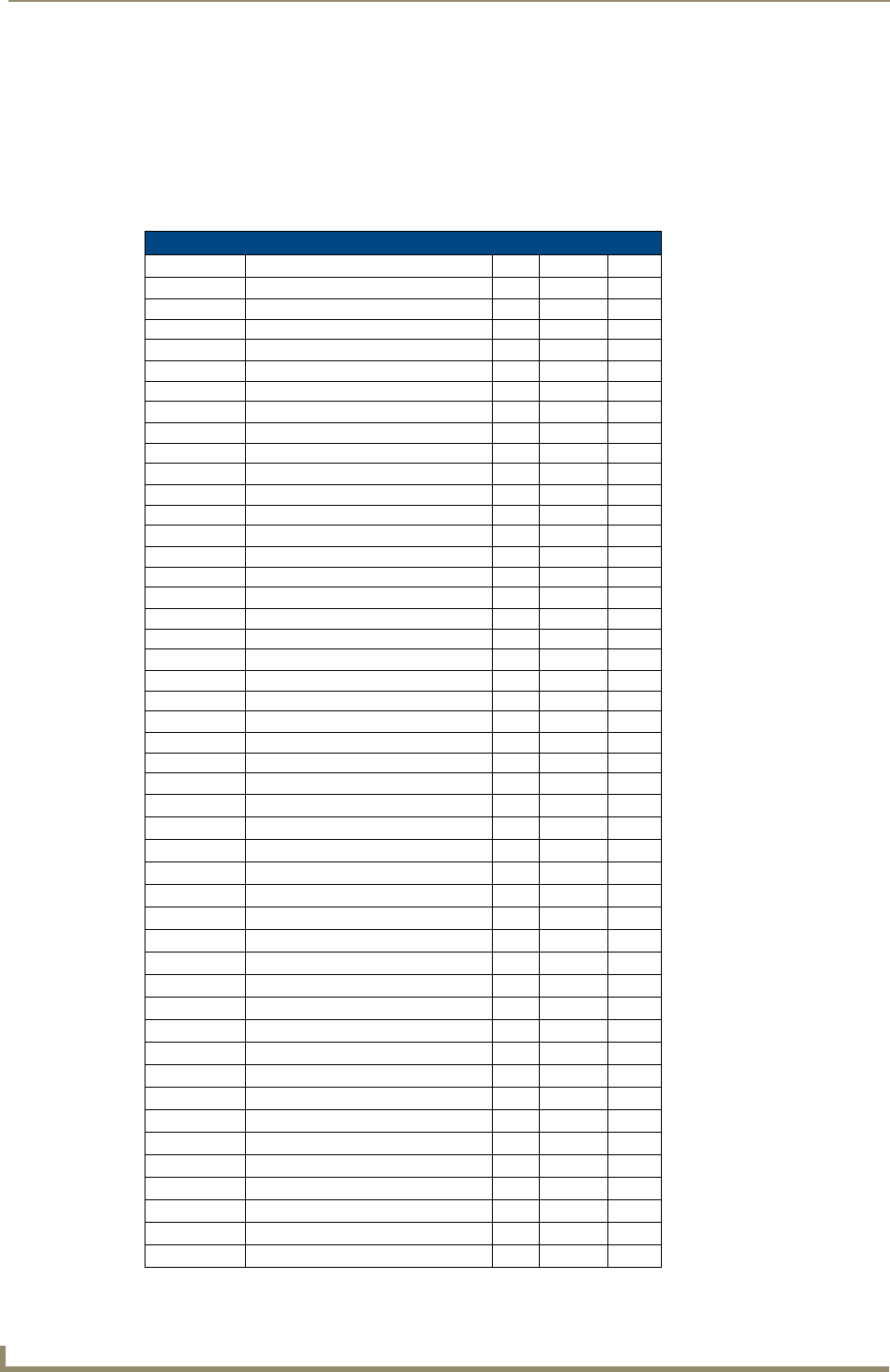
Programming
118 MVP-9000i Modero® Wireless Touch Panel with Intercom
Programming Numbers
The following information provides the programming numbers for colors, fonts, and borders.
Colors can be used to set the colors on buttons, sliders, and pages. The lowest color number represents the
lightest color-specific display; the highest number represents the darkest display. For example, 0 represents
light red, and 5 is dark red.
RGB Triplets and Names For Basic 88 Colors
RGB Values for all 88 Basic Colors
Index No. Name Red Green Blue
00 Very Light Red 255 0 0
01 Light Red 223 0 0
02 Red 191 0 0
03 Medium Red 159 0 0
04 Dark Red 127 0 0
05 Very Dark Red 95 0 0
06 Very Light Orange 255 128 0
07 Light Orange 223 112 0
08 Orange 191 96 0
09 Medium Orange 159 80 0
10 Dark Orange 127 64 0
11 Very Dark Orange 95 48 0
12 Very Light Yellow 255 255 0
13 Light Yellow 223 223 0
14 Yellow 191 191 0
15 Medium Yellow 159 159 0
16 Dark Yellow 127 127 0
17 Very Dark Yellow 95 95 0
18 Very Light Lime 128 255 0
19 Light Lime 112 223 0
20 Lime 96 191 0
21 Medium Lime 80 159 0
22 Dark Lime 64 127 0
23 Very Dark Lime 48 95 0
24 Very Light Green 0 255 0
25 Light Green 0 223 0
26 Green 0 191 0
27 Medium Green 0 159 0
28 Dark Green 0 127 0
29 Very Dark Green 0 95 0
30 Very Light Mint 0 255 128
31 Light Mint 0 223 112
32 Mint 0 191 96
33 Medium Mint 0 159 80
34 Dark Mint 0 127 64
35 Very Dark Mint 0 95 48
36 Very Light Cyan 0 255 255
37 Light Cyan 0 223 223
38 Cyan 0 191 191
39 Medium Cyan 0 159 159
40 Dark Cyan 0 127 127
41 Very Dark Cyan 0 95 95
42 Very Light Aqua 0 128 255
43 Light Aqua 0 112 223
44 Aqua 0 96 191
45 Medium Aqua 0 80 159
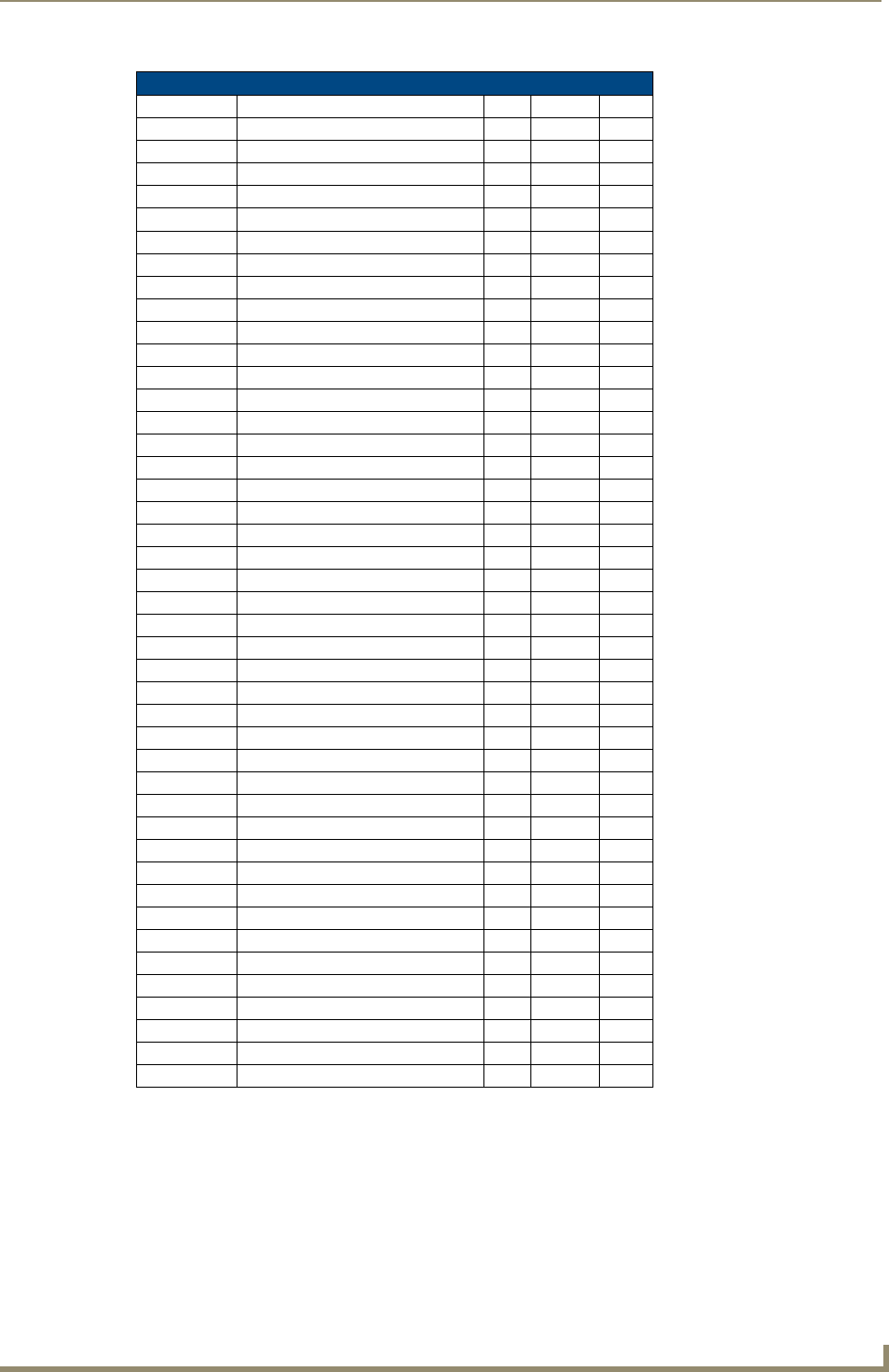
Programming
119
MVP-9000i Modero® Wireless Touch Panel with Intercom
RGB Values for all 88 Basic Colors (Cont.)
Index No. Name Red Green Blue
46 Dark Aqua 0 64 127
47 Very Dark Aqua 0 48 95
48 Very Light Blue 0 0 255
49 Light Blue 0 0 223
50 Blue 0 0 191
51 Medium Blue 0 0 159
52 Dark Blue 0 0 127
53 Very Dark Blue 0 0 95
54 Very Light Purple 128 0 255
55 Light Purple 112 0 223
56 Purple 96 0 191
57 Medium Purple 80 0 159
58 Dark Purple 64 0 127
59 Very Dark Purple 48 0 95
60 Very Light Magenta 255 0 255
61 Light Magenta 223 0 223
62 Magenta 191 0 191
63 Medium Magenta 159 0 159
64 Dark Magenta 127 0 127
65 Very Dark Magenta 95 0 95
66 Very Light Pink 255 0 128
67 Light Pink 223 0 112
68 Pink 191 0 96
69 Medium Pink 159 0 80
70 Dark Pink 127 0 64
71 Very Dark Pink 95 0 48
72 White 255 255 255
73 Grey1 238 238 238
74 Grey3 204 204 204
75 Grey5 170 170 170
76 Grey7 136 136 136
77 Grey9 102 102 102
78 Grey4 187 187 187
79 Grey6 153 153 153
80 Grey8 119 119 119
81 Grey10 85 85 85
82 Grey12 51 51 51
83 Grey13 34 34 34
84 Grey2 221 221 221
85 Grey11 68 68 68
86 Grey14 17 17 17
87 Black 0 0 0
255 TRANSPARENT 99 53 99
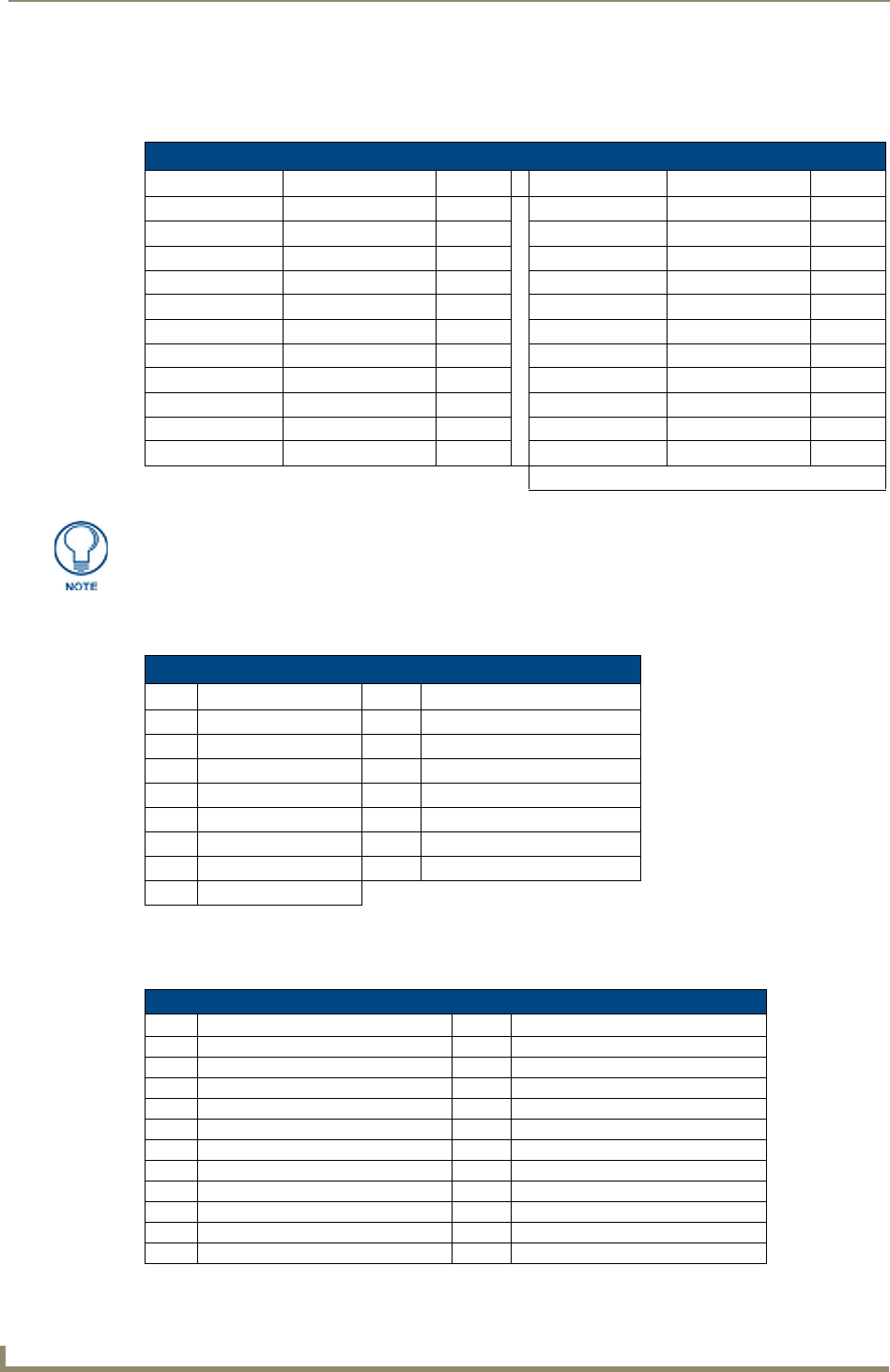
Programming
120 MVP-9000i Modero® Wireless Touch Panel with Intercom
Font Styles And Id Numbers
Font styles can be used to program the text fonts on buttons, sliders, and pages. The following chart shows the
default font type and their respective ID numbers generated by TPDesign4.
Border Styles And Programming Numbers
Border styles can be used to program borders on buttons, sliders, and popup pages.
The TPDesign4 Touch Panel Design program has pre-set border styles that are user-selectable.
The following number values cannot be used for programming purposes when changing border styles. TPD4
border styles may ONLY be changed by using the name.
Default Font Styles and ID Numbers
Font ID # Font type Size Font ID # Font type Size
1 Courier New 9 19 Arial 9
2 Courier New 12 20 Arial 10
3 Courier New 18 21 Arial 12
4 Courier New 26 22 Arial 14
5 Courier New 32 23 Arial 16
6 Courier New 18 24 Arial 18
7 Courier New 26 25 Arial 20
8 Courier New 34 26 Arial 24
9 AMX Bold 14 27 Arial 36
10 AMX Bold 20 28 Arial Bold 10
11 AMX Bold 36 29 Arial Bold 8
32 - Variable Fonts start at 32.
Fonts must be imported into a TPDesign4 project file. The font ID numbers are
assigned by TPDesign4. These values are also listed in the Generate
Programmer’s Report.
Border Styles and Programming Numbers
No. Border styles No. Border styles
0-1 No border 10-11 Picture frame
2 Single line 12 Double line
3 Double line 20 Bevel-S
4 Quad line 21 Bevel-M
5-6 Circle 15 22-23 Circle 15
7 Single line 24-27 Neon inactive-S
8 Double line 40-41 Diamond 55
9 Quad line
TPD4 Border Styles by Name
No. Border styles No. Border styles
1 None 27 Cursor Bottom
2 AMX Elite -L 28 Cursor Bottom with Hole
3 AMX Elite -M 29 Cursor Top
4 AMX Elite -S 30 Cursor Top with Hole
5 Bevel -L 31 Cursor Left
6 Bevel -M 32 Cursor Left with Hole
7 Bevel -S 33 Cursor Right
8 Circle 15 34 Cursor Right with Hole
9 Circle 25 35 Custom Frame
10 Circle 35 36 Diamond 15
11 Circle 45 37 Diamond 25
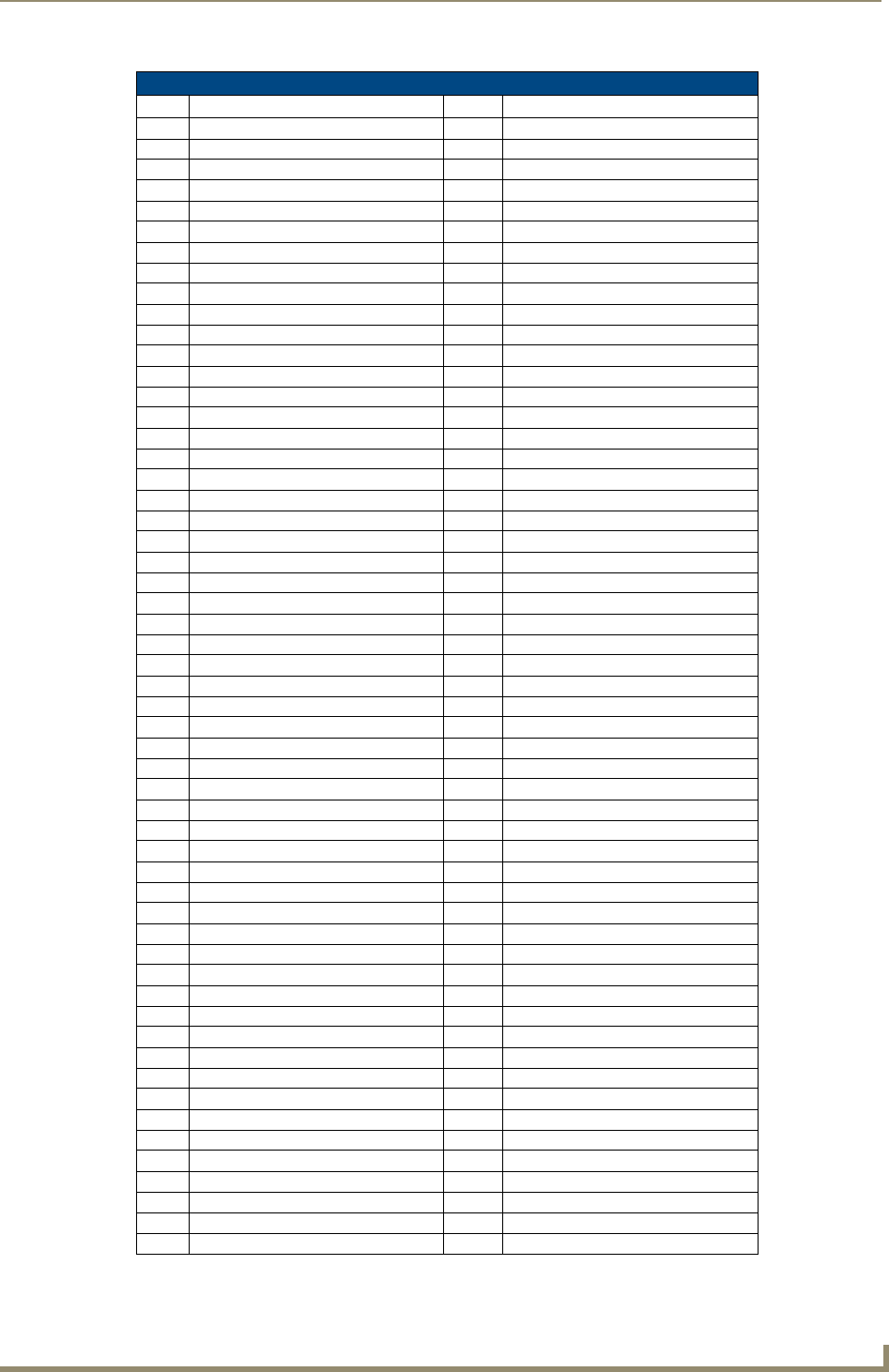
Programming
121
MVP-9000i Modero® Wireless Touch Panel with Intercom
TPD4 Border Styles by Name (Cont.)
No. Border styles No. Border styles
12 Circle 55 38 Diamond 35
13 Circle 65 39 Diamond 45
14 Circle 75 40 Diamond 55
15 Circle 85 41 Diamond 65
16 Circle 95 42 Diamond 75
17 Circle 105 43 Diamond 85
18 Circle 115 44 Diamond 95
19 Circle 125 45 Diamond 105
20 Circle 135 46 Diamond 115
21 Circle 145 47 Diamond 125
22 Circle 155 48 Diamond 135
23 Circle 165 49 Diamond 145
24 Circle 175 50 Diamond 155
25 Circle 185 51 Diamond 165
26 Circle 195 52 Diamond 175
53 Diamond 185 97 Menu Bottom Rounded 185
54 Diamond 195 98 Menu Bottom Rounded 195
55 Double Bevel -L 99 Menu Top Rounded 15
56 Double Bevel -M 100 Menu Top Rounded 25
57 Double Bevel -S 101 Menu Top Rounded 35
58 Double Line 102 Menu Top Rounded 45
59 Fuzzy 103 Menu Top Rounded 55
60 Glow-L 104 Menu Top Rounded 65
61 Glow-S 105 Menu Top Rounded 75
62 Help Down 106 Menu Top Rounded 85
63 Neon Active -L 107 Menu Top Rounded 95
64 Neon Active -S 108 Menu Top Rounded 105
65 Neon Inactive -L 109 Menu Top Rounded 115
66 Neon Inactive -S 110 Menu Top Rounded 125
67 Oval H 60x30 111 Menu Top Rounded 135
68 Oval H 100x50 112 Menu Top Rounded 145
69 Oval H 150x75 113 Menu Top Rounded 155
70 Oval H 200x100 114 Menu Top Rounded 165
71 Oval V 30x60 115 Menu Top Rounded 175
72 Oval V 50x100 116 Menu Top Rounded 185
73 Oval V 75x150 117 Menu Top Rounded 195
74 Oval V 100x200 118 Menu Right Rounded 15
75 Picture Frame 119 Menu Right Rounded 25
76 Quad Line 120 Menu Right Rounded 35
77 Single Line 121 Menu Right Rounded 45
78 Windows Style Popup 122 Menu Right Rounded 55
79 Windows Style Popup (Status Bar) 123 Menu Right Rounded 65
80 Menu Bottom Rounded 15 124 Menu Right Rounded 75
81 Menu Bottom Rounded 25 125 Menu Right Rounded 85
82 Menu Bottom Rounded 35 126 Menu Right Rounded 95
83 Menu Bottom Rounded 45 127 Menu Right Rounded 105
84 Menu Bottom Rounded 55 128 Menu Right Rounded 115
85 Menu Bottom Rounded 65 129 Menu Right Rounded 125
86 Menu Bottom Rounded 75 130 Menu Right Rounded 135
87 Menu Bottom Rounded 85 131 Menu Right Rounded 145
88 Menu Bottom Rounded 95 132 Menu Right Rounded 155
89 Menu Bottom Rounded 105 133 Menu Right Rounded 165
90 Menu Bottom Rounded 115 134 Menu Right Rounded 175
91 Menu Bottom Rounded 125 135 Menu Right Rounded 185
92 Menu Bottom Rounded 135 136 Menu Right Rounded 195
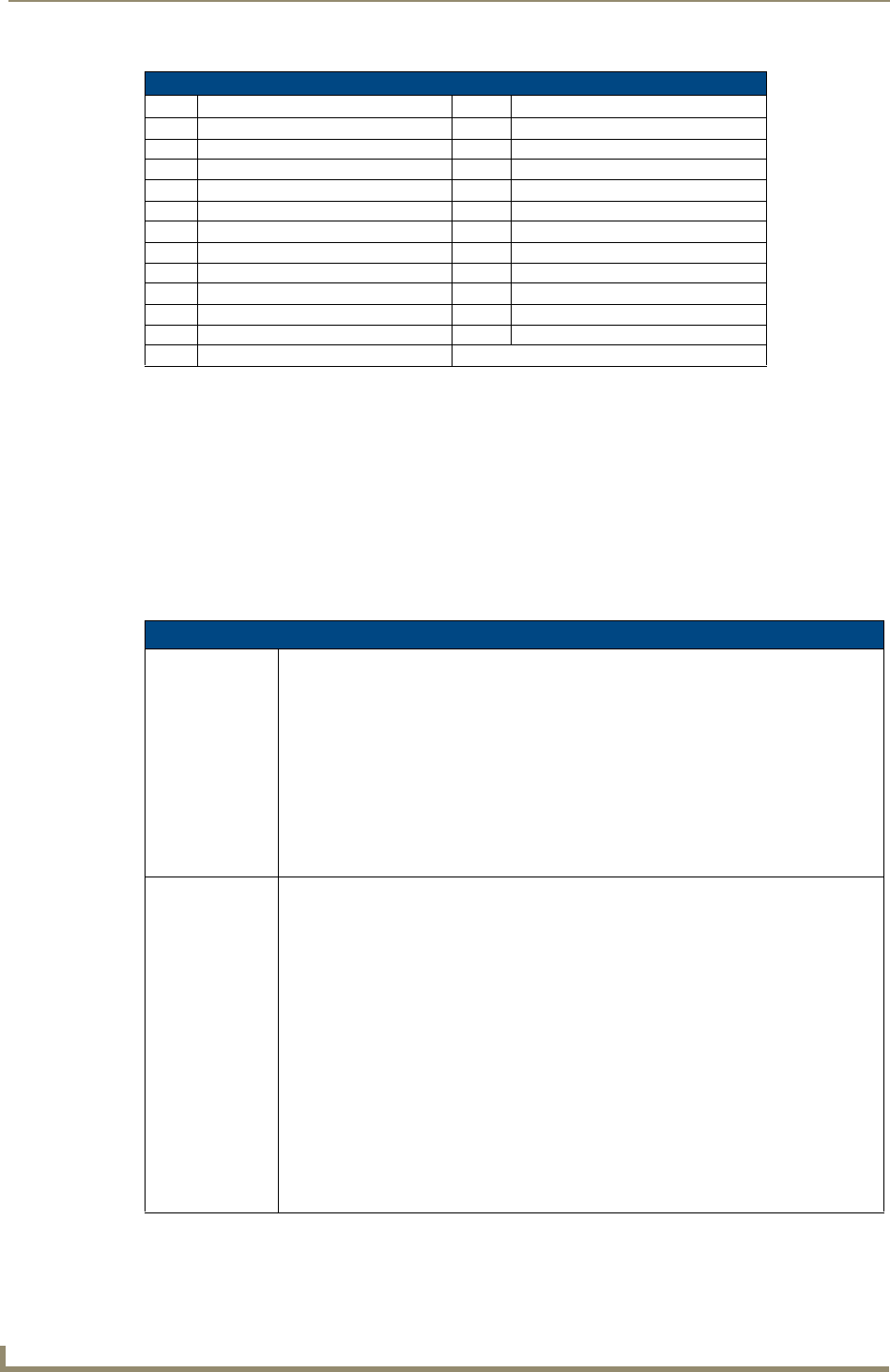
Programming
122 MVP-9000i Modero® Wireless Touch Panel with Intercom
"^" Button Commands
These Button Commands are used in NetLinx Studio and are case insensitive.
All commands that begin with "^" have the capability of assigning a variable text address range and button
state range. A device must first be defined in the NetLinx programming language with values for the
Device: Port: System (in all programming examples - Panel is used in place of these values).
Variable text ranges allow you to target 1 or more variable text channels in a single command.
Button State ranges allow you to target 1 or more states of a variable text button with a single
command.
"." Character is used for the 'through' notation, also the “&” character is used for the 'And'
notation.
TPD4 Border Styles by Name (Cont.)
No. Border styles No. Border styles
93 Menu Bottom Rounded 145 137 Menu Left Rounded 15
94 Menu Bottom Rounded 155 138 Menu Left Rounded 25
95 Menu Bottom Rounded 165 139 Menu Left Rounded 35
96 Menu Bottom Rounded 175 140 Menu Left Rounded 45
141 Menu Left Rounded 55 149 Menu Left Rounded 135
142 Menu Left Rounded 65 150 Menu Left Rounded 145
143 Menu Left Rounded 75 151 Menu Left Rounded 155
144 Menu Left Rounded 85 152 Menu Left Rounded 165
145 Menu Left Rounded 95 153 Menu Left Rounded 175
146 Menu Left Rounded 105 154 Menu Left Rounded 185
147 Menu Left Rounded 115 155 Menu Left Rounded 195
148 Menu Left Rounded 125
"^" Button Commands
^ANI
Run a button
animation
(in 1/10 second).
Syntax:
"'^ANI-<vt addr range>,<start state>,<end state>,<time>'"
Variable:
variable text address range = 1 - 4000.
start state = Beginning of button state (0= current state).
end state = End of button state.
time = In 1/10 second intervals.
Example:
SEND_COMMAND Panel,"'^ANI-500,1,25,100'"
Runs a button animation at text range 500 from state 1 to state 25 for 10 second.
^APF
Add page flip
action to a button
if it does not
already exist.
Syntax:
"'^APF-<vt addr range>,<page flip action>,<page name>'"
Variable:
variable text address range = 1 - 4000.
page flip action =
Stan[dardPage] - Flip to standard page
Prev[iousPage] - Flip to previous page
Show[Popup] - Show Popup page
Hide[Popup] - Hide Popup page
Togg[lePopup] - Toggle popup state
ClearG[roup] - Clear popup page group from all pages
ClearP[age] - Clear all popup pages from a page with the specified page name
ClearA[ll] - Clear all popup pages from all pages
page name = 1 - 50 ASCII characters.
Example:
SEND COMMAND Panel,"'^APF-400,Stan,Main Page'"
Assigns a button to a standard page flip with page name 'Main Page'.
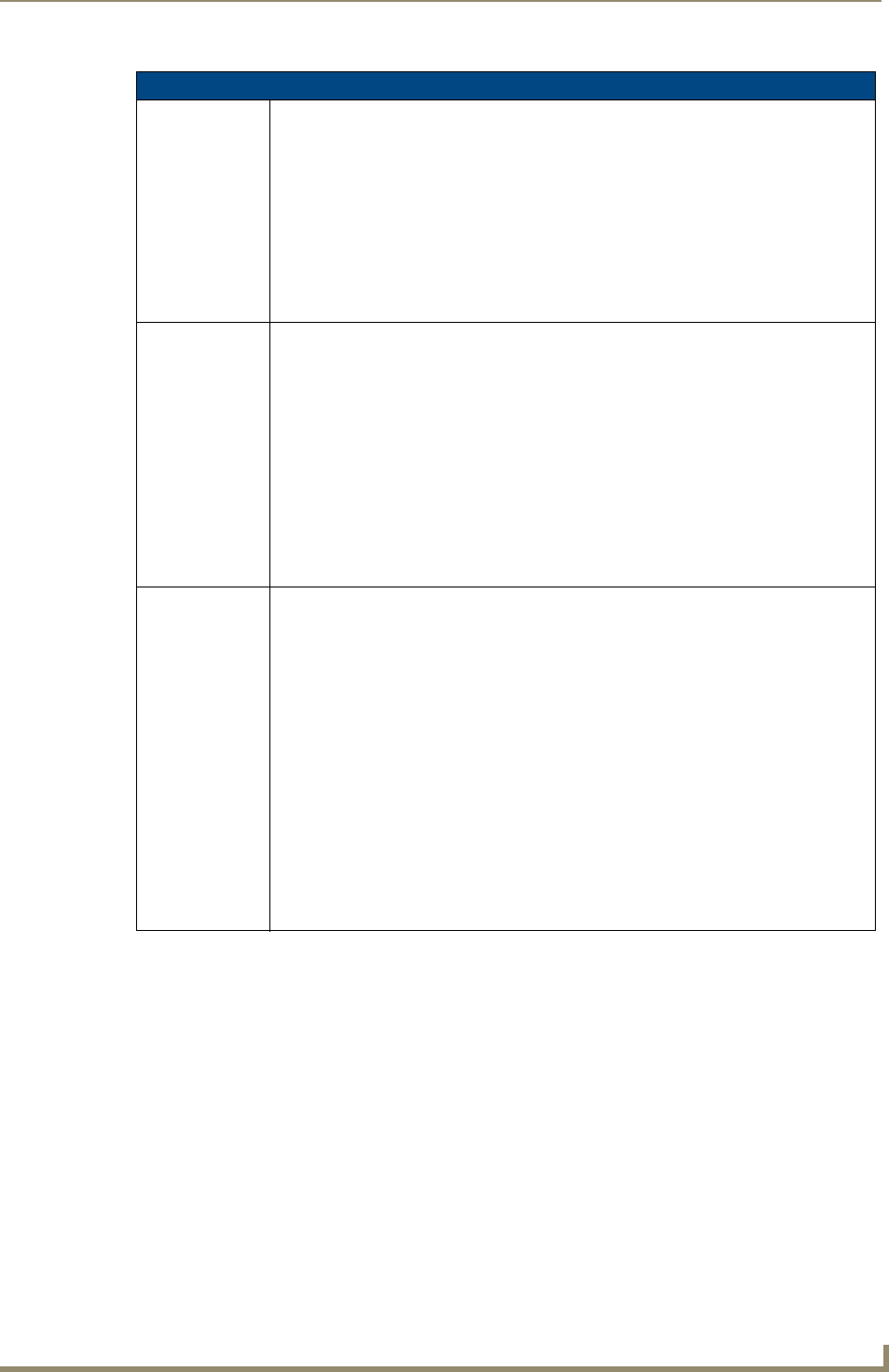
Programming
123
MVP-9000i Modero® Wireless Touch Panel with Intercom
"^" Button Commands (Cont.)
^BAT
Append
non-unicode text.
Syntax:
"'^BAT-<vt addr range>,<button states range>,<new text>'"
Variable:
variable text address range = 1 - 4000.
button states range = 1 - 256 for multi-state buttons (0 = All states, for General buttons
1 = Off state and 2 = On state).
new text = 1 - 50 ASCII characters.
Example:
SEND_COMMAND Panel,"'^BAT-520,1,Enter City'"
Appends the text 'Enter City' to the button’s OFF state.
^BAU
Append
unicode text.
Same format as ^UNI.
Syntax:
"'^BAU-<vt addr range>,<button states range>,<unicode text>'"
Variable:
variable text address range = 1 - 4000.
button states range = 1 - 256 for multi-state buttons (0 = All states, for General buttons
1 = Off state and 2 = On state).
unicode text = 1 - 50 ASCII characters. Unicode characters must be entered in Hex
format.
Example:
SEND_COMMAND Panel,"'^BAU-520,1,00770062'"
Appends Unicode text '00770062' to the button’s OFF state.
^BCB
Set the border
color to the
specified color.
Only if the specified border color is not the same as the current color.
Note: Color can be assigned by color name (without spaces), number or R,G,B value
(RRGGBB or RRGGBBAA).
Syntax:
"'^BCB-<vt addr range>,<button states range>,<color value>'"
Variable:
variable text address range = 1 - 4000.
button states range = 1 - 256 for multi-state buttons (0 = All states, for General buttons
1 = Off state and 2 = On state).
color value = Refer to the RGB Values for all 88 Basic Colors table on page 118 for more
information.
Example:
SEND_COMMAND Panel,"'^BCB-500.504&510,1,12'"
Sets the Off state border color to 12 (Yellow). Colors can be set by Color Numbers, Color
name, R,G,B,alpha colors (RRGGBBAA) and R, G & B colors values (RRGGBB).
Refer to the RGB Values for all 88 Basic Colors table on page 118.

Programming
124 MVP-9000i Modero® Wireless Touch Panel with Intercom
"^" Button Commands (Cont.)
^BCF
Set the fill color to
the specified
color.
Only if the specified fill color is not the same as the current color.
Note: Color can be assigned by color name (without spaces), number or R,G,B value
(RRGGBB or RRGGBBAA).
Syntax:
"'^BCF-<vt addr range>,<button states range>,<color value>'"
Variable:
variable text address range = 1 - 4000.
button states range = 1 - 256 for multi-state buttons (0 = All states, for General buttons
1 = Off state and 2 = On state).
color value = Refer to the RGB Values for all 88 Basic Colors table on page 118 for more
information.
Example:
SEND_COMMAND Panel,"'^BCF-500.504&510.515,1,12'"
SEND_COMMAND Panel,"'^BCF-500.504&510.515,1,Yellow'"
SEND_COMMAND Panel,"'^BCF-500.504&510.515,1,#F4EC0A63''"
SEND_COMMAND Panel,"'^BCF-500.504&510.515,1,#F4EC0A'"
Sets the Off state fill color by color number. Colors can be set by Color Numbers, Color
name, R,G,B,alpha colors (RRGGBBAA) and R, G & B colors values (RRGGBB).
^BCT
Set the text color
to the specified
color.
Only if the specified text color is not the same as the current color.
Note: Color can be assigned by color name (without spaces), number or R,G,B value
(RRGGBB or RRGGBBAA).
Syntax:
"'^BCT-<vt addr range>,<button states range>,<color value>'"
Variable:
variable text address range = 1 - 4000.
button states range = 1 - 256 for multi-state buttons (0 = All states, for General buttons
1 = Off state and 2 = On state).
color value = Refer to the RGB Values for all 88 Basic Colors table on page 118 for more
information.
Example:
SEND_COMMAND Panel,"'^BCT-500.504&510,1,12'"
Sets the Off state border color to 12 (Yellow). Colors can be set by Color Numbers, Color
name, R,G,B,alpha colors (RRGGBBAA) and R, G & B colors values (RRGGBB).
^BDO
Set the button
draw order.
Determines what order each layer of the button is drawn.
Syntax:
"'^BDO-<vt addr range>,<button states range>,<1-5><1-5><1-5><1-5><1-
5>'"
Variable:
variable text address range = 1 - 4000.
button states range = 1 - 256 for multi-state buttons (0 = All states, for General buttons
1 = Off state and 2 = On state).
layer assignments =
Fill Layer = 1
Image Layer = 2
Icon Layer = 3
Text Layer = 4
Border Layer = 5
Note: The layer assignments are from bottom to top. The default draw order is 12345.
Example:
SEND_COMMAND Panel,"'^BDO-530,1&2,51432'"
Sets the button’s variable text 530 ON/OFF state draw order (from bottom to top) to
Border, Fill, Text, Icon, and Image.
Example 2:
SEND_COMMAND Panel,"'^BDO-1,0,12345'"
Sets all states of a button back to its default drawing order.
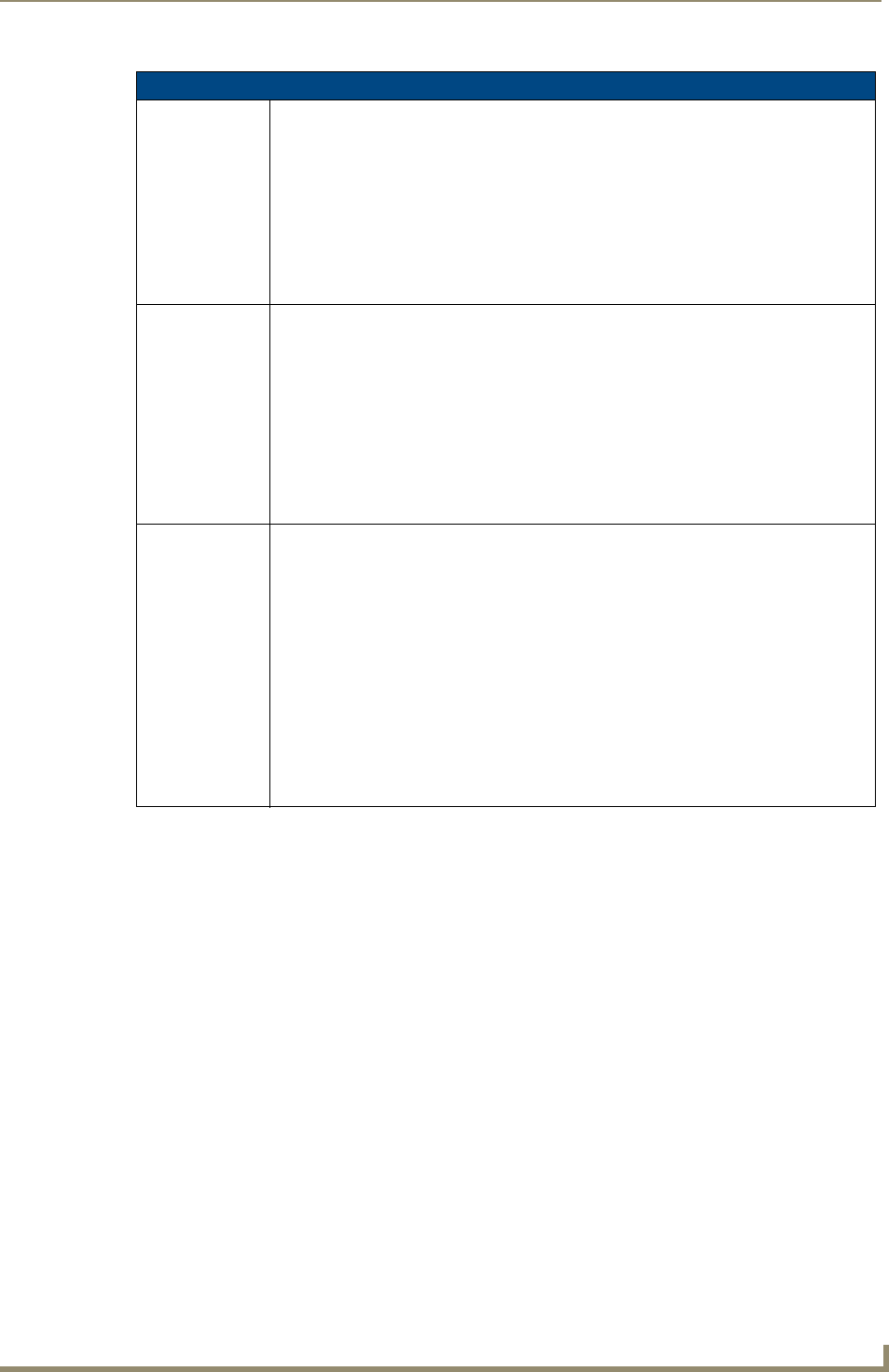
Programming
125
MVP-9000i Modero® Wireless Touch Panel with Intercom
"^" Button Commands (Cont.)
^BFB
Set the feedback
type of the button.
ONLY works on General-type buttons.
Syntax:
"'^BFB-<vt addr range>,<feedback type>'"
Variable:
variable text address range = 1 - 4000.
feedback type = (None, Channel, Invert, On (Always on), Momentary, and Blink).
Example:
SEND_COMMAND Panel,"'^BFB-500,Momentary'"
Sets the Feedback type of the button to 'Momentary'.
^BIM
Set the input
mask for the
specified address.
Syntax:
"'^BIM-<vt addr range>,<input mask>'"
Variable:
variable text address range = 1 - 4000.
input mask = Refer to the Text Area Input Masking table on page 176 for character
types.
Example:
SEND_COMMAND Panel,"'^BIM-500,AAAAAAAAAA'"
Sets the input mask to ten ’A’ characters, that are required, to either a letter or digit
(entry is required).
^BLN
Set the number of
lines removed
equally from the
top and bottom of
a composite video
signal.
The maximum number of lines to remove is 240. A value of 0 will display the incoming
video signal unaffected. This command is used to scale non 4x3 video images into non
4x3 video buttons.
Syntax:
"'^BLN-<vt addr range>,<button states range>,<number of lines>'"
Variable:
variable text address range = 1 - 4000.
button states range = 1 - 256 for multi-state buttons (0 = All states, for General buttons
1 = Off state and 2 = On state).
number of lines = 0 - 240.
Example:
SEND_COMMAND Panel,"'^BLN-500,55'"
Equally removes 55 lines from the top and 55 lines from the bottom of the video button.

Programming
126 MVP-9000i Modero® Wireless Touch Panel with Intercom
"^" Button Commands (Cont.)
^BMC
Button copy
command.
Copy attributes of
the source button
to all the
destination
buttons.
Note that the source is a single button state. Each state must be copied as a separate
command. The <codes> section represents what attributes will be copied. All codes are
2 char pairs that can be separated by comma, space, percent or just ran together.
Syntax:
"'^BMC-<vt addr range>,<button states range>,<source port>,<source
address>,<source state>,<codes>'"
Variable:
variable text address range = 1 - 4000.
button states range = 1 - 256 for multi-state buttons (0 = All states, for General buttons
1 = Off state and 2 = On state).
• source port = 1 - 100.
• source address = 1 - 4000.
• source state = 1 - 256.
codes:
BM - Picture/Bitmap
BR - Border
CB - Border Color
CF - Fill Color
CT - Text Color
EC - Text effect color
EF - Text effect
FT - Font
IC - Icon
JB - Bitmap alignment
JI - Icon alignment
JT - Text alignment
LN - Lines of video removed
OP - Opacity
SO - Button Sound
TX - Text
VI - Video slot ID
WW - Word wrap on/off
Example:
SEND_COMMAND Panel,"'^BMC-425,1,1,500,1,BR'"
or
SEND_COMMAND Panel,"'^BMC-425,1,1,500,1,%BR'"
Copies the OFF state border of button with a variable text address of 500 onto the OFF
state border of button with a variable text address of 425.
Example 2:
SEND_COMMAND Panel,"'^BMC-150,1,1,315,1,%BR%FT%TX%BM%IC%CF%CT'"
Copies the OFF state border, font, Text, bitmap, icon, fill color and text color of the button
with a variable text address of 315 onto the OFF state border, font, Text, bitmap, icon, fill
color and text color of the button with a variable text address of 150.
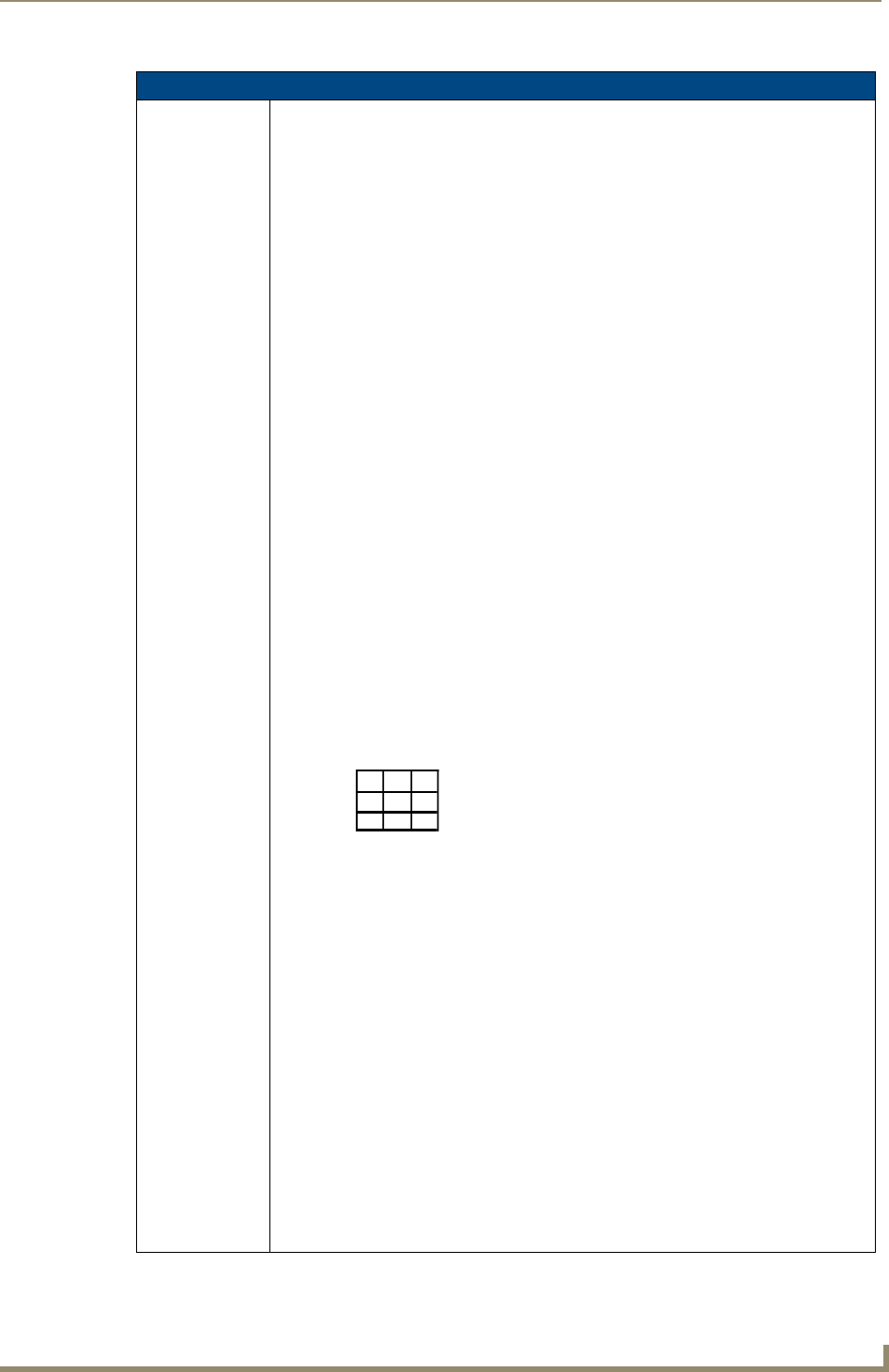
Programming
127
MVP-9000i Modero® Wireless Touch Panel with Intercom
"^" Button Commands (Cont.)
^BMF
Set any/all button
parameters by
sending
embedded codes
and data.
Syntax:
"'^BMF-<vt addr range>,<button states range>,<data>'"
Variables:
variable text address char array = 1 - 4000.
button states range = 1 - 256 for multi-state buttons (0 = All states, for General buttons
1 = Off state and 2 = On state).
level range = 1 - 600 (level value is 1 - 65535).
data:
’%R<left>, <top>, <right>, <bottom>’ = Set rectangle.
’%B<border style>’ = Set the border style name. See the Border Styles and
Programming Numbers table on page 120.
’%B’,<border 0-27,40,41> = Set the borer style number. See the Border Styles and
Programming Numbers table on page 120.
’%DO<1-5><1-5><1-5><1-5><1-5> = Set the draw order. Listed from bottom to top.
Refer to the ^BDO command on page 124 for more information.
’%F’,<font 1-8,10,11,20-29,32-xx> = Set the font. See the Default Font Styles and ID
Numbers table on page 120.
’%F<font 01-08,10,11,20-29,32-xx>’ = Set the font. See the Default Font Styles and ID
Numbers table on page 120.
’%MI<mask image>’ = Set the mask image. Refer to the ^BMI command on page 128 for
more information.
’%R = Sets button location and also resizes the button. Takes four parameters: left, top,
right, bottom.
’%T<text >’ = Set the text using ASCII characters (empty is clear).
’%P<bitmap>’ = Set the picture/bitmap filename (empty is clear).
’%I’,<icon 01-9900, 0-clear>’ = Set the icon using values of 01 - 9900 (icon numbers are
assigned in the TPDesign4 Resource Manager tab - Slots section).
’%I<icon 01-9900, 0-clear>’ = Set the icon using values of 01 - 9900 (icon numbers are
assigned in the TPDesign4 Resource Manager tab - Slots section).
’%J’,<alignment of text 1-9> = As shown the following telephone keypad alignment
chart:
’%JT<alignment of text 0-9>’ = As shown the above telephone keypad alignment chart,
BUT the 0 (zero) is absolute and followed by ’,<left>,<top>’
’%JB<alignment of bitmap/picture 0-9>’ = As shown the above telephone keypad
alignment chart BUT the 0 (zero) is absolute and followed by ’,<left>,<top>’
’%JI<alignment of icon 0-9>’ = As shown the above telephone keypad alignment chart,
BUT the 0 (zero) is absolute and followed by ’,<left>,<top>’
For some of these commands and values, refer to the RGB Values for all 88 Basic
Colors table on page 118.
’%CF<on fill color>’ = Set Fill Color.
’%CB<on border color>’ = Set Border Color.
’%CT<on text color>’ = Set Text Color.
’%SW<1 or 0>’ = Show/hide a button.
’%SO<sound>’ = Set the button sound.
’%EN<1 or 0>’ = Enable/disable a button.
’%WW<1 or 0>’ = Word wrap ON/OFF.
’%GH<bargraph hi>’ = Set the bargraph upper limit.
’%GL<bargraph low>’ = Set the bargraph lower limit.
’%GN<bargraph slider name>’ = Set the bargraph slider name/Joystick cursor name.
’%GC<bargraph slider color>’ = Set the bargraph slider color/Joystick cursor color.
1
4
789
6
32
5
0
Zero can be used for an absolute p osition

Programming
128 MVP-9000i Modero® Wireless Touch Panel with Intercom
"^" Button Commands (Cont.)
^BMF
(Cont.)
’%GI<bargraph invert>’ = Set the bargraph invert/noninvert or joystick coordinate
(0,1,2,3). ^GIV section on page 134 more information.
’%GU<bargraph ramp up>’ = Set the bargraph ramp up time in intervals of 1/10 second.
’%GD<bargraph ramp down>’ = Set the bargraph ramp down time in 1/10 second.
’%GG<bargraph drag increment> = Set the bargraph drag increment. Refer to the ^GDI
command on page 134 for more information.
’%VI<video ON/OFF>’ = Set the Video either ON (value=1) or OFF (value=0).
’%OT<feedback type>’ = Set the Feedback (Output) Type to one of the following:
None, Channel,Invert, ON (Always ON), Momentary, or Blink.
’%SM’ = Submit a text for text area button.
’%SF<1 or 0>’ = Set the focus for text area button.
’%OP<0-255>’ = Set the button opacity to either Invisible (value=0) or Opaque
(value=255).
’%OP#<00-FF>’ = Set the button opacity to either Invisible (value=00) or Opaque
(value=FF).
’%UN<Unicode text>’ = Set the Unicode text. See the ^UNI section on page 139 for the
text format.
’%LN<0-240>’ = Set the lines of video being removed. ^BLN section on page 125 for
more information.
’%EF<text effect name>’ = Set the text effect.
’%EC<text effect color>’ = Set the text effect color.
’%ML<max length>’ = Set the maximum length of a text area.
’%MK<input mask>’ = Set the input mask of a text area.
’%VL<0-1>’ = Log-On/Log-Off the computer control connection
’%VN<network name>’ = Set network connection name.
’%VP<password>’ = Set the network connection password.
Example:
SEND_COMMAND Panel,"'^BMF-500,1,%B10%CFRed%CB Blue
%CTBlack%Ptest.png'"
Sets the button OFF state as well as the Border, Fill Color, Border Color, Text Color, and
Bitmap.
^BMI
Set the button
mask image.
Mask image is used to crop a borderless button to a non-square shape. This is typically
used with a bitmap.
Syntax:
"'^BMI-<vt addr range>,<button states range>,<mask image>'"
Variable:
variable text address range = 1 - 4000.
button states range = 1 - 256 for multi-state buttons (0 = All states, for General buttons
1 = Off state and 2 = On state).
mask image = Graphic file used.
Example:
SEND_COMMAND Panel,"'^BMI-530,1&2,newMac.png'"
Sets the button with variable text 530 ON/OFF state mask image to 'newmac.png'.
^BML
Set the maximum
length of the text
area button.
If this value is set to zero (0), the text area has no max length. The maximum length avail-
able is 2000. This is only for a Text area input button and not for a Text area input masking
button.
Syntax:
"'^BML-<vt addr range>,<max length>'"
Variable:
variable text address range = 1 - 4000.
max length = 2000 (0=no max length).
Example:
SEND_COMMAND Panel,"'^BML-500,20'"
Sets the maximum length of the text area input button to 20 characters.
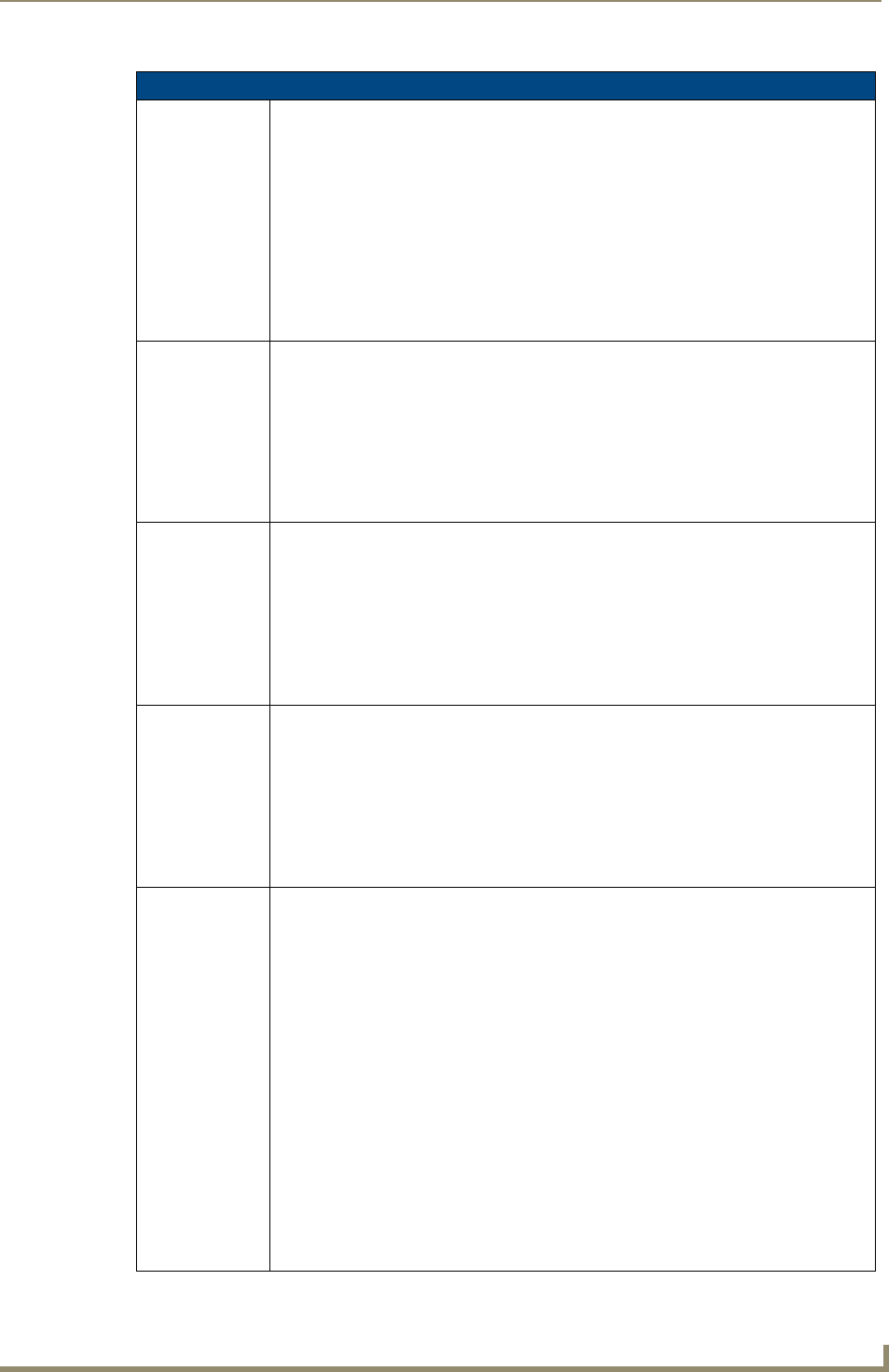
Programming
129
MVP-9000i Modero® Wireless Touch Panel with Intercom
"^" Button Commands (Cont.)
^BMP
Assign a picture to
those buttons with
a defined address
range.
Syntax:
"'^BMP-<vt addr range>,<button states range>,<name of bitmap/
picture>'"
Variable:
variable text address range = 1 - 4000.
button states range = 1 - 256 for multi-state buttons (0 = All states, for General buttons
1 = Off state and 2 = On state).
name of bitmap/picture = 1 - 50 ASCII characters.
Example:
SEND_COMMAND Panel,"'^BMP-500.504&510.515,1,bitmap.png'"
Sets the OFF state picture for the buttons with variable text ranges of 500-504 & 510-515.
^BNC
Clear current
Take No te
annotations.
Syntax:
"'^BNC-<vt addr range>,<command value>'"
Variable:
variable text address range = 1 - 4000.
command value = (0= clear, 1= clear all).
Example:
SEND_COMMAND Panel,"'^BNC-973,0'"
Clears the annotation of the TakeNote button with variable text 973.
^BNN
Set the TakeNote
network name for
the specified
Addresses.
Syntax:
"'^BNN-<vt addr range>,<network name>'"
Variable:
variable text address range = 1 - 4000.
network name = Use a valid IP Address.
Example:
SEND_COMMAND Panel,"'^BNN-973,192.168.169.99'"
Sets the TakeNote button network name to 192.168.169.99.
^BNT
Set the TakeNote
network port for
the specified
Addresses.
Syntax:
"'^BNT-<vt addr range>,<network port>'"
Variable:
variable text address range = 1 - 4000.
network port = 1 - 65535.
Example:
SEND_COMMAND Panel,"'^BNT-973,5000'"
Sets the TakeNote button network port to 5000.
^BOP
Set the button
opacity.
The button opacity can be specified as a decimal between 0 - 255, where zero (0) is
invisible and 255 is opaque, or as a HEX code, as used in the color commands by
preceding the HEX code with the # sign. In this case, #00 becomes invisible and #FF
becomes opaque. If the opacity is set to zero (0), this does not make the button inactive,
only invisible.
Syntax:
"'^BOP-<vt addr range>,<button states range>,<button opacity>'"
Variable:
variable text address range = 1 - 4000.
button states range = 1 - 256 for multi-state buttons (0 = All states, for General buttons
1 = Off state and 2 = On state).
button opacity = 0 (invisible) - 255 (opaque).
Example:
SEND_COMMAND Panel,"'^BOP-500.504&510.515,1,200'"
Example 2:
SEND_COMMAND Panel,"'^BOP-500.504&510.515,1,#C8'"
Both examples set the opacity of the buttons with the variable text range of 500-504 and
510-515 to 200.

Programming
130 MVP-9000i Modero® Wireless Touch Panel with Intercom
"^" Button Commands (Cont.)
^BOR
Set a border to a
specific border
style associated
with a border
value for those
buttons with a
defined address
range.
Refer to the Border Styles and Programming Numbers table on page 120 for more
information.
Syntax:
"'^BOR-<vt addr range>,<border style name or border value>'"
Variable:
variable text address range = 1 - 4000.
border style name = Refer to the Border Styles and Programming Numbers table on
page 120.
border value = 0 - 41.
Examples:
SEND_COMMAND Panel,"'^BOR-500.504&510.515,10'"
Sets the border by number (#10) to those buttons with the variable text range of 500-504
& 510-515.
SEND_COMMAND Panel,"'^BOR-500.504&510,AMX Elite -M'"
Sets the border by name (AMX Elite) to those buttons with the variable text range of
500-504 & 510-515.
The border style is available through the TPDesign4 border-style drop-down list. Refer to
theTPD4 Border Styles by Name table on page 120 for more information.
^BOS
Set the button to
display either a
Video or
Non-Video
window.
Syntax:
"'^BOS-<vt addr range>,<button states range>,<video state>'"
Variable:
variable text address range = 1 - 4000.
button states range = 1 - 256 for multi-state buttons (0 = All states, for General buttons
1 = Off state and 2 = On state).
video state = Video Off = 0 and Video On = 1.
Example:
SEND_COMMAND Panel,"'^BOS-500,1,1'"
Sets the button to display video.
^BPP
Set or clear the
protected page flip
flag of a
button.
Zero clears the flag.
Syntax:
"'^BPP-<vt addr range>,<protected page flip flag value>'"
Variable:
variable text address range = 1 - 4000.
protected page flip flag value range = 0 - 4 (0 clears the flag).
Example:
SEND_COMMAND Panel,"'^BPP-500,1'"
Sets the button to protected page flip flag 1 (sets it to password 1).
^BRD
Set the border of
a button state/
states.
Only if the specified border is not the same as the current border. The border names are
available through the TPDesign4 border-name drop-down list.
Syntax:
"'^BRD-<vt addr range>,<button states range>,<border name>'"
Variable:
variable text address range = 1 - 4000.
button states range = 1 - 256 for multi-state buttons (0 = All states, for General buttons
1 = Off state and 2 = On state).
border name = Refer to the Border Styles and Programming Numbers table on
page 120.
Example:
SEND_COMMAND Panel,"'^BRD-500.504&510.515,1&2,Quad Line'"
Sets the border by name (Quad Line) to those buttons with the variable text range of
500-504 & 510-515.
Refer to theTPD4 Border Styles by Name table on page 120.
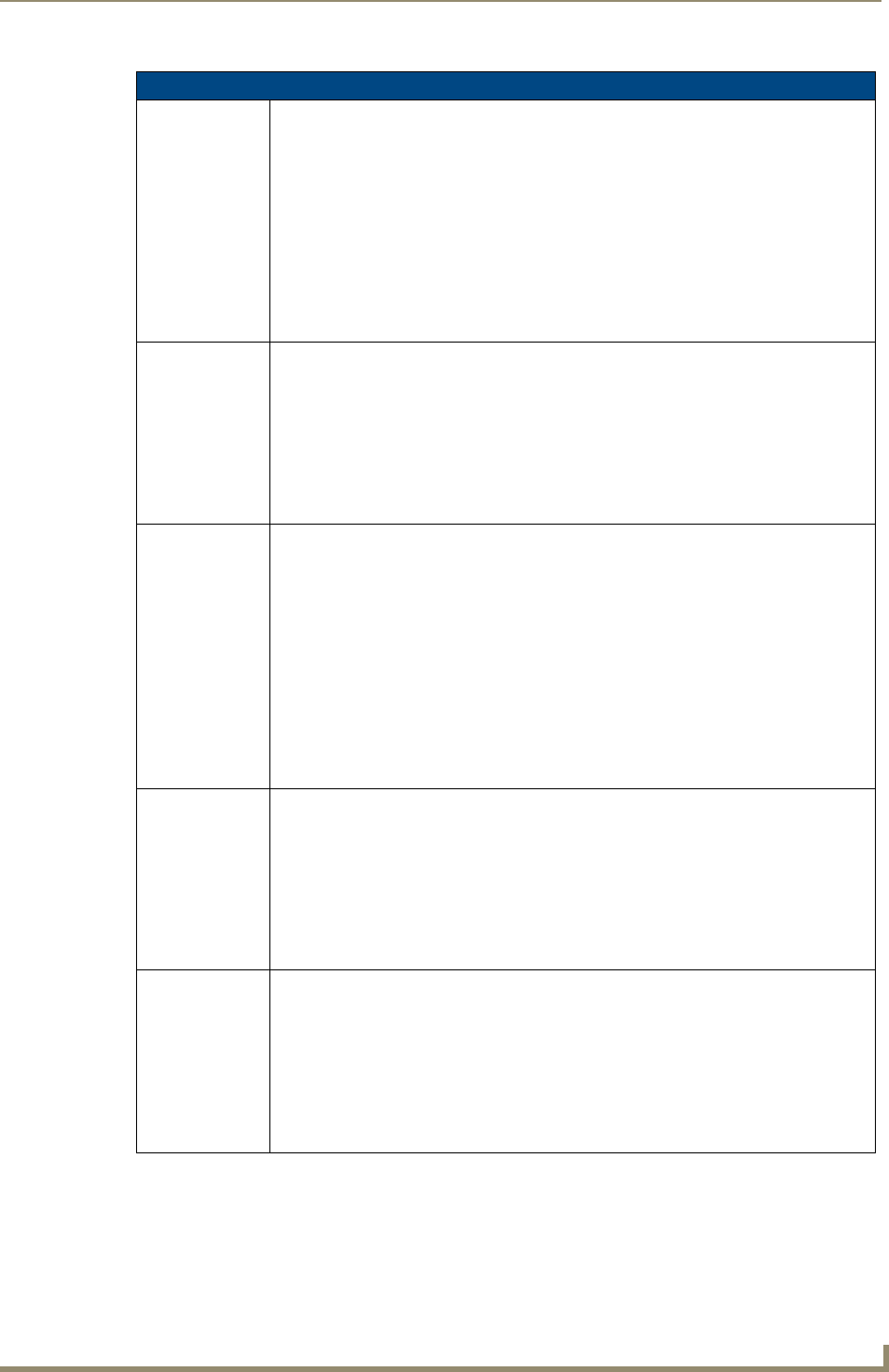
Programming
131
MVP-9000i Modero® Wireless Touch Panel with Intercom
"^" Button Commands (Cont.)
^BSF
Set the focus to
the text area.
Note: Select one button at a time (single variable text address). Do not assign a variable
text address range to set focus to multiple buttons. Only one variable text address can be
in focus at a time.
Syntax:
"'^BSF-<vt addr range>,<selection value>'"
Variable:
variable text address range = 1 - 4000.
selection value = Unselect = 0 and select = 1.
Example:
SEND_COMMAND Panel,"'^BSF-500,1'"
Sets the focus to the text area of the button.
^BSM
Submit text for
text area buttons.
This command causes the text areas to send their text as strings to the NetLinx Master.
Syntax:
"'^BSM-<vt addr range>'"
Variable:
variable text address range = 1 - 4000.
Example:
SEND_COMMAND Panel,"'^BSM-500'"
Submits the text of the text area button.
^BSO
Set the sound
played when a
button is pressed.
If the sound name is blank the sound is then cleared. If the sound name is not matched,
the button sound is not changed.
Syntax:
"'^BSO-<vt addr range>,<button states range>,<sound name>'"
Variable:
variable text address range = 1 - 4000.
button states range = 1 - 256 for multi-state buttons (0 = All states, for General buttons
1 = Off state and 2 = On state).
sound name = (blank - sound cleared, not matched - button sound not changed).
Example:
SEND_COMMAND Panel,"'^BSO-500,1&2,music.wav'"
Assigns the sound 'music.wav' to the button Off/On states.
^BVL
Log-On/Log-Off
the computer
control
connection.
Syntax:
"'^BVL-<vt addr range>,<connection>'"
Variable:
variable text address range = 1 - 4000.
connection = 0 (Log-Off connection) and 1 (Log-On connection).
Example:
SEND_COMMAND Panel,"'^BVL-500,0'"
Logs-off the computer control connection of the button.
^BVN
Set the computer
control remote
host for the
specified address.
Syntax:
SEND_COMMAND <DEV>,"'^BVN-<vt addr range>,<remote host>'"
Variables:
variable text address range = 1 - 4000.
remote host = 1 - 50 ASCII characters.
Example:
SEND_COMMAND Panel,"'^BVN-500,191.191.191.191'"
Sets the remote host to '191.191.191.191' for the specific computer control button.
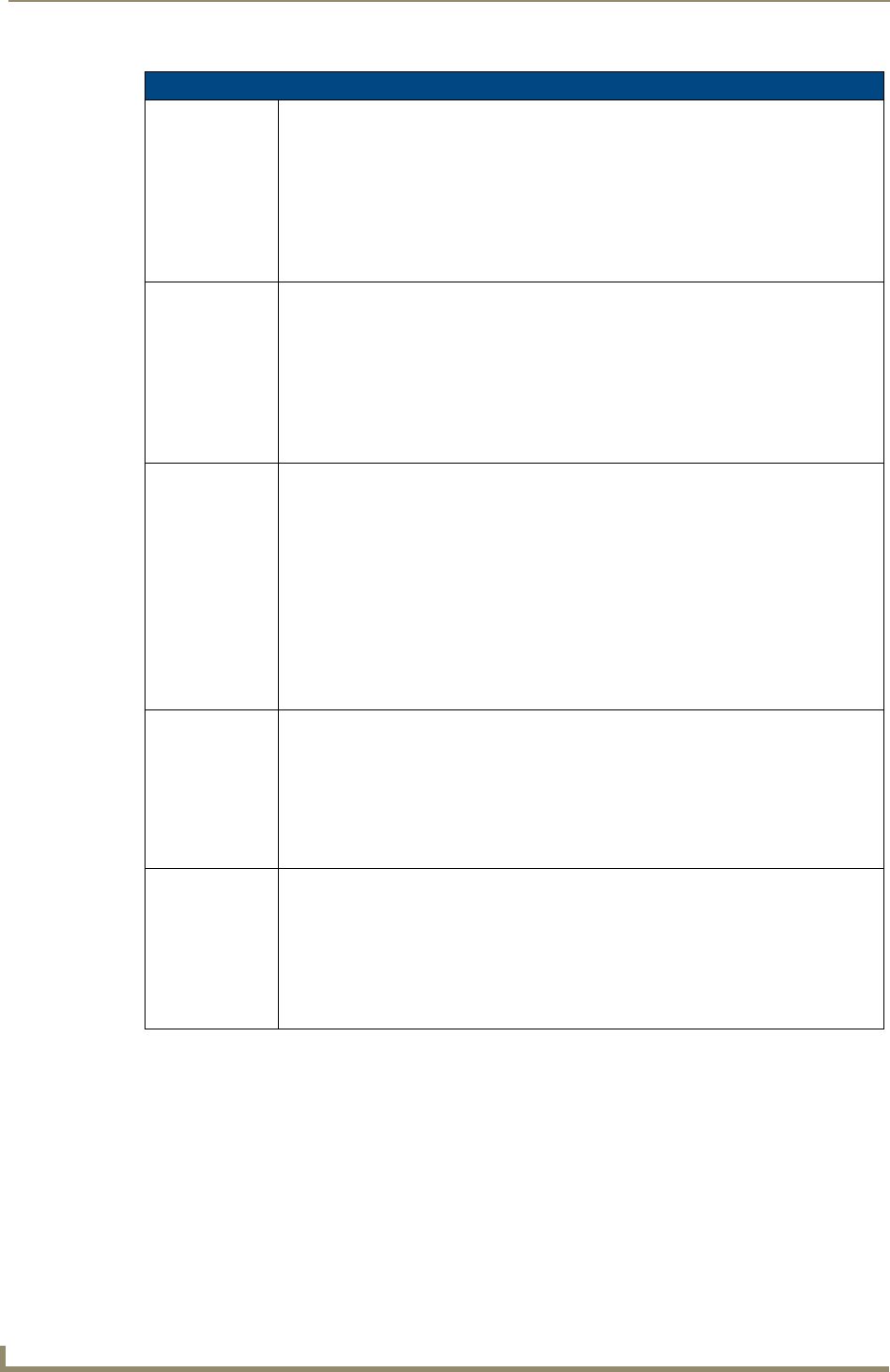
Programming
132 MVP-9000i Modero® Wireless Touch Panel with Intercom
"^" Button Commands (Cont.)
^BVP
Set the network
password for the
specified address.
Syntax:
"'^BVP-<vt addr range>,<network password>'"
Variable:
variable text address range = 1 - 4000.
network password = 1 - 50 ASCII characters.
Example:
SEND_COMMAND Panel,"'^BVP-500,PCLOCK'"
Sets the password to PCLOCK for the specific PC control button.
^BVT
Set the computer
control network
port for the
specified address.
Syntax:
"'^BVT-<vt addr range>,<network port>'"
Variable:
variable text address range = 1 - 4000.
network port = 1 - 65535.
Example:
SEND_COMMAND Panel,"'^BVT-500,5000'"
Sets the network port to 5000.
^BWW
Set the button
word wrap
feature to those
buttons with a
defined address
range.
By default, word-wrap is Off.
Syntax:
"'^BWW-<vt addr range>,<button states range>,<word wrap>'"
Variable:
variable text address range = 1 - 4000.
button states range = 1 - 256 for multi-state buttons (0 = All states, for General buttons
1 = Off state and 2 = On state).
word wrap = (0=Off and 1=On). Default is Off.
Example:
SEND_COMMAND Panel,"'^BWW-500,1,1'"
Sets the word wrap on for the button’s Off state.
^CPF
Clear all page flips
from a button.
Syntax:
"'^CPF-<vt addr range>'"
Variable:
variable text address range = 1 - 4000.
Example:
SEND_COMMAND Panel,"'^CPF-500'"
Clears all page flips from the button.
^DLD
Set the disable
cradle LED flag.
Syntax:
"'^DLD-<status>'"
Variable:
status = (0= cradle operates normally, 1= forces the cradle LEDs to always be dim).
Example:
SEND_COMMAND Panel,"'^DLD-1'"
Disables the cradle LEDs.
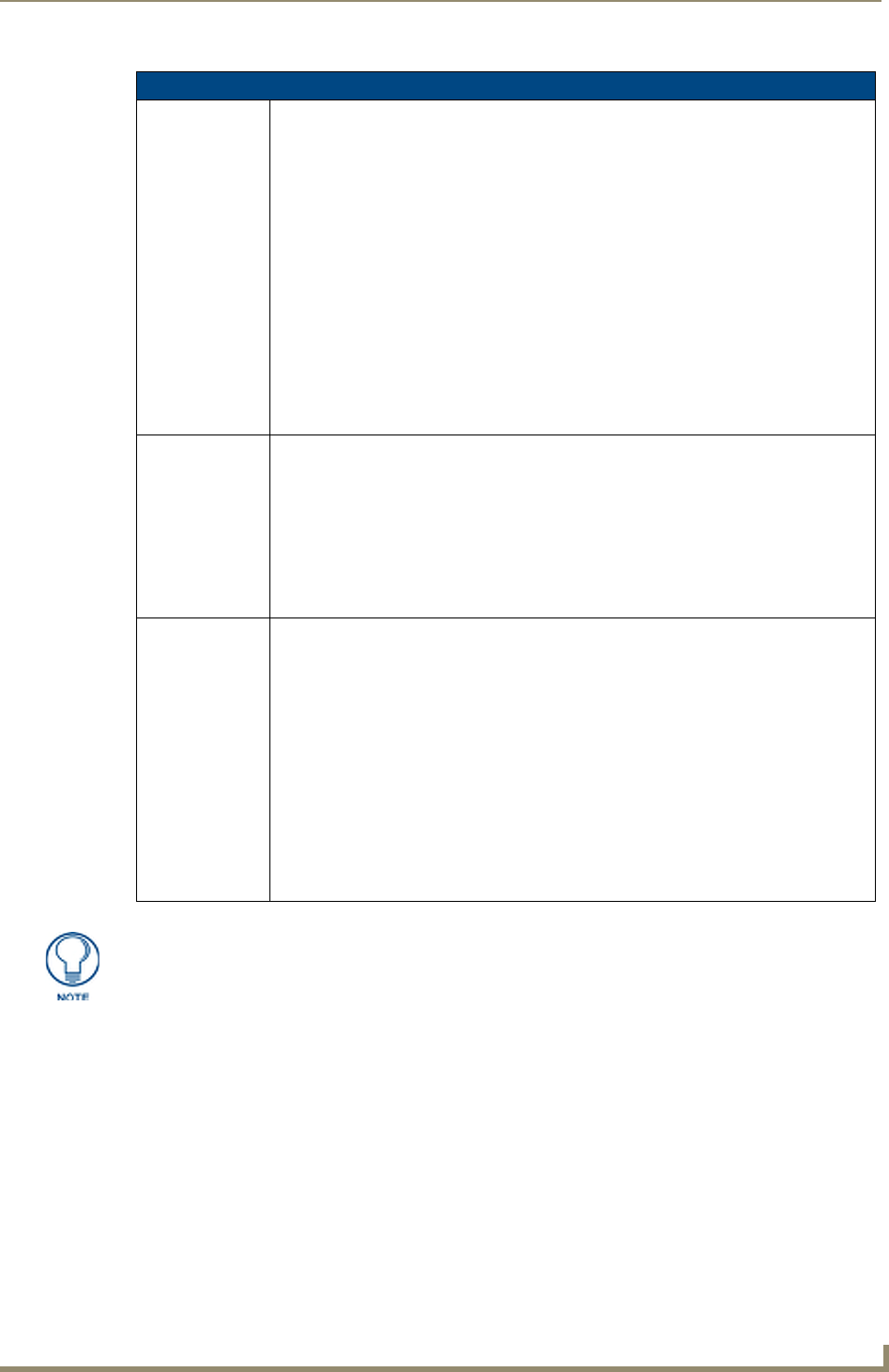
Programming
133
MVP-9000i Modero® Wireless Touch Panel with Intercom
"^" Button Commands (Cont.)
^DPF
Delete page flips
from button if it
already exists.
Syntax:
"'^DFP-<vt addr range>,<actions>,<page name>'"
Variable:
variable text address range = 1 - 4000.
actions =
Stan[dardPage] - Flip to standard page
Prev[iousPage] - Flip to previous page
Show[Popup] - Show Popup page
Hide[Popup] - Hide Popup page
Togg[lePopup] - Toggle popup state
ClearG[roup] - Clear popup page group from all pages
ClearP[age] - Clear all popup pages from a page with the specified page name
ClearA[ll] - Clear all popup pages from all pages
page name = 1 - 50 ASCII characters.
Example:
SEND COMMAND Panel,"'^DPF-409,Prev'"
Deletes the assignment of a button from flipping to a previous page.
^ENA
Enable or disable
buttons with a set
variable text
range.
Syntax:
"'^ENA-<vt addr range>,<command value>'"
Variable:
variable text address range = 1 - 4000.
command value = (0= disable, 1= enable)
Example:
SEND_COMMAND Panel,"'^ENA-500.504&510.515,0'"
Disables button pushes on buttons with variable text range 500-504 & 510-515.
^FON
Set a font to a
specific Font ID
value for those
buttons with a
defined address
range.
Font ID numbers are generated by the TPDesign4 programmers report.
Syntax:
"'^FON-<vt addr range>,<button states range>,<font value>'"
Variable:
variable text address range = 1 - 4000.
button states range = 1 - 256 for multi-state buttons (0 = All states, for General buttons
1 = Off state and 2 = On state).
font value = range = 1 - XXX. Refer to the Default Font Styles and ID Numbers section
on page 120.
Example:
SEND_COMMAND Panel,"'^FON-500.504&510.515,1&2,4'"
Sets the font size to font ID #4 for the On and Off states of buttons with the variable text
range of 500-504 & 510-515.
The Font ID is generated by TPD4 and is located in TPD4 through the Main menu.
Panel > Generate Programmer's Report >Text Only Format >Readme.txt.
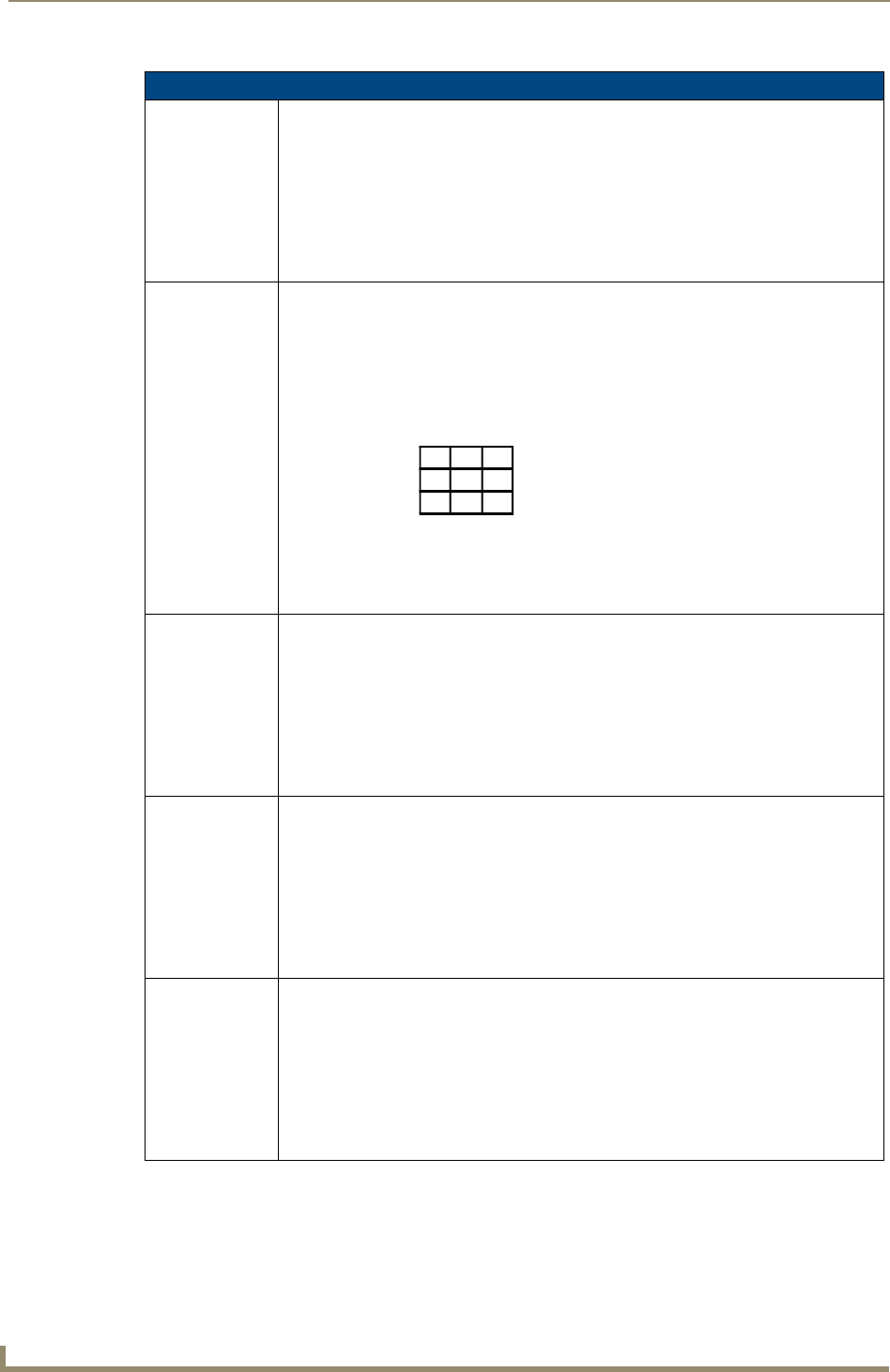
Programming
134 MVP-9000i Modero® Wireless Touch Panel with Intercom
"^" Button Commands (Cont.)
^GDI
Change the
bargraph drag
increment.
Syntax:
"'^GDI-<vt addr range>,<bargraph drag increment>'"
Variable:
variable text address range = 1 - 4000.
bargraph drag increment = The default drag increment is 256.
Example:
SEND_COMMAND Panel,"'^GDI-7,128'"
Sets the bargraph with variable text 7 to a drag increment of 128.
^GIV
Invert the joystick
axis to move the
origin to another
corner.
Parameters 1,2, and 3 will cause a bargraph or slider to be inverted regardless of
orientation. Their effect will be as described for joysticks.
Syntax:
"'^GIV-<vt addr range>,<joystick axis to invert>'"
Variable:
variable text address range = 1 - 4000.
joystick axis to invert = 0 - 3.
For a bargraph 1 = Invert, 0 = Non Invert
Example:
SEND_COMMAND Panel,"'^GIV-500,3'"
Inverts the joystick axis origin to the bottom right corner.
^GLH
Change the
bargraph upper
limit.
Syntax:
"'^GLH-<vt addr range>,<bargraph hi>'"
Variable:
variable text address range = 1 - 4000.
bargraph limit range = 1 - 65535 (bargraph upper limit range).
Example:
SEND_COMMAND Panel,"'^GLH-500,1000'"
Changes the bargraph upper limit to 1000.
^GLL
Change the
bargraph lower
limit.
Syntax:
"'^GLL-<vt addr range>,<bargraph low>'"
Variable:
variable text address range = 1 - 4000.
bargraph limit range = 1 - 65535 (bargraph lower limit range).
Example:
SEND_COMMAND Panel,"'^GLL-500,150'"
Changes the bargraph lower limit to 150.
^GRD
Change the
bargraph
ramp-down time
in 1/10th of a
second.
Syntax:
"'^GRD-<vt addr range>,<bargraph ramp down time>'"
Variable:
variable text address range = 1 - 4000.
bargraph ramp down time = In 1/10th of a second intervals.
Example:
SEND_COMMAND Panel,"'^GRD-500,200'"
Changes the bargraph ramp down time to 20 seconds.
0
23
11 = Invert horizontal axis
2 = Invert vertical axis
3 = Invert both axis locations
0 = Normal
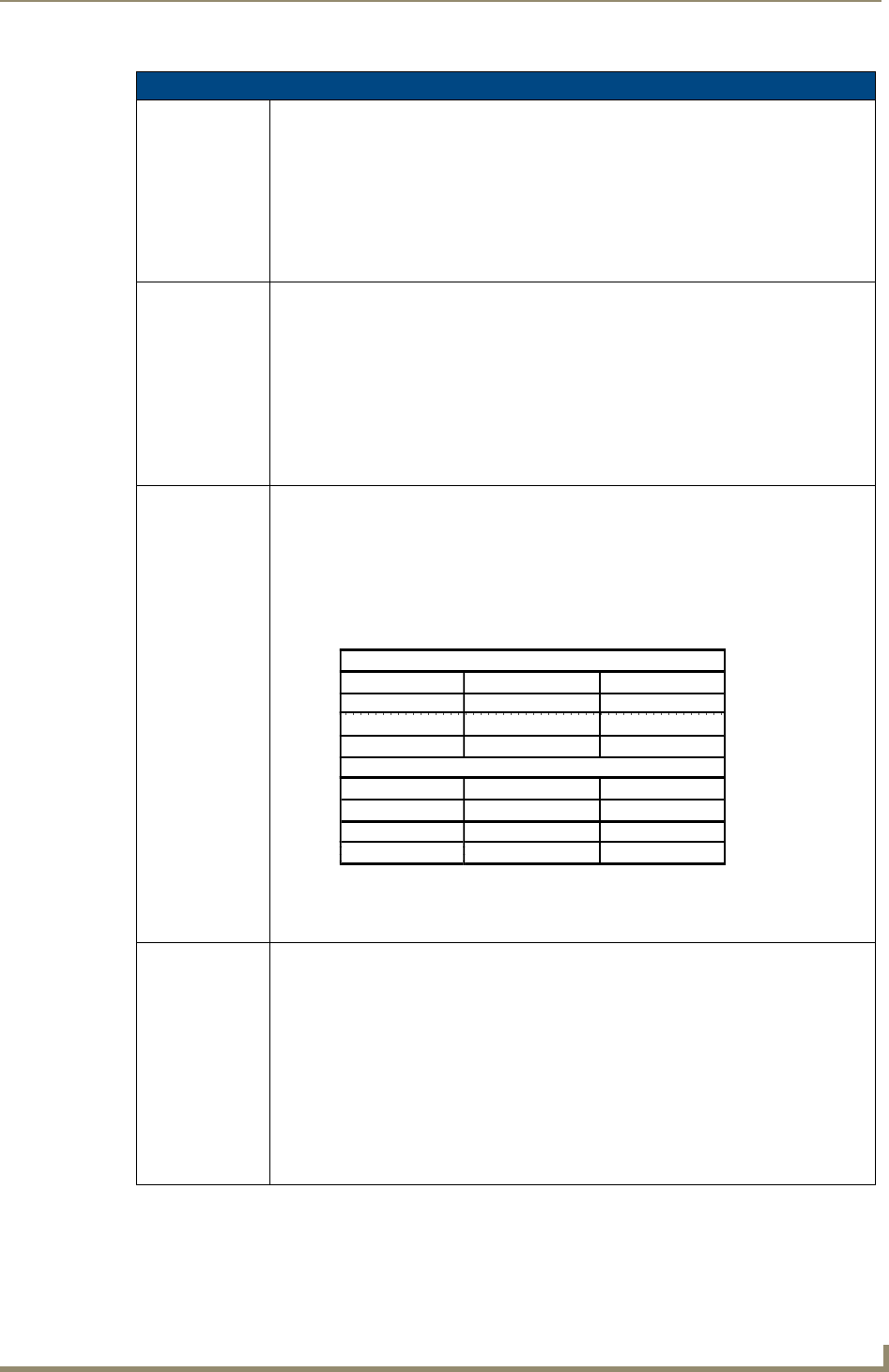
Programming
135
MVP-9000i Modero® Wireless Touch Panel with Intercom
"^" Button Commands (Cont.)
^GRU
Change the
bargraph
ramp-up time in
1/10th of a
second.
Syntax:
"'^GRU-<vt addr range>,<bargraph ramp up time>'"
Variable:
variable text address range = 1 - 4000.
bargraph ramp up time = In 1/10th of a second intervals.
Example:
SEND_COMMAND Panel,"'^GRU-500,100'"
Changes the bargraph ramp up time to 10 seconds.
^GSC
Change the
bargraph slider
color or joystick
cursor color.
A user can also assign the color by Name and R,G,B value (RRGGBB or RRGGBBAA).
Syntax:
"'^GSC-<vt addr range>,<color value>'"
Variable:
variable text address range = 1 - 4000.
color value = Refer to the RGB Values for all 88 Basic Colors table on page 118.
Example:
SEND_COMMAND Panel,"'^GSC-500,12'"
Changes the bargraph or joystick slider color to Yellow.
^GSN
Change the
bargraph slider
name or joystick
cursor name.
Slider names and cursor names can be found in the TPDesign4 slider name and cursor
drop-down list.
Syntax:
"'^GSN-<vt addr range>,<bargraph slider name>'"
Variable:
variable text address range = 1 - 4000.
bargraph slider name = See table below.
Example:
SEND_COMMAND Panel,"'^GSN-500,Ball'"
Changes the bargraph slider name or the Joystick cursor name to ’Ball’.
^ICO
Set the icon to a
button.
Syntax:
"'^ICO-<vt addr range>,<button states range>,<icon index>'"
Variable:
variable text address range = 1 - 4000.
button states range = 1 - 256 for multi-state buttons (0 = All states, for General buttons
1 = Off state and 2 = On state).
icon index range = 0 - 9900 (a value of 0 is clear).
Example:
SEND_COMMAND Panel,"'^ICO-500.504&510.515,1&2,1'"
Sets the icon for On and Off states for buttons with variable text ranges of 500-504 &
510-515.
Bargraph Slider Names:
Circle -M
None
Circle -S
Ball
Precision
Circle -L
Rectangle -L Rectangle -M Rectangle -S
Windows Windows Active
Joystick Cursor Names:
Circl e
No ne
Crossh airs
Arrow
Gunsight
Ball
Ha nd M eta l Spi ra l
Ta rget View Finder
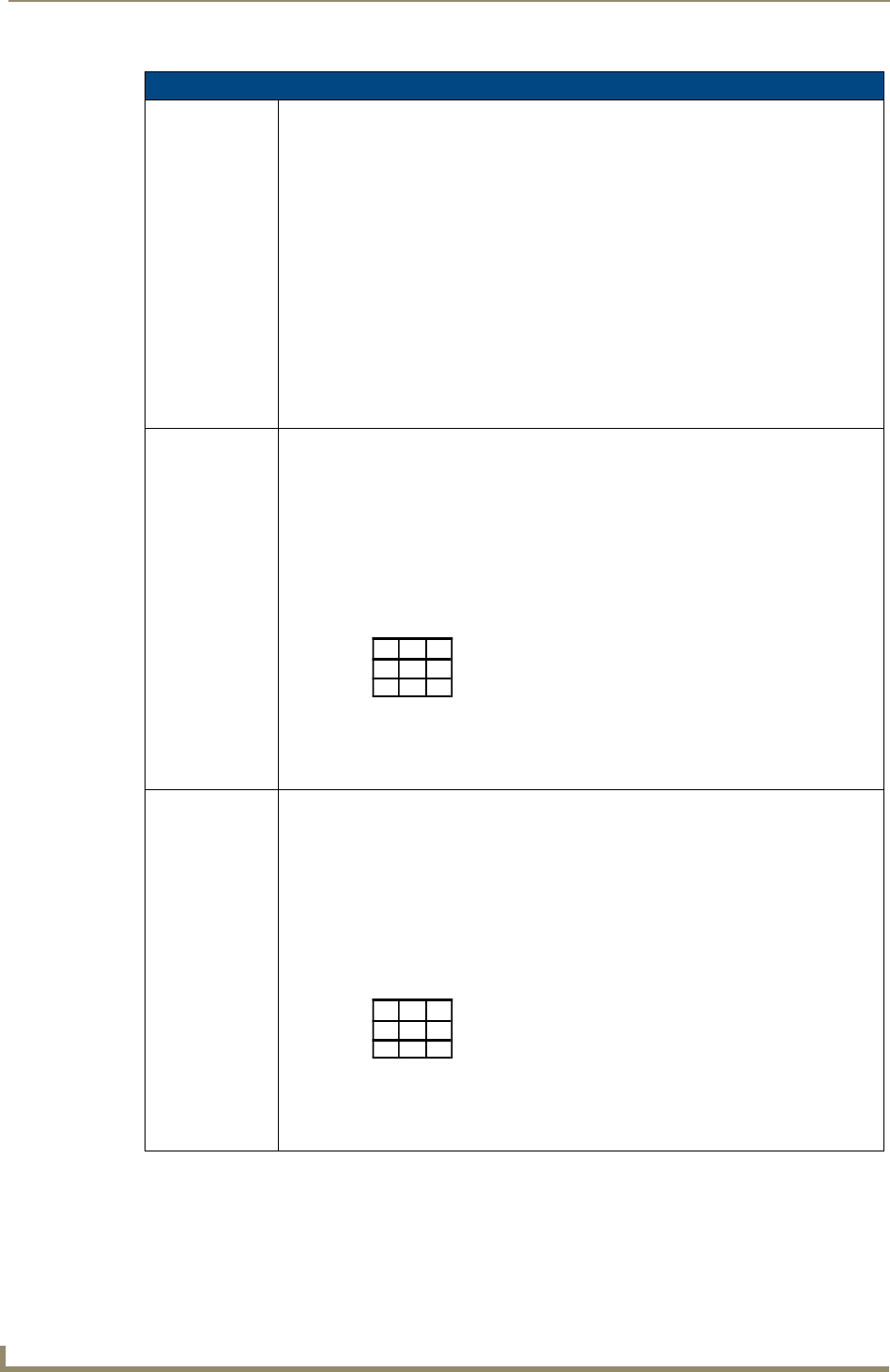
Programming
136 MVP-9000i Modero® Wireless Touch Panel with Intercom
"^" Button Commands (Cont.)
^IRM
Set the IR
channel.
Pulse the given IR channel for onTime in tenths of seconds. Delay offTime in tenths of a
second before the next IR pulse is allowed. ^IRM allows the command itself to specify the
port number. ^IRM is needed because commands programmed on the panel itself can
only be sent to a single port number. (currently this is defined as 1 only).
Note: The port number of the IR will be the port number assigned in TPD4.
Syntax:
"'^IRM-<port>,<channel>,<onTime>,<offTime>'"
Variable:
port = User-defined port on the device (panel).
channel = 1 - 255 (channel to pulse).
onTime = 1/10th of a second.
offTime = 1/10th of a second.
Example:
SEND_COMMAND Panel,"'^IRM-10,5, 20, 10'"
Sets the port 10 IR channel 5 on time to 1 second and off time to 2 seconds.
^JSB
Set bitmap/
picture alignment
using a numeric
keypad layout for
those buttons with
a defined address
range.
The alignment of 0 is followed by ',<left>,<top>'. The left and top coordinates are relative
to the upper left corner of the button.
Syntax:
"'^JSB-<vt addr range>,<button states range>,<new text alignment>'"
Variable:
variable text address range = 1 - 4000.
button states range = 1 - 256 for multi-state buttons (0 = All states, for General buttons
1 = Off state and 2 = On state).
new text alignment = Value of 1- 9 corresponds to the following locations:
Example:
SEND_COMMAND Panel,"'^JSB-500.504&510.515,1&2,1'"
Sets the off/on state picture alignment to upper left corner for those buttons with variable
text ranges of 500-504 & 510-515.
^JSI
Set icon
alignment using a
numeric keypad
layout for those
buttons with a
defined address
range.
The alignment of 0 is followed by ',<left>,<top>'. The left and top coordinates are relative
to the upper left corner of the button.
Syntax:
"'^JSI-<vt addr range>,<button states range>,<new icon alignment>'"
Variable:
variable text address range = 1 - 4000.
button states range = 1 - 256 for multi-state buttons (0 = All states, for General buttons
1 = Off state and 2 = On state).
new icon alignment = Value of 1 - 9 corresponds to the following locations:
Example:
SEND_COMMAND Panel,"'^JSI-500.504&510.515,1&2,1'"
Sets the Off/On state icon alignment to upper left corner for those buttons with variable
text range of 500-504 & 510-515.
1
4
789
6
32
5
0
Zero can be used for an absolute position
1
4
789
6
32
5
0
Zero can be use d for an ab solute positio n
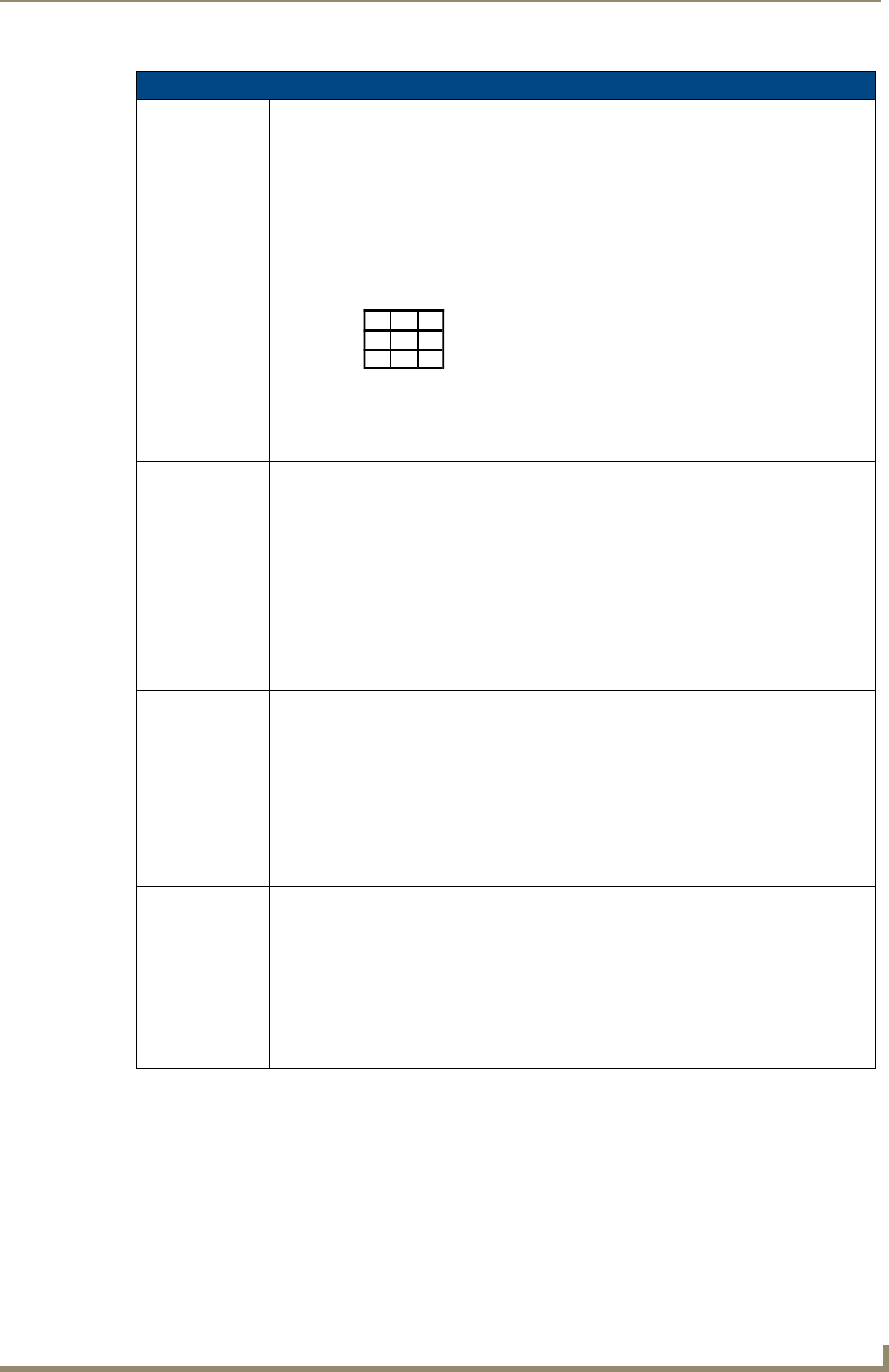
Programming
137
MVP-9000i Modero® Wireless Touch Panel with Intercom
"^" Button Commands (Cont.)
^JST
Set text
alignment using a
numeric keypad
layout for those
buttons with a
defined address
range.
The alignment of 0 is followed by ',<left>,<top>'. The left and top coordinates are relative
to the upper left corner of the button.
Syntax:
"'^JST-<vt addr range>,<button states range>,<new text alignment>'"
Variable:
variable text address range = 1 - 4000.
button states range = 1 - 256 for multi-state buttons (0 = All states, for General buttons
1 = Off state and 2 = On state).
new text alignment = Value of 1 - 9 corresponds to the following locations:
Example:
SEND_COMMAND Panel,"'^JST-500.504&510.515,1&2,1'"
Sets the text alignment to the upper left corner for those buttons with variable text ranges
of 500-504 & 510-515.
^MBT
Set the Mouse
Button mode On
for the virtual PC.
Syntax:
"'^MBT-<pass data>'"
Variable:
pass data:
0 = None
1 = Left
2 = Right
3 = Middle
Example:
SEND COMMAND Panel,"'^MBT-1'"
Sets the mouse button mode to ’Left Mouse Click’.
^MDC
Turn On the
’Mouse
double-click’
feature for the
virtual PC.
Syntax:
"'^MDC'"
Example:
SEND COMMAND Panel,"'^MDC'"
Sets the mouse double-click for use with the virtual PC.
^PIC
Start/stop Picture
View
Syntax:
^PIC-<0=stop,1=start>
Starts and stops Picture View.
^SHO
Show or hide a
button with a set
variable text
range.
Syntax:
"'^SHO-<vt addr range>,<command value>'"
Variable:
variable text address range = 1 - 4000.
command value = (0= hide, 1= show).
Example:
SEND_COMMAND Panel,"'^SHO-500.504&510.515,0'"
Hides buttons with variable text address range 500-504 & 510-515.
1
4
789
6
32
5
0
Zero can be use d for an ab solute positio n

Programming
138 MVP-9000i Modero® Wireless Touch Panel with Intercom
"^" Button Commands (Cont.)
^TEC
Set the text effect
color for the
specified
addresses/states
to the specified
color.
The Text Effect is specified by name and can be found in TPD4. You can also assign the
color by name or RGB value (RRGGBB or RRGGBBAA).
Syntax:
"'^TEC-<vt addr range>,<button states range>,<color value>'"
Variable:
variable text address range = 1 - 4000.
button states range = 1 - 256 for multi-state buttons (0 = All states, for General buttons
1 = Off state and 2 = On state).
color value = Refer to the RGB Values for all 88 Basic Colors table on page 118.
Example:
SEND_COMMAND Panel,"'^TEC-500.504&510.515,1&2,12'"
Sets the text effect color to Very Light Yellow on buttons with variable text 500-504
and 510-515.
^TEF
Set the text effect.
The Text Effect is specified by name and can be found in TPD4.
Syntax:
"'^TEF-<vt addr range>,<button states range>,<text effect name>'"
Variable:
variable text address range = 1 - 4000.
button states range = 1 - 256 for multi-state buttons (0 = All states, for General buttons
1 = Off state and 2 = On state).
text effect name = Refer to the Text Effects table on page 141 for a listing of text effect
names.
Example:
SEND_COMMAND Panel,"'^TEF-500.504&510.515,1&2,Soft Drop Shadow 3'"
Sets the text effect to Soft Drop Shadow 3 for the button with variable text range 500-504
and 510-515.
^TXT
Assign a text
string to those
buttons with a
defined address
range.
Sets Non-Unicode text.
Syntax:
"'^TXT-<vt addr range>,<button states range>,<new text>'"
Variable:
variable text address range = 1 - 4000.
button states range = 1 - 256 for multi-state buttons (0 = All states, for General buttons
1 = Off state and 2 = On state).
new text = 1 - 50 ASCII characters.
Example:
SEND_COMMAND Panel,"'^TXT-500.504&510.515,1&2,Test Only'"
Sets the On and Off state text for buttons with the variable text ranges of
500-504 & 510-515.

Programming
139
MVP-9000i Modero® Wireless Touch Panel with Intercom
"^" Button Commands (Cont.)
^UNI
Set Unicode text.
For the ^UNI command (%UN and ^BMF command), the Unicode text is sent as
ASCII-HEX nibbles.
Syntax:
"'^UNI-<vt addr range>,<button states range>,<unicode text>'"
Variable:
variable text address range = 1 - 4000.
button states range = 1 - 256 for multi-state buttons (0 = All states, for General buttons
1 = Off state and 2 = On state).
unicode text = Unicode HEX value.
Example:
SEND_COMMAND Panel,"'^UNI-500,1,0041'"
Sets the button’s unicode character to ’A’.
Note: To send the variable text ’A’ in unicode to all states of the variable text
button 1, (for which the character code is 0041 Hex), send the following command:
SEND_COMMAND TP,"'^UNI-1,0,0041'"
Note: Unicode is always represented in a HEX value. TPD4 generates (through the Text
Enter Box dialog) unicode HEX values. Refer to the TPDesign4 Instruction Manual for
more information.
^WLD
Controls the
behavior of the
panel LED
Syntax:
^WLD,<LED NUM>,<ACTION>,<VALUE>
Variables:
<LED NUM> indicates the channel code or ID number.
0-RED
1-BLUE
2-GREEN
<ACTION> indicates the expected behavior of the LED.
0 - LED OFF Turns LED Off
1 - LED ON Turns LED On
2 - LED Resume Restores operation of LED.
3 - LOW BRIGHTNESS Sets the low brightness value for LED when operating on
battery.
4 - HIGH BRIGHNESS Sets the high brightness value for LED when operating on
external power or docked.
5 - En/Disable Blink Enable LED blinking
6 - En/Disable Fade Transitions from high/low are smooth
7 - Set Color Set the tri-color (MVP9000i) LED to one of the supported NetLinx colors
(Yellow, Orange, VeryLightCyan, etc…)
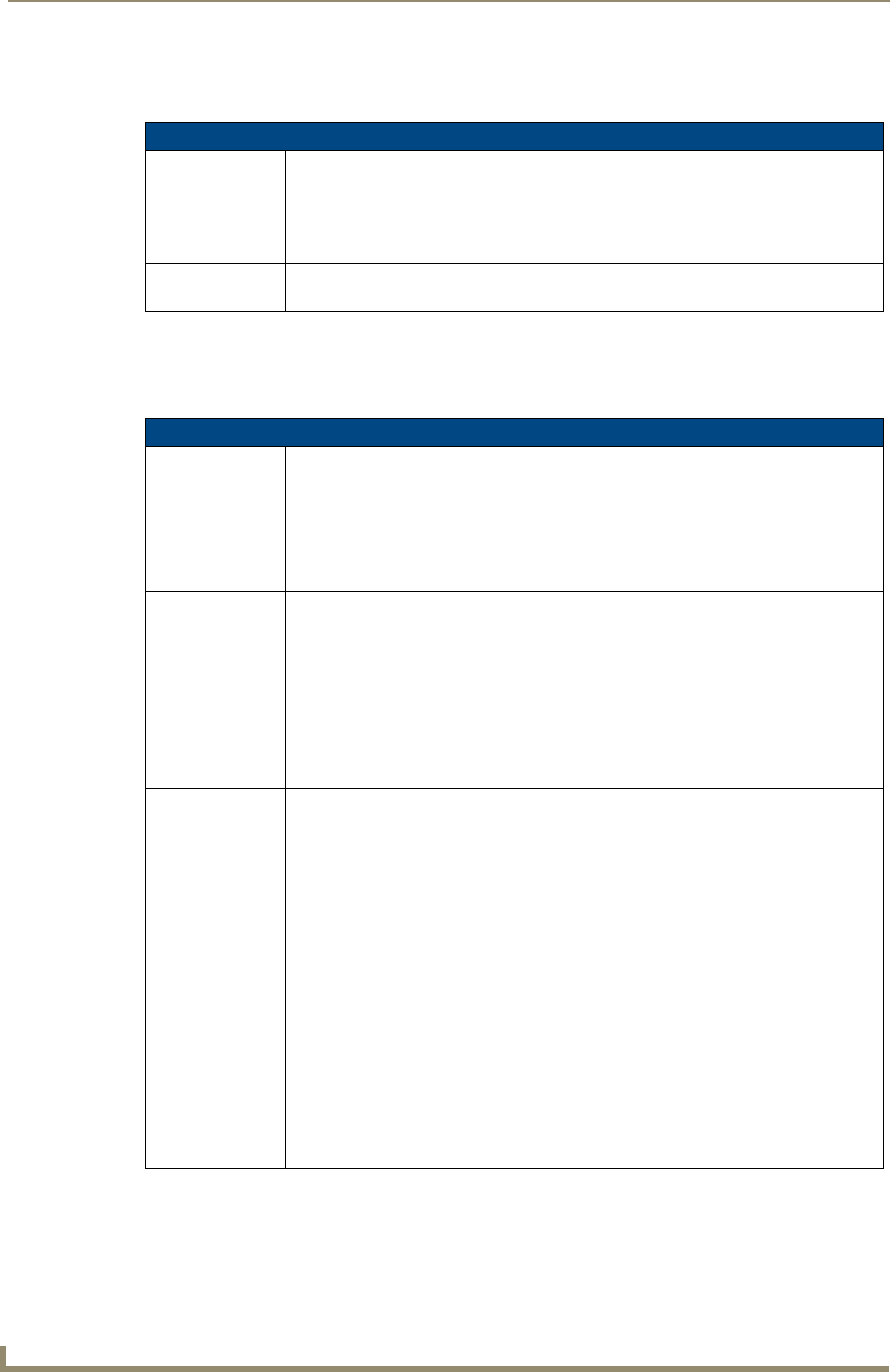
Programming
140 MVP-9000i Modero® Wireless Touch Panel with Intercom
Miscellaneous MVP Strings
The following two strings are sent by the MVP panel back to the communicating Master:
MVP Panel Lock Passcode Commands
These commands are used to maintain a passcode list. With the MVP-9000i, a password must be entered to
remove the panel from the Wall Docking Station. Only the passcode is entered. The user entry is just for
identifying the passcodes.
MVP Strings to Master
undock <master> This is sent to the target Master when the MVP is undocked.
• If the panel has no information within the User Access Passwords list, ’none’ is sent as
a user.
• If the undock button on the Protected Setup page is used, ’setup’ is sent as a user.
• This string can be disabled from within the firmware setup pages.
dock • This is sent to the target Master when the MVP is docked.
• This string can be disabled from within the firmware setup pages.
MVP Panel Lock Passcode Commands
^LPC
Clear all
users from the
User Access
Passwords list on
the Password
Setup page.
Syntax:
"'^LPC'"
Example:
SEND_COMMAND Panel,"'^LPC'"
Clear all users from the User Access Password list on the Password Setup page.
Refer to the section on page 89 for more information.
^LPR
Remove a given
user from the User
Access
Passwords list on
the Password
Setup page.
Syntax:
"'^LPR-<user>'"
Variable:
user = 1 - 50 ASCII characters.
Example:
SEND_COMMAND Panel,"'^LPR-Robert'"
Remove user named ’Robert’ from the User Access Password list on the Password
Setup page. Refer to the section on page 89 for more
information.
^LPS
Set the user name
and password.
This command allows you to:
1. Add a new user name and password OR
2. Set the password for a given user.
The user name and password combo is added to the User Access and/or Password list
in the Password Setup page. The user name must be alphanumeric.
Syntax:
"'^LPS-<user>,<passcode>'"
Variable:
user = 1 - 50 ASCII characters.
passcode = 1 - 50 ASCII characters.
Example:
SEND_COMMAND Panel,"'^LPS-Manager,undock'"
Sets a new user name as "Manager" and the password to "undock".
Example 2:
SEND_COMMAND Panel,"'^LPS-Manager,test'"
Changes the given user name password to "test".
Refer to the section on page 89 for more information.
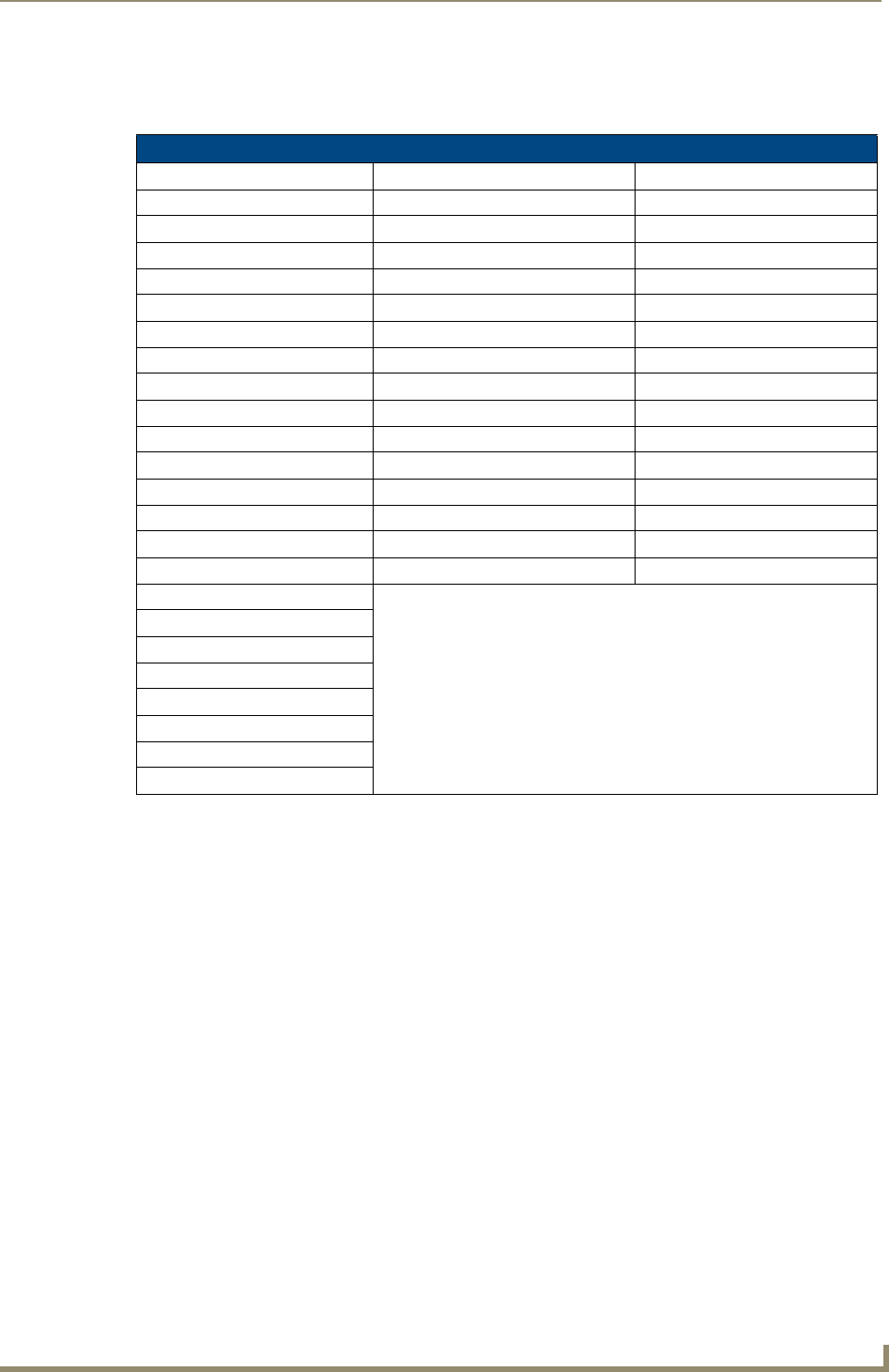
Programming
141
MVP-9000i Modero® Wireless Touch Panel with Intercom
Text Effects Names
The following is a listing of text effects names associated with the ^TEF command on page 138.
Button Query Commands
Button Query commands reply back with a custom event. There will be one custom event for each button/state
combination. Each query is assigned a unique custom event type. The following example is for debug
purposes only:
NetLinx Example: CUSTOM_EVENT[device, Address, Custom event type]
DEFINE_EVENT
CUSTOM_EVENT[TP,529,1001] // Text
CUSTOM_EVENT[TP,529,1002] // Bitmap
CUSTOM_EVENT[TP,529,1003] // Icon
CUSTOM_EVENT[TP,529,1004] // Text Justification
CUSTOM_EVENT[TP,529,1005] // Bitmap Justification
CUSTOM_EVENT[TP,529,1006] // Icon Justification
CUSTOM_EVENT[TP,529,1007] // Font
CUSTOM_EVENT[TP,529,1008] // Text Effect Name
CUSTOM_EVENT[TP,529,1009] // Text Effect Color
CUSTOM_EVENT[TP,529,1010] // Word Wrap
CUSTOM_EVENT[TP,529,1011] // ON state Border Color
CUSTOM_EVENT[TP,529,1012] // ON state Fill Color
CUSTOM_EVENT[TP,529,1013] // ON state Text Color
CUSTOM_EVENT[TP,529,1014] // Border Name
CUSTOM_EVENT[TP,529,1015] // Opacity
Text Effects
• Glow -S • Medium Drop Shadow 1 • Hard Drop Shadow 1
• Glow -M • Medium Drop Shadow 2 • Hard Drop Shadow 2
• Glow -L • Medium Drop Shadow 3 • Hard Drop Shadow 3
• Glow -X • Medium Drop Shadow 4 • Hard Drop Shadow 4
• Outline -S • Medium Drop Shadow 5 • Hard Drop Shadow 5
• Outline -M • Medium Drop Shadow 6 • Hard Drop Shadow 6
• Outline -L • Medium Drop Shadow 7 • Hard Drop Shadow 7
• Outline -X • Medium Drop Shadow 8 • Hard Drop Shadow 8
• Soft Drop Shadow 1 • Medium Drop Shadow 1 with outline • Hard Drop Shadow 1 with outline
• Soft Drop Shadow 2 • Medium Drop Shadow 2 with outline • Hard Drop Shadow 2 with outline
• Soft Drop Shadow 3 • Medium Drop Shadow 3 with outline • Hard Drop Shadow 3 with outline
• Soft Drop Shadow 4 • Medium Drop Shadow 4 with outline • Hard Drop Shadow 4 with outline
• Soft Drop Shadow 5 • Medium Drop Shadow 5 with outline • Hard Drop Shadow 5 with outline
• Soft Drop Shadow 6 • Medium Drop Shadow 6 with outline • Hard Drop Shadow 6 with outline
• Soft Drop Shadow 7 • Medium Drop Shadow 7 with outline • Hard Drop Shadow 7 with outline
• Soft Drop Shadow 8 • Medium Drop Shadow 8 with outline • Hard Drop Shadow 8 with outline
• Soft Drop Shadow 1 with outline
• Soft Drop Shadow 2 with outline
• Soft Drop Shadow 3 with outline
• Soft Drop Shadow 4 with outline
• Soft Drop Shadow 5 with outline
• Soft Drop Shadow 6 with outline
• Soft Drop Shadow 7 with outline
• Soft Drop Shadow 8 with outline
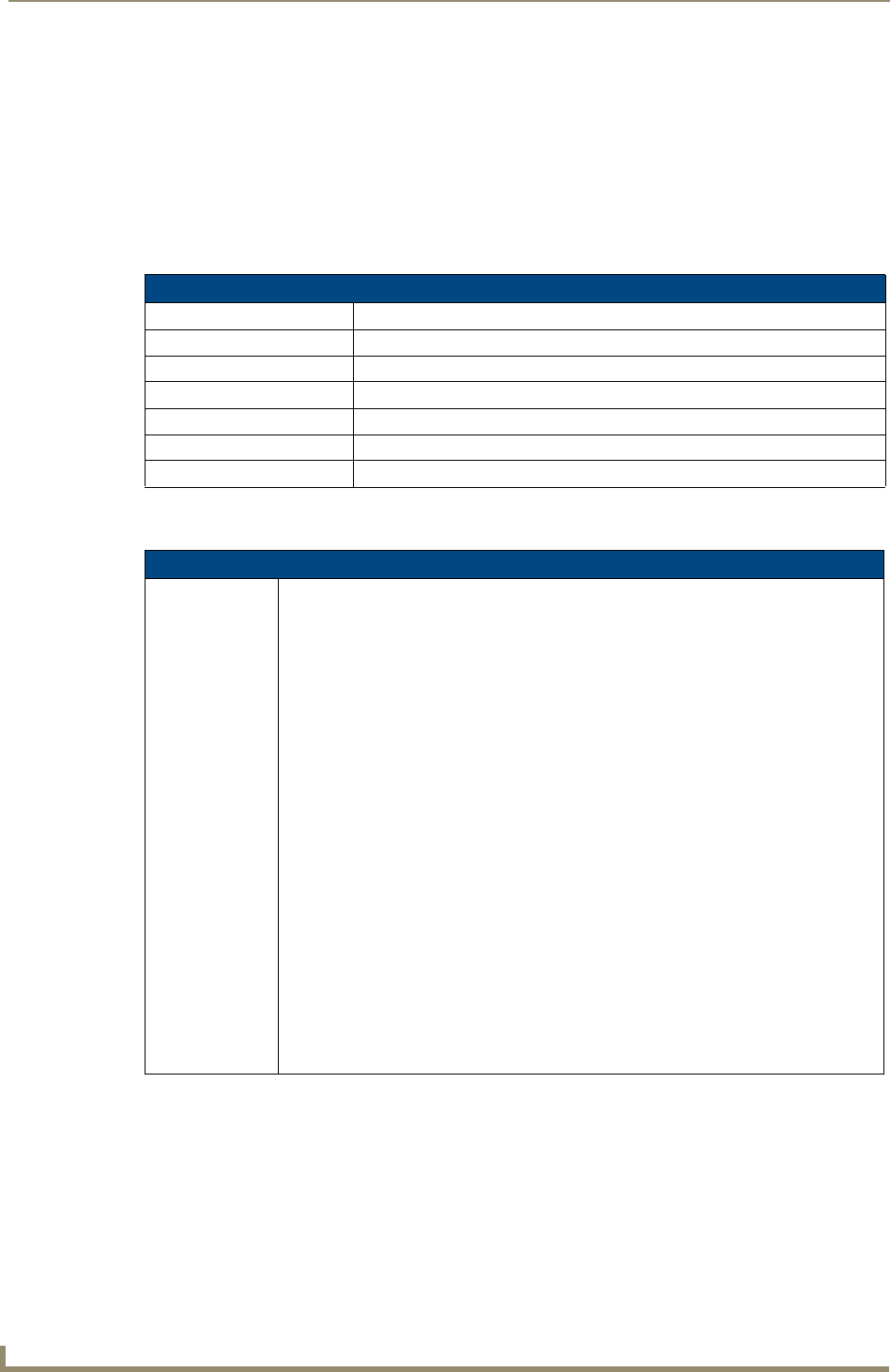
Programming
142 MVP-9000i Modero® Wireless Touch Panel with Intercom
{
Send_String 0,"'ButtonGet Id=',ITOA(CUSTOM.ID),' Type=',ITOA(CUSTOM.TYPE)"
Send_String 0,"'Flag =',ITOA(CUSTOM.FLAG)"
Send_String 0,"'VALUE1 =',ITOA(CUSTOM.VALUE1)"
Send_String 0,"'VALUE2 =',ITOA(CUSTOM.VALUE2)"
Send_String 0,"'VALUE3 =',ITOA(CUSTOM.VALUE3)"
Send_String 0,"'TEXT =',CUSTOM.TEXT"
Send_String 0,"'TEXT LENGTH =',ITOA(LENGTH_STRING(CUSTOM.TEXT))"
}
All custom events have the following 7 fields:
These fields are populated differently for each query command. The text length (String Encode) field is not
used in any command.
Custom Event Fields
Field Description
Uint Flag 0 means text is a standard string, 1 means Unicode encoded string
slong value1 button state number
slong value2 actual length of string (this is not encoded size)
slong value3 index of first character (usually 1 or same as optional index
string text the text from the button
text length (string encode) button text length
Button Query Commands
?BCB
Get the current
border color.
Syntax:
"'?BCB-<vt addr range>,<button states range>'"
Variable:
variable text address range = 1 - 4000.
button states range = 1 - 256 for multi-state buttons (0 = All states, for General buttons
1 = Off state and 2 = On state).
custom event type 1011:
Flag - zero
Value1 - Button state number
Value2 - Actual length of string (should be 9)
Value3 - Zero
Text - Hex encoded color value (ex: #000000FF)
Text length - Color name length (should be 9)
Example:
SEND COMMAND Panel,"'?BCB-529,1'"
Gets the button 'OFF state' border color. information.
The result sent to the Master would be:
ButtonGet Id = 529 Type = 1011
Flag = 0
VALUE1 = 1
VALUE2 = 9
VALUE3 = 0
TEXT = #222222FF
TEXT LENGTH = 9

Programming
143
MVP-9000i Modero® Wireless Touch Panel with Intercom
Button Query Commands (Cont.)
?BCF
Get the current fill
color.
Syntax:
"'?BCF-<vt addr range>,<button states range>'"
Variable:
variable text address range = 1 - 4000.
button states range = 1 - 256 for multi-state buttons (0 = All states, for General buttons
1 = Off state and 2 = On state).
custom event type 1012:
Flag - Zero
Value1 - Button state number
Value2 - Actual length of string (should be 9)
Value3 - Zero
Text - Hex encoded color value (ex: #000000FF)
Text length - Color name length (should be 9)
Example:
SEND COMMAND Panel,"'?BCF-529,1'"
Gets the button 'OFF state' fill color information.
The result sent to the Master would be:
ButtonGet Id = 529 Type = 1012
Flag = 0
VALUE1 = 1
VALUE2 = 9
VALUE3 = 0
TEXT = #FF8000FF
TEXT LENGTH = 9
?BCT
Get the current
text color.
Syntax:
"'?BCT-<vt addr range>,<button states range>'"
Variable:
variable text address range = 1 - 4000.
button states range = 1 - 256 for multi-state buttons (0 = All states, for General buttons
1 = Off state and 2 = On state).
custom event type 1013:
Flag - Zero
Value1 - Button state number
Value2 - Actual length of string (should be 9)
Value3 - Zero
Text - Hex encoded color value (ex: #000000FF)
Text length - Color name length (should be 9)
Example:
SEND COMMAND Panel,"'?BCT-529,1'"
Gets the button 'OFF state' text color information.
The result sent to Master would be:
ButtonGet Id = 529 Type = 1013
Flag = 0
VALUE1 = 1
VALUE2 = 9
VALUE3 = 0
TEXT = #FFFFFEFF
TEXT LENGTH = 9

Programming
144 MVP-9000i Modero® Wireless Touch Panel with Intercom
Button Query Commands (Cont.)
?BMP
Get the current
bitmap name.
Syntax:
"'?BMP-<vt addr range>,<button states range>'"
Variable:
variable text address range = 1 - 4000.
button states range = 1 - 256 for multi-state buttons (0 = All states, for General buttons
1 = Off state and 2 = On state).
custom event type 1002:
Flag - Zero
Value1 - Button state number
Value2 - Actual length of string
Value3 - Zero
Text - String that represents the bitmap name
Text length - Bitmap name text length (should be 9)
Example:
SEND COMMAND Panel,"'?BMP-529,1'"
Gets the button 'OFF state' bitmap information.
The result sent to the Master would be:
ButtonGet Id = 529 Type = 1002
Flag = 0
VALUE1 = 1
VALUE2 = 9
VALUE3 = 0
TEXT = Buggs.png
TEXT LENGTH = 9
?BOP
Get the overall
button opacity.
Syntax:
"'?BOP-<vt addr range>,<button states range>'"
Variable:
variable text address range = 1 - 4000.
button states range = 1 - 256 for multi-state buttons (0 = All states, for General buttons
1 = Off state and 2 = On state).
custom event type 1015:
Flag - Zero
Value1 - Button state number
Value2 - Opacity
Value3 - Zero
Text - Blank
Text length - Zero
Example:
SEND COMMAND Panel,"'?BOP-529,1'"
Gets the button 'OFF state' opacity information.
The result sent to the Master would be:
ButtonGet Id = 529 Type = 1015
Flag = 0
VALUE1 = 1
VALUE2 = 200
VALUE3 = 0
TEXT =
TEXT LENGTH = 0

Programming
145
MVP-9000i Modero® Wireless Touch Panel with Intercom
Button Query Commands (Cont.)
?BRD
Get the current
border name.
Syntax:
"'?BRD-<vt addr range>,<button states range>'"
Variable:
variable text address range = 1 - 4000.
button states range = 1 - 256 for multi-state buttons (0 = All states, for General buttons
1 = Off state and 2 = On state).
custom event type 1014:
Flag - Zero
Value1 - Button state number
Value2 - Actual length of string
Value3 - Zero
Text - String that represents border name
Text length - Border name length
Example:
SEND COMMAND Panel,"'?BRD-529,1'"
Gets the button 'OFF state' border information.
The result sent to the Master would be:
ButtonGet Id = 529 Type = 1014
Flag = 0
VALUE1 = 1
VALUE2 = 22
VALUE3 = 0
TEXT = Double Bevel Raised -L
TEXT LENGTH = 22
?BWW
Get the current
word wrap flag
status.
Syntax:
"'?BWW-<vt addr range>,<button states range>'"
Variable:
variable text address range = 1 - 4000.
button states range = 1 - 256 for multi-state buttons (0 = All states, for General buttons
1 = Off state and 2 = On state).
custom event type 1010:
Flag - Zero
Value1 - Button state number
Value2 - 0 = no word wrap, 1 = word wrap
Value3 - Zero
Text - Blank
Text length - Zero
Example:
SEND COMMAND Panel,"'?BWW-529,1'"
Gets the button 'OFF state' word wrap flag status information.
The result sent to the Master would be:
ButtonGet Id = 529 Type = 1010
Flag = 0
VALUE1 = 1
VALUE2 = 1
VALUE3 = 0
TEXT =
TEXT LENGTH = 0

Programming
146 MVP-9000i Modero® Wireless Touch Panel with Intercom
Button Query Commands (Cont.)
?FON
Get the current
font index.
Syntax:
"'?FON-<vt addr range>,<button states range>'"
Variable:
variable text address range = 1 - 4000.
button states range = 1 - 256 for multi-state buttons (0 = All states, for General buttons
1 = Off state and 2 = On state).
custom event type 1007:
Flag - Zero
Value1 - Button state number
Value2 - Font index
Value3 - Zero
Text - Blank
Text length - Zero
Example:
SEND COMMAND Panel,"'?FON-529,1'"
Gets the button 'OFF state' font type index information.
The result sent to the Master would be:
ButtonGet Id = 529 Type = 1007
Flag = 0
VALUE1 = 1
VALUE2 = 72
VALUE3 = 0
TEXT =
TEXT LENGTH = 0
?ICO
Get the current
icon index.
Syntax:
"'?ICO-<vt addr range>,<button states range>'"
Variable:
variable text address range = 1 - 4000.
button states range = 1 - 256 for multi-state buttons (0 = All states, for General buttons
1 = Off state and 2 = On state).
custom event type 1003:
Flag - Zero
Value1 - Button state number
Value2 - Icon Index
Value3 - Zero
Text - Blank
Text length - Zero
Example:
SEND COMMAND Panel,"'?ICO-529,1&2'"
Gets the button 'OFF state' icon index information.
The result sent to the Master would be:
ButtonGet Id = 529 Type = 1003
Flag = 0
VALUE1 = 2
VALUE2 = 12
VALUE3 = 0
TEXT =
TEXT LENGTH = 0

Programming
147
MVP-9000i Modero® Wireless Touch Panel with Intercom
Button Query Commands (Cont.)
?JSB
Get the current
bitmap
justification.
Syntax:
"'?JSB-<vt addr range>,<button states range>'"
Variable:
variable text address range = 1 - 4000.
button states range = 1 - 256 for multi-state buttons (0 = All states, for General buttons
1 = Off state and 2 = On state).
custom event type 1005:
Flag - Zero
Value1 - Button state number
Value2 - 1 - 9 justify
Value3 - Zero
Text - Blank
Text length - Zero
Example:
SEND COMMAND Panel,"'?JSB-529,1'"
Gets the button 'OFF state' bitmap justification information.
The result sent to the Master would be:
ButtonGet Id = 529 Type = 1005
Flag = 0
VALUE1 = 1
VALUE2 = 5
VALUE3 = 0
TEXT =
TEXT LENGTH = 0
?JSI
Get the current
icon
justification.
Syntax:
"'?JSI-<vt addr range>,<button states range>'"
Variable:
variable text address range = 1 - 4000.
button states range = 1 - 256 for multi-state buttons (0 = All states, for General buttons
1 = Off state and 2 = On state).
custom event type 1006:
Flag - Zero
Value1 - Button state number
Value2 - 1 - 9 justify
Value3 - Zero
Text - Blank
Text length - Zero
Example:
SEND COMMAND Panel,"'?JSI-529,1'"
Gets the button 'OFF state' icon justification information.
The result sent to the Master would be:
ButtonGet Id = 529 Type = 1006
Flag = 0
VALUE1 = 1
VALUE2 = 6
VALUE3 = 0
TEXT =
TEXT LENGTH = 0

Programming
148 MVP-9000i Modero® Wireless Touch Panel with Intercom
Button Query Commands (Cont.)
?JST
Get the current
text justification.
Syntax:
"'?JST-<vt addr range>,<button states range>'"
Variable:
variable text address range = 1 - 4000.
button states range = 1 - 256 for multi-state buttons (0 = All states, for General buttons
1 = Off state and 2 = On state).
custom event type 1004:
Flag - Zero
Value1 - Button state number
Value2 - 1 - 9 justify
Value3 - Zero
Text - Blank
Text length - Zero
Example:
SEND COMMAND Panel,"'?JST-529,1'"
Gets the button 'OFF state' text justification information.
The result sent to the Master would be:
ButtonGet Id = 529 Type = 1004
Flag = 0
VALUE1 = 1
VALUE2 = 1
VALUE3 = 0
TEXT =
TEXT LENGTH = 0
?TEC
Get the current
text effect color.
Syntax:
"'?TEC-<vt addr range>,<button states range>'"
Variable:
variable text address range = 1 - 4000.
button states range = 1 - 256 for multi-state buttons (0 = All states, for General buttons
1 = Off state and 2 = On state).
custom event type 1009:
Flag - Zero
Value1 - Button state number
Value2 - Actual length of string (should be 9)
Value3 - Zero
Text - Hex encoded color value (ex: #000000FF)
Text length - Color name length (should be 9)
Example:
SEND COMMAND Panel,"'?TEC-529,1'"
Gets the button 'OFF state' text effect color information.
The result sent to the Master would be:
ButtonGet Id = 529 Type = 1009
Flag = 0
VALUE1 = 1
VALUE2 = 9
VALUE3 = 0
TEXT = #5088F2AE
TEXT LENGTH = 9

Programming
149
MVP-9000i Modero® Wireless Touch Panel with Intercom
Button Query Commands (Cont.)
?TEF
Get the current
text effect name.
Syntax:
"'?TEF-<vt addr range>,<button states range>'"
Variable:
variable text address range = 1 - 4000.
button states range = 1 - 256 for multi-state buttons (0 = All states, for General buttons
1 = Off state and 2 = On state).
custom event type 1008:
Flag - Zero
Value1 - Button state number
Value2 - Actual length of string
Value3 - Zero
Text - String that represents the text effect name
Text length - Text effect name length
Example:
SEND COMMAND Panel,"'?TEF-529,1'"
Gets the button 'OFF state' text effect name information.
The result sent to the Master would be:
ButtonGet Id = 529 Type = 1008
Flag = 0
VALUE1 = 1
VALUE2 = 18
VALUE3 = 0
TEXT = Hard Drop Shadow 3
TEXT LENGTH = 18
?TXT
Get the current
text information.
Syntax:
"'?TXT-<vt addr range>,<button states range>,<optional index>'"
Variable:
variable text address range = 1 - 4000.
button states range = 1 - 256 for multi-state buttons (0 = All states, for General buttons
1 = Off state and 2 = On state).
optional index = This is used if a string was too long to get back in one command.
The reply will start at this index.
custom event type 1001:
Flag - Zero
Value1 - Button state number
Value2 - Actual length of string
Value3 - Index
Text - Text from the button
Text length - Button text length
Example:
SEND COMMAND Panel,"'?TXT-529,1'"
Gets the button 'OFF state' text information.
The result sent to the Master would be:
ButtonGet Id = 529 Type = 1001
Flag = 0
VALUE1 = 1
VALUE2 = 14
VALUE3 = 1
TEXT = This is a test
TEXT LENGTH = 14
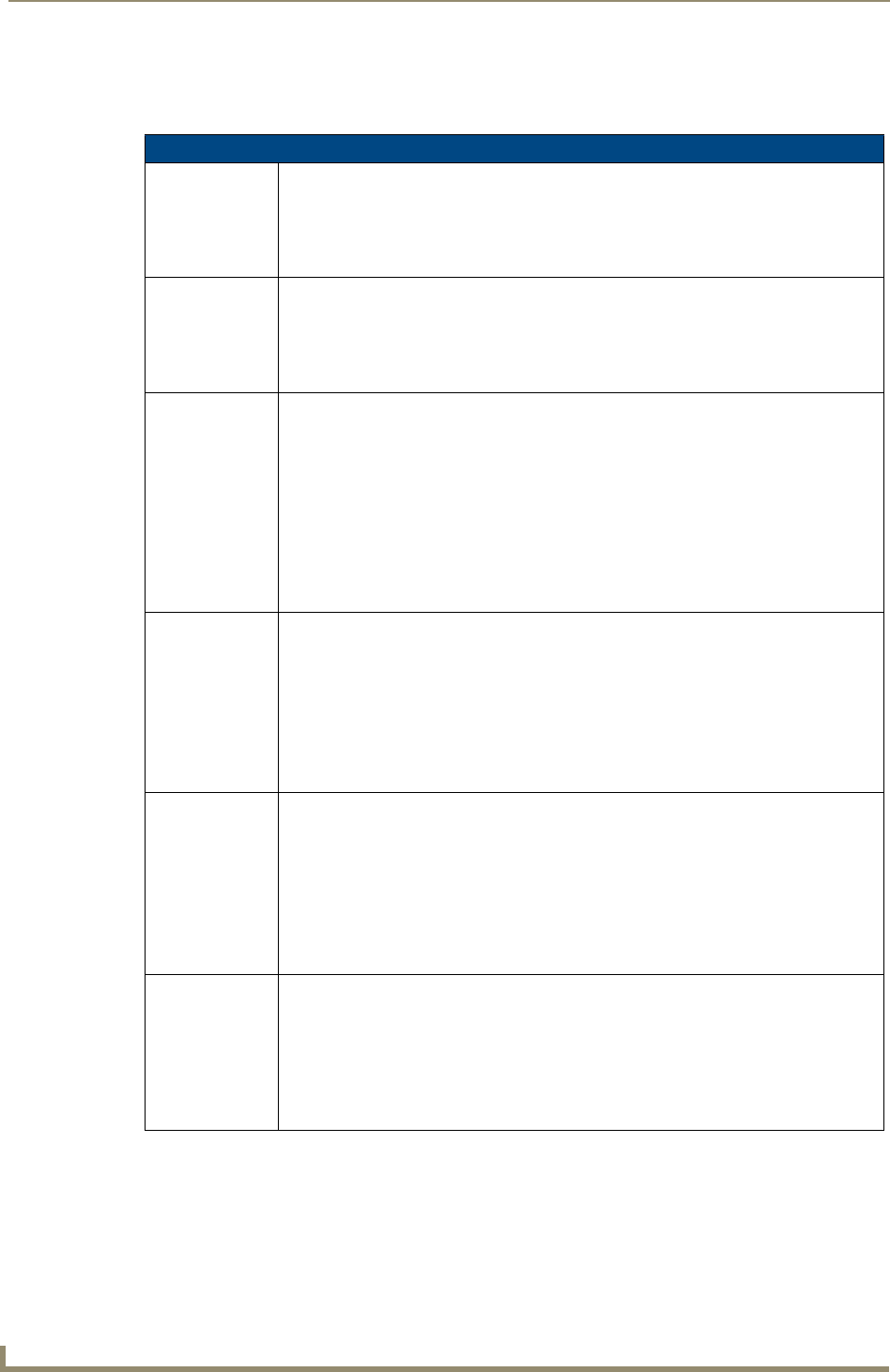
Programming
150 MVP-9000i Modero® Wireless Touch Panel with Intercom
Panel Runtime Operations
Serial Commands are used in Terminal Emulator mode. These commands are case insensitive.
Panel Runtime Operation Commands
ABEEP
Output a single
beep even if beep
is Off.
Syntax:
"'ABEEP'"
Example:
SEND COMMAND Panel,"'ABEEP'"
Outputs a beep of duration 1 beep even if beep is Off.
ADBEEP
Output a double
beep even if beep
is Off.
Syntax:
"'ADBEEP'"
Example:
SEND COMMAND Panel,"'ADBEEP'"
Outputs a double beep even if beep is Off.
@AKB
Pop up the
keyboard icon and
initialize the text
string to that
specified.
Keyboard string is set to null on power up and is stored until power is lost. The Prompt
Text is optional.
Syntax:
"'@AKB-<initial text>;<prompt text>'"
Variables:
initial text = 1 - 50 ASCII characters.
prompt text = 1 - 50 ASCII characters.
Example:
SEND COMMAND Panel,"'@AKB-Texas;Enter State'"
Pops up the Keyboard and initializes the text string 'Texas' with prompt text 'Enter State'.
AKEYB
Pop up the
keyboard icon and
initialize the text
string to that
specified.
Keyboard string is set to null on power up and is stored until power is lost.
Syntax:
"'AKEYB-<initial text>'"
Variables:
initial text = 1 - 50 ASCII characters.
Example:
SEND COMMAND Panel,"'AKEYB-This is a Test'"
Pops up the Keyboard and initializes the text string 'This is a Test'.
AKEYP
Pop up the
keypad icon and
initialize the text
string to that
specified.
The keypad string is set to null on power up and is stored until power is lost.
Syntax:
"'AKEYP-<number string>'"
Variables:
number string = 0 - 9999.
Example:
SEND COMMAND Panel,"'AKEP-12345'"
Pops up the Keypad and initializes the text string '12345'.
AKEYR
Remove the
Keyboard/
Keypad.
Remove keyboard or keypad that was displayed using 'AKEYB', 'AKEYP', 'PKEYP',
@AKB, @AKP, @PKP, @EKP, or @TKP commands.
Syntax:
"'AKEYR'"
Example:
SEND COMMAND Panel,"'AKEYR'"
Removes the Keyboard/Keypad.
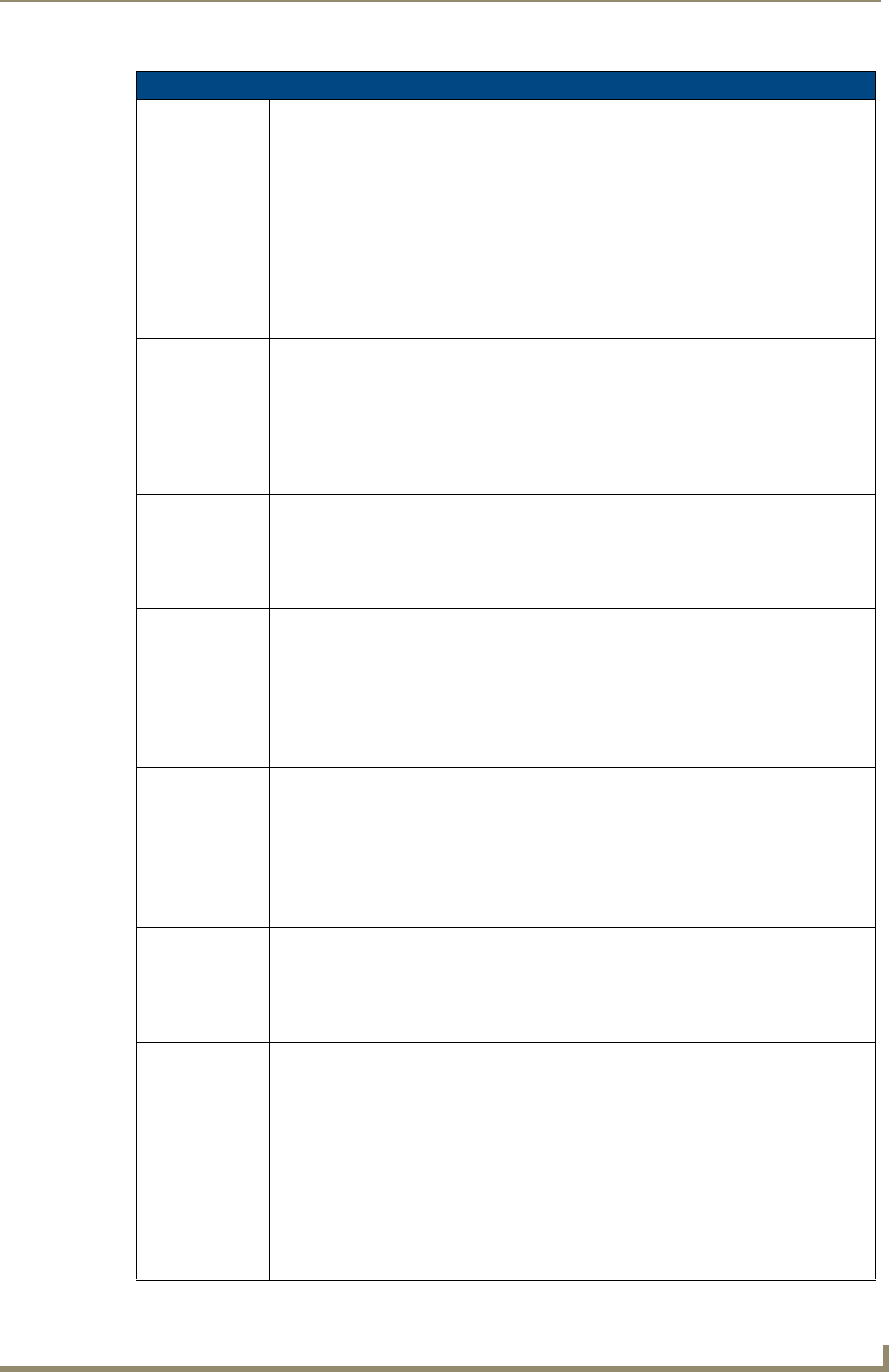
Programming
151
MVP-9000i Modero® Wireless Touch Panel with Intercom
Panel Runtime Operation Commands (Cont.)
@AKP
Pop up the
keypad icon and
initialize the text
string to that
specified.
Keypad string is set to null on power up and is stored until power is lost. The Prompt Text
is optional.
Syntax:
"'@AKP-<initial text>;<prompt text>'"
Variables:
initial text = 1 - 50 ASCII characters.
prompt text = 1 - 50 ASCII characters.
Example:
SEND COMMAND Panel,"'@AKP-12345678;ENTER PASSWORD'"
Pops up the Keypad and initializes the text string '12345678' with prompt text ’ENTER
PASSWORD’.
@AKR
Remove the
Keyboard/
Keypad.
Remove keyboard or keypad that was displayed using 'AKEYB', 'AKEYP', 'PKEYP',
@AKB, @AKP, @PKP, @EKP, or @TKP commands.
Syntax:
"'@AKR'"
Example:
SEND COMMAND Panel,"'@AKR'"
Removes the Keyboard/Keypad.
BEEP
Output a beep.
Syntax:
"'BEEP'"
Example:
SEND COMMAND Panel,"'BEEP'"
Outputs a beep.
BRIT
Set the panel
brightness.
Syntax:
"'BRIT-<brightness level>'"
Variable:
brightness level = 0 - 100.
Example:
SEND COMMAND Panel,"'BRIT-50'"
Sets the brightness level to 50.
@BRT
Set the panel
brightness.
Syntax:
"'@BRT-<brightness level>'"
Variable:
brightness level = 0 - 100.
Example:
SEND COMMAND Panel,"'@BRT-70'"
Sets the brightness level to 70.
DBEEP
Output a
double beep.
Syntax:
"'DBEEP'"
Example:
SEND COMMAND Panel,"'DBEEP'"
Outputs a double beep.
@EKP
Extend the
Keypad.
Pops up the keypad icon and initializes the text string to that specified. The Prompt Text is
optional.
Syntax:
"'@EKP-<initial text>;<prompt text>'"
Variables:
initial text = 1 - 50 ASCII characters.
prompt text = 1 - 50 ASCII characters.
Example:
SEND COMMAND Panel,"'@EKP-33333333;Enter Password'"
Pops up the Keypad and initializes the text string '33333333' with prompt text 'Enter
Password'.
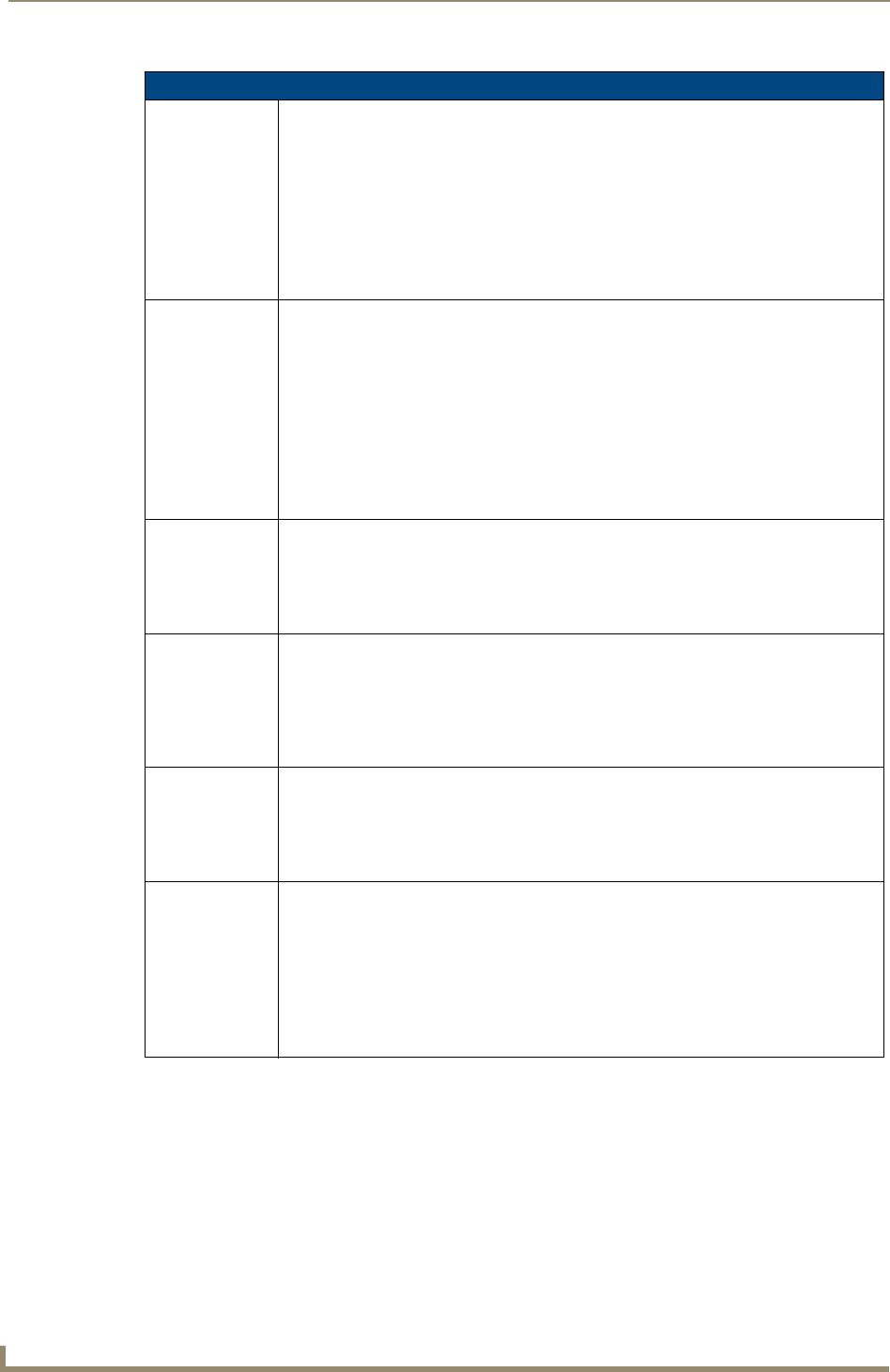
Programming
152 MVP-9000i Modero® Wireless Touch Panel with Intercom
Panel Runtime Operation Commands (Cont.)
PKEYP
Present a private
keypad.
Pops up the keypad icon and initializes the text string to that specified. Keypad displays a
'*' instead of the numbers typed. The Prompt Text is optional.
Syntax:
"'PKEYP-<initial text>'"
Variables:
initial text = 1 - 50 ASCII characters.
Example:
SEND COMMAND Panel,"'PKEYP-123456789'"
Pops up the Keypad and initializes the text string '123456789' in '*'.
@PKP
Present a private
keypad.
Pops up the keypad icon and initializes the text string to that specified. Keypad displays a
'*' instead of the numbers typed. The Prompt Text is optional.
Syntax:
"'@PKP-<initial text>;<prompt text>'"
Variables:
initial text = 1 - 50 ASCII characters.
prompt text = 1 - 50 ASCII characters.
Example:
SEND COMMAND Panel,"'@PKP-1234567;ENTER PASSWORD'"
Pops up the Keypad and initializes the text string 'ENTER PASSWORD' in '*'.
SETUP
Send panel to
SETUP page.
Syntax:
"'SETUP'"
Example:
SEND COMMAND Panel,"'SETUP'"
Sends the panel to the Setup Page.
SHUTDOWN
Shut down the
batteries providing
power to the
panel.
Syntax:
"'SHUTDOWN'"
Example:
SEND COMMAND Panel,"'SHUTDOWN'"
Shuts-down the batteries feeding power to the panel. This function saves the battery from
discharging.
SLEEP
Force the panel
into screen saver
mode.
Syntax:
"'SLEEP'"
Example:
SEND COMMAND Panel,"'SLEEP'"
Forces the panel into screen saver mode.
@SOU
Play a sound file.
Syntax:
"'@SOU-<sound name>'"
Variables:
sound name = Name of the sound file. Supported sound file formats are:
WAV & MP3.
Example:
SEND COMMAND Panel,"'@SOU-Music.wav'"
Plays the 'Music.wav' file.
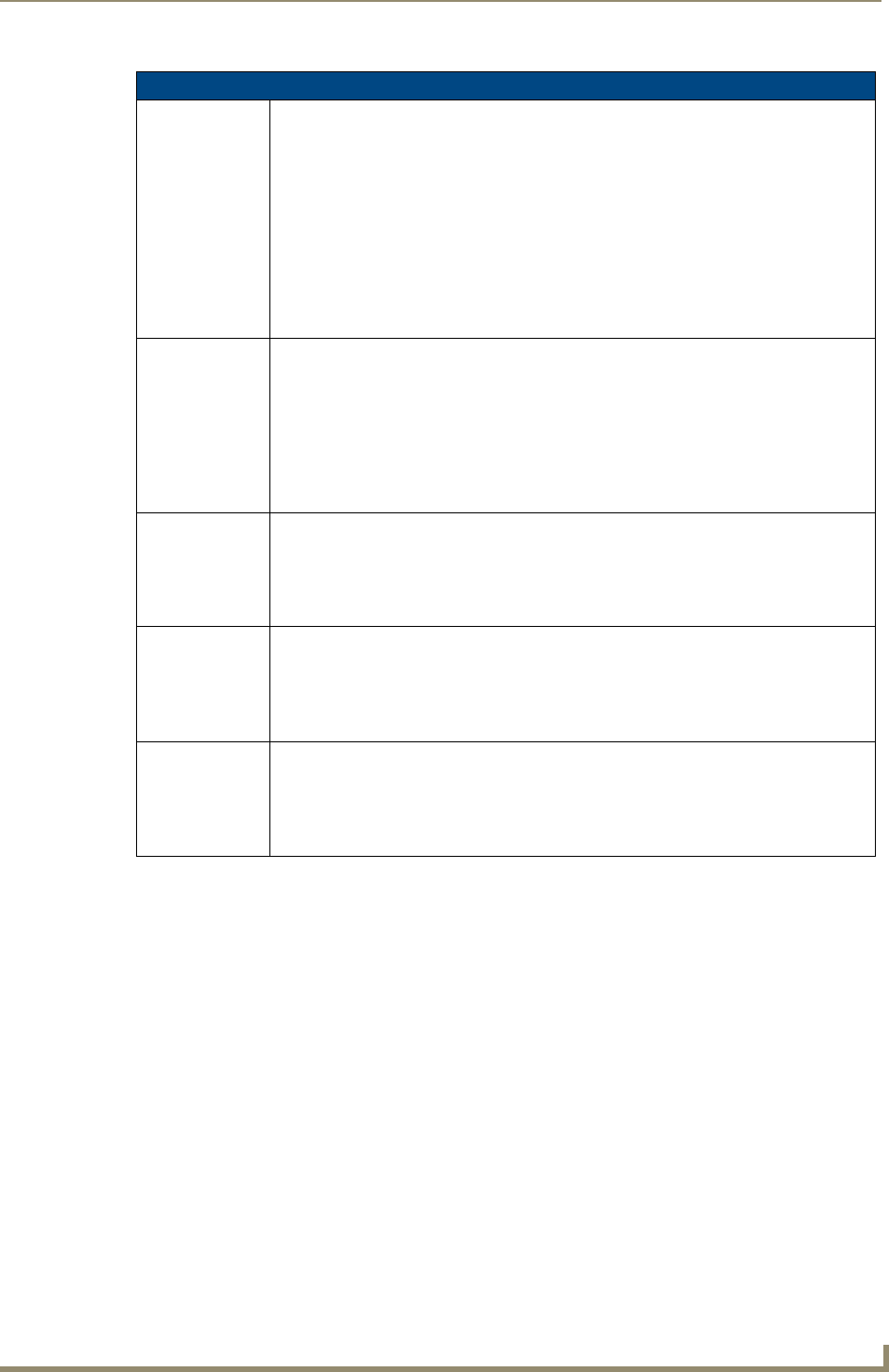
Programming
153
MVP-9000i Modero® Wireless Touch Panel with Intercom
Panel Runtime Operation Commands (Cont.)
@TKP
Present a
telephone
keypad.
Pops up the keypad icon and initializes the text string to that specified. The Prompt Text is
optional.
Syntax:
"'@TKP-<initial text>;<prompt text>'"
Variables:
initial text = 1 - 50 ASCII characters.
prompt text = 1 - 50 ASCII characters.
Example:
SEND COMMAND Panel,"'@TKP-999.222.1211;Enter Phone Number'"
Pops-up the Keypad and initializes the text string '999.222.1211' with prompt text 'Enter
Phone Number'.
TPAGEON
Turn On page
tracking.
This command turns On page tracking, whereby when the page or popups change, a
string is sent to the Master. This string may be captured with a CREATE_BUFFER
command for one panel and sent directly to another panel.
Syntax:
"'TPAGEON'"
Example:
SEND COMMAND Panel,"'TPAGEON'"
Turns On page tracking.
TPAGEOFF
Turn Off page
tracking.
Syntax:
"'TPAGEOFF'"
Example:
SEND COMMAND Panel,"'TPAGEOFF'"
Turns Off page tracking.
@VKB
Popup the
virtual
keyboard.
Syntax:
"'@VKB'"
Example:
SEND COMMAND Panel,"'@VKB'"
Pops-up the virtual keyboard.
WAKE
Force the panel
out of screen
saver mode.
Syntax:
"'WAKE'"
Example:
SEND COMMAND Panel,"'WAKE'"
Forces the panel out of the screen saver mode.

Programming
154 MVP-9000i Modero® Wireless Touch Panel with Intercom
Input Commands
These Send Commands are case insensitive.
Input Commands
^CAL
Put panel in
calibration mode.
Syntax:
"'^CAL'"
Example:
SEND COMMAND Panel,"'^CAL'"
Puts the panel in calibration mode.
^KPS
Set the
keyboard
passthru.
Syntax:
"'^KPS-<pass data>'"
Variable:
pass data:
<blank/empty> = Disables the keyboard.
0 = Pass data to G4 application (default). This can be used with VPC or text areas.
1 - 4 = Not used.
5 = Sends out data to the Master.
Example:
SEND COMMAND Panel,"'^KPS-5'"
Sets the keyboard passthru to the Master. Option 5 sends keystrokes directly to the
Master via the Send Output String mechanism. This process sends a virtual keystroke
command (^VKS) to the Master.
Example 2:
SEND COMMAND Panel,"'^KPS-0'"
Disables the keyboard passthru to the Master.
The following point defines how the parameters within this command work:
• Accepts keystrokes from any of these sources: attached USB keyboard or Virtual
keyboard.
^VKS
Send one or more
virtual key strokes
to the G4
application.
Key presses and key releases are not distinguished except in the case of CTRL, ALT, and
SHIFT.
Refer to theEmbedded Codes table on page 155 that define special characters which
can be included with the string but may not be represented by the ASCII character set.
Syntax:
"'^VKS-<string>'"
Variable:
string = Only 1 string per command/only one stroke per command.
Example:
SEND COMMAND Panel,"'^VKS-'8"
Sends out the keystroke 'backspace' to the G4 application.
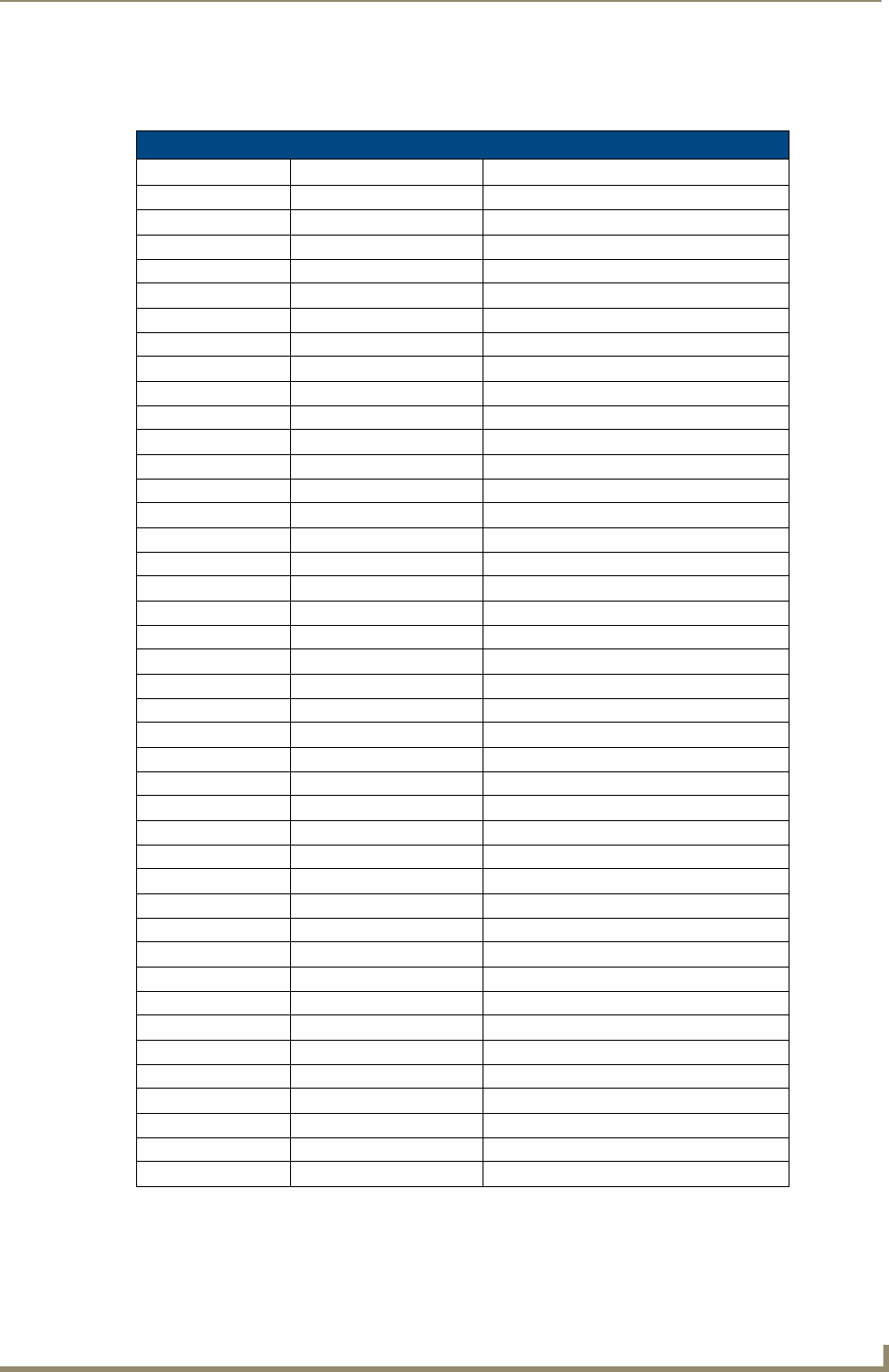
Programming
155
MVP-9000i Modero® Wireless Touch Panel with Intercom
Embedded codes
The following is a list of G4 compatible embedded codes:
Embedded Codes
Decimal numbers Hexidecimal values Virtual keystroke
8 ($08) Backspace
13 ($0D) Enter
27 ($1B) ESC
128 ($80) CTRL key down
129 ($81) ALT key down
130 ($82) Shift key down
131 ($83) F1
132 ($84) F2
133 ($85) F3
134 ($86) F4
135 ($87) F5
136 ($88) F6
137 ($89) F7
138 ($8A) F8
139 ($8B) F9
140 ($8C) F10
141 ($8D) F11
142 ($8E) F12
143 ($8F) Num Lock
144 ($90) Caps Lock
145 ($91) Insert
146 ($92) Delete
147 ($93) Home
148 ($94) End
149 ($95) Page Up
150 ($96) Page Down
151 ($97) Scroll Lock
152 ($98) Pause
153 ($99) Break
154 ($9A) Print Screen
155 ($9B) SYSRQ
156 ($9C) Tab
157 ($9D) Windows
158 ($9E) Menu
159 ($9F) Up Arrow
160 ($A0) Down Arrow
161 ($A1) Left Arrow
162 ($A2) Right Arrow
192 ($C0) CTRL key up
193 ($C1) ALT key up
194 ($C2) Shift key up
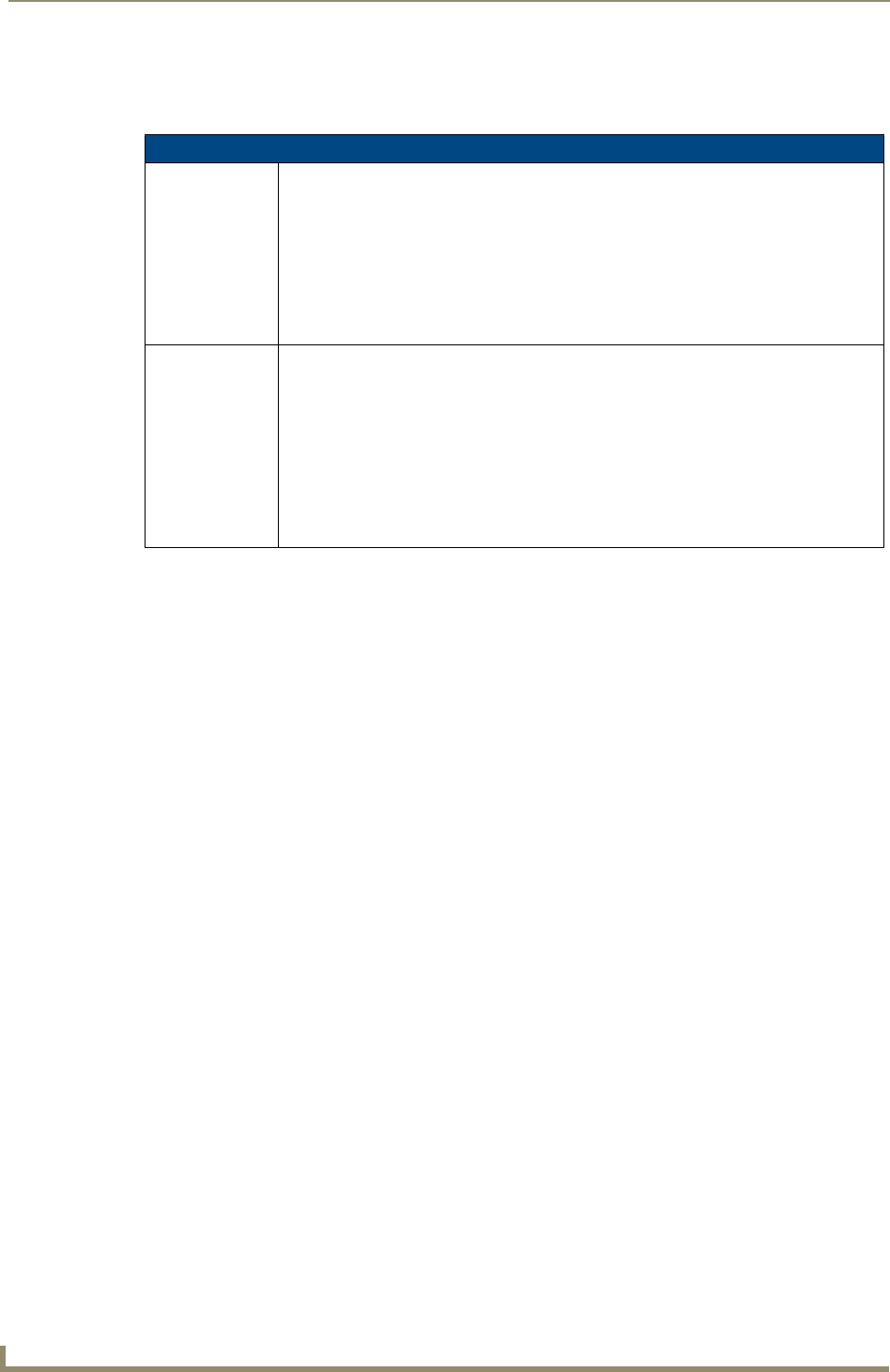
Programming
156 MVP-9000i Modero® Wireless Touch Panel with Intercom
Panel Setup Commands
These commands are case insensitive.
Panel Setup Commands
@PWD
Set the page flip
password.
@PWD sets the level 1 password only.
Syntax:
"'@PWD-<page flip password>'"
Variables:
page flip password = 1 - 50 ASCII characters.
Example:
SEND COMMAND Panel,"'@PWD-Main'"
Sets the page flip password to 'Main'.
^PWD
Set the page flip
password.
Password level is required and must be 1 - 4.
Syntax:
"'^PWD-<password level>,<page flip password>'"
Variables:
password level = 1 - 4.
page flip password = 1 - 50 ASCII characters.
Example:
SEND COMMAND Panel,"'^PWD-1,Main'"
Sets the page flip password on Password Level 1 to 'Main'.

Programming
157
MVP-9000i Modero® Wireless Touch Panel with Intercom
Dynamic Image Commands
The following table describes Dynamic Image Commands.
Dynamic Image Commands
^BBR
Set the bitmap of
a button to use a
particular
resource.
Syntax:
"'^BBR-<vt addr range>,<button states range>,<resource name>'"
Variable:
variable text address range = 1 - 4000.
button states range = 1 - 256 for multi-state buttons (0 = All states, for General buttons
1 = Off state and 2 = On state).
resource name = 1 - 50 ASCII characters.
Example:
SEND_COMMAND Panel,"'^BBR-700,1,Sports_Image'"
Sets the resource name of the button to ’Sports_Image’.
^RAF
Add new
resources.
Adds any and all resource parameters by sending embedded codes and data.
Since the embedded codes are preceded by a '%' character, any '%' character contained
in the URL must be escaped with a second '%' character (see example).
The file name field (indicated by a %F embedded code) may contain special escape
sequences as shown in the ^RAF, ^RMF - Embedded Codes table below.
Syntax:
"'^RAF-<resource name>,<data>'"
Variables:
• resource name = 1 - 50 ASCII characters.
• data = Refers to the embedded codes, see the ^RAF, ^RMF - Embedded Codes section
on page 158.
Example:
SEND_COMMAND Panel,"'^RAF-New Image,%P0%HAMX.COM%ALab/
Test%%5Ffile%Ftest.jpg'"
Adds a new resource.
• The resource name is ’New Image’
• %P (protocol) is an HTTP
• %H (host name) is AMX.COM
• %A (file path) is Lab/Test_file
• %F (file name) is test.jpg.
Note that the %%5F in the file path is actually encoded as %5F.
^RFR
Force a refresh for
a given resource.
Syntax:
"'^RFR-<resource name>'"
Variable:
resource name = 1 - 50 ASCII characters.
Example:
SEND_COMMAND Panel,"'^RFR-Sports_Image'"
Forces a refresh on ’Sports_Image’.
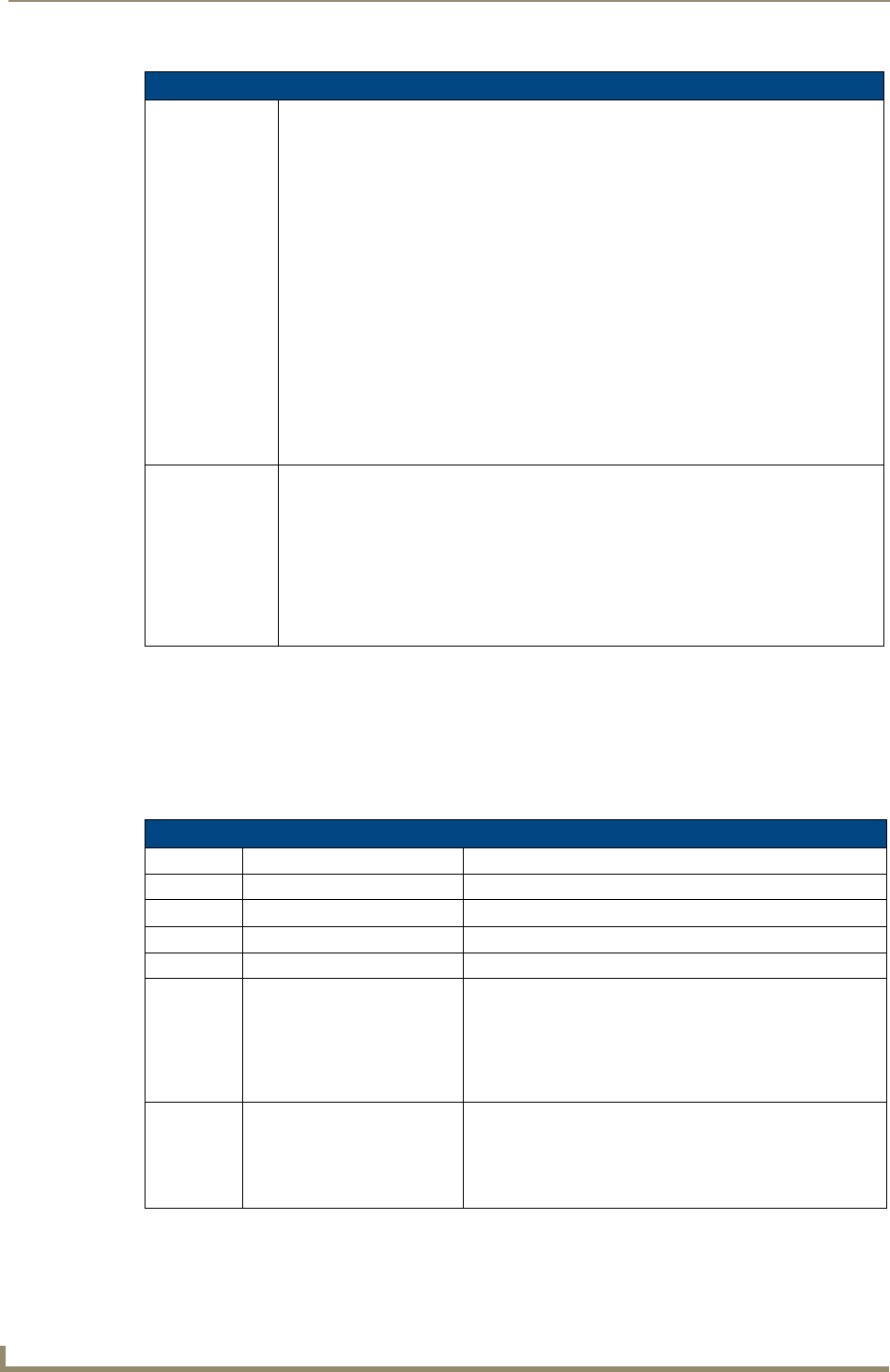
Programming
158 MVP-9000i Modero® Wireless Touch Panel with Intercom
^RAF, ^RMF - Embedded Codes
The ^RAF and ^RMF commands add and modify any and all resource parameters by sending embedded codes
and data:
"'^RAF-<resource name>,<data>'"
"'^RMF-<resource name>,<data>'"
The <data> variable uses the embedded codes described in the following table:
Dynamic Image Commands (Cont.)
^RMF
Modify an
existing resource.
Modifies any and all resource parameters by sending embedded codes and data.
Since the embedded codes are preceded by a '%' character, any '%' character contained
in the URL must be escaped with a second '%' character (see example).
The file name field (indicated by a %F embedded code) may contain special escape
sequences as shown in the ^RAF, ^RMF - Embedded Codes section on page 158.
Syntax:
"'^RMF-<resource name>,<data>'"
Variables:
• resource name = 1 - 50 ASCII characters
• data = Refers to the embedded codes, see the ^RAF, ^RMF - Embedded Codes section
on page 158.
Example:
SEND_COMMAND Panel,"'^RMF-Sports_Image,%ALab%%5FTest/
Images%Ftest.jpg'"
Changes the resource ’Sports_Image’ file name to ’test.jpg’ and the path to ’Lab_Test/
Images’.
Note that the %%5F in the file path is actually encoded as %5F.
^RSR
Change the
refresh rate for a
given resource.
Syntax:
"'^RSR-<resource name>,<refresh rate>'"
Variable:
resource name = 1 - 50 ASCII characters.
refresh rate = Measured in seconds.
Example:
SEND_COMMAND Panel,"'^RSR-Sports_Image,5'"
Sets the refresh rate to 5 seconds for the given resource (’Sports_Image’).
^RAF, ^RMF - Embedded Codes
Parameter Embedded Code Description
protocol ’%P <0-1>’ Set protocol. HTTP (0) or FTP (1).
user ’%U <user>’ Set Username for authentication.
password ’%S <password>’ Set Password for authentication.
host ’%H <host>’ Set Host Name (fully qualified DNS or IP Address).
file ’%F <file>’ Full path to the location of the file or program that will return
the resource. The path must be a valid HTTP URL minus the
protocol and host.
The only exception to this is the inclusion of special escape
sequences and in the case of FTP protocol, regular expres-
sions.
path ’%A <path>’ Set Directory path. The path must be a valid HTTP URL minus
the protocol, host and filename.
The only exception to this is the inclusion of special escape
sequences and in the case of FTP protocol, regular expres-
sions.
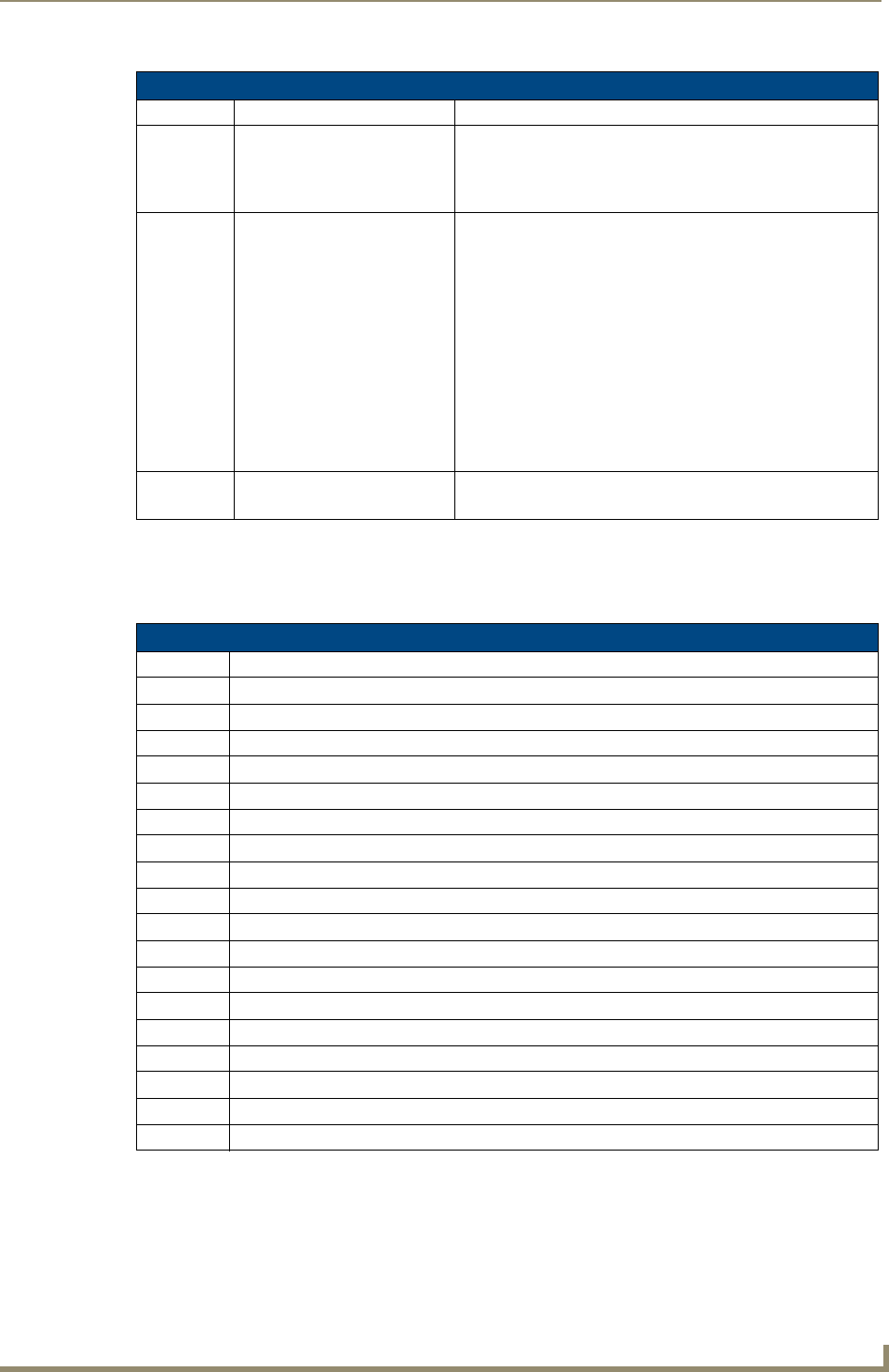
Programming
159
MVP-9000i Modero® Wireless Touch Panel with Intercom
Escape Sequences
The ^RAF and ^RMF commands support the replacement of any special escape sequences in the filename
(specified by the %F embedded code) with the corresponding data obtained from the system as outlined in the
table below:
For instance, http://www.amx.com/img.asp?device=$DV
would become
http://www.amx.com/img.asp?device=10001.
^RAF, ^RMF - Embedded Codes (Cont.)
Parameter Embedded Code Description
refresh ’%R <refresh 1-65535>’ The number of seconds between refreshes in which the
resource is downloaded again. Refreshing a resource causes
the button displaying that resource to refresh also.
The default value is 0 (only download the resource once).
newest ’%N <0-1>’ Set the newest file. A value of 1 means that only the most
recent file matching the pattern is downloaded.
Note: The 'newest file' option only applies to FTP Dynamic
Images, and only those that have pattern matching as part of
their filename. Neither 'newest file' nor pattern matching apply
to HTTP Dynamic Images.
When set, the panel will first pull a list of files matching the
given pattern from the specified FTP server and path. The
timestamps of the items in the list will be compared, with the
newest one being displayed on the panel. This is useful for
source devices that place a uniquely named still image in a
folder at constant intervals, allowing the panel always to
display the most recent one.
preserve ’%V <0-1>’ Set the value of the preserve flag.
Default is 0. Currently preserve has no function.
Escape Sequences
Sequence Panel Information
$DV Device Number
$SY System Number
$IP IP Address
$HN Host Name
$MC Mac Address
$ID Neuron ID (Only supported on panels that use ICSNet; ignored on all other panels)
$PX X resolution of current panel mode/file
$PY Y resolution of current panel mode/file
$ST Current state
$AC Address code
$AP Address port
$CC Channel code
$CP Channel port
$LC Level code
$LP Level port
$BX X Resolution of Current button
$BY Y Resolution of Current button
$BN Name of Button

Programming
160 MVP-9000i Modero® Wireless Touch Panel with Intercom
Intercom Commands
The following is a list of Intercom Commands:
Intercom Commands
^MODEL?
Sets model name.
Panel model name. If the panel supports intercom hardware it will respond with its model
name as shown in the response below. Older hardware or newer hardware that has inter-
com support disabled with not respond to this command.
Syntax:
SEND_COMMAND <DEV>,"'^MODEL?'"
Variables:
None.
Example:
SEND_COMMAND TP1,"'^MODEL?'"
Panel response string if intercom enabled:
^MODEL-MVP-8400i
^ICS-
Intercom start.
^ICS-<IP>,<TX UDP port>,<RX UDP port>,<initial mode>'"
Intercom start. Starts a call to the specified IP address and ports, where initial mode is
either 1 (talk) or 0 (listen) or 2 (both). If no mode is specified 0 (listen) is assumed. Please
note, however, that no data packets will actually flow until the intercom modify command is
sent to the panel.
Syntax:
SEND_COMMAND <DEV>,"'^ICS-<IP>,<TX UDP port>,<RX UDP port>,<initial
mode>'"
Variables:
IP = IP Address of panel to connect with on an Intercom call.
TX UDP port = UDP port to transmit to.
RX UDP port = UDP port to receive from.
initial mode = 0 (listen) or 1 (talk) or 2 (handsfree). 0 is the default.
Examples:
Example of setting up a handsfree unicast call between two panels:
SEND_COMMAND TP1, "^ICS-192.168.0.3,9000,9002,2"
SEND_COMMAND TP2, "^ICS-192.168.0.4,9002,9000,2"
Example of setting up a multicast call where the first panel is paging two other panels:
SEND_COMMAND TP1, "^ICS-239.252.1.1,9002,9000,1"
SEND_COMMAND TP2, "^ICS-239.252.1.1,9002,9000,0"
SEND_COMMAND TP3, "^ICS-239.252.1.1,9002,9000,0"
Example of setting up a baby monitor call where the first panel is listening to the micro-
phone audio coming from the second panel:
SEND_COMMAND TP1, "^ICS-192.168.0.3,9000,9002,0"
SEND_COMMAND TP2, "^ICS-192.168.0.4,9002,9000,1"
^ICE'
Intercom end.
Intercom end. This terminates an intercom call/connection.
Syntax:
SEND_COMMAND <DEV>,"'^ICE'"
Variables:
None.
Example:
SEND_COMMAND TP1,"'^ICE'"
SEND_COMMAND TP2,"'^ICE'"
Terminates an intercom call between two panels.
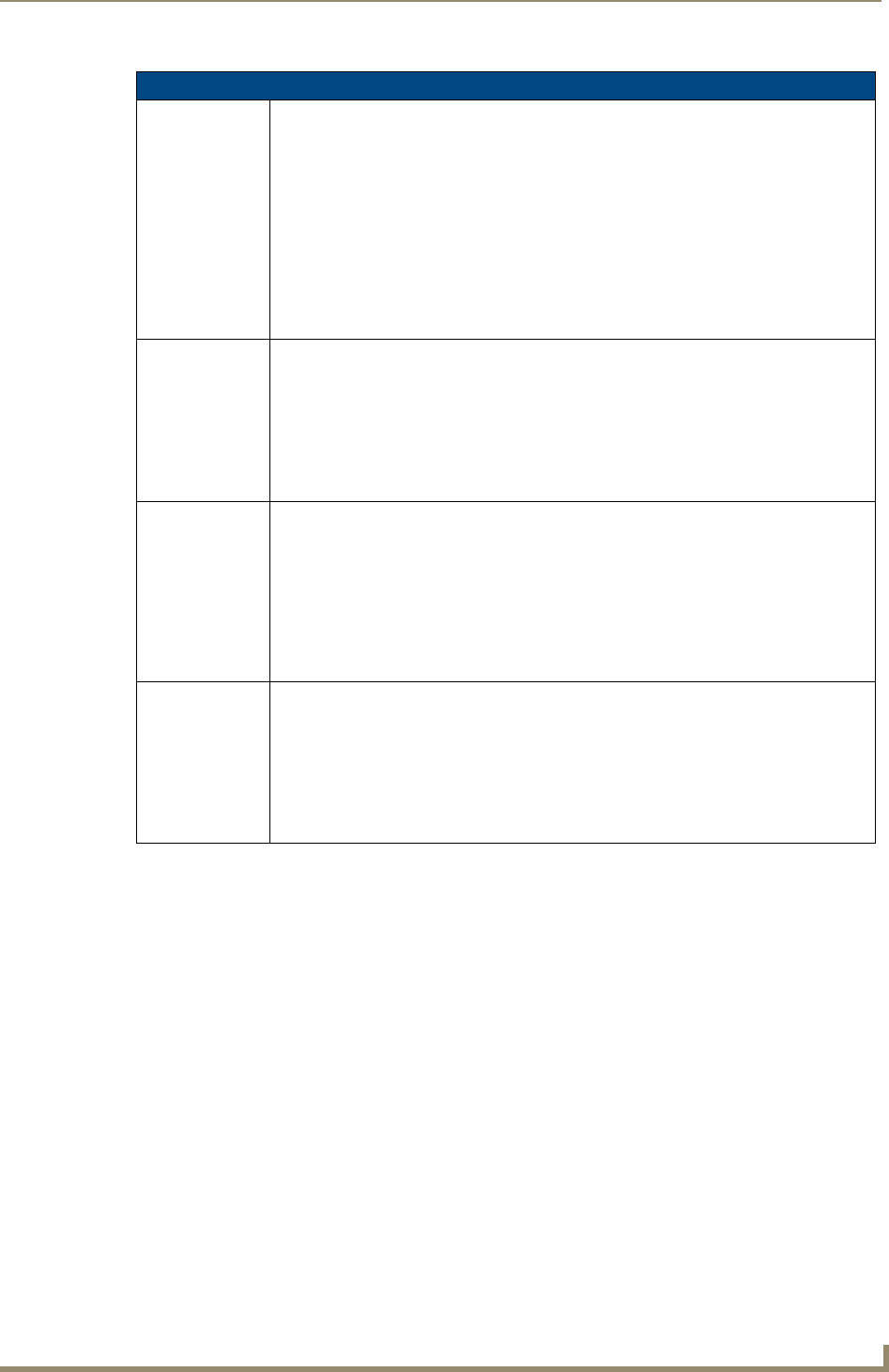
Programming
161
MVP-9000i Modero® Wireless Touch Panel with Intercom
Intercom Commands (Cont.)
^ICM-TALK
^ICM-LISTEN
Intercom modify
command.
Intercom modify command. For backwards compatibility both versions are supported.
In this release, however, the TALK and LISTEN sub commands are ignored. The
microphone and/or speaker are activated based on the initial mode value of the intercom
start command and the audio data packet flow is started upon receipt of this command by
the panel.
Syntax:
SEND_COMMAND <DEV>,"'^ICM-TALK'"
Variables:
None.
Example:
SEND_COMMAND TP1,"'^ICM-TALK'"
^ICM-MICLEVEL
Intercom modify
command.
Used to set the microphone level during an intercom call.
Syntax:
SEND_COMMAND <DEV>, "^ICM-MICLEVEL"
Variables:
Valid levels are from 0 to 100.
Example:
SEND_COMMAND TP1, "^ICM-MICLEVEL,40"
^ICM-MUTEMIC
Intercom modify
command.
Set the state of the microphone on a panel to muted (1) or unmuted (0). At the start of
each call the microphone starts out unmuted.
Syntax:
SEND_COMMAND <DEV>, "^ICM-MUTEMIC"
Variables:
None.
Example:
SEND_COMMAND TP1, "^ICM-MUTEMIC,1"
^ICM-
SPEAKERLEVEL
Intercom modify
command.
Used to set the speaker level during an intercom call.
Syntax:
SEND_COMMAND <DEV>, "^ICM-SPEAKERLEVEL,55"
Variables:
Valid levels are from 0 to 100.
Example:
SEND_COMMAND TP1, "^ICM-SPEAKERLEVEL,55"

Programming
162 MVP-9000i Modero® Wireless Touch Panel with Intercom
SIP Commands
The following table lists and describes SIP commands that are generated from the touch panel.
SIP Commands
^PHN-
AUTOANSWER
Provides the state
of the
auto-answer fea-
ture.
Syntax:
"'^PHN-AUTOANSWER, <state>'"
Variable:
state = 0 or 1 (off or on)
Example:
SEND_COMMAND Panel,"'^PHN-AUTOANSWER, 1'"
^PHN-CALL
Provides call
progress notifica-
tion for a call.
Syntax:
"'^PHN-CALL, <status>, <connection id>'"
Variable:
status = CONNECTED, DISCONNECTED, TRYING, RINGING, or HOLD.
connection id = The identifying number of the connection.
Example:
SEND_COMMAND Panel"'^PHN-CALL, CONNECTED, 1'"
Notifies that the call is connected.
^PHN-INCOMING
Provides incoming
call notification.
Provides incoming call notification and the connection id used for all future commands
related to this call. The connection id will be 0 or 1.
Syntax:
"'^PHN-INCOMING, <caller number>, <caller name>, <connection id>,
<timestamp>, '"
Variable:
caller number = The phone number of the incoming call.
caller name = The name associated with the caller number.
connection id = The identifying number of the connection.
timestamp = The current time in MM/DD/YY HH:MM:SS format.
Example:
SEND_COMMAND Panel,"'^PHN-INCOMING, 2125551000, AMX, 07/22/08
12:00:00, 1'"
^PHN-
LINESTATE
Indicates the cur-
rent state of each
of the available
connections used
to manage calls.
Syntax:
"'^PHN-LINESTATE, <connection id>, <state>, <connection id>,
<state>,...'"
Variable:
connection id = The identifying number of the connection.
state = IDLE, HOLD, or CONNECTED
extn = The local extension of this panel (see Example)
Example:
SEND_COMMAND Panel,"'^PHN-LINESTATE, 1, IDLE, 2, CONNECTED, SIP,
<extn>'"
^PHN-
MSGWAITING
Indicates the
number of mes-
sages waiting the
user’s voice mail
box.
Syntax:
"'^PHN-MSGWAITING, <messages>, <new message count>, <old message
count>, <new urgent message count>, <old urgent message count>'"
Variable:
messages = 0 or 1 (1 indicates new messages)
new message count = The number of new messages.
old message count = The number of old messages.
new urgent message count = The number of new messages marked urgent.
old urgent message count = The number of old messages marked urgent.
Example:
SEND_COMMAND Panel,"'^PHN-MSGWAITING, 1, 1, 2, 1, 0’"
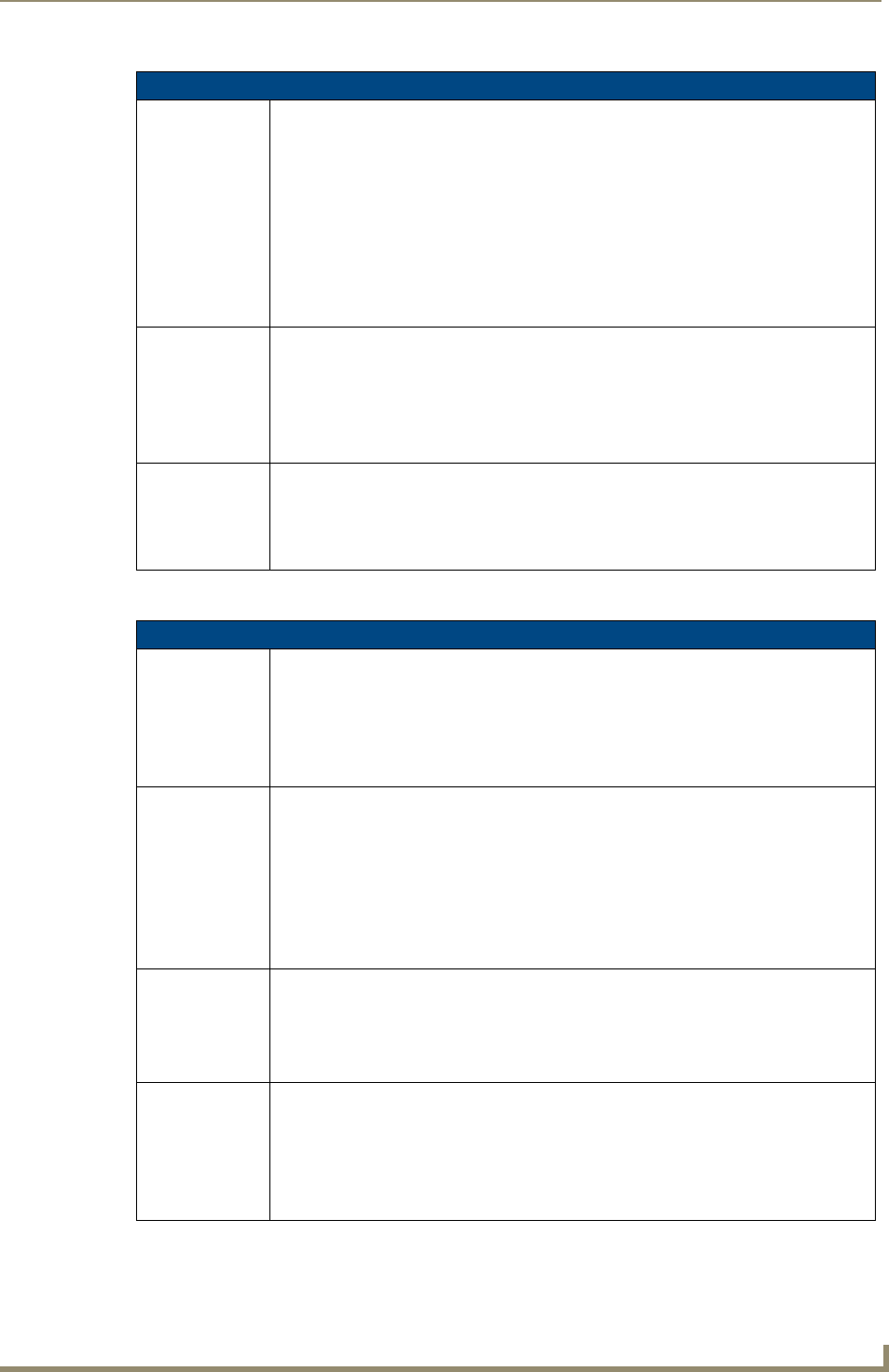
Programming
163
MVP-9000i Modero® Wireless Touch Panel with Intercom
The following table lists and describes SIP commands that are sent to the touch panel to manage calls.
SIP Commands (Cont.)
^PHN-PRIVACY
Indicates the state
of the privacy fea-
ture.
Syntax:
"'^PHN-PRIVACY, <state>'"
Variable:
state = 0 (Disable) or 1 (Enable)
new message count = The number of new messages.
old message count = The number of old messages.
new urgent message count = The number of new messages marked urgent.
old urgent message count = The number of old messages marked urgent.
Example:
SEND_COMMAND Panel,"'^PHN-PRIVACY, 0’"
^PHN-REDIAL
Indicates the
panel is redialing
the number.
Syntax:
"'^PHN-REDIAL, <number>'"
Variable:
number = The phone number to dial.
Example:
SEND_COMMAND Panel,"'^PHN-REDIAL, 2125551000’"
^PHN-
TRANSFERRED
Indicates a call
has been trans-
ferred.
Syntax:
"'^PHN-TRANSFERRED'"
Example:
SEND_COMMAND Panel,"'^PHN-TRANSFERRED’"
SIP Commands
^PHN-ANSWER
Answers the call.
Syntax:
"'^PHN-ANSWER, <connection id>'"
Variable:
connection id = The identifying number of the connection
Example:
SEND_COMMAND Panel,"'^PHN-ANSWER, 1'"
^PHN-
AUTOANSWER
Enables or
disables the auto-
answer
feature of the
phone.
Enables (1) or disables (0) the auto-answer feature on the phone.
Syntax:
"’^PHN-AUTOANSWER, <state>’"
Variable:
state = 0 (Disable) or 1 (Enable)
Example:
SEND_COMMAND Panel,"'^PHN-AUTOANSWER, 1'"
Enables the auto-answer feature.
?PHN-
AUTOANSWER
Queries the state
of the auto-
answer feature.
The panel responds with the ^PHN-AUTOANSWER, <state> message.
Syntax:
"’?PHN-AUTOANSWER’"
Example:
SEND_COMMAND Panel,"'?PHN-AUTOANSWER'"
^PHN-CALL
Calls the
provided number.
Syntax:
"’^PHN-CALL, <number>’"
Variable:
number = The provided phone number
Example:
SEND_COMMAND Panel,"'^PHN-CALL, 2125551000'"
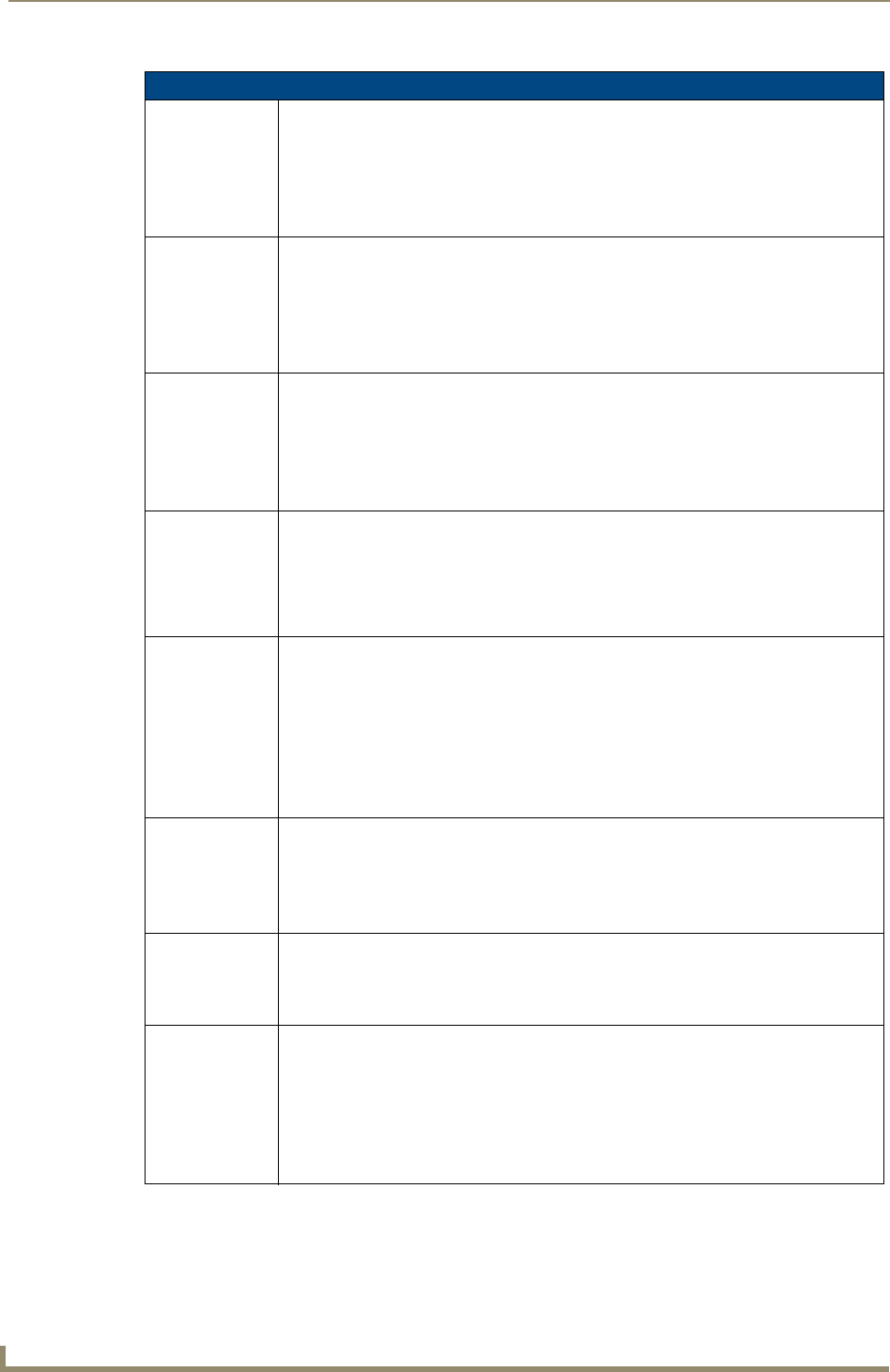
Programming
164 MVP-9000i Modero® Wireless Touch Panel with Intercom
SIP Commands (Cont.)
^PHN-DTMF
Sends DTMF
codes.
Syntax:
"’^PHN-DTMF, <DTMF code>’"
Variable:
DTMF code = 0, 1, 2, 3, 4, 5, 6, 7, 8, 9, POUND, or ASTERISK.
Example:
SEND_COMMAND Panel,"'^PHN-DTMF, 1234567879ASTERISK'"
^PHN-HANGUP
Hangs up the call.
Syntax:
"’^PHN-HANGUP, <connection id>’"
Variable:
connection id = The identifying number of the connection
Example:
SEND_COMMAND Panel,"'^PHN-HANGUP, 1'"
^PHN-HOLD
Places the call on
hold.
Syntax:
"’^PHN-HOLD, <connection id>’"
Variable:
connection id = The identifying number of the connection
Example:
SEND_COMMAND Panel,"'^PHN-HOLD, 1'"
?PHN-
LINESTATE
Queries the state
of each of the
connections used
by the SIP device.
The panel responds with the ^PHN-LINESTATE message.
Syntax:
"’?PHN-LINESTATE’"
Example:
SEND_COMMAND Panel,"'?PHN-LINESTATE'"
^PHN-PRIVACY
Enables or dis-
ables the privacy
feature of the
phone.
Enables or disables the privacy feature on the phone (do not disturb).
Syntax:
"’^PHN-PRIVACY, <state>’"
Variable:
state = 0 (Disable) or 1 (Enable)
Example:
SEND_COMMAND Panel,"'^PHN-PRIVACY, 1'"
Enables the privacy feature.
?PHN-PRIVACY
Queries the state
of the privacy fea-
ture.
The panel responds with the ^PHN-PRIVACY, <state> message.
Syntax:
"’?PHN-PRIVACY’"
Example:
SEND_COMMAND Panel,"'?PHN-PRIVACY'"
^PHN-REDIAL
Redials the last
number.
Syntax:
"’^PHN-REDIAL’"
Example:
SEND_COMMAND Panel,"'^PHN-REDIAL'"
^PHN-
TRANSFER
Transfers the call
to the provided
number.
Syntax:
"’^PHN-TRANSFER, <connection id>, <number>’"
Variable:
connection id = The identifying number of the connection
number = The number to which you want to transfer the call.
Example:
SEND_COMMAND Panel,"'^PHN-TRANSFER, 1, 2125551000'"
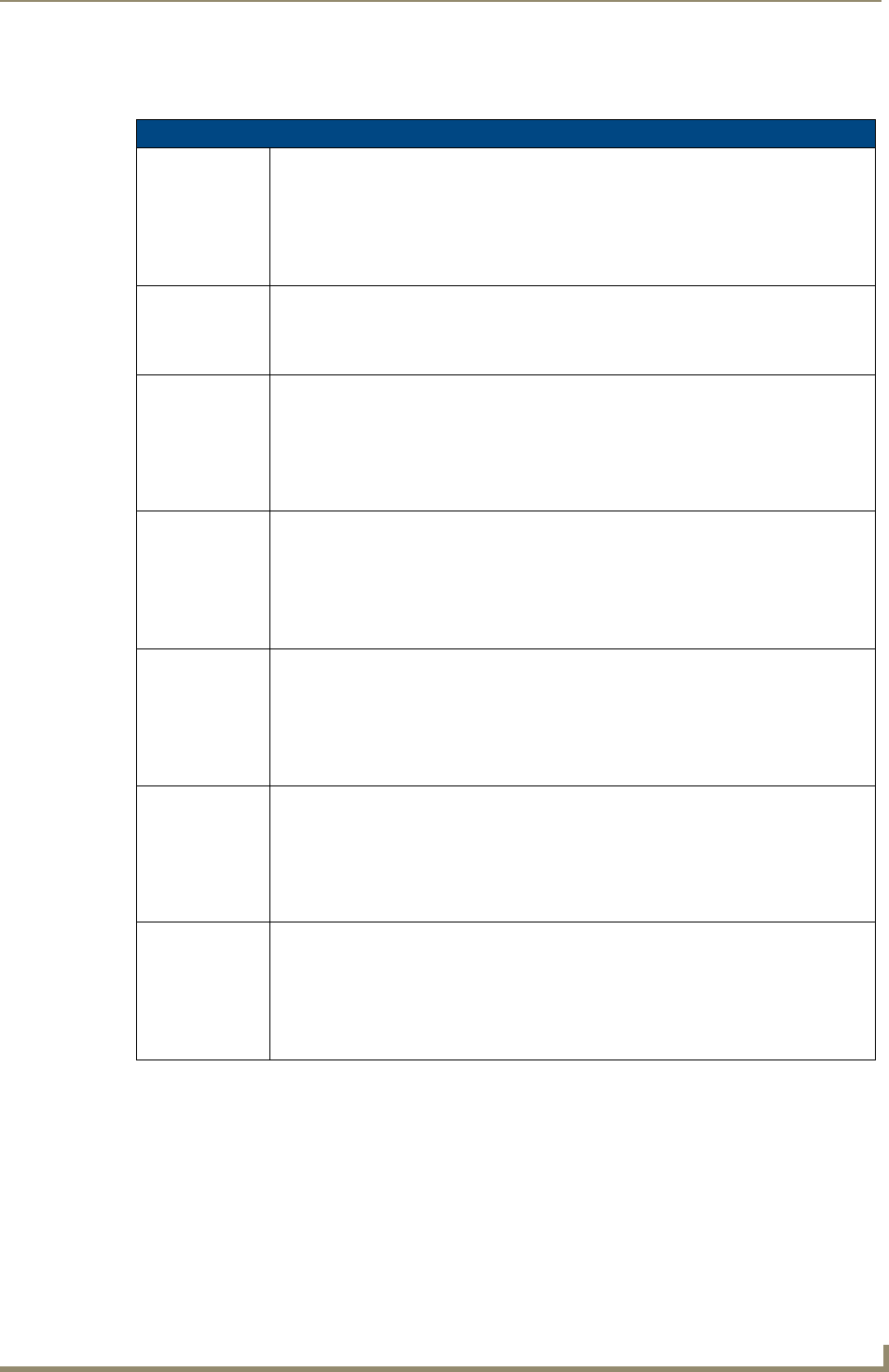
Programming
165
MVP-9000i Modero® Wireless Touch Panel with Intercom
The following table lists and describes SIP setup commands. Using any of these commands causes the current
user to go offline.
SIP Setup Commands
^PHN-SETUP-
DOMAIN
Sets the realm for
authentication.
Syntax:
"’^PHN-SETUP-DOMAIN, <domain>’"
Variable:
domain = The realm used for authentication
Example:
SEND_COMMAND Panel,"’^PHN-SETUP-DOMAIN, asterisk’"
^PHN-SETUP-
ENABLE
Registers a new
user
Once the configuration has been updated, the ENABLE command should be run to re-
register the new user.
Syntax:
"’^PHN-SETUP-ENABLE’"
^PHN-SETUP-
PASSWORD
Sets the user
password for the
proxy server.
Syntax:
"’^PHN-SETUP-PASSWORD, <password>’"
Variable:
password = The password for the user name
Example:
SEND_COMMAND Panel,"’^PHN-SETUP-PASSWORD, 6003’"
^PHN-SETUP-
PORT
Sets the port num-
ber for the proxy
server.
Syntax:
"’^PHN-SETUP-PORT, <port>’"
Variable:
port = The port for the proxy server
Example:
SEND_COMMAND Panel,"’^PHN-SETUP-PORT, 5060’"
^PHN-SETUP-
PROXYADDR
Sets the IP
address for the
proxy server.
Syntax:
"’^PHN-SETUP-PROXYADDR, <IP>’"
Variable:
IP = The IP address for the proxy server
Example:
SEND_COMMAND Panel,"’^PHN-SETUP-PROXYADDR, 192.168.223.111’"
^PHN-SETUP-
STUNADDR
Sets the IP
address for the
STUN server.
Syntax:
"’^PHN-SETUP-STUNADDR, <IP>’"
Variable:
IP = The IP address for the STUN server
Example:
SEND_COMMAND Panel,"’^PHN-SETUP-STUNADDR, 192.168.223.111’"
^PHN-SETUP-
USERNAME
Sets the user
name for authenti-
cation with the
proxy server.
Syntax:
"’^PHN-SETUP-USERNAME, <username>’"
Variable:
username = The user name (usually the phone extension)
Example:
SEND_COMMAND Panel,"’^PHN-SETUP-USERNAME, 6003’"

Programming
166 MVP-9000i Modero® Wireless Touch Panel with Intercom
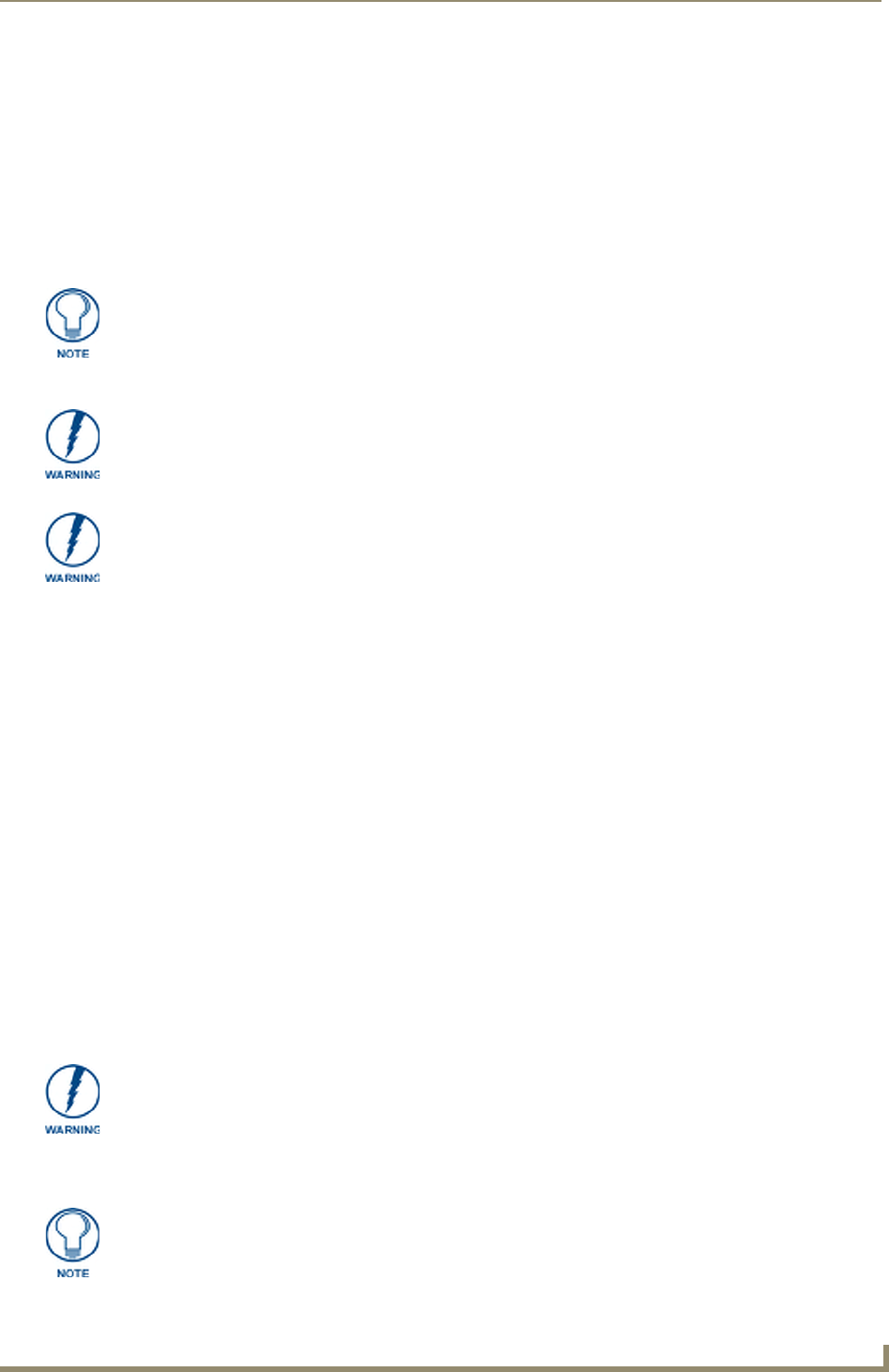
Battery Life and Replacement
167
MVP-9000i Modero® Wireless Touch Panel with Intercom
Battery Life and Replacement
Overview
The battery powering the MVP-9000i is designed for upwards of 300 deep discharge rechargings. Regular
shallow rechargings will extensively increase expected battery life, and the device should be stored in either
the Table Docking Station or the Wall Docking Station when not in use to keep it at an optimum charge. The
battery has reached its effective end of life after it can no longer hold more than a 70 percent charge.
IMPORTANT NOTES!
Lithium-Polymer batteries are small, compact, and ideal for providing long lasting
power. However, they must be used and charged properly. Improper use can result in
serious injury, fire, or death.
Please read and understand the following warnings. If you have any questions or
concerns with this product, please contact your AMX sales representative.
This installation requires opening the case of the MVP-9000i and working within its
internal components. If you are unwilling or unable to replace the battery, please
return the device to AMX for battery replacement.
WARNING: Misuse of a Lithium-Polymer battery may result in overheating, fire, or
explosion!
Safety Information:
• Do not dismantle, open, or shred the battery.
• Do not short circuit the battery. Do not store batteries haphazardly in a box or
drawer where they may short circuit each other or be short circuited by conductive
materials.
• Do not remove a battery from its original packaging until required for use.
• Do not expose batteries to heat or fire. Avoid storage in direct sunlight.
• Do not subject the batteries to mechanical shock.
• In the event of a cell leaking, do not allow the liquid to come into contact with the
skin or eyes. If contact has been made, wash the affected area with copious
amounts of water and seek medical advice.
• Insure battery connector is aligned and installed correctly.
• Store the batteries in a dry place with temperature between 0° C (32° F) and 40° C
(104° F).
• Do not maintain the battery on charge when not in use.
• Note that batteries give their best performance when they are operated at normal
room temperature (20°C/68°F) ± 5°C/9°F).
• When disposing of batteries, keep cells or batteries of different electrochemical
systems separate from each other.
Charging
• Use only with approved AMX charger.
Care must be taken to install the battery without damaging the battery.
Lithium-Polymer battery technology degrades in capacity over time, unless the
battery is periodically charged and discharged. AMX recommends installing all
Lithium-Polymer batteries in functional AMX products within 6 months of receipt.
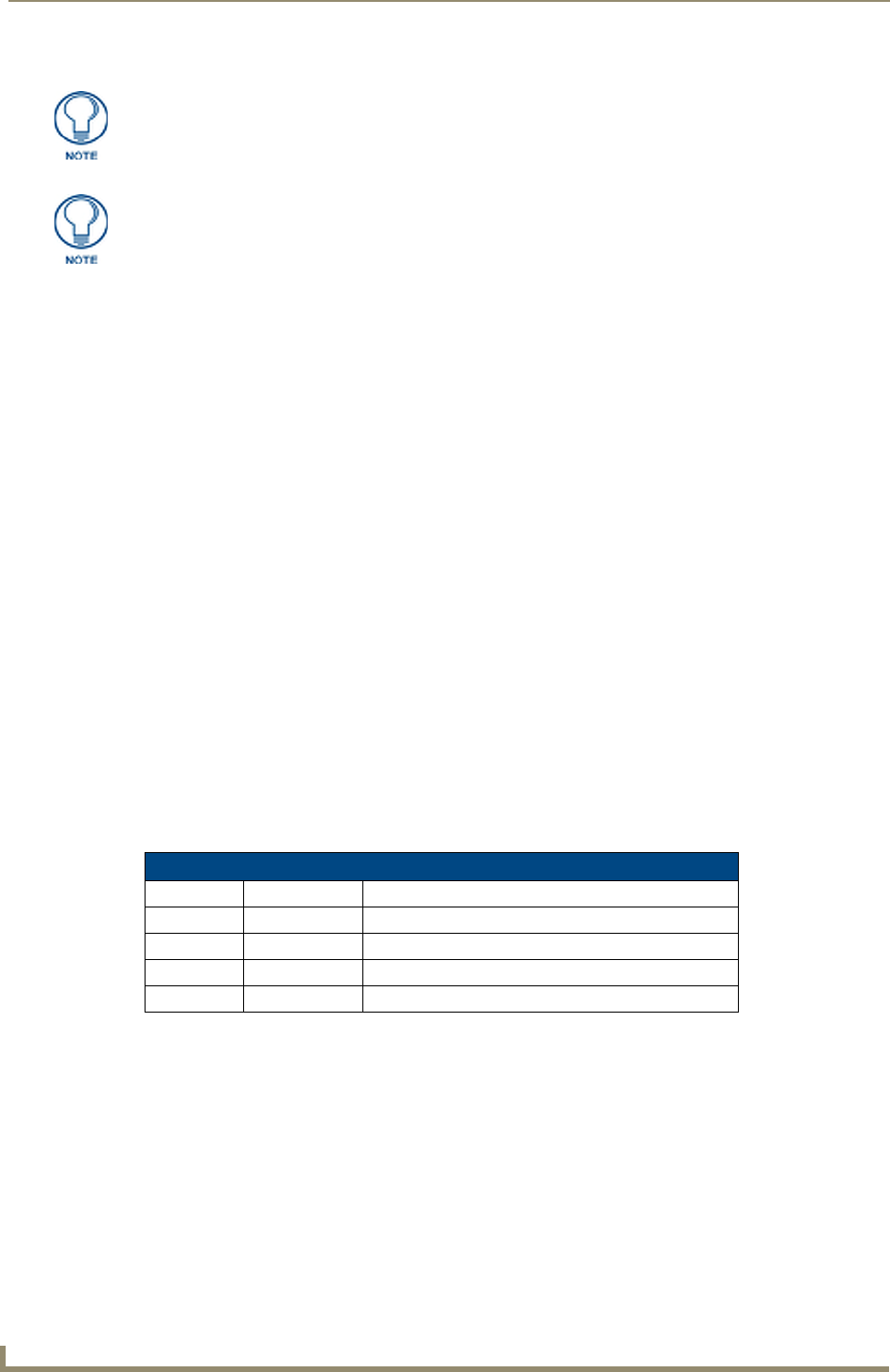
Battery Life and Replacement
168 MVP-9000i Modero® Wireless Touch Panel with Intercom
Power Management
Since the MVP-9000i is a battery-powered handheld device, power management is a necessary concern. Under
active use, the charge on the integral Lithium-Polymer battery can last for as long as five days. However, to
maximize usability and minimize the chances of the device becoming completely discharged at a critical
moment, the MVP-9000i should be kept in its charging cradle or wall station when not in use.
The MVP-9000i operates on four distinct power modes:
On - This is the normal power mode of the panel during operation. In this mode, all necessary
modules are powered up and their respective clocks are being driven appropriately. The device
remains online with the NetLinx Master and continues to appear in the online tree of NetLinx
Studio.
Sleep - This mode of operation can be selected through the Setup Pages and only controls the
backlight. In this case, the unit remains on all the time, and only the backlight will be turned off
after the user-selectable time of inactivity has elapsed. The device remains online with the NetLinx
Master and continues to be shown in the online tree of NetLinx Studio. The unit shall transfer to the
Awake mode after it detects a touch on the touchscreen or capacitive touch buttons. This mode uses
80 percent of the power required for the Awake mode.
Standby - In this mode, power to all components other than the touch screen is turned off after the
user selectable time of inactivity has elapsed. Device will turn back on by touching the screen. Re-
acquiring a WAP connection may require up to 25 seconds.
Shutdown - The system enters this mode after a user selectable amount of inactivity time has
elapsed or if the battery level falls below10 percent of its full charge. This is the absolute lowest
mode of operation, during which power to all peripherals and components is turned off. It is not
online with the NetLinx Master and will not appear in NetLinx Studio. The system remains in this
mode until it is rebooted. In the latter case, the panel has to be placed in a Table Docking Station in
order for it to be operational.
Proper Battery Maintenance
To insure maximum performance and reliability of the MVP-9000i, please insure that a full charge is
performed every 3 months if not used regularly. If a battery is left uncharged beyond this time frame, it may
result in premature battery lifespan degradation and will require replacement.
Please dispose of all used batteries in a proper fashion as required by municipal or
federal regulations.
Prior to battery removal, run the device until the battery is completely discharged.
Power Modes for the MVP-9000i
Mode Power Use Time Available (With Full Battery Charge)
On 100% 5 hours
Sleep 50% 10 hours
Standby 15% 72 hours
Shutdown Less than 1% Up to one month
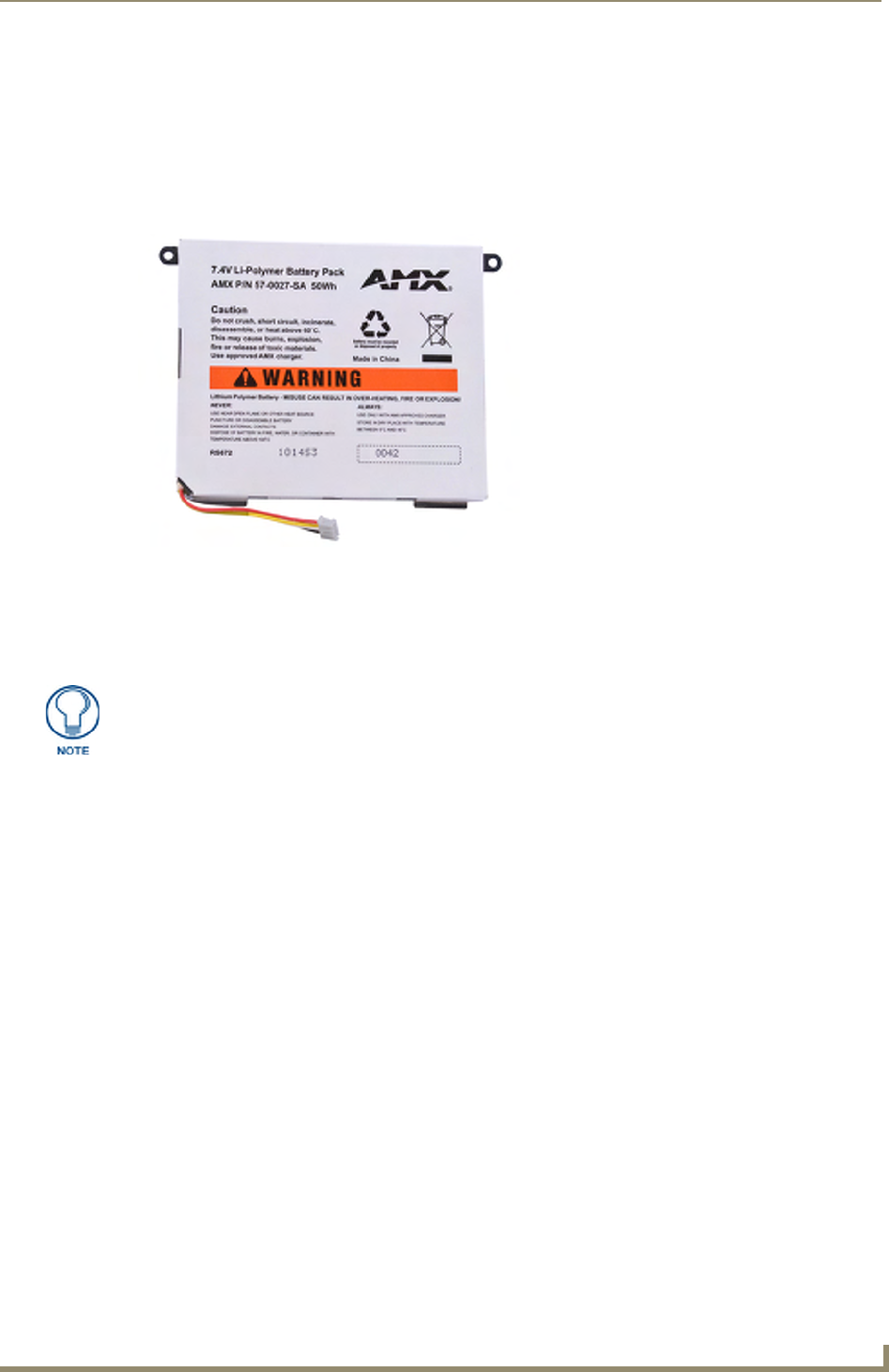
Battery Life and Replacement
169
MVP-9000i Modero® Wireless Touch Panel with Intercom
Battery Replacement
The touch panel's battery is intended to last the life of the device, but in cases where the battery has reached its
effective end of life, it may be replaced.
READ THESE INSTRUCTIONS FIRST!
To minimize the risk of damage to the battery during installation, all replacement batteries come in a protective
metal cover (FIG. 99). This cover cannot be removed from the battery.
Replacing the Battery
Before replacing the battery, download and install the latest firmware for the MVP-9000i. This firmware is
available at www.amx.com.
FIG. 99 Lithium-Polymer battery for the MVP-9000i
IMPORTANT: Prior to battery removal, run the device until the battery is completely
discharged. Do NOT discharge the battery before installing the latest MVP-9000i
firmware, available at www.amx.com.
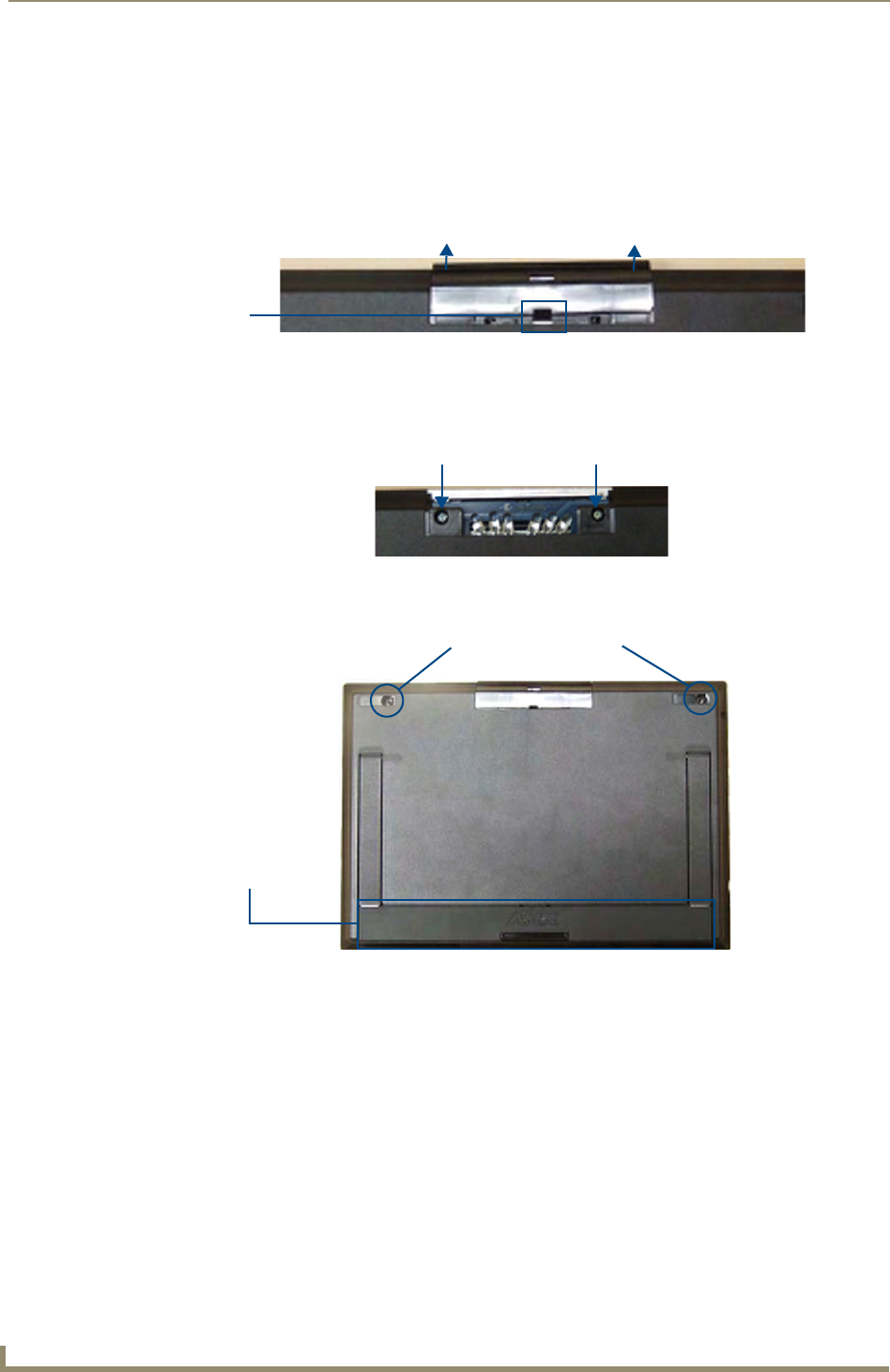
Battery Life and Replacement
170 MVP-9000i Modero® Wireless Touch Panel with Intercom
To remove an old battery and replace it:
1. Remove the battery from its packaging, remove the protective film from the battery, and inspect it for any
damage or distortion. If the battery shows evidence of damage, contact AMX for replacement and proper
disposal information.
2. Place the device face-down on a surface that will not scratch the unit and gently pry up the IR emitter
cover at the screw slot at its bottom (FIG. 100).
3. Hold arefully press ln the left and right to loosen and remove the IR emitter cover.
4. Remove the two screws underneath the IR emitter cover (FIG. 101).
5. Remove the five screws on the back of the device. (FIG. 102).
Two of the screws are at the upper corners of the device, underneath rubber feet that also act as
screw covers. Remove the rubber feet to access the screws.
Lift up the kickstand and remove the label to reach the remaining three screws.
6. Discharge all static electricity that may have built up on your body, either by using a static discharge strap
or by touching a nearby piece of metal.
7. Carefully remove the back of the device and detach the battery lead at the battery connector (FIG. 103).
This will allow the back cover to be detached from the device.
FIG. 100 Removal of the IR emitter cover
FIG. 101 Location of screws under IR emitter cover
FIG. 102 Screw placement at the back of the MVP-9000i
Screw slot
Pry up on IR emitter cover
Screws under IR emitter cover
Two screws under upper screw covers
3 screws under label
(beneath kickstand)
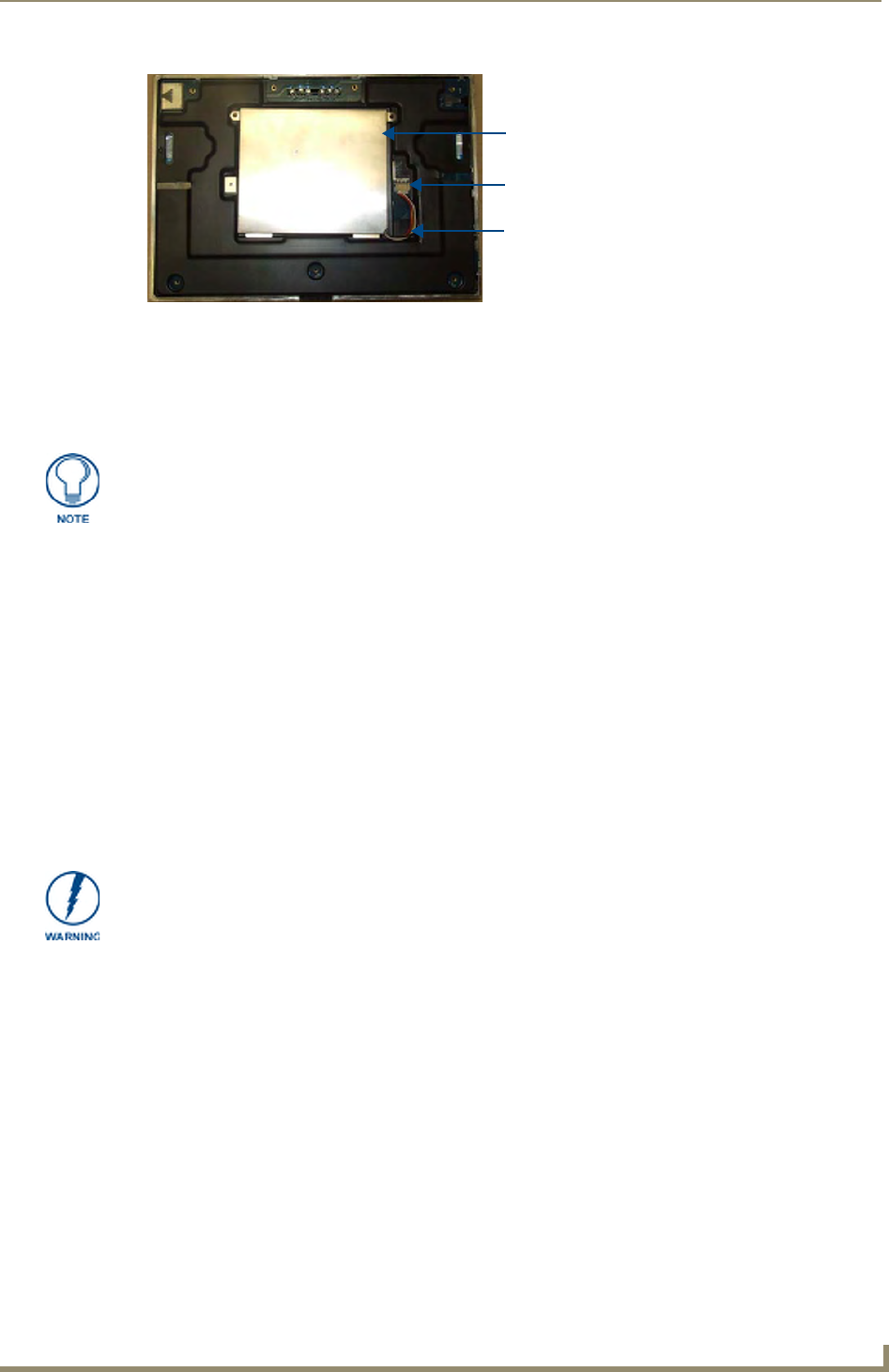
Battery Life and Replacement
171
MVP-9000i Modero® Wireless Touch Panel with Intercom
Remove the Old Battery
Remove the two screws holding the battery case to the back cover. Carefully remove the battery
from the back cover, taking care of the two retaining tabs helping to hold the battery onto the back
cover. Please dispose of the battery in a proper fashion as required by municipal or federal
regulations.
Install the New Battery
Open the plastic bag containing the battery, taking care not to use sharp instruments near the battery
itself.
Attach the new battery to the back cover, using the two screws used to hold the previous battery to
the cover.
Reconnecting the Battery To The Device
1. On the back cover, make sure that the battery connector wiring runs to the left and that the protective film
on the battery case has been removed. Make sure that the excess battery wiring fits in the space to the
bottom right of the battery placement. Make sure that the battery lead is not crimped or damaged upon
closure of the case.
2. Make sure to seat fully the battery plug to the connector in the device. If fingers cannot be used, use a
clean, nonconductive stick or probe to seat the connectors.
3. Reattach the back of the device.
4. Insert the five screws and replace the rubber feet atop the two upper screws, using replacement rubber feet
and bottom label included with the replacement battery.
5. Insert the screws underneath the IR emitter cover slot.
6. Reattach the IR emitter cover.
7. Restart the device to confirm that the new battery is functioning correctly.
8. Attach the residual voltage discharge adaptor (SAA5966-27-A) to the old battery and allow any
remaining charge to dissipate. Note that the adaptor may become warm to the touch for up to 12 hours.
FIG. 103 Battery and battery connector placement
Battery (shown on device for clarity)
Battery connector
Battery lead
Attach a residual voltage discharge adaptor (SAA5966-27-A) to the old battery and
allow any remaining charge to dissipate. Note that the adaptor may become warm to
the touch for up to 12 hours.
When reassembling the device, take especial care not to pinch, puncture, or damage
the battery. Do not force the rear plate onto the device, as this can damage the
device.

Battery Life and Replacement
172 MVP-9000i Modero® Wireless Touch Panel with Intercom
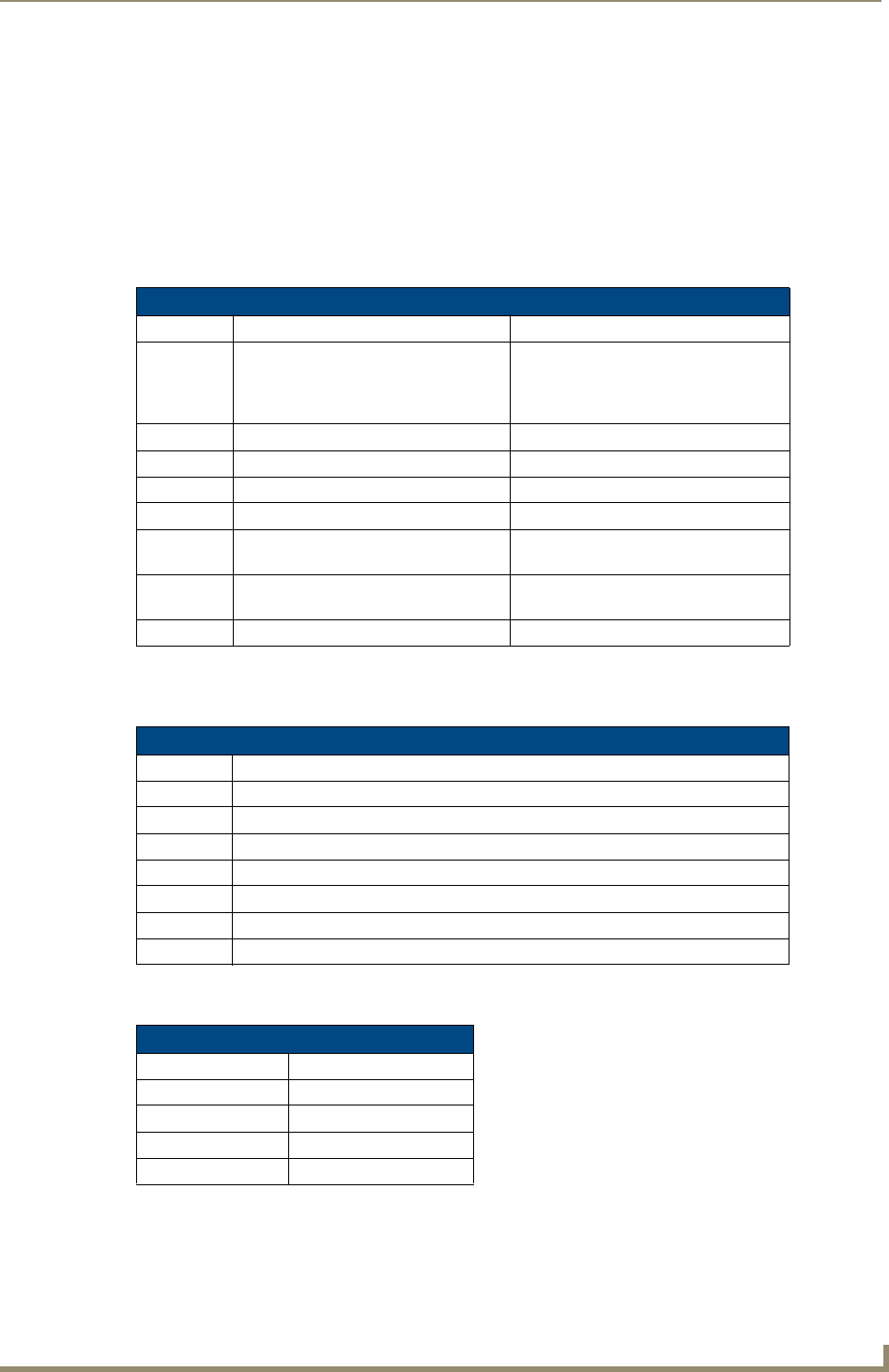
Appendix A: Text Formatting
173
MVP-9000i Modero® Wireless Touch Panel with Intercom
Appendix A: Text Formatting
Text Formatting Codes for Bargraphs/Joysticks
Text formatting codes for bargraphs provide a mechanism to allow a portion of a bargraphs text to be
dynamically provided information about the current status of the level (multistate and traditional). These codes
are entered into the text field along with any other text.
The following is a code list used for bargraphs:
By changing the text on a button (via a VT command), you can modify the codes on a button. When one of the
Text Formatting Codes is encountered by the firmware, it is replaced with the correct value. These values are
derived from the following operations:
Given a current raw level value of 532, a range low value of 500, and a high range value of 600, the following
text formatting codes would yield the following strings as shown in the table below:
Bargraph Text Code Inputs
Code Bargraph Multi-State Bargraph
$P Display the current percentage of the
bargraph (derived from the Adjusted
Level Value as it falls between the
Range Values)
Display the current percentage of the
bargraph (derived from the Adjusted
Level Value as it falls between the
Range Values)
$V Raw Level Value Raw Level Value
$L Range Low Value Range Low Value
$H Range High Value Range High Value
$S N/A Current State
$A Adjusted Level Value (Range Low Value
subtracted from the Raw Level Value)
Adjusted Level Value (Range Low Value
subtracted from the Raw Level Value)
$R Low Range subtracted from the High
Range
Low Range subtracted from the High
Range
$$ Dollar sign Dollar sign
Formatting Code Operations
Code Operation
$P (Current Value - Range Low Value / Range High Value - Range Low Value) x 100
$V Current Level Value
$L Range Low Value
$H Range High Value
$S Current State (if regular bargraph then resolves to nothing)
$A Current Value - Range Low Value
$R Range High Value - Range Low Value
Example
Format Display
$P% 32%
$A out of $R 32 out of 100
$A of 0 - $R 32 of 0 - 100
$V of $L - $H 532 of 500 - 600
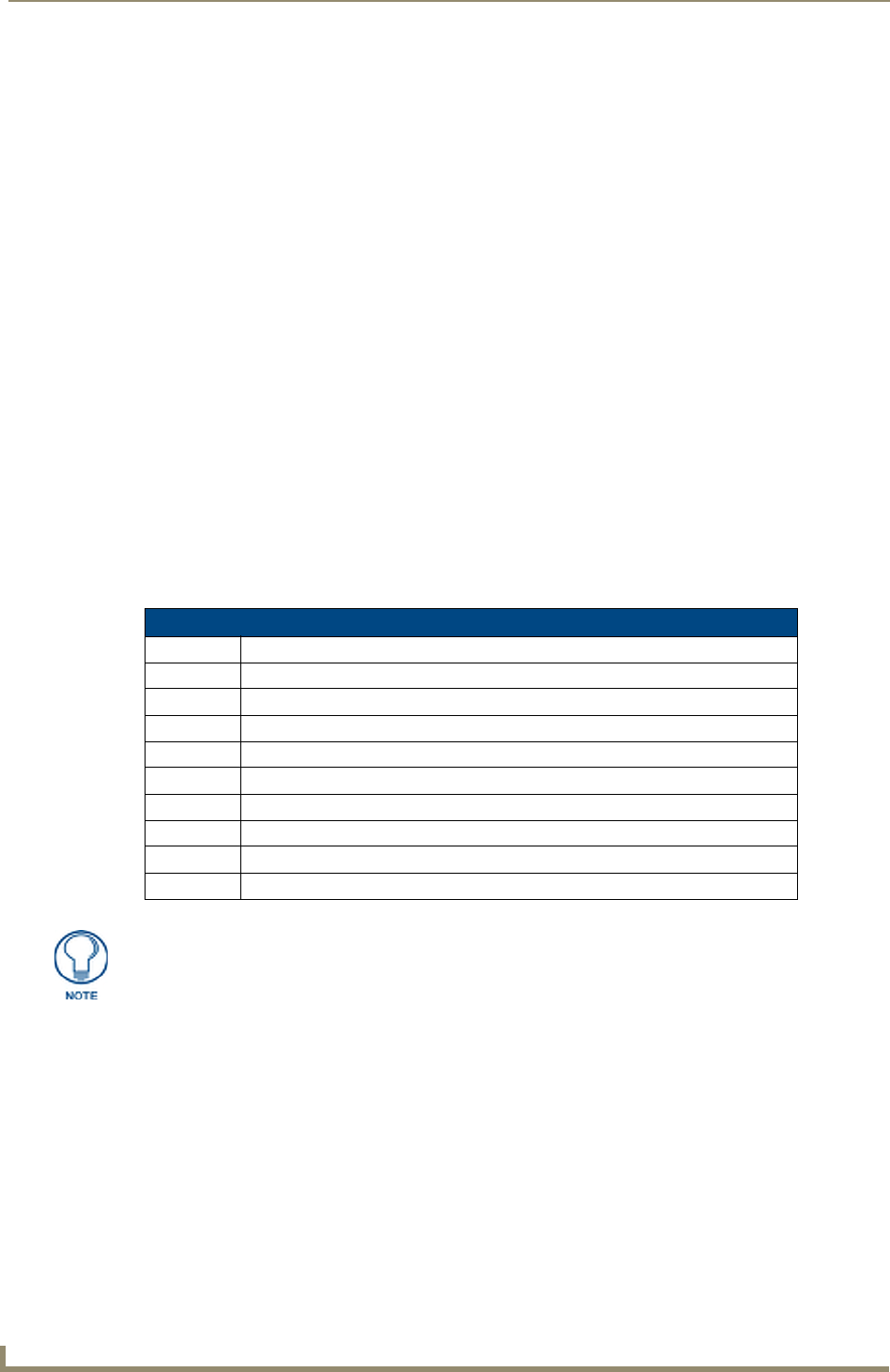
Appendix A: Text Formatting
174 MVP-9000i Modero® Wireless Touch Panel with Intercom
Text Area Input Masking
Text Area Input Masking may be used to limit the allowed/correct characters that are entered into a text area.
For example, in working with a zip code, a user could limit the entry to a max length of only 5 characters; with
input masking, this limit could be changed to 5 mandatory numerical digits and 4 optional numerical digits. A
possible use for this feature is to enter information into form fields. The purpose of this feature is to:
With this feature, it is not necessary to:
Input mask character types
These character types define what information is allowed to be entered in any specific instance. The following
table lists what characters in an input mask will define what characters are allowed in any given position.
Refer to the following SEND_COMMANDs for more detailed information:
• Force the use of correct type of characters (i.e. numbers vs. characters)
• Limit the number of characters in a text area
• Suggest proper format with fixed characters
• Right to Left
• Required or Optional
• Change/Force a Case
• Create multiple logical fields
• Specify range of characters/number for each field
• Limit the user to a choice of selections
• Handle complex input tasks such as names, days of the week, or month by name
• Perform complex validation such as Subnet Mask validation
Character Types
Character Masking Rule
0 Digit (0 to 9, entry required, plus [+] and minus [-] signs not allowed)
9 Digit or space (entry not required, plus and minus signs not allowed)
# Digit or space (entry not required; plus and minus signs allowed)
L Letter (A to Z, entry required)
? Letter (A to Z, entry optional)
A Letter or digit (entry required)
a Letter or digit (entry optional)
& Any character or a space (entry required)
C Any character or a space (entry optional)
The number of the above characters used determines the length of the input masking
box. Example: 0000 requires an entry, requires digits to be used, and allows only 4
characters to be entered/used.
•^BIM - Sets the input mask for the specified addresses. (see the ^BIM section on
page 125).
•^BMF subcommand %MK - sets the input mask of a text area (see the
^BMF section on page 127).
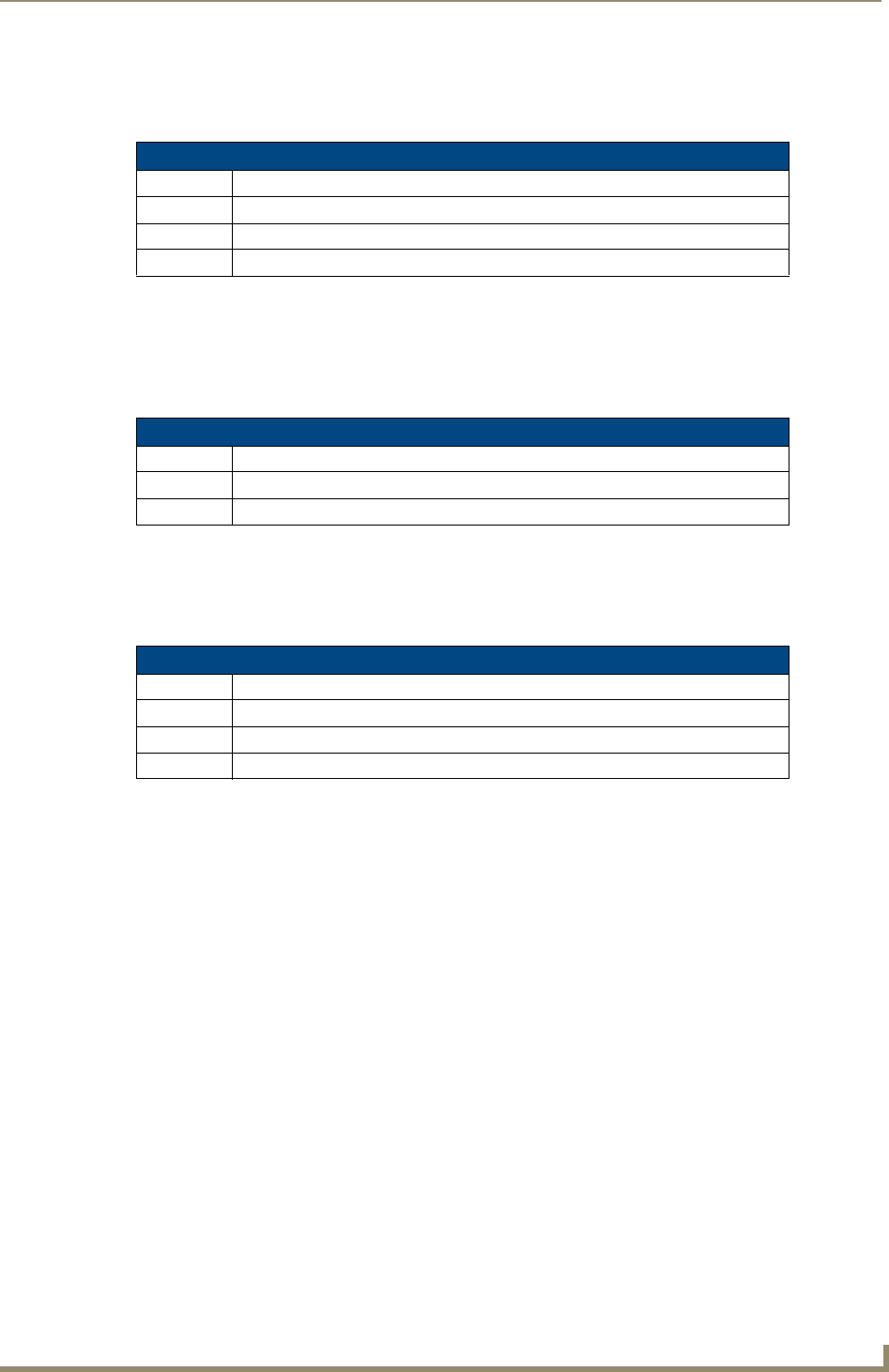
Appendix A: Text Formatting
175
MVP-9000i Modero® Wireless Touch Panel with Intercom
Input Mask Ranges
These ranges allow a user to specify the minimum and maximum numeric value for a field. Only one range is
allowed per field. Using a range implies a numeric entry ONLY.
An example from the above table:
[0|255] This allows a user to enter a value from 0 to 255.
Input mask next field characters
These characters allow you to specify a list of characters that cause the keyboard to move the focus to the next
field when pressed, instead of inserting the text into the text area.
An example from the above table:
{.} or {:} or {.:} Proceed to the next text area input box after a user hits any of these keys.
Input mask operations
Input Mask Operators change the behavior of the field in the following way:
Input mask literals
To define a literal character, enter any character, other than those shown in the above table (including spaces,
and symbols). A back-slash ('\') causes the character that follows it to be displayed as the literal character. For
example, \A is displayed just as the letter A. To define one of the following characters as a literal character,
precede that character with a back-slash. Text entry operation using Input Masks.
A keyboard entry using normal text entry is straightforward. However, once an input mask is applied, the
behavior of the keyboard needs to change to accommodate the input mask's requirement. When working with
masks, any literal characters in the mask will be "skipped" by any cursor movement, including cursor,
backspace, and delete keys.
When operating with a mask, the mask should be displayed with placeholders. The "-" character should
display where you should enter a character. The arrow keys will move between the "-" characters and allow
you to replace them. The text entry code operates as if it is in the overwrite mode. If the cursor is positioned on
a character already entered and you type in a new (and valid) character, the new character replaces the old
character. There is no shifting of characters.
When working with ranges specified by the [] mask, the keyboard allows you to enter a number between the
values listed in the ranges. If a user enters a value that is larger than the maximum, the maximum number of
right-most characters is used to create a new, acceptable value.
Example 1: If you type "125" into a field accepting 0-100, then the values displayed will be "1",
"12", "25".
Example 2: If the max for the field was 20, then the values displayed will
be "1", "12", "5".
Input Mask Ranges
Character Meaning
[ Start range
] End range
| Range Separator
Input Mask Next Field Char
Character Meaning
{ Start Next Field List
} End Next Field List
Input Mask Operators
Character Meaning
< Forces all characters to be converted to lowercase
> Forces all characters to be converted to uppercase
^ Sets the overflow flag for this field
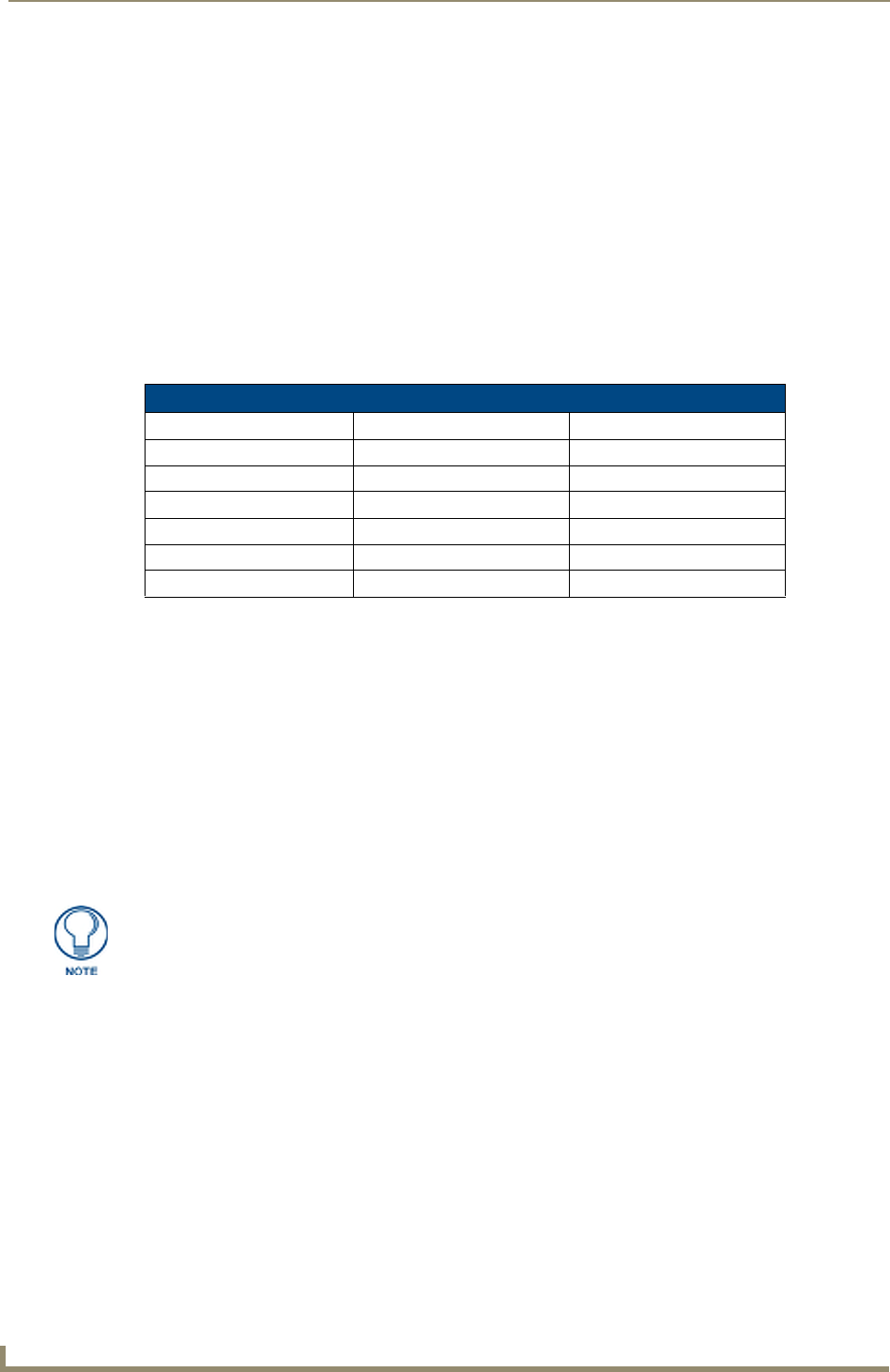
Appendix A: Text Formatting
176 MVP-9000i Modero® Wireless Touch Panel with Intercom
When data overflows from a numerical field, the overflow value is added to the previous field on the chain if
the overflow character was specified. In the above example, if the overflow flag was set, the first example will
place the "1" into the previous logical field and the second example will place "12" in the previous logical
field. If the overflow field already contains a value, the new value will be inserted to the right of the current
characters and the overflow field will be evaluated. Overflow continues to work until a field with no overflow
value is set or no more fields remain (i.e. reached first field).
If a character is typed and that character appears in the Next Field list, the keyboard should move the focus to
the next field. For example, when entering time, a ":" is used as a next field character. If you enter "1:2", the 1
is entered in the current field (hours) and then the focus is moved to the next field and 2 is entered in that field.
When entering time in a 12-hour format, entry of AM and PM is required. Instead of adding AM/PM to the
input mask specification, the AM/PM should be handled within the NetLinx code. This allows a programmer
to show/hide and provide discrete feedback for AM and PM.
Input mask output examples
The following are some common input masking examples:
URL Resources
A URL can be broken into several parts. For example, with the URL http://www.amx.com/company-info-
home.asp, this URL indicates that the protocol in use is http (HyperText Transport Protocol) and that the
information resides on a host machine named www.amx.com. The image on that host machine is given an
assignment (by the program) name of company-info-home.asp (Active Server Page).
The exact meaning of this name on the host machine is both protocol dependent and host dependent. The
information normally resides in a file, but it could be generated dynamically. This component of the URL is
called the file component, even though the information is not necessarily in a file.
A URL can optionally specify a port, which is the port number to which the TCP/IP connection is made on the
remote host machine. If the port is not specified, the default port for the protocol is used instead. For example,
the default port for http is 80. An alternative port could be specified as: http://www.amx.com:8080/company-
info-home.asp.
Special Escape Sequences
The system has only a limited knowledge of URL formats, as it transparently passes the URL information onto
the server for translation. A user can then pass any parameters to the server side programs such as CGI scripts
or active server pages.
However; the system will parse the URL looking for special escape codes. When it finds an escape code, it
replaces that code with a particular piece of panel, button, or state information.
For example, "http://www.amx.com/img.asp?device=$DV" would become http://www.amx.com/
img.asp?device=10001.
Output Examples
Common Name Input Mask Input
IP Address Quad [0|255]{.} Any value from 0 to 255
Hour [1|12]{:} Any value from 1 to 12
Minute/Second [0|59]{:} Any value from 0 to 59
Frames [0|29]{:} Any value from 0 to 29
Phone Numbers (999) 000-0000 (555) 555-5555
Zip Code 00000-9999 75082-4567
Any legal HTTP syntax can be used.
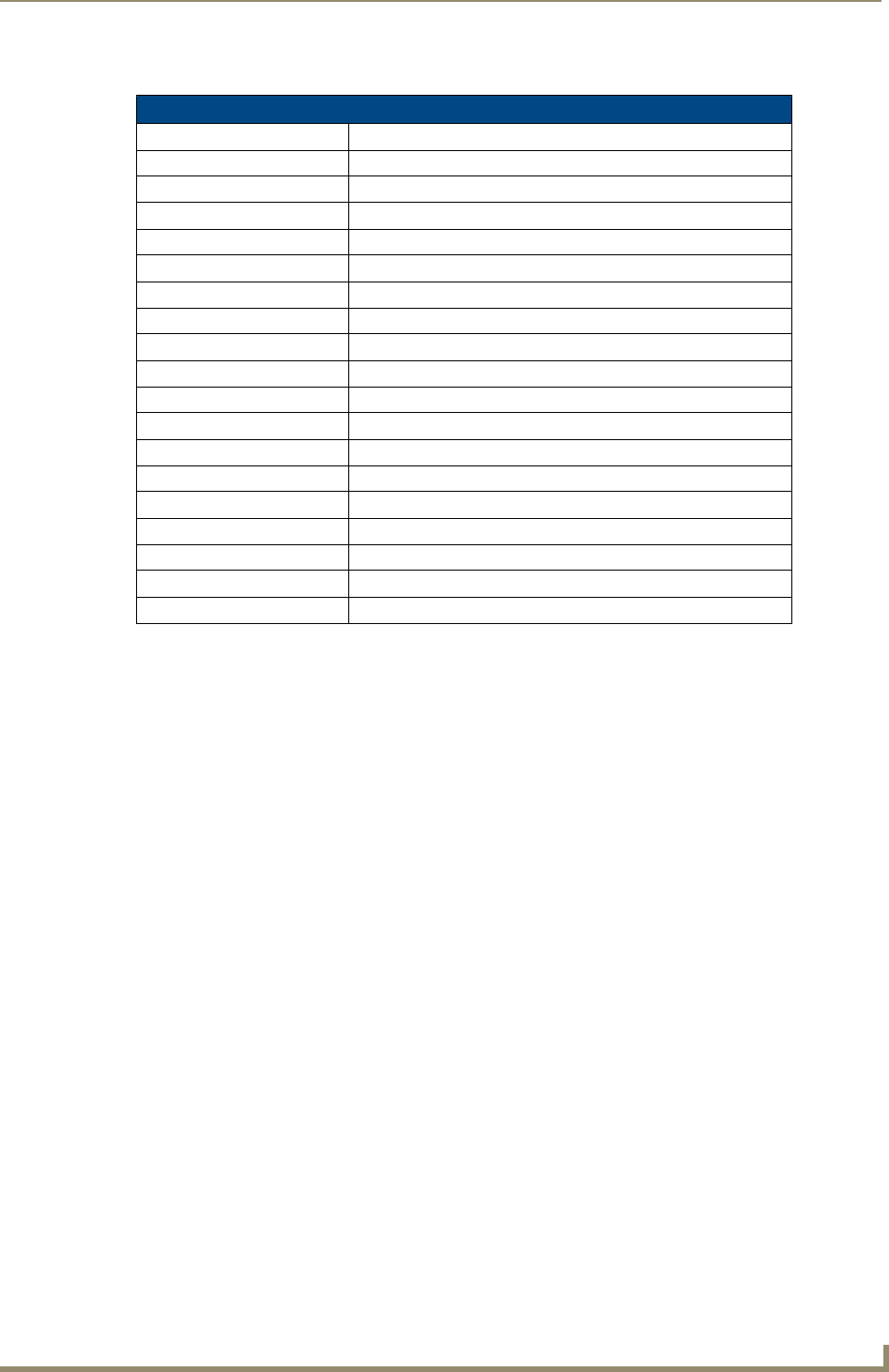
Appendix A: Text Formatting
177
MVP-9000i Modero® Wireless Touch Panel with Intercom
Other used escape sequences include:
Escape Sequences
Sequence Panel Information
$DV Device Number
$SY System Number
$IP IP Address
$HN Host Name
$MC Mac Address
$ID Neuron ID
$PX X Resolution of current panel mode/file
$PY Y Resolution of current panel mode/file
$BX X Resolution of current button
$BY Y Resolution of current button
$BN Name of button
$ST Current state
$AC Address Code
$AP Address Port
$CC Channel Code
$CP Channel Port
$LC Level Code
$LP Level Port

Appendix A: Text Formatting
178 MVP-9000i Modero® Wireless Touch Panel with Intercom

Appendix B: Wireless Technology
179
MVP-9000i Modero® Wireless Touch Panel with Intercom
Appendix B: Wireless Technology
Overview of Wireless Technology
802.11b/2.4 GHz and 802.11a/5 GHz are the two major WLAN standards and both operate using
radio frequency (RF) technology. Together the two standards are together called WiFi and operate
in frequency bands of 2.4 GHz and 5 GHz respectively.
The 802.11b specification was the first to be finalized and reach the marketplace. The actual
throughput obtained from an 802.11b network will typically be between 4 and 5 Mbps.
Because of the higher frequency (and thus shorter wavelength) that they use, 802.11a signals have a
much tougher time penetrating solid objects like walls, floors, and ceilings. As a result, the price for
802.11a's higher speed is not only a shorter range but also a weaker and less consistent signal.
802.11a/b/g provides increased bandwidth at 54 Mbps. As part of the IEEE 802.11a/b/g
specification, when throughput cannot be maintained, this card will automatically switch
algorithms in order to maintain the highest spread possible at a given distance. In addition, 802.11a/
b/g can also step down to utilize 802.11b algorithms and also maintain a connection at longer
distances.
IP Routing is a behavior of the wireless routing is largely dependent on the wired network
interface. Although the panel can be connected to two networks simultaneously, it may only have
one gateway. If the wired network was successfully set up and a gateway was obtained; then the
default route for all network traffic will be via the wired network. In the event that the wired
network was not configured, then the default route for all network traffic will be via the wireless
network. The wired network connection always takes priority.
Example: Imagine a panel connected to the two networks A & B. A is the wired network and B is
the wireless network. If the Master controller is on either of these networks, then it will be reached.
However if the Master controller is on a different network, C, then the gateway determines which
network interface (wired or wireless) will be used.
Wireless Access Points (WAPs) are the cornerstone of any wireless network. A WAP acts as a
bridge between a wired and wireless network. It aggregates the traffic from all wireless clients and
forwards it down the network to the switch or router. One WAP may be all that is necessary for a
standard installation. However, more WAPs may be needed, depending on the size of the
installation, its layout, and its construction.
Wireless Equivalent Privacy (WEP) Security is a method by which WLANs protect wireless data
streams. A data stream encrypted with WEP can still be intercepted or eavesdropped upon, but the
encryption makes the data unintelligible to the interloper. The strength of WEP is measured by the
length of the key used to encrypt the data. The longer the key, the harder it is to crack.
802.11b implementations provided 64-bit and 128-bit WEP keys. This is known respectively as 64-
bit and 128-bit WEP encryption. 64-bit is generally not regarded as adequate security protection.
Both key lengths are supported by the Modero product line.
Whichever level of WEP used, using identical settings is crucial (CASE SENSITIVE)--the key
length, and the key itself-- on all devices. Only devices with common WEP settings will be able to
communicate. Similarly,
If one device has WEP enabled and another does no, they will not be able to talk to each other.
Although the calculations required to encrypt data with WEP can impact the performance of your
wireless network, this impact is generally only seen when running benchmarks, and is not large
enough to be noticeable in the course of normal network usage.

Appendix B: Wireless Technology
180 MVP-9000i Modero® Wireless Touch Panel with Intercom
Terminology
802.1x
IEEE 802.1x is an IEEE standard that is built on the Internet standard EAP (Extensible Authentication
Protocol). 802.1x is a standard for passing EAP messages over either a wired or wireless LAN. Additionally,
802.1x is also responsible for communicating the method with which WAPs and wireless users can share and
change encryption keys. This continuous key change helps resolve any major security vulnerabilities native to
WEP.
AES
Short for Advanced Encryption Standard, is a cipher currently approved by the NSA to protect US
Government documents classified as Top Secret. The AES cipher is the first cipher protecting Top Secret
information available to the general public.
CERTIFICATES (CA)
A certificate can have many forms, but at the most basic level, a certificate is an identity combined with a
public key, and then signed by a certification authority. The certificate authority (CA) is a trusted external third
party which "signs" or validates the certificate. When a certificate has been signed, it gains some cryptographic
properties. AMX supports the following security certificates within three different formats:
PEM (Privacy Enhanced Mail)
DER (Distinguished Encoding Rules)
PKCS12 (Public Key Cryptography Standard #12)
Typical certificate information can include the following items:
Certificate Issue Date
Extensions
Issuer
Public Key
Serial Number
Signature Algorithm
User
Version
MIC
Short for Message Integrity Check, this prevents forged packets from being sent. Through WEP, it was
possible to alter a packet whose content was known even if it had not been decrypted.
TKIP
Short for Temporal Key Integration, this is part of the IEEE 802.11i encryption standard for wireless LANs.
TKIP provides a per-packet key mixing, message integrity check and re-keying mechanism, thus ensuring that
every data packet is sent with its own unique encryption key. Key mixing increases the complexity of decoding
the keys by giving the hacker much less data that has been encrypted using any one key.
WEP
Short for Wired Equivalent Privacy, WEP is a scheme used to secure wireless networks (WiFi). A wireless
network broadcasts messages using radio which are particularly susceptible to hacker attacks. WEP was
intended to provide the confidentiality and security comparable to that of a traditional wired network. As a
result of identified weaknesses in this scheme, WEP was superseded by WiFi Protected Access (WPA), and
then by the full IEEE 802.11i standard (also known as WPA2).
WPA
WiFi Protected Access (WPA and WPA2) is a class of system used to secure wireless (WiFi) computer
networks. It was created in response to several serious weaknesses researchers had found in the previous WEP
system. WPA implements the majority of the IEEE 802.11i standard, and was intended as an intermediate
measure to take the place of WEP while 802.11i was prepared (WPA2).
WPA is designed to work with all wireless network interface cards, but not necessarily with first generation
wireless access points.
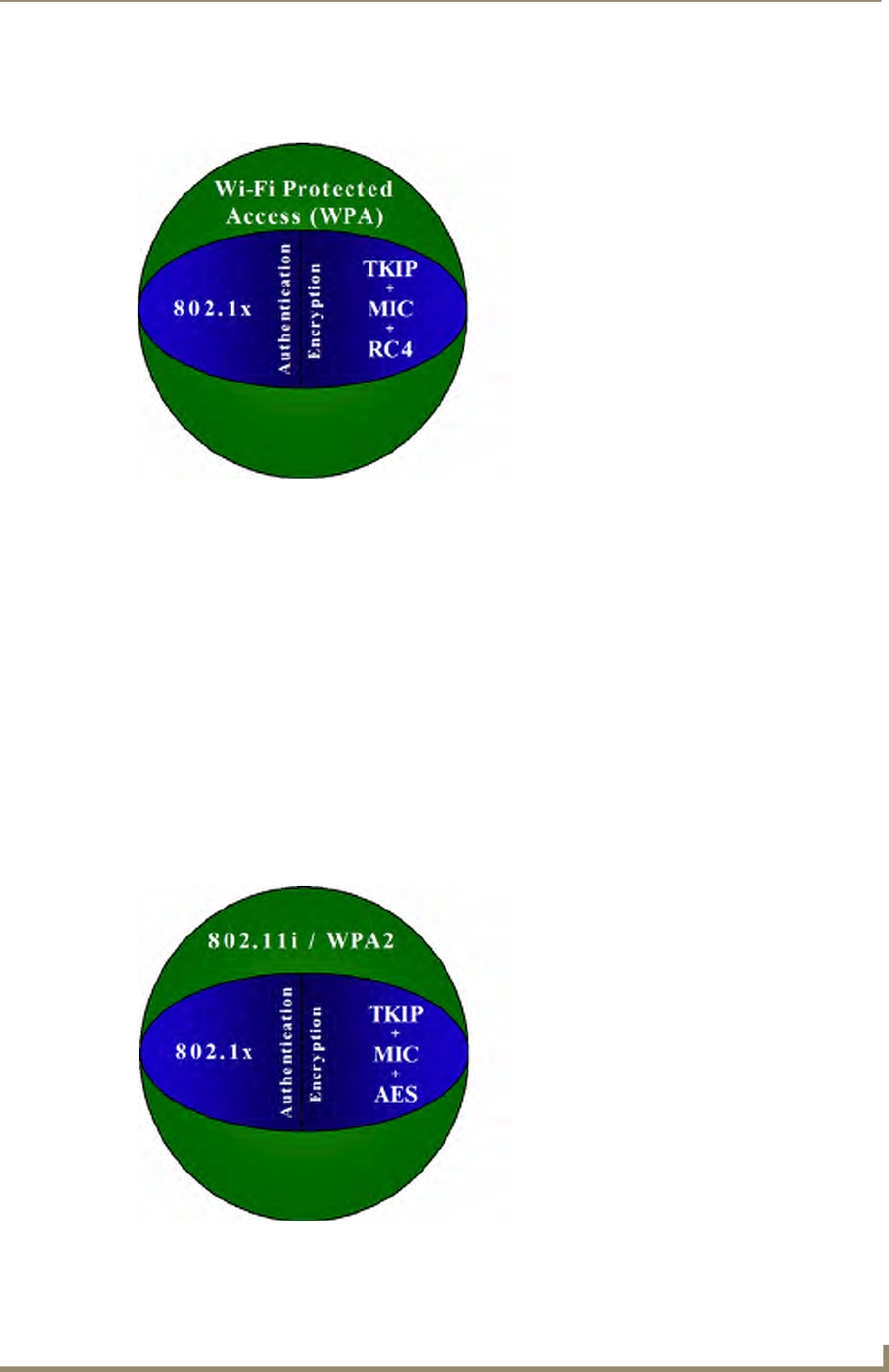
Appendix B: Wireless Technology
181
MVP-9000i Modero® Wireless Touch Panel with Intercom
To resolve problems with WEP, the WiFi Alliance released WPA (FIG. 104), which integrated 802.1x, TKIP
and MIC. Within the WPA specifications, the RC4 cipher engine was maintained from WEP. RC4 is widely
used in SSL (Secure Socket Layer) to protect internet traffic.
WPA2
Also know as IEEE 802.11i, this is an amendment to the 802.11 standard specifying security mechanisms for
wireless networks. The 802.11i scheme makes use of the Advanced Encryption Standard (AES) block cipher;
WEP and WPA use the RC4 stream cipher.
The 802.11i architecture contains the following components: 802.1X for authentication (entailing the use of
EAP and an authentication server), RSN for keeping track of associations, and AES-based CCMP to provide
confidentiality, integrity and origin authentication.
WPA2 implements the full standard, but will not work with some older network cards. Both provide good
security, with two significant issues:
either WPA or WPA2 must be enabled and chosen in preference to WEP.
WEP is usually presented as the first security choice in most installation instructions.
in the "Personal" mode, the most likely choice for homes and small offices, a passphrase is required
that, for full security, must be longer than the typical 6 to 8 character passwords users are taught to
employ.
With the RC4 released to the general public, the IEEE implemented the Advanced Encryption Standard (AES)
as the cipher engine for 802.11i, which the WiFi Alliance has branded as WPA2 (FIG. 105).
FIG. 104 WPA Overview
FIG. 105 WPA2 Overview
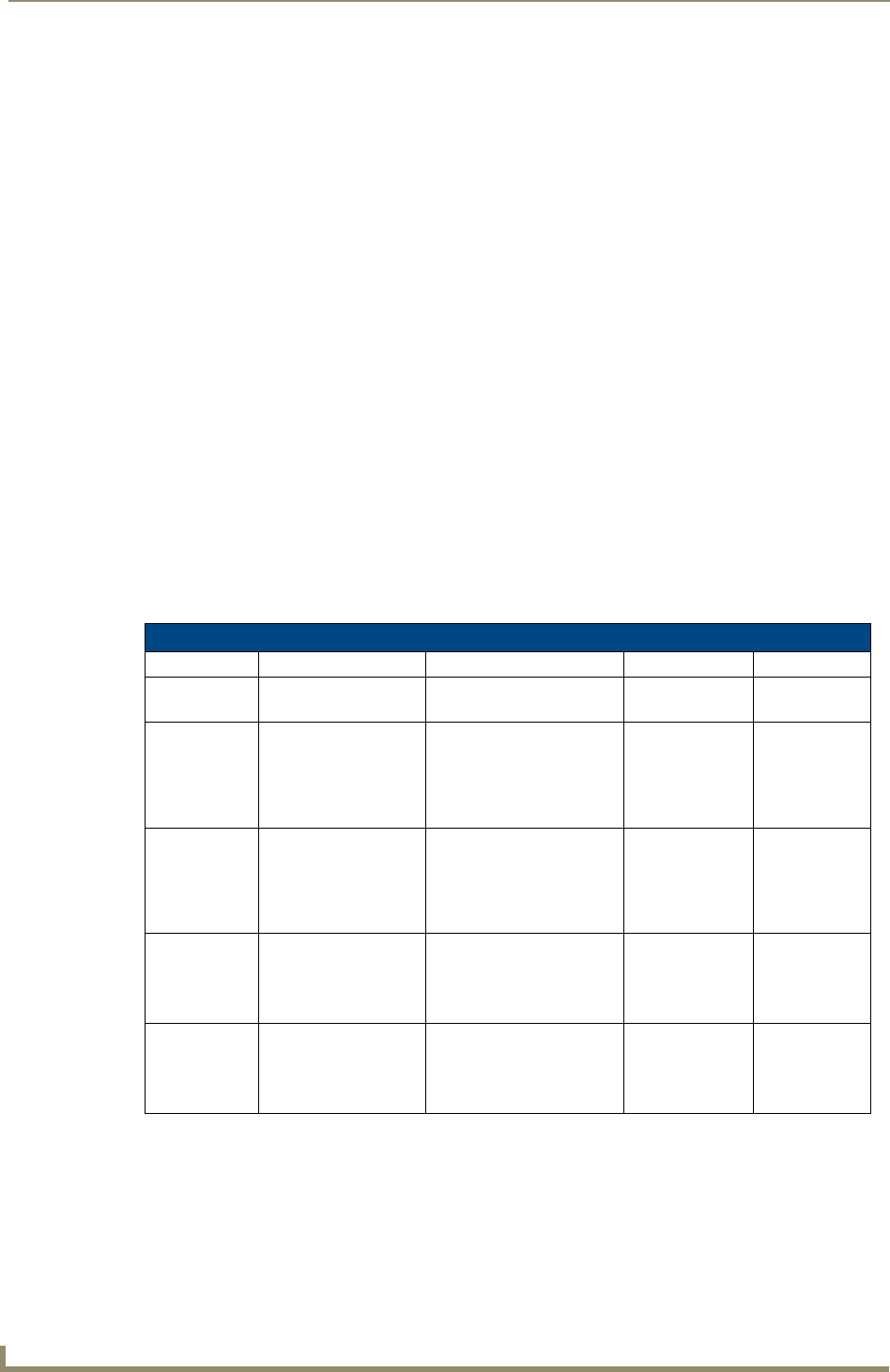
Appendix B: Wireless Technology
182 MVP-9000i Modero® Wireless Touch Panel with Intercom
EAP Authentication
EAP (Extensible Authentication Protocol) is an Enterprise authentication protocol that can be used in both a
wired and wireless network environment. EAP requires the use of an 802.1x Authentication Server, also
known as a RADIUS server. Although over 40 different EAP methods are currently defined, the current
internal Modero 802.11a/b/g wireless card and accompanying firmware only support the following EAP
methods (listed from simplest to most complex):
EAP-LEAP (Cisco Light EAP)
EAP-FAST (Cisco Flexible Authentication via Secure Tunneling, a.k.a. LEAPv2)
The following use certificates:
EAP-PEAP (Protected EAP)
EAP-TTLS (Tunneled Transport Layer Security)
EAP-TLS (Transport Layer Security)
EAP requires the use of an 802.1x authentication server (also known as a RADIUS server). Sophisticated
Access Points (such as Cisco) can use a built-in RADIUS server. The most common RADIUS servers used in
wireless networks today are:
Microsoft Sever 2003
Juniper Odyssey (once called Funk Odyssey)
Meetinghouse AEGIS Server
DeviceScape RADIUS Server
Cisco Secure ACS
EAP Characteristics
The following table outlines the differences among the various EAP Methods from most secure (at the top of
the list) to the least secure (at the bottom of the list):
EAP Method Characteristics
Method: Credential Type: Authentication: Pros: Cons:
EAP-TLS • Certificates • Certificate is based on a
two-way authentication
• Highest
Security
• Difficult to
deploy
EAP-TTLS • Certificates
• Fixed Passwords
• One-time passwords
(tokens)
• Client authentication is
done via password and
certificates
• Server authentication is
done via certificates
• High Security • Moderately
difficult to
deploy
EAP-PEAP • Certificates
• Fixed Passwords
• One-time passwords
(tokens)
• Client authentication is
done via password and
certificates
• Server authentication is
done via certificates
• High Security • Moderately
difficult to
deploy
EAP-LEAP • Certificates
• Fixed Passwords
• One-time passwords
(tokens)
• Authentication is based on
MS-CHAP and
MS-CHAPv2
authentication protocols
• Easy
deployment
• Susceptible to
dictionary
attacks
EAP-FAST • Certificates
• Fixed Passwords
• One-time passwords
(tokens)
•N/A •N/A •N/A
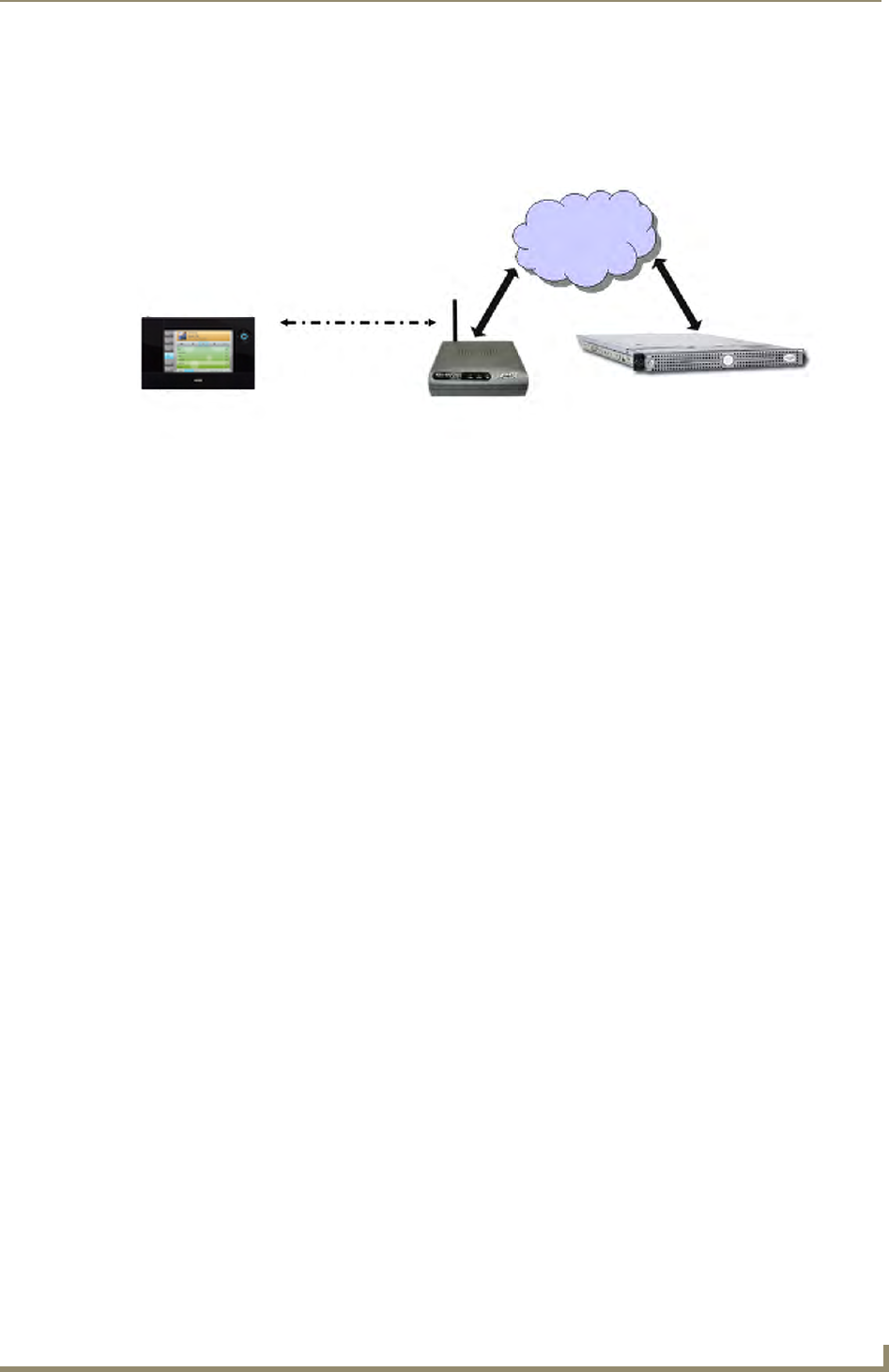
Appendix B: Wireless Technology
183
MVP-9000i Modero® Wireless Touch Panel with Intercom
EAP Communication Overview
EAP Authentication goes a step beyond just encrypting data transfers, but also requires that a set of credentials
be validated before the client (panel) is allowed to connect to the rest of the network (FIG. 106). Below is a
description of this process. It is important to note that no user intervention is necessary during this process. It
proceeds automatically based on the configuration parameters entered into the panel.
1. The client (panel) establishes a wireless connection with the WAP specified by the SSID.
2. The WAP opens up a tunnel between itself and the RADIUS server configured via the access point. This
tunnel means that packets can flow between the panel and the RADIUS server but nowhere else. The
network is protected until authentication of the client (panel) is complete and the ID of the client is
verified.
3. The WAP (Authenticator) sends an "EAP-Request/Identity" message to the panel as soon as the wireless
connection becomes active.
4. The panel then sends a "EAP-Response/Identity" message through the WAP to the RADIUS server
providing its identity and specifying which EAP type it wants to use. If the server does not support the
EAP type, then it sends a failure message back to the WAP which will then disconnect the panel. As an
example, EAP-FAST is only supported by the Cisco server.
5. If the EAP type is supported, the server then sends a message back to the client (panel) indicating what
information it needs. This can be as simple as a username (Identity) and password or as complex as
multiple CA certificates.
6. The panel then responds with the requested information. If everything matches, and the panel provides
the proper credentials, the RADIUS server then sends a success message to the access point instructing it
to allow the panel to communicate with other devices on the network. At this point, the WAP completes
the process for allowing LAN Access to the panel (possibly a restricted access based on attributes that
came back from the RADIUS server).
As an example, the WAP might switch the panel to a particular VLAN or install a set of farewell rules.
FIG. 106 EAP security method in process
Client - Panel
(Supplicant)
802.1x
(EAP Over Wireless)
Authenticator
(Wireless Access Point)
LAN
Authentication Server
(RADIUS Server)

Appendix B: Wireless Technology
184 MVP-9000i Modero® Wireless Touch Panel with Intercom
Configuring Modero Firmware via the USB Port
The MVP-9000i needs to be configured to connect with a PC to transfer firmware via the mini-USB port. To
configure the touch panel:
Step 1: Configure The Panel For a USB Connection Type
1. After the panel powers up, hold the Reset button to display the Setup page (for more information, refer to
the Accessing the Setup pages section on page 45) and open the Protected Setup page.
2. Press System Settings to open the System Settings page.
3. Toggle the blue Type field in the Master Connection section until the choice cycles to USB.
4. Press the Back button on the touch panel to return to the Protected Setup page.
5. Press the Reboot button both to save any changes and to restart the panel. Remember that the panel’s
connection type must be set to USB prior to rebooting the panel and prior to inserting the USB connector.
6. ONLY AFTER the unit displays the first panel page should you THEN insert the mini-USB connector
into the Mini-USB Port on the panel. It may take a minute for the panel to detect the new connection and
send a signal to the PC, indicated by a green System Connection icon.
If a few minutes have gone by and the System Connection icon still does not turn green, complete
the procedures in the following section to set up the Virtual Master and refresh the System from the
Online Tree. This action sends out a request to the panel to respond and completes the
communication, turning the System Connection icon green.
7. Repeat steps 2 and 3 to return to the System Settings page
Step 2: Prepare NetLinx Studio For Communication Via the USB Port
1. From the Start menu in Windows XP, open the Network Connections dialog (Start > Settings >
Network Connections > Local Area Connection).
2. Look for the Local Area Connection reading Local Area Connection, AMX USB Device Link and double-
click on it to open the Local Status.
3. Press the Properties tab to open the Local Area Connection Properties section.
4. Press the Properties button to open the TCP/IP Properties dialog box.
5. Set the IP address to an address within the same subnet as the panel IP address specified within the USB
IP settings of the panel. For instance, if the default IP address on the device is 172.16.0.2, set the IP
address to 172.16.0.1. Use any class and number currently not being used by your network.
6. Set the Subnet Mask to 255.255.0.0.
7. In the TCP/IP Properties dialog box, click OK.
8. In the Local Area Connection Properties, section, click Close.
ALL fields are then greyed out and read-only. However, they still display any previous
network information.

Appendix B: Wireless Technology
185
MVP-9000i Modero® Wireless Touch Panel with Intercom
AMX Certificate Upload Utility
The Certificate Upload utility gives you the ability to compile a list of target touch panels, select a pre-obtained
certificate (uniquely identifying the panel), and then upload that file to the selected panel.
This application ensures that a unique certificate is securely uploaded to a specific touch panel. Currently, the
target panels must be capable of supporting the WPA-PSK and EAP-XXX wireless security formats.
The Certificate Upload utility supports the following capabilities:
Ability to browse both a local and network drive to find a desired certificate file.
Ability to create a list of target AMX G4 touch panels based on IP Addresses.
Ability to display the IP Address of the local computer hosting the application.
Ability to load a previously created list of target touch panels.
Ability to save the current list of target Modero panel as a file.
Ability to track the progress of the certificate upload by noting the current data size being
transmitted and any associated error messages (if any).
The Certificate Upload Utility recognizes the following certificate file types:
CER (Certificate File)
DER (Distinguished Encoding Rules)
PEM (Privacy Enhanced Mail)
PFX (Normal Windows generated certificate)
PVK (Private Key file)
Uploading a Certificate File
1. Install the latest AMX USB LAN LINK driver onto your computer by installing the latest versions of
either TPDesign4 or NetLinx Studio2. This USB driver prepares your computer for proper
communication with the MVP-9000i.
2. Access the target panel's Protected Setup firmware page and configure the USB communication
parameters.
3. With the panel successfully communicating with the target computer, launch the Certificate Upload
Utility.
Familiarize yourself with the Certificate Utility User Interface options.
4. Locate your certificate file by using the Browse button and navigating to the desired file type.
5. Use the drop-down arrow in the Local Address field to select direct communication through the USB port.
6. Select the 172.XX.0.1 IP Address that corresponds to the virtual IP Address assigned to the USB
connection port on the computer.
7. Navigate to the Add IP Address field at the bottom-right of the interface and enter a value of 1 greater than
the virtual USB IP Address.
For example: If the virtual USB IP Address is 176.16.0.1, then add an address for the directly connected
panel of 176.16.0.2. This is one greater than the USB address value detected by the utility.
A certificate may be sent to ONLY ONE directly connected panel via USB.
Use the Ethernet port’s IP Address to send a server certificate to multiple panel targets.
8. Select the IP Address which corresponds to the local computer's Ethernet address.
9. Navigate to the Add IP Address field (bottom-right of the interface) and enter the IP Addresses of the
various target touch panels.
10. Click the Add button to complete the entry and add the new IP Address to the listing of available device
IP Addresses. Repeat this process for all subsequent device IP Addresses.
This application must be run from a local machine and should not be used from a
remote network location.

Appendix B: Wireless Technology
186 MVP-9000i Modero® Wireless Touch Panel with Intercom
11. Once the list is complete, click on the File drop-down menu and select the Save option. This launches a
Save dialog to assign a name to the current list of addresses and then save the information as a TXT (text)
file to a known location.
12. Select the target devices to be uploaded with the selected certificate. These may be:
individually selected by toggling the box next to the Send entry (with the Type column).
selected as a group by clicking on the Check All radio box located at the top of the device IP
Address listing.
13. When ready to send the certificate file to the selected panels, click the Send button to initiate the upload.
Once the Status field for each entry reads Done, the upload was successfully completed.
This application must be run from a local machine and should not be used from a
remote network location.
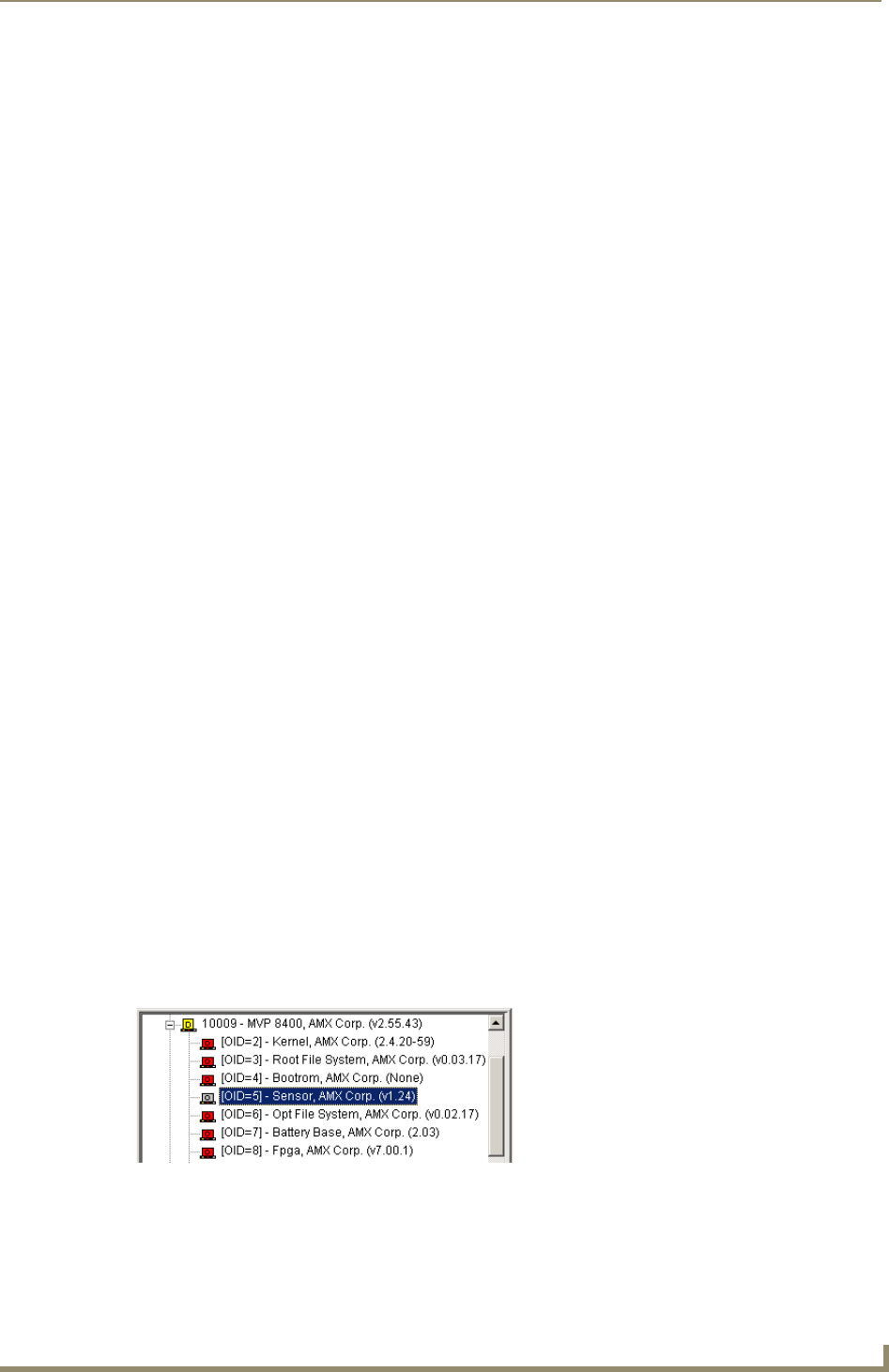
Appendix C: Troubleshooting
187
MVP-9000i Modero® Wireless Touch Panel with Intercom
Appendix C: Troubleshooting
Overview
This section describes the solutions to possible hardware/firmware issues that could arise during the common
operation of a Modero touch panel.
Panel Doesn’t Respond To Touches
Symptom: The device either does not respond to touches on the touch screen or does not register the touch as
being in the correct area of the screen.
If the screen is off:
The device may be in Standby Mode. Press and hold the directional pad to wake up the panel.
The device may be in Shutdown Mode. Press and hold the center button on the directional pad until
the device turns on.
The device battery may be drained. Place the device into a Table Docking Station or a Wall
Docking Station, or connect it to its included power source to recharge the battery.
If the screen is on:
The protective laminate coating may still be on the LCD. Verify that the coating on the LCD is
removed before beginning any calibration process. The protective cover makes calibration difficult
because the device cannot calibrate on specific crosshairs when the sheet is pressing on the whole
LCD.
The previous calibration may be off. Reset the device calibration, as explained in the Calibrate
Page section on page 87.
Battery Will Not Hold Or Take A Charge
Symptom: The battery will not hold or take a charge and shows no indication of charging, either on the
bargraphs or in the Battery Setup page.
To keep the battery from being damaged from operating at too low a level, the firmware places it into a
protected state.
The panel must have the latest firmware. If it doesn’t, the firmware can be found at www.amx.com.
1. Load the firmware into the panel, using NetLinx Studio.
2. After loading the firmware, power cycle the MVP (this is a complete power cycle, not a Reboot). The
panel will now show the current firmware version within the Setup > Panel Information page.
3. Connect the power supply to the panel. You will see 2 warning messages on the display.
The first one warns that the battery is low and must be charged.
The second warning tells you that the battery is in a protected mode.
4. Wait a few minutes and then check the Battery Settings page on the device to see any charging activity on
the bar graphs. (For more information, refer to the Power Management Page section on page 51.)
The “Sensor” device in the Online Tree tab below the MVP panel should show v1.24 or higher after the
upgrade, as shown in FIG. 107:
FIG. 107 "Sensor" device in the Online Tree tab

Appendix C: Troubleshooting
188 MVP-9000i Modero® Wireless Touch Panel with Intercom
MVP-9000i Isn’t Appearing In The Online Tree Tab
1. Verify that the System number is the same on both the NetLinx Project Navigator window and the System
Settings page on the device.
2. Verify the proper NetLinx Master IP and connection methods entered into the Master Connection section
of the System Settings page.
MVP Can’t Obtain a DHCP Address
In requesting a DHCP Address, the DHCP Server can take up to a few minutes to provide the address.
1. Verify that the WAP is configured to match the MVP panel Network Name (SSID) field, Encryption,
Default Key, and Current Key string.
2. In NetLinx Studio, select Diagnostics > Network Address and verify the System number.
3. If the IP Address field is still empty, give the device a few minutes to negotiate a DHCP Address and try
again.
My WAP Doesn’t Seem To Be Working
WEP will not work unless the same default key is set on both the panel and the Wireless Access Point (WAP).
For example, if the access point was set to default WEP key 4 (which was 01:02:03:04:05), the Modero’s
Default WEP key 4 must be set to 01:02:03:04:05.
NetLinx Studio Only Detects One Of My Connected Masters
Each Master is given a Device Address of 00000.
Only one Master can be assigned to a particular System number. If you want to work with multiple Masters,
open different instances of NetLinx Studio and assign each Master its own System value.
Example: A site has an NXC-ME260/64 and an NI-4000. In order to work with both units. The ME260 can be
assigned System #1 and the NI-4000 can then be assigned System #2 using two open sessions of NetLinx
Studio v 2.x.
Can’t Connect To a NetLinx Master
Symptom: I can’t seem to connect to a NetLinx Master using NetLinx Studio.
Select Settings > Master Comm Settings > Communication Settings > Settings (for TCP/IP), and uncheck the
"Automatically Ping the Master Controller to ensure availability".
The pinging is to determine if the Master is available and to reply with a connection failure instantly if it is not.
Without using the ping feature, a connection may still be attempted, but a failure will take longer to be
recognized.
When connecting to a NetLinx Master controller via TCP/IP, the program will first try to ping the controller
before attempting a connection. Pinging a device is relatively fast and will determine if the device is off-line,
or if the TCP/IP address that was entered was incorrect.
If you decide not to ping for availability and the controller is off-line, or you have an incorrect TCP/IP address,
the program will try for 30-45 seconds to establish a connection.
Only One Modero Panel In My System Shows Up
Symptom: I have more than one Modero panel connected to my System Master and only one shows up.
Multiple NetLinx Compatible devices, such as MVP panels, can be associated for use with a single Master.
Each panel comes with a defaulted Device Number value of 10001. When using multiple panels, different
Device Number values have to be assigned to each panel.
1. Press and hold the Reset button (FIG. 45) to open the Setup page.
Remember that the Passphrase generator on the panel does not produce the same
Current Key if using the same passphrase on the WAP.
If you are trying to connect to a Master controller that is behind a firewall, you may
have to uncheck this option. Most firewalls will not allow ping requests to pass
through for security reasons.

Appendix C: Troubleshooting
189
MVP-9000i Modero® Wireless Touch Panel with Intercom
2. Press the Protected button, enter 1988 into the on-screen Keypad’s password field, and press Done when
finished.
3. Enter a Device Number value for the panel into the Device Number Keypad. The default is 10001 and the
range is from 1 - 32000.
Panel Behaves Strangely After Downloading A Panel File Or Firmware
Symptom: After downloading a panel file or firmware to a G4 device, the panel behaves strangely.
If the panel already contains a large enough file, subsequent downloads will take up more space than is
available and could often corrupt the Compact Flash. The demo file that typically ships with G4 panels is one
such file.
Symptoms include:
Having to repeat the download.
Inability to make further downloads to the panel. May get "directory" errors, "graphics hierarchy"
errors, etc., indicating problems with the Compact Flash.
Panel will not boot, or gets stuck on "AMX" splash screen.
Other problems also started after downloading to a new panel or a panel with a TPD4 file that takes up a
considerable amount of the available Compact Flash.
1. DO NOT download TPD4 files (of large size) over the demo pages, or any other large TPD4 file.
2. First download a small blank one page file to the G4 panel using the Normal Transfer option to send/
download the page.
3. Reboot the device.
4. Do your regular file or firmware download.

Appendix C: Troubleshooting
190 MVP-9000i Modero® Wireless Touch Panel with Intercom

Appendix C - Troubleshooting
191
MVP-9000i Modero® Wireless Touch Panel with Intercom

10/2010 ©2010 AMX. All rights reserved. AMX and the AMX logo are registered trademarks of AMX. AMX reserves the right to alter specifications without notice at any time.
It’s Your World - Take Control™
3000 RESEARCH DRIVE, RICHARDSON, TX 75082 USA • 800.222.0193 • 469.624.8000 • 469-624-7153 fax • 800.932.6993 technical support • www.amx.com
